Honeywell 950009 Handheld computer with 3 radios User Manual 95XX UG
Honeywell International Inc Handheld computer with 3 radios 95XX UG
User Manual
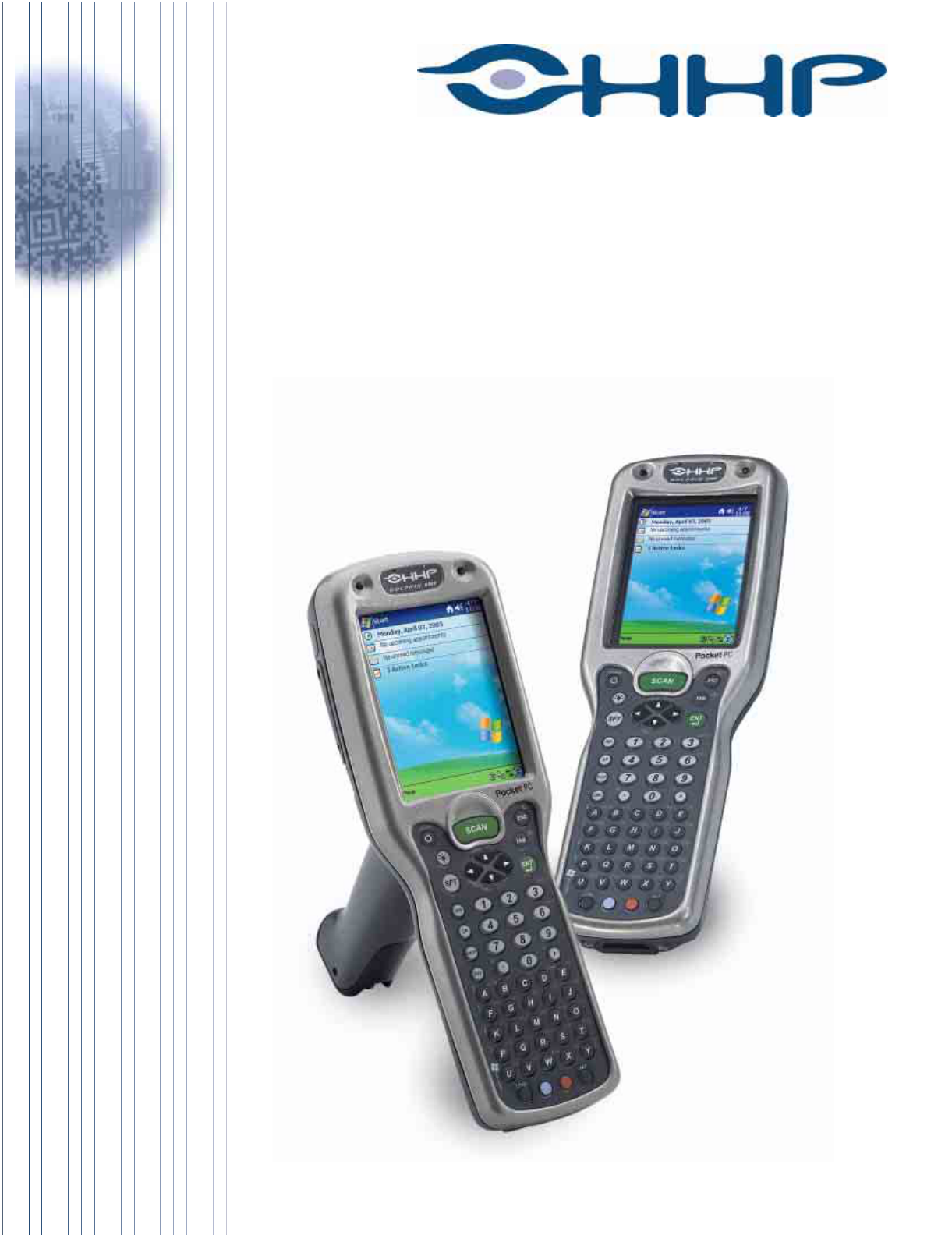
™
User’s Guide - GSM Draft
Dolphin
®
9500/9550 Mobile Computer
Windows® Powered Pocket PC 2002

Trademarks
Dolphin, HomeBase, Mobile Base, and QuadCharger are trademarks or registered trademarks of Hand Held Products, Inc.
Microsoft Pocket PC 2002, Windows, Windows NT, Windows 2000, Windows ME, Windows XP, ActiveSync, Outlook, and the
Windows logo are trademarks or registered trademarks of Microsoft Corporation.
Intel is a registered trademark of Intel Corporation.
Chapter 7 (pages 7-1–7-11) contains copyrighted information from SyChip, Inc.
Chapter 7 (pages 7-12–7-25) contains copyrighted information from Meetinghouse Corporation. Meetinghouse, the
Meetinghouse logo, and all other Meetinghouse trademarks/service marks contained herein are trademarks or registered
trademarks of Meetinghouse.
The Bluetooth trademarks are owned by Bluetooth SIG, Inc., U.S.A. and licensed to HHP. Chapter 8 is copyrighted information
used by permission from Bluetooth SIG, Inc.
Information appears in Chapter 9 (9-3–9-15 and 9-17–9-22) with permission from INTRINSYC Software, Inc.
Other product names mentioned in this manual may be trademarks or registered trademarks of their respective companies and
are hereby acknowledged.
Disclaimer
Hand Held Products, Inc. d/b/a HHP (“HHP”) reserves the right to make changes in specifications and other information contained
in this document without prior notice, and the reader should in all cases consult HHP to determine whether any such changes
have been made. The information in this publication does not represent a commitment on the part of HHP.
HHP shall not be liable for technical or editorial errors or omissions contained herein; nor for incidental or consequential damages
resulting from the furnishing, performance, or use of this material.
This document contains proprietary information that is protected by copyright. All rights are reserved. No part of this document
may be photocopied, reproduced, or translated into another language without the prior written consent of HHP.
2000-2003 Hand Held Products, Inc. All rights reserved.
Web Address: www.hhp.com

Dolphin® 9500/9550 Mobile Computer User’s Guide - GSM Draft iii
Chapter 1 - Introduction
Required Safety Labels....................................................................................................................... 1-2
Location........................................................................................................................................ 1-2
Dolphin 9500/9550 Batch Terminal............................................................................................. 1-2
Regulatory and Safety Approvals for all Dolphin 9500/9550 Terminals .......................................... 1-3
Dolphin 9500/9550 WLAN or WPAN Radio .............................................................................. 1-4
Dolphin 9500 WWAN Radio....................................................................................................... 1-5
FCC Compliance................................................................................................................................. 1-6
Dolphin 9500/9550 Batch Terminal............................................................................................. 1-6
Dolphin 9500/9550 RF Terminal with 802.11b, Bluetooth, and/or GSM Radios ....................... 1-6
Dolphin 9500/9550 802.11b, GSM, and/or Bluetooth R&TTE Compliance Statement.............. 1-7
Pacemakers, Hearing Aids and Other Electrically Powered Devices .......................................... 1-7
Microwaves .................................................................................................................................. 1-7
Care and Cleaning of the Dolphin 9500/9550 .................................................................................... 1-7
Chapter 2 - Getting Started
Overview............................................................................................................................................. 2-1
Dolphin 9500/9550 Models and Options............................................................................................2-2
Image Engine Options.................................................................................................................. 2-2
Dolphin 9500/9550 Peripherals .......................................................................................................... 2-3
Dolphin 9500/9550 Accessories ......................................................................................................... 2-4
Bar Code Symbologies Supported ..................................................................................................... 2-5
Using the Dolphin 9500/9550 for the First Time................................................................................ 2-6
Resetting the Terminal...................................................................................................................... 2-12
Soft Reset (Warm Boot)............................................................................................................. 2-12
Hard Reset (Cold Boot).............................................................................................................. 2-12
Suspend Mode................................................................................................................................... 2-12
Chapter 3 - Dolphin 9500/9550 Overview
System Features .................................................................................................................................. 3-1
Front Panel Features ........................................................................................................................... 3-2
Back Panel Features............................................................................................................................ 3-4
Dolphin 9500................................................................................................................................ 3-4
Dolphin 9550................................................................................................................................ 3-6
Side Panel Features............................................................................................................................. 3-8
Bottom Panel Features ........................................................................................................................ 3-9
Mechanical Connector.................................................................................................................. 3-9
Table of Contents

iv Dolphin® 9500/9550 Mobile Computer User’s Guide - GSM Draft
Batteries ............................................................................................................................................ 3-10
Main Battery Pack ...................................................................................................................... 3-10
The Li-ion battery pack requires four hours to charge completely. ........................................... 3-10
Internal Backup Battery.............................................................................................................. 3-10
Managing Battery Power............................................................................................................ 3-11
Default Critical and Low Battery Points .................................................................................... 3-11
Setting Critical and Low Battery Points..................................................................................... 3-11
Checking Battery Power............................................................................................................. 3-12
Storing Batteries ......................................................................................................................... 3-12
Guidelines for Battery Use and Disposal ................................................................................... 3-12
Dolphin 9500/9550 Technical Specifications................................................................................... 3-13
Chapter 4 - Using the Dolphin 9500/9550 Mobile Computer
Entering Data ...................................................................................................................................... 4-1
Today Screen ...................................................................................................................................... 4-2
Navigation Bar .................................................................................................................................... 4-3
Command Bar............................................................................................................................... 4-3
Pop-Up Menus .................................................................................................................................... 4-4
Selecting Programs ............................................................................................................................. 4-5
Imager ................................................................................................................................................. 4-6
Decoding a Bar Code ................................................................................................................... 4-6
Capturing Images ......................................................................................................................... 4-8
Using the Keyboards........................................................................................................................... 4-9
35-Key Numeric/Alpha Keyboard ............................................................................................. 4-12
43-Key Numeric/Alpha Keyboard ............................................................................................. 4-13
56-Key Alpha/Numeric Keyboard ............................................................................................. 4-14
Key Combinations...................................................................................................................... 4-14
Adjusting the Backlight .................................................................................................................... 4-15
Color Display ............................................................................................................................. 4-15
Monochrome Display ................................................................................................................. 4-15
Communication Media Options........................................................................................................ 4-17
Software Communication Programs .......................................................................................... 4-17
Radio Options ................................................................................................................................... 4-18
Available Radio Combinations .................................................................................................. 4-18
Radio Driver Installation ............................................................................................................ 4-18
The Radio Manager .................................................................................................................... 4-18
Powering Up a Radio ................................................................................................................. 4-19
Entering Text Using the Input Panel................................................................................................. 4-20
Using the SIP.............................................................................................................................. 4-20
Using the Letter Recognizer....................................................................................................... 4-20
Using the Block Recognizer....................................................................................................... 4-21
Selecting Text............................................................................................................................. 4-21
Input Panel Options .................................................................................................................... 4-22
Writing on the Screen ....................................................................................................................... 4-23
To Select Writing ....................................................................................................................... 4-23
Drawing on the Screen...................................................................................................................... 4-24
Selecting a Drawing ................................................................................................................... 4-24
Status Icons ....................................................................................................................................... 4-25

Dolphin® 9500/9550 Mobile Computer User’s Guide - GSM Draft v
Notifications...................................................................................................................................... 4-25
Finding and Organizing Information ................................................................................................ 4-26
Chapter 5 - Settings
Overview............................................................................................................................................. 5-1
Personal Tab........................................................................................................................................ 5-2
Adding a Program to the Start Menu............................................................................................ 5-3
System Tab.......................................................................................................................................... 5-5
About ............................................................................................................................................ 5-5
Backlight ...................................................................................................................................... 5-6
Clock ............................................................................................................................................ 5-6
CPU Speed ................................................................................................................................... 5-6
HHP WLAN Settings ................................................................................................................... 5-7
IrDA Config ................................................................................................................................. 5-7
Memory ........................................................................................................................................ 5-8
Power.......................................................................................................................................... 5-11
Radio Manager ........................................................................................................................... 5-11
Regional Settings........................................................................................................................ 5-11
Remove Programs ...................................................................................................................... 5-13
Screen ......................................................................................................................................... 5-15
Connection Settings .......................................................................................................................... 5-16
Connections Tab......................................................................................................................... 5-17
Deleting Connections ................................................................................................................. 5-24
Creating a Custom Connection................................................................................................... 5-24
Connecting.................................................................................................................................. 5-26
Network Card Connections ........................................................................................................5-27
Network Adapters ............................................................................................................................. 5-28
Editing Properties ....................................................................................................................... 5-29
Chapter 6 - Communications
Overview............................................................................................................................................. 6-1
Help on Connecting...................................................................................................................... 6-1
Installing Additional Software ..................................................................................................... 6-1
Using ActiveSync ............................................................................................................................... 6-2
Capabilities................................................................................................................................... 6-2
Requirements................................................................................................................................ 6-2
Setting Up Your Desktop Computer ............................................................................................ 6-2
Synchronizing from Your Desktop Computer ............................................................................. 6-2
Synchronizing from Your Device ................................................................................................ 6-3
Adding Programs to the Terminal Using ActiveSync.................................................................. 6-3
Using Infrared ..................................................................................................................................... 6-5
Verify That the IrDA Port is Enabled .......................................................................................... 6-5
Verify That Beam Settings Are Set to Receive............................................................................ 6-6
Sending and Receiving Information............................................................................................. 6-6
Troubleshooting............................................................................................................................ 6-7
Using an ISP ....................................................................................................................................... 6-8
Adding Programs Directly from the Internet ............................................................................... 6-8

vi Dolphin® 9500/9550 Mobile Computer User’s Guide - GSM Draft
Chapter 7 - Wireless LAN Communications with 802.11b
Overview............................................................................................................................................. 7-1
Powering Up the 802.11b Radio Driver ....................................................................................... 7-1
Configuring the 802.11b Radio........................................................................................................... 7-2
Accessing the Configuration Utility.............................................................................................7-2
The Configuration Utility............................................................................................................. 7-2
Status Tab ..................................................................................................................................... 7-2
Config Tab.................................................................................................................................... 7-4
Advanced Tab............................................................................................................................... 7-9
About Tab................................................................................................................................... 7-10
The Status Icon........................................................................................................................... 7-10
Wireless Security Supplement .......................................................................................................... 7-12
Installing the AEGIS Client Software ........................................................................................ 7-12
Configuring the Pocket PC Client .............................................................................................. 7-16
Running AEGIS Client............................................................................................................... 7-17
Configuring the AEGIS Client Software.................................................................................... 7-18
Port Setting Menus ..................................................................................................................... 7-22
Port Setting Parameters .............................................................................................................. 7-24
Certificate Management ............................................................................................................. 7-25
Chapter 8 - Wireless PAN Communications with Bluetooth
Overview............................................................................................................................................. 8-1
Powering Up the Bluetooth Radio Driver .................................................................................... 8-1
Setting Up Your Bluetooth Card ..................................................................................................8-1
Assign COM Ports .............................................................................................................................. 8-2
Discover Bluetooth Device(s)............................................................................................................. 8-3
Bond With Discovered Device(s)................................................................................................. 8-3
View Device Properties................................................................................................................ 8-5
Set Up Your Favorite Device ....................................................................................................... 8-6
Change Views............................................................................................................................... 8-6
Delete a Device From the Folder .................................................................................................8-7
Turn Radio Transmitter ON/OFF ....................................................................................................... 8-8
Bluetooth ActiveSync ......................................................................................................................... 8-9
Bluetooth LAN Access ..................................................................................................................... 8-11
OBEX................................................................................................................................................ 8-14
Exchange Business Cards........................................................................................................... 8-14
Send a Contact............................................................................................................................ 8-15
Send a File .................................................................................................................................. 8-16
Browse Remote Device .............................................................................................................. 8-18
Receive Contact or File ............................................................................................................. 8-22
Enable File Sharing .................................................................................................................... 8-22
Using the Dialer ................................................................................................................................ 8-24
Get Connected Wizard...................................................................................................................... 8-26
Dial-up to Your Network .................................................................................................................. 8-29

Dolphin® 9500/9550 Mobile Computer User’s Guide - GSM Draft vii
Chapter 9 - Wireless WAN Communications with GSM/GPRS
Overview............................................................................................................................................. 9-1
Powering Up the GSM/GPRS Radio Driver ................................................................................ 9-1
Capabilities................................................................................................................................... 9-1
Tri-Band Antenna......................................................................................................................... 9-1
Requirements................................................................................................................................ 9-1
SIM Card Installation.......................................................................................................................... 9-2
Using uPhone ...................................................................................................................................... 9-3
Accessing uPhone......................................................................................................................... 9-3
Phone Status ................................................................................................................................. 9-3
Bubble Dialogs ............................................................................................................................. 9-4
Using the Dialler ................................................................................................................................. 9-5
Making a Call ............................................................................................................................... 9-5
Receiving a Call ........................................................................................................................... 9-6
Ending a Call ................................................................................................................................ 9-6
Touchtones ................................................................................................................................... 9-7
Volume Control............................................................................................................................ 9-7
Tools Menu................................................................................................................................... 9-7
Settings Menu............................................................................................................................... 9-8
Audio Modes....................................................................................................................................... 9-9
Handset......................................................................................................................................... 9-9
Headset ......................................................................................................................................... 9-9
Hands-Free ................................................................................................................................... 9-9
Ringtone Configuration .................................................................................................................... 9-10
Accessing Ringtone Configuration ............................................................................................ 9-10
WAV Files.................................................................................................................................. 9-10
Previewing Tones ....................................................................................................................... 9-10
Call Log ............................................................................................................................................ 9-11
Opening the Call Log ................................................................................................................. 9-11
Call Log Options ........................................................................................................................ 9-12
Tools Menu................................................................................................................................. 9-12
SMS Manager ................................................................................................................................... 9-13
Opening the SMS Manager ........................................................................................................ 9-13
Sending an SMS Message ..........................................................................................................9-14
Online Help....................................................................................................................................... 9-15
GPRS Settings................................................................................................................................... 9-16
To Select Pre-Configured GPRS Settings .................................................................................. 9-16
To Add a GPRS Setting.............................................................................................................. 9-17
GPRS Connection....................................................................................................................... 9-17
Establishing GPRS Internet Settings ................................................................................................ 9-19

viii Dolphin® 9500/9550 Mobile Computer User’s Guide - GSM Draft
Chapter 10 - Applications
Calendar: Scheduling Appointments and Meetings.......................................................................... 10-1
Using the Summary Screen ........................................................................................................10-3
Creating Meeting Requests ........................................................................................................ 10-3
Contacts............................................................................................................................................. 10-4
Using the Summary Screen ........................................................................................................10-6
Tasks ................................................................................................................................................. 10-7
Using the Summary Screen ........................................................................................................10-9
Notes ............................................................................................................................................... 10-10
Inbox ............................................................................................................................................... 10-12
Synchronizing E-mail Messages .............................................................................................. 10-12
Connecting Directly to an E-mail Server ................................................................................. 10-12
Using the Message List ............................................................................................................ 10-13
Composing Messages ............................................................................................................... 10-15
Managing E-mail Messages and Folders.................................................................................. 10-15
Folder Behavior with a Direct Connection to an E-mail Server .............................................. 10-16
Pocket Internet Explorer ................................................................................................................. 10-17
Accessing Pocket Internet Explorer ......................................................................................... 10-17
Browse the Internet on Your Terminal..................................................................................... 10-17
The Mobile Favorites Folder.................................................................................................... 10-18
Creating and Synchronizing Mobile Favorites......................................................................... 10-18
Using AvantGo® Channels ....................................................................................................... 10-19
Companion Programs...................................................................................................................... 10-21
Pocket Word.................................................................................................................................... 10-21
Using Pocket Word .................................................................................................................. 10-21
Typing Mode ............................................................................................................................ 10-22
Writing Mode ........................................................................................................................... 10-23
Drawing Mode.......................................................................................................................... 10-24
Pocket Excel.................................................................................................................................... 10-25
Tips for Working in Pocket Excel............................................................................................ 10-25
Chapter 11 - Dolphin 9500/9550 HomeBase
Overview........................................................................................................................................... 11-1
Dolphin 9500/9550 HomeBase Parts and Functions ........................................................................ 11-2
Front Panel ................................................................................................................................ 11-2
Rear Panel .................................................................................................................................. 11-4
HomeBase Serial Connector ............................................................................................................. 11-5
Powering the HomeBase................................................................................................................... 11-6
Charging the Main Battery................................................................................................................ 11-7
To Power a Terminal and Charge its Main Battery.................................................................... 11-7
Charging a Spare Battery Using the Auxiliary Battery Well ..................................................... 11-7

Dolphin® 9500/9550 Mobile Computer User’s Guide - GSM Draft ix
Communications ............................................................................................................................... 11-8
Communications Types.............................................................................................................. 11-8
Equipment Requirements ........................................................................................................... 11-8
Setting up the HomeBase for RS-232 Communications ............................................................ 11-8
Setting up the HomeBase for USB Communication ................................................................ 11-10
Communicating with the Dolphin 9500/9550 Terminal .......................................................... 11-12
Verifying Communication........................................................................................................ 11-12
Verifying Data Transfer ........................................................................................................... 11-12
Mounting the HomeBase ................................................................................................................ 11-13
Desk Mounting ......................................................................................................................... 11-13
Wall Mounting ......................................................................................................................... 11-14
Chapter 12 - Dolphin 9500/9550 Mobile Base
Overview........................................................................................................................................... 12-1
Mobile Base Parts and Functions...................................................................................................... 12-2
Front Panel ................................................................................................................................. 12-2
Bottom Panel .............................................................................................................................. 12-3
Powering the Dolphin Terminal........................................................................................................ 12-4
Charging the Dolphin Terminal ................................................................................................. 12-4
Installing the Dolphin Mobile Base .................................................................................................. 12-5
Mounting the Mobile Base ......................................................................................................... 12-5
Powering the Dolphin Mobile Base ........................................................................................... 12-6
Setting the Mobile Base Up for Communications ............................................................................ 12-7
Connecting the Cables................................................................................................................ 12-7
Mobile Base Serial Connector....................................................................................................12-8
Configuring the Dolphin Terminal............................................................................................. 12-8
Chapter 13 - Dolphin 9500/9550 ChargeBase
Overview........................................................................................................................................... 13-1
Dolphin ChargeBase Parts and Functions......................................................................................... 13-2
Front Panel ................................................................................................................................ 13-2
Back Panel.................................................................................................................................. 13-2
Power Supply ............................................................................................................................. 13-3
Supplying Power to the ChargeBase................................................................................................. 13-3
Inserting and Removing Terminals................................................................................................... 13-4
Inserting...................................................................................................................................... 13-4
Removing ................................................................................................................................... 13-4
Charging Terminals in the ChargeBase ............................................................................................ 13-5
Mounting the ChargeBase................................................................................................................. 13-6
Bottom Panel .............................................................................................................................. 13-6
Using the DIN Rail..................................................................................................................... 13-6
Using the Mounting Brackets.....................................................................................................13-8

xDolphin® 9500/9550 Mobile Computer User’s Guide - GSM Draft
Chapter 14 - Dolphin 9500/9550 QuadCharger
Overview........................................................................................................................................... 14-1
Dolphin QuadCharger Parts and Functions ...................................................................................... 14-1
Front Panel ................................................................................................................................ 14-1
Rear Panel................................................................................................................................... 14-2
Supplying Power to the QuadCharger .............................................................................................. 14-3
Inserting and Removing Battery Packs............................................................................................. 14-3
Storing Batteries ......................................................................................................................... 14-3
Charging Batteries in the QuadCharger............................................................................................ 14-3
Using the Battery Analyzer............................................................................................................... 14-4
To Analyze a Battery.................................................................................................................. 14-4
Mounting the QuadCharger .............................................................................................................. 14-5
Troubleshooting ................................................................................................................................ 14-6
Chapter 15 - Warranty, Support, and Service
Limited Warranty.............................................................................................................................. 15-1
How to Extend Your Warranty .................................................................................................. 15-1
Return Information............................................................................................................................ 15-2
Calling for an RMA Number...................................................................................................... 15-2
Service and Repair Locations..................................................................................................... 15-2
Shipping...................................................................................................................................... 15-2
Repair ......................................................................................................................................... 15-2
Technical Assistance......................................................................................................................... 15-3
Assistance Online ....................................................................................................................... 15-3
FTP Server.................................................................................................................................. 15-3
Appendix A - Keyboards
Overview............................................................................................................................................ A-1
General Windows Keyboard Shortcuts ....................................................................................... A-1
43-Key Alpha/Numeric Keyboard .................................................................................................. A-2
Blue Key Functions and Characters ............................................................................................ A-2
Red Key Functions and Characters ............................................................................................. A-3
Key Combinations....................................................................................................................... A-3
35 Key Numeric/Alpha Keyboard ..................................................................................................... A-5
Blue Key Functions and Characters .......................................................................................... A-5
Key Combinations....................................................................................................................... A-6
56 Key Full Alpha Numeric............................................................................................................... A-7
Key Combinations....................................................................................................................... A-9
Com Port Assignment Table ........................................................................................................... A-10

Dolphin® 9500/9550 Mobile Computer User’s Guide - GSM Draft 1 - 1
1
Introduction
Congratulations on the Purchase of Your New Dolphin 9500 or Dolphin 9550 Mobile Computer!
You have made a wise choice in selecting the Dolphin, a device known worldwide for its ergonomic form factor, light-weight,
rugged design and single-handed data collection capabilities.
Ergonomics
The patented shape of the Dolphin 9500 fits into either hand comfortably with major function keys that are easy to access. The
hand strap on the back panel ensures a secure grip enabling true, one-handed operation. The integrated pistol-grip handle on
the Dolphin 9550 provides intuitive point-and-shoot scanning over extended periods of use.
Rugged Design
Dolphin 9500/9550 terminals are the most durable mobile computers on the market. Their rugged design can withstand repeated
five-foot drops onto a concrete floor, extreme temperatures, and high humidity, moisture, and dust conditions. The terminals are
independently
to meet IP64 specifications.
Mobile Computing
Built to last, the Dolphin’s durably built case houses
• A low-power, high-resolution digital image engine for omni-directional and auto-discrimination decoding of linear bar codes
• Co-located and integrated 802.11b and BluetoothTM wireless radios for real-time data collection applications (optional)
• An Intel® X-Scale 400MHz RISC microprocessor for fast processing
• A Microsoft® Windows® for Pocket PC platform that is easily programmable with standard programming tools
• 64 MB RAM and 32 MB FLASH memory configuration for ample and secure data storage
• An optional Secure Digital (SD) memory interface for additional memory capabilities
You can also install custom software applications, making the Dolphin 9500/9550 the ultimate mobile data collection solution for
your enterprise needs.
Additional Features
The Dolphin 9500/9550 features:
• Long-lasting Lithium Ion (Li-ion) batteries
• A large, easy-to-read 1/4 VGA (240 x 320) color or monochrome backlit touch screen that can display text or graphics
• Three keyboard options
• An industrial connector that supports both serial and USB communications as well as power out to peripheral devices
• A full suite of compatible peripheral devices
• Decoding of stacked linear and matrix codes
• Digital picture capability
• Optical Character Recognition (OCR) functionality
Application Development Tools
• Dolphin SDK for Pocket PC 2002 with embedded VB or C++
• Dolphin.NET SDK for Pocket PC 2002 with Visual Studio.NET 2003
This User’s Guide
The Dolphin 9500/9550 Mobile Computer User’s Guide is designed to provide you with the information you need to make the
most of your Dolphin terminal. Sections on the basics, safety, battery use, accessories, and service make this guide a complete
source of information.
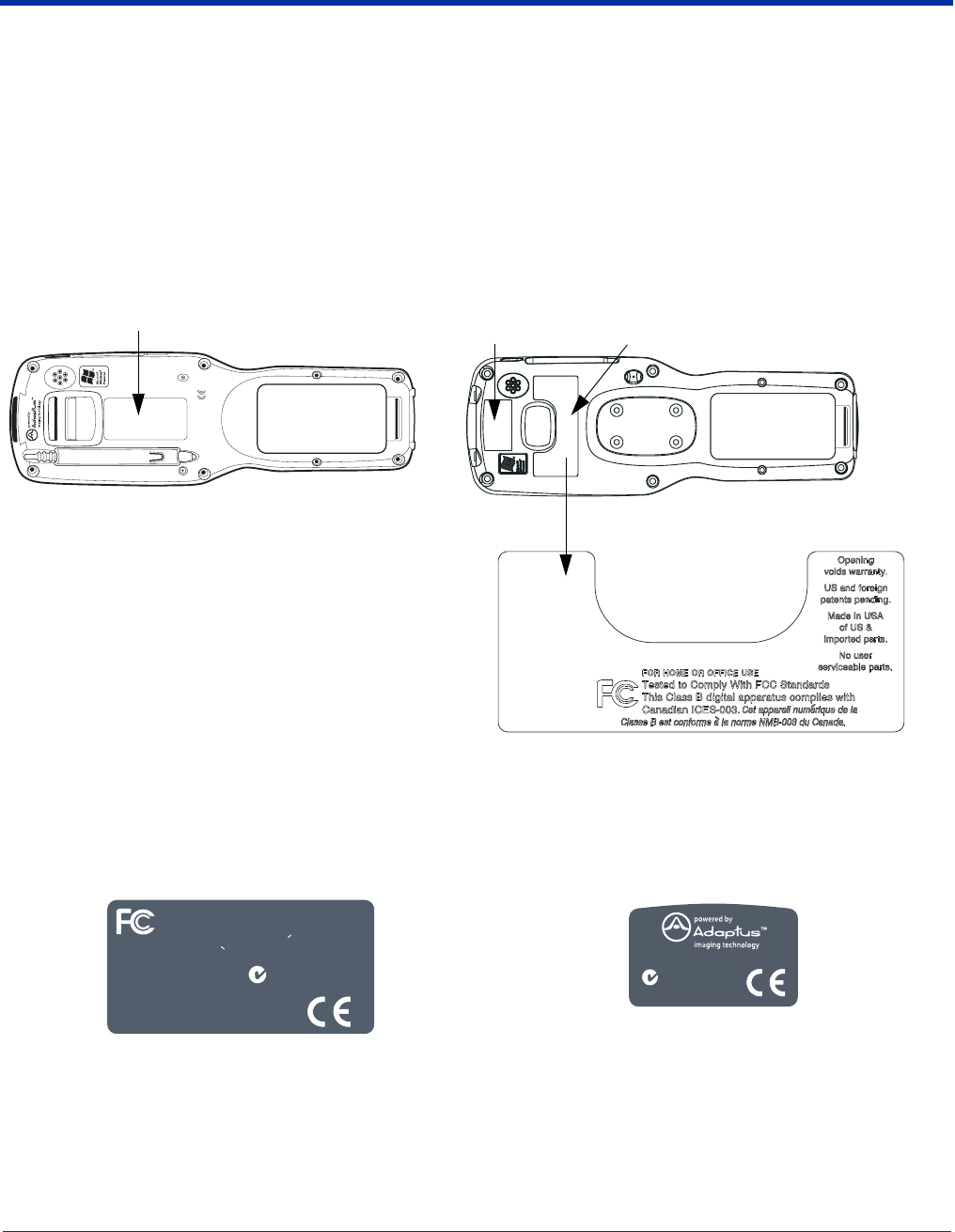
1 - 2 Dolphin® 9500/9550 Mobile Computer User’s Guide - GSM Draft
Required Safety Labels
The Dolphin 9500/9550 mobile computer meets or exceeds the requirements of all applicable standards organizations for safe
operation. However, as with any electrical equipment, the best way to ensure safe operation is to operate them according to the
agency guidelines that follow. Please read these guidelines carefully before using your Dolphin mobile computer.
Location
Safety labels appear on the back panel of both terminals. On the Dolphin 9500 units, the required information is contained in the
label. On the Dolphin 9550, some required information is embedded in the plastic and the rest is in the label.
Dolphin 9500/9550 Batch Terminal
The following are the required safety labels for batch terminals that appear on the back panel:
Dolphin 9500 Dolphin 9550
Dolphin 9500 Dolphin 9550
Safety labels appear here. Safety information is
embedded in the plastic
Safety labels
appear here.
THESE DRAWINGS AND SPECIFICATIONS ARE THE PROPERTY AND CONFIDENTIAL
MATERIAL OF HAND HELD PRODUCTS, INC. AND SHALL NOT BE
REPRODUCED, OR COPIED, OR USED AS A BASIS FOR MANUFACTURE OR SALE
OF EQUIPMENT OR DEVICES WITHOUT WRITTEN PERMISSION. c
REV# REV DESCRIPTION
DESIGNED BY DATE
ARTWORK
LEVEL
TITLE:
A
DRAWING NO: REV
SCALE
DO NOT SCALE
SHEET 1 OF 1
DRAWING NO.
DATE
ECN#
Tested to Comply With FCC Standards
This Class B Digital apparatus complies with
FOR HOME OR OFFICE USE
Canadian ICES-003. Cet appariel numerique de la
Classe B est conforme a la norme NMB-003 du Canada.
N10410
Hand Held Products, Inc.
Skaneateles Falls, NY
Made in USA of US & imported parts.
No user serviceable parts.
Opening Voids Warranty.
www.hhp.com
THESE DRAWINGS AND SPECIFICATIONS ARE THE PROPERTY AND CONFIDENTIAL
MATERIAL OF HAND HELD PRODUCTS, INC. AND SHALL NOT BE
REPRODUCED, OR COPIED, OR USED AS A BASIS FOR MANUFACTURE OR SALE
OF EQUIPMENT OR DEVICES WITHOUT WRITTEN PERMISSION. c REV# REV DESCRIPTION
DESIGNED BY DATE
ARTWORK
LEVEL
TITLE:
ADRAWING NO: REV
SCALE
DO NOT SCALE
SHEET 1 OF 1
DRAWING NO.
DATE
ECN#
N10410
Hand Held Products, Inc. www.hhp.com
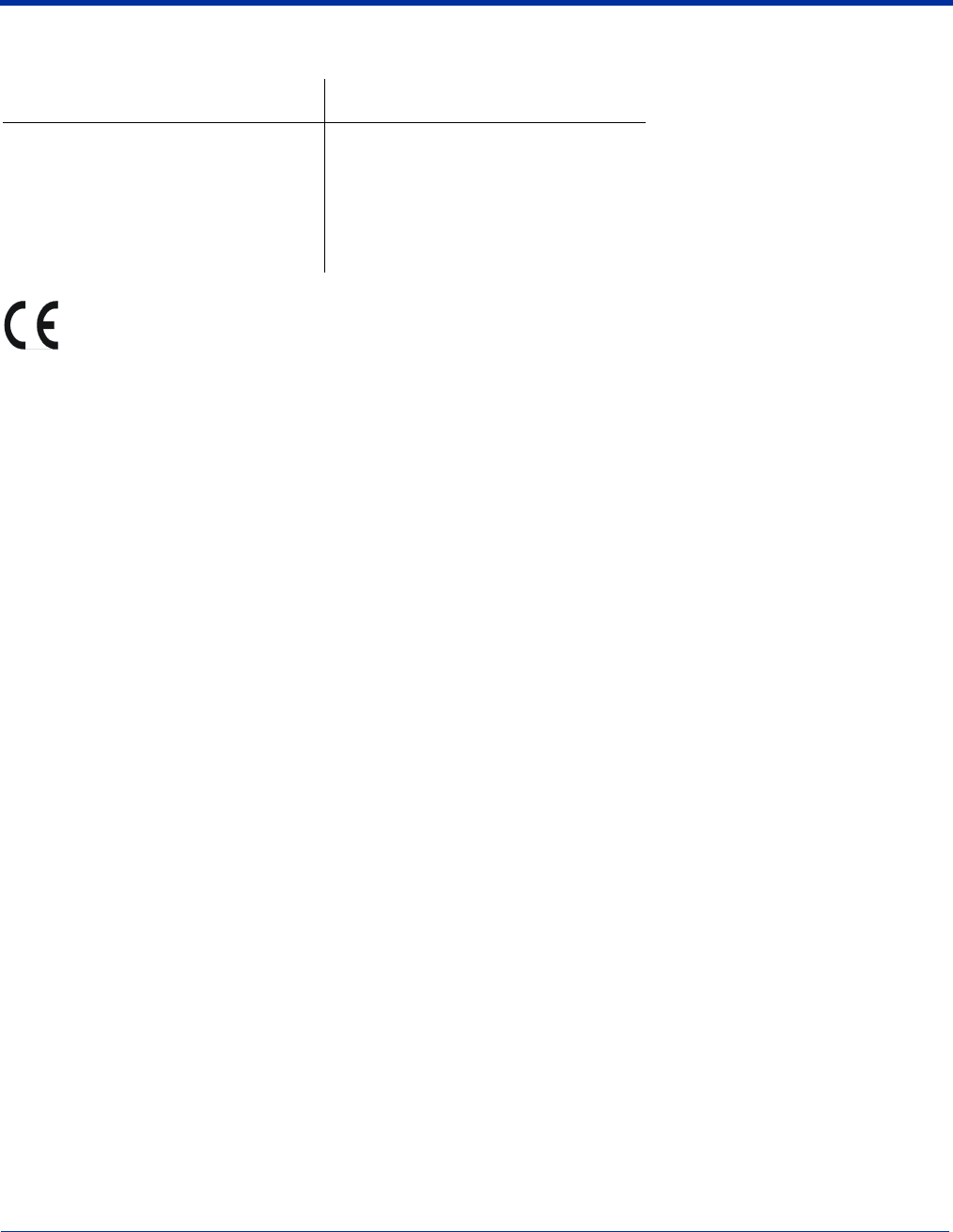
Dolphin® 9500/9550 Mobile Computer User’s Guide - GSM Draft 1 - 3
Regulatory and Safety Approvals for all Dolphin 9500/9550 Terminals
The CE Mark on the product indicates that the system has been tested to and conforms with the provisions noted within
the 89/336/EEC Electromagnetic Compatibility Directive and the 73/23/EEC Low Voltage Directive.
For further information, please contact:
Hand Held Products, Inc.
Nijverheidsweg 9
5627 BT Eindhoven
The Netherlands
HHP shall not be liable for use of our product with equipment (i.e., power supplies, personal computers, etc.) that is not CE
marked and does not comply with the Low Voltage Directive.
Parameter Specification
U.S.A
Canada
European Community
FCC Part 15, Class B
ICES-003
EN 55022 (CISPR 22) Class B
EN60950
EN60825-1
EN55024: 1998
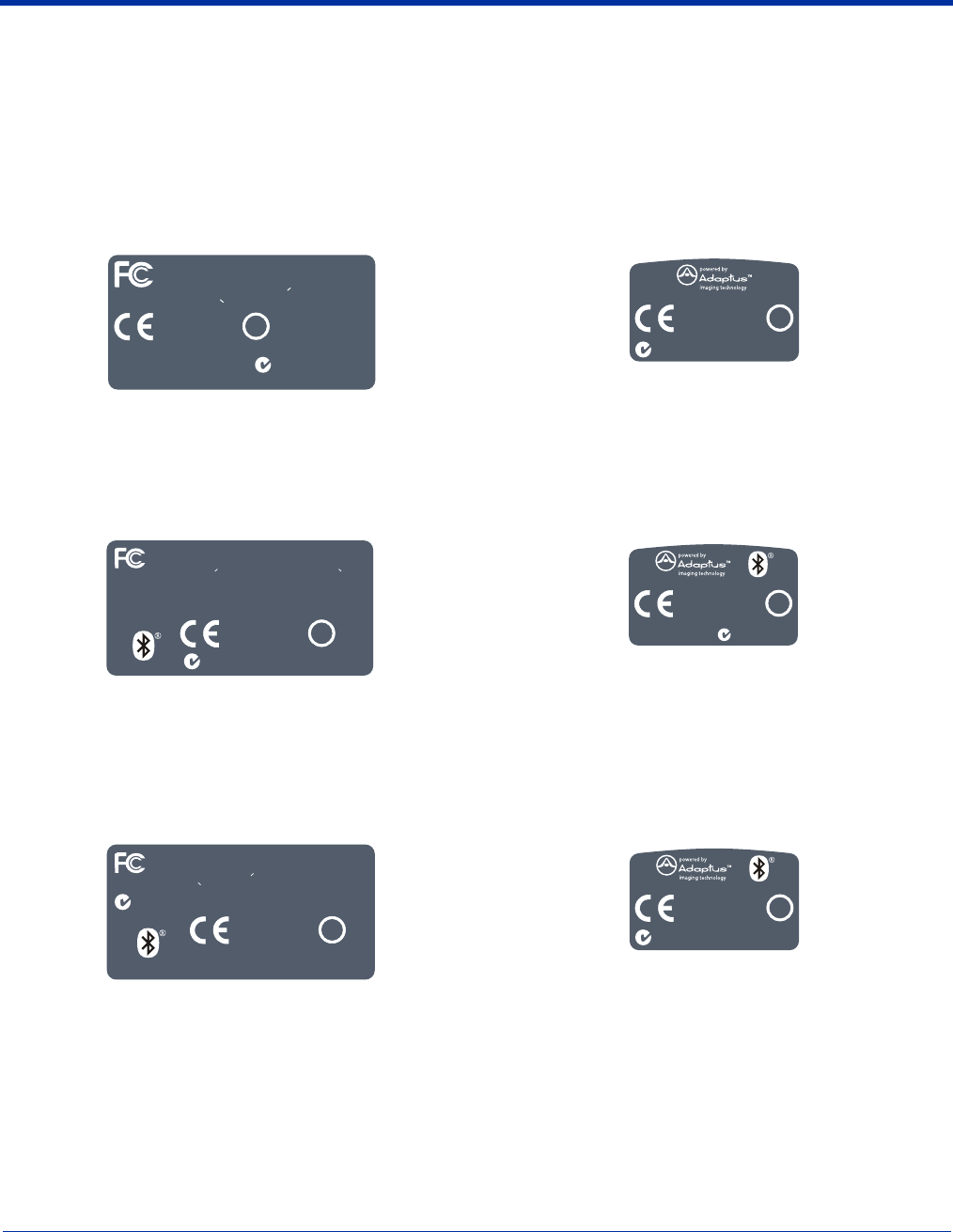
1 - 4 Dolphin® 9500/9550 Mobile Computer User’s Guide - GSM Draft
Dolphin 9500/9550 WLAN or WPAN Radio
The Dolphin® 9500/9550 RF terminal is designed to comply with the most current applicable standards on safe levels of RF
energy developed by the Institute of Electrical and Electronics Engineers (IEEE) and the American National Standards Institute
(ANSI) and has been recommended for adoption by the Federal Communications Commission (FCC).
802.11b
The following is the required safety label that appears on the back panel of Dolphin RF terminals equipped with an 802.11b radio:
Bluetooth
The following is the required safety label that appears on the back panel of Dolphin RF terminals equipped with a Bluetooth radio:
802.11b and Bluetooth
The following is the required safety label that appears on the back panel of the RF terminals equipped with an 802.11b and a
Bluetooth radio combination:
Dolphin 9500 Dolphin 9550
Dolphin 9500 Dolphin 9550
Dolphin 9500 Dolphin 9550
THESE DRAWINGS AND SPECIFICATIONS ARE THE PROPERTY AND CONFIDENTIAL
MATERIAL OF HAND HELD PRODUCTS, INC. AND SHALL NOT BE
REPRODUCED, OR COPIED, OR USED AS A BASIS FOR MANUFACTURE OR SALE
OF EQUIPMENT OR DEVICES WITHOUT WRITTEN PERMISSION. c
REV# REV DESCRIPTION
DESIGNED BY DATE
ARTWORK
LEVEL
TITLE:
A
DRAWING NO: REV
SCALE
DO NOT SCALE
SHEET 1 OF 1
DRAWING NO.
DATE
ECN#
N10410
Tested to Comply With FCC Standards
This Class B Digital apparatus complies with
FOR HOME OR OFFICE USE
Canadian ICES-003. Cet appariel numerique de la
Classe B est conforme a la norme NMB-003 du Canada.
Hand Held Products, Inc. www.hhp.com
Made in USA of US &
imported parts.
No user serviceable parts.
Opening Voids Warranty.
0681
!
Canada: 1693B9503
FCC ID: HD5950003
!
THESE DRAWINGS AND SPECIFICATIONS ARE THE PROPERTY AND CONFIDENTIAL
MATERIAL OF HAND HELD PRODUCTS, INC. AND SHALL NOT BE
REPRODUCED, OR COPIED, OR USED AS A BASIS FOR MANUFACTURE OR SALE
OF EQUIPMENT OR DEVICES WITHOUT WRITTEN PERMISSION. c
REV# REV DESCRIPTION
DESIGNED BY DATE
ARTWORK
LEVEL
TITLE:
A
DRAWING NO: REV
SCALE
DO NOT SCALE SHEET 1 OF 1
DRAWING NO.
DATE
ECN#
Canada: 1693B9503FCC ID: HD5950003
!
0681
!
N10410
Hand Held Products, Inc.
www.hhp.com
THESE DRAWINGS AND SPECIFICATIONS ARE THE PROPERTY AND CONFIDENTIAL
MATERIAL OF HAND HELD PRODUCTS, INC. AND SHALL NOT BE
REPRODUCED, OR COPIED, OR USED AS A BASIS FOR MANUFACTURE OR SALE
OF EQUIPMENT OR DEVICES WITHOUT WRITTEN PERMISSION. c
REV# REV DESCRIPTION
DESIGNED BY DATE
ARTWORK
LEVEL
TITLE:
A
DRAWING NO: REV
SCALE
DO NOT SCALE
SHEET 1 OF 1
DRAWING NO.
DATE
ECN#
N10410
Tested to Comply With FCC Standards
This Class B Digital apparatus complies with Canadian
FOR HOME OR OFFICE USE
ICES-003. Cet appariel numerique de la Classe B est conforme a la
norme NMB-003 du Canada.
Hand Held Products, Inc.
Made in USA of US & imported parts.
No user serviceable parts. Opening Voids Warranty.
0681
!
Canada: 1693B9504
Contains Socket Radio FCC ID: LUBBTM-1
www.hhp.com
!
THESE DRAWINGS AND SPECIFICATIONS ARE THE PROPERTY AND CONFIDENTIAL
MATERIAL OF HAND HELD PRODUCTS, INC. AND SHALL NOT BE
REPRODUCED, OR COPIED, OR USED AS A BASIS FOR MANUFACTURE OR SALE
OF EQUIPMENT OR DEVICES WITHOUT WRITTEN PERMISSION. c REV# REV DESCRIPTION
DESIGNED BY DATE
ARTWORK
LEVEL
TITLE:
ADRAWING NO: REV
SCALE
DO NOT SCALE
SHEET 1 OF 1
DRAWING NO.
DATE
ECN#
Canada: 1693B9504FCC ID: LUBBTM-1
Socket Radio
!
0681
!
N10410
Hand Held Products, Inc.
www.hhp.com
THESE DRAWINGS AND SPECIFICATIONS ARE THE PROPERTY AND CONFIDENTIAL
MATERIAL OF HAND HELD PRODUCTS, INC. AND SHALL NOT BE
REPRODUCED, OR COPIED, OR USED AS A BASIS FOR MANUFACTURE OR SALE
OF EQUIPMENT OR DEVICES WITHOUT WRITTEN PERMISSION. c REV# REV DESCRIPTION
DESIGNED BY DATE
ARTWORK
LEVEL
TITLE:
ADRAWING NO: REV
SCALE
DO NOT SCALE
SHEET 1 OF 1
DRAWING NO.
DATE
ECN#
N10410
Tested to Comply With FCC Standards
This Class B Digital apparatus complies with
FOR HOME OR OFFICE USE
Canadian ICES-003. Cet appariel numerique de la
Classe B est conforme a la norme NMB-003 du Canada.
Hand Held Products, Inc.
Made in USA
of US &
imported parts.
No user
serviceable
parts.
Opening Voids
Warranty.
0681
!
Canada: 1693B9506
FCC ID: HD5950006
www.hhp.com
!
THESE DRAWINGS AND SPECIFICATIONS ARE THE PROPERTY AND CONFIDENTIAL
MATERIAL OF HAND HELD PRODUCTS, INC. AND SHALL NOT BE
REPRODUCED, OR COPIED, OR USED AS A BASIS FOR MANUFACTURE OR SALE
OF EQUIPMENT OR DEVICES WITHOUT WRITTEN PERMISSION. c
REV# REV DESCRIPTION
DESIGNED BY DATE
ARTWORK
LEVEL
TITLE:
ADRAWING NO: REV
SCALE
DO NOT SCALE
SHEET 1 OF 1
DRAWING NO.
DATE
ECN#
Canada: 1693B9506
FCC ID: HD5950006
!
0681
!
N10410
Hand Held Products, Inc.
www.hhp.com
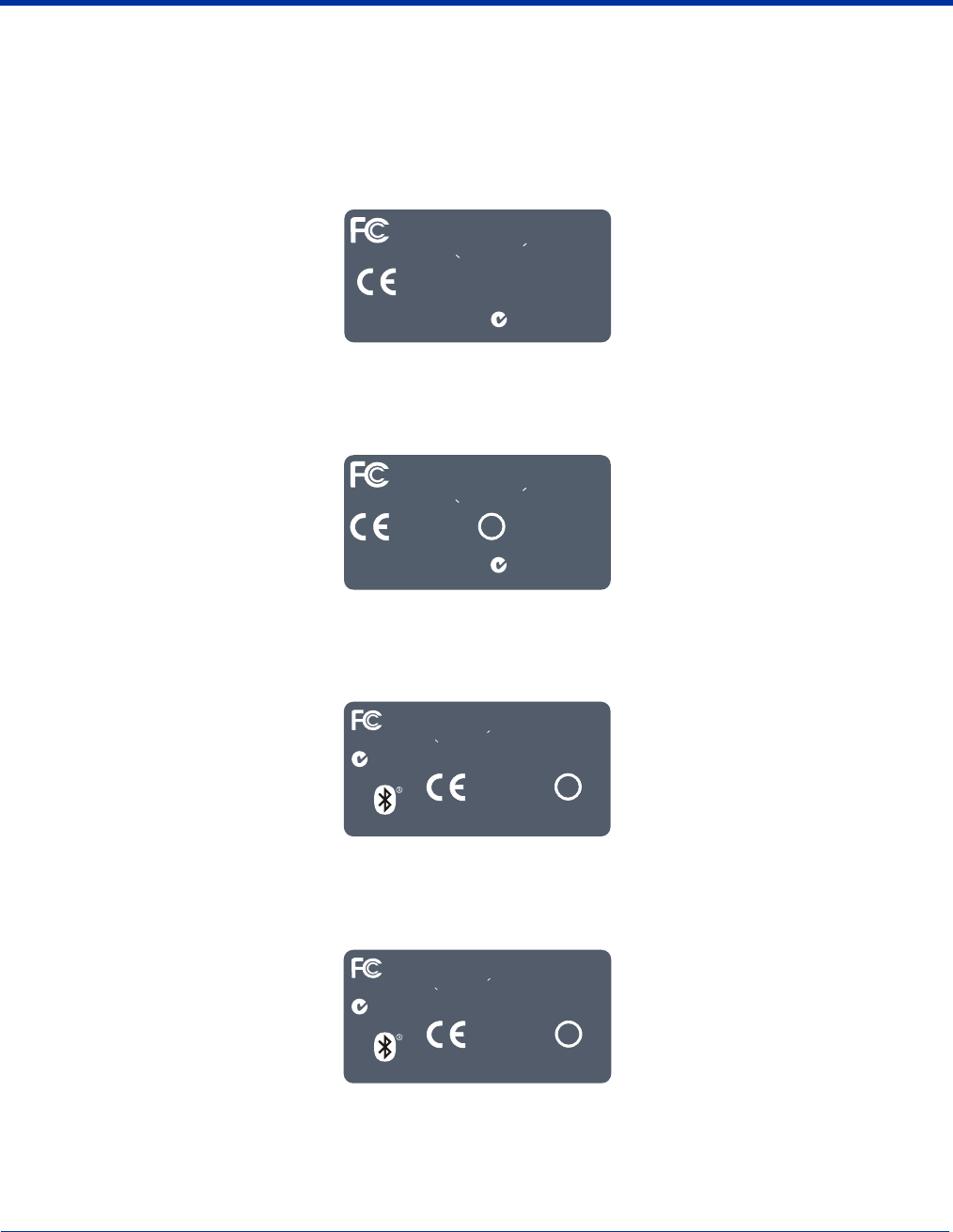
Dolphin® 9500/9550 Mobile Computer User’s Guide - GSM Draft 1 - 5
Dolphin 9500 WWAN Radio
The Dolphin 9500 RF terminal is designed to comply with the most current applicable standards on safe levels of RF energy
developed by the Institute of Electrical and Electronics Engineers (IEEE) and the American National Standards Institute (ANSI)
and has been recommended for adoption by the Federal Communications Commission (FCC).
GSM
The following is the required safety label that appears on the back panel of Dolphin 9500 terminals equipped with a GSM radio:
GSM and 802.11b
The following is the required safety label that appears on the back panel of Dolphin 9500 terminals equipped with a GSM and
802.11b radio combination:
GSM and Bluetooth
The following is the required safety label that appears on the back panel of Dolphin 9500 terminals equipped with a GSM and
Bluetooth radio combination:
GSM, Bluetooth, and 802.11b
The following is the required safety label that appears on the back panel of Dolphin 9500 terminals equipped with a GSM,
Bluetooth, and 802.11b radio combination:
THESE DRAWINGS AND SPECIFICATIONS ARE THE PROPERTY AND CONFIDENTIAL
MATERIAL OF HAND HELD PRODUCTS, INC. AND SHALL NOT BE
REPRODUCED, OR COPIED, OR USED AS A BASIS FOR MANUFACTURE OR SALE
OF EQUIPMENT OR DEVICES WITHOUT WRITTEN PERMISSION. c
REV# REV DESCRIPTION
DESIGNED BY DATE
ARTWORK
LEVEL
TITLE:
A
DRAWING NO: REV
SCALE
DO NOT SCALE
SHEET 1 OF 1
DRAWING NO.
DATE
ECN#
N10410
Tested to Comply With FCC Standards
This Class B Digital apparatus complies with
FOR HOME OR OFFICE USE
Canadian ICES-003. Cet appariel numerique de la
Classe B est conforme a la norme NMB-003 du Canada.
Hand Held Products, Inc. www.hhp.com
Made in USA of US &
imported parts.
No user serviceable parts.
Opening Voids Warranty.
0168
Canada: 1693B9505
FCC ID: HD5950005
THESE DRAWINGS AND SPECIFICATIONS ARE THE PROPERTY AND CONFIDENTIAL
MATERIAL OF HAND HELD PRODUCTS, INC. AND SHALL NOT BE
REPRODUCED, OR COPIED, OR USED AS A BASIS FOR MANUFACTURE OR SALE
OF EQUIPMENT OR DEVICES WITHOUT WRITTEN PERMISSION. c REV# REV DESCRIPTION
DESIGNED BY DATE
ARTWORK
LEVEL
TITLE:
A
DRAWING NO: REV
SCALE
DO NOT SCALE
SHEET 1 OF 1
DRAWING NO.
DATE
ECN#
N10410
Tested to Comply With FCC Standards
This Class B Digital apparatus complies with
FOR HOME OR OFFICE USE
Canadian ICES-003. Cet appariel numerique de la
Classe B est conforme a la norme NMB-003 du Canada.
Hand Held Products, Inc. www.hhp.com
Made in USA of US &
imported parts.
No user serviceable parts.
Opening Voids Warranty.
0168
!
Canada: 1693B9507
FCC ID: HD5950007
!
THESE DRAWINGS AND SPECIFICATIONS ARE THE PROPERTY AND CONFIDENTIAL
MATERIAL OF HAND HELD PRODUCTS, INC. AND SHALL NOT BE
REPRODUCED, OR COPIED, OR USED AS A BASIS FOR MANUFACTURE OR SALE
OF EQUIPMENT OR DEVICES WITHOUT WRITTEN PERMISSION. c REV# REV DESCRIPTION
DESIGNED BY DATE
ARTWORK
LEVEL
TITLE:
A
DRAWING NO: REV
SCALE
DO NOT SCALE
SHEET 1 OF 1
DRAWING NO.
DATE
ECN#
N10410
Tested to Comply With FCC Standards
This Class B Digital apparatus complies with
FOR HOME OR OFFICE USE
Canadian ICES-003. Cet appariel numerique de la
Classe B est conforme a la norme NMB-003 du Canada.
Hand Held Products, Inc.
Made in USA
of US &
imported parts.
No user
serviceable
parts.
Opening Voids
Warranty.
0168
!
Canada: 1693B9508
FCC ID: HD5950008
www.hhp.com
!
THESE DRAWINGS AND SPECIFICATIONS ARE THE PROPERTY AND CONFIDENTIAL
MATERIAL OF HAND HELD PRODUCTS, INC. AND SHALL NOT BE
REPRODUCED, OR COPIED, OR USED AS A BASIS FOR MANUFACTURE OR SALE
OF EQUIPMENT OR DEVICES WITHOUT WRITTEN PERMISSION. c
REV# REV DESCRIPTION
DESIGNED BY DATE
ARTWORK
LEVEL
TITLE:
A
DRAWING NO: REV
SCALE
DO NOT SCALE SHEET 1 OF 1
DRAWING NO.
DATE
ECN#
N10410
Tested to Comply With FCC Standards
This Class B Digital apparatus complies with
FOR HOME OR OFFICE USE
Canadian ICES-003. Cet appariel numerique de la
Classe B est conforme a la norme NMB-003 du Canada.
Hand Held Products, Inc.
Made in USA
of US &
imported parts.
No user
serviceable
parts.
Opening Voids
Warranty.
0168
!
Canada: 1693B9509
FCC ID: HD5950009
www.hhp.com
!

1 - 6 Dolphin® 9500/9550 Mobile Computer User’s Guide - GSM Draft
FCC Compliance
Dolphin mobile computers meet or exceed all applicable standards and have been manufactured to the highest level of quality.
Dolphin 9500/9550 Batch Terminal
Dolphin 9500/9550 Batch terminals comply with part 15 of the FCC rules. Operation is subject to the following two conditions:
1. This device may not cause harmful interference.
2. This device must accept any interference received, including interference that may cause undesired operation.
Dolphin 9500/9550 RF Terminal with 802.11b, Bluetooth, and/or GSM Radios
This device complies with Part 15 of the FCC Rules. Operation is subject to the following two conditions:
1. This device may not cause harmful interference.
2. This device must accept any interference received, including interference that may cause undesired operation.
This equipment has been tested and found to comply with the limits for a Class B digital device pursuant to Part 15 of the FCC
Rules. These limits are designed to provide reasonable protection against harmful interference in a residential installation. This
equipment generates, uses, and can radiate radio frequency energy and, if not installed and used in accordance with the
instructions, may cause harmful interference to radio communications. If this equipment does cause harmful interference to radio
or television reception, which can be determined by turning the equipment off and on, the user is encouraged to try to correct the
interference by one or more of the following measures:
• Reorient or relocate the receiving antenna.
• Increase the separation between the equipment and receiver.
• Connect the equipment into an outlet on a circuit different from that to which the receiver is connected.
• Consult the dealer or an experienced radio/TV technician for help.
If necessary, the user should consult the dealer or an experienced radio/television technician for additional suggestions. The user
may find the following booklet helpful: “Something About Interference.” This is available at FCC local regional offices. Our
company is not responsible for any radio or television interference caused by unauthorized modifications of this equipment or the
substitution or attachment of connecting cables and equipment other than those specified by our company. The correction is the
responsibility of the user. Use only shielded data cables with this system.
In accordance with FCC 15.21, changes or modifications not expressly approved by the party responsible for compliance could
void the user’s authority to operate the equipment.
Note: Dolphin 9550 terminals do not support GSM radios.
This device and its antenna must not be co-located or operating in conjunction with any other antenna or
transmitter. To maintain compliance with FCC RF exposure guidelines for body-worn operation, do not use
accessories that contain metallic components and ensure that the terminal is at least 15mm (0.6 inches) from
the body.
Canadian Compliance
This Class B digital apparatus complies with Canadian ICES-003. Operation is subject to the following two conditions:
1. This device may not cause harmful interference.
2. This device must accept any interference received, including interference that may cause undesired operation.
To prevent radio interference to the licensed service, this device is intended to be operated indoors and away from windows to
provide maximum shielding. Equipment (or its transmit antenna) that is installed outdoors is subject to licensing.
Cet appareil numérique de la Classe B est conforme à la norme NMB-003 du Canada.
!
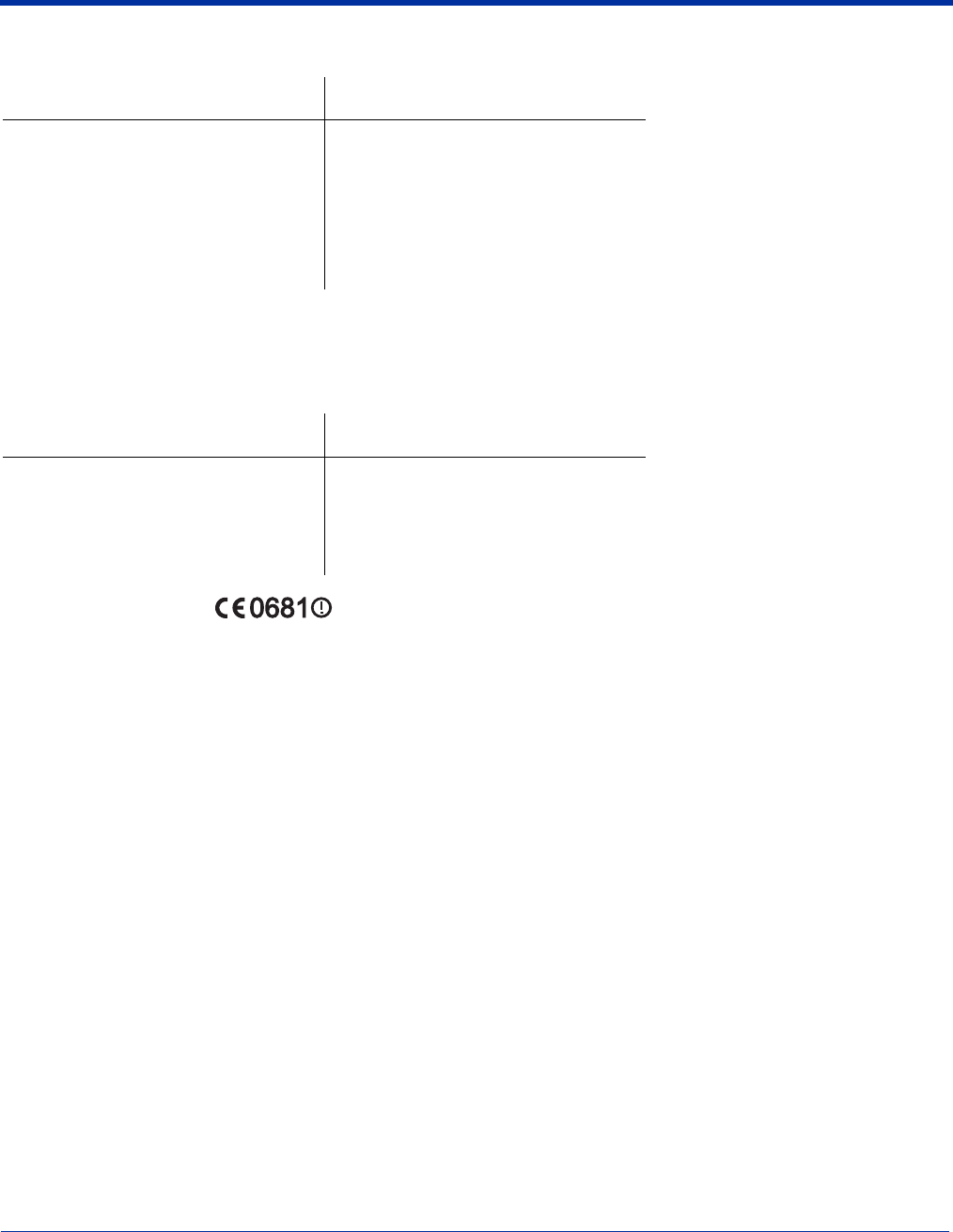
Dolphin® 9500/9550 Mobile Computer User’s Guide - GSM Draft 1 - 7
RF, Regulatory, and Safety Agency Approvals
Dolphin 9500/9550 802.11b, GSM, and/or Bluetooth R&TTE Compliance Statement
The HHP Dolphin 9500RF and Dolphin 9550RF are in conformity with all essential requirements of the R&TTE Directive (1999/
5/EC). This equipment has been assessed to the following standards:
This product is marked with in accordance with the Class II product requirements specified in the R&TTE
Directive, 1999/5/EC.
The equipment is intended for use throughout the European Community. Its authorization for use in France is restricted as
follows:
PAN European Frequency Range: 2.402 - 2.480 GHz
Restricted Frequency Range for use in France: 2.448 - 2.480 GHz
Note: Dolphin 9550 terminals do not support GSM radios.
Pacemakers, Hearing Aids and Other Electrically Powered Devices
Most manufacturers of medical devices adhere to the IEC 601-1-2 standard. This standard requires devices to operate properly
in an EM Field with a strength of 3V/m over a frequency range of 26 to 1000MHz.
The maximum allowable field strength emitted by the Dolphin is 0.3V/m according to Subpart B of Part 1 of the FCC rules.
Therefore, the Dolphin RF has no effect on medical devices that meet the IEC specification.
Microwaves
The radio in the Dolphin RF terminal operates on the same frequency band as a microwave oven. Therefore, if you use a
microwave within range of the Dolphin RF terminal you may notice performance degradation in your wireless network. However,
both your microwave and your wireless network will continue to function.
The Dolphin Batch terminal does not contain a radio, and therefore, is not affected by microwave ovens.
Care and Cleaning of the Dolphin 9500/9550
When needed, clean the image engine window and the LCD display with a clean, non-abrasive, lint-free cloth. The terminal can
be cleaned with a damp cloth.
Parameter Specification
RF Approvals
U.S.A
Canada
Europe
Mexico
FCC Part 15.247
RSS 210
ETS 300 328
Telecom RCPHAD002-485
Parameter Specification
R&TTE EN 300 328-2:2000
EN 301 489-1 (August 2000)
EN 301 489-17 (Sept. 2000)
EN 60950: 1992 Incl Amdt 1-4,11
EN 50361: 2001

1 - 8 Dolphin® 9500/9550 Mobile Computer User’s Guide - GSM Draft

Dolphin® 9500/9550 Mobile Computer User’s Guide - GSM Draft 2 - 1
Getting Started
Overview
The Dolphin 9500/9550 mobile computer is designed for easy, single-handed mobile data collection. Each mobile computer is
equipped with a PXA255 400MHz RISC processor built to run the Pocket PC platform.
Dolphin 9500/9550 computers are available with different types of 2D imagers and wireless radios to meet most any enterprise
mobile data collection requirement. There are three keyboard options and a 240 x 320 pixel, backlit 1/4 VGA display available in
color or monochrome.
The Dolphin 9500/9550 platform contains an integrated imager that can take digital images such as shipping manifests and
recipient signatures in addition to decoding standard linear and two-dimensional symbologies.
Adapting the Dolphin to Your environment
The Dolphin 9500/9550 comprises one element of an enterprise data collection system that includes various models, peripherals,
and accessories that you can combine to suit your exact needs.
2

2 - 2 Dolphin® 9500/9550 Mobile Computer User’s Guide - GSM Draft
Dolphin 9500/9550 Models and Options
HHP’s family of Dolphin 9500/9550 mobile data collection terminals includes these models:
The Dolphin 9500 Batch
This is a Pocket PC mobile computer with a unique, ergonomic shape designed for single-handed use. The standard Dolphin
9500 is available with 64 MB RAM and 32 MB non-volatile Flash and integrated digital imager. An optional Secure Digital (SD)
memory interface offers additional memory. The industrial, mechanical connector supports serial RS-232 up to 115 Kbps and
USB communications at 12 Mbps. It also features an IrDA infrared port to communicate data to portable printers and IrDA
compliant devices.
The Dolphin 9550 Batch
This mobile computer offers the same enhanced productivity features of the Dolphin 9500 terminal with the added convenience
of an integrated pistol grip-style form factor for high volume scanning applications.
The Dolphin 9500/9550 WLAN (802.11b)
These terminals integrate the basic functionality of the Batch terminals with the choice of an integrated 802.11b direct sequence
radio that allows the terminal to communicate with a host computer through a wireless local area network (WLAN).
The Dolphin 9500/9550 WPAN (Bluetooth)
This terminal allows Bluetooth communications to Bluetooth enabled devices such as printers, mobile phones, access points,
Bluetooth-enabled PCs, etc.
The Dolphin 9500/9550 WLAN and WPAN (802.11b and Bluetooth)
This terminal features the capabilities of both 802.11b and Bluetooth configurations.
Image Engine Options
Dolphin 9500/9550 terminals may be equipped with one of the following:
• IMAGETEAM™ 4100SR: red or green aimer option scans from 2.5 to 12.5 in. (6.3 to 32 cm.)
• IMAGETEAM™ 4100SF: red or green aimer option scans from 2.1 to 8.9 in. (5 to 22.6 cm.)
Specifications are for 100% UPC Code.

Dolphin® 9500/9550 Mobile Computer User’s Guide - GSM Draft 2 - 3
Dolphin 9500/9550 Peripherals
Each of the following items is sold separately to enhance your Dolphin 9500/9550 terminals capabilities.
Dolphin HomeBase™
The Dolphin HomeBase charging and communication cradle supports both RS-232 and USB communications, which
enable it to interface with the majority of PC-based enterprise systems. When a terminal is seated in the HomeBase, its
main battery pack charges in less that four hours. In addition, the HomeBase contains an auxiliary battery well that
charges a spare Li-ion battery.
For more information, see Dolphin 9500/9550 HomeBase on page 11-1.
Dolphin Mobile Base
The Dolphin Mobile Base charging and communication cradle is designed specifically for in-premise and in-transit data
collection applications. It features a flexible mounting bracket, a cigarette lighter adapter, and power cable to adapt it to
your environment.
When a terminal is seated in the Mobile Base, its main battery pack charges in less that four hours. The serial connector
supports RS-232 communication and power out to peripheral devices, such as hand held scanners.
For more information, see Dolphin 9500/9550 Mobile Base on page 12-1.
Dolphin ChargeBase
The Dolphin ChargeBase is a four-slot charging cradle that holds, powers, and charges a terminal in each slot.
For more information, see Dolphin 9500/9550 ChargeBase on page 13-1.
Dolphin Net Base
The Dolphin Net Base is a four-slot charging/communication cradle that holds, powers, charges, and communicates
with the terminal in each slot. Communications occurs via Ethernet and dynamically-assigned IP addresses.
For more information about the Dolphin Net Base, please consult the Dolphin 9500/9550 Net Base Quick Start Guide.
Dolphin QuadCharger™
The Dolphin QuadCharger is a four-slot charging station for Dolphin Li-ion battery packs. It can charge each battery in
less than four hours. The fourth slot features a battery analyzer that completely resets and re-calibrates a battery and
displays its resulting capacity.
For more information, see Dolphin 9500/9550 QuadCharger on page 14-1.

2 - 4 Dolphin® 9500/9550 Mobile Computer User’s Guide - GSM Draft
Dolphin 9500/9550 Accessories
Each of the following items is sold separately to enhance your Dolphin 9500/9550 terminals capabilities.
Charging/Communication Cables
USB and serial cables connect the Dolphin 9500/9550 directly to both a peripheral device for communication and a
power source for charging.
Dolphin Mobile Charger
This charging cable plugs the terminal directly into a vehicle cigarette lighter/power port to power the terminal and
charge the battery pack. This accessory converts the 12 Volts out of the vehicle to the 9 Volts required by the terminal.
Protective Enclosure
This enclosure wraps around the terminal to protect it from wear and tear.
Protective Holster
The protective holster secures the terminal for mobile use.
Dolphin Mobile Mount
The Dolphin Mobile Mount solution secures the Dolphin 9500 computers in place in the cab of any vehicle. Used in
conjunction with the Mobile Charger, Dolphin terminals can be adapted to almost any in-transit environment.
Li-ion Battery Pack
The 7.4v, 14.8 watt hour Li-ion rechargeable battery pack provides the main power supply for Dolphin 9500/9550
terminals.

Dolphin® 9500/9550 Mobile Computer User’s Guide - GSM Draft 2 - 5
Bar Code Symbologies Supported
Symbology type Symbologies supported
1D Symbologies Codabar
Code 3 of 9
Code 11
Code 32 Pharmaceutical (PARAF)
Code 93
Code 128
EAN with Add-On and EAN with Extended Coupon Code
EAN-13
Interleaved 2 or 5
Matrix 2 of 5
Plessey
PosiCode
RSS
Straight 2 of 5 IATA
Straight 2 of 5 Industrial
Telepen
Trioptic Code
UCC/EAN-128
UPC and UPC-A
2D Symbologies Aztec
Code 16K
Composite
Data Matrix
MaxiCode
OCR
PDF417
QR
RSS
Composite Codes Aztec Mesa
Codablock F
EAN·UCC
RSS-14
OCR Codes OCR A and OCR B
Postal Codes Postnet and most international 4 state codes
Australian Post
British Post
Canadian Post
China Post
Japanese Post
KIX (Netherlands) Post
Korea Post
Planet Code
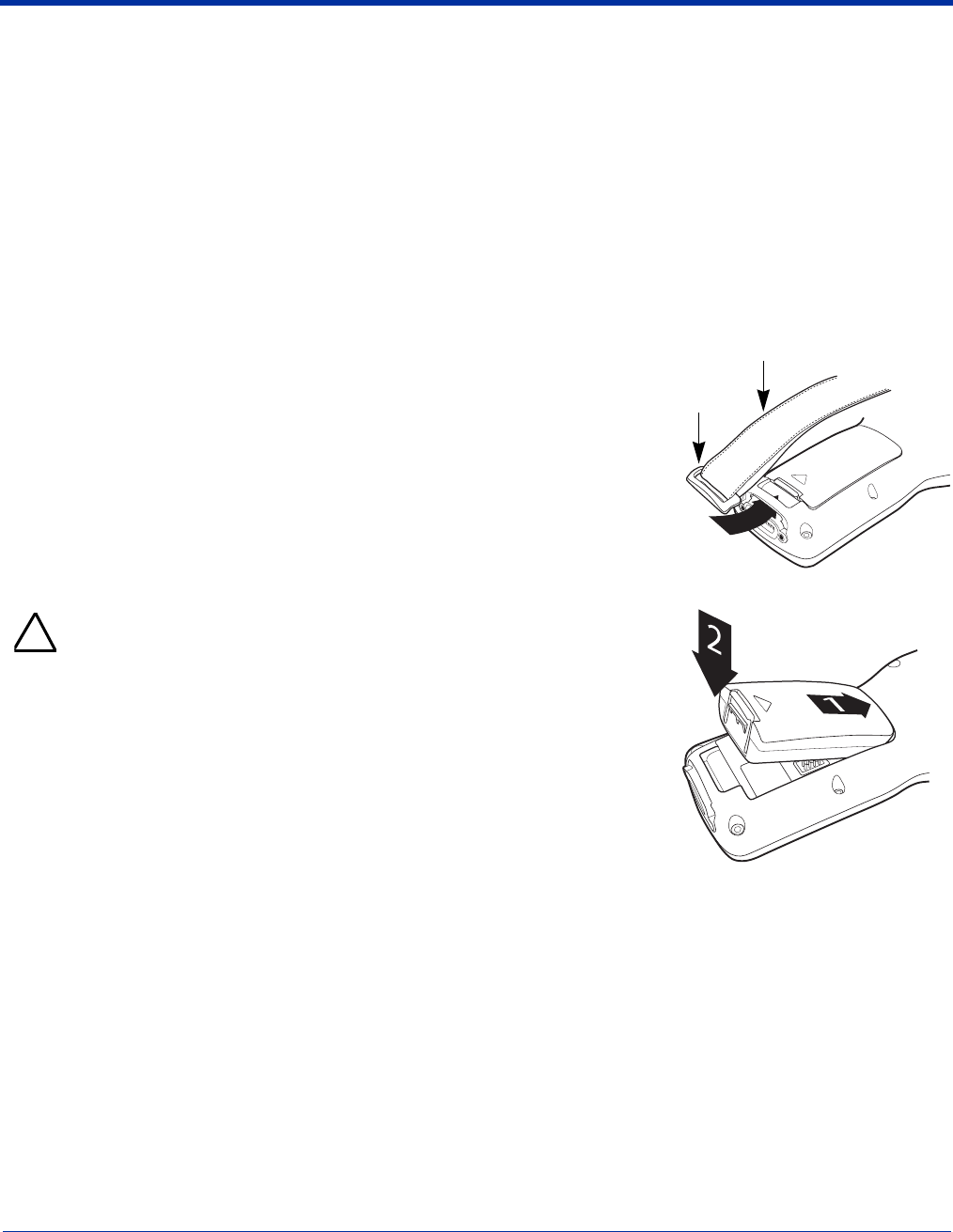
2 - 6 Dolphin® 9500/9550 Mobile Computer User’s Guide - GSM Draft
Using the Dolphin 9500/9550 for the First Time
Step 1. Unpack the Carton and Verify its Contents
Verify that the carton contains the following items:
• Dolphin 9500/9550 mobile computer (the terminal)
• Main battery pack (7.4v Li-Ion)
• Microsoft Companion CD
• Dolphin 9500 Quick Start Guide
Be sure to keep the original packaging in the event that the Dolphin terminal should need to be returned for service. For details,
see Return Information on page 15-2.
Each order includes a Dolphin Software Development Kit and User’s Guide CD; verify that you received this CD with your order.
If you ordered accessories for your terminals, verify that they are also included with the order.
The Dolphin 9500 Handstrap
The Dolphin 9500 ships with the handstrap installed and fastened with a clip on the bottom
panel; see Bottom Panel Features on page 3-9. To install the battery pack, you must
detach the handstrap.
To detach the handstrap, push the clip of the handstrap down and away from the terminal.
Move the strap up and away from the bottom panel.
To re-attach the handstrap, slide the clip back into place on the bottom panel.
Step 2. Install the Main Battery Pack
Use only the Li-ion battery packs provided by HHP. The use of any battery
pack not sold/manufactured by HHP in the Dolphin 9500/9550 terminal will
void your warranty and may result in damage to the Dolphin terminal or
battery.
1. Unpack the Li-ion battery pack. Hold the terminal with the front panel (keyboard)
facing down. On the Dolphin 9500, detach the handstrap.
2. Take the battery and insert the end without the locking tab into the top of the battery
well and push down with a hinging motion until the locking tab snaps.
3. On the Dolphin 9500, re-attach the handstrap.
To Remove the Main Battery Pack
1. Detach the handstrap (on the 9500).
2. Press the locking tab on the battery pack away from the bottom panel, and pull the
battery pack up with a hinging motion.
Step 3. Charge the Main and Backup Batteries
The power supply for the Dolphin mobile computer consists of two types of battery power: the main battery pack installed on the
back panel and the backup battery that resides inside the terminal.
The main battery powers the terminal. The internal backup battery charges off the main battery and maintains the application
data stored in RAM and system clock for up to 30 minutes when the terminal’s main battery pack is completely discharged or
removed.
Before initial use - The terminals are shipped with both batteries discharged of all power. Charge the main battery pack for a
minimum of four hours before initial use.
When installed in the terminal, the battery pack can be charged in the HomeBase, Mobile Base, or with the appropriate charging
cable. When not installed in the terminal, battery packs can be charged in the QuadCharger or the auxiliary well of the
HomeBase.
Time to Charge - Four hours for the main battery pack, eight hours for the internal backup battery the first time.
Clip
Handstrap
!
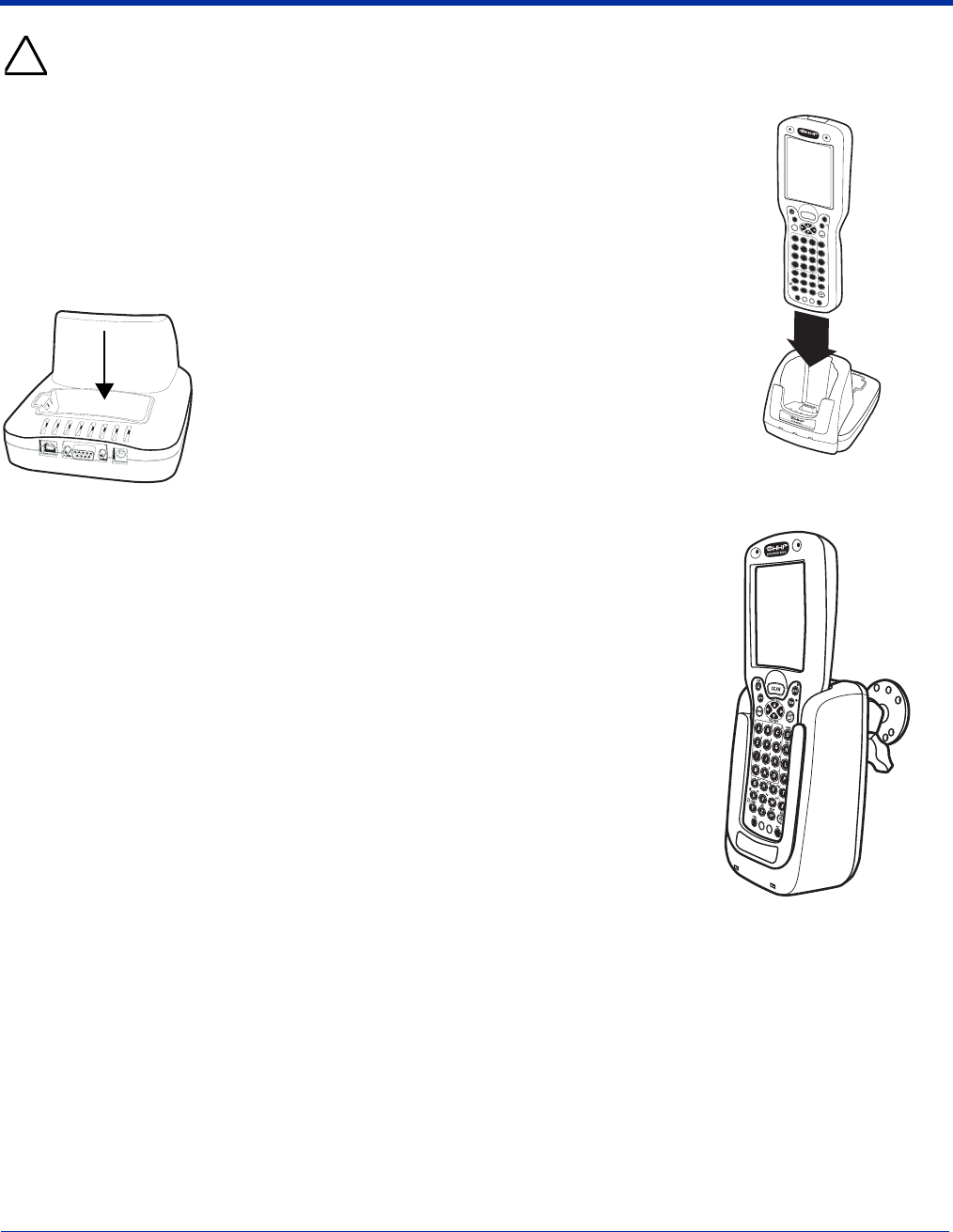
Dolphin® 9500/9550 Mobile Computer User’s Guide - GSM Draft 2 - 7
Use only Dolphin 9500 series peripherals, power cables, and power adapters. Use of peripherals, cables, or power
adapters not sold/manufactured by HHP will void the warranty and may damage the terminal.
Using the Dolphin HomeBase
1. Connect the HomeBase to the power supply provided by HHP.
2. Slide the terminal (with installed battery pack) into the terminal well until the Dock LED
lights solid green to indicate that the terminal is properly seated.
3. The battery pack begins charging.
Using the Mobile Base
1. Connect the Mobile Base to the appropriate power source using an HHP cable.
2. Slide the terminal (with installed battery pack) into the terminal well until the Dock LED
lights solid green to indicate that the terminal is properly seated.
3. The battery pack begins charging.
Other Charging Options
When the Li-ion battery is installed in the terminal, connect a charging/communication
cable to the 17-pin connector and plug the cable into a power outlet.
When the Li-ion battery is not installed in the terminal, place the battery pack in the Dolphin
QuadCharger.
!
DOCK
AUXBATTERY
COMM
DOLPHIN9500
SCAN
ESC
TAB
SFT
ABC
EFG
IJK
MNO
S
R
Q
UVW
YZ
D
H
L
P
T
X
NUM
ENT
123
789
456
;:
*
@
F1F2F3F4
F5F6F7F8
STARTINSBKSPDEL
CTRLALT
SEND
END
POWER
V
O
L
P
G
V
O
L
P
G
+
+
-0
,
SP
Charging a Spare Battery Pack
The HomeBase features an
auxiliary battery well. Insert a spare
battery pack into this well and the
battery charges in four hours. The
auxiliary battery well charges
batteries independently of the
terminal well.
DOCK
COMM
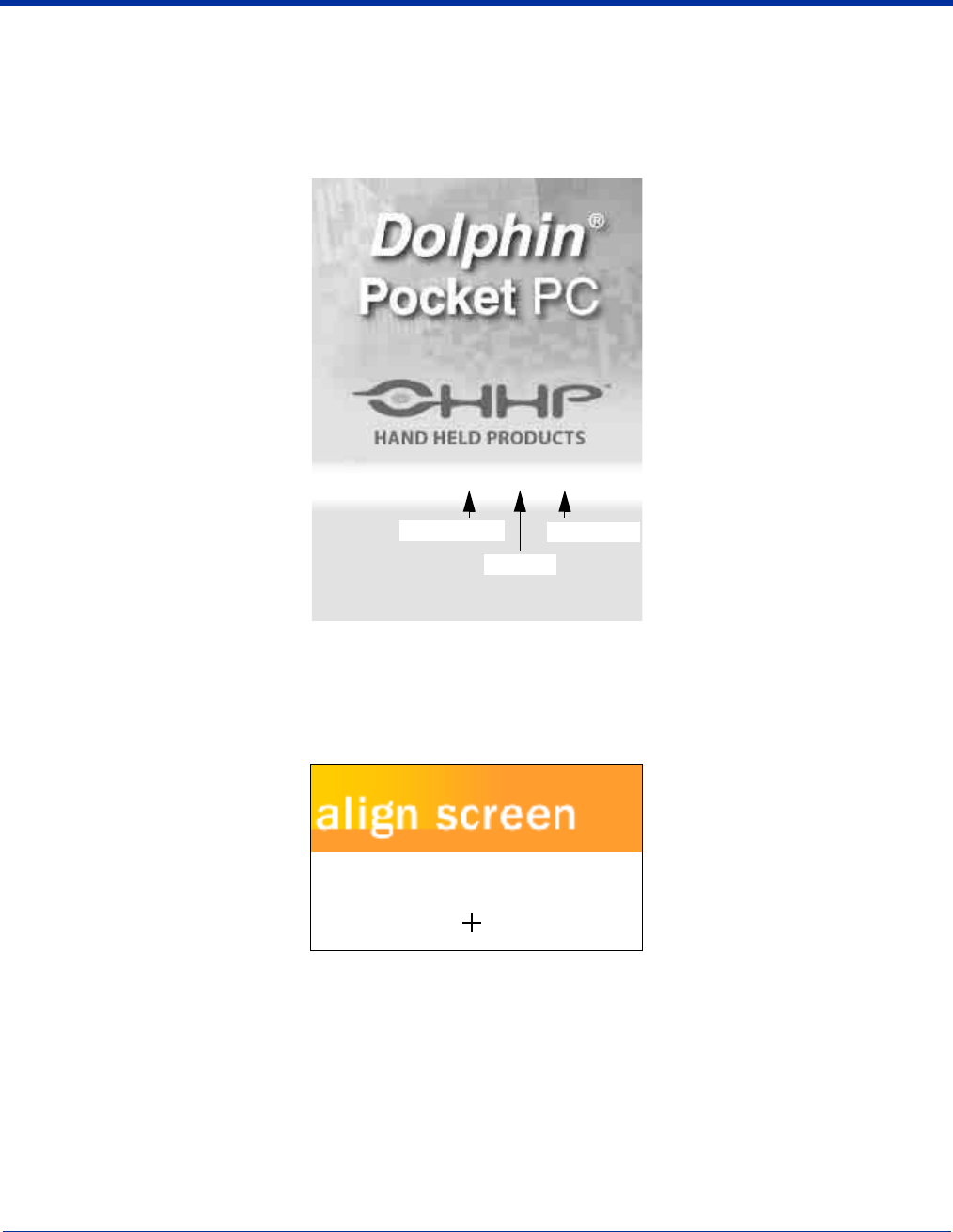
2 - 8 Dolphin® 9500/9550 Mobile Computer User’s Guide - GSM Draft
Step 4. Initialize the Mobile Computer
1. When power is applied from a newly installed battery, the decode LED lights and the scan LED blinks for approximately three
seconds. Do NOT press any keys while the terminal is booting up.
2. The terminal initializes and the HHP splash screen displays for a few seconds. The Build numbers indicate the software
version number.
3. The system performs a hard reset. When the display activates again, follow the instructions that appear.
Step 5. Align the Screen
You are prompted to align the screen by tapping the target five times. Use the stylus provided by HHP.
• Alignment should always be performed with a stylus designed for touch screen applications. The small point is required for
accurate calibration.
• Press the stylus firmly into the center of the cross-hair target once and release. Do not “double-tap” the target.
• You can re-align the screen at any time by going to Start > Settings > System tab > Screen.
Step 6. Complete the Screens
After aligning the screen, follow the directions on the screen which take you through a simple exercise showing how to use the
stylus and pop-up menus.
Build: 5.XX/5.XX/5.XX
Bootloader
Kernel
Keyboard
Tap the target firmly and accurately at
each location on the screen. The target
will continue to move until the screen is
aligned.
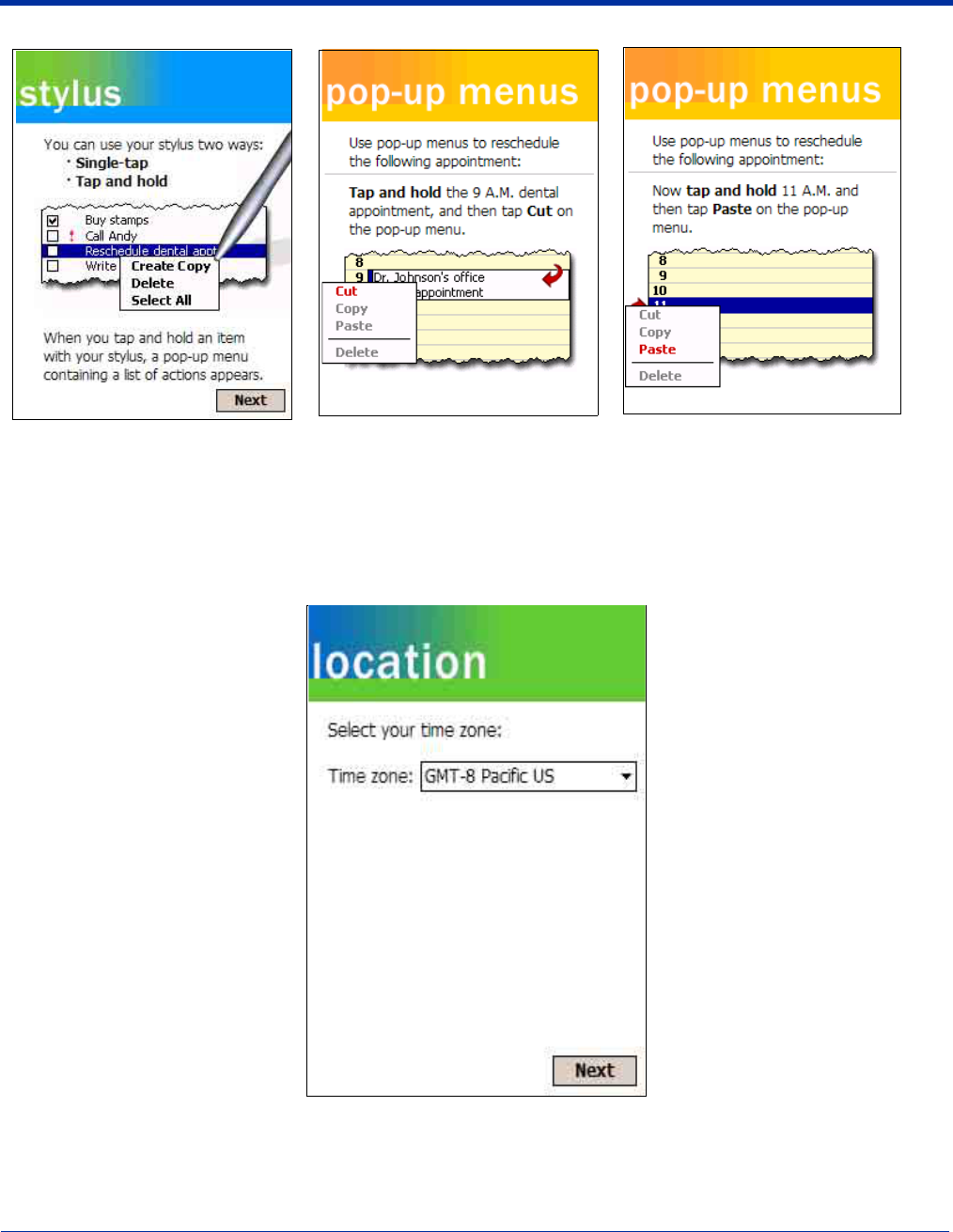
Dolphin® 9500/9550 Mobile Computer User’s Guide - GSM Draft 2 - 9
Note: HHP recommends using screen protectors for Dolphin 9500/9550 terminals; especially for those terminals used within
applications that require high-volume interfacing with the touch screen. Screen protectors help prevent damage to the
touch screen and are easily installed. Screen protectors can be purchased at any major computer retail store or directly
from HHP, Inc. Please contact HHP directly for part numbers and pricing.
Step 7. Set the Time Zone
After screen alignment is completed, the Location screen shown below displays.
Use the drop-down list to select your time zone, and tap Next. This does not necessarily set the correct time; only the time zone.
You set the time and date manually. See Setting the Time and Date on page -10.
After setting the time zone, you are finished with the initial setup of your Dolphin mobile computer. The system begins
autoinstalling.
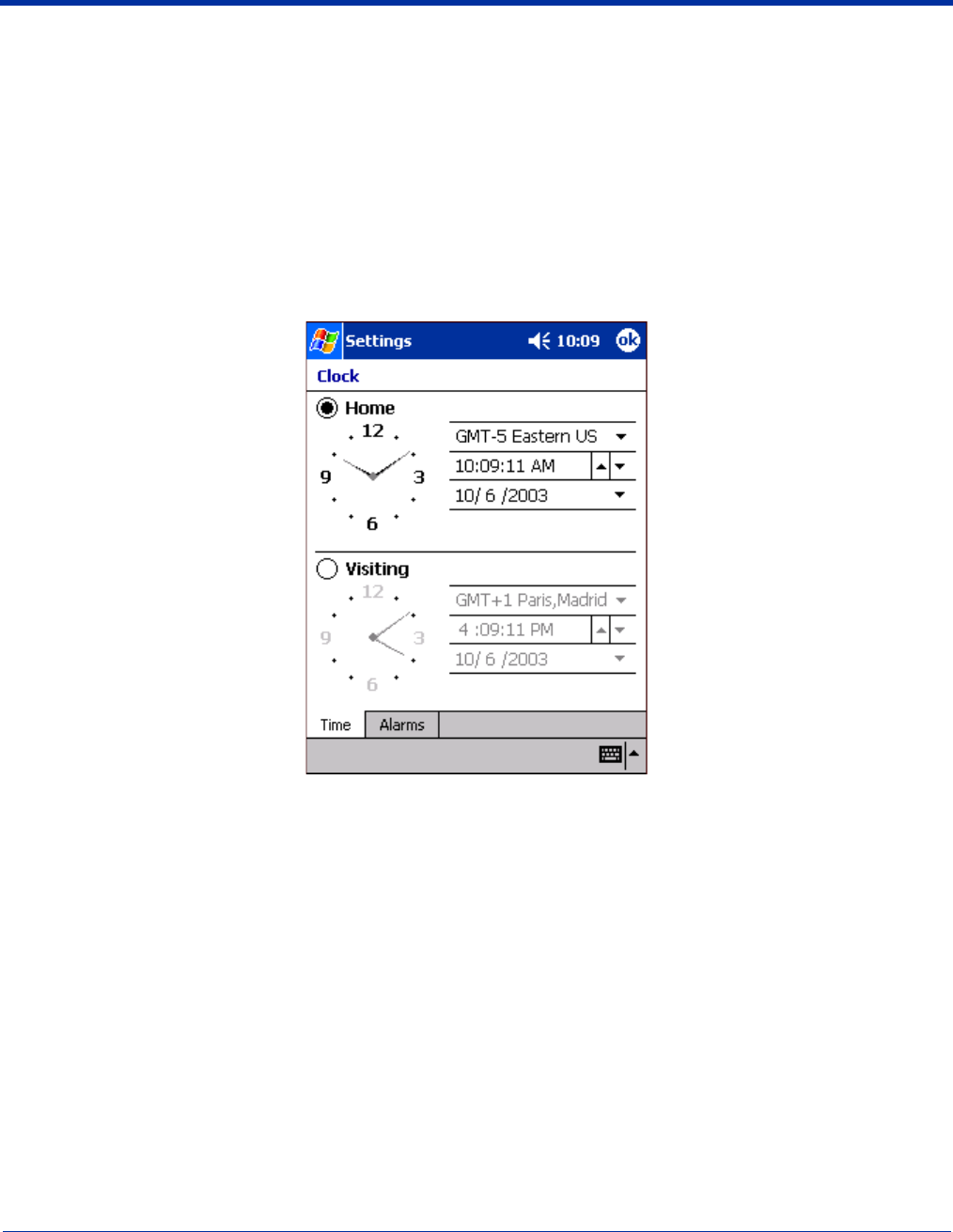
2 - 10 Dolphin® 9500/9550 Mobile Computer User’s Guide - GSM Draft
Step 8. Autoinstall
For each program that loads, a status bar indicates that the program is loading. Autoinstall occurs after each hard reset. Do NOT
touch the keyboard or the screen while programs are loading.
All configurations of the Dolphin 9500/9550 install HHP Demos and HHP Utilities. If the terminal is configured with a wireless
radio, the appropriate radio drivers (*.cabs) and utilities for each radio install.
After Autoinstall is complete, the terminal performs a soft reset automatically. When it finishes booting up after the soft reset, the
Today screen appears; see Today Screen on page 4-2.
Setting the Time and Date
You need to re-set the time and date after every hard reset of the terminal. It is a good idea to set the time and date now before
you begin using the device.
To set the time and date, go to Start > Settings > Systems tab > Clock to set the date and time.
Step 9. Verifying Operations with HHP Demos
The Dolphin 9500/9550 mobile computer comes loaded with HHP Demos you can use to verify imaging and decoding.
Verify Imaging
The Image Demo enables you to use the imager to capture an image.
1. Go to Start > HHP Demos > Image Demo. The image demo opens.
2. Point the terminal at an object and press the SCAN key. A preview of the object appears on the terminal screen.
3. Release the SCAN key. The image is captured. By default, the image saves to the My Device folder as “imagedemo.jpg.” To
save to a different location, go to File > Save As and select a new location.
4. Press the ESC key to close the demo.
For more information about taking an image, see Imager on page 4-6.
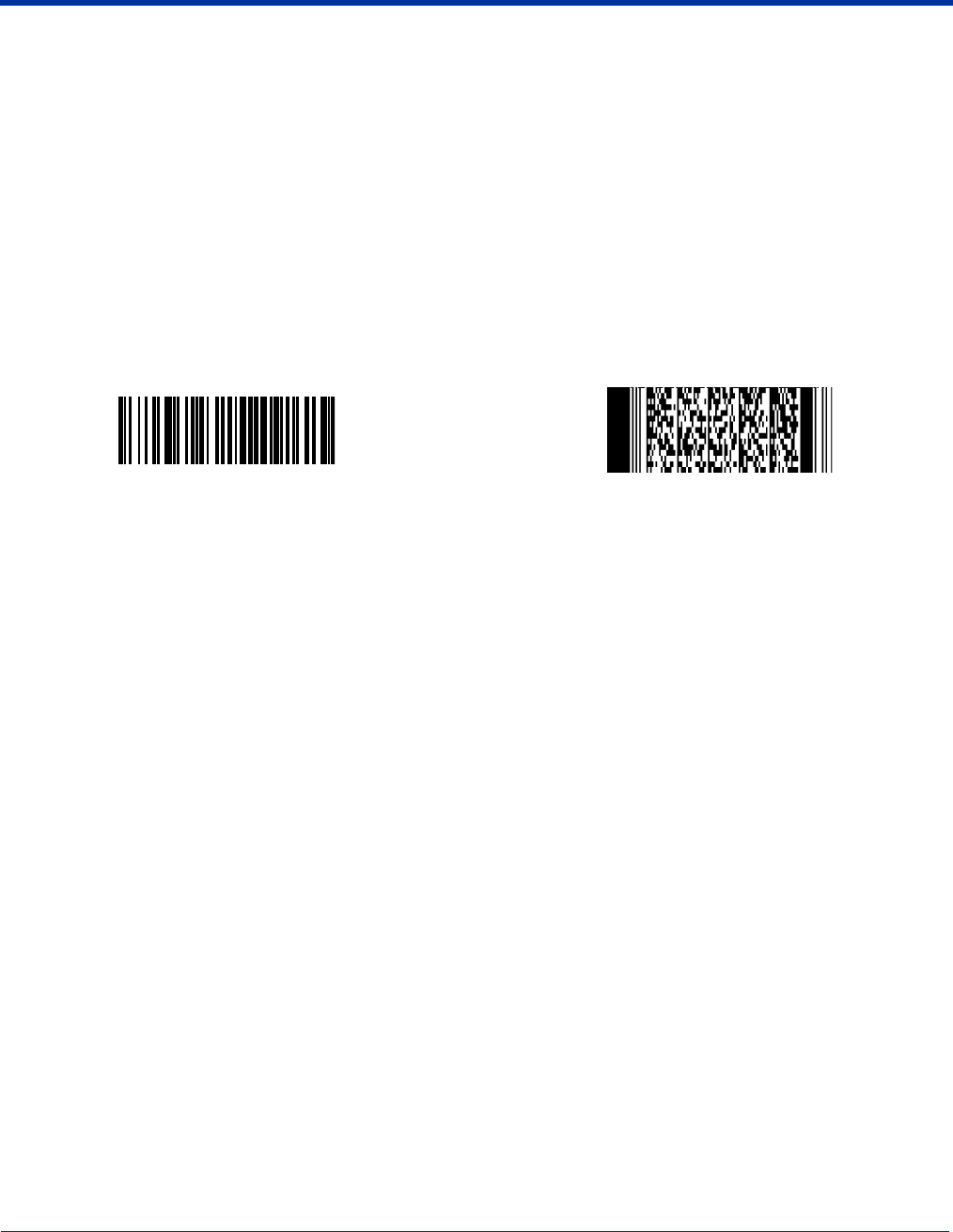
Dolphin® 9500/9550 Mobile Computer User’s Guide - GSM Draft 2 - 11
Verify Decoding
The Scan Demo enables you to decode a sample bar code.
1. Go to Start > HHP Demos > Scan Demo.
2. Aim the terminal at a bar code and press the SCAN key. The decode LED flashes red, the scan LED lights red, and a green
aimer beam projects out from the scanner.
3. When a good scan is obtained, the decode LED lights solid green and the terminal beeps. The bar code readout appears on
the screen.
4. Press the ESC key to close the demo.
Sample Bar Codes
You can use the following bar codes to verify decoding:
For more information, see Decoding a Bar Code on page 4-6.
Sample 128 Sample PDF417
Code 128 PDF417 Test Message

2 - 12 Dolphin® 9500/9550 Mobile Computer User’s Guide - GSM Draft
Resetting the Terminal
Soft Reset (Warm Boot)
You would perform a soft reset if the terminal fails to respond. The soft reset re-boots the device without losing RAM data.
1. Press and hold the Control (CTRL) and the Shift (SFT) keys for approximately five seconds.
2. The decode and scan LEDs flash for approximately three seconds as the terminal resets.
3. When the reset is complete, the Today screen displays.
Hard Reset (Cold Boot)
A hard reset resets the operating system, restores the terminal back to factory defaults, and resets the terminal after a bootloader,
keyboard, and kernel upgrade.
A hard reset erases all of the data stored in RAM memory and all RAM installed applications.
1. Press and hold the Control (CTRL) and the Escape (ESC) keys for approximately five seconds.
2. The decode and scan LEDs light for approximately three seconds.
3. The terminal re-initializes (see page 2-8 for details).
Suspend Mode
To put the Dolphin terminal into suspend mode manually, press and hold the POWER key. The terminal goes into suspend mode
automatically when the terminal is inactive for a programmed period of time. For more information, see Power on page 5-11.
To wake the Dolphin terminal from suspend mode, press the Power or SCAN key.
The Dolphin terminal also goes into suspend mode if you remove the main battery pack while the terminal is powered on. To
wake the Dolphin terminal from suspend mode, simply install a fully charged battery. The terminal powers on.
If the main battery and back-up battery are ever fully discharged of power, the terminal performs a hard reset when power
is restored. The terminal will be restored to its original state. All data stored in RAM memory will be lost.
!
!

Dolphin® 9500/9550 Mobile Computer User’s Guide - GSM Draft 3 - 1
3
Dolphin 9500/9550 Overview
System Features
Processor
The Dolphin 9500/9550 terminal is equipped with an Intel X-Scale 400MHz RISC microprocessor that runs on a 100 MHz RAM
BUS, making it one of the most powerful Pocket PC platforms on the market.
Operating System
The Pocket PC platform is a compact, highly efficient, scalable operating system. Its open architecture facilitates development
of applications for energy-efficient data collection devices like the Dolphin 9500/9550 terminal.
Memory
Main Board - The memory configuration for the Dolphin 9500/9550 terminals is 64 MB RAM and 32 MB non-volatile FLASH.
Secure Digital Card (SD) - Dolphin 9500/9550 terminals contain one Secure Digital (SD) memory interface for additional
application and data storage. Additional secure digital upgrades of 64 MB, 128 MB, and 256 MB are available. The secure digital
card socket is user accessible while preserving the terminal’s environmental rating.
Wireless Radio Options
For more information, see Radio Options on page 4-18.
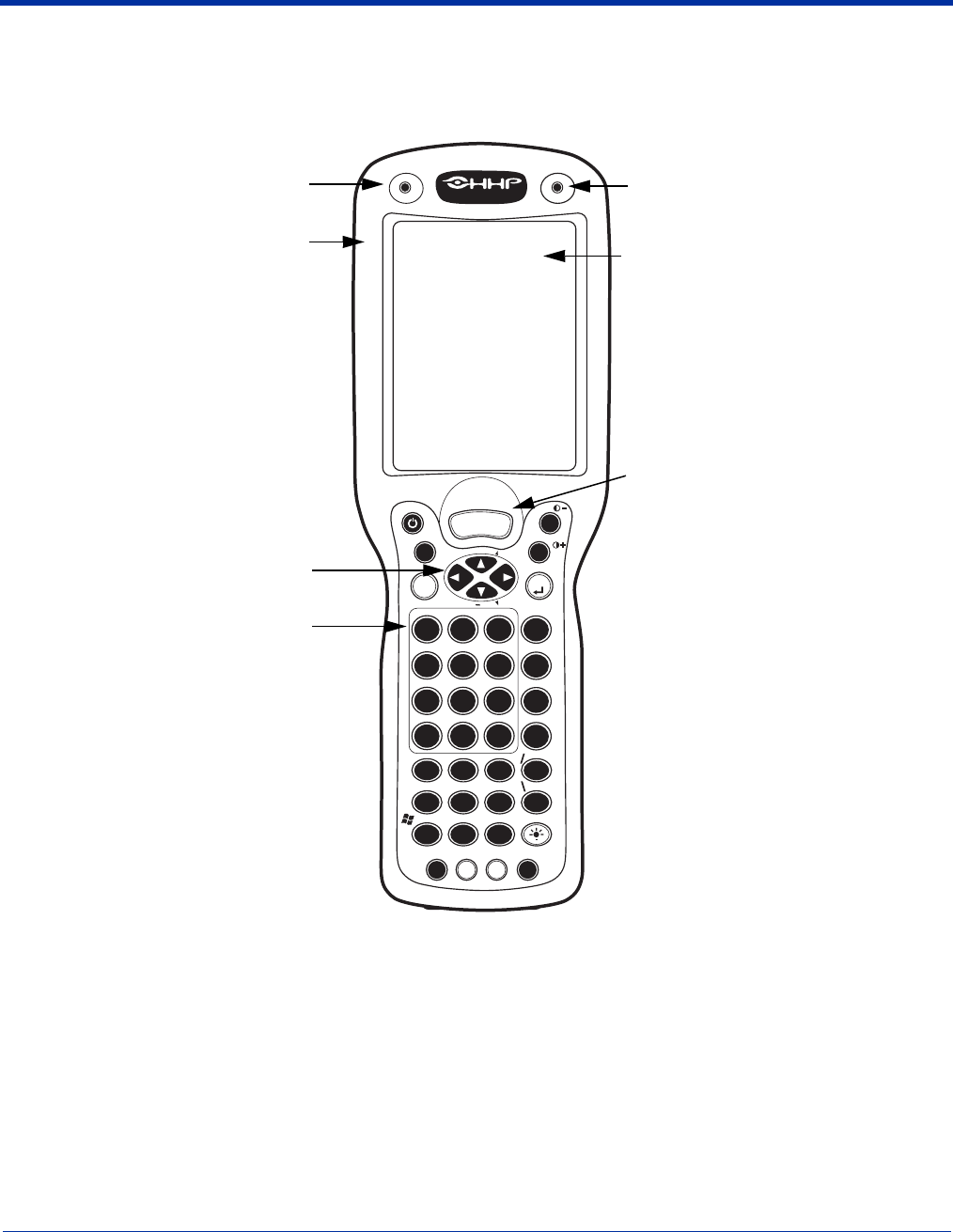
3 - 2 Dolphin® 9500/9550 Mobile Computer User’s Guide - GSM Draft
Front Panel Features
This section describes features on the Dolphin 9500/9550 terminal front panel.
LEDs
The two light emitting diodes (LEDs) located at the top of the LCD display flash and illuminate during resets and
scanning/imaging. Both can be programmed by various software applications.
Scan LED - Located in the upper right corner, this LED lights red when you press the SCAN key.
Decode LED - Located in the upper left corner, this LED lights green when a scanned bar code is successfully decoded.
Display
The Dolphin 9500/9550 terminals feature a 3.5” liquid crystal display (LCD) touch screen and is covered with an
industrial, protective lens. The video graphic array (VGA) resolution is 1/4 (240 X 320 pixel). The touch screen is
activated with the stylus (included with the terminal) or a finger. The LCD display is available in monochrome and color.
Color - The color LCD is 16 bits/pixel and uses active display or thin film transistor (TFT) technology. The backlight for
the display illuminates when the screen is touched, but not when the Backlight key is pressed.
DOLPHIN 9500
SCAN
ESC
TA B
SFT
ABC
EFG
IJK
MNO
S
RQ
UVW
YZ
D
H
L
P
T
X
NUM
ENT
123
789
456
;:
*
@
F1 F2 F3 F4
F5 F6 F7 F8
START INS BKSP DEL
CTRL ALT
SEND
END
POWER
V
O
L
P
G
V
O
L
P
G
+
+
-0
,
SP
Decode LED Scan LED
Display
Navigation keys
SCAN key
Keyboard
Magnesium top cover

Dolphin® 9500/9550 Mobile Computer User’s Guide - GSM Draft 3 - 3
Monochrome - The monochrome LCD is grayscale and 4 bits/pixel. The backlight illuminates when the touch screen
or the Backlight key is pressed. Monochrome units contain an addition contrast setting to enhance readability.
For more information about the Backlight, see Adjusting the Backlight on page 4-15.
SCAN Key
The SCAN key is centrally located for easy access with the right or left hand. When pressed, the SCAN key activates
the scanner/imager. The SCAN key also functions as an on or system wakeup control for the terminal.
Navigation Keys
The centrally-located navigation keys enable you to move and position the cursor through software programs. The up
and down arrows are programmed to perform specific functions when pressed in combination with the Blue and Red
modifier keys.
Keyboard
The Dolphin 9500/9550 series features three keyboard options: 35-key numeric/alpha keyboard, 43-key numeric/alpha
keyboard, and 56-key alpha/numeric keyboard. Each keyboard is backlit for easy viewing in various lighting conditions
and contains centrally located keys for both right- and left-hand operation. The silver background of both the keys and
the overlay enhances the readability of each.
The overlay of all three keyboards are color-coded to indicate the functions performed or characters typed when the
color-coded key is pressed immediately after the Red or Blue Modifier key at the bottom of the keyboard.
For a complete overview of each keyboard, see Using the Keyboards on page 4-9.
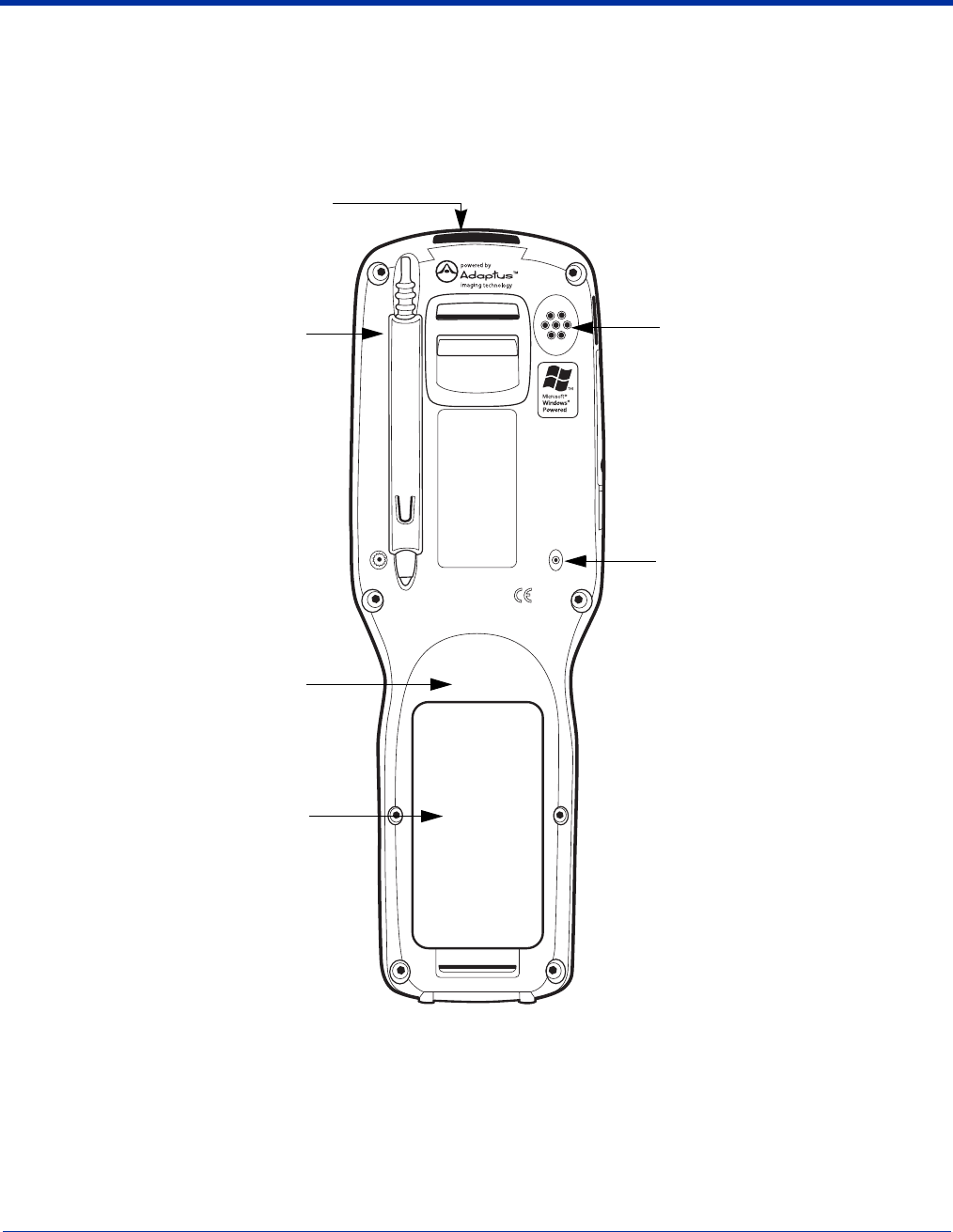
3 - 4 Dolphin® 9500/9550 Mobile Computer User’s Guide - GSM Draft
Back Panel Features
Because the back panel of the Dolphin 9500 and the Dolphin 9550 are different, each is featured in its own section.
Dolphin 9500
The following graphic describes features on the back panel of the Dolphin 9500 terminal.
Image Engine Window
Dolphin 9500/9550 terminals come equipped with an image engine that reads and decodes linear, stacked linear
(PDF417), and 2D matrix bar code symbologies. With the latest CMOS-based technology, the engine works like a digital
camera and enables digital image capture, signature capture, and reading of OCR characters.
Digital images taken with the Dolphin 9500/9550 terminal have a maximum image size of 640 x 480 pixels and may
have up to a 256 grayscale image definition. Files formats supported for image storage include Bitmap (.bmp), JPEG
(.jpg) and Portable Network Graphics (.png).
For a frontal view of the Image Engine Window, see Image Engine Window on page 3-6.
Battery Well
(underneath the battery)
Battery
Image Engine
Window
Stylus (in slot) Speaker
Microphone

Dolphin® 9500/9550 Mobile Computer User’s Guide - GSM Draft 3 - 5
Speaker
The Dolphin 9500/9550 terminal has an integrated speaker that sounds audio signals as you scan bar code labels and
enter data. The operating frequency range is 500Hz at 71 dB up to 80 dB. The speaker can also be used for playing
sounds (e.g., WAV files).
Hand Strap
The Dolphin 9500 has an integrated elastic hand strap to provide a comfortable, secure grip on the terminal. It is
attached to the terminal with a clip on the bottom panel; see Hand strap clip on page 3-9. If desired, the strap may be
adjusted or removed.
Microphone
Dolphin 9500/9550 terminals feature an integrated microphone that provides audio input to the terminal.
Battery/Battery Well
The Battery Well is a recessed area on the back of the Dolphin that holds the Li-Ion battery pack. For more information,
see Batteries on page 3-10.
Stylus
The stylus is used to operate the touch screen. The back panel features this storage slot to hold the stylus when not in
use.
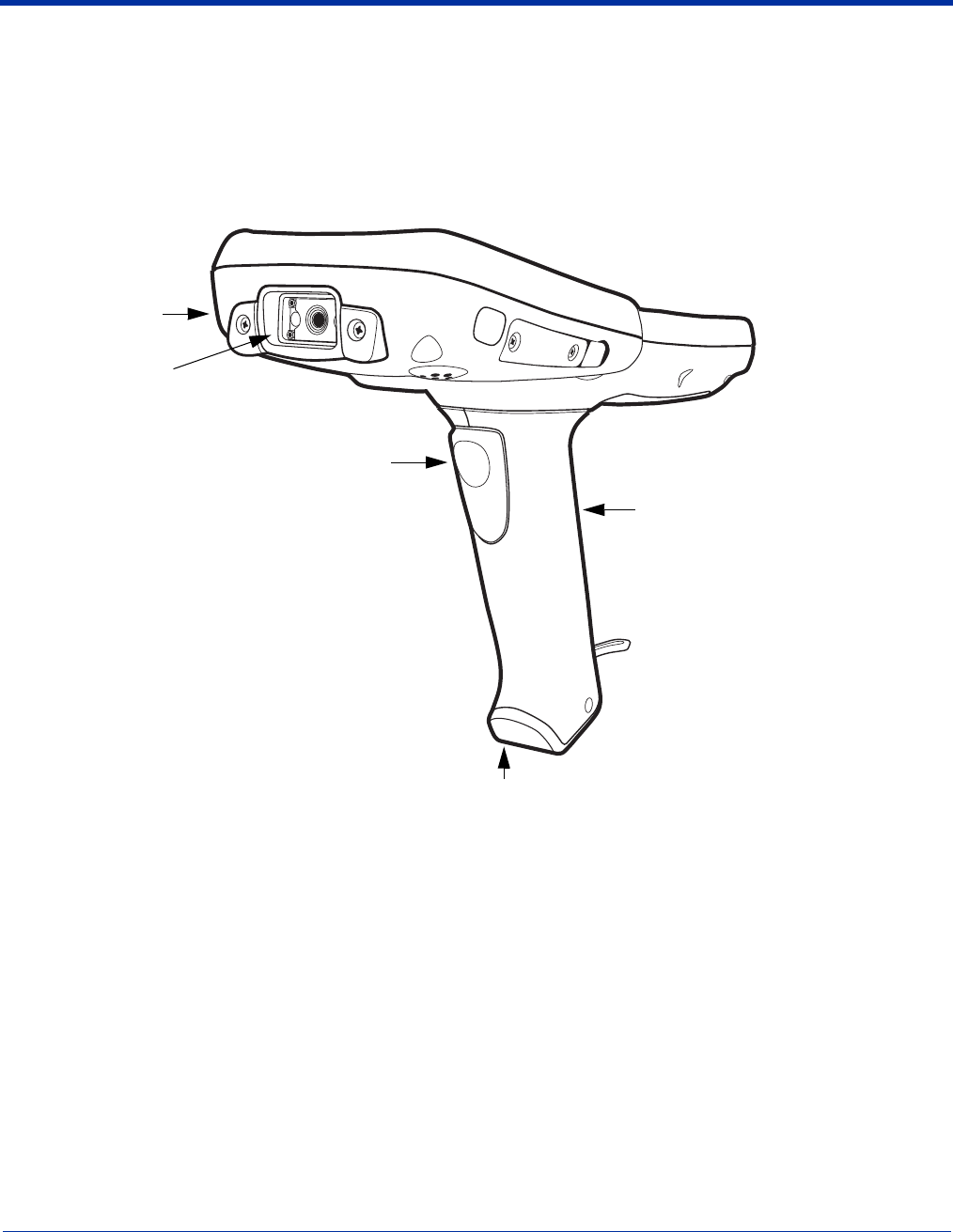
3 - 6 Dolphin® 9500/9550 Mobile Computer User’s Guide - GSM Draft
Dolphin 9550
This section describes the back panel of the Dolphin 9550. It contains the same features as the Dolphin 9500 described in the
previous section with the additions of
• a pistol-grip handle to hold and maneuver the terminal with greater ease,
• a scanner/imager trigger on the handle that activates the scan, and
• rubber bumpers that enable the terminal to rest safely and securely when not in use.
The following is a graphic of the 9550 back panel.
Rubber Bumpers
See Rubber Bumpers on page 3-7.
Image Engine Window
This is the front view of the window. For more information, see Image Engine Window on page 3-4.
Scan Trigger
The scan trigger provides comfortable scan activation.
Pistol Grip Handle
The comfortable, ergonomic handle is integrated into the back panel to enhance the terminals durability in rugged, real-
world settings. The handle was designed specifically for use in rapid, high-volume scanning applications and features
rubber surface details to improve handle grip, comfort, and shock absorption.
Rubber
Bumpers
Pistol-Grip Handle
Scan Trigger
Rubber Bumper
Image Engine
Window
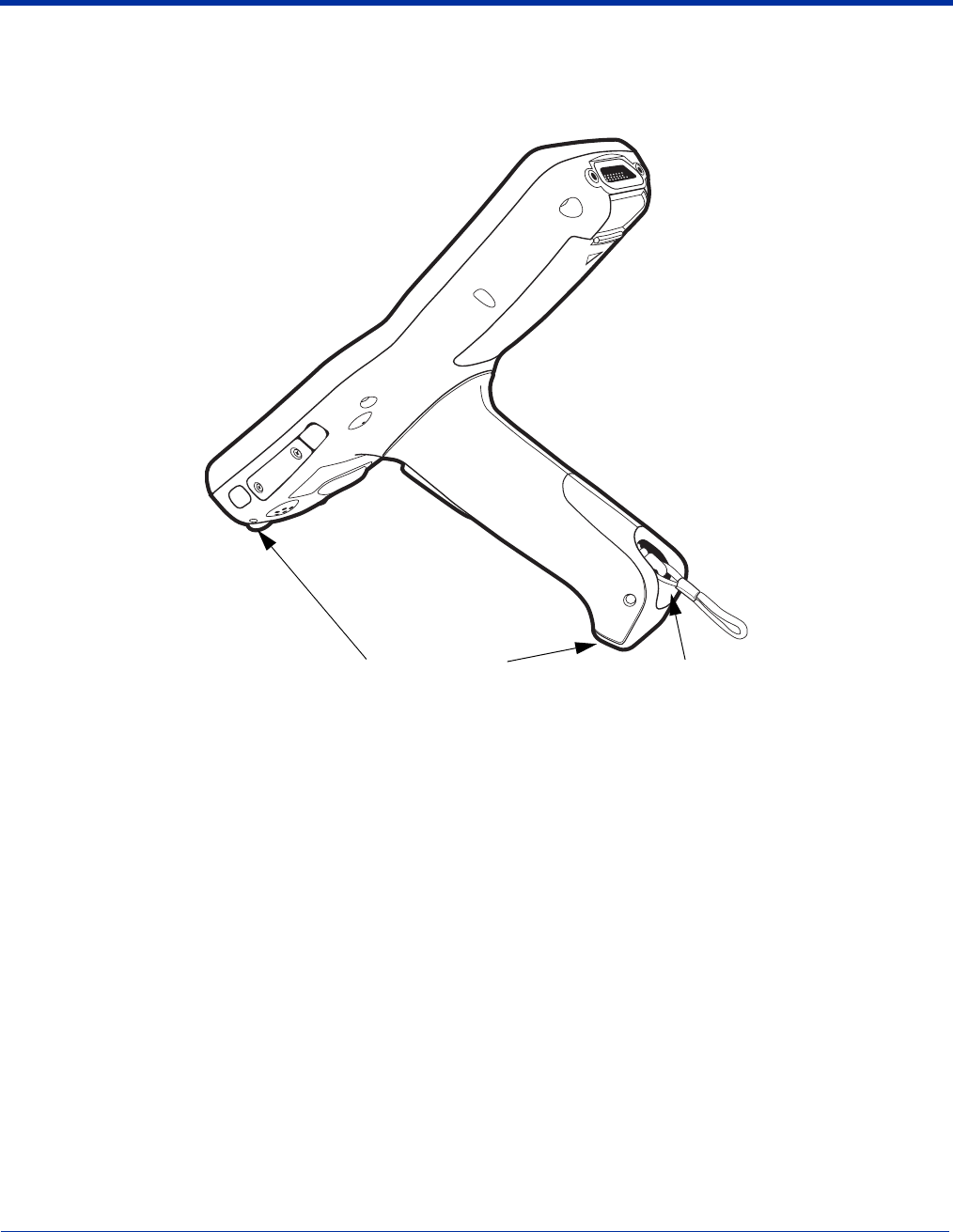
Dolphin® 9500/9550 Mobile Computer User’s Guide - GSM Draft 3 - 7
Rubber Bumpers
The rubber bumpers enable the Dolphin 9550 to rest in a stable, nose-down position when the unit is set on a flat
surface.
The following graphic shows the Dolphin 9550 in a nose-down position, resting on its rubber bumpers.
Stylus
The stylus is used to operate the touch screen display. The Dolphin 9550 stores the stylus inside the pistol-grip handle.
Rubber Bumpers Stylus - inside the handle
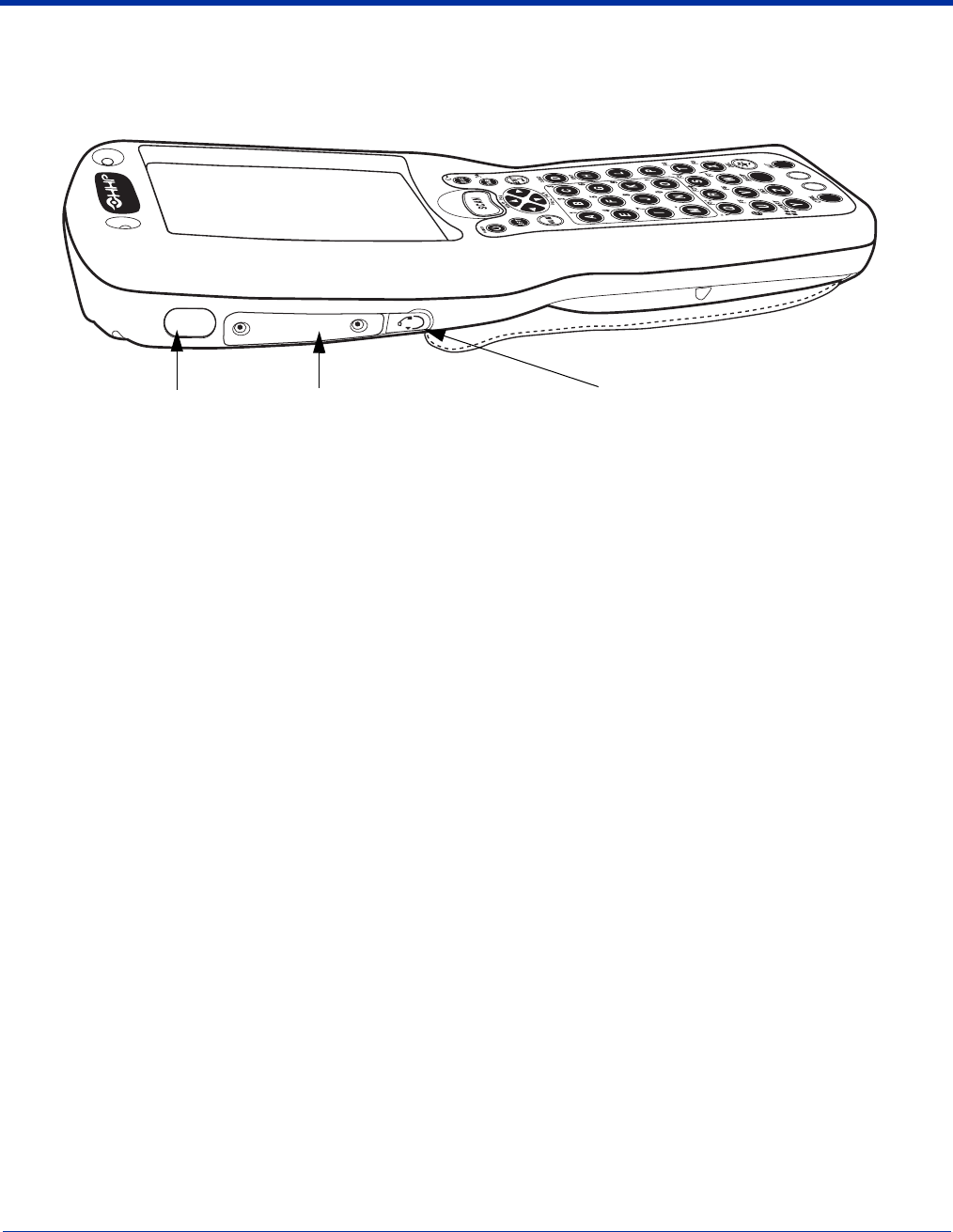
3 - 8 Dolphin® 9500/9550 Mobile Computer User’s Guide - GSM Draft
Side Panel Features
The following graphic shows the left, side panel.
IrDA Port
The Infrared Data Association or IrDA port communicates with IrDA-enabled devices such as PC’s, printers, modems,
or other Dolphin 9500/9550 terminals. The maximum speed is 115kbps.
Secure Digital Memory Interface
Dolphin 9500/9550 terminals have an industry standard Secure Digital (SD) memory interface. The Secure Digital
Access Door seals the memory interface from moisture and particle intrusion and provides secure storage for read/write
data. However, the user can open the access door manually to gain access to the SD.
Terminals can be custom-configured with SD memory of 64MB, 128MB, or 256MB.
Audio Jack
Dolphin 9500/9550 terminals contain a 2.5mm audio jack for stereo audio playback. This jack serves as both a headset
interface or as a microphone to make sound recordings. In both cases, you must use a 2.5mm plug.
DOLPHIN9500
IrDA Port Audio Jack (2.5mm)
Access Door to the Secure Digital
(SD) memory interface

Dolphin® 9500/9550 Mobile Computer User’s Guide - GSM Draft 3 - 9
Bottom Panel Features
This following graphics describe the bottom panel of the Dolphin 9500/9550.
Mechanical Connector
The bottom panel of the Dolphin 9500/9550 features a custom, industrial-grade connector with 17 pins. When seated in a Dolphin
9500 series peripheral, the terminal is powered, the main battery charged, and communication occurs via this connector. All
Dolphin 9500 series peripherals are designed to work exclusively with this connector.
The 17-pin connector can communicate with Dolphin 9500 series peripherals via RS-232 or USB. For RS-232, the maximum
communication speed is 115 Kbps with a seven baud rate setting. For USB, the communication speed is 12 Mbps. If the
peripheral unit is connected to a PC, this connector also transmits data. This serial port is designated as COM port 1 on the PC.
The mechanical connector also provides power out (to peripheral devices) 5V at 500mA. This means that, with the proper HHP
cable, the terminal can power another device.
Pin # Description
1 +USB
2 PWR
3 N / C
4 N / C
5 N / C
6 N / C
7 GND
8 5V OUT
9 DTR
10 -USB
11 USB DET
12 RI
13 DSR
14 RXD
15 RTS
16 TXD
17 CTS
1
10
2
11
3
12
4
13
5
14
6
15
7
16
8
17
9
Mechanical Connector
Hand strap clip
Note: Signals referenced are for a DTE device.

3 - 10 Dolphin® 9500/9550 Mobile Computer User’s Guide - GSM Draft
Batteries
The Dolphin 9500/9550 features intelligent battery technology. It is comprised of two types of battery power: the main battery
pack installed in the back panel and the backup battery located inside the terminal. They are designed to work together to prevent
data loss when the terminal is in use over long periods.
Both must be completely charged before using the Dolphin 9500/9550 for the first time.
Main Battery Pack
Use only the Li-ion battery packs provided by HHP. The use of any battery pack not sold/manufactured by HHP in the
Dolphin 9500/9550 terminal will void your warranty and may result in damage to the Dolphin terminal or battery.
The 7.4V, 14.8 watt hour Li-Ion battery pack is the primary power source for the Dolphin. The Li-Ion battery is designed to operate
in a temperature range of -10 to 50°C (14 to 122°F). They can be stored between -30 to 80°C (-22 to 176°F).
For the location of the Li-Ion battery on the terminal, see Battery/Battery Well on page 3-5.
Charging Options
When the Li-ion battery is installed in the terminal:
• Place the terminal in a HomeBase (page 11-7) or Mobile Base (page 12-4) that is connected to an appropriate power supply.
• Connect a charging/communication cable to the mechanical connector, plug the cable into the AC adapter, and plug the
adapter cable into a power outlet.
When the Li-ion battery is not installed in the terminal:
• Place the battery pack in the Dolphin QuadCharger - see Charging Batteries in the QuadCharger on page 14-3.
• Place the battery pack in the auxiliary battery well of the HomeBase - see page 11-7.
Charging Time
The Li-ion battery pack requires four hours to charge completely.
Internal Backup Battery
Located inside the terminal, the backup battery is a 3.6 Volt nickel metal hydride (NiMH) battery. The internal backup battery must
be replaced by HHP.
Purpose
The internal backup battery prevents the terminal from being reset if you need to remove and replace the main battery pack. It
retains RAM data and allows the real-time clock to remain operational for up to 30 minutes when the main battery pack is
removed.
Charging
The internal backup battery is powered by the main battery pack. Therefore, charging the internal backup battery requires that
the main battery pack be installed in the terminal and the terminal be connected to a charging device.
The internal backup battery must be fully charged before using the terminal for the first time. The initial charge cycle takes
approximately eight hours. After that, if the internal backup battery becomes fully discharged of power, it requires a minimum of
10 hours of charging time to function normally.
If the terminal is left without the main battery pack for more than 30 minutes, the internal backup battery needs to be recharged
to function according to its specifications.
Note: Data and programs stored in flash memory are not lost even if the internal backup battery fails. However, you must reset
the real-time clock using the Pocket PC time and date function; see Setting the Time and Date on page 2-10.
Guidelines
Follow these guidelines to maximize the life of the Dolphin’s backup battery:
• Keep a charged Li-Ion battery pack in the Dolphin. The internal battery prematurely discharges if there is not at least a partially
charged battery in the terminal.
• Put the Dolphin in the HomeBase connected to power when the terminal is not in use.
!

Dolphin® 9500/9550 Mobile Computer User’s Guide - GSM Draft 3 - 11
Managing Battery Power
Data and files saved on the Dolphin 9500/9550 terminal may be stored in RAM, so it is important to maintain a continuous power
supply to the terminal. When the main battery pack becomes low, the Low Battery Charge icon appears in the notification tray at
the top of the screen. The Critical icon appears when the battery is critically low. There is also a Low Battery icon that appears
when the backup battery is low. For details about these icons, see Status Icons on page 4-25.
Letting the backup battery become fully discharged causes the terminal to lose all data in RAM. Therefore, you should keep a
charged battery pack in the Dolphin at all times. The internal battery discharges prematurely if there is not at least a partially
charged battery in the terminal. When you remove a battery pack, insert another charged battery pack in the Dolphin.
The battery status indicator displays in the notification tray when the battery is low or critically low. If there is no indicator, the
battery is adequately charged.
If the main battery is low and the terminal is in suspend mode, pressing the SCAN or Power button does not wake the Dolphin
9500/9550 terminal; you must replace the discharged battery with a fully charged battery.
Default Critical and Low Battery Points
The Dolphin 9500/9550 is programmed to display warnings when the battery reaches critical and low battery points. There are
two entries defined in the registry:
[HKEY_LOCAL_MACHINE\System\CurrentControlSet\Control\Power]
“CriticalBatt”=dword:a
“LowBatt”=dword:19
“CriticalBatt”=dword:a
This sets the Critical Battery point to 10 percent (a hex = 10 decimal). The critical battery setting is the point at which the customer
is warned that the battery charge is very low. This warning is posted every 3 minutes until the situation is corrected.
“LowBatt”=dword:19
This sets the Low battery point to 25 percent (19 hex = 25 decimal). The low battery setting is the point at which the user is notified
that the battery is low. The user is notified only once for a low battery.
Setting Critical and Low Battery Points
Developers can reset these parameters in the registry from 0 (no warning) to 99 (would nearly always warn). Warnings do not
appear when the terminal is on external power.
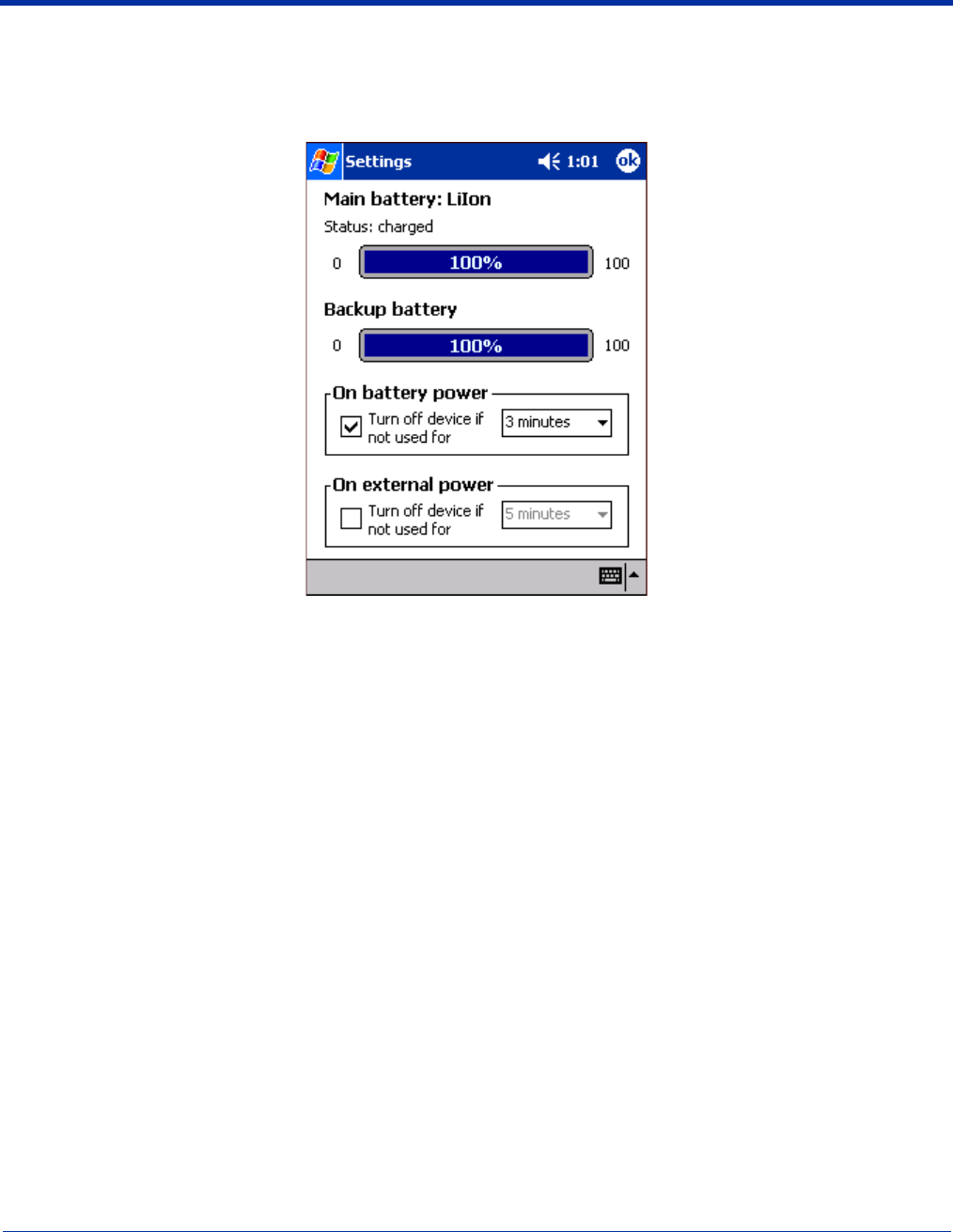
3 - 12 Dolphin® 9500/9550 Mobile Computer User’s Guide - GSM Draft
Checking Battery Power
1. Go to Start > Settings > System tab > Power. The power settings screen appears displaying the charge status of both the
installed Li-ion battery pack and the NiMH backup battery inside the terminal. This screen also displays the Suspend Mode
settings for the terminal.
2. Select your time-out preferences from the drop-down lists. You can have both battery power and external power settings
simultaneously.
3. Tap OK to save the changes and exit.
Storing Batteries
To maintain optimal battery performance, follow the guidelines below when storing:
• Avoid storing batteries outside the specified range of -4 to 104° F (-20 to 40°C) or in extremely high humidity.
• For prolonged storage, do not keep batteries stored in a charger that is connected to a power source.
Guidelines for Battery Use and Disposal
The following are general guidelines for the safe use and disposal of batteries:
• Use only the battery supplied, recommended, or approved by HHP.
• Replace a defective batteries immediately as it could damage the Dolphin terminal.
• Never throw a used battery in the trash. It contains heavy metals and should be recycled according to local guidelines.
• Don’t short-circuit a battery or throw it into a fire. It can explode and cause severe personal injury.
• Excessive discharge damages a battery. Recharge the battery when your terminal indicates low battery power.
• Although your battery can be recharged many times, it will eventually be depleted. Replace it after the battery is unable to
hold an adequate charge.
• If you are not sure the battery or charger is working properly, please send it to HHP or an authorized HHP service center, for
inspection.
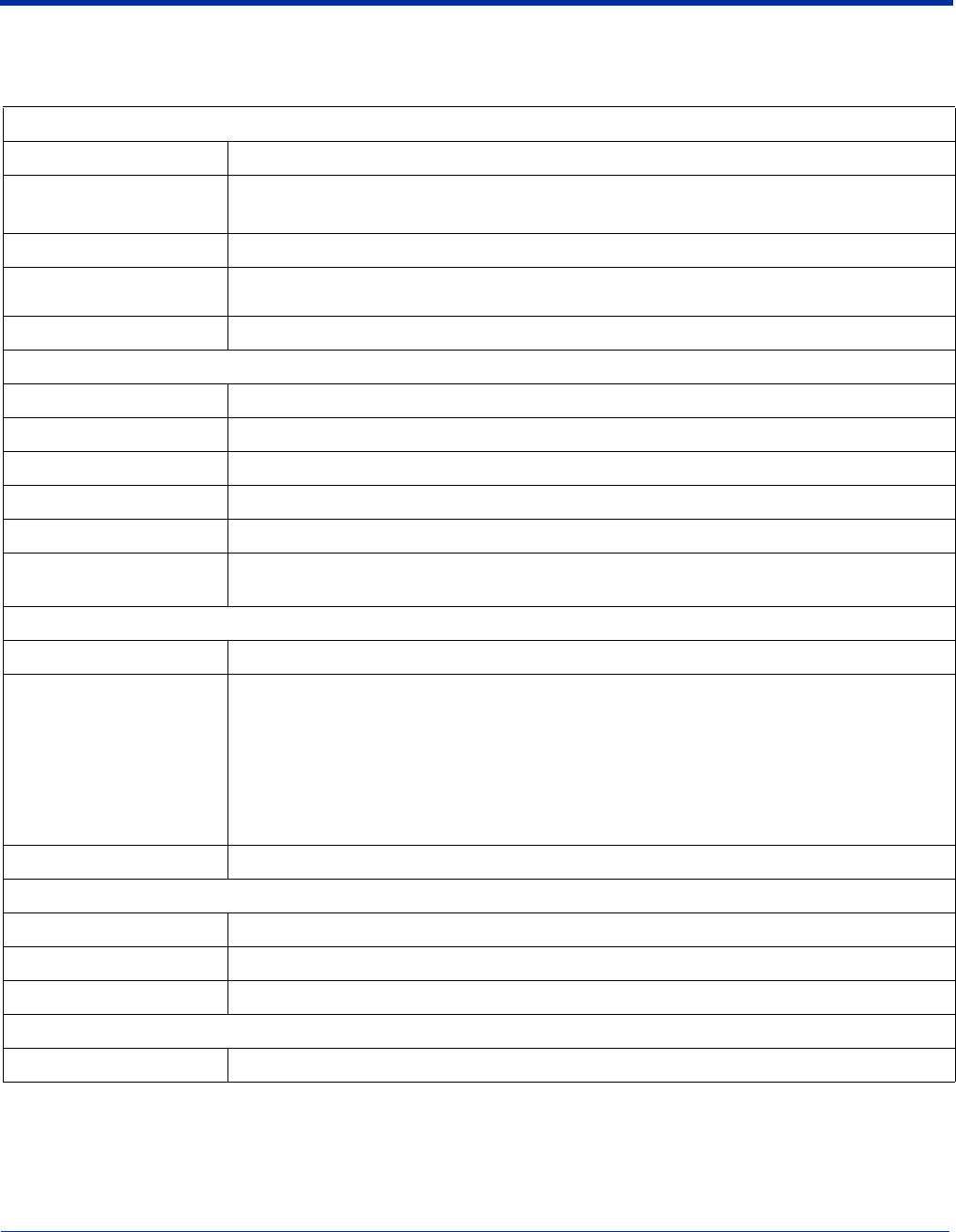
Dolphin® 9500/9550 Mobile Computer User’s Guide - GSM Draft 3 - 13
Dolphin 9500/9550 Technical Specifications
System Architecture
Processor: Intel X-Scale PXA255 400MHz
Development
Environment:
Dolphin SDK for Pocket PC 2002 supports Embedded VB or C++
Dolphin .NET SDK for Pocket PC 2002 supports Visual Studio.NET(VB.NET and C#.NET)
Operating Platform: Pocket PC 2002 Professional Edition
Third-Party Software: Support for Connect Terminal Emulation software (TNVT, 3270, 5250) and Java Virtual Machine
(JVM) runtime
Memory: 64MB RAM x 32MB non-volatile Flash
Data Inputs
Imager/Scanner: See Image Engine Options on page 2-2.
1D Symbologies: See Bar Code Symbologies Supported on page 2-5.
2D Symbologies: See Bar Code Symbologies Supported on page 2-5.
Composite Codes See Bar Code Symbologies Supported on page 2-5.
OCR Fonts: See Bar Code Symbologies Supported on page 2-5.
Three Keyboard Options: 35-key numeric-shifted alpha, 43-key alpha-shifted numeric, and 56-key full alpha/numeric
See Using the Keyboards on page 4-9.
Data Outputs
Display: See Display on page 3-2.
I/O Ports: Custom, industrial-grade, mechanical connector supports
• USB communications at 12Mbps
• Serial RS-232 communication up to 115Kbps
• Charging via peripheral cradles
AC adapter cables
Integrated IrDA port
Integrated audio jack that acts as a speaker and a microphone
Mass Storage: User-accessible Secure Digital (SD) memory interface
Wireless Radio Options
WLAN: IEEE 802.11b DSSS Authentication Methodologies: LEAP, MD5, TLS, TTLS, and PEAP
WWAN: (9500 only) GSM/GPRS Tri-band (900, 1800, 1900 MHz) radio with accessible SIM card interface
WPAN: Bluetooth radio
Physical
Dimensions: 9.6"L x 3.45"W x 1.66"D at display (24.53 x 8.76 x 4.23 cm), 2.7"W x 1.5"D at grip (6.9 x 3.8 cm)

3 - 14 Dolphin® 9500/9550 Mobile Computer User’s Guide - GSM Draft
Weight: 9500 Terminal –
Batch: 19.7 oz. (558 gm)
WLAN: 20.2 oz. (573 gm)
WPAN: 20 oz. (567 gm)
WLAN/WPAN: 20.3 oz. (576 gm)
9550 Terminal –
Batch: 23.4 oz. (663 gm)
WLAN: 23.9 oz. (677.5 gm)
Operating Temperature: 14 to 122°F (-10°C to 55°C)
The terminal can operate in temperatures lower than -20°C with potential degradation in
performance depending on the application
Storage Temperature: -22 to 176°F (-30°C to 80°C)
Humidity: 95% humidity, non-condensing
Electrical Static
Discharge: 15 kv on all surfaces
Impact Resistance: Withstands multiple 5ft. (1.5m) drops onto concrete
Environmental
Resistance: Independently certified to meet IP64 standards for moisture and particle resistance
Power: Lithium-Ion battery technology – 7.4V, 14.8 watt-hour main battery with hot-swappable design
for fast replacement in the field
Other: Integrated stylus with optional tether and removable hand strap
Peripherals/Accessories
Dolphin HomeBase Charging/communications cradle with auxiliary battery well. Data transfer via RS-232 serial or
USB ports.
Dolphin Mobile Base Mobile charging/communication cradle. Data transfer via RS-232 serial. Power out 5 volts for
peripheral devices.
Dolphin QuadCharger Four-slot battery charger that charges four batteries in under four hours. One slot doubles as a
battery analyzer.
Dolphin Mobile Charger Charges a Dolphin terminal by plugging into a vehicle cigarette lighter/power port.
Dolphin Net Base Four-slot charging/communication cradle designed for Ethernet-based communications.
Dolphin ChargeBase Four-slot charging cradle that holds, powers, and charges a terminal in each slot.
Charging/Communication
cables USB or serial cables that charge and communicate with the terminal directly–without a cradle.
Li-Ion Battery Pack 7.4V, 14.8 watt hour Li-ion rechargeable main battery for the Dolphin.
Regulatory Approvals
FCC-CE-Radio Country: US/Canada, R&TTE
Dolphin 9500/9550 Technical Specifications

Dolphin® 9500/9550 Mobile Computer User’s Guide - GSM Draft 4 - 1
4
Using the Dolphin 9500/9550 Mobile Computer
Entering Data
To enter data, you may:
• Use the 35-key, 43-key, or 56-key keyboards
• Capture images or scan bar code data into data fields
• Use the Soft Input Panel (SIP) to enter text
• Write directly on the screen
• Draw pictures on the screen
• Use Microsoft® ActiveSync® to synchronize or copy information from your desktop computer. For more information on
ActiveSync, see ActiveSync Help on your desktop computer. For information on communicating with ActiveSync, see Using
ActiveSync on page 6-2.
Touch Screen
HHP recommends using screen protectors to protect the touch screen; especially when used with applications that require high-
volume interfacing with the touch screen. Screen protectors help prevent damage to the touch screen display and are easily
installed. Screen protectors can be purchased at any major computer retail store or directly from HHP.
For touch screen input, use the included stylus or your finger. The method you choose depends on which one is
appropriate for your application. While there is a great deal of variation in different applications, for buttons or icons that
are close together, you generally achieve greater accuracy with the stylus. Use of other objects, such as paper clips,
pencils, or ink pens can damage the input panel and will void the warranty.
!
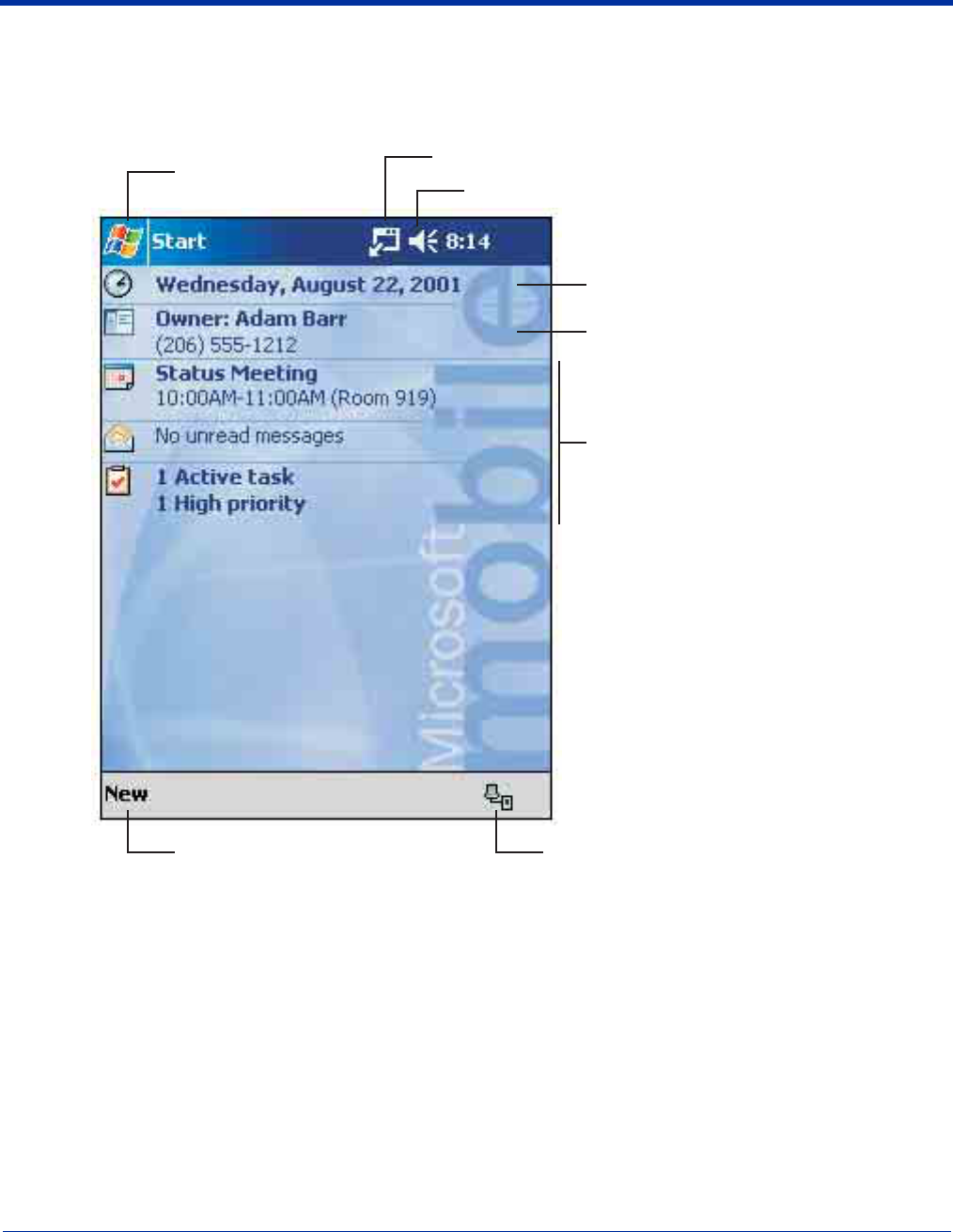
4 - 2 Dolphin® 9500/9550 Mobile Computer User’s Guide - GSM Draft
Today Screen
When you turn on your device for the first time, you see the Today screen. You can also display it by tapping Start and then
Today. On the Today screen, you can see at a glance important information for the day.
Your day at a glance.
Tap to create a new item.
Tap to switch
to a program.
Tap to view notification messages.
Tap to view connection status.
Tap to change date and time.
Tap to open an item.
Tap to change volume or mute all sounds.
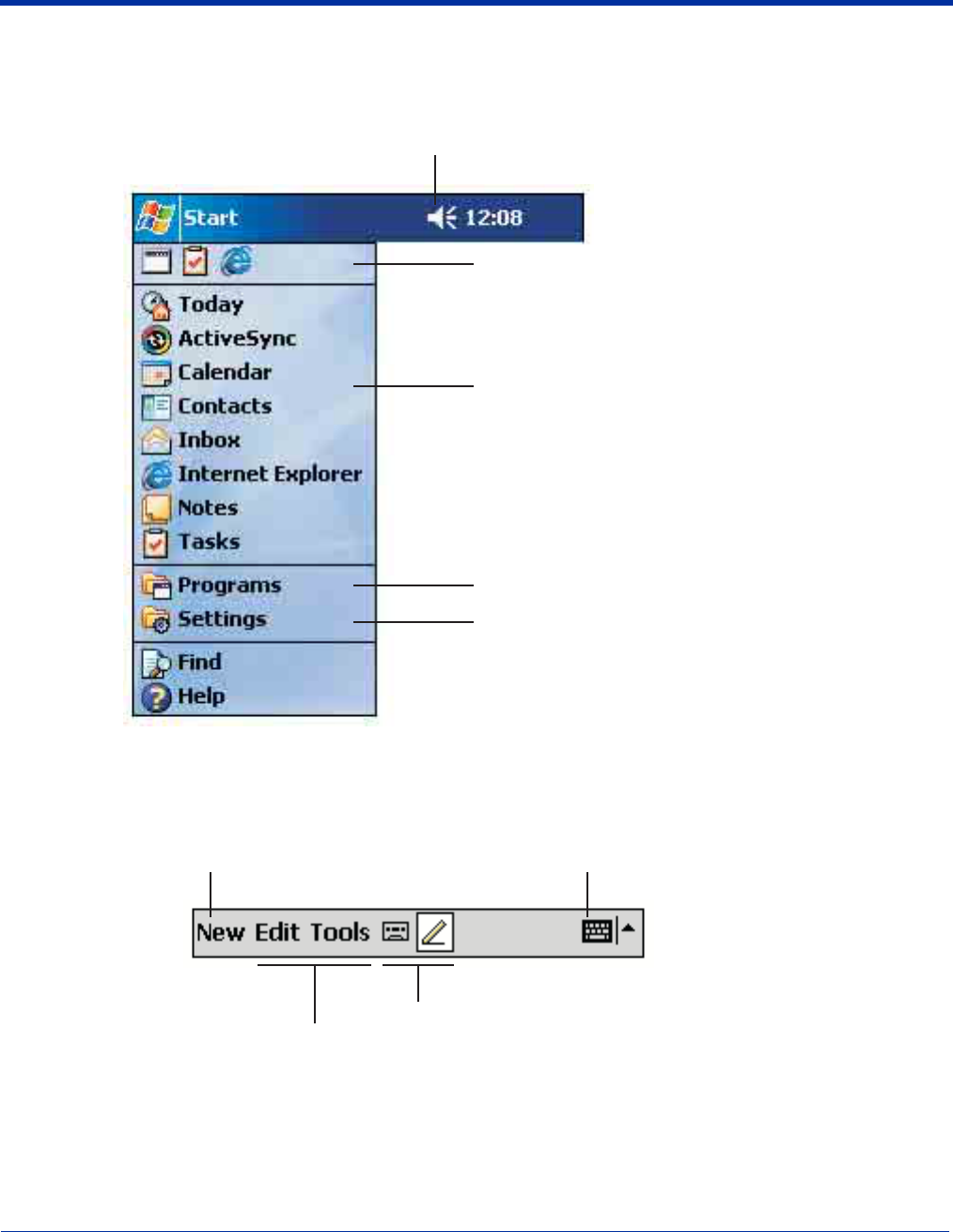
Dolphin® 9500/9550 Mobile Computer User’s Guide - GSM Draft 4 - 3
Navigation Bar
The navigation bar is located at the top of the screen. It displays the active program and current time, and allows you to switch
to programs and close screens.
Command Bar
Use the command bar at the bottom of the screen to perform tasks in programs. The command bar includes menu names,
buttons, and the Input Panel button. To create a new item in the current program, tap New. To see the name of a button, tap and
hold the stylus on the button. Drag the stylus off the button so that the command is not carried out.
Tap to select a program.
Tap to change volume or mute the device.
Tap to see additional programs.
Tap to customize the device.
Tap to quickly select a program
you have recently used.
New button.
Menu
names.
Buttons.
Input panel button.
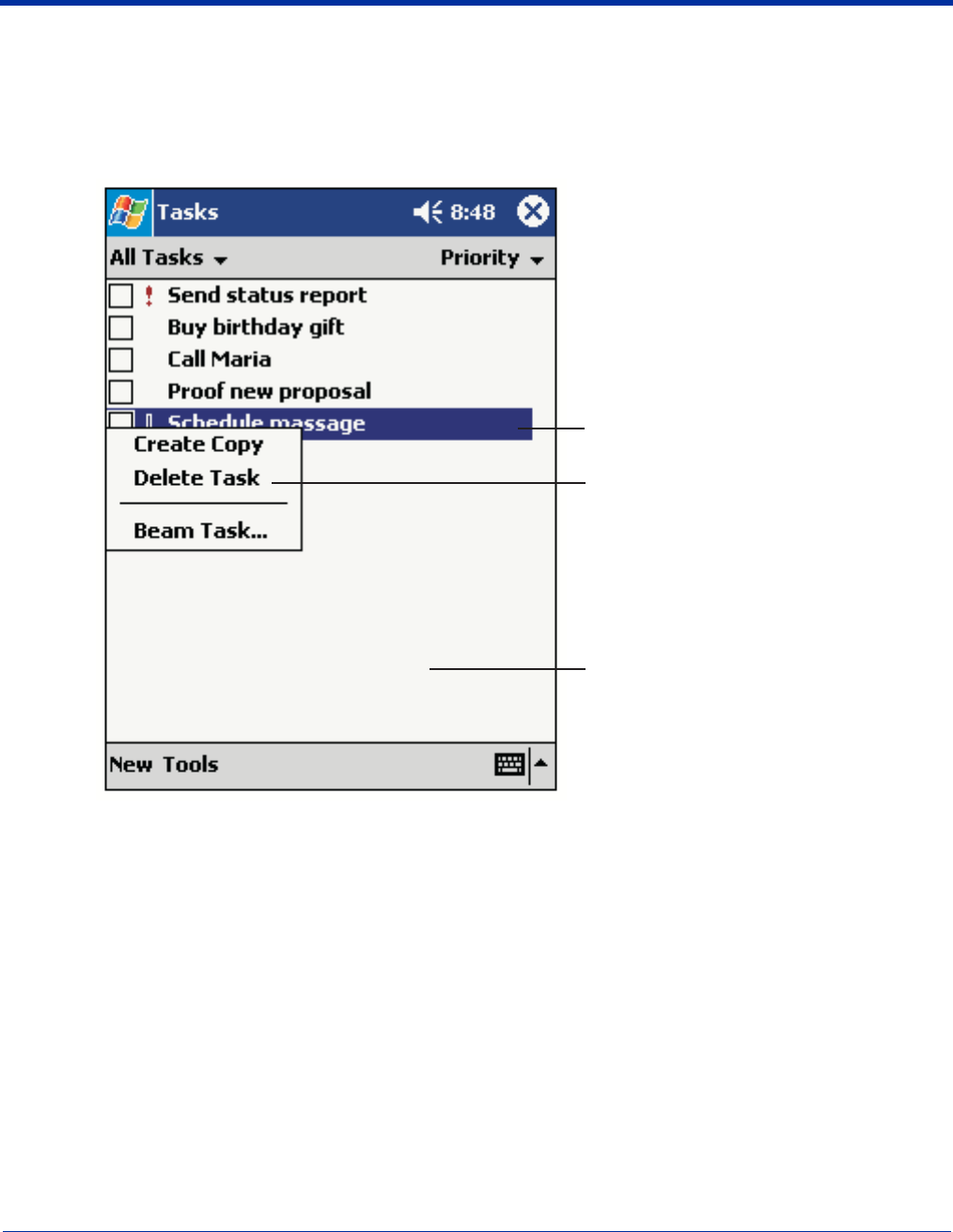
4 - 4 Dolphin® 9500/9550 Mobile Computer User’s Guide - GSM Draft
Pop-Up Menus
With pop-up menus, you can quickly choose an action for an item. For example, you can use the pop-up menu in the contact list
to quickly delete a contact, make a copy of a contact, or send an e-mail message to a contact. The actions in the pop-up menus
vary from program to program. To access a pop-up menu, tap and hold the stylus on the item name of the action you want to
perform the action. When the menu appears, lift the stylus, and tap the action you want to perform. Or tap anywhere outside the
menu to close the menu without performing an action.
Tap and hold to display
the pop-up menu.
Lift the stylus and tap
the action you want.
Tap outside the menu
to close it without performing
an action.
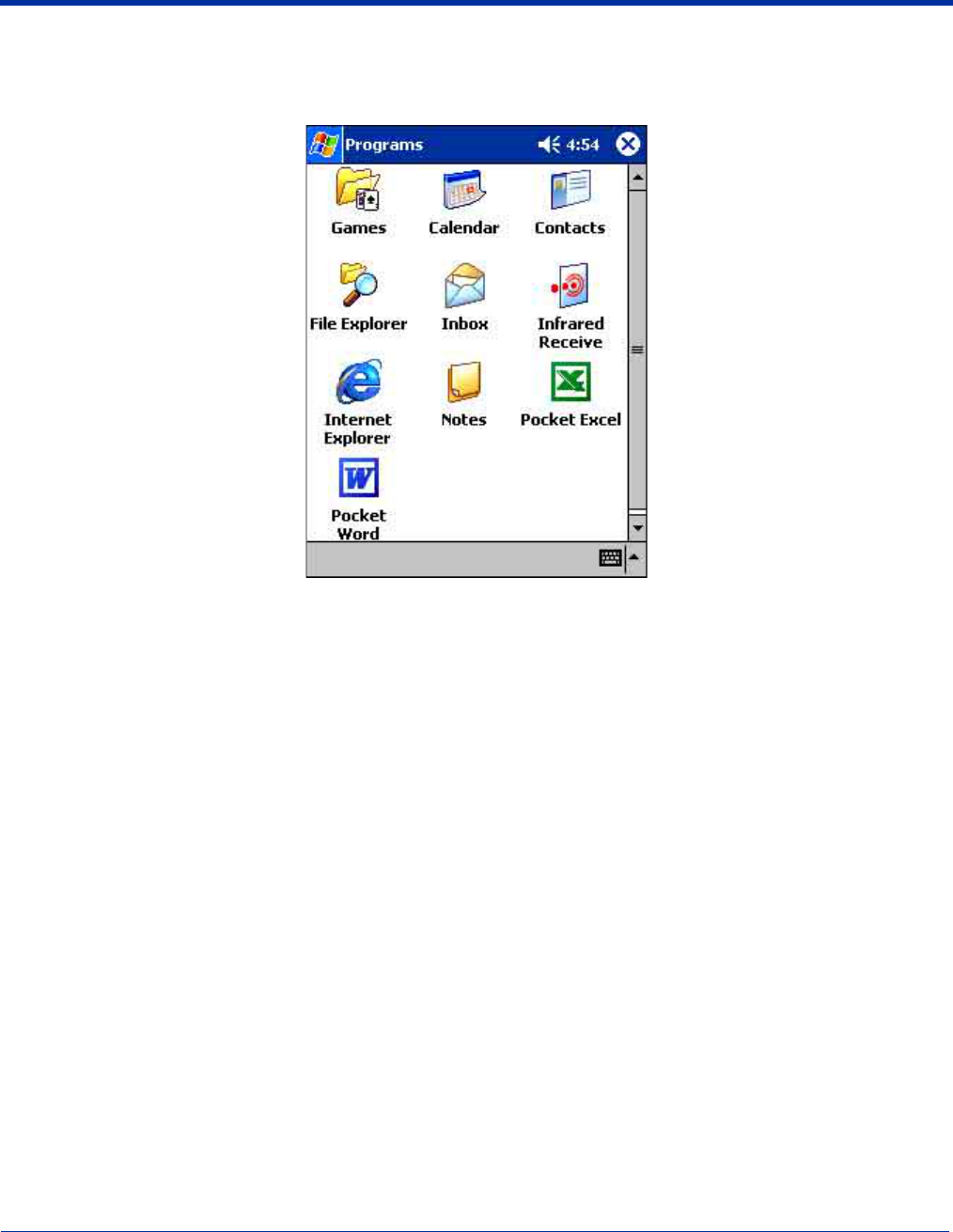
Dolphin® 9500/9550 Mobile Computer User’s Guide - GSM Draft 4 - 5
Selecting Programs
To select a program, tap Start > Programs, then the program name.
Note: Some programs have abbreviated labels for check boxes and drop-down lists. To see the full spelling of an abbreviated
label, tap and hold the stylus on the label. Drag the stylus off the label so that the command is not carried out.
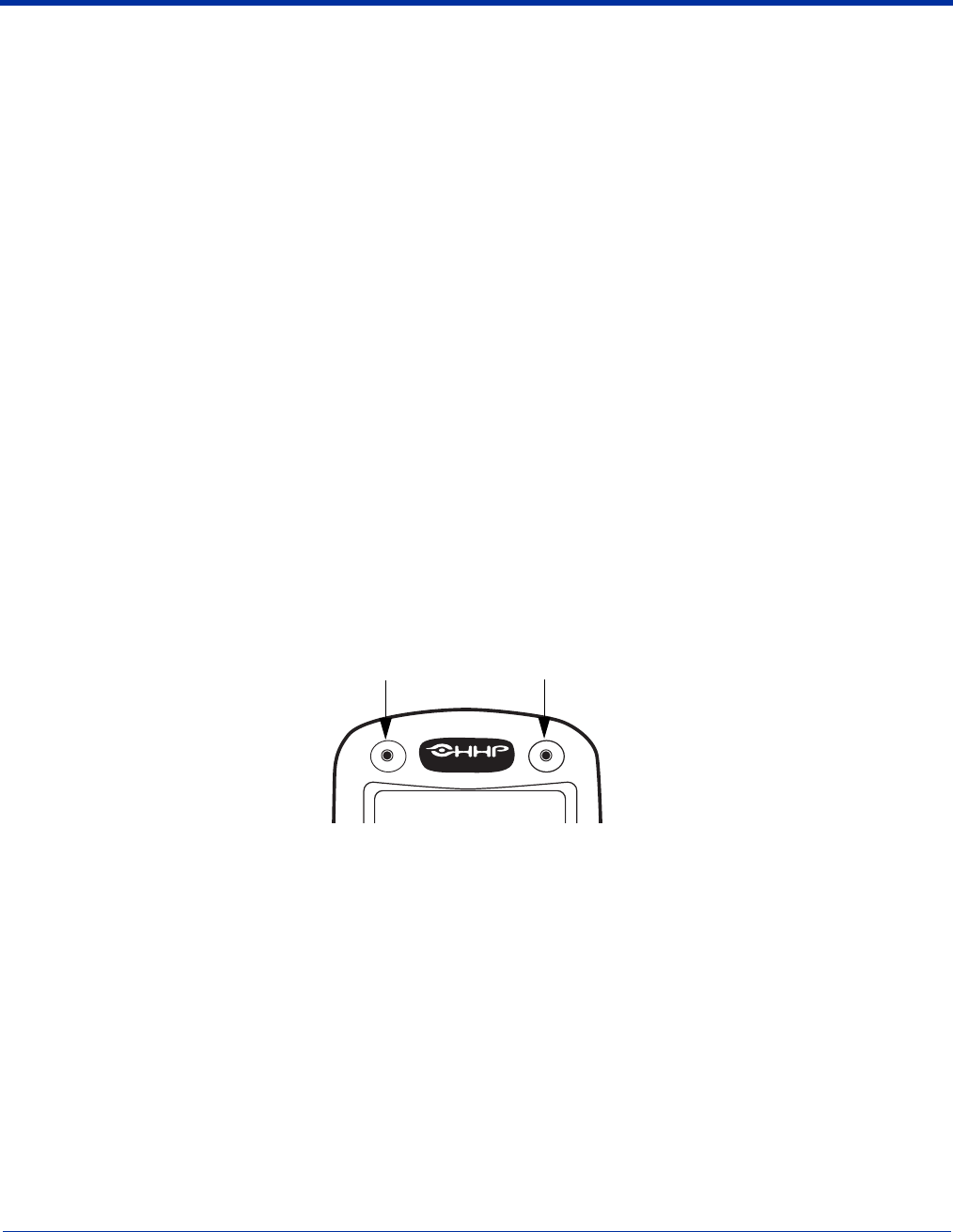
4 - 6 Dolphin® 9500/9550 Mobile Computer User’s Guide - GSM Draft
Imager
The terminal houses a compact image engine that instantly reads all popular 1D and 2D bar codes. It also supports omni-
directional aiming and decoding for greater flexibility in handling the device in real-world settings. The imager can also capture
digital images, such as signatures and pictures of damaged inventory. Images are saved in industry-standard file formats.
The terminal supports two types of image decoding for use in various bar code reading and imaging applications: full-area
imaging and Advanced Linear Decoding (ALD).
Full-area Imaging
Full-area imaging provides omni-directional reading of linear and non-linear 1D and 2D bar codes, OCR, signature capture, and
picture taking. When reading all bar code types using full-area imaging, a positive read can be obtained from most any position.
To achieve the best read, the aiming beam should be centered horizontally across the bar code.
ALD
ALD provides fast reading of linear and stacked linear bar codes. To achieve a positive read when reading linear 1D and PDF417
bar codes, the green aiming beam should be centered horizontally across the bar code. When ALD is enabled, the reader does
not read matrix or postal codes.
Decoding a Bar Code
1. Point the Dolphin 9500/9550 terminal directly at the bar code. The imager faces straight out the top panel. The aiming beam
should be oriented in line with the bar code to achieve optimal decoding. A range of 4-10 inches (10-25 cm) from the bar
code is recommended.
2. Project the imager’s green aiming beam by:
• Pressing and holding the SCAN key on both the 9500 and 9550.
• Pressing and holding the Scan Trigger on the 9550.
3. The decode LED flashes red, and the scan LED lights red.
4. Center the aiming beam over the bar code.
5. When the bar code is successfully decoded, the decode LED lights green and the terminal beeps.
6. The bar code information is entered into the application in use.
DOLPHIN 9500
Scan LEDDecode LED
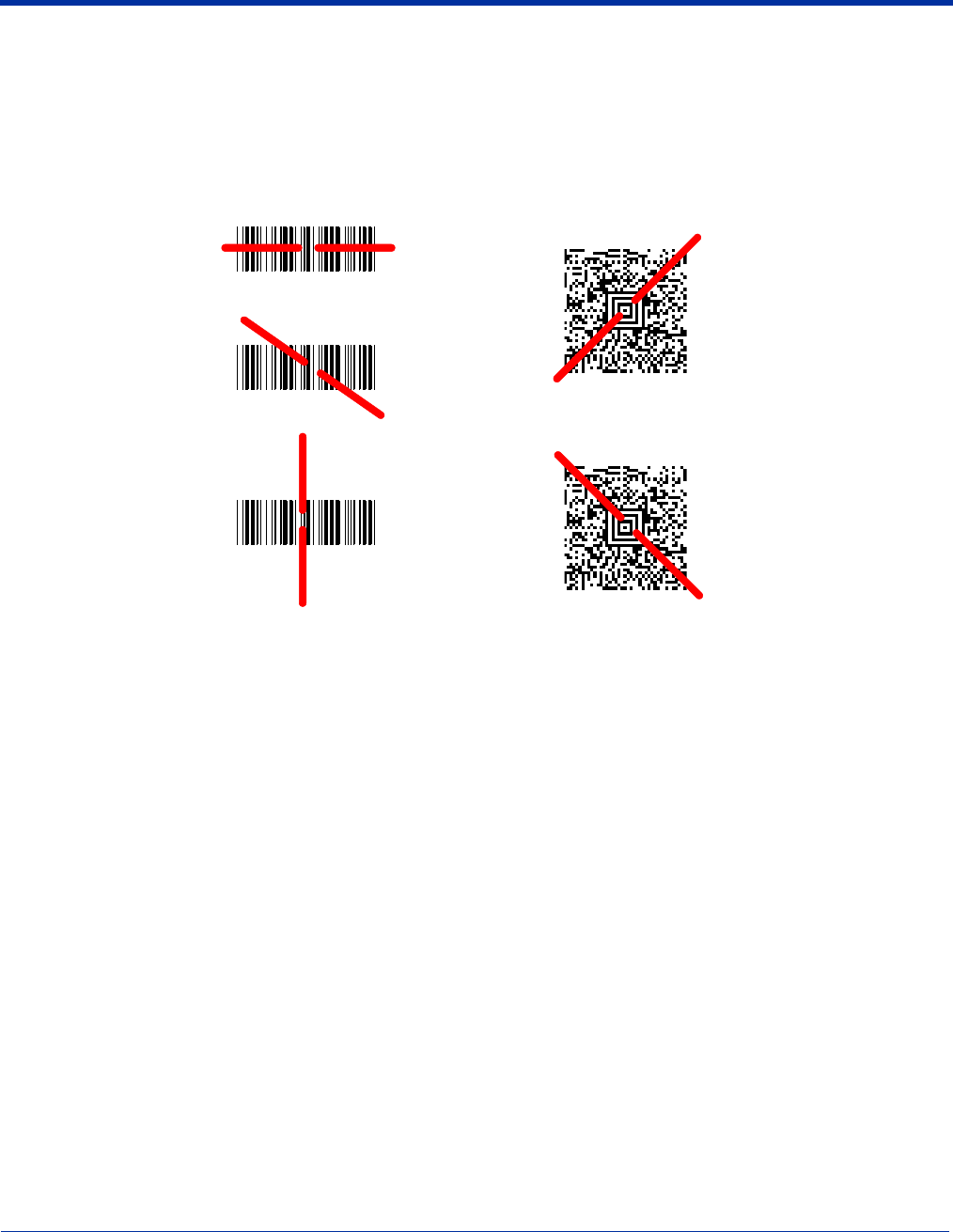
Dolphin® 9500/9550 Mobile Computer User’s Guide - GSM Draft 4 - 7
Scanning Position Options
The aiming beam is smaller when the terminal is held closer to the code and larger when it is farther from the code. Symbologies
with smaller bars or elements (mil size) should be read closer to the unit. Symbologies with larger bars or elements (mil size)
should be read farther from the unit.
The following chart displays the imager’s aiming positions:
Linear bar code 2D Matrix symbol
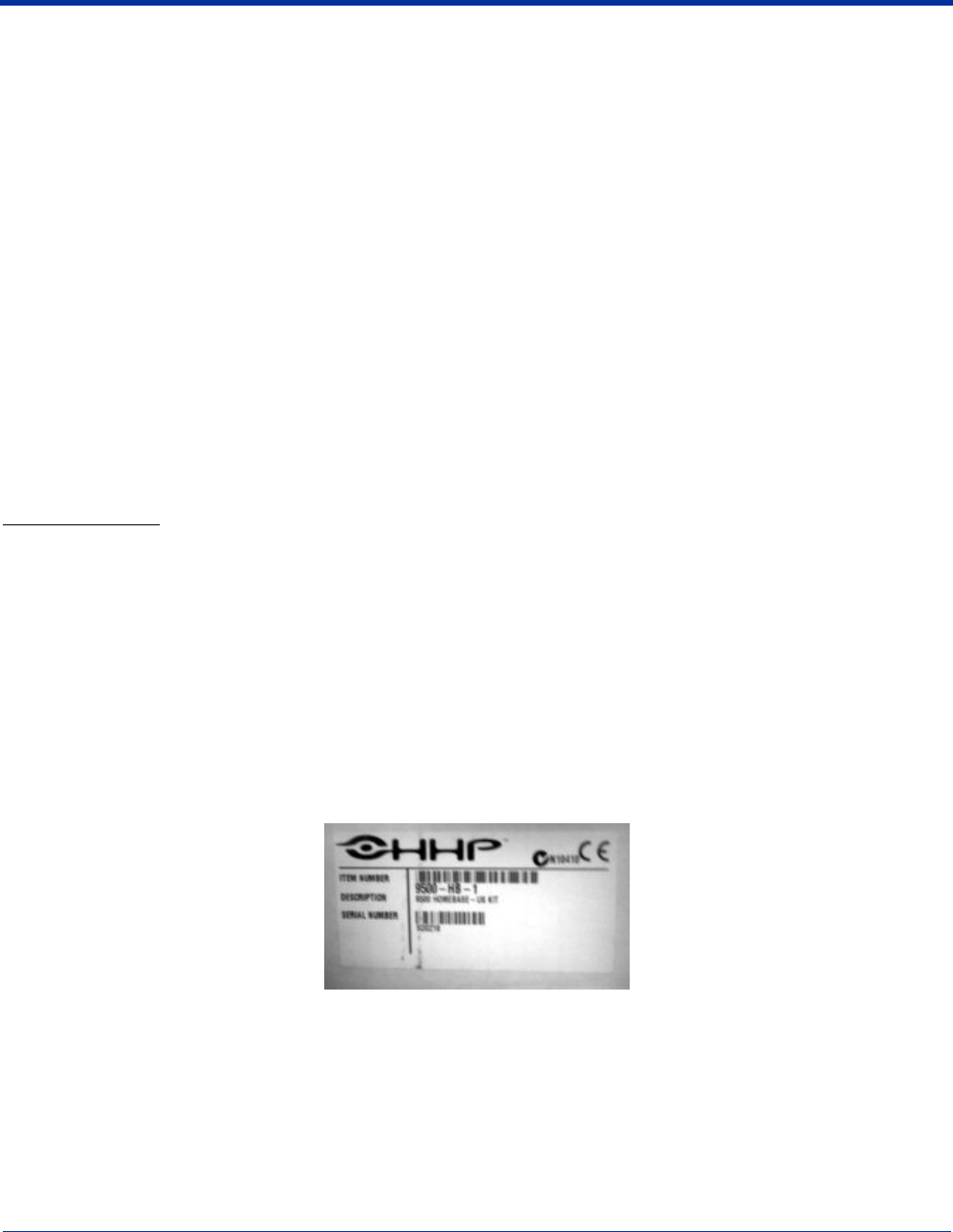
4 - 8 Dolphin® 9500/9550 Mobile Computer User’s Guide - GSM Draft
Capturing Images
The image-capture process is an intuitive, split-second operation for experienced users. By following the basic guidelines, new
users can easily develop their own technique and, with practice, quickly learn to adapt it to different application environments.
Image Preview
When the imaging process is initiated, the Dolphin 9500/9550 touch screen displays a preview of the object. This is a live video
image of what the imager is currently viewing. It has a slightly degraded appearance compared to the captured image. This is
normal.
The Scan Key
The Scan key captures images on both the Dolphin 9500 and the Dolphin 9550 terminals. It is the only way to capture an image
on the 9500, while on the 9550, you can also use the scan trigger on the pistol-grip handle.
Image Quality and File Size
The terminal is capable of saving images in a number of industry-standard file formats such as *.bmp, *.jpg and *.png. The default
file format for images is a grayscale *.jpg.
The image quality and related file size are determined by the data compression method used by the software application in use
when you take images. The average size of the image file is approximately 4-8K. However, the size of the image depends on the
content of the image–the more complex the content, the larger the file size.
For the highest quality, take grayscale images.
Taking an Image
The following steps are basic guidelines for taking images:
1. Point the Dolphin 9500/9550 terminal directly at the object. The imager points straight out the top panel.
2. To preview the image:
• Press and hold the SCAN key on both the 9500 and 9550.
• Press and hold the Scan Trigger on the 9550.
3. The touch screen displays a preview of the object, and the decode and scan LEDs light red.
4. Adjust the terminal’s position until the object appears on the screen the way you want it to appear in the image.
5. Hold the terminal still and release the SCAN key or Scan Trigger. The scan and decode LEDs flash red, the touch screen
flashes, and the captured image appears on the screen.
6. Unless otherwise specified by the application in use, the image is saved to the My Device folder (Start > Programs > File
Explorer > My Device). From here, the image file can be uploaded to a host PC using Microsoft ActiveSync and a Dolphin
communication peripheral.
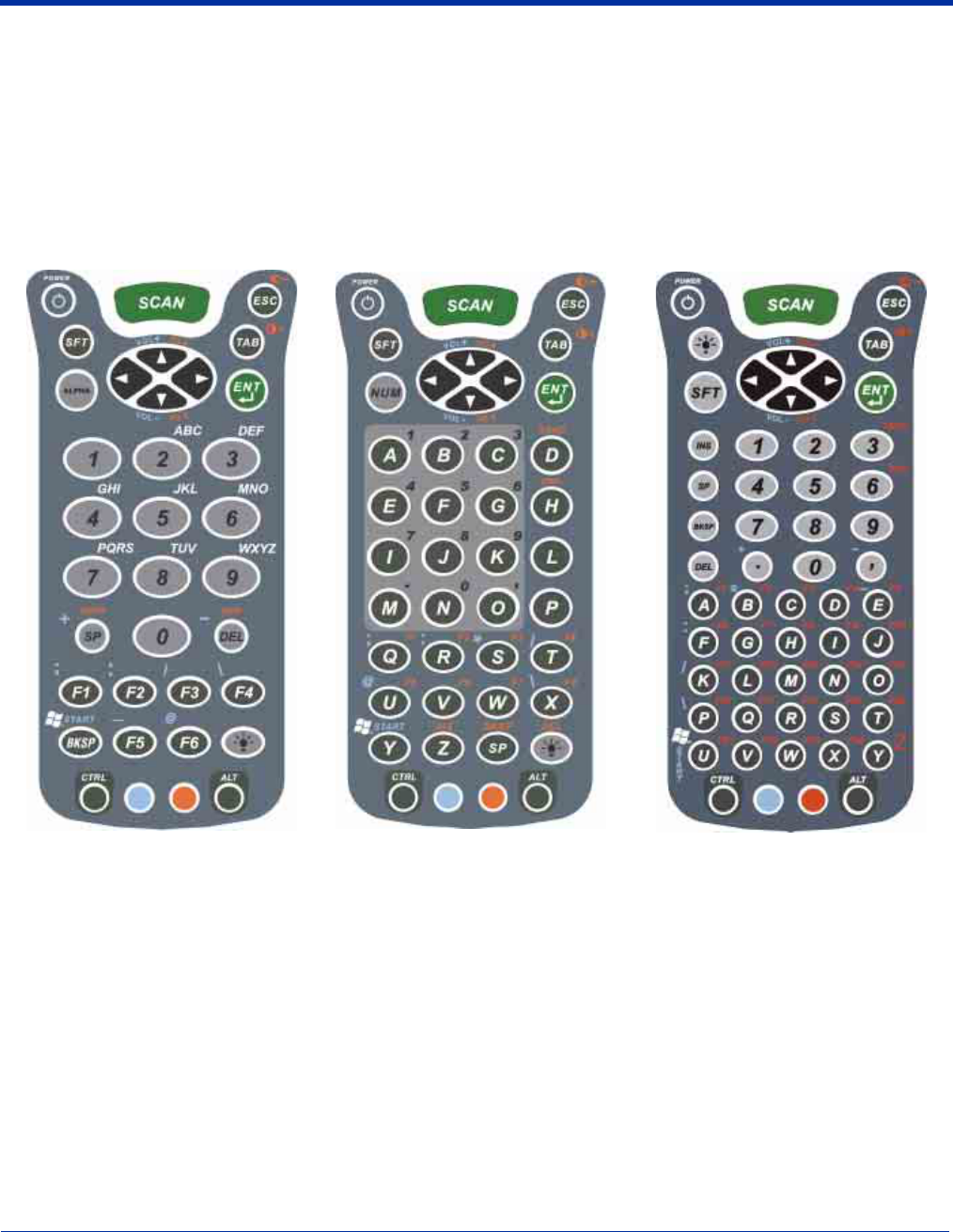
Dolphin® 9500/9550 Mobile Computer User’s Guide - GSM Draft 4 - 9
Using the Keyboards
The Dolphin 9500/9550 series features three keyboard options: 35-key numeric/alpha keyboard, 43-key numeric/alpha
keyboard, and 56-key alpha/numeric keyboard. Each keyboard is backlit for easy viewing in various lighting conditions and
contains centrally located keys for both right- and left-hand operation. The silver background of both the keys and the overlay
enhances the readability of each.
The overlay of all three keyboards are color-coded to indicate the functions performed or characters typed when the color-coded
key is pressed immediately after the Red or Blue Modifier key at the bottom of the keyboard. In addition to the alpha and numeric
keys, each keyboard contains function, navigation and modifier keys.
43-key numeric/alpha keyboard35-key numeric/alpha keyboard 56-key alpha/numeric keyboard
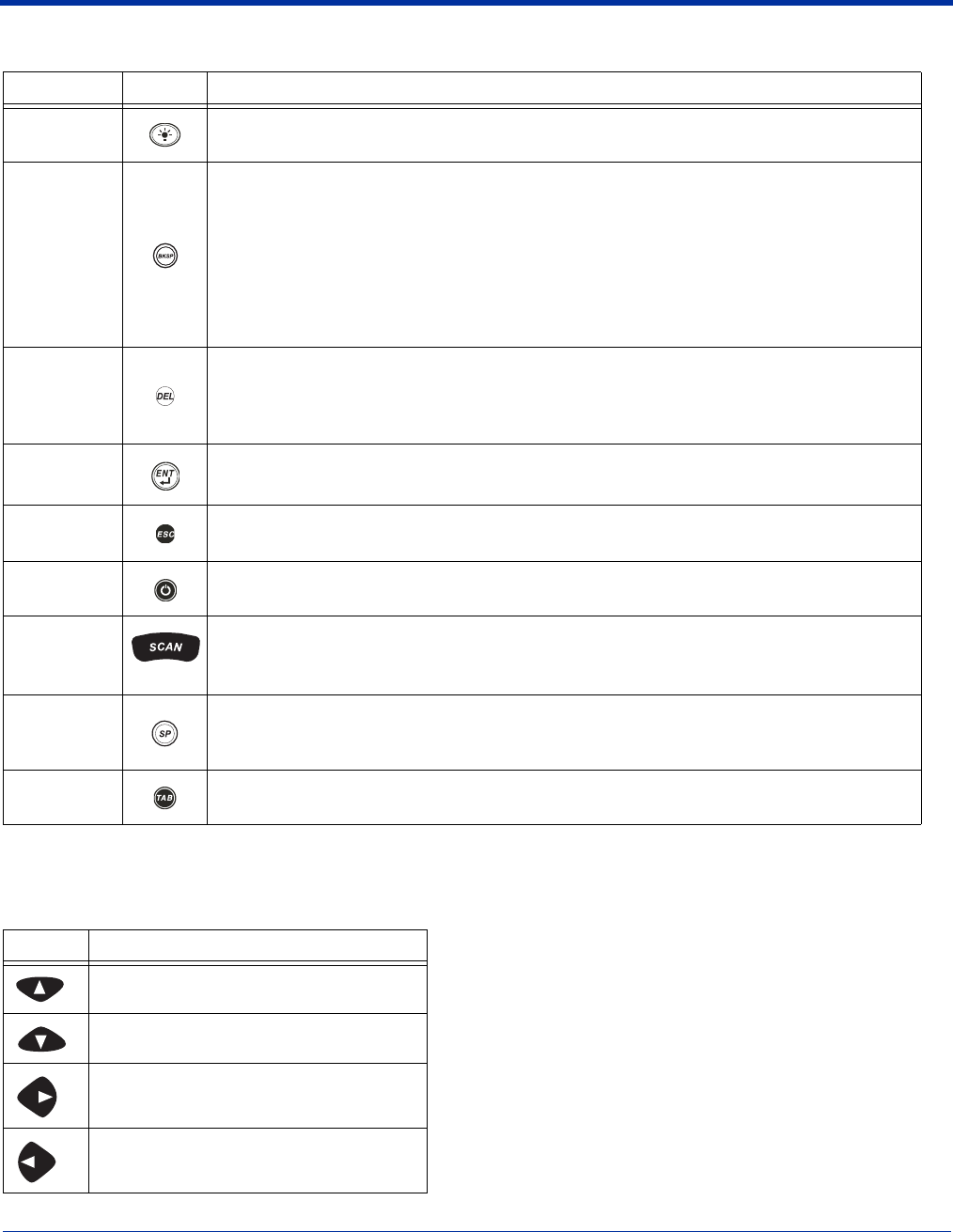
4 - 10 Dolphin® 9500/9550 Mobile Computer User’s Guide - GSM Draft
Using the Function Keys
Using the Navigation Keys
Located in the center of each keyboard for easy access with either hand, the navigation keys enable you to navigate the cursor
through an application screen.
Name Key Function
Backlight
By default
,
the Backlight key turns the keyboard backlight on and off. See
Adjusting the
Backlight
on page
4-15.
Backspace
(BKSP)
This key appears on both the 35- and 56-key keyboards.
The BKSP key moves the cursor back one space each time the key is pressed. If you are
typing text, it deletes the previous character each time it is pressed.
On the 43-key keyboard, the backspace is a shifted function; press SFT + SP to backspace.
To delete a single character, press Red key + SP. To delete multiple characters, press Red key
+ SP and hold down the SP key.
Delete
(DEL)
This key appears on both the 35- and 56-keyboard. The Delete key deletes the next character
forward each time the key is pressed.
On the 43-key keyboard, delete is a shifted function; press SFT + the Backlight key to delete.
Enter (ENT)
The Enter key confirms data entry.
Escape
(ESC)
The Escape key performs a cancel action.
Power Key
The Power key puts the terminal into and wakes the terminal from suspend mode.
SCAN Key
The SCAN key activates the scan on both Dolphin 9500/9550 terminals. It also “wakes” the
terminals from sleep mode. Its position allows convenient one-handed image-taking and/or
bar code decoding.
Space (SP)
The Space key moves the cursor one space.
Tab
The Tab key moves the cursor to the next tab stop or the next control (on a form).
Press To …
Move the cursor up one row or line.
Move the cursor down one row or line.
Move the cursor one character to the right.
Move the cursor one character to the left.
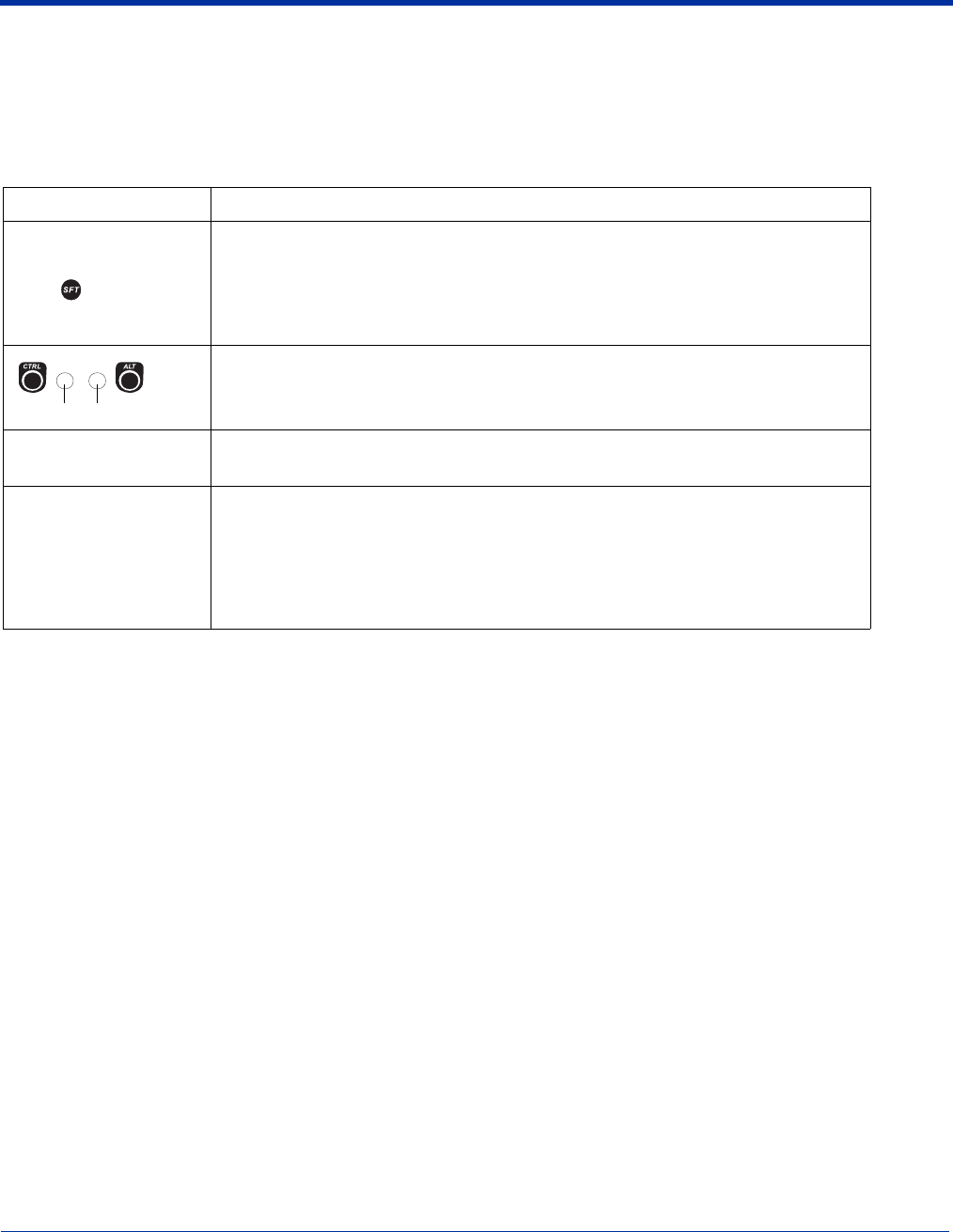
Dolphin® 9500/9550 Mobile Computer User’s Guide - GSM Draft 4 - 11
The up and down arrows can also be used for volume control when pressed in combination with the blue modifier key. They can
also be used for page up and page down commands when pressed in combination with the red modifier key. Other functionality
varies according to the application in use.
Using the Modifier Keys
All three versions of the Dolphin 9500/9550 keyboard feature the standard PC keyboard modifier keys, Shift (SFT), Alt, and
Control (CTRL) as well as Blue and Red modifier keys.
Name & Key Function
Shift (SFT)
The SFT key modifies only the next key pressed; it must be pressed before each key
you wish to modify. SFT toggles the keyboard between uppercase alphabet mode and
lowercase alphabet mode. Use SFT toggle Caps Lock on and off by double-tapping it
or by pressing SFT + the Red modifier key. When Caps Lock is toggled on, characters
are uppercase; when toggled off, characters are lowercase.
The CTRL, ALT, and Blue and Red Modifier keys are located along the bottom of each
keyboard.
CTRL
and
ALT
Functions of the ALT and CTRL keys depend on the software application in use and
the keys pressed in combination with each.
Blue
and
Red
The blue and red keys are used in combination with other keys to type special
characters and perform system functions. Each key modifies only the next key pressed.
The overlay of each keyboard is color-coded to indicate the character typed or function
performed when specific keys are pressed immediately after the blue or red modifier
key.
RedBlue
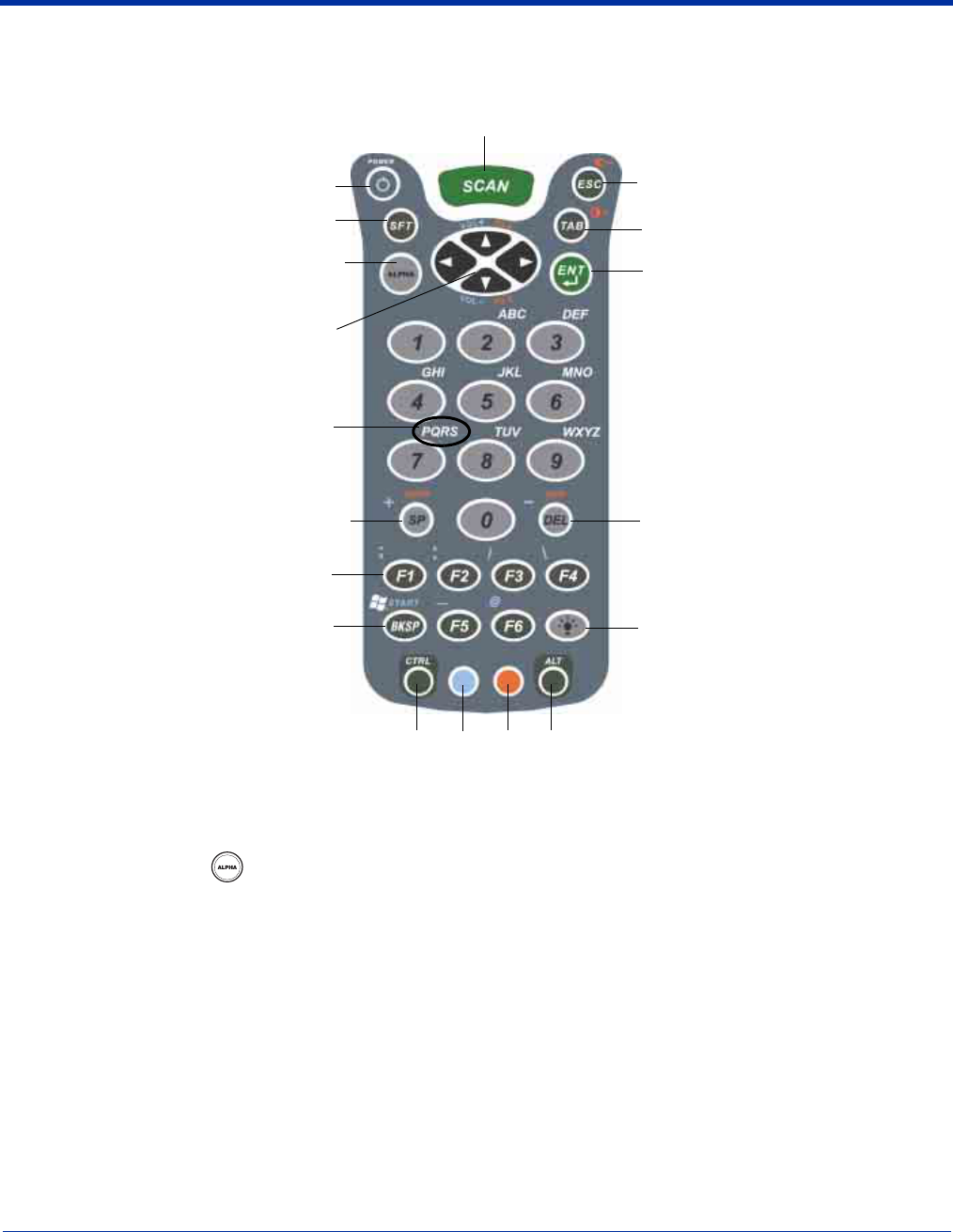
4 - 12 Dolphin® 9500/9550 Mobile Computer User’s Guide - GSM Draft
35-Key Numeric/Alpha Keyboard
The following graphic displays the 35-key numeric/alpha keyboard.
Alpha Lock Key (ALPHA)
Because the 35-key keyboard defaults to numeric mode, the Alpha Lock key appears only on the 35-key keyboard. The Alpha
Lock key enables you to toggle between the numeric and alpha modes. Numeric mode is when you type numbers with the
number keys. Alpha mode is when you type letters with the number keys.
The letters on the overlay above specific number keys indicate what letter will be typed when you press that key in alpha mode.
Enter key
Backlight key
Alpha Lock key
Shift key
Navigation keys
Ta b key
CTRL, Blue, Red, ALT Modifier keys
SCAN key
Power key
Backspace key
Function keys
Space key
Escape key
Delete key
Alpha Lock Indicators
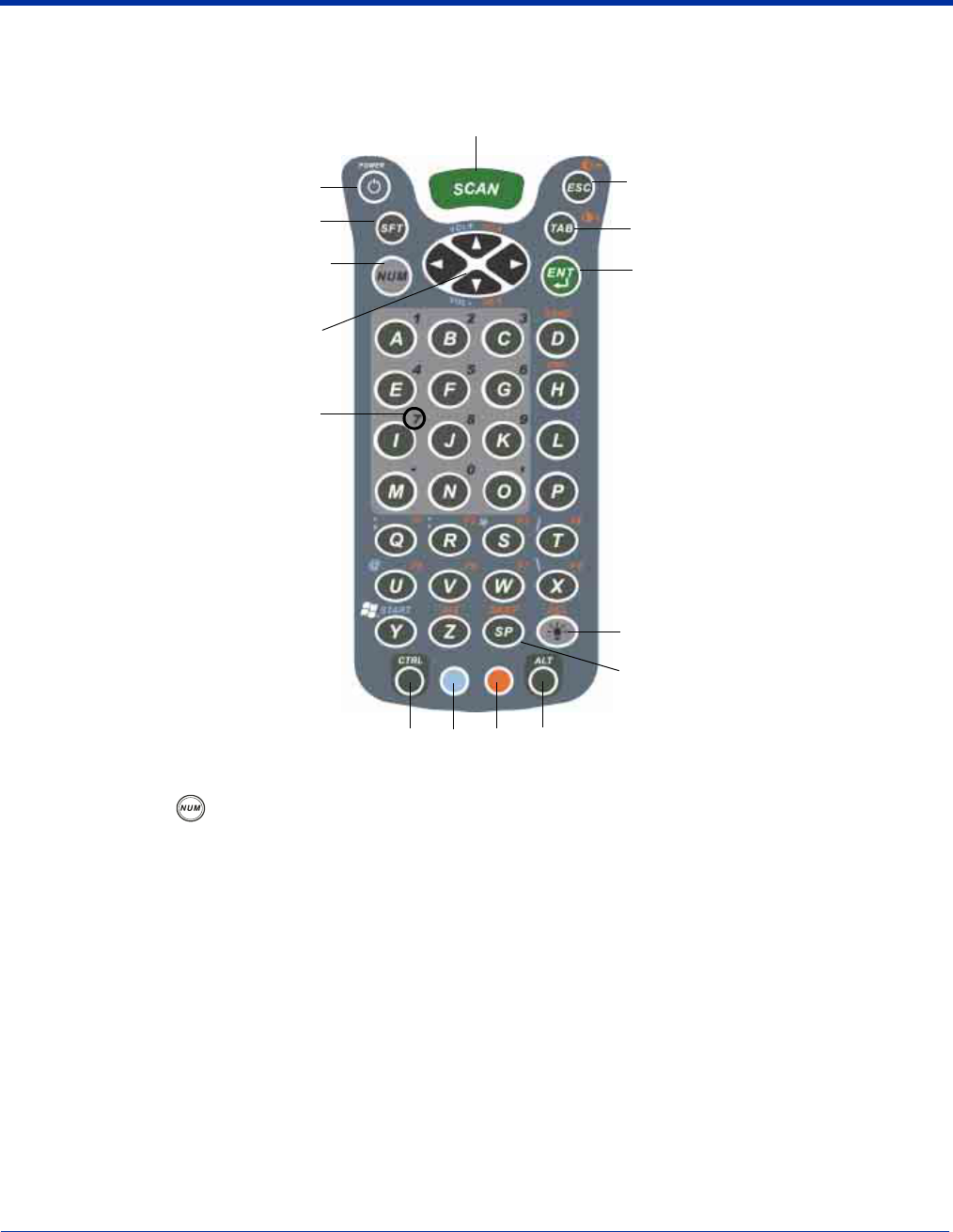
Dolphin® 9500/9550 Mobile Computer User’s Guide - GSM Draft 4 - 13
43-Key Numeric/Alpha Keyboard
The following graphic displays the 43-key numeric/alpha keyboard.
Number Lock (NUM)
Because the 43-key keyboard defaults to alpha mode, the Number Lock key appears only on the 43-key keyboard. The Number
Lock key enables you to toggle between the alpha and numeric modes. alpha mode is when you type letters with the letter keys.
Numeric mode is when you type numbers with the letter keys.
The numbers on the overlay above specific letter keys indicate what number will be typed when you press that key in Numeric
mode.
Backlight key (use with SFT to delete)
SCAN key
Space key (use with SFT to backspace)
CTRL, Blue, Red, ALT Modifier keys
Enter key
Tab key
Escape key
Number Lock key
Shift key
Navigation keys
Power key
Number Lock
Indicators
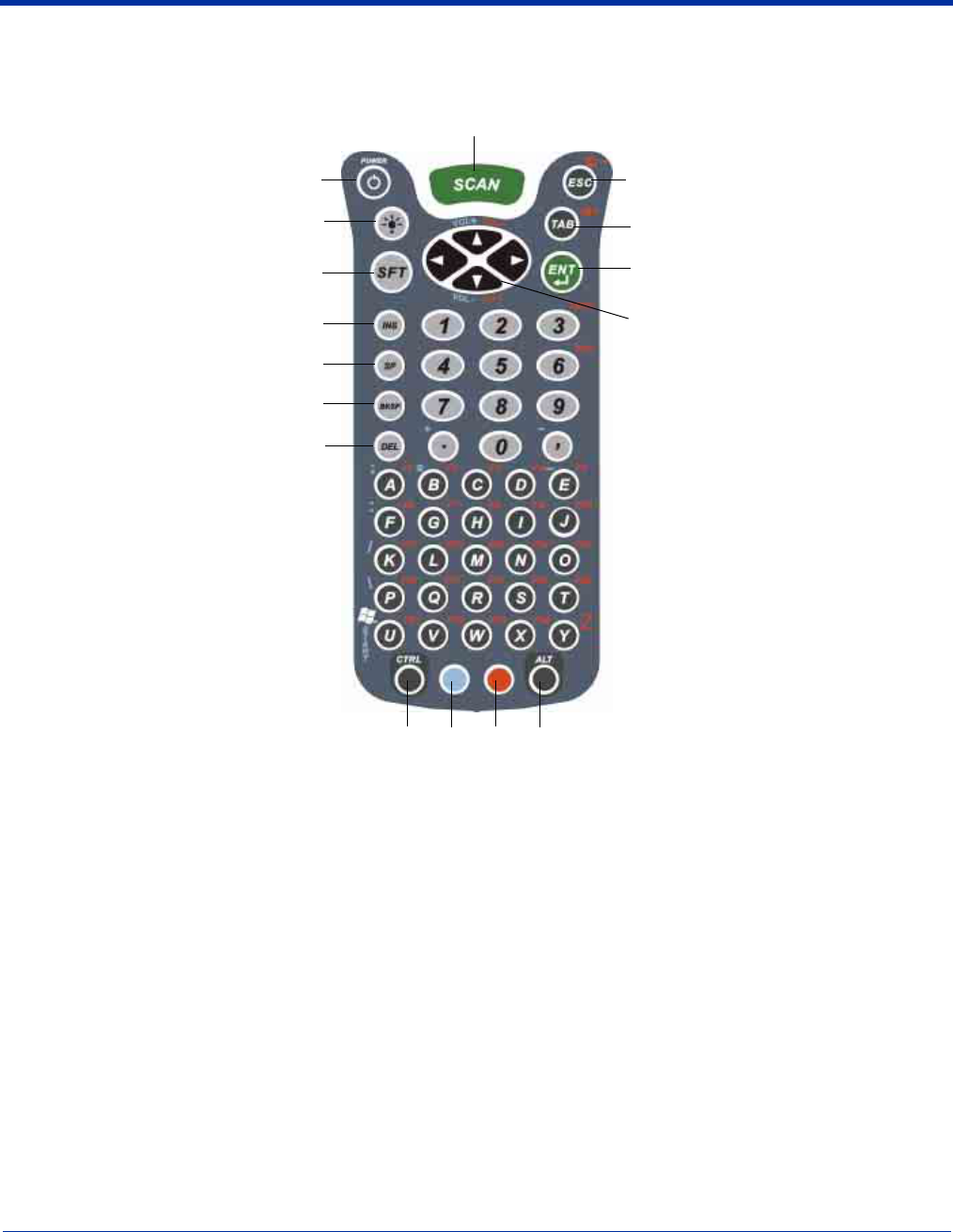
4 - 14 Dolphin® 9500/9550 Mobile Computer User’s Guide - GSM Draft
56-Key Alpha/Numeric Keyboard
The following graphic displays the 56-key numeric/alpha keyboard.
Key Combinations
There are keyboard combinations for specific functions and special characters on each keyboard. For charts of the key
combinations associated with each keyboard layout, see the Appendix A of the Dolphin 9500/9550 User’s Guide.
Shift key
Navigation keys
SCAN key
Power key
Backspace key
Space key
Delete key
Backlight key
Insert key
CTRL, Blue, Red, ALT Modifier keys
Enter key
Ta b key
Escape key
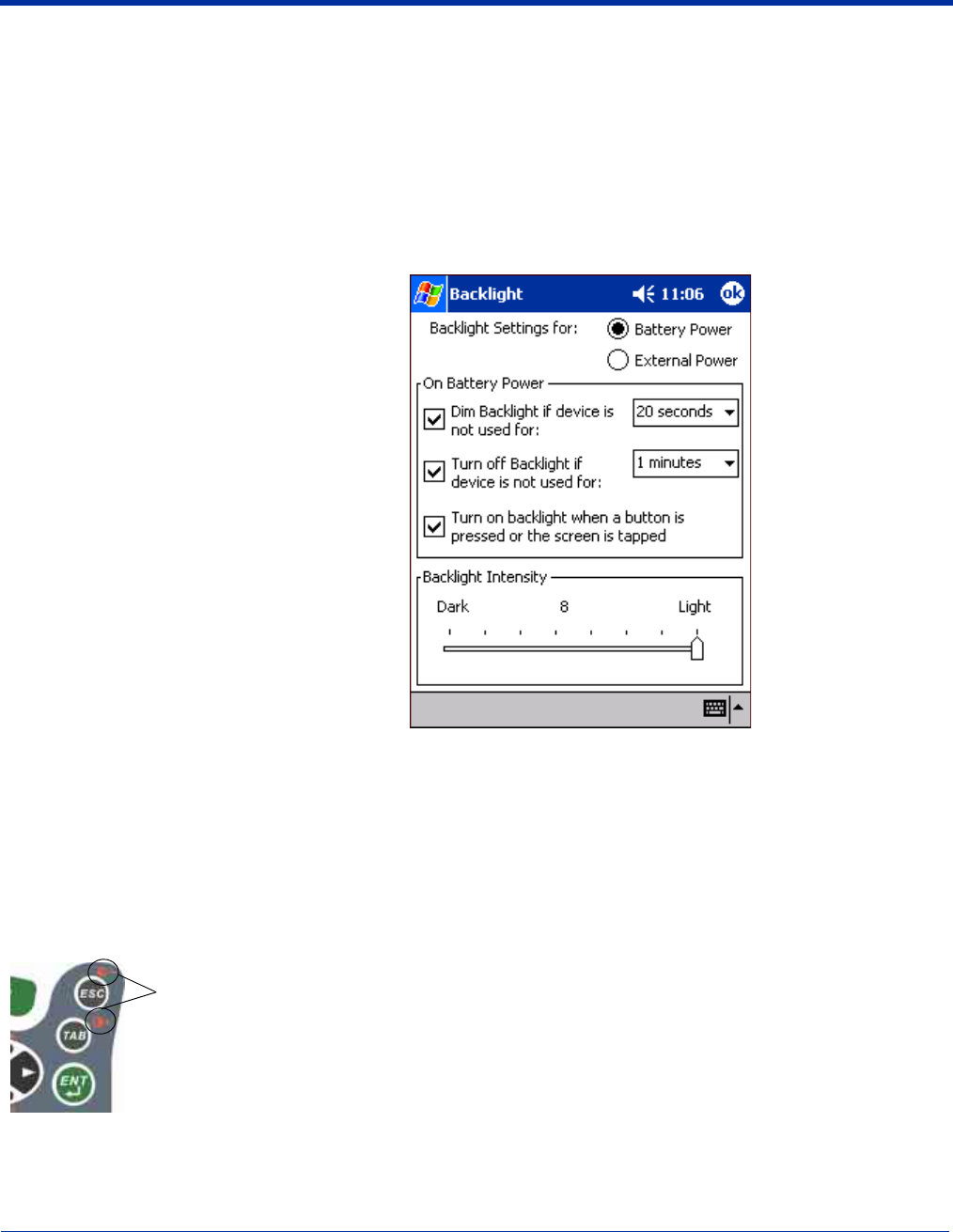
Dolphin® 9500/9550 Mobile Computer User’s Guide - GSM Draft 4 - 15
Adjusting the Backlight
Both the keyboard and the display are backlit to enable better viewing in low-light conditions. All keyboards contains a Backlight
key that toggles the backlight on and off; see Backlight on page 4-10.
Keyboard By default, the Backlight key turns the keyboard backlight on and off for both color display and
monochrome terminals.
Display Backlight functionality differs for color and monochrome displays.
Monochrome Display
The backlight for monochrome displays turns on and off when you press the Backlight key, but not when you tap the screen. You
can adjust the contrast using the keyboard or the system settings.
Using the Keyboard
Press and hold the
• Red Modifier key + ESC to decrease the contrast
• Red Modifier key + TAB to increase the contrast
Color Display
The backlight for the color display is user-defined.
Go to Start > Settings > System tab > Backlight.
The Backlight screen appears.
The graphic on the right displays the default
backlight settings for color displays.
Adjust the settings as needed with the options
available. Use the slider to adjust intensity.
Click OK to save any changes.
The display backlight functions according to the
settings saved here.
All three keyboards have red
indicators over each key to indicate
which key to press in combination with
the red modifier key to adjust the
contrast.
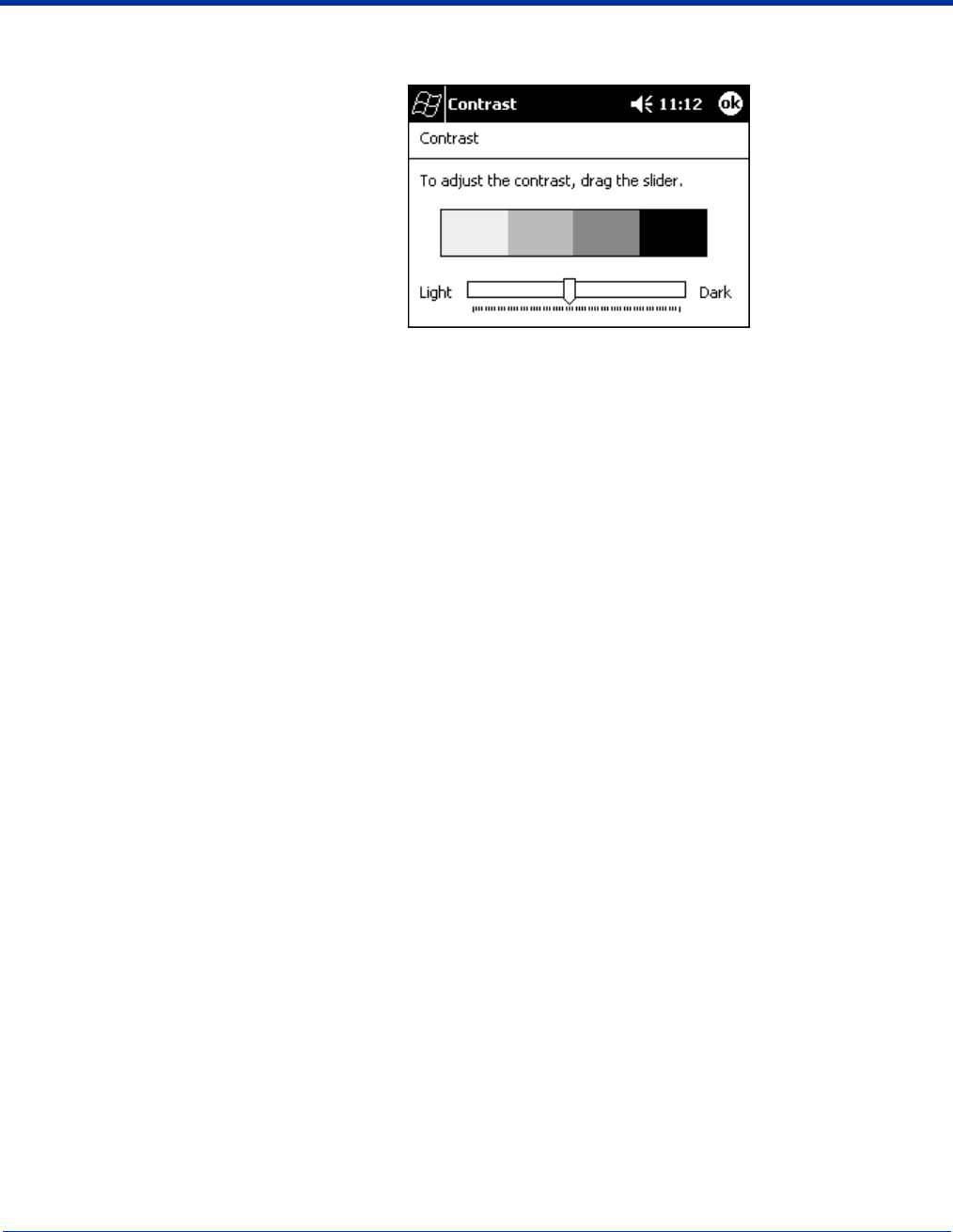
4 - 16 Dolphin® 9500/9550 Mobile Computer User’s Guide - GSM Draft
Using the System Settings
Tap Start > Settings > System tab > Contrast.
The current settings are displayed.
Use the slider to adjust the contrast to the desired
setting.
Tap OK to save adjustments.

Dolphin® 9500/9550 Mobile Computer User’s Guide - GSM Draft 4 - 17
Communication Media Options
Via the Mechanical Connector
The 17-pin, industrial-grade, mechanical connector on the bottom panel is designed to work only with HHP sold/manufactured
communication and charging peripherals. Via these peripherals, the connector supports USB and RS-232 communications,
enabling the user to connect the Dolphin 9500/9550 terminal to external devices such as scanners and printers. The connector
also provides power out 5V at 500mA, which means that, with the proper HHP cable, the terminal can power another device.
For more information about the connector, see Mechanical Connector on page 3-9.
Via the IrDA Port
The IrDA port enables the Dolphin 9500/9550 to transmit data via pulses of light to and from other IrDA-compliant devices, such
as printers and PCs or to other Dolphin 9500/9550 terminals.
Via the 802.11b Radio
The Dolphin 9500/9550 may be equipped with a WiFi®-compliant, interoperable 2.4 GHz 802.11b direct sequence spread
spectrum wireless local area network (WLAN) radio.
Via Bluetooth Radio
The Dolphin 9500/9550 may be equipped with a Bluetooth wireless personal area network (WPAN) radio.
Software Communication Programs
Microsoft® ActiveSync v3.7®
Microsoft ActiveSync is a tool that enables Pocket PC devices, such as the Dolphin 9500/9550, to exchange and synchronize
application data with a desktop computer.
For more information, see Communications on page 6-1.
RAS
Short for Remote Access Services, RAS is a feature built into Windows NT that enables users to log into an NT-based LAN using
a modem, X.25 connection or WAN link. RAS is fully supported and allows the use of PPP or SLIP connections for network
connectivity.

4 - 18 Dolphin® 9500/9550 Mobile Computer User’s Guide - GSM Draft
Radio Options
Dolphin 9500/9550 terminals can be configured with one or a combination of the following radios:
• 802.11b
• Bluetooth
• GSM/GPRS (9500 only)
Please note that the 9550 supports all radio options and configurations EXCEPT FOR GSM/GPRS.
Available Radio Combinations
Dolphin 9500/9550 terminals can be configured with more than one radio.
Co-located Radios
Some combinations are co-located, which means that you can use only one radio at a time. In this case, you can have both radios
installed but need to power one up and the other down before operation.
• 802.11b and GSM/GPRS
Co-operational Radios
Some combinations are co-operational, which means that you can power up and operate both radios simultaneously.
• Bluetooth and 802.11b
• Bluetooth and GSM/GPRS
Radio Driver Installation
Radio drivers install during the autoinstall whenever the mobile computer is initialized; when first turned on or after a hard reset.
Only the appropriate drivers for your terminal’s radio configuration install. For example, if your terminal is configured only with an
802.11b radio, only the driver for that radio installs. For more information, see Autoinstall on page 2-10.
When a single radio installs, its radio driver is powered up automatically after initialization is complete. In general, when more
than one radio installs, the terminal powers up the 802.11b radio. However, if a GSM radio is installed, the terminal powers up
the GSM radio.
The Radio Manager
The Radio Manager is a control panel applet through which the radio power driver controls the radio state. It enables you to
choose which radios on the terminal are powered up. When powered up, the radio is transmitting, when powered down, the radio
is not transmitting.
Single Radio Configuration
If your terminal contains a single radio module and its associated driver is installed, operates by itself without any special
configuration made to the device.
Multiple Radio Configuration
Configuration of simultaneous radio operation is done during the manufacturing process according to FCC regulations. If multiple
radio modules are installed in your terminal, simultaneous operation must be configured on the device before the radio power
driver allows it. In other words, verify which radio or radios are powered up or down.
Multiple Radio Operation
GSM and 802.11b are mutually exclusive. While they may both be present, they cannot be allowed to operate simultaneously. If
you have modules and drivers for both radios installed on your terminal, you must ensure that one radio is powered down before
using the other.
The Bluetooth radio is allowed to operate by itself or simultaneously with either of the GSM or 802.11b radios.
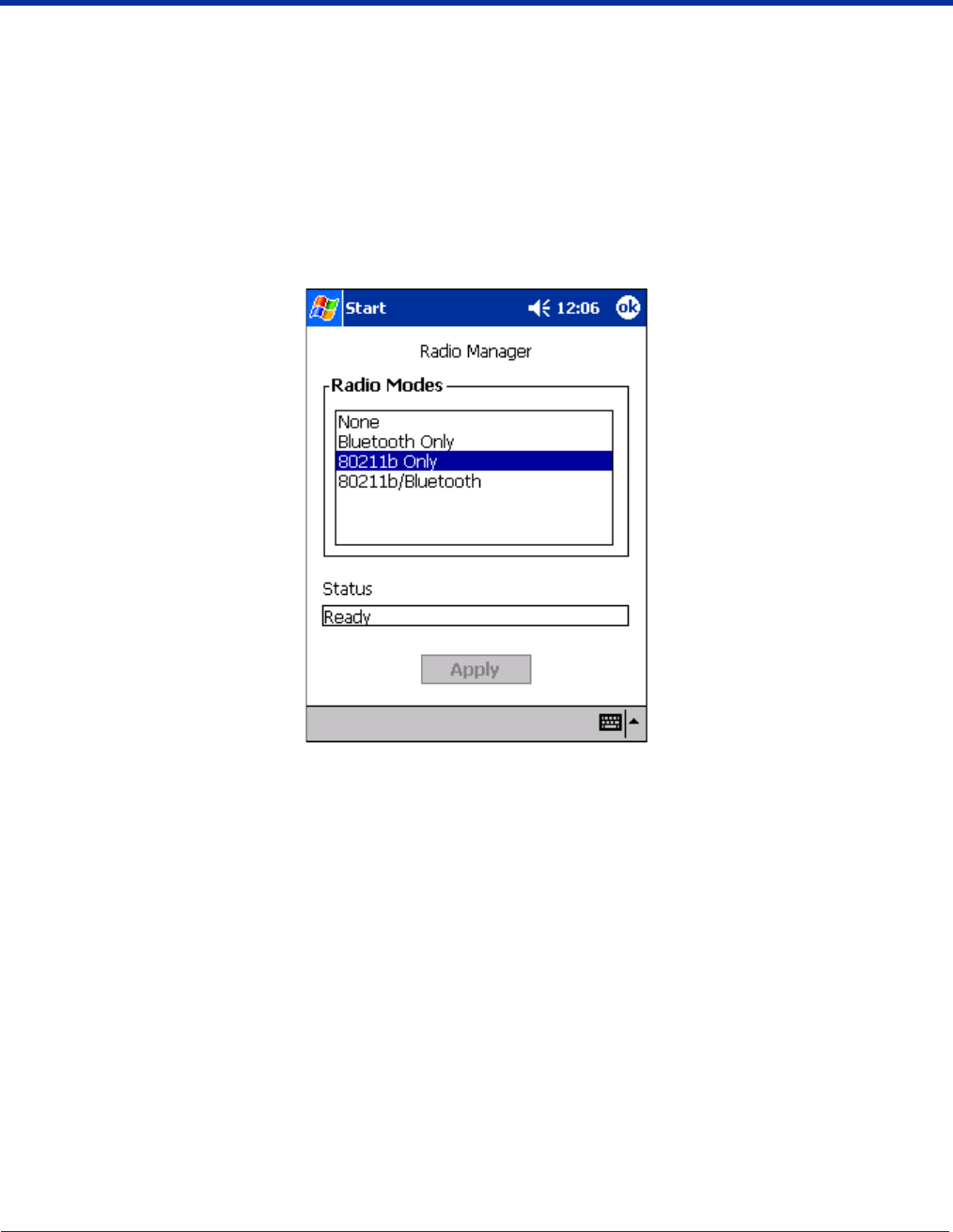
Dolphin® 9500/9550 Mobile Computer User’s Guide - GSM Draft 4 - 19
Powering Up a Radio
Requirements
To successfully power up a radio, both the hardware module and the software driver must be installed on the terminal. If the
module is present, the radio appears in the Radio Manager. However if the driver is not installed, you cannot successfully power
up the radio. Attempting to do so produces an error in the Status field that tells you that the driver is not installed.
To Power Up a Radio or Radio Combination
1. Open the Radio Manager by going to Start > Settings > System tab > Radio Manager. The Radio Manager appears
identifying which radio modules are allowed on the terminal. The highlighted entry is the radio mode that is currently enabled;
its Status should be Ready.
Radio Modes box The Radio Modes box displays the radio hardware modules currently installed on the terminal. For
example, if a working Bluetooth module is installed, the box contains the line Bluetooth Only whether
or not that radio is currently powered up.
Status field The Status field provides feedback on the state of the radio. When it reads “Ready,” the radio selected
in the Radio Modes box is powered up. The Status field displays error messages when a radio cannot
be enabled.
2. Select the radio in the Radio Modes list and tap Apply.
The radio drivers are powered down and powered up in the proper sequence. For example, if the radio powered up is Bluetooth
Only and you try to switch to 802.11b Only, after Apply is tapped, the Radio Manager powers down the Bluetooth radio first, then
powers up the 802.11b radio.
If an error occurs during this process, the radio mode change is abandoned. The resulting radio state is the status of the radios
at the time the error occurred.
To Power Down Radios
Radio drivers are automatically powered down if the radio or radio combination that is currently powered up requires it. To power
down all radios, select None and tap Apply.
For more information about 802.11b radios, see Wireless LAN Communications with 802.11b on page 7-1.
For more information about Bluetooth radios, see Wireless PAN Communications with Bluetooth on page 8-1.
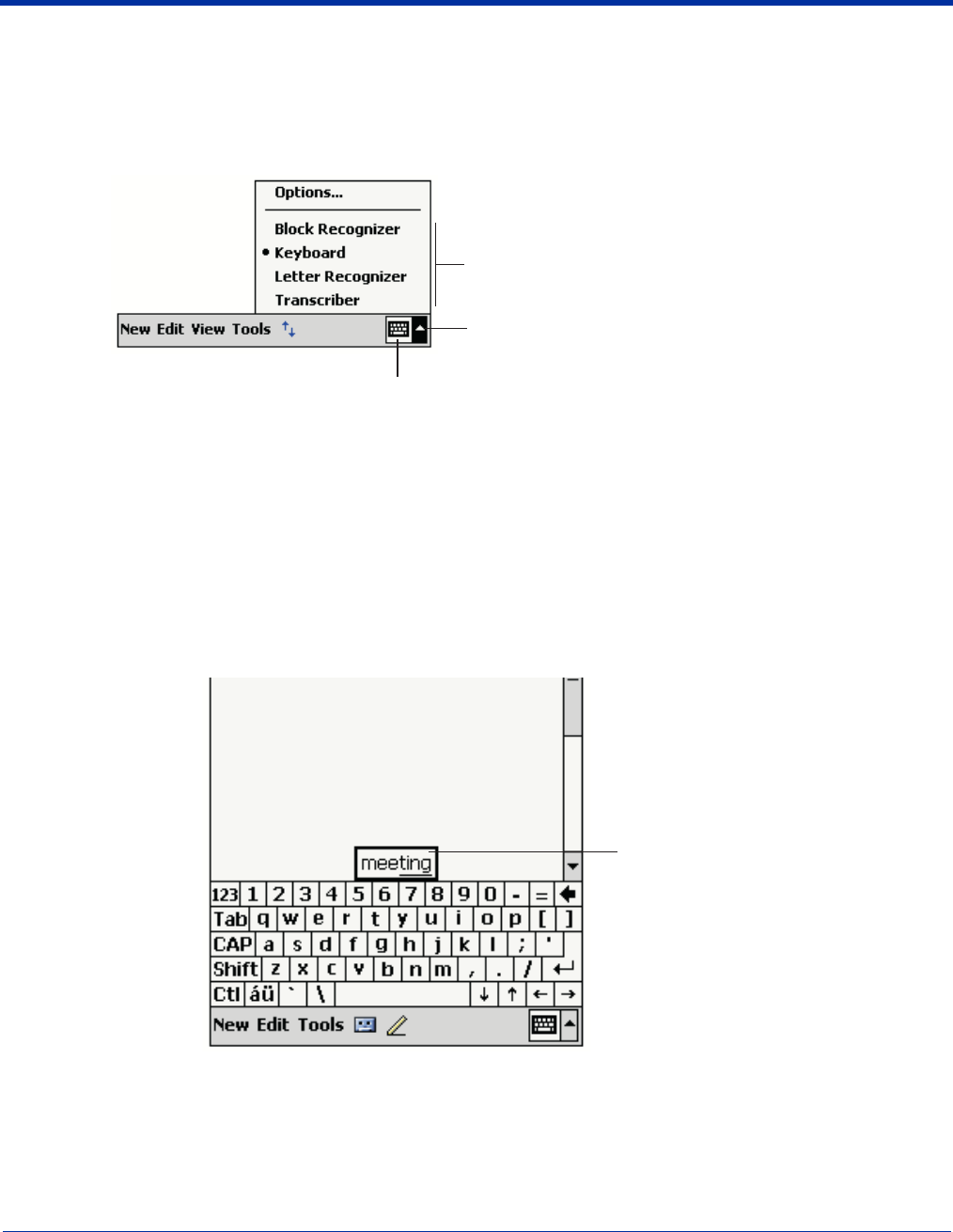
4 - 20 Dolphin® 9500/9550 Mobile Computer User’s Guide - GSM Draft
Entering Text Using the Input Panel
Use the input panel to enter information in any program on the Dolphin mobile computer. You can either type on the soft keyboard
or write on the touch screen using Letter Recognizer or Block Recognizer. In either case, the characters appear as typed text on
the screen.
To show or hide the input panel, tap the Input Panel button. Tap the arrow next to the Input Panel button to see your choices.
Note: The Transcriber tool is located on the Dolphin 9500/9550 Microsoft Companion CD and must be installed separately.
When you use the input panel, your terminal anticipates the word you are typing or writing and displays it above the input panel.
When you tap the displayed word, it is inserted into your text at the insertion point. The more you use your Dolphin 9500/9550
terminal, the more words it learns to anticipate.
To change word suggestion options, such as the number of words suggested at one time, tap Start> Settings>Personal
>Input> Word Completion tab.
Using the SIP
1. Tap the arrow next to the Input Panel button and select Keyboard.
2. On the soft keyboard that is displayed, tap the keys with your stylus.
Using the Letter Recognizer
With Letter Recognizer you can write letters using the stylus just as you would on paper.
1. Tap the arrow next to the Input Panel button and then Letter Recognizer.
Input Panel button.
Select an input method.
Tap to see your choices.
Tap here if this
is the right word.
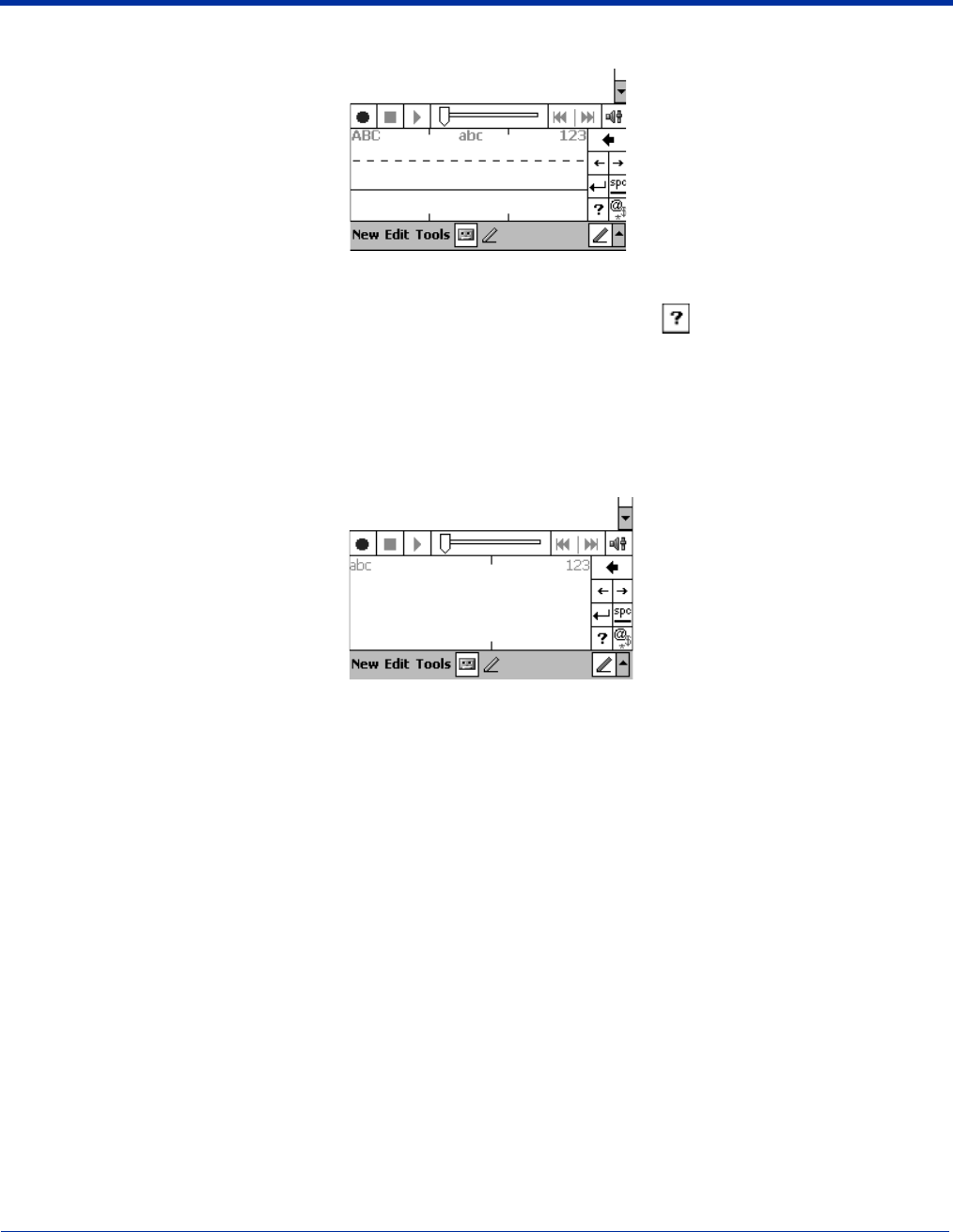
Dolphin® 9500/9550 Mobile Computer User’s Guide - GSM Draft 4 - 21
2. Write a letter in the box.
When you write a letter, it is converted to typed text that appears on the screen. For specific instructions on using Letter
Recognizer, with Letter Recognizer open, tap the question mark next to the writing area .
Using the Block Recognizer
With Block Recognizer you can input character strokes using the stylus that are similar to those used on other devices.
1. Tap the arrow next to the Input Panel button and then Block Recognizer.
2. Write a letter in the box.
When you write a letter, it is converted to typed text that appears on the screen. For specific instructions on using Block
Recognizer, with Block Recognizer open, tap the question mark next to the writing area.
Selecting Text
To edit or format typed text, select it by dragging the stylus across the text. You can cut, copy, and paste text by tapping and
holding the selected words and then tapping an editing command on the pop-up menu, or by tapping the command on the Edit
menu.
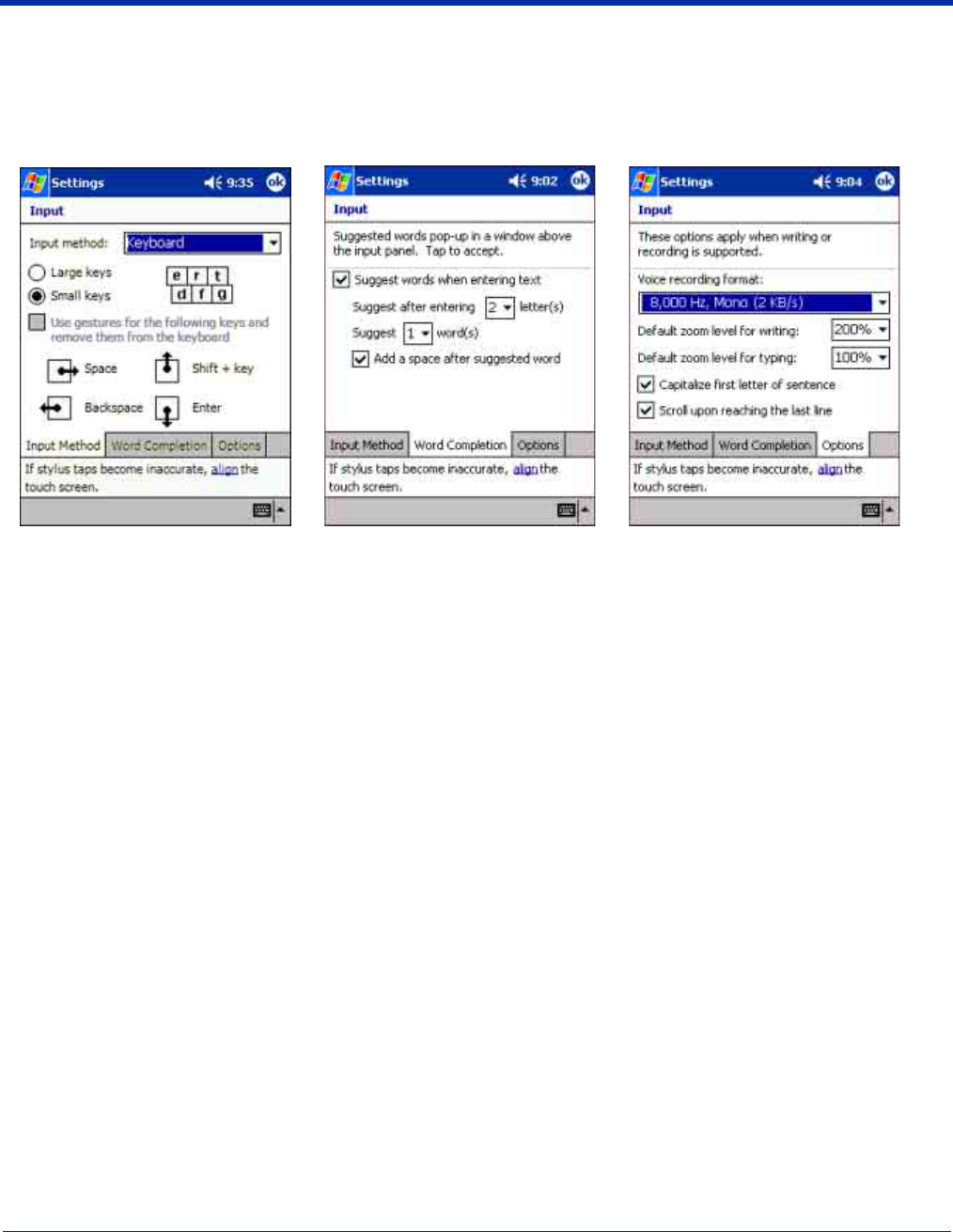
4 - 22 Dolphin® 9500/9550 Mobile Computer User’s Guide - GSM Draft
Input Panel Options
You can set input options by going to Start > Settings > Personal tab > Input.The following graphics are the tab windows where
you can customize the input panel to your preferences:
Input Method tab Word Completion tab Options tab
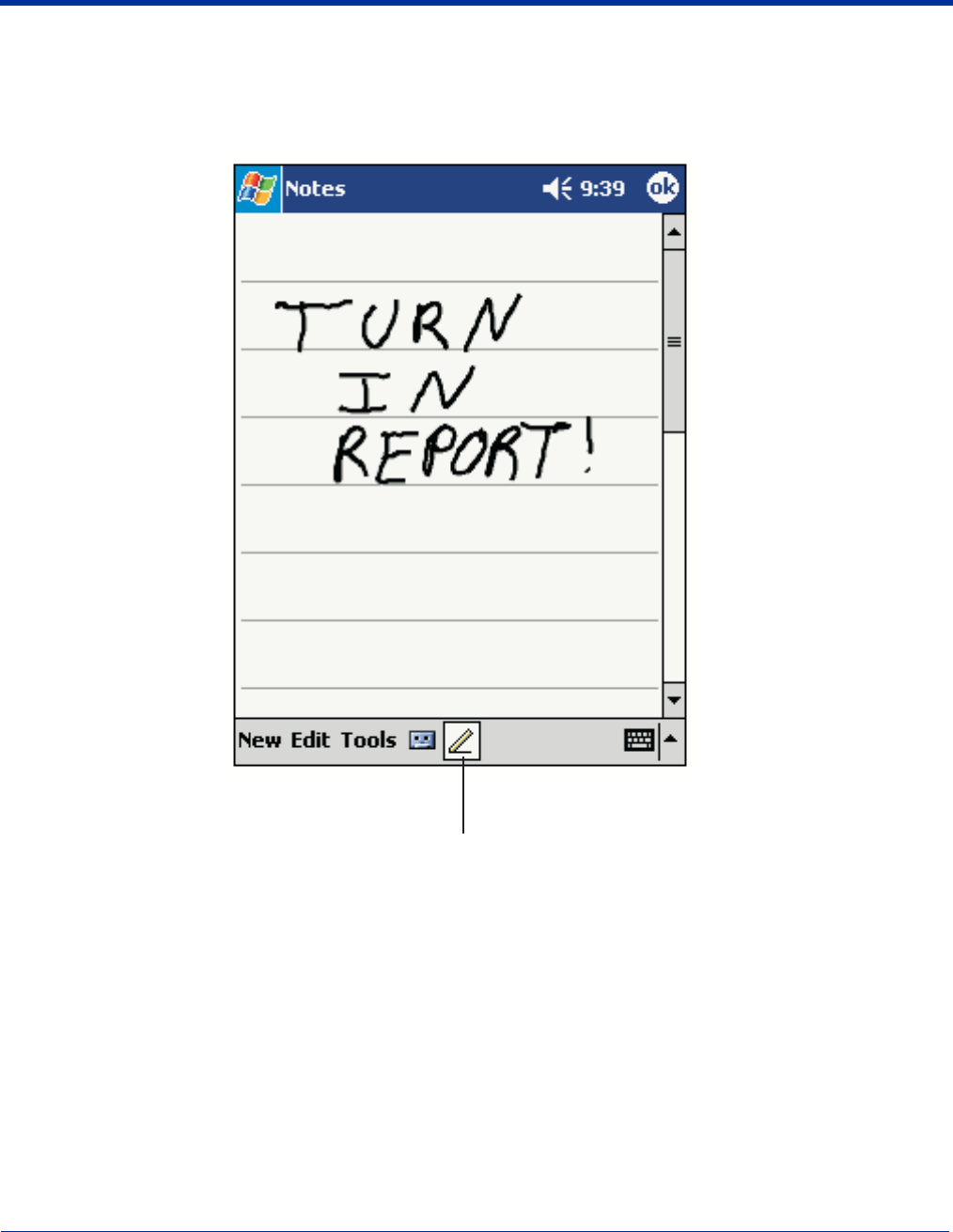
Dolphin® 9500/9550 Mobile Computer User’s Guide - GSM Draft 4 - 23
Writing on the Screen
In any program that accepts writing, such as the Notes program, and in the Notes tab in Calendar, Contacts, and Tasks, you can
use your stylus to write directly on the screen as you would on paper.
To write on the screen, tap the Pen button to switch to writing mode. This action displays lines on the screen to help you write.
Note: Some programs that accept writing may not have the Pen button. See the documentation for that program to find out how
to switch to writing mode.
To Select Writing
If you want to edit or format writing, you must select it first.
1. Tap and hold the stylus next to the text you want to select until the insertion point appears.
2. Without lifting, drag the stylus across the text you want to select.
If you accidentally write on the screen, tap Tools, then Undo and try again. You can also select text by tapping the Pen button
to deselect it and then dragging the stylus across the screen.
You can cut, copy, and paste written text in the same way you work with typed text: tap and hold the selected words and then
tap an editing command on the pop-up menu, or tap the command on the Edit menu.
Tap the Pen button and use
your stylus like a pen.
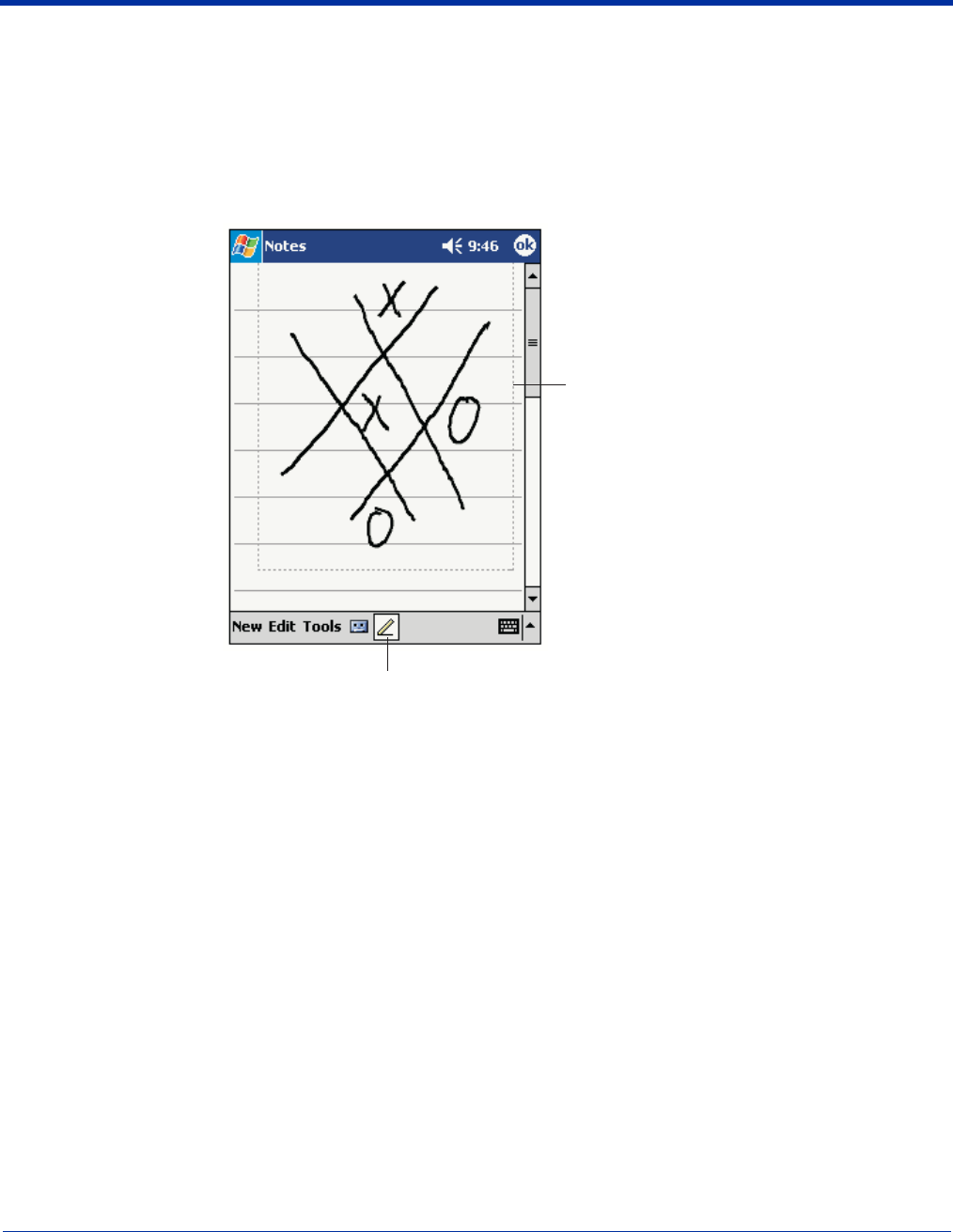
4 - 24 Dolphin® 9500/9550 Mobile Computer User’s Guide - GSM Draft
Drawing on the Screen
Drawing on the screen is similar to writing on the screen. The difference between writing and drawing on the screen is how you
select items and how they can be edited.
To create a drawing, cross three ruled lines on your first stroke. A drawing box appears. Subsequent strokes in or touching the
drawing box become part of the drawing. Drawings that do not cross three ruled lines will be treated as writing.
For example, selected drawings can be resized, while writing cannot.
Note: You may want to change the zoom level so that you can more easily work on or view your drawing. Tap Tools and then
a zoom level.
Selecting a Drawing
To edit or format a drawing, tap and hold the stylus on the drawing until the selection handle appears. To select multiple drawings,
deselect the Pen button and then drag to select the drawings you want.
You can cut, copy, and paste selected drawings by tapping and holding the selected drawing and then tapping an editing
command on the pop-up menu, or by tapping the command on the Edit menu. To resize a drawing, make sure the Pen button
is not selected, and drag a selection handle.
The drawing box indicates
the boundaries of the drawing.
Pen button.
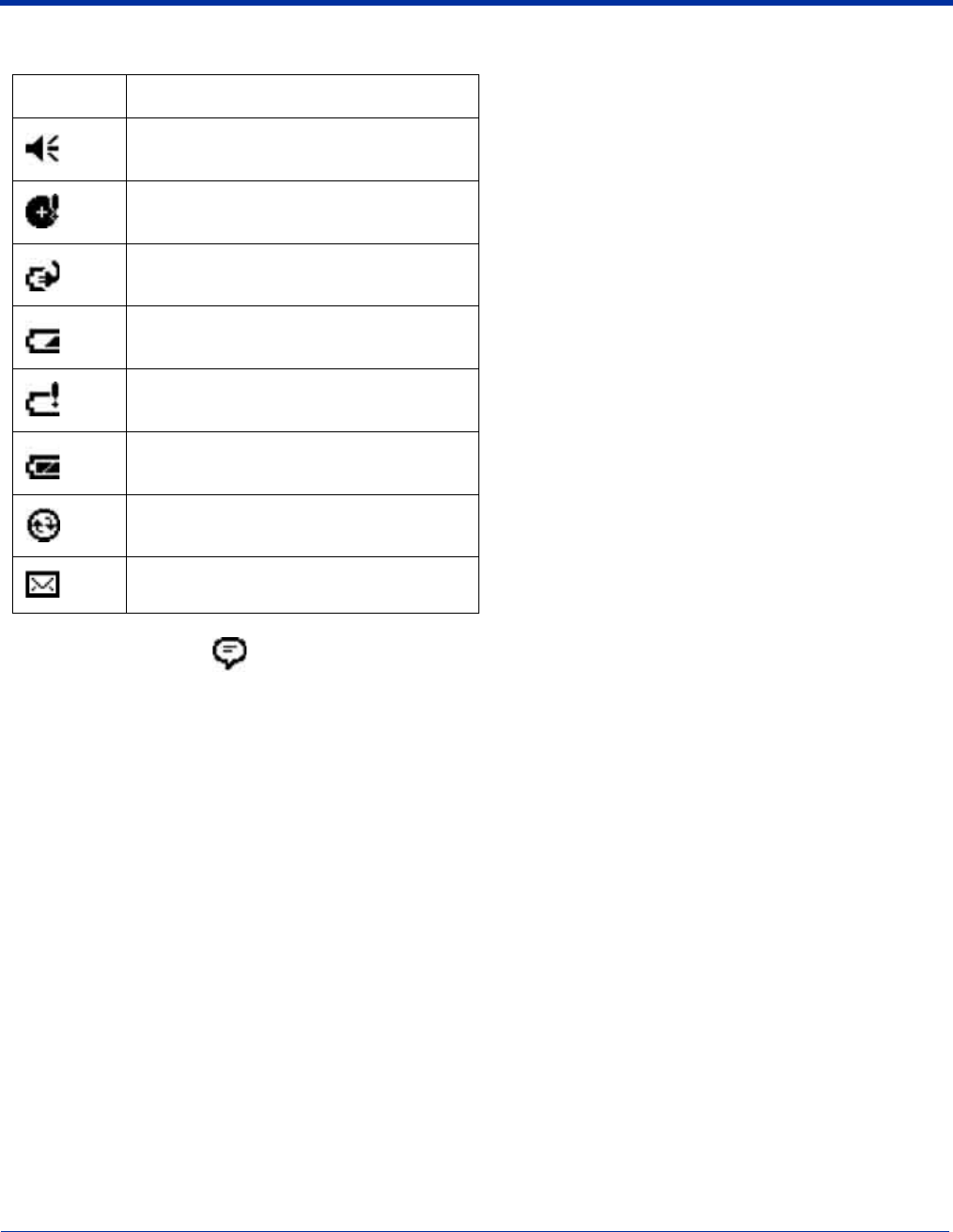
Dolphin® 9500/9550 Mobile Computer User’s Guide - GSM Draft 4 - 25
Status Icons
Note: The Notification icon displays if more notification icons need to be displayed than there is room to display them. Tap
the icon to view all notification icons.
Notifications
Your device reminds you in a variety of ways when you have something to do. For example, if you’ve set up an appointment in
Calendar, a task with a due date in Tasks, or an alarm in Clock, you’ll be notified in any of the following ways:
• A message box appears on the screen.
• A sound, which you can specify, is played.
• A light flashes on your device.
To choose reminder types and sounds for your device, tap Start > Settings > Personal tab > Sounds & Notifications. The
options you choose here apply throughout the device.
Status Icon Meaning
Turns all sounds on and off
Backup battery is low
Main batteries are charging
Main batteries are low
Main batteries are very low
Main batteries are full
Synchronization is beginning or ending
Notification that one or more e-mail
messages were received
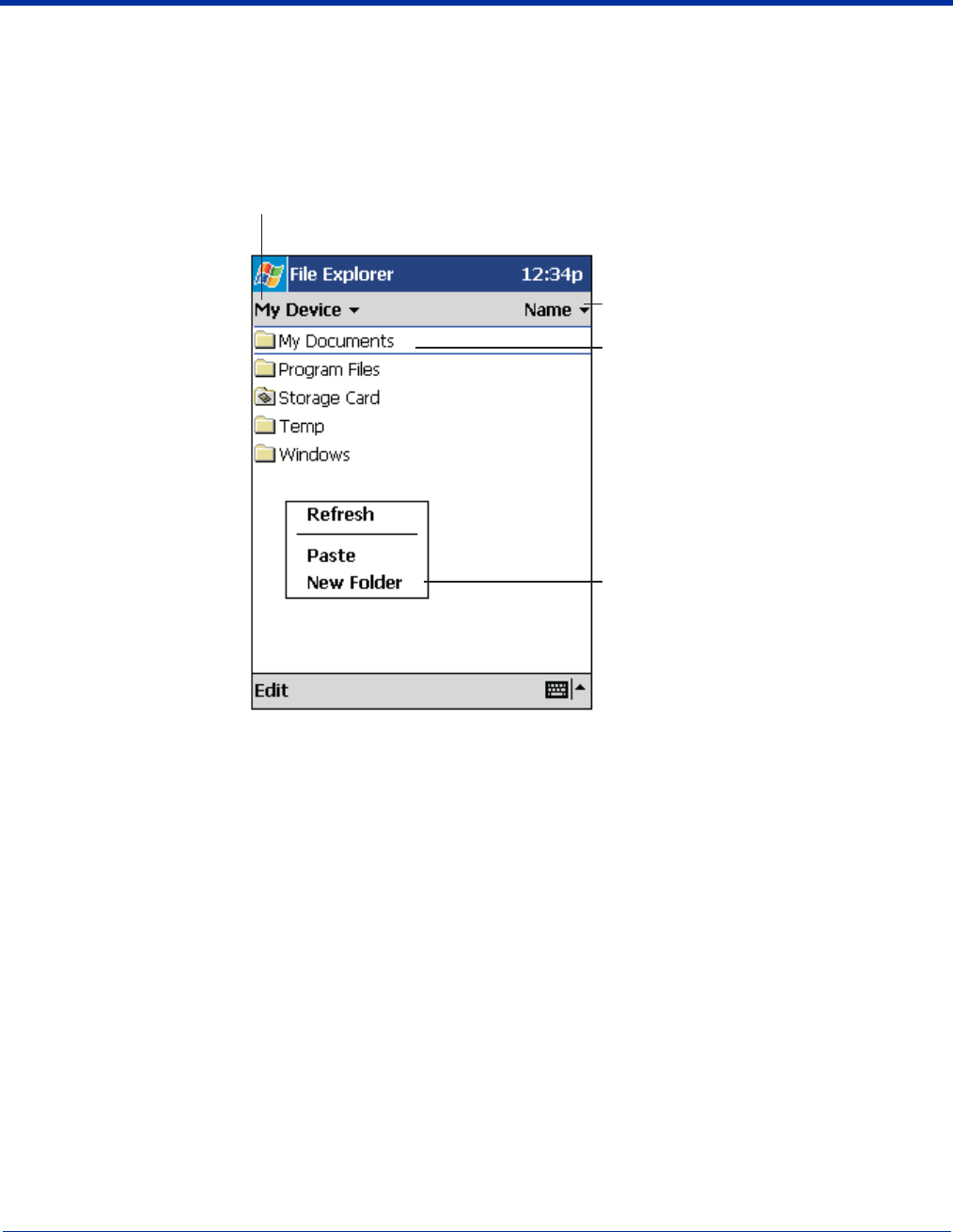
4 - 26 Dolphin® 9500/9550 Mobile Computer User’s Guide - GSM Draft
Finding and Organizing Information
The Find feature on your Dolphin mobile computer helps you quickly locate information. On the Start menu, tap Find. Enter the
text you want to find, select a data type, and then tap Go to start the search.
To quickly find information that is taking up storage space on your device, select Larger than 64 KB in Type.
You can also use the File Explorer to find files on your device and to organize these files into folders. On the Start menu, tap
Programs, and then File Explorer.
You can move files in File Explorer by tapping and holding the item you want to move, and then tapping Cut or Copy and Paste
on the pop-up menu.
Tap the folder name
to open it.
Tap and hold to create
a new folder.
Select the sort order
for the list.
Tap to change folders.
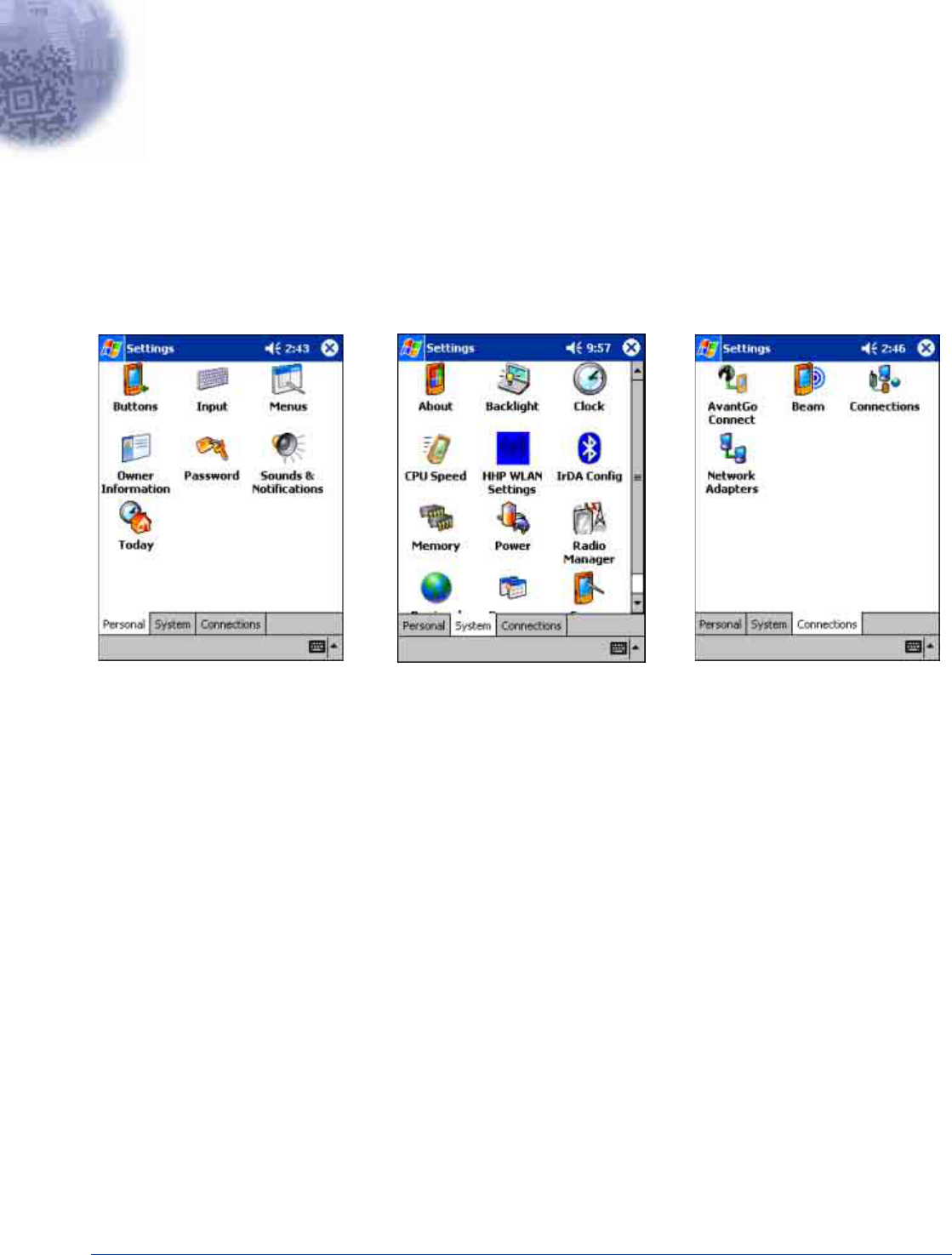
Dolphin® 9500/9550 Mobile Computer User’s Guide - GSM Draft 5 - 1
5
Settings
Overview
System settings are available off the Start menu. Go to Start > Settings and the system settings screen opens displaying the
Personal tab. System settings are comprised of the following three tabs:
Personal tab Enables you to customize buttons, input methods, menus, etc. - see Personal Tab on page 5-2.
System tab Enables you to adjust system settings - see System Tab on page 5-5.
Connections tab Enables you to establish network and connection settings - see Connection Settings on page 5-16.
Personal tab System tab Connections tab
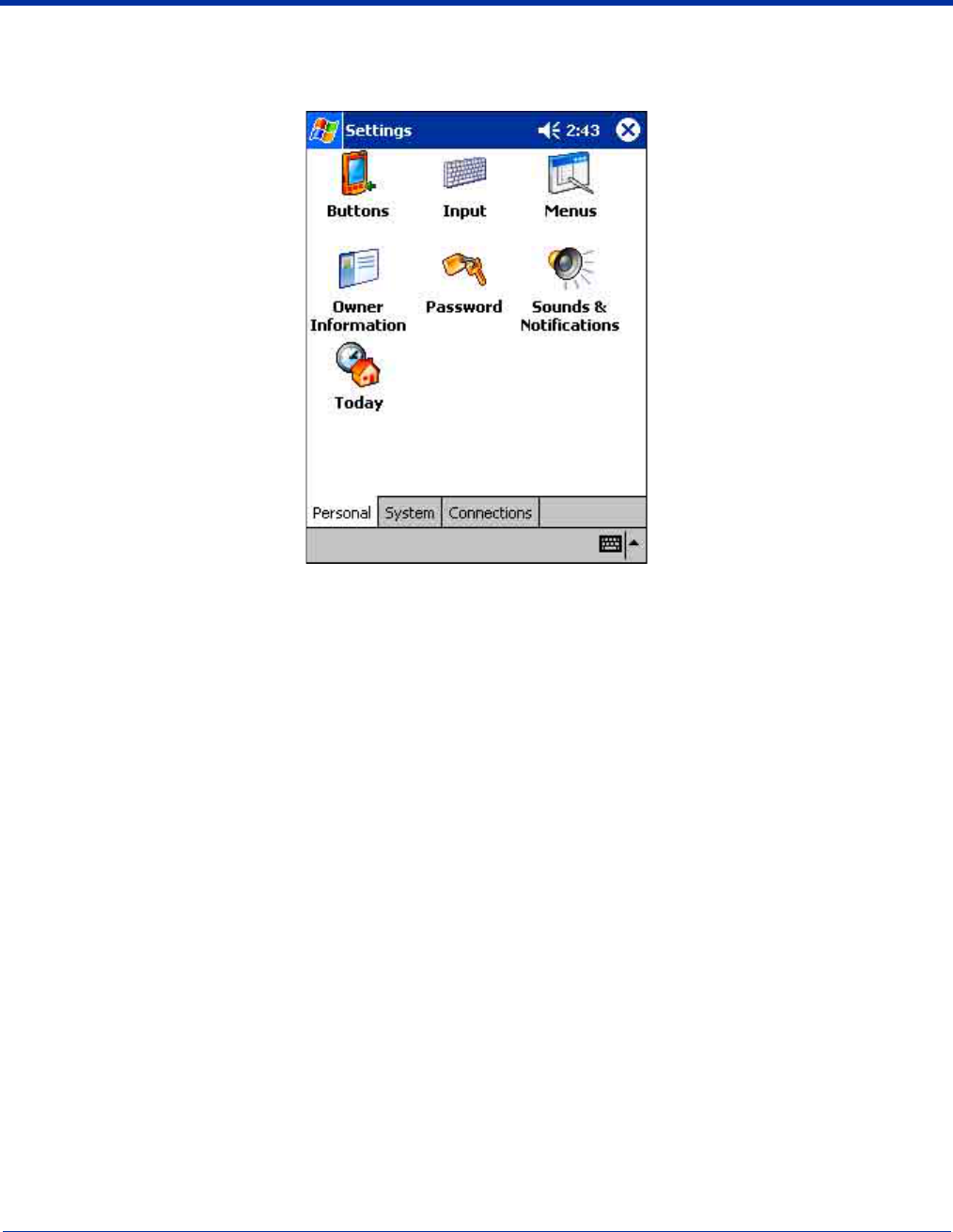
5 - 2 Dolphin® 9500/9550 Mobile Computer User’s Guide - GSM Draft
Personal Tab
To access the Personal tab, go to Start > Settings. The screen opens displaying the Personal tab.
Button Name Tapping this icon enables you to …
Buttons Customize buttons to perform functions.
To use this setting, the HotKeys HHP Utility must be initialized. Tap Start > HHP Utils > HotKeys
(the icon is the same). The HotKeys utility initializes. Return to the Personal tab and tap the Buttons
icon.
Input Customize the input panel. For details, see Input Panel Options on page 4-22.
Menus Customize what appears on the Start menu, and to enable a pop-up menu from the New button.
Owner Information Enter your contact information.
Password Password protect the terminal to limit access to your device.
Sounds & Notifications Set the sound volume, enable and disable sounds for specific actions, and set sound parameters for
system notifications.
Today Customize the look and the information that is displayed on the Today screen
Note: Personal settings are stored in RAM memory. They are replaced by system defaults after each hard reset. For more
information about resets, see Soft Reset (Warm Boot) on page 2-12.
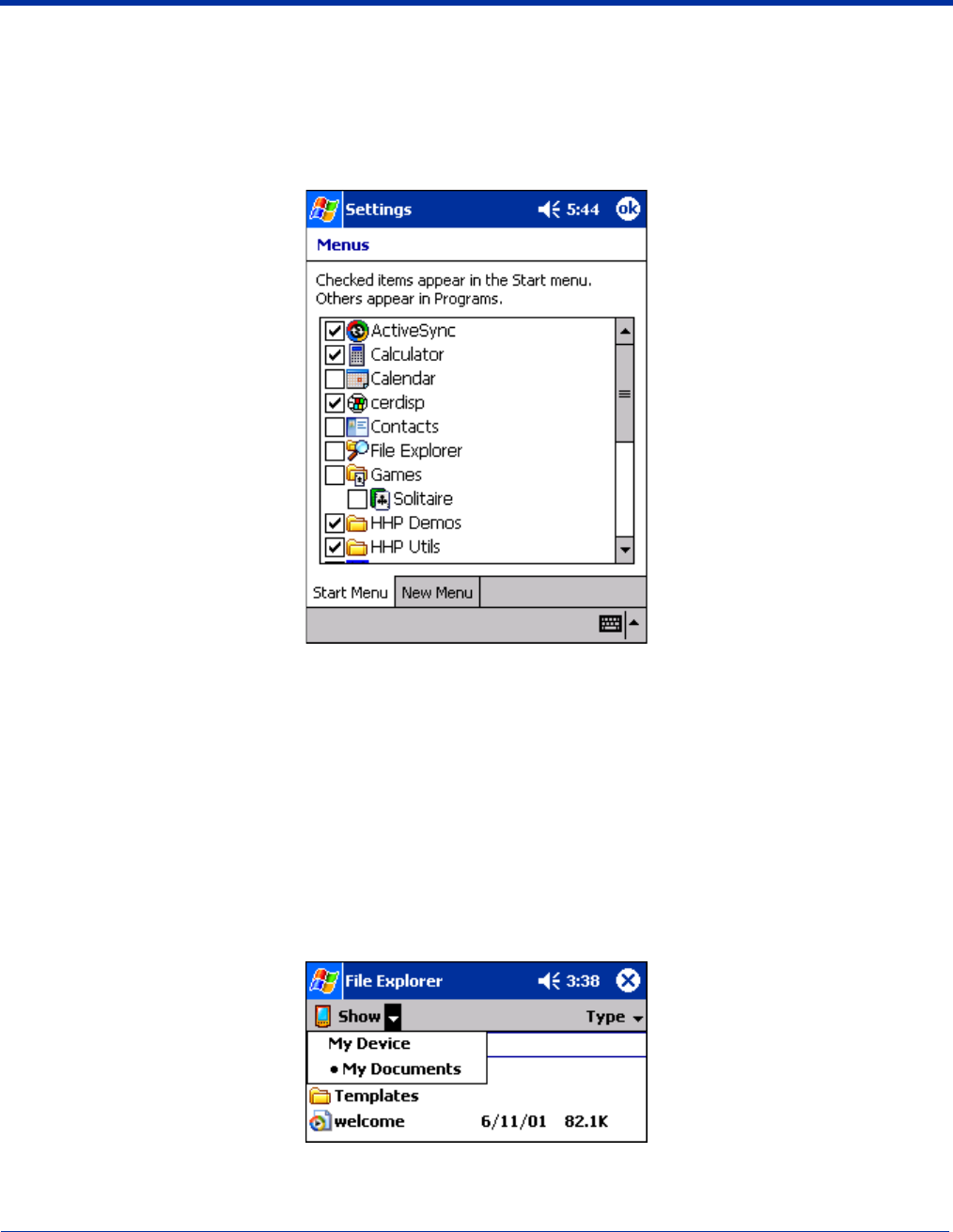
Dolphin® 9500/9550 Mobile Computer User’s Guide - GSM Draft 5 - 3
Adding a Program to the Start Menu
You can add existing programs you use often, such as File Explorer, to the Start menu for faster access. You are not installing
the program, just re-routing access to it.
Using System Settings
1. Tap Start > Settings > Personal tab > Menus > Start Menu tab.
2. Tap the check box for the program you want to add and tap OK to save.
3. Tap the Start menu.
4. Verify that the program appears.
Using File Explorer
If you do not see the program listed, you can either use File Explorer on the device to move the program or ActiveSync on the
desktop computer to create a shortcut to the program and place the shortcut in the Start Menu folder.
Note: We recommend that you Copy and Paste Shortcut so that you do not alter your program configurations by accident. Using
Copy and Paste Shortcut (as opposed to Cut and Paste) ensures that the program files remain where they need to be for
the system to find them to perform system functions.
1. Tap Start > Programs > File Explorer, and navigate to the program.
File Explorer opens to My Documents by default; to see a list of all folders, tap the folder name and then My Device.
2. Tap and hold on the program, then tap Copy on the pop-up menu.
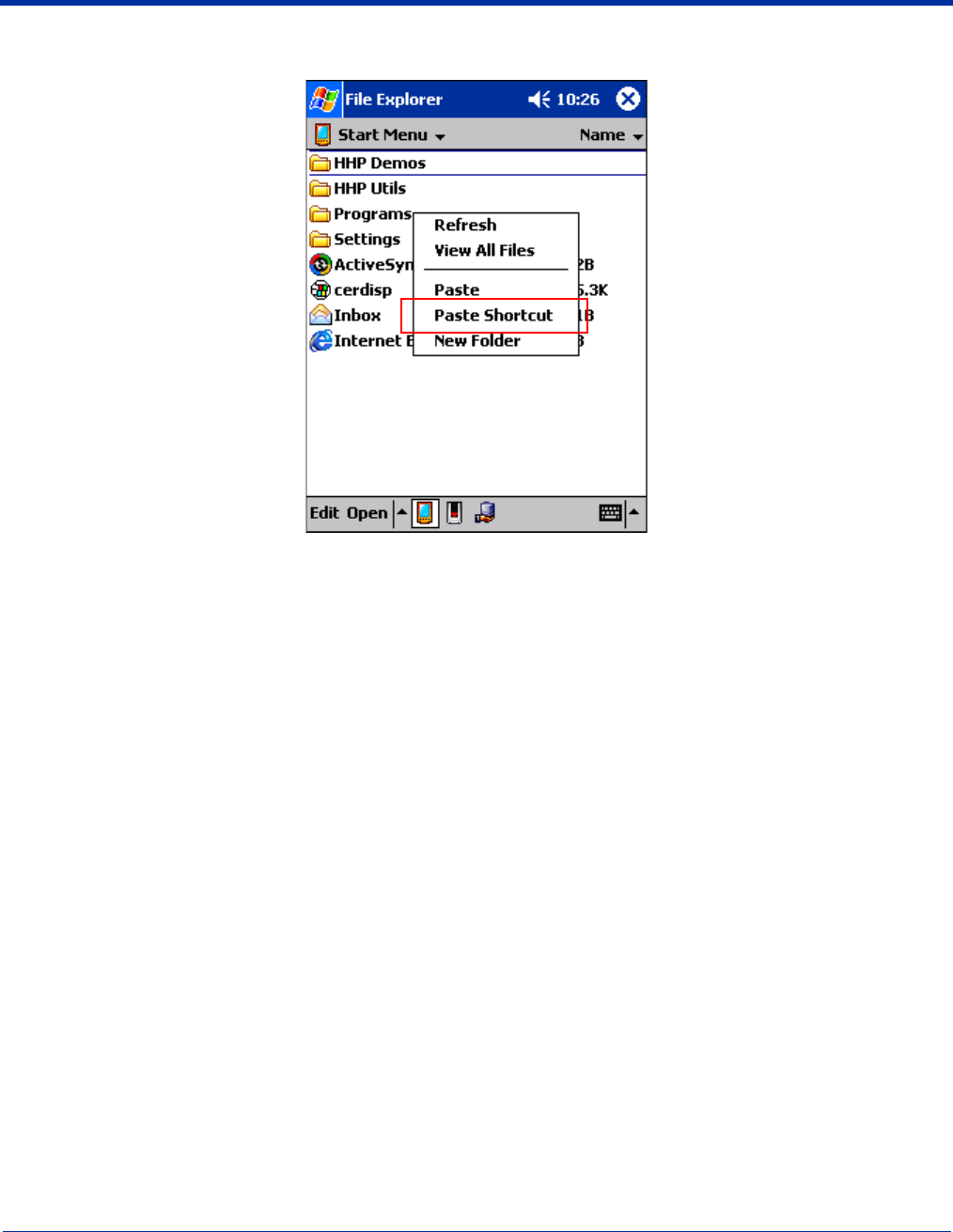
5 - 4 Dolphin® 9500/9550 Mobile Computer User’s Guide - GSM Draft
3. Navigate to the Windows folder and open the Start Menu (My Device > Windows > Start Menu), tap and hold a blank area
of the window, and tap Paste Shortcut on the pop-up menu.
4. Tap the Start menu.
5. Verify that the program now appears.
Using ActiveSync on the Desktop Computer
Here, you are performing the same basic process as on the terminal, except that you are using the Explore (Windows Explorer)
utility to cut and paste.
1. Open ActiveSync > Explore.
2. Navigate to the program.
3. Right-click on the program and select Create Shortcut.
4. Select the shortcut, right-click, and select Cut.
5. Navigate to the Start Menu folder (Windows > Start Menu).
6. Right-click on an empty area and select Paste.
7. On the terminal, tap the Start menu.
8. Verify that program appears.
For more information, see ActiveSync Help.
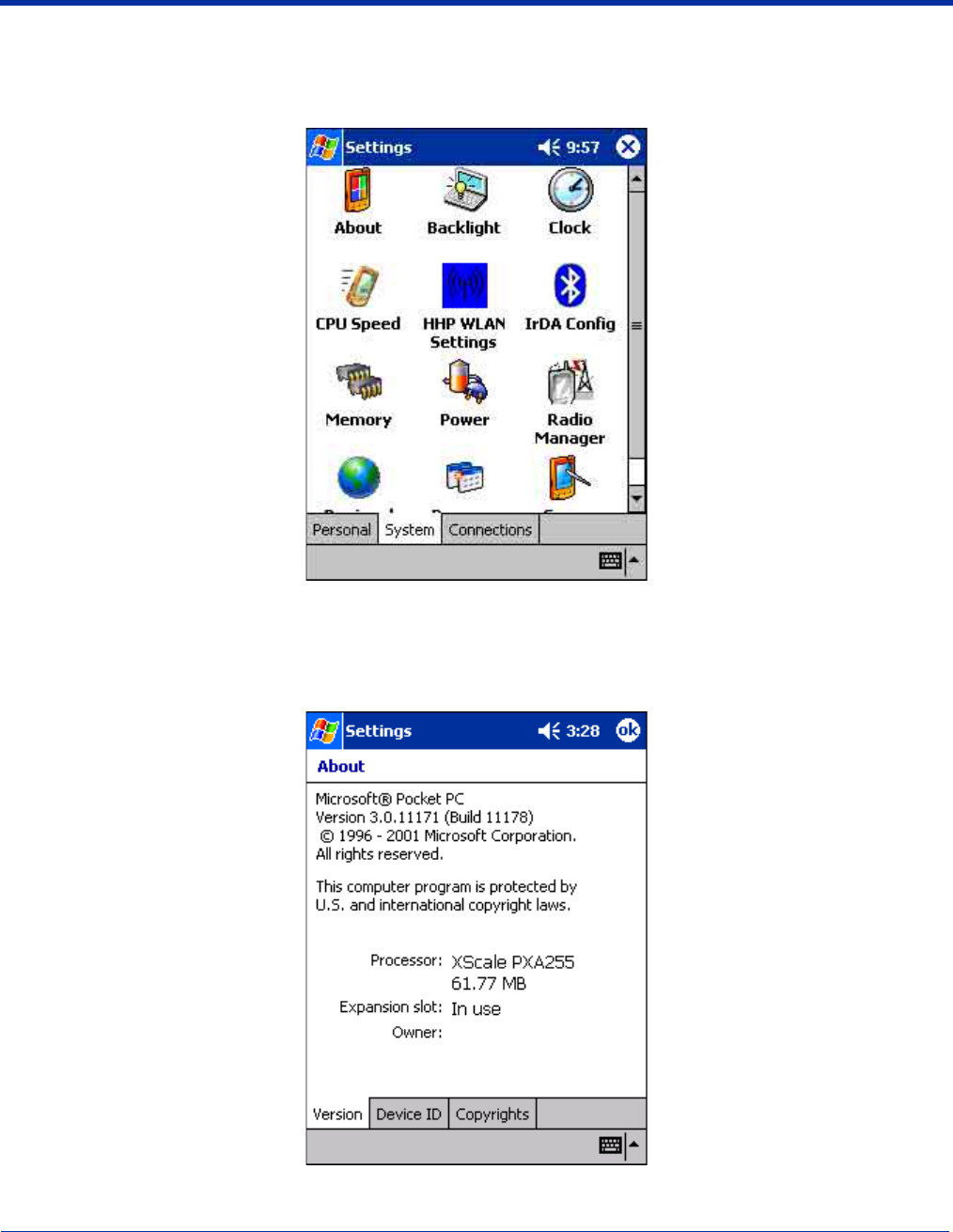
Dolphin® 9500/9550 Mobile Computer User’s Guide - GSM Draft 5 - 5
System Tab
The System tab enables you to verify and sometimes alter system parameters. To access the System tab, go to Start > Settings
> System tab. Tap the appropriate icon to open that system setting.
About
The About system setting displays specific information about what is loaded on the terminal. It contains three tabs:
Version tab Displays the information about the software, operating system, and processor of the terminal.
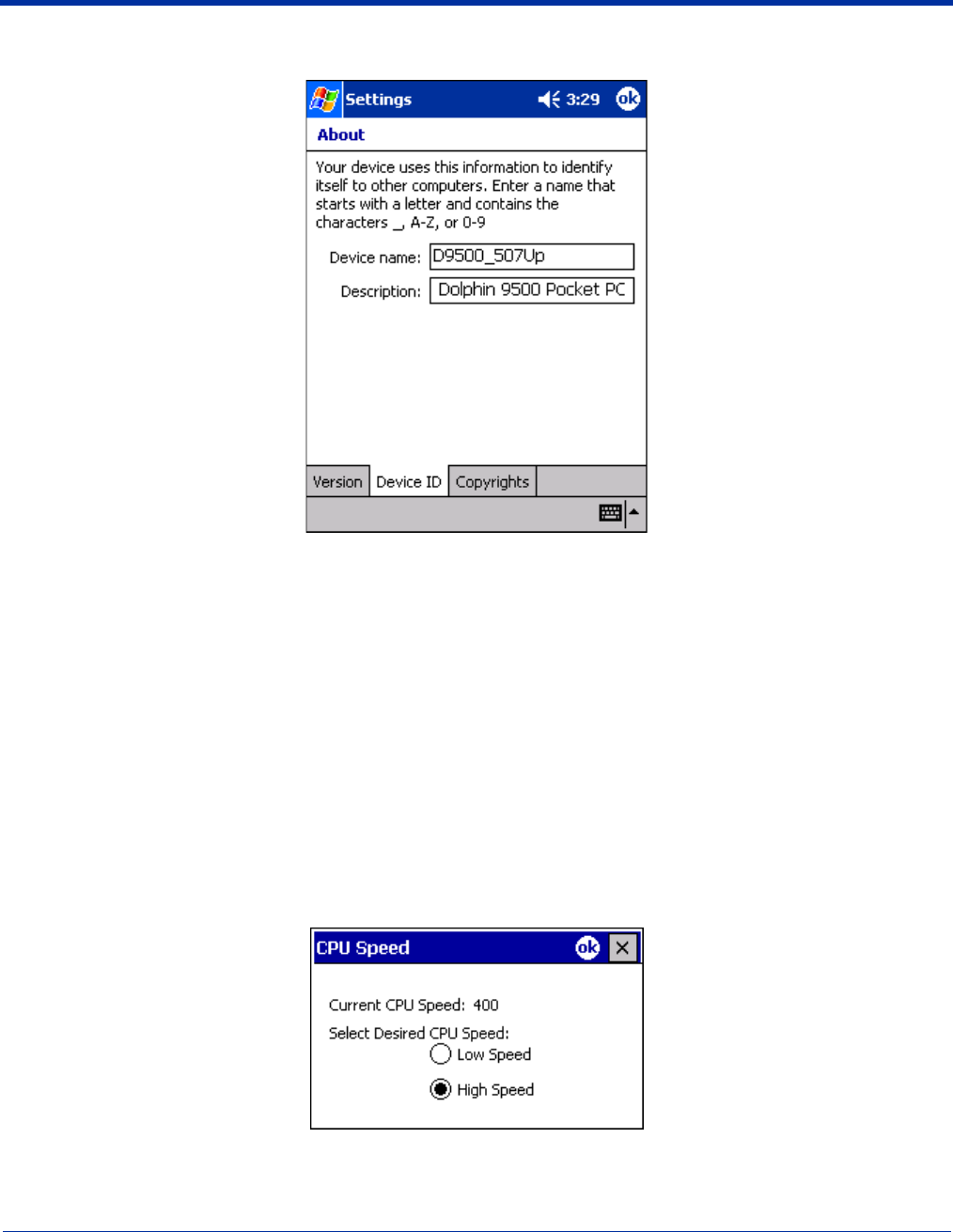
5 - 6 Dolphin® 9500/9550 Mobile Computer User’s Guide - GSM Draft
Device ID Displays the information the device uses to identify itself to other computers. It can be important to
know this information if the Dolphin terminal is going to be part of a networked system of devices.
The name or description can be changed according to the parameters on the screen. The first time
this screen is opened, it displays the system’s default name and description for the device. The
Device name is the name used for ActiveSync connection.
Copyrights tab Displays important copyright information.
Backlight
The Backlight system setting enables you to customize backlight functionality for the display. For more information, see Adjusting
the Backlight on page 4-15.
Clock
This setting sets the system clock. Appointments, scheduled events, and any function on a schedule runs off this setting. You
need to set the time zone and time after each hard reset; see Setting the Time and Date on page 2-10.
CPU Speed
This system setting enables you to see and change the current speed of the Central Processing Unit (CPU).
The default is High Speed at 400MHz. Low Speed is 200MHz.
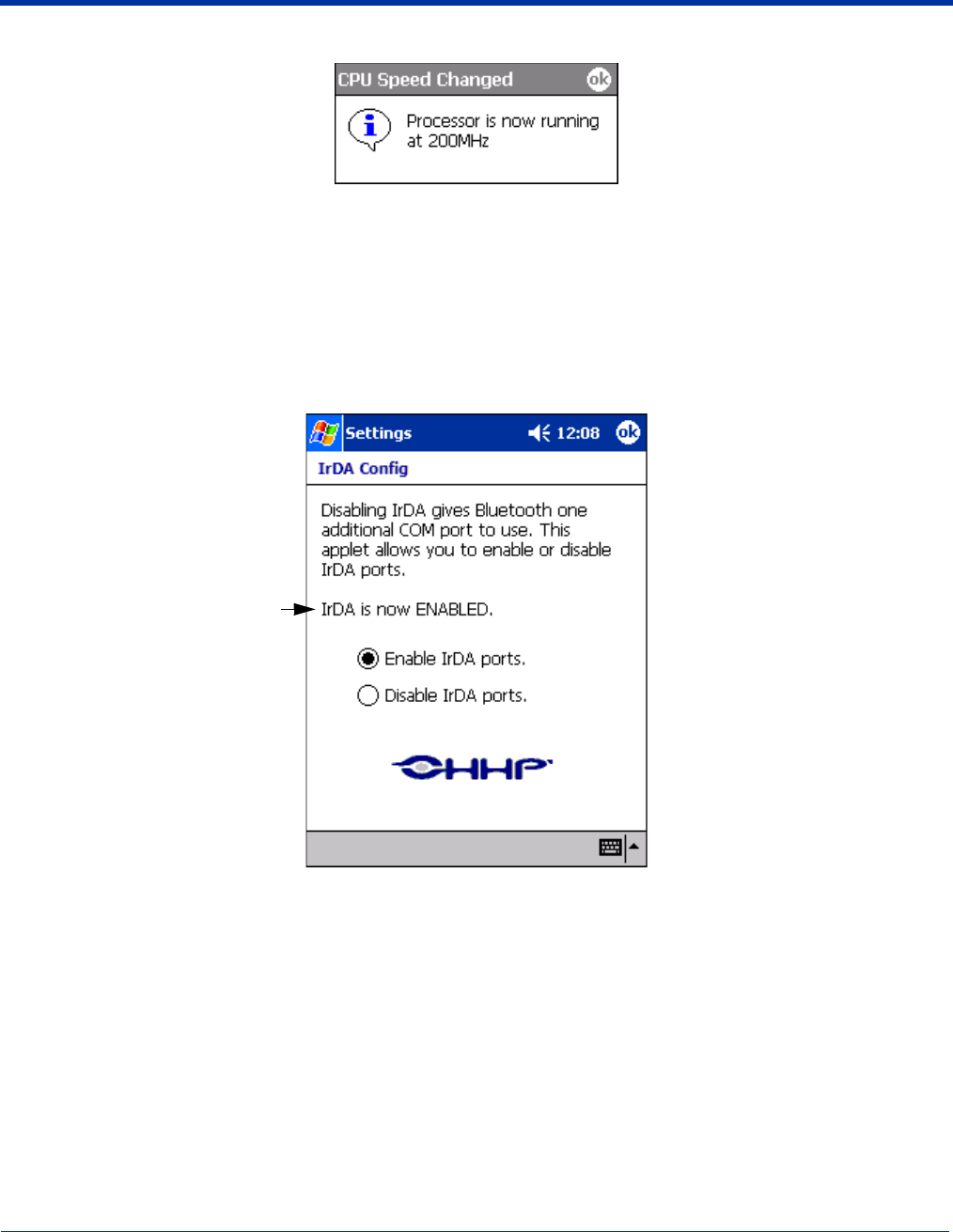
Dolphin® 9500/9550 Mobile Computer User’s Guide - GSM Draft 5 - 7
To change the default, select Low Speed and tap OK. A message appear confirming the changed and now current CPU speed.
Tap OK to save the change.
HHP WLAN Settings
This option appears on the Settings tab only if an 802.11b radio is installed on the device. For more information, see The Status
Icon on page 7-10.
IrDA Config
This system setting allows you to verify the IrDA port settings.
The IrDA com port can be disabled to free up a com port. This is useful if, for example, you are using a Bluetooth radio and want
to connect the terminal to additional Bluetooth devices.
To Disable the IrDA Port
1. Tap Disable IrDA ports.
2. You receive a message stating that you need to reset the terminal before the change takes effect. Tap OK.
3. Perform a soft reset; see Soft Reset (Warm Boot) on page 2-12.
4. Go to Start > Settings > System tab > IrDA and verify that the screen says “IrDA is now DISABLED.”
Always displays the current status
of the IrDA port. Enabled is the
default.
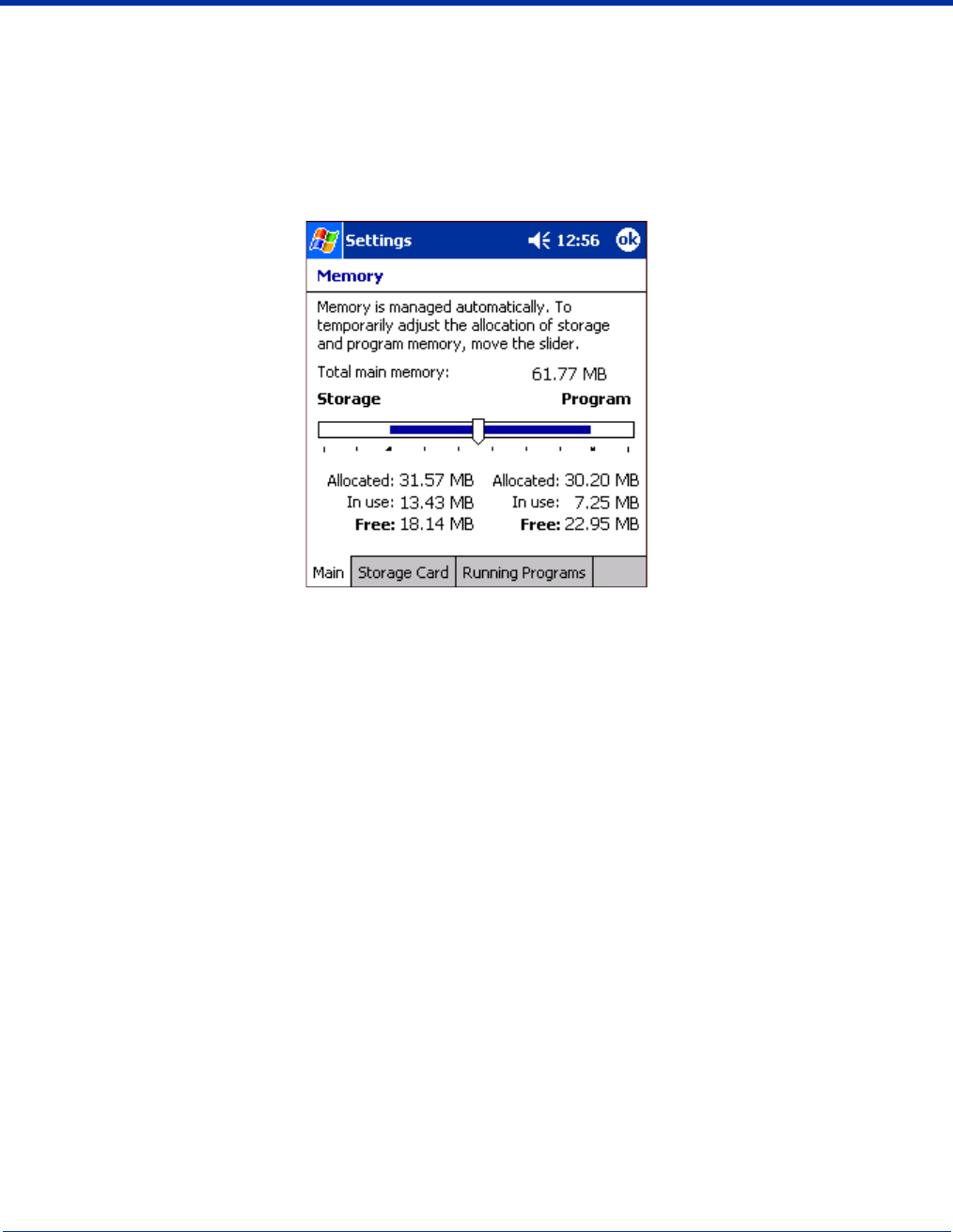
5 - 8 Dolphin® 9500/9550 Mobile Computer User’s Guide - GSM Draft
Memory
The Memory system setting enables you to review and manage both RAM (volatile) and IPSM/Storage Card (non-volatile)
memory. Access this system setting whenever you receive system messages about memory.
There are three tabs: Main, Storage Card, and Running Programs.
Main tab This tab displays current capacity and usage of the 64MB of on-board, volatile RAM memory. This is
the memory used for running and storing programs as well as storing program data.
Total main memory The total memory capacity of current RAM memory.
Storage The part of RAM memory used for storing programs and program data.
Program The part of RAM memory used to run programs.
Fields Under Storage and Memory
Allocated Displays the current MB of memory allocated for Storage and Program use.
In use Displays the total MB of that allocated memory being used in Storage and Program memory
functions.
Free Displays the total MB of memory available for Storage and Programs use.
To Increase/Decrease RAM Memory
To increase Program or Storage memory, tap, hold, and drag the slider towards the kind of memory you want to increase. The
three fields adjust automatically; Program memory decrease when you increase Storage memory and vice versa.
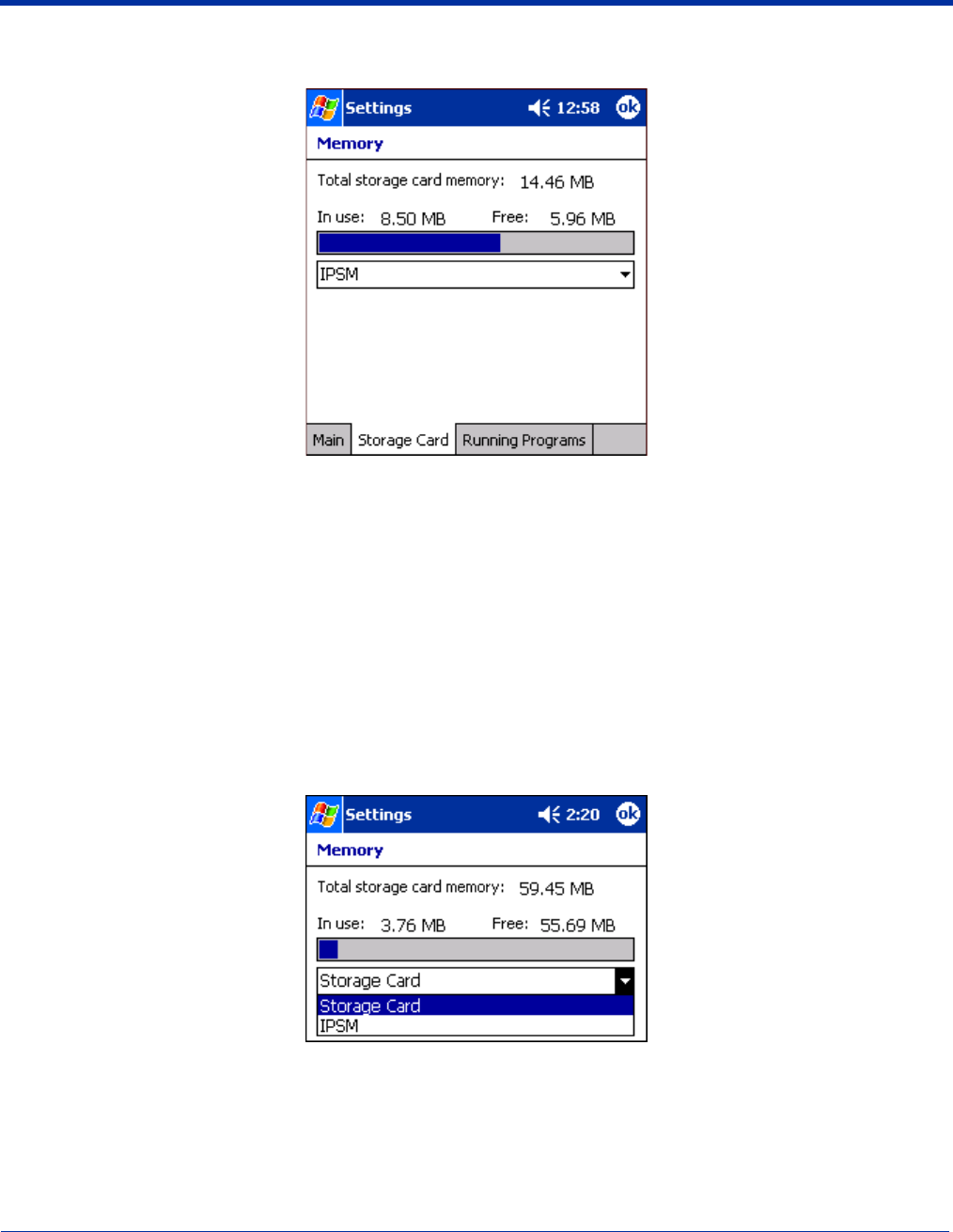
Dolphin® 9500/9550 Mobile Computer User’s Guide - GSM Draft 5 - 9
Storage Card tab This tab displays the current capacity and usage statistics of the selected memory type; IPSM or
Storage Card. Select the memory type from the drop-down list. IPSM is selected automatically.
IPSM Short for Intel Persistent Storage Manager, this is14MB of on-board Flash memory that is non-
volatile. Because this memory is non-volatile, data or programs stored in IPSM are not affected when
power is removed. Autoinstall programs, for example, are stored in IPSM so that they are always
installed at cold-boot startup.
When IPSM is selected in the drop-down list, the Storage Card tab displays the IPSM memory
capacity and usage statistics.
Storage Card You can install additional memory in Dolphin terminals - see Secure Digital Memory Interface on page
3-8. If a storage card is installed in the terminal, a Storage Card entry appears in the drop-down list.
Select Storage Card and the Storage Card tab displays the current capacity and usage statistics of
the installed storage card.
Total storage
card memory
The total MB of memory capacity of the selected memory.
In use The MB currently being used.
Free The MB that is still available for use.
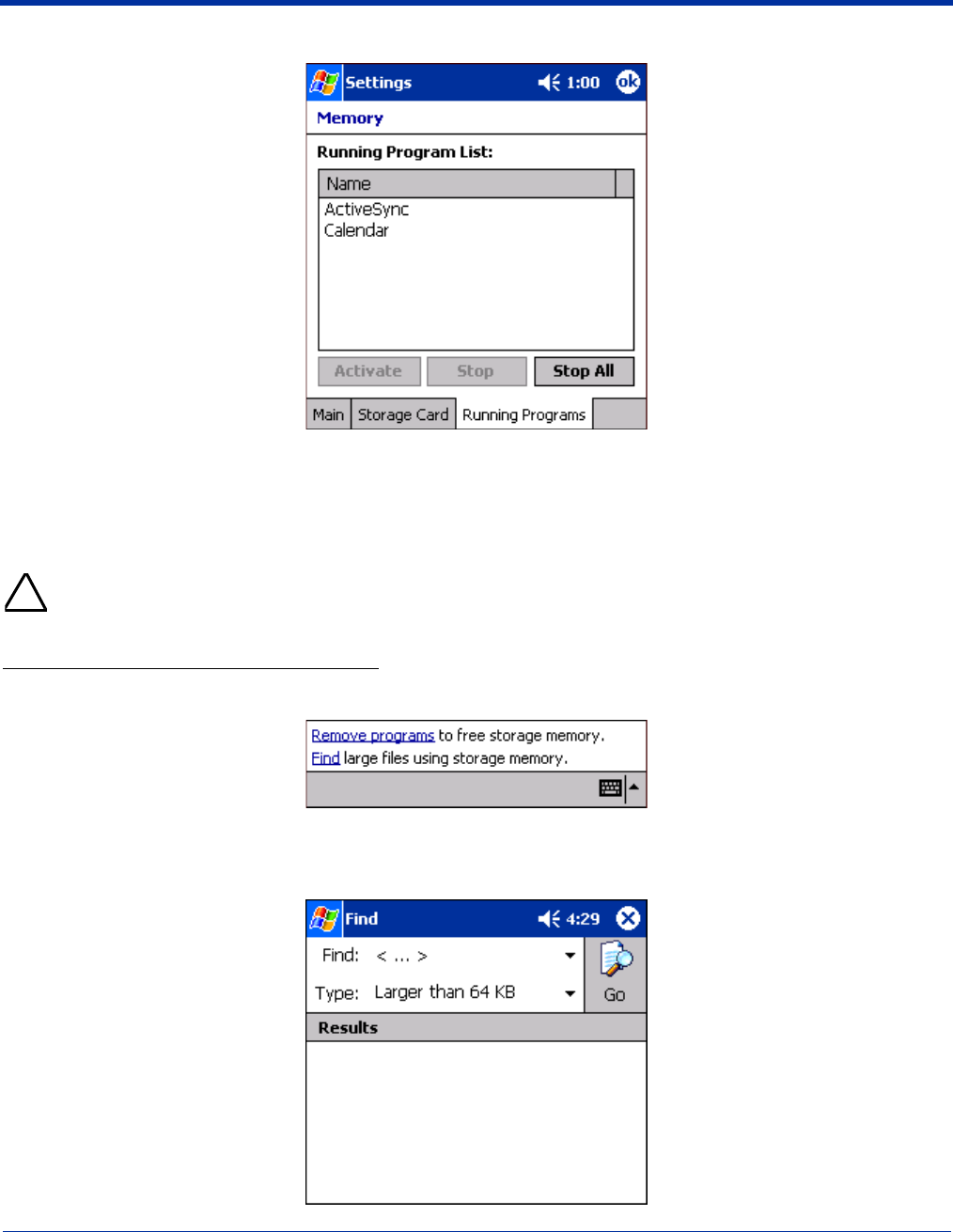
5 - 10 Dolphin® 9500/9550 Mobile Computer User’s Guide - GSM Draft
Running Programs tab Displays the software programs currently using Storage memory.
Check this tab when you are receiving out of memory errors or when the mobile computer is running slowly.
You can
• Select a program in the list and tap Stop to stop it from running (and therefore from using memory), or
•Tap Stop All to automatically stop all running programs.
Anytime you stop a running program, it frees up RAM memory. Be advised that, when you stop a program here, any
unsaved data in that program is lost. To free up memory without risking data loss, return to the running program, save
your data, and close the application.
Links at the Bottom of the Memory Tabs
At the bottom of all three Memory tabs are two links:
Remove programs Opens the Remove Programs system setting. For details, see Remove Programs on page 5-13.
Find Enables you to search for large files using storage memory. It opens the Find screen with Larger than
64KB already selected in the Type field.
!
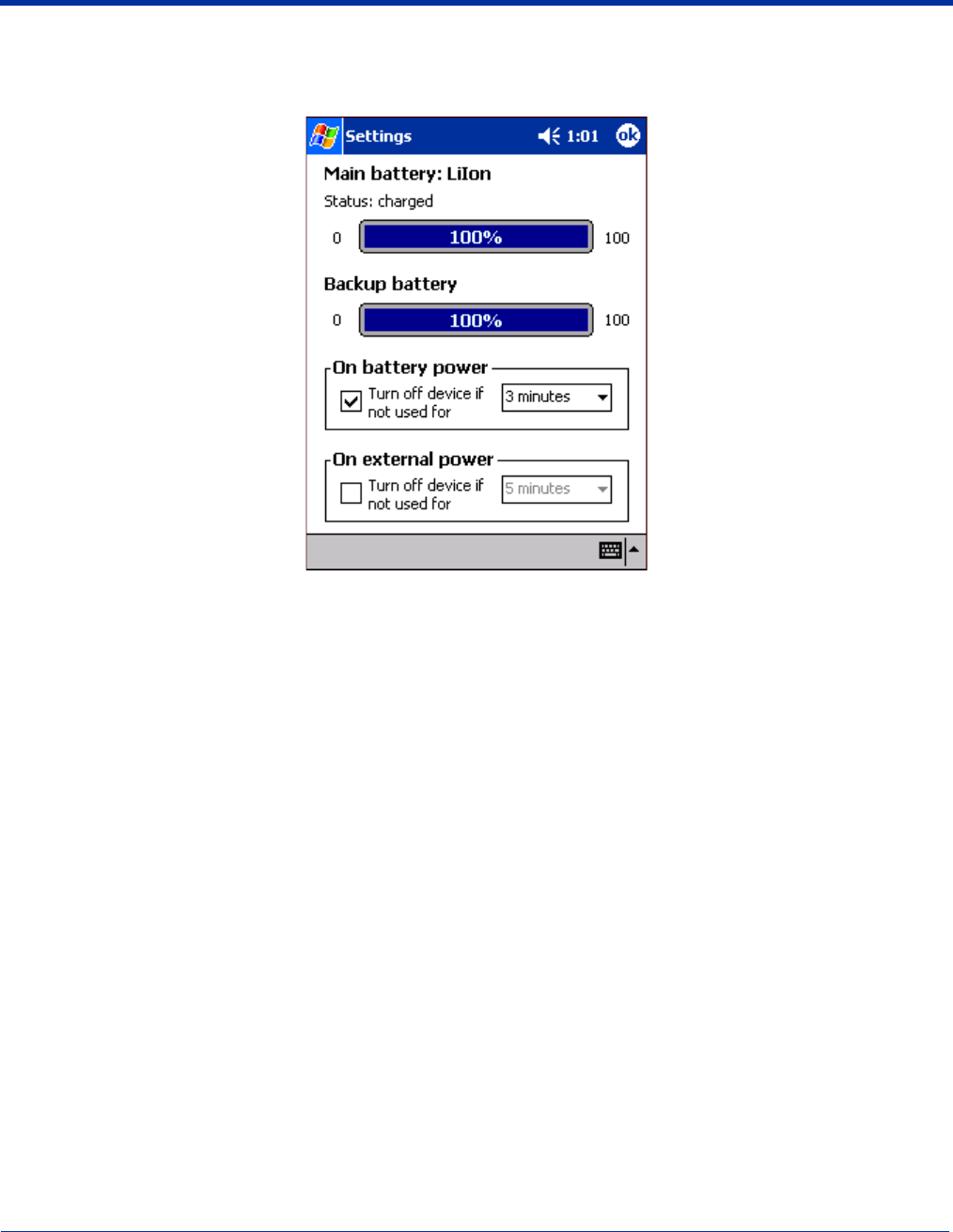
Dolphin® 9500/9550 Mobile Computer User’s Guide - GSM Draft 5 - 11
Power
The Power system setting enables you to check the remaining charge of both the main and backup batteries. For more
information, see Batteries on page 3-10.
You can also set automatic turn-off times for the terminal to conserve power. When the device is “turned off,” that means that it
goes into suspend mode. For more information on suspend mode, see Suspend Mode on page 2-12.
Radio Manager
The Radio Manager enables you to see which radios are powered up on the Dolphin terminal. In this system setting, you power
up and power down radios loaded on the terminal. For details, see The Radio Manager on page 4-18.
Regional Settings
Regional Settings enables you to customize the appearance and formatting to your geographic region. Specifically, you can
customize numbers (number of decimal places allowed, for example), currency (using the $ or € symbol, for example), time, and
date. These specifications apply to all screens, including the Today screen.
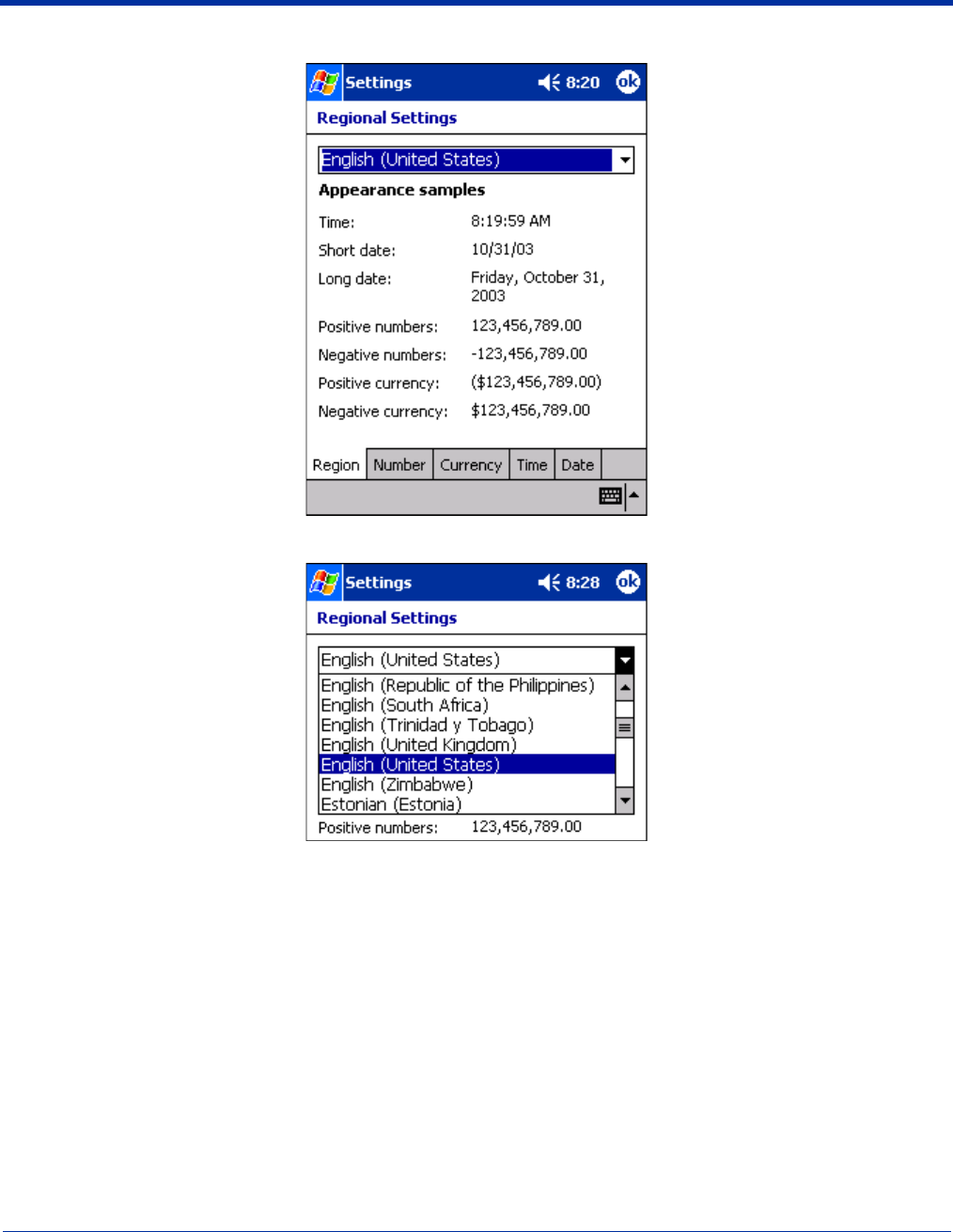
5 - 12 Dolphin® 9500/9550 Mobile Computer User’s Guide - GSM Draft
The Region tab displays an overview of the region selected in the drop-down list at the top.
The terminal is loaded with a number of pre-programmed regional settings. Select one from the list.
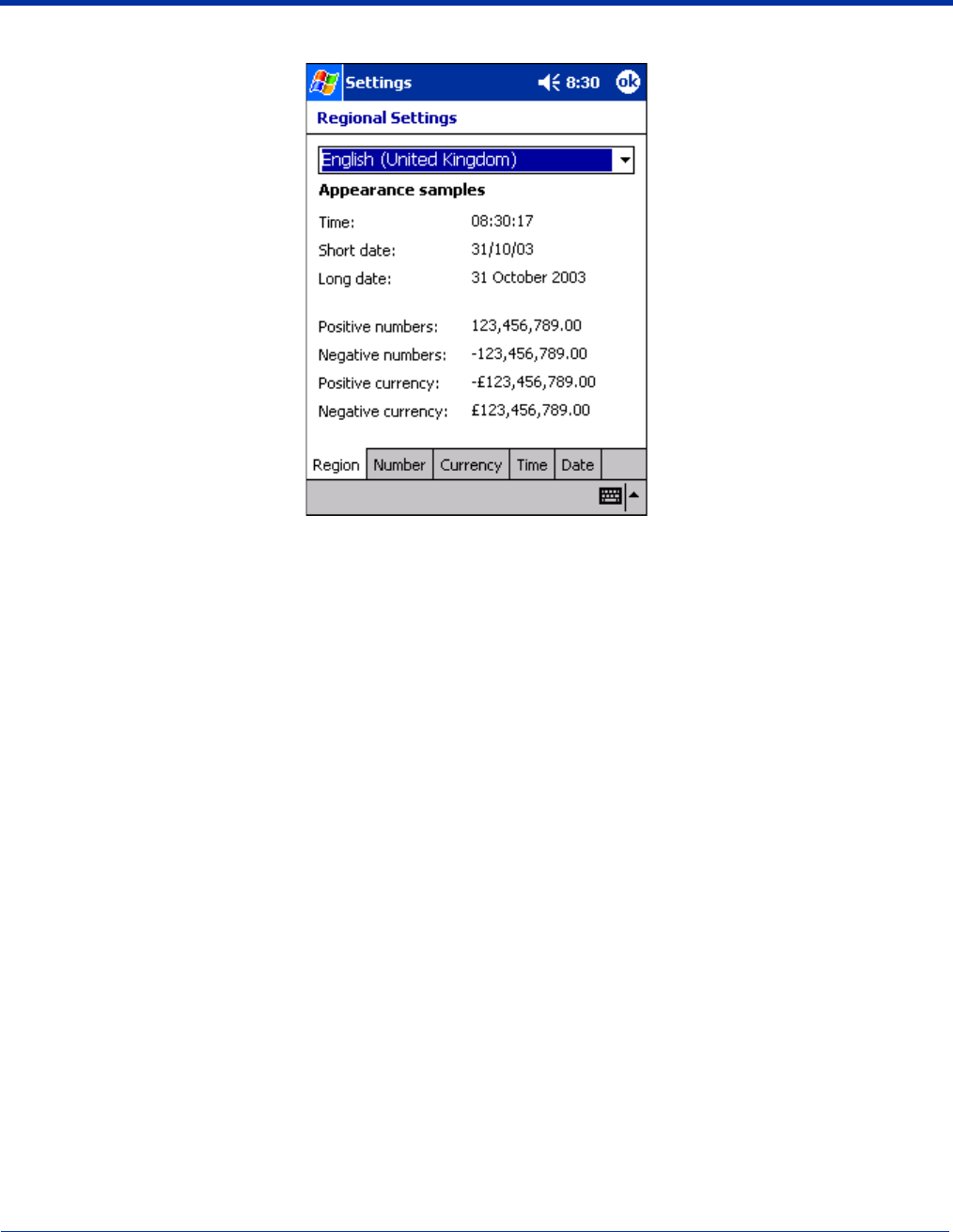
Dolphin® 9500/9550 Mobile Computer User’s Guide - GSM Draft 5 - 13
The results appear below.
To see specific settings or change a specific setting, tap on one of the tabs, make the change and tap OK to save it.
Remove Programs
The Remove Programs settings enables you to remove programs installed on the terminal. Use this setting to troubleshoot when
you receive messages that the device is out of memory.
The programs removed are removed from RAM memory. Any program (usually *.cab or *.dll files) stored in the Autoinstall folder
(My Device > IPSM > Autoinstall) will re-install after the next hard reset.
For information about the Autoinstall process, see Autoinstall on page 2-10.
For information about the hard reset process, see Hard Reset (Cold Boot) on page 2-12.
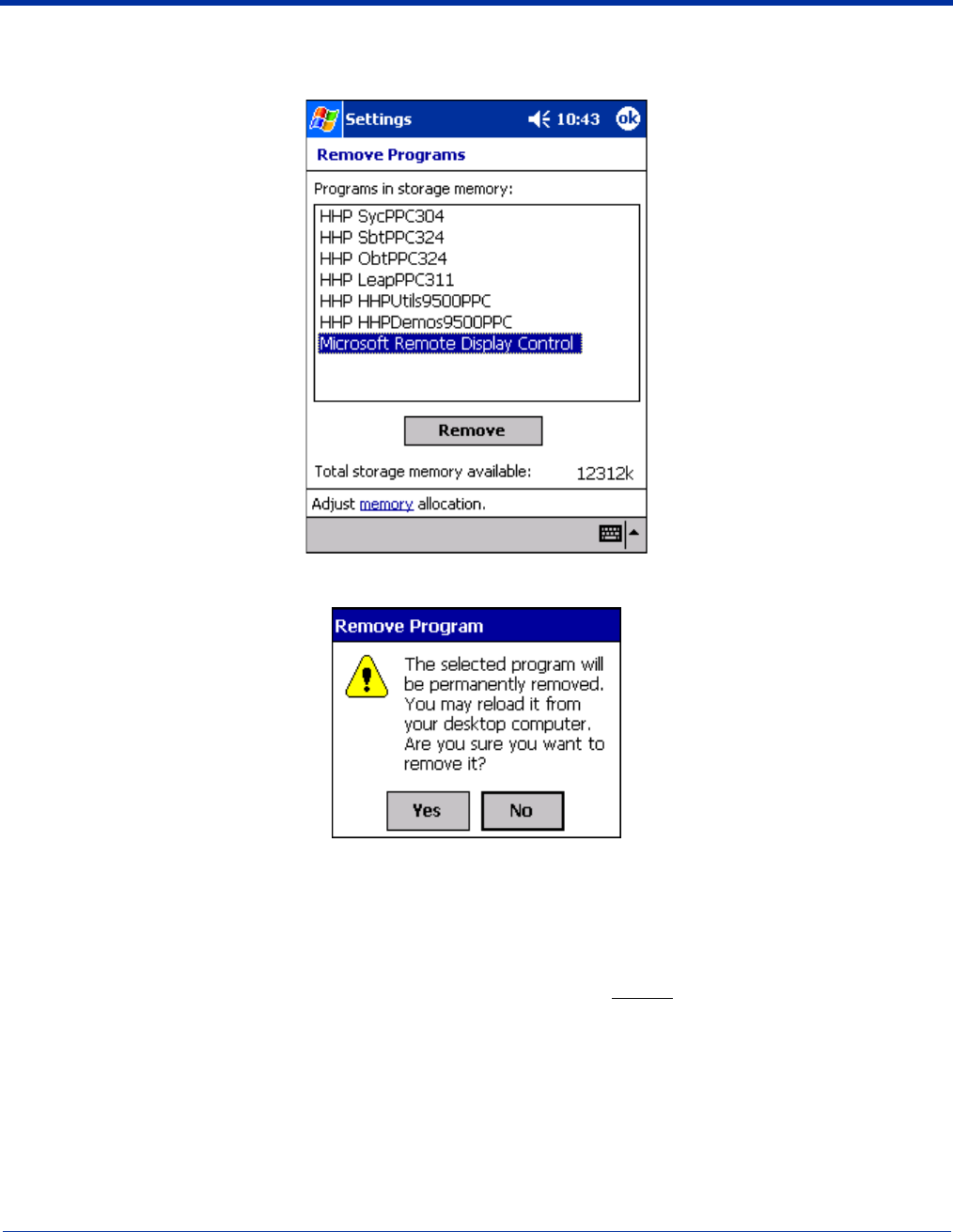
5 - 14 Dolphin® 9500/9550 Mobile Computer User’s Guide - GSM Draft
To Remove Programs:
1. Tap Remove Programs. In the list, select the program you want to remove.
2. Tap Remove. The following message appears:
3. Tap Yes. Wait while the program is removed.
4. Verify that the program no longer appears in the list.
Memory
The Remove Programs screen displays the total storage memory available. It adjusts automatically when a program is removed
for quick reference. For more detailed memory information, tap memory of “Adjust memory allocation.” along the bottom margin.
It opens the Memory system setting. For information about memory settings, see Memory on page 5-8.
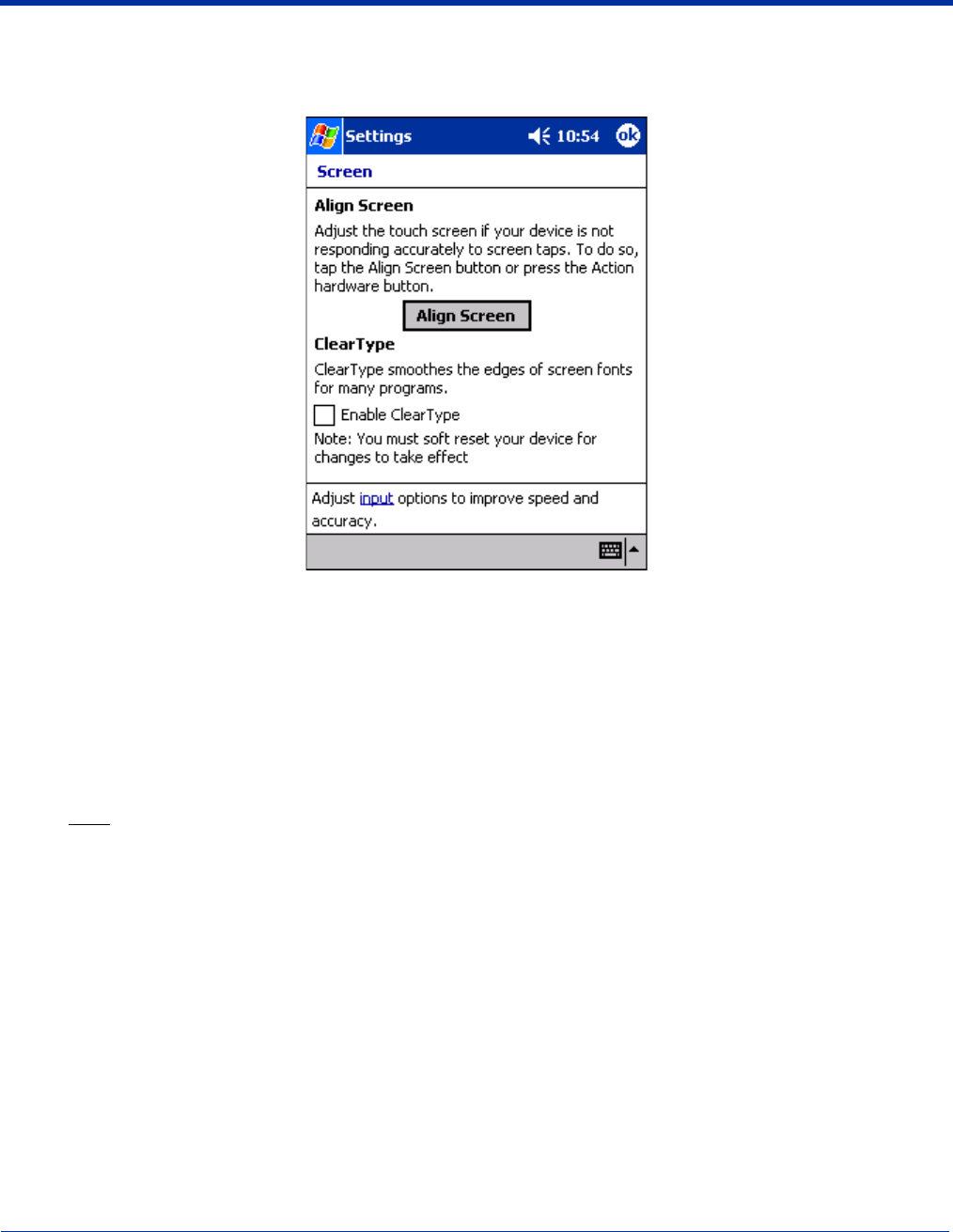
Dolphin® 9500/9550 Mobile Computer User’s Guide - GSM Draft 5 - 15
Screen
The Screen setting enables you to re-align the screen at any time. You would need to re-align the screen if tapping buttons or
icons with the stylus no longer seems to work appropriately.
To align the screen, tap Align Screen, and follow the instructions. See Align the Screen on page 2-8.
ClearType
Dolphin 9500/9550 displays support ClearType font rendering. ClearType is a Microsoft technology that dramatically increases
the readability of text on LCD displays. Select the Enable ClearType, tap OK, and perform a soft reset; see Soft Reset (Warm
Boot) on page 2-12.
For more information about ClearType font rendering for Pocket PC, visit: http://www.microsoft.com/typography/cleartype/
what.htm?fname=%20&fsize=
Input Options
Tapping input of “Adjust input options to improve speed and accuracy” opens the input panel settings; see Input Panel Options
on page 4-22.
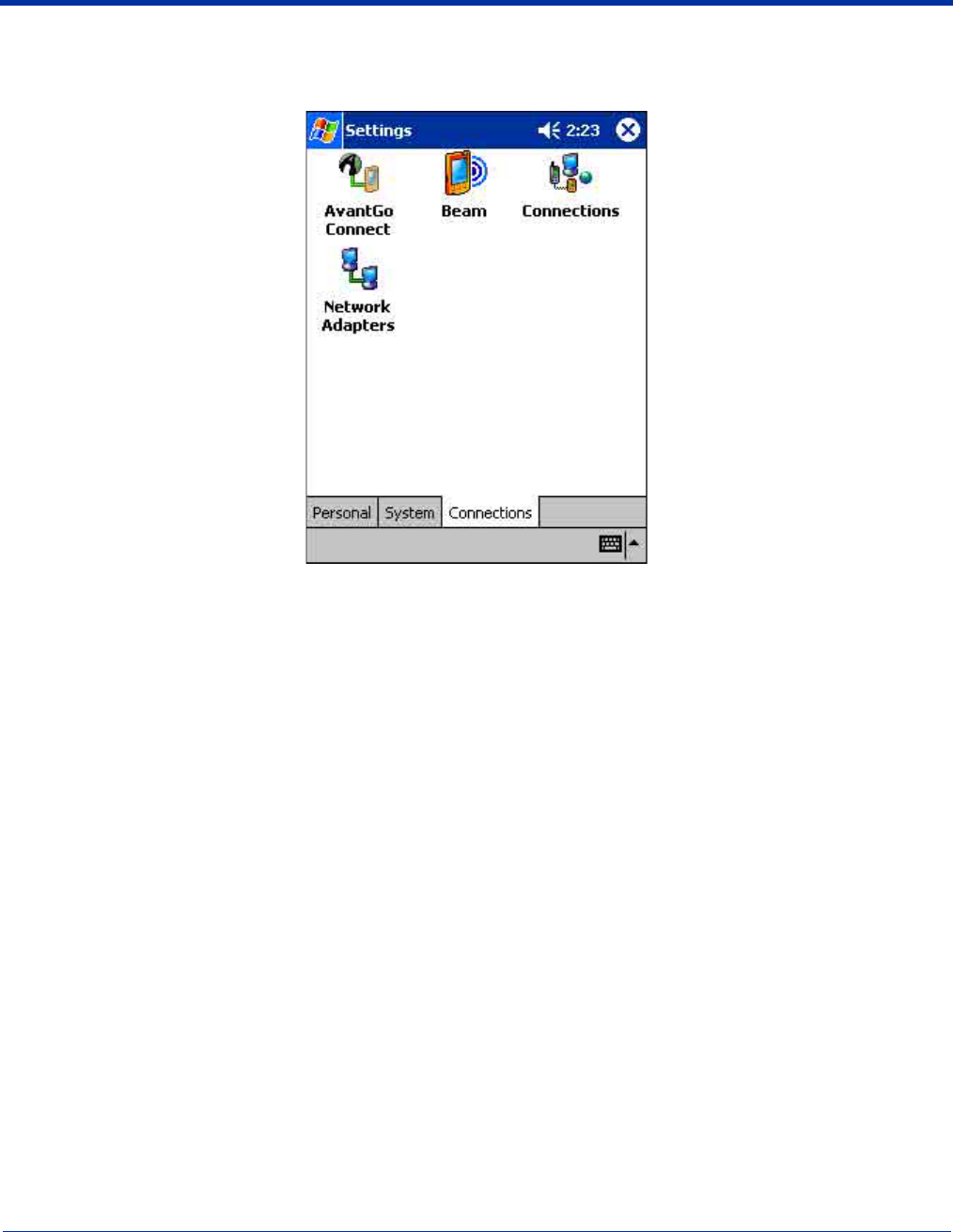
5 - 16 Dolphin® 9500/9550 Mobile Computer User’s Guide - GSM Draft
Connection Settings
The Connections tab serves as a connections manager for the terminal that enables you to manage your network connections.
There are three main components:
Beam Enables you to verify and adjust the infrared settings of the IrDA port. For details, see Using Infrared
on page 6-5.
Connections Enables you to configure your network connections for internet and work, create new connections,
and set default connections.
Network Adapters Enables you to configure your network adapters.
Additions to this window
Other items appear on this window if your terminal is configured with specific network software and/or protocols. For terminals
configured with a GSM/GPRS WWAN radio, this screen contains a link to your GPRS settings. For more information, see GPRS
Settings on page 9-16.
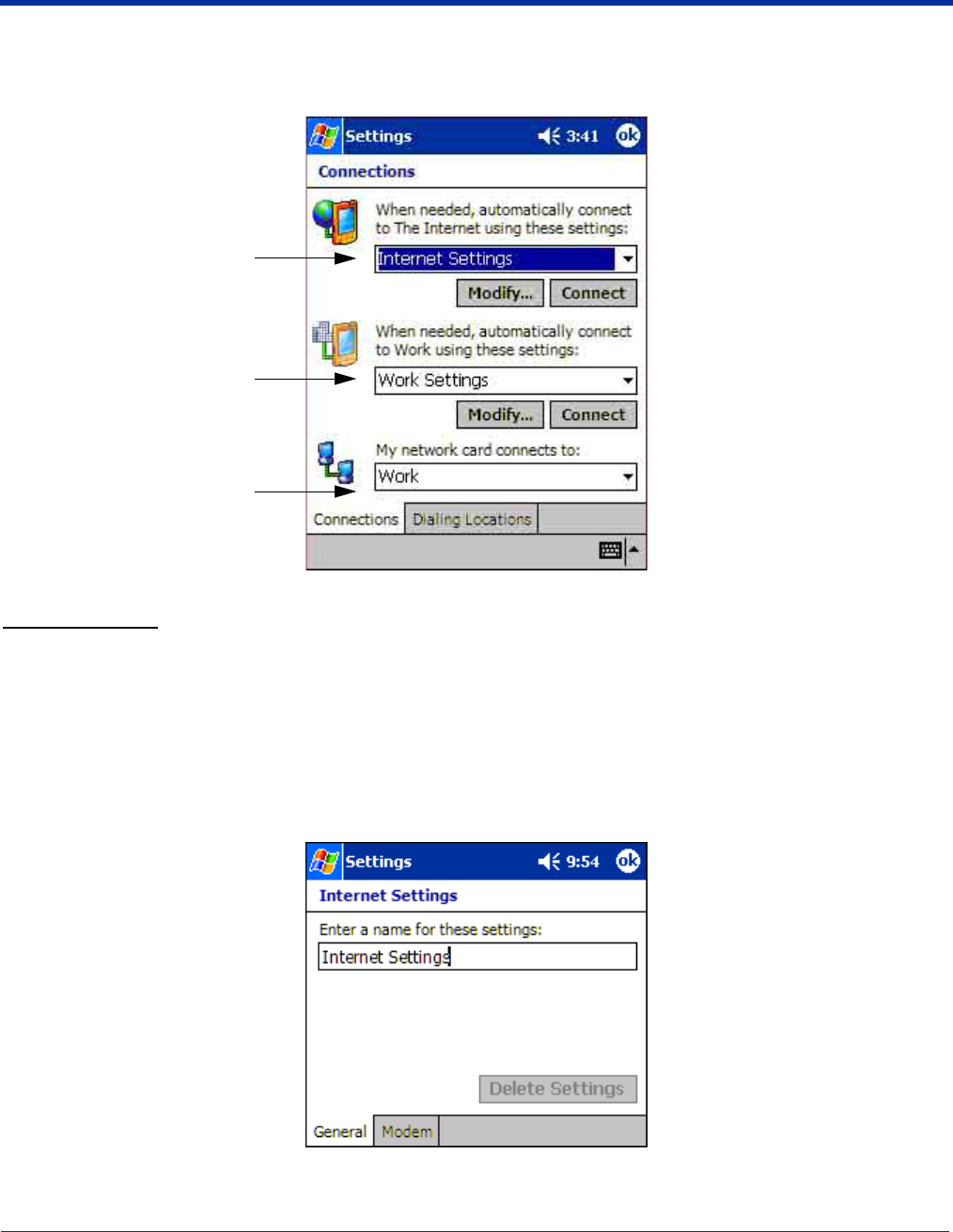
Dolphin® 9500/9550 Mobile Computer User’s Guide - GSM Draft 5 - 17
Connections Tab
The Connections screen enables you to manage internet, work, and network card connections that the terminal defaults to when
connecting to the network.
Internet Settings
When configuring internet settings, make sure that you are prepared with dial-up numbers and other necessary numbers from
you office network or internet service provider (ISP).
There are two tabs for internet settings: Modem and General.
Modem tab This tab enables you to establish individual modem settings for each internet connection. It leads you
through a series of screens and tabs that enable you to enter both basic and advanced network and
dial-up information.
General tab This tab enables you to name or, rather, re-name “Internet Settings” to a name of your own choosing.
If you enter a new name and tap OK, that name appears in drop-down lists instead of “Internet
Settings.”
When connecting to the
internet, the system
defaults to the setting
selected here. The terminal
is initially set to Internet
Settings.
When connecting to the
internet, the system
defaults to the setting
selected here. The terminal
is initially set to Work
Settings.
The network card connects
to the setting selected here.
The terminal is initially set
to Work.
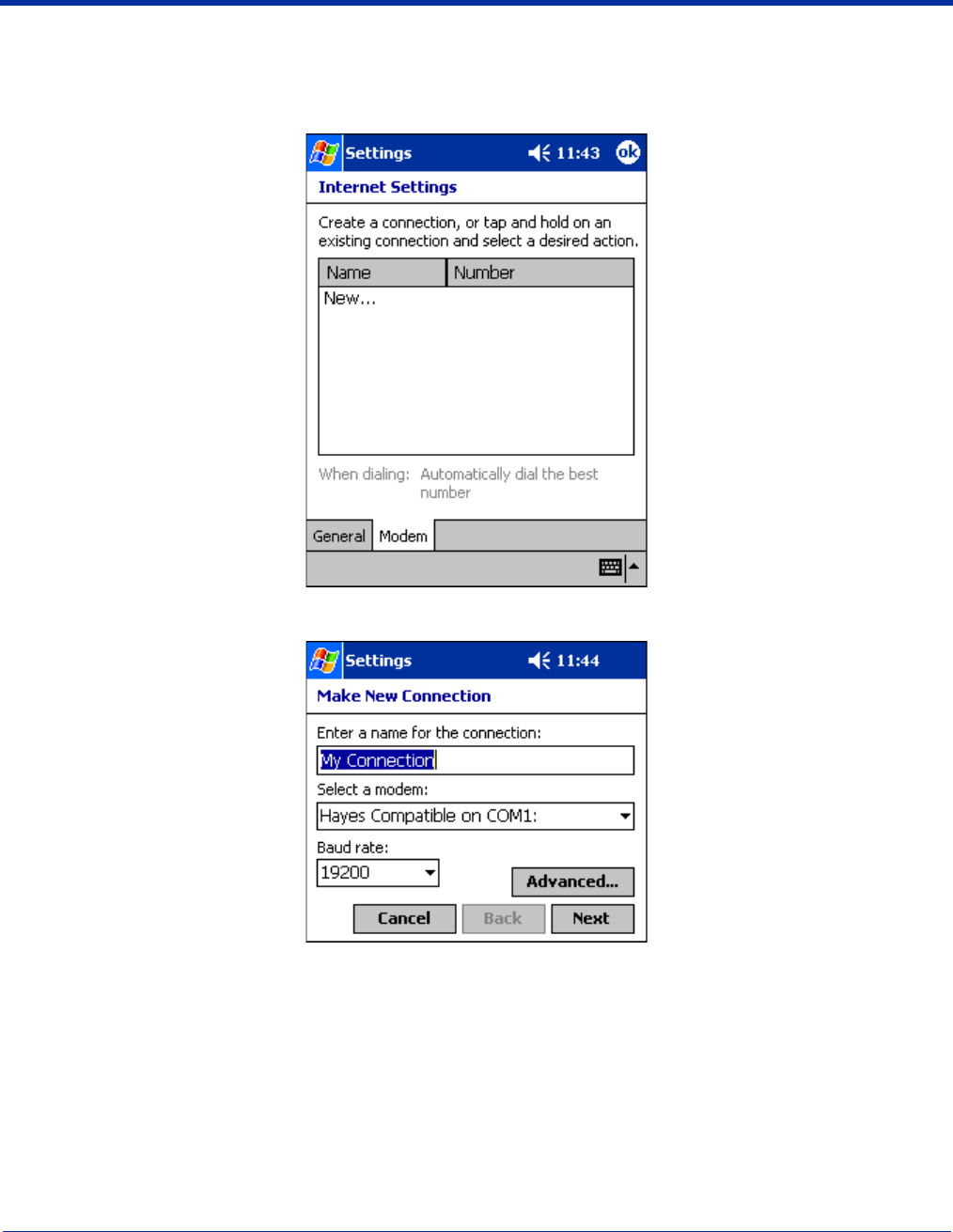
5 - 18 Dolphin® 9500/9550 Mobile Computer User’s Guide - GSM Draft
To Configure Internet Settings
1. On the Connections tab, select Internet Settings in the first drop-down list, and tap Modify. The Internet Settings screen
appears displaying the Modem tab. The list in the middle of the screen displays existing internet connections. If you have not
yet established an internet connection, “New…” appears in the list.
2. Tap New. The Make a New Connection screen appears.
3. Complete the fields.
•Enter a name for the connection in the first field. “My Connection” is auto-filled by default. You can type over it with
the SIP that appears or the using the keyboard. This name identifies this internet connection and appears in the list
on the Internet Settings screen.
•Select a modem from the drop-down list. This list displays available COM ports (including IrDA, if enabled).
• Select the appropriate Baud rate for both the modem and the network you’re using.
• (Tap Advanced to enter Port Settings, TCP/IP, and Name Servers; see Advanced Settings on page 5-19.)
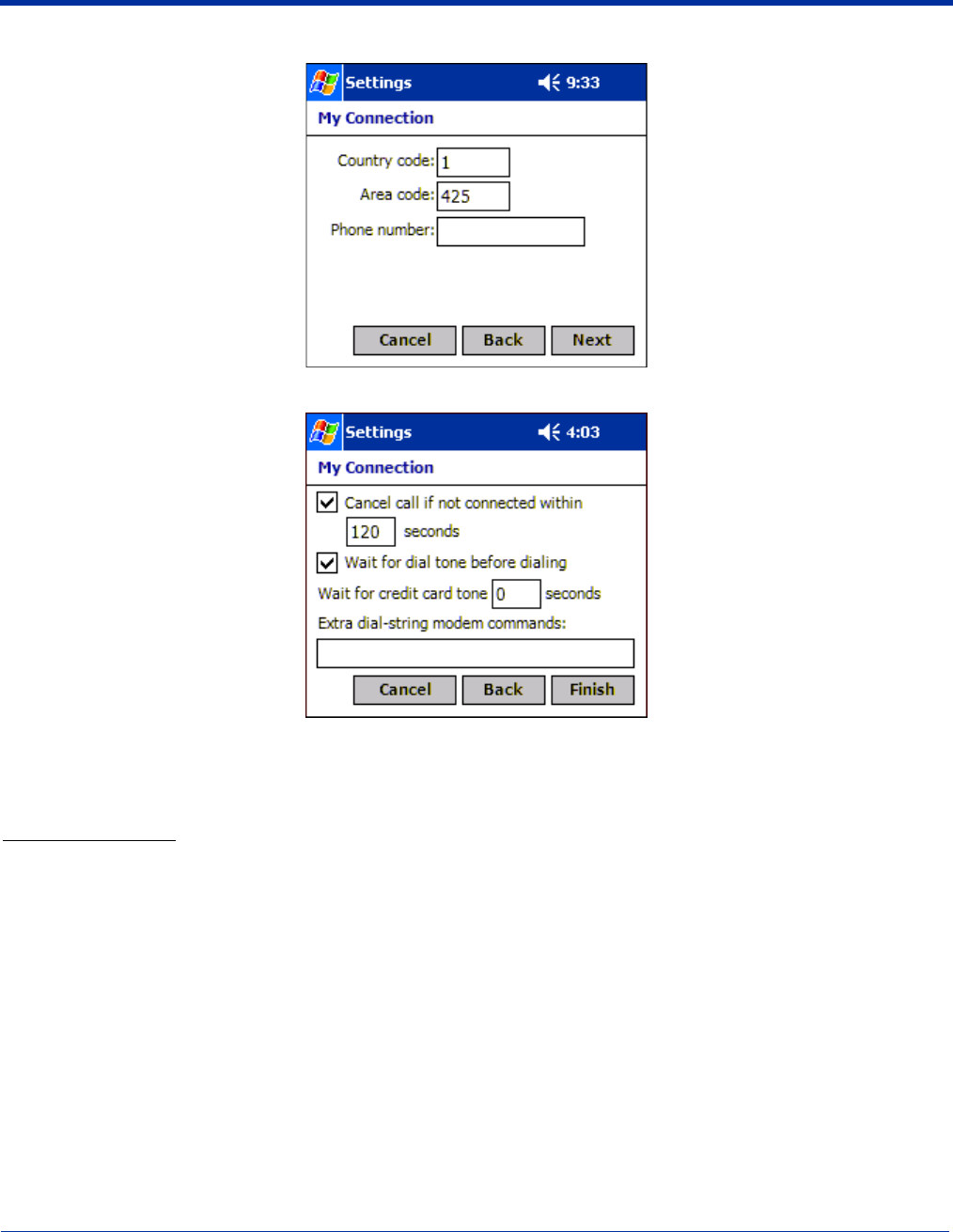
Dolphin® 9500/9550 Mobile Computer User’s Guide - GSM Draft 5 - 19
4. Tap Next to enter the phone number for the modem to dial.
5. Enter the phone number and tap Next.
6. Enter the parameters, including any extra dial-string modem commands, and tap Finish. You are returned to the Internet
Settings screen where the new connection name and number appear in the list. You can tap on it any time to edit the
settings.
Advanced Settings
When making a new connection (see page 5-18) or editing an existing connection, you can tap Advanced to open three tab
windows that enable you to connect your terminal to an integrated network: Port Settings, TCP/IP, Name Servers.
You should not need to change advanced settings. If you do, verify with your network administrator that you have the correct
information.
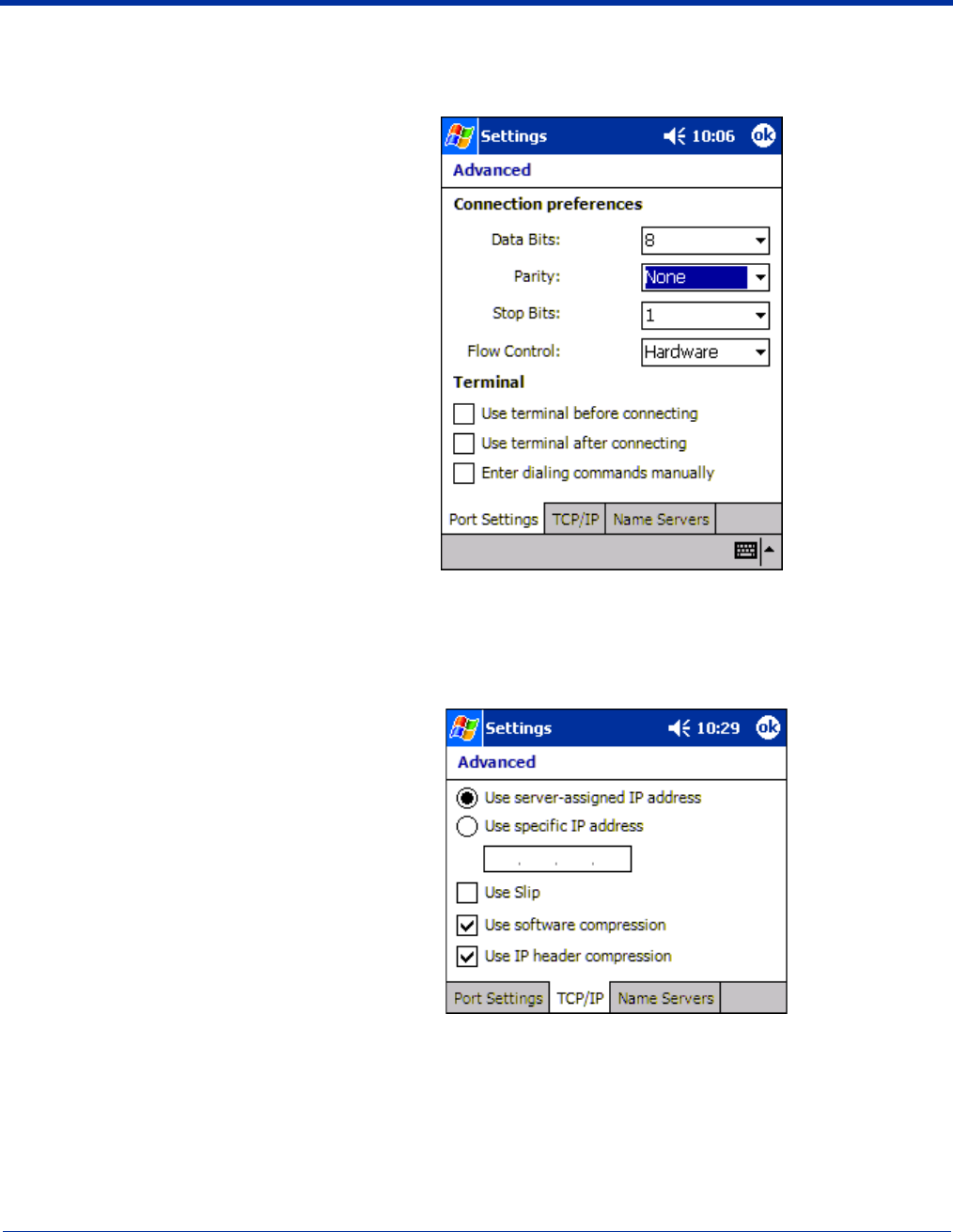
5 - 20 Dolphin® 9500/9550 Mobile Computer User’s Guide - GSM Draft
Port Settings Advanced settings opens to this tab window. On it, enter the parameters for the port the terminal is
using.
TCP/IP settings Tap on this tab to configure TCP/IP settings. Server-assigned IP addresses use Dynamic Host
Configuration Protocol (DHCP).
Connection preferences
Data Bits • Can be set between 4 and 8
Parity • Can be set to None, Odd, Even,
Mark, or Space
Stop Bits • Can be set to 1, 1.5, or 2
Flow Control • Can be set to Software,
Hardware, or None
Terminal settings
Use terminal before connecting
Use terminal after connecting
Enter dialing commands manually
Tap OK to save settings.
You can
• Use the server-assigned IP address
(recommended) or enter a specific IP address in
the field provided
• Use Slip
• Use software compression
• Use IP header compression
Tap OK to save settings.
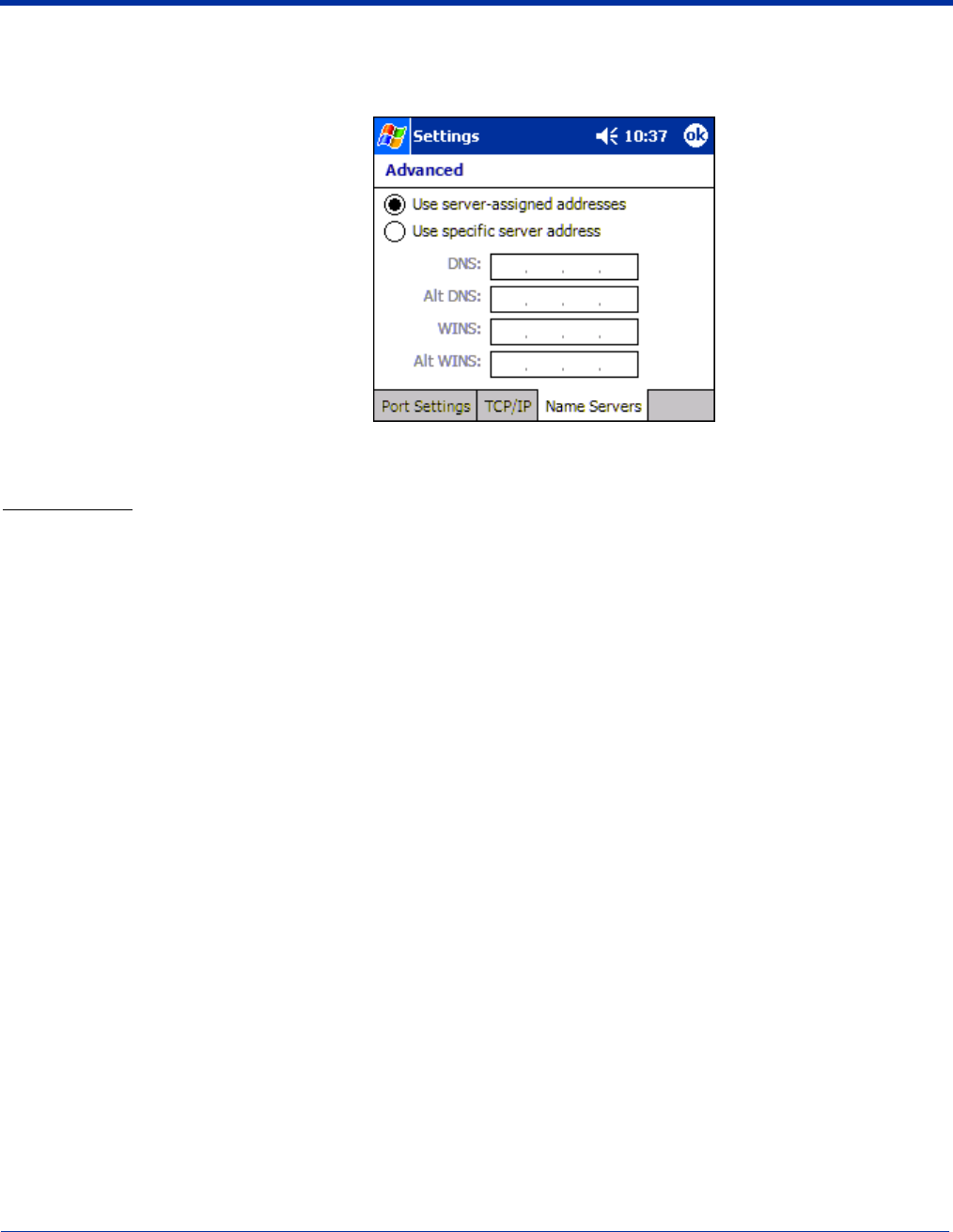
Dolphin® 9500/9550 Mobile Computer User’s Guide - GSM Draft 5 - 21
Name Servers settings Tap on this tab to determine how the terminal connects to servers. Server-assigned IP addresses use
DHCP.
Work Settings
When configuring work settings, make sure that you are prepared with dial-up numbers and other necessary numbers from you
office network or internet service provider (ISP).
To access work settings, navigate to the Connections screen (Start > Settings > Connections tab > Connections), select Work
Settings in the second drop-down list.
There are four tabs for work settings: General, Modem, VPN, and Proxy Settings.
General tab The General tab for Work Settings functions the same way it does for Internet Settings; for more
information, see page 5-17.
Modem tab The Modem tab for Work Settings functions the same way it does for Internet Settings; for more
information, see To Configure Internet Settings on page 5-18.
VPN tab The VPN tab enabled you to create virtual private network for your work settings.
Proxy Server tab The Proxy Server tab enables you to connect to the internet via a proxy server.
You can
• Use the server-assigned IP address
(recommended) OR
• Enter a specific server address in the
fields provided:
• DNS and Alt DNS - enter the
domain name server address to
locate the appropriate domain. If
the domain can’t be found, the Alt
DNS is tried automatically.
• WINS and Alt WINS - enter the
appropriate IP address to locate
the desired server on the
windows network. If the server
can’t be found, the Alt WINS
address is tried automatically.
Tap OK to save settings.
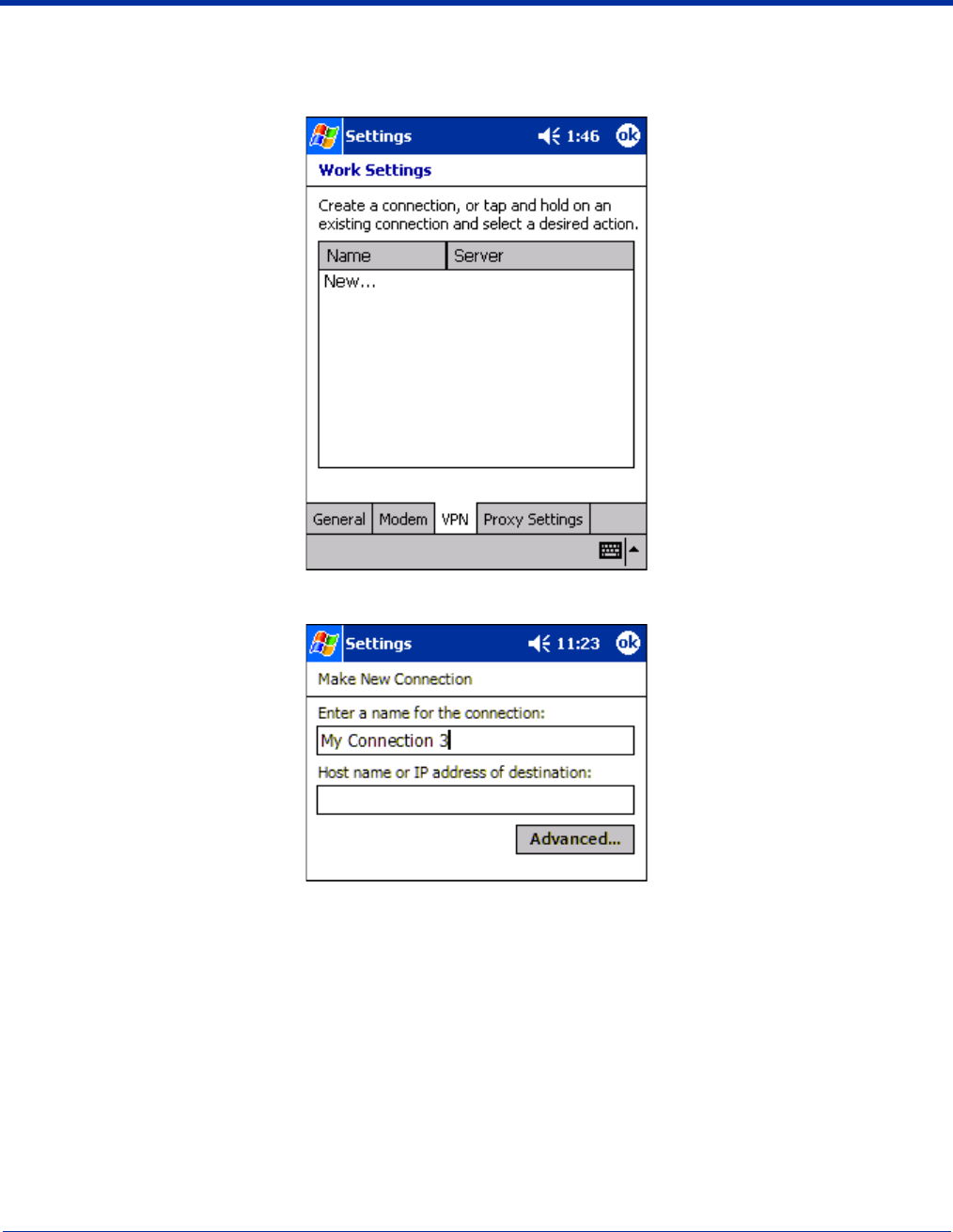
5 - 22 Dolphin® 9500/9550 Mobile Computer User’s Guide - GSM Draft
VPN Tab
1. After the Modem settings have been established, tap on the VPN tab. The Work Settings screen displays with a list of
connections in the middle of the window. If no connections have been established, only New... appears.
2. Tap New to make a new connection.
3. Enter a name for the connection and type the desired IP address. Tap Advanced. The system processes the information and
the TCP/IP and Name Servers tabs appear.
• See TCP/IP tab on page 5-20 for information about completing this tab.
• See Name Servers tab on page 5-21 for information about completing this tab.
4. Tap OK and you are returned to the VPN tab.
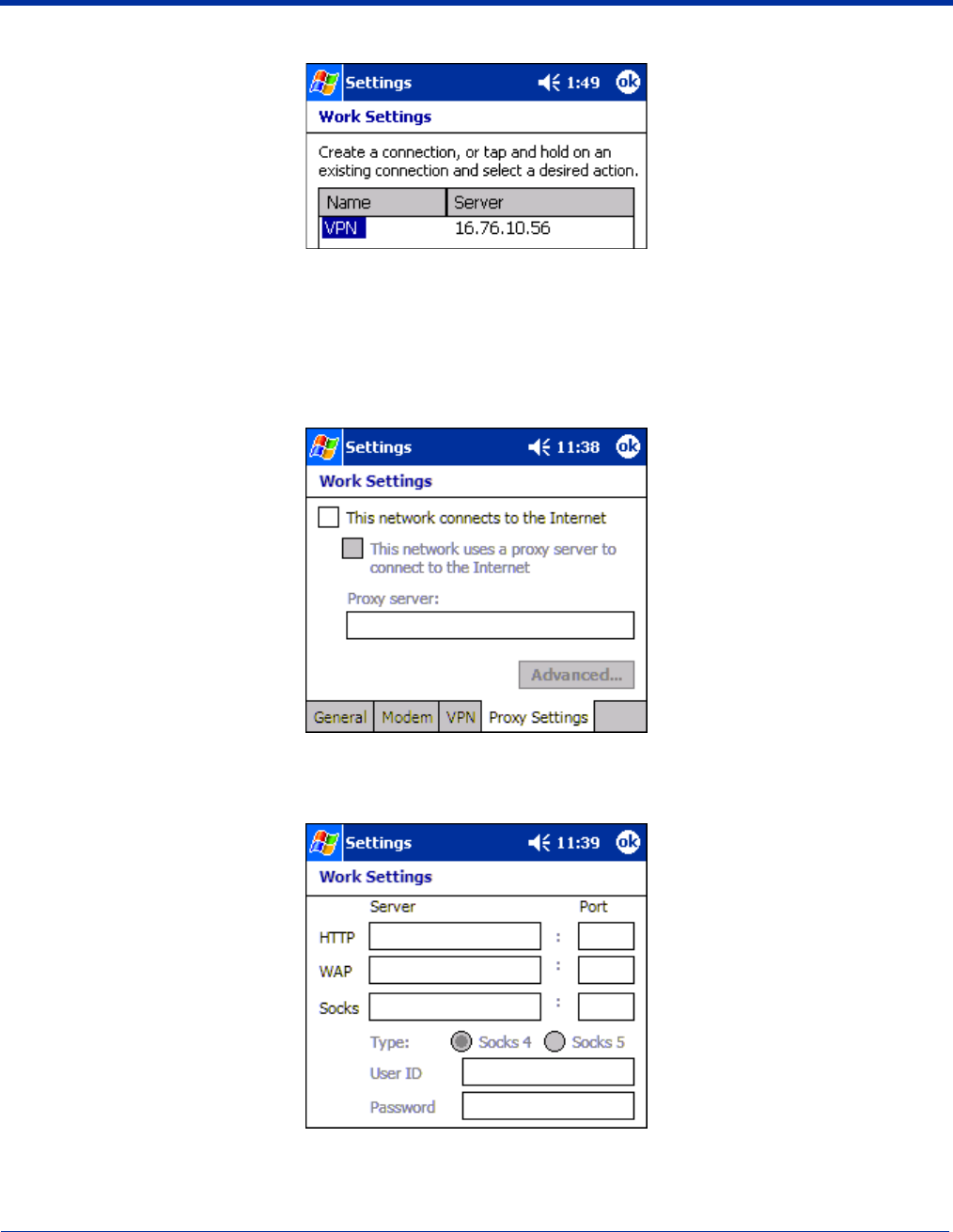
Dolphin® 9500/9550 Mobile Computer User’s Guide - GSM Draft 5 - 23
5. Tap OK again and you are returned to the Work Settings screen, which now lists the new VPN connection.
Proxy Settings
Proxy setting are most often used when your terminal is connected to a network with a firewall. In this case, you would connect
to the internet via a proxy server.
To Connect Via Proxy Server
1. Open Work Settings and tap the Proxy Server tab.
2. Check the first box, then check This network uses a proxy server to connect to the Internet.
3. Enter the Proxy server information in the field provided and tap Advanced.
4. Complete the fields
•HTTP address and Port
•WAP and Port - enter the wireless access point identifier for the network
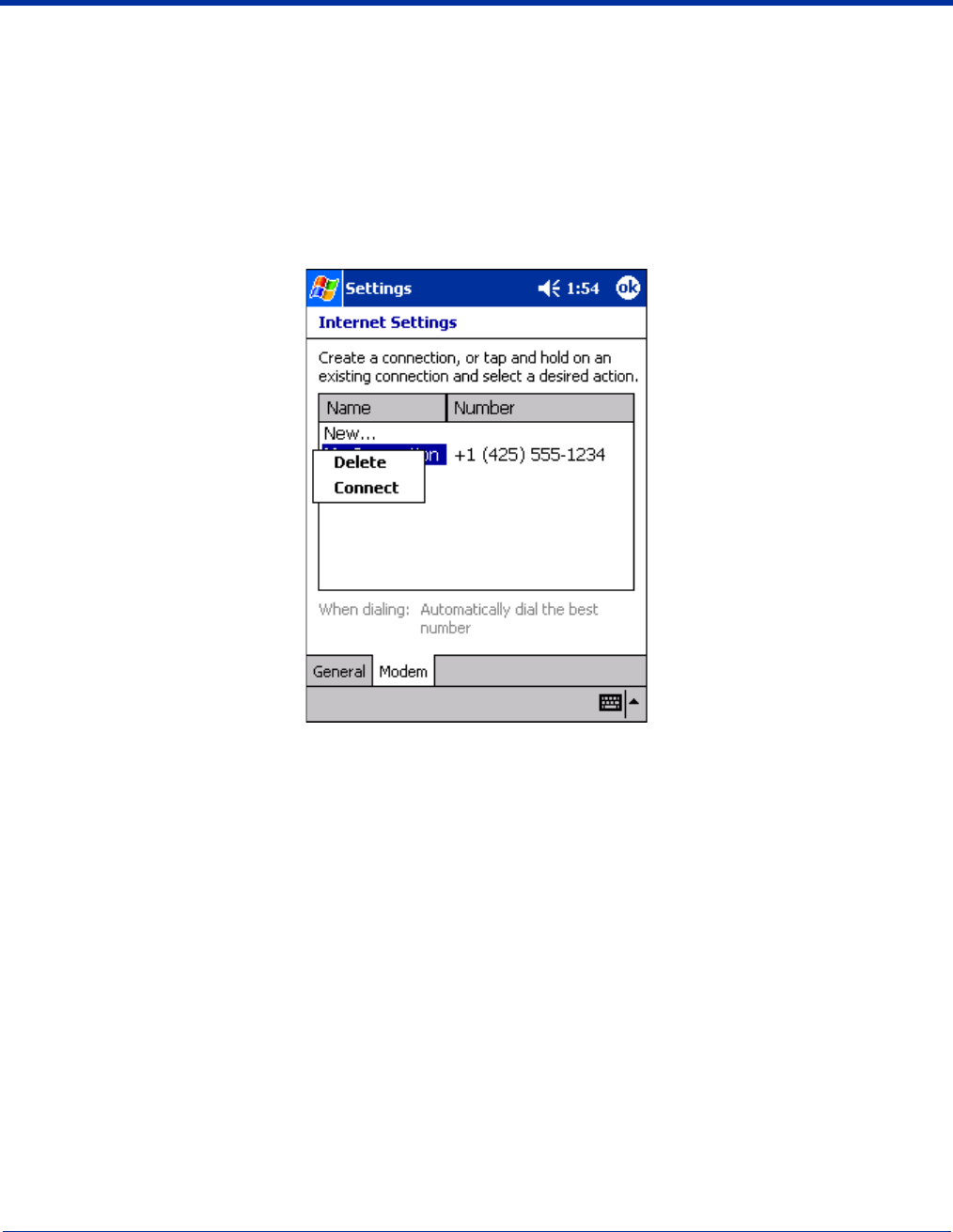
5 - 24 Dolphin® 9500/9550 Mobile Computer User’s Guide - GSM Draft
•Socks and Port - if your network uses the circuit-level proxy server. If you enter an address here, the Type field
activates and you need to select Socks 4 or Socks.
• The User ID and Password fields activate after you have entered the appropriate information. If the fields activate,
you need to complete both.
5. Tap OK to save and you are returned to the Proxy Server tab.
6. Tap OK again and you are returned to the Work Settings screen, which now lists the new Proxy Server connection.
Deleting Connections
To delete a connection at any time, you need to navigate to it from the Connections tab. On the Modem tab of either the Internet
or Work Settings screen, tap and hold on the connection. A pop-up menu appears.
Select Delete and the connection is deleted.
Creating a Custom Connection
The Dolphin 9500/9550 terminal comes loaded with Internet Settings and Works Settings as options in the drop-down lists on
the Connections tab. You can create new settings of each type. After they are saved, custom settings appear in the drop-down
lists on the Connections tab.
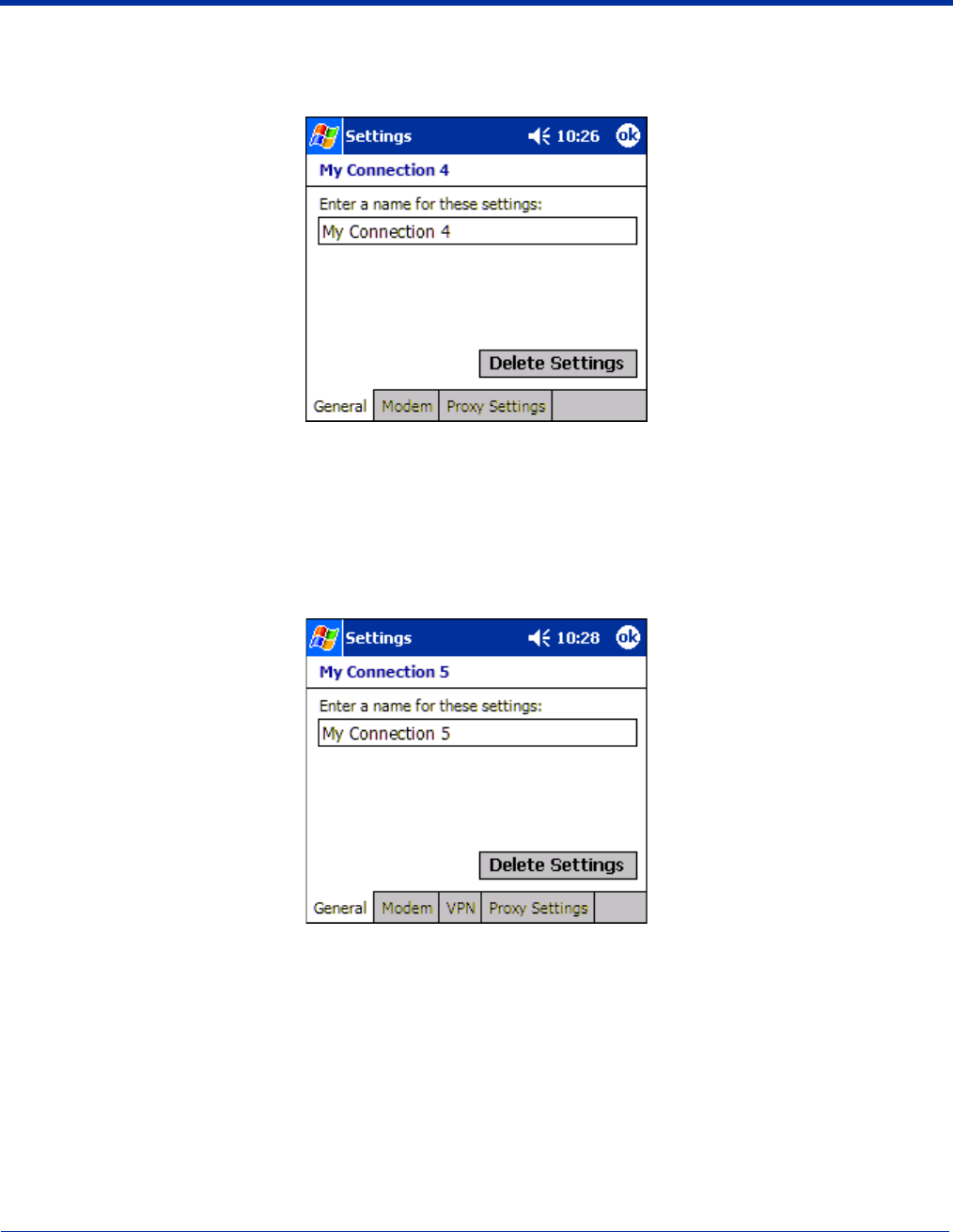
Dolphin® 9500/9550 Mobile Computer User’s Guide - GSM Draft 5 - 25
Internet Settings
On the Connections tab, in the first field (for Internet Settings), select New in the drop-down list. The General tab opens so that
you can name the connection.
Tap the Modem tab. The Modem tab opens. From there, complete the rest of the process for internet settings. For more
information, see Internet Settings on page 5-17.
You also have the option of tapping the Proxy Settings tab to have this connection go through a proxy server. For more
information, see Proxy Settings on page 5-23.
Work Settings
On the Connections tab, in the second field (for Work Settings), select New in the drop-down list. The General tab opens so that
you can name the connection.
Tap the Modem tab. The Modem tab opens. From there, complete the rest of the process for setting up a work connection. For
more information, see Work Settings on page 5-21.
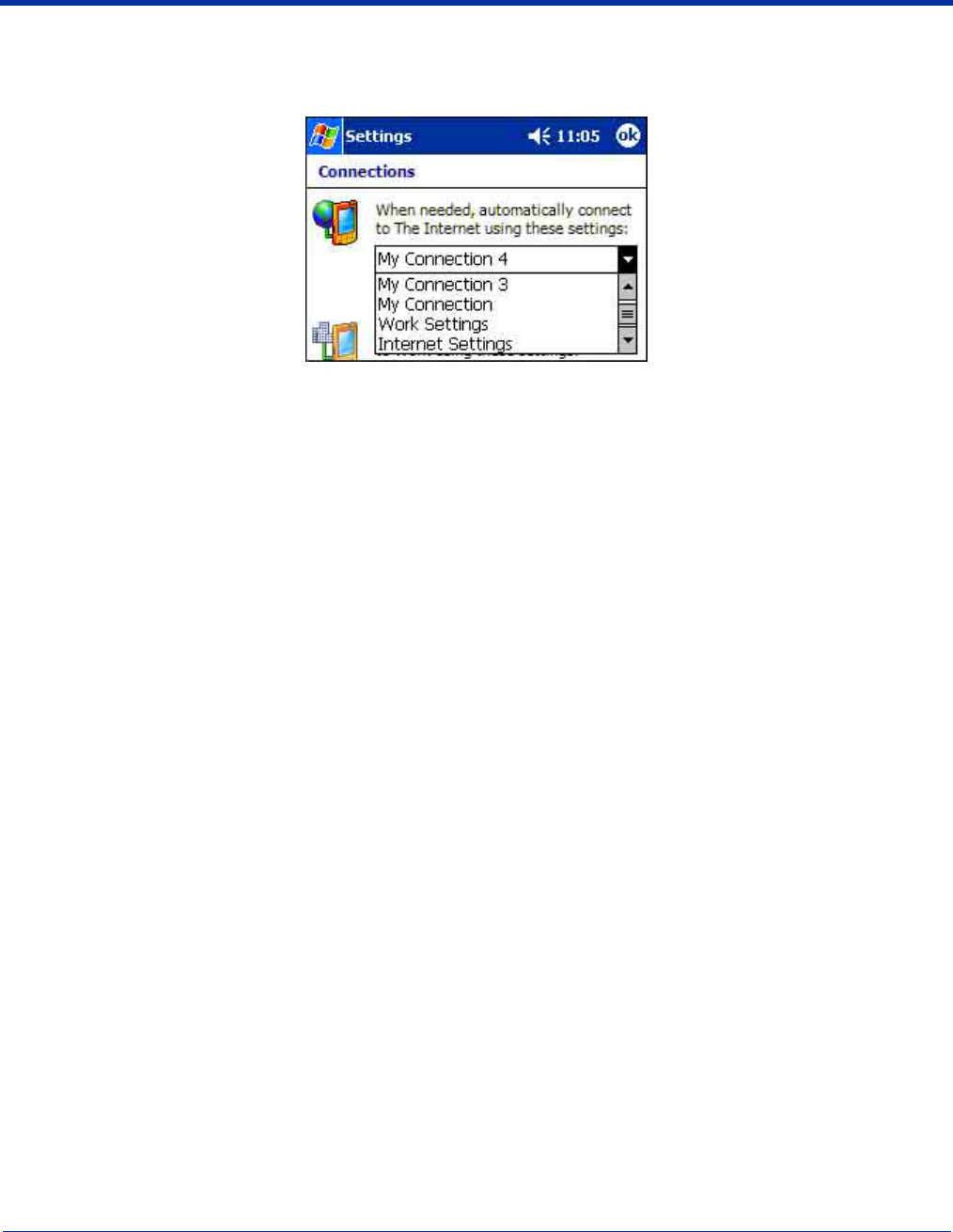
5 - 26 Dolphin® 9500/9550 Mobile Computer User’s Guide - GSM Draft
Connecting
You can test your connection settings on the Connections tab (see page 5-17) any time. In either of the first two drop-down lists
(Internet and Work), select the desired setting.
Tap Connect and the terminal begins connecting to the network.
Note: The Connect button is active only when the selected connection setting is valid.
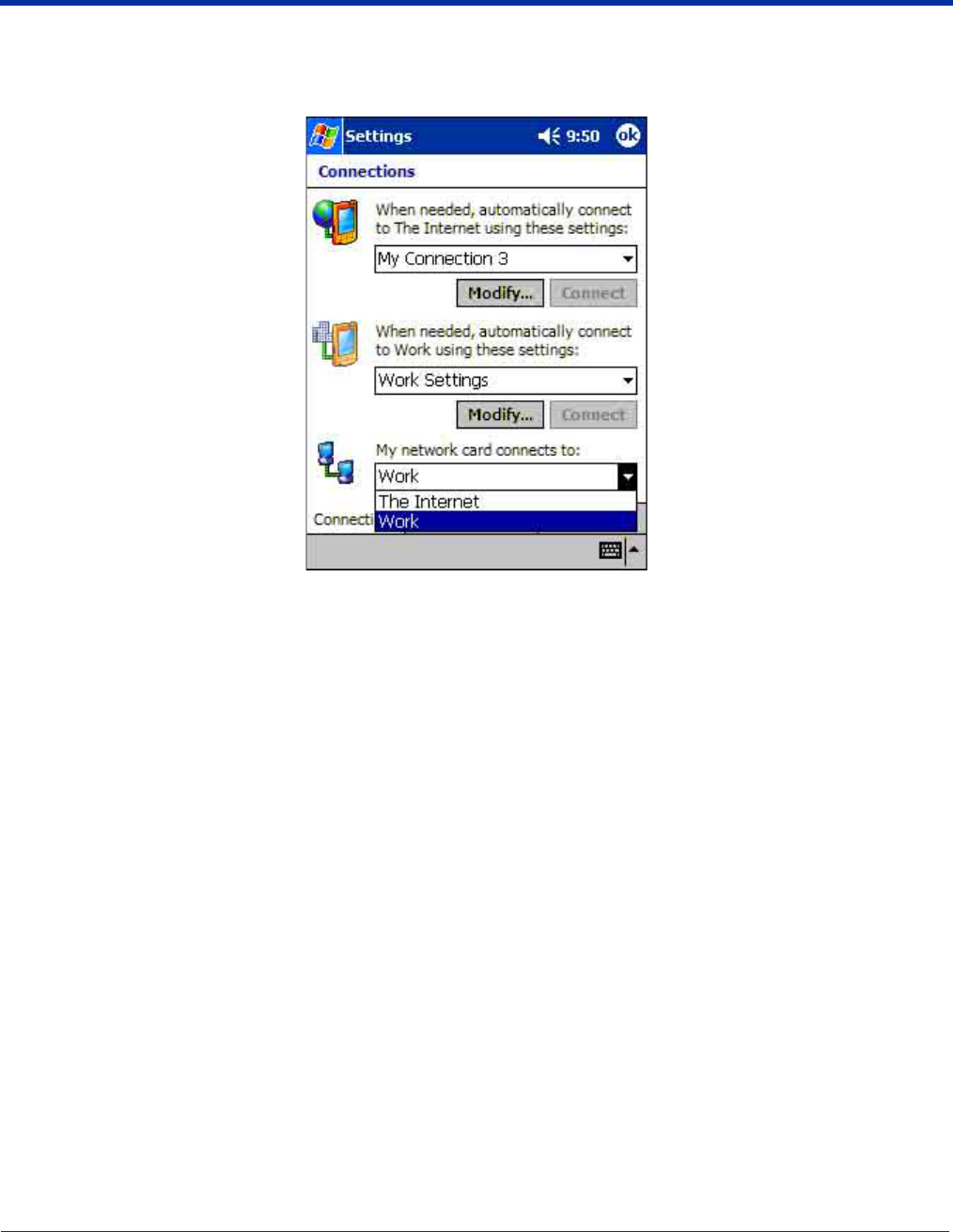
Dolphin® 9500/9550 Mobile Computer User’s Guide - GSM Draft 5 - 27
Network Card Connections
The third field on the Connections tab (see page 5-17) enables you to select the connection setting of your network card. You
can have your network card use your internet or work settings.
Tap OK to save settings.
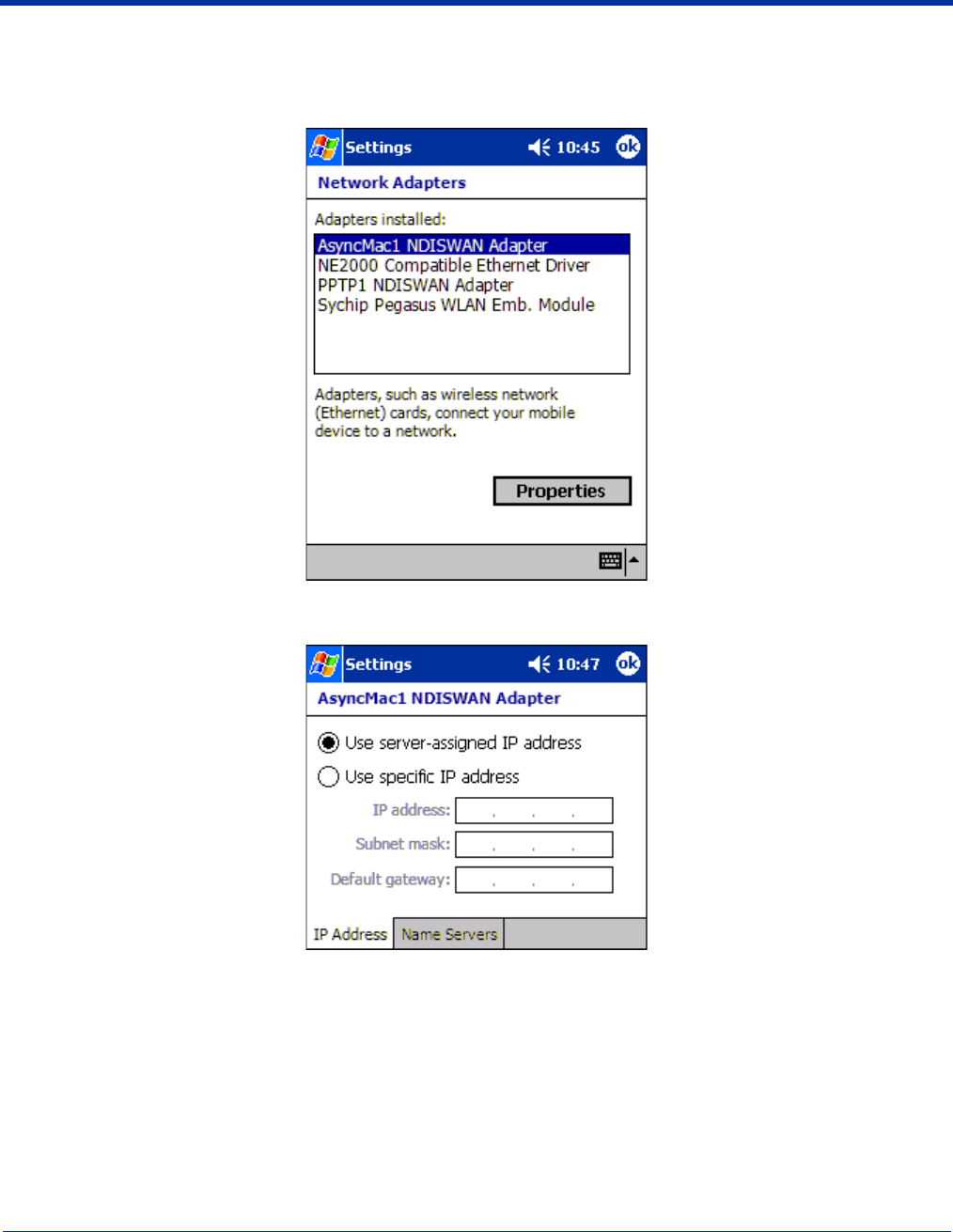
5 - 28 Dolphin® 9500/9550 Mobile Computer User’s Guide - GSM Draft
Network Adapters
On the Connections tab (see page 5-17), tapping Network Adapters enables you to review the adapters installed on the terminal
and the properties associated with each.
To see the IP addresses and Name Servers of a network adapter, select one in the list, and tap Properties. Server-assigned IP
addresses use DHCP.
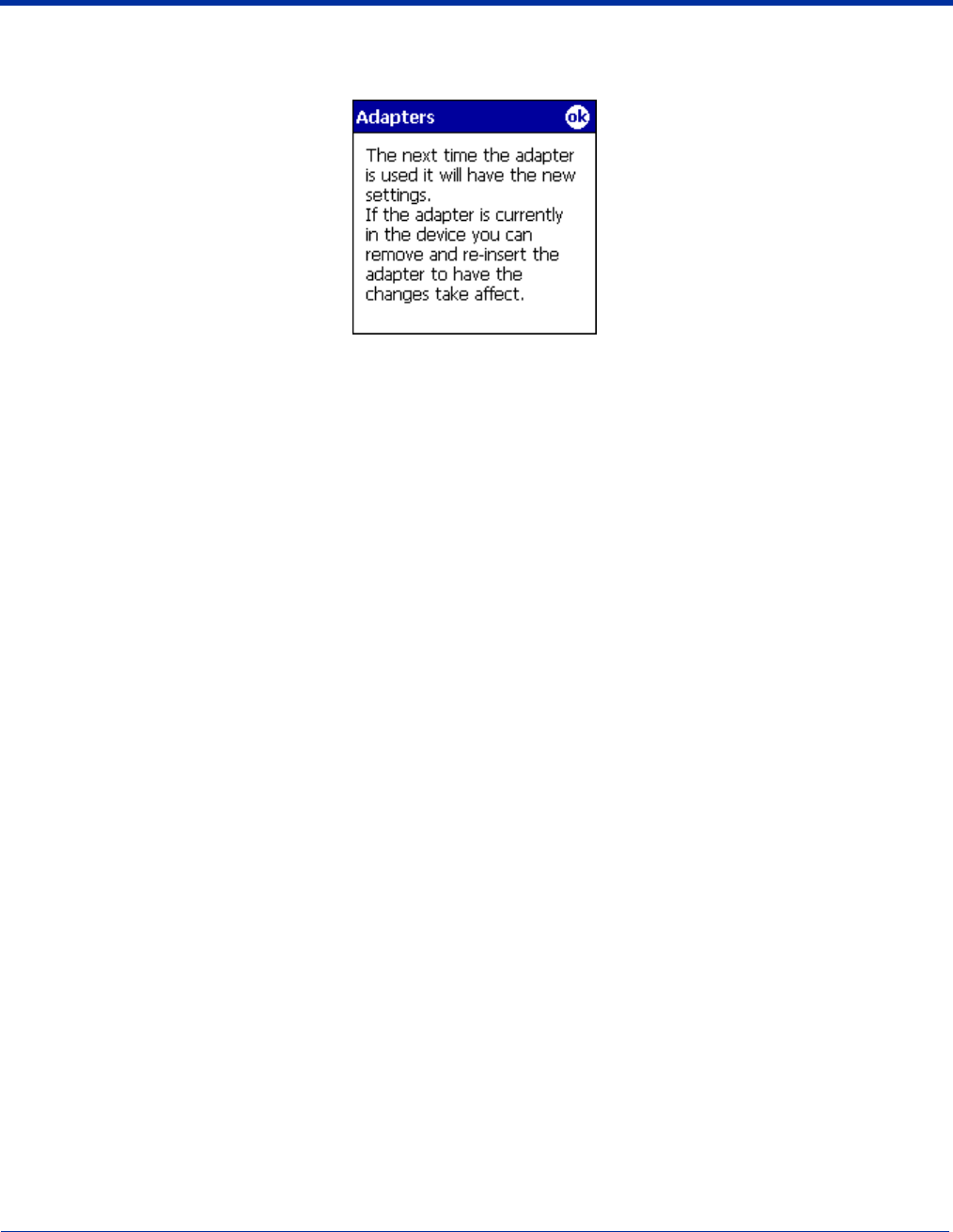
Dolphin® 9500/9550 Mobile Computer User’s Guide - GSM Draft 5 - 29
Editing Properties
Any time you open properties and tap OK, the system saves the settings. The following message appears after you tap OK:
Tap OK again to save any changes.

5 - 30 Dolphin® 9500/9550 Mobile Computer User’s Guide - GSM Draft

Dolphin® 9500/9550 Mobile Computer User’s Guide - GSM Draft 6 - 1
6
Communications
Overview
You can exchange information between your Dolphin 9500/9550 and other mobile devices, a desktop computer, a network, or
the Internet. You have the following connection options:
• Connect to your desktop computer and synchronize via Microsoft ActiveSync v3.7 or higher.
• Use the infrared (IrDA) port to send and receive files between two devices.
• Connect to your Internet Service Provider (ISP).
Help on Connecting
More information on the procedures described here, as well as information on additional procedures, can be found in the following
locations:
• ActiveSync Help on the desktop computer. In ActiveSync, click Help > Microsoft ActiveSync Help.
•See Inbox on page 10-12.
• Online Help on the device. Tap Start > Help > View menu > All Installed Help > Inbox or Connections.
For troubleshooting information, go to the Pocket PC website at: http://www.microsoft.com/windowsmobile/products/pocketpc/
Installing Additional Software
In addition to the default programs installed on your terminal when it is first booted up, you can install any program created for
your device, as long as your device has enough memory to store it and the program has an *.exe, *.cab, or *.dll extension.
The most popular place to find software for your device is on the Pocket PC website (http://www.microsoft.com/mobile/pocketpc/
When selecting programs, verify that the program and version of the program are designed for the Pocket PC and your
device processor type. Determine your device and processor type by tapping Start > Settings > System tab > About. On
the Version tab, make a note of the information in the Processor field.
!

6 - 2 Dolphin® 9500/9550 Mobile Computer User’s Guide - GSM Draft
Using ActiveSync
Using Microsoft ActiveSync version 3.7 or higher, you can synchronize information on your desktop computer with your device
and vice versa. Synchronization compares the data on the Dolphin mobile computer with your desktop computer and updates
both with the most recent data.
For example, you can:
• Update the information in Microsoft Pocket Outlook® on your device by synchronizing it with Microsoft Outlook on your desktop
computer.
• Synchronize Microsoft Word and Microsoft Excel files between your device and desktop computer. Your files are automatically
converted to the correct format.
The most current version of ActiveSync can be downloaded from www.microsoft.com.
Capabilities
With ActiveSync, you can also:
• Back up and restore your device data.
• Copy (rather than synchronize) files between your device and desktop computer.
• Control when synchronization occurs by selecting a synchronization mode. For example, you can synchronize continually
while connected to your desktop computer or only when you choose the synchronize command.
• Select which information types are synchronized and control how much data is synchronized. For example, you can choose
how many weeks of past appointments you want synchronized.
Note: By default, ActiveSync does not automatically synchronize all types of information. Use ActiveSync Options to specify the
types of information you want to synchronize. The synchronization process makes the data (in the information types you
select) identical on both your desktop computer and your device.
Requirements
To synchronize, ActiveSync version 3.7 or higher must be on both your desktop computer and your device. ActiveSync 3.7 is
already installed on your device. Therefore, you must install ActiveSync 3.7 on your desktop computer from the Microsoft
Companion CD that came with your terminal.
To install ActiveSync on your desktop computer, insert the Microsoft Companion CD into the CD-ROM drive of your desktop
computer. Click the yellow arrow, click Start Here, then follow the directions on your screen.
When communicating via ActiveSync, your terminal must be connected to the host PC with a peripheral device sold/
manufactured by HHP, such as the Dolphin HomeBase, Dolphin Mobile Base, Dolphin ChargeBase, Dolphin Net Base,
or other Dolphin 9500 series charging/communication cable. Use of any peripheral not sold/manufactured by HHP may
damage your terminal and will void the warranty.
For more information about communication peripherals, see Dolphin 9500/9550 HomeBase on page 11-1 and Dolphin 9500/
9550 Mobile Base on page 12-1.
Setting Up Your Desktop Computer
When installation of ActiveSync is complete on your desktop computer, the ActiveSync Setup Wizard helps you
• connect your device to your desktop computer,
• set up a partnership so you can synchronize information between your device and your desktop computer, and
• customize your synchronization settings.
Synchronizing from Your Desktop Computer
Because ActiveSync is already installed on your device, your first synchronization process begins automatically when you finish
setting up your desktop computer in the wizard and your terminal is connected to the host PC.
After your first synchronization, look at Calendar, Contacts, and Tasks on your device. Notice that the same information from
Microsoft Outlook on your desktop computer is now on your device, and you didn’t have to type a word. Simply disconnect your
device from your computer and you’re ready to go!
For more information about using ActiveSync on your desktop computer, open ActiveSync, then open ActiveSync Help.
!
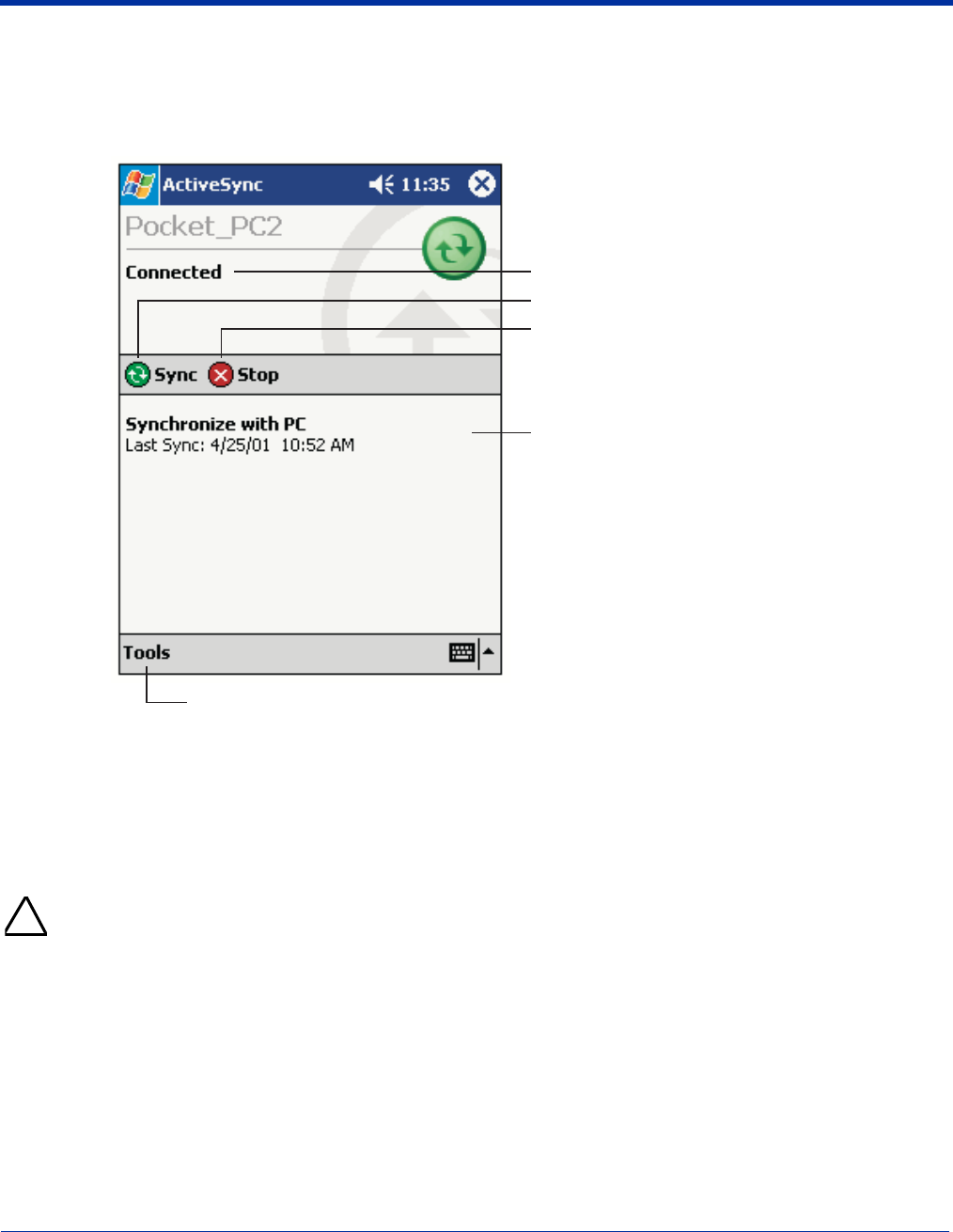
Dolphin® 9500/9550 Mobile Computer User’s Guide - GSM Draft 6 - 3
Synchronizing from Your Device
ActiveSync must be setup on your desktop computer and the first synchronization process completed before you initiate
synchronization from your device.
To initiate synchronization from your device, tap Start, then ActiveSync to begin the process.
Note: If you have a wireless LAN card, you can synchronize remotely from your device.
Adding Programs to the Terminal Using ActiveSync
The software application must be stored or installed on the host PC. Some programs are installers and install on the PC and the
terminal at the same time. Some programs designed for terminals cannot be installed on PCs. In those cases, the appropriate
files must be stored on the host PC, transferred via ActiveSync, and installed on the terminal.
When selecting programs, verify that the program and version of the program are designed for the Pocket PC and your
device processor type. Determine your device and processor type by tapping Start > Settings > System tab > About. On
the Version tab, make a note of the information in the Processor field.
1. Download the program to your desktop computer from either the Internet or the CD or disk that contains the program. You
may see a single *.exe or setup.exe file, a *.cab file, or *.dll. There may also be several versions of files for different device
types and processors.
2. Read any installation instructions, Read Me files, or documentation that comes with the program. Many programs provide
special installation instructions.
3. Connect the terminal to the host PC via an HHP communication peripheral.
If the File is an Installer:
4. Double-click the *.exe or *.setup.exe file. The installation wizard begins. Follow the directions on the PC screen. The
installation process includes transferring the software to the terminal.
Tap to connect and synchronize.
View synchronization status.
Tap to synchronize via IR or
change synchronization settings.
View connection status.
Tap to stop synchronization.
!

6 - 4 Dolphin® 9500/9550 Mobile Computer User’s Guide - GSM Draft
If the File is Not an Installer:
5. An error message appears stating that the program is valid but designed for a different type of computer. You need to
manually transfer this file to the terminal.
6. If you cannot find any installation instructions for the program in the Read Me file or documentation, open ActiveSync and
click Explore.*
7. Navigate to the My Pocket PC folder and copy the program file or files to the Program Files folder on the terminal.
• If you want the program to be part of the Autoinstall that occurs after every hard reset, place the program file in the
Autoinstall folder (My Pocket PC > IPSM > Autoinstall).
8. Depending on the program, you may need to open File Explorer on the terminal, navigate to the folder where the program is
located, and tap on the program file to install it.
• If you copied the file to the Autoinstall folder, you can either tap on the program inside the Autoinstall folder or perform
a hard reset and the program will install as part of the regular Autoinstall; see Autoinstall on page 2-10. Remember, a
hard reset erases RAM data! For more information, see Hard Reset (Cold Boot) on page 2-12.
After installation on the terminal is complete, tap Start > Programs and the program and its icon appears on the Programs
screen. Tap it to open the program.
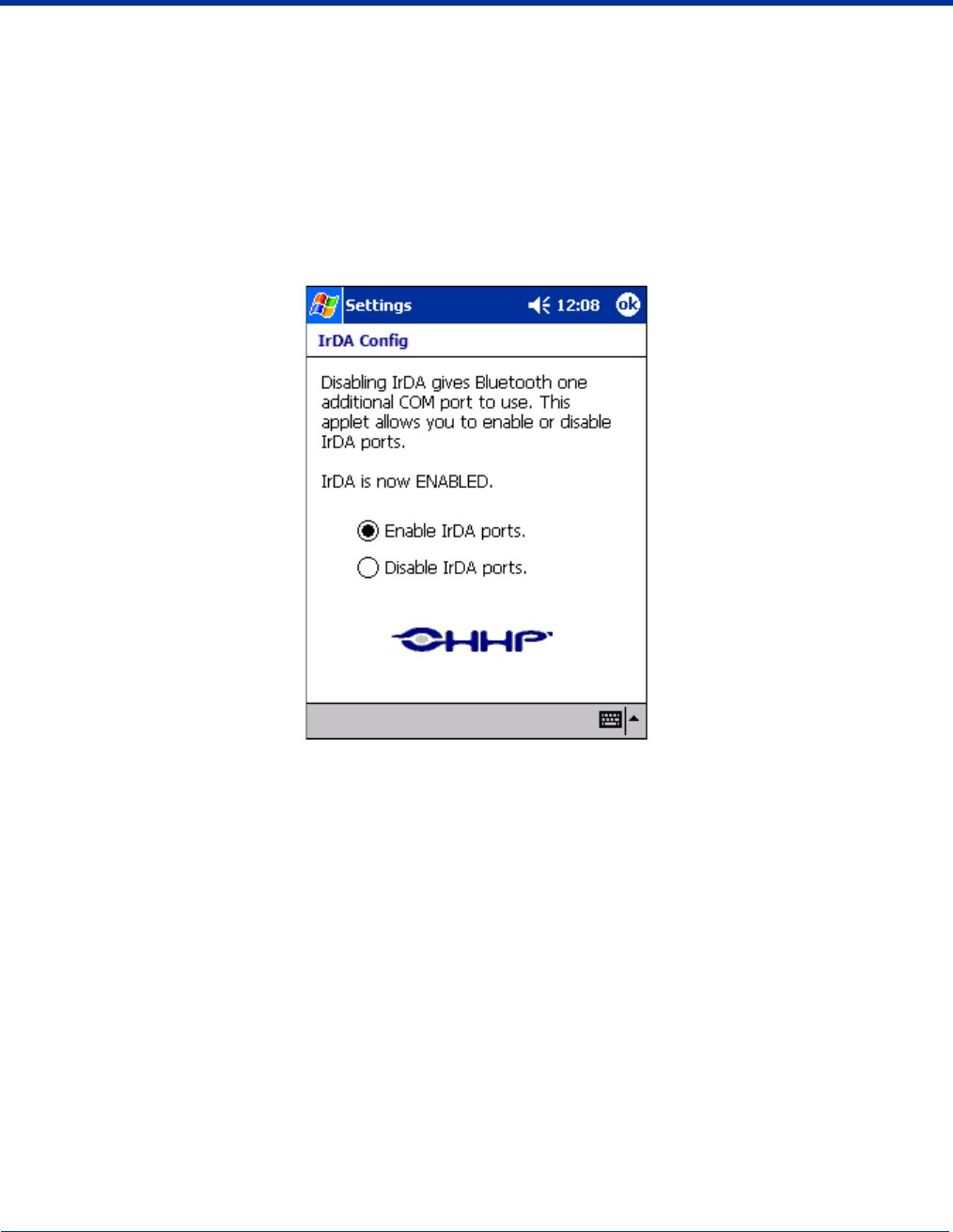
Dolphin® 9500/9550 Mobile Computer User’s Guide - GSM Draft 6 - 5
Using Infrared
Dolphin 9500/9550 terminals contains infrared or IrDA ports on the left side panel (see IrDA Port on page 3-8). Using these ports,
you can send and receive data between the terminal and other devices equipped with infrared. This can include, but is not limited
to, Pocket PC information such as Contacts and Tasks, as well as software upgrades.
Verify That the IrDA Port is Enabled
The IrDA port must be enabled to transmit data. By default, the IrDA port is assigned to com port 6 and is enabled. It can be
disabled to free up a com port.
Verify that the IrDA port is enabled before attempting to transmit data via infrared. Go to Go to Start > Settings > System tab >
IrDA Config.
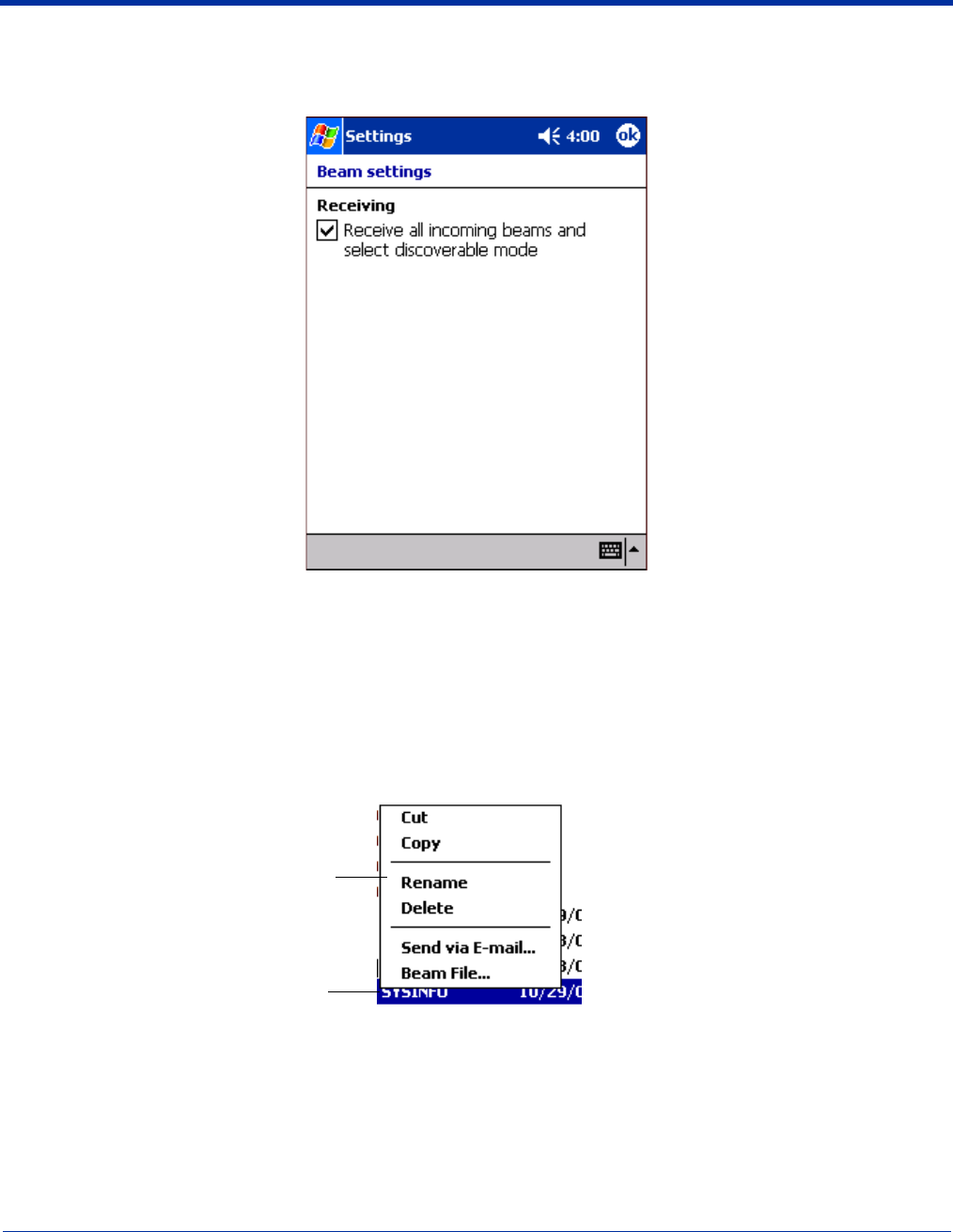
6 - 6 Dolphin® 9500/9550 Mobile Computer User’s Guide - GSM Draft
Verify That Beam Settings Are Set to Receive
The Beam Settings must be set to receive for the terminal to receive data from other infrared devices. To verify, tap Start >
Settings > Connections tab > Beam. The Beam Settings window should appear as follows:
Sending and Receiving Information
Sending:
1. Align the IR ports so that they are unobstructed and within a close range.
2. Open the program where you created the item you want to send and locate the item in the list.
You can also beam files, but not folders, from File Explorer.
3. Tap and hold the item. A pop-up menu appears.
4. Select Beam File.
Receiving:
1. Align the IR ports so that they are unobstructed and within a close range.
2. Have the owner of the other device send the information to you. Your device automatically receives it.
Selected item
Pop-up menu
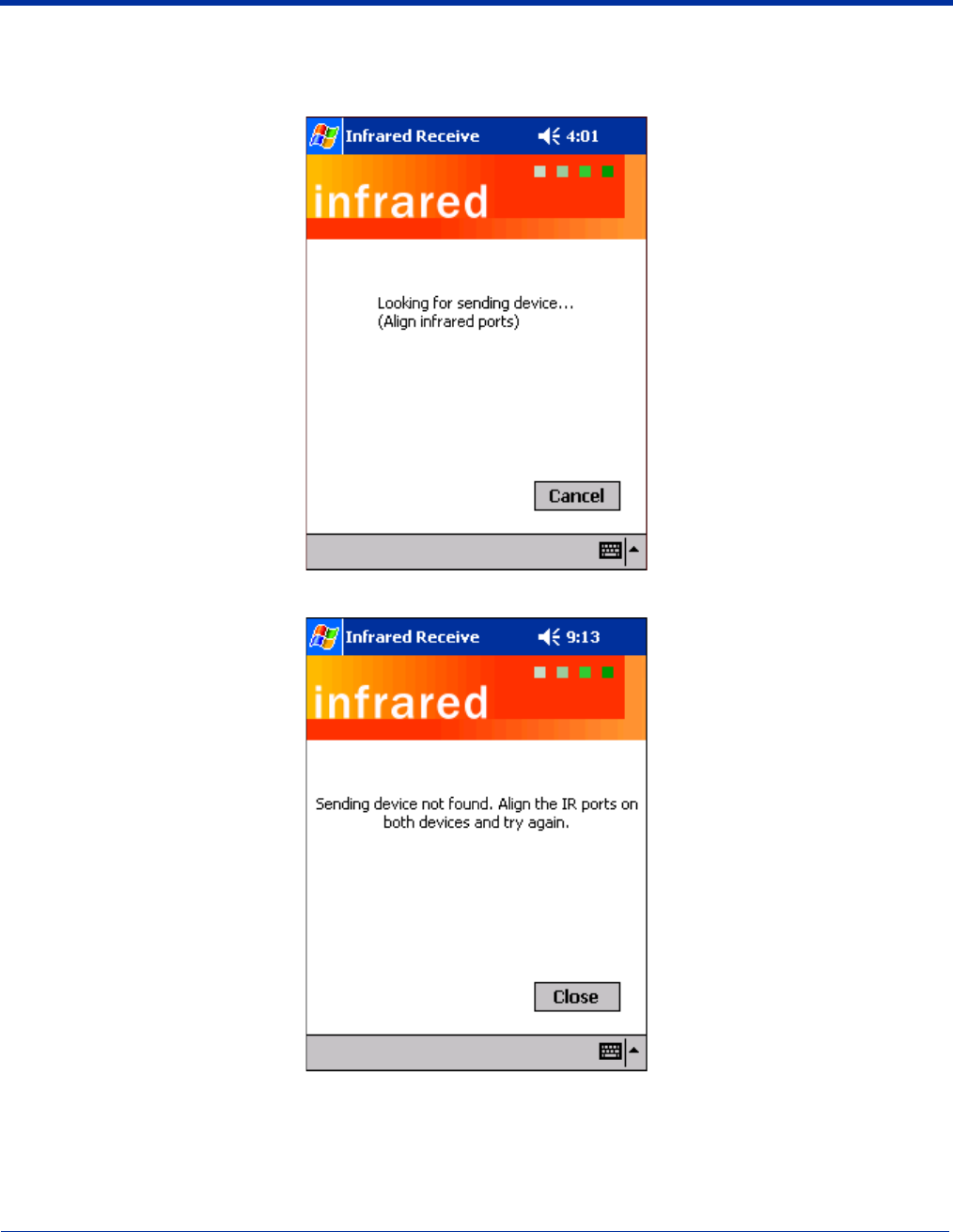
Dolphin® 9500/9550 Mobile Computer User’s Guide - GSM Draft 6 - 7
Troubleshooting
If the Beam Settings are not set to receive or you’ve aligned two IrDA ports and the terminal is still not receiving, go to Start >
Programs > Infrared Receive. The terminal searches for the sending device.
If the terminal cannot find the sending device, the following message appears:

6 - 8 Dolphin® 9500/9550 Mobile Computer User’s Guide - GSM Draft
Using an ISP
The communication software for creating an ISP connection is already installed on your device. Your service provider should
provide the software needed to install other services, such as paging and fax services.
After you are connected, you can send and receive e-mail messages by using Inbox and view Web or WAP pages by using
Pocket Internet Explorer. For more information, see Inbox on page 10-12. You can also download software applications from the
web.
Adding Programs Directly from the Internet
When selecting programs, verify that the program and version of the program are designed for the Pocket PC and your
device processor type. Determine your device and processor type by tapping Start > Settings > System tab > About. On
the Version tab, make a note of the information in the Processor field.
1. Determine your device and processor type so that you know which version of the software to install. Go to Start > Settings >
System tab > About. On the Version tab, make a note of the information in the Processor field.
2. Download the program to your device straight from the Internet using Pocket Internet Explorer. You may see a single *.exe or
setup.exe file, or several versions of files for different device types and processors.
3. Read any installation instructions, Read Me files, or documentation that comes with the program. Many programs provide
special installation instructions.
4. Tap the file, such as an *.exe file. The installation wizard begins. Follow the directions on the screen.
For more information about working with Pocket Internet Explorer, see Pocket Internet Explorer on page 10-17.
!

Dolphin® 9500/9550 Mobile Computer User’s Guide - GSM Draft 7 - 1
7
Wireless LAN Communications with 802.11b
Overview
Dolphin 9500/9550 terminals are available with an on-board 2.4 GHz 802.11b (Wireless Local Area Network) WLAN radio that
uses Direct Sequence Spread Spectrum (DSSS) technology to spread the signal continuously over a wide frequency band. It
provides a data rate of up to 11 Mbps. In addition, the open software architecture makes the Dolphin 9500/9550 a complete
solution for a variety of wireless mobile data collection applications.
The Dolphin 9500/9550 is interoperable with other 802.11b WiFi-compliant products including access points, printers, PCs via
PC-card adapters and other wireless portable terminals.
Powering Up the 802.11b Radio Driver
When the mobile computer is first initialized, the radio driver for the 802.11b module is installed. Before using the radio, make
sure that the 802.11b radio is powered up. For more information, see The Radio Manager on page 4-18.
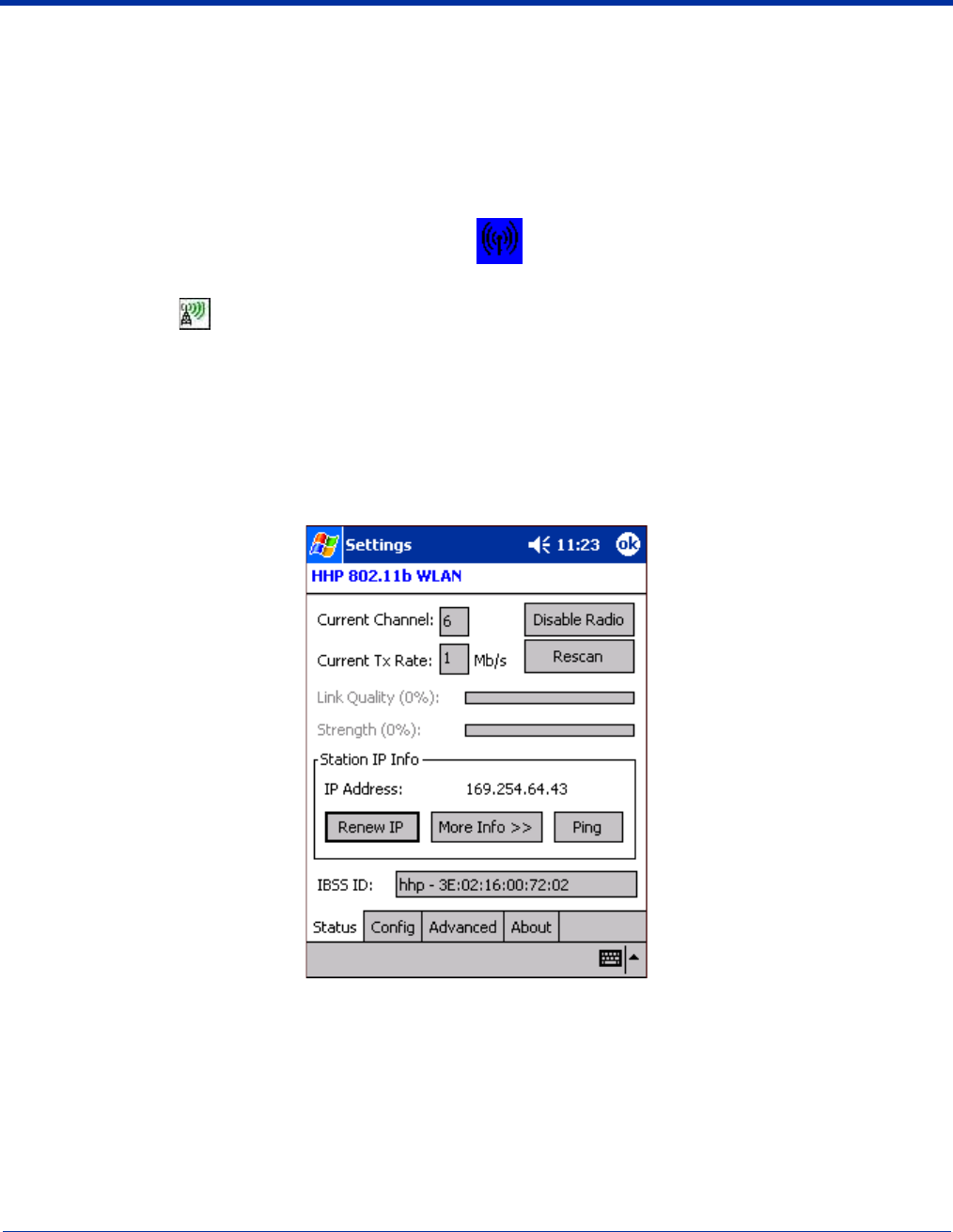
7 - 2 Dolphin® 9500/9550 Mobile Computer User’s Guide - GSM Draft
Configuring the 802.11b Radio
Dolphin 9500/9550 terminal loaded with an 802.11b radio contain a configuration utility that enables you to enter and save the
optimal transmission settings.
Accessing the Configuration Utility
You can access the configuration utility two ways:
1. Tap Start > Settings > System tab > HHP WLAN Settings .
This icon appears on the System tab only if there is an 802.11b radio installed on the terminal.
2. Tap the Status icon - see The Status Icon on page 7-10.
The Configuration Utility
The configuration utility consists of four tabs: Status, Config, Advanced, and About. Each tab is described in its own section in
this chapter.
Status Tab
HHP WLAN Settings always opens to the Status tab, which displays the current WLAN settings for 802.11b.
Current Channel Shows the RF channel currently used by the card.
Current TX Rate Shows the current transmit rate. This can be 1 Mbps, 2 Mbps, 5.5 Mbps, or 11 Mbps.
Link Quality Gives signal to noise ratio in both percentage and graphical display.
Strength Gives signal strength of the receiver in both percentage and graphical display.
Station IP Info IP Address - IP address of the radio. Check with your network administrator for IP configuration
information.
IBSS ID Shows the Network Name and the MAC address of:
- the access point the card is associated with in AP mode, or
- the creator of IBSS into which the card is joined in peer-to-peer (Ad-Hoc) mode.
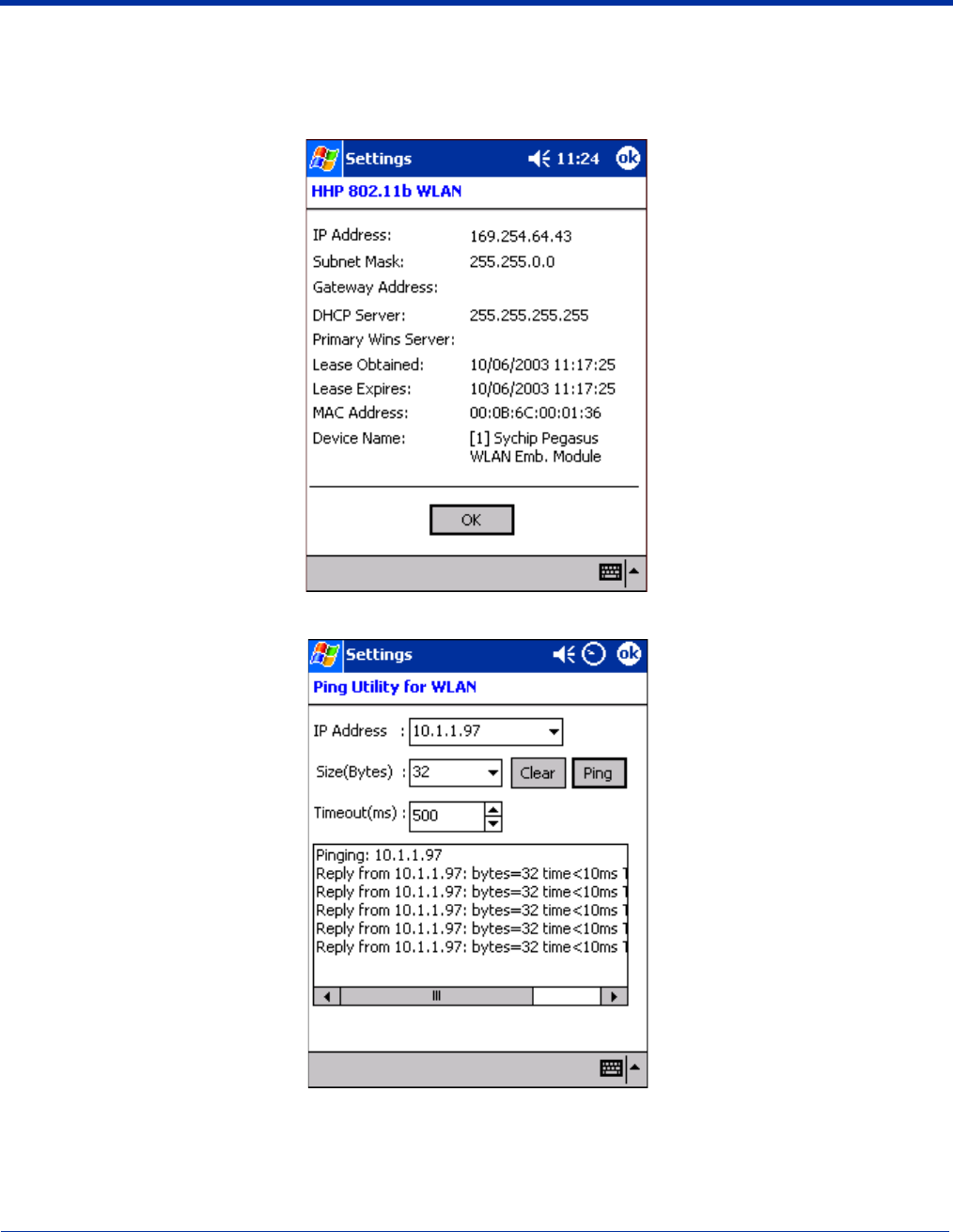
Dolphin® 9500/9550 Mobile Computer User’s Guide - GSM Draft 7 - 3
Disable/Enable Radio Tap this button to toggle to disable/enable the radio link from the card.
Rescan Tap this button to start a rescan process to search for an AP with a stronger signal in the network.
Renew IP Tap this button to reapply IP the address from the DHCP server when automatic DHCP is enabled.
More Info Tap this button to display detailed TCP/IP info; as shown in the following screen:
Ping Tap this button to open the Ping utility for WLAN.
Field Description
IP Address Displays the current IP address. You can enter another IP address to ping.
Size (Bytes) Displays the current bytes size; 32 is the default. You can select up to 8192
from the drop-down list.
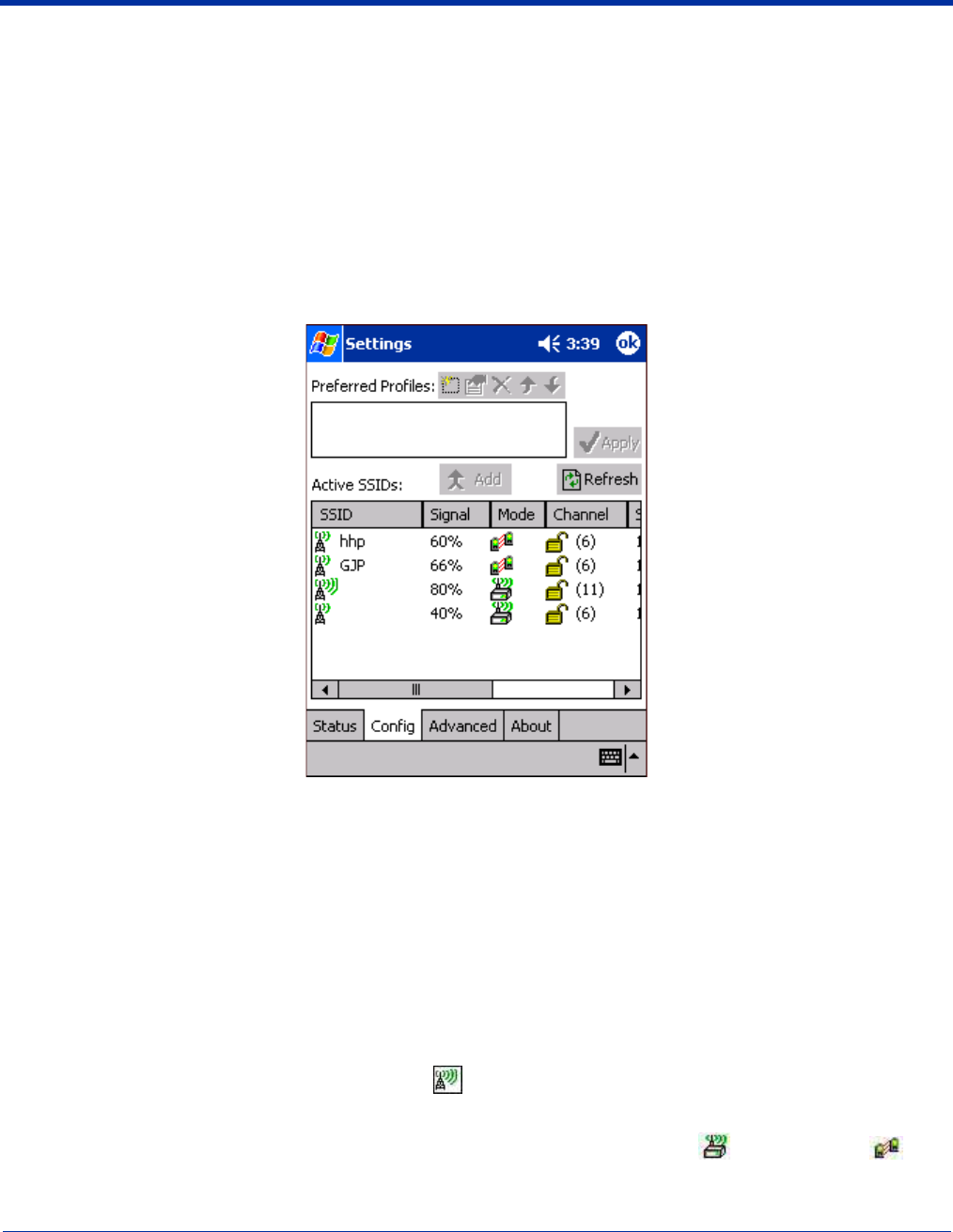
7 - 4 Dolphin® 9500/9550 Mobile Computer User’s Guide - GSM Draft
Config Tab
The Config tab provides a list of all access points and peer stations in range. Its configuration tool enables you to create and edit
SSID profiles for access points that you want your station to associate with.
Preferred Profiles A list of preferred profiles for access points (AP) in the network created by the user, or added from
the Active SSIDs table is located at the top of the Config window. When the radio is turned on, it
searches for the APs with which to associate in the order of the listed profiles. For each profile in the
table, one can make changes by using the icon tools at top of the table: New, Edit, Delete, Up, and
Down (- the creator of IBSS into which the card is joined in peer-to-peer (Ad-Hoc) mode. on page 7-
2). This table is blank after the initial HHP software installation. It can be kept blank with no automatic
association preference.
Active SSIDs The Active SSIDs table lists all access points or peer stations (creator of IBSS) in the vicinity of the
host. It displays only those SSIDs that accept broadcast associations.
Each record displays information in the following six fields (The screen may not display all the fields
in the following table. Use horizontal scroll bar to check all):
Timeout (ms) Displays the current timeout; 500 is the default. Increase or decrease it by
tapping the up and down arrow buttons.
Clear Tap this button to clear IP Address input and the ping statistics field.
Ping Tap this button to ping the IP address entered in the input field.
Ping Statistics field: Shows the pinging IP address and the pinging results.
Column This column displays…
SSID The Network Name of the access point or peer station. An icon with signal
strength is also shown.
Signal Strength in percentage for that SSID.
Mode An icon shows whether it is an access point , or a peer station .
Field Description

Dolphin® 9500/9550 Mobile Computer User’s Guide - GSM Draft 7 - 5
Apply Tap Apply to associate your station with the SSID you selected.
This SSID can be either from the Preferred Profile table or from the Active SSIDs list. When applied,
the Status tab window displays the status of the wireless connection. If the association failed, a
search for another AP in the Preferred Profile list automatically takes place, and the radio attempts to
associate with the station, in order of preference.
Refresh Tap Refresh to start a new search for all available access points or peer stations in the vicinity.
Adding an Active SSID Profile to the Preferred Profile Table
1. Select an SSID from the Active SSID list.
2. Tap Add.
If the SSID has WEP Key-On, the Settings window displays and prompts you to enter the WEP Method, Encryption Key, and
Key ID.
3. Tap OK in the Settings window after finishing the configuration. The SSID and its profile are added into the Preferred Profiles
window.
If adding an SSID with WEP Key Off, the Settings window does not display and the SSID is added directly to the Preferred
Profile table when you tap the Add button.
Channel The channel it uses and the WEP method it applies, if any. The icon
stands for WEP Key-On, and for WEP Key-Off.
SupRate Supported data rate of the access point or the peer station.
BSSID (MAC Addr) BSSID or MAC Address of the access point or the peer station.
Column This column displays…
SSID The Network Name of the access point or peer station. An icon with signal
strength is also shown.
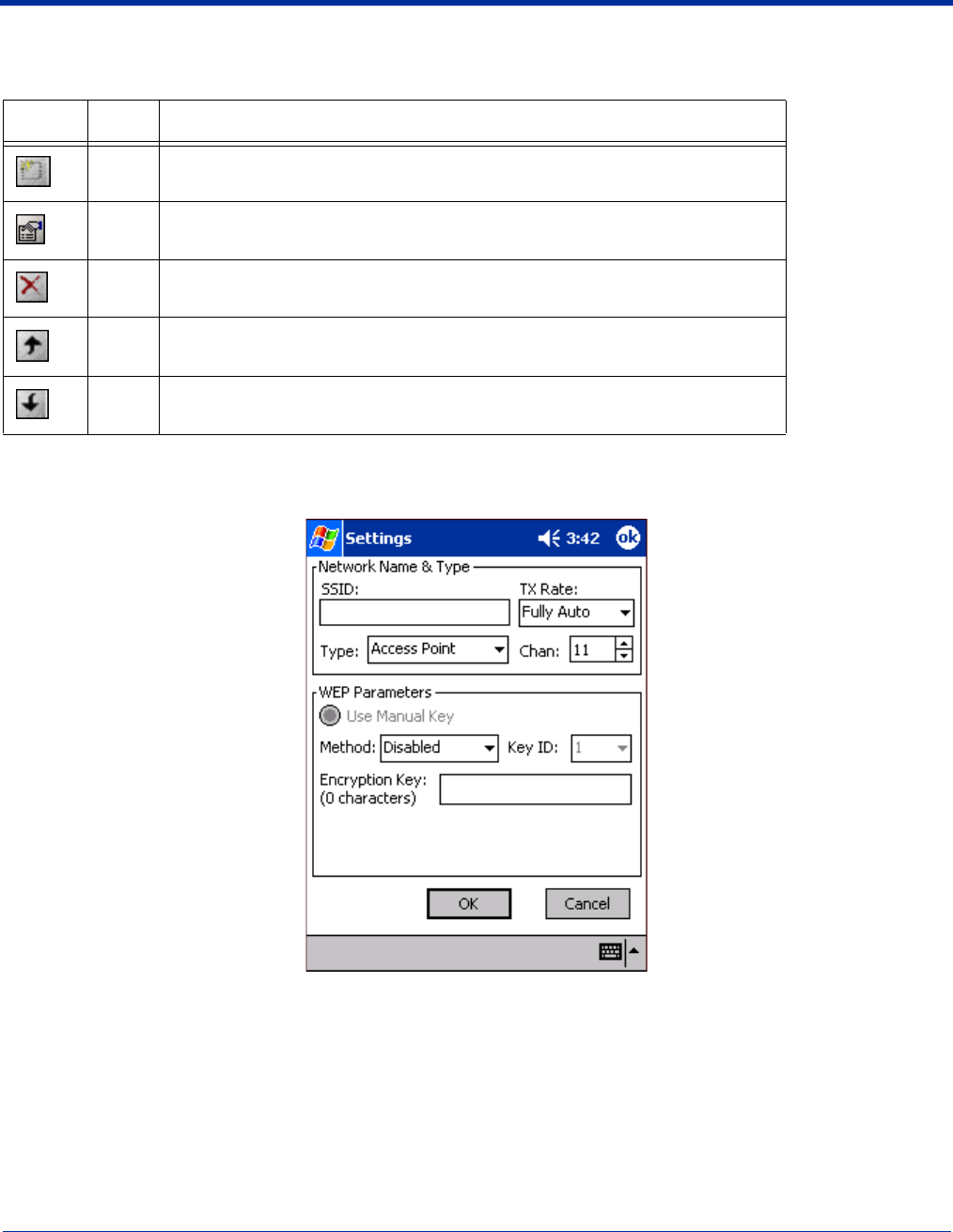
7 - 6 Dolphin® 9500/9550 Mobile Computer User’s Guide - GSM Draft
Preferred Profile Icons
You can complete a number of tasks to manage your Preferred Profiles using the five icons at the top of the window:
To Create a New Profile
1. Tap the New button and the following screen displays:
2. Enter the values for the new profile in the information fields and tap OK.
Icon Name Tap this icon to…
New Create a profile.
Edit Modify a profile.
Delete Delete a selected profile.
Up Move the highlighted profile up to increase the automatic association priority.
Down Move the highlighted profile down to decrease the automatic association priority.
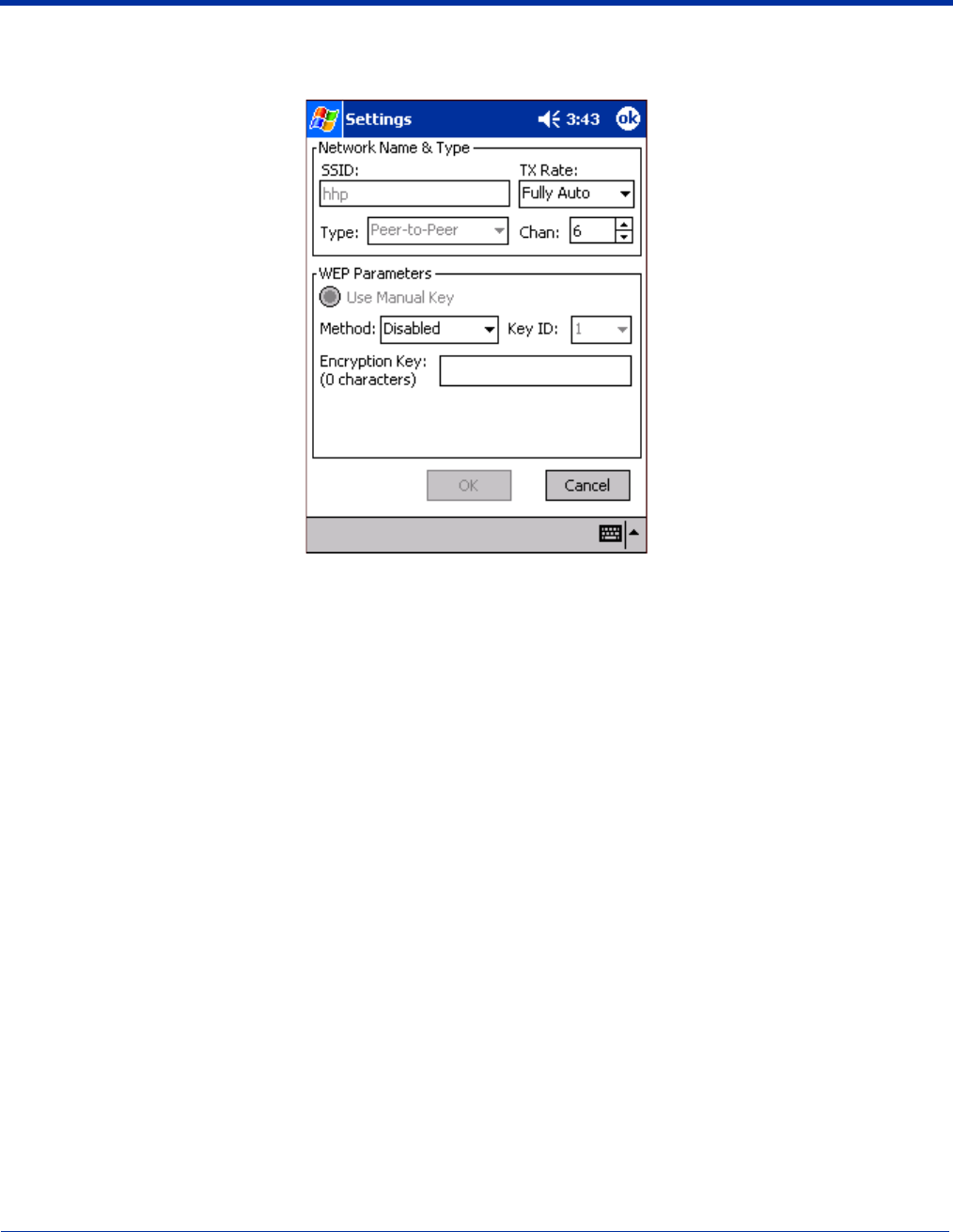
Dolphin® 9500/9550 Mobile Computer User’s Guide - GSM Draft 7 - 7
To Modify a Profile
Select one and tap the Edit icon. The following screen displays:
SSID To enter an SSID, which is the Network Name. Check with your network administrator for Network
Name (SSID).
Type Choose Peer-to-Peer or Access Point from the drop-down list. Peer-to-Peer mode is used for
communication between two (or more) radio stations (cards) without an access point. Access Point
mode is also called “Infrastructure” mode.
TX Rate Choose the transmit rate from the drop-down list - 1MB, 2 MB, Auto 1/2 MB, 5.5 MB, 11 MB, or Fully
Auto. The transmit rate is set to Fully Auto by default.
Chan Scroll to select a channel for communication.
WEP Parameters In this section, you configure the WEP Key for secure wireless communication. Within this block, you
configure the WEP Method, Encryption Key, and Key ID.
Use Manual Key Manually input the encryption code for the WEP Key. This is the default setting.
WEP Method The options in this drop-down list determine what characters can be used to create the Encryption
Key. Select one of the following five:
Encryption Key Character sets differ depending on the selected WEP method and key format.
Key ID Choose from the available options: Key 1 (Default), Key 2, Key 3, or Key 4. Check with your network
administrator for the WEP Key and Key ID you need to use.
Cancel Tap this button to close the window without saving or modifying the profile.
OK Tap this button to make the change.
Note: The SSID, Type, TX Rate, and Channel fields are unchangeable in Access Point mode, whereas TX Rate and Channel
fields can be changed in Peer-to-Peer mode.
Option This option means that …
Disabled WEP Key Off
64 bit (HEX) up to 10 characters are configurable in Hexadecimal for Encryption Key
64 bit (ASCII) up to 5 characters are configurable in ASCII for Encryption Key
128 bit (HEX) up to 26 characters are configurable in Hexadecimal for Encryption Key
128 bit (ASCII) up to 13 characters are configurable in ASCII for Encryption Key
HEX - Hexadecimal is a set of 16 characters from 0-9 and from A(a)-F(f).
ASCII - ASCII means any printable ASCII character can be typed.
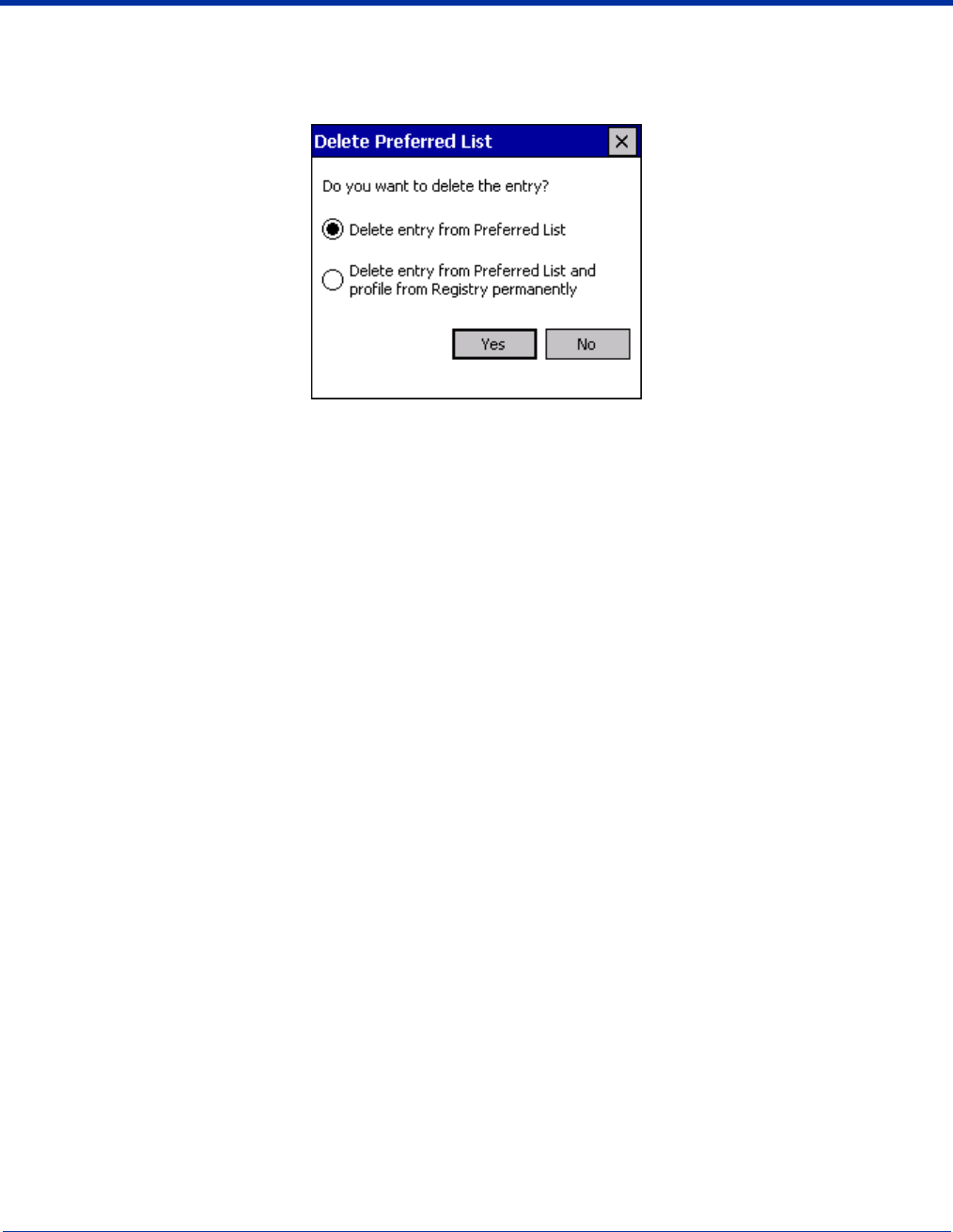
7 - 8 Dolphin® 9500/9550 Mobile Computer User’s Guide - GSM Draft
To Delete a Profile
Profiles may be deleted either from the Preferred List or from the Preferred List and Registry. To delete a profile, select (highlight)
a profile and tap the Delete button and the following screen displays:
From the pop-up window select the option of your choice and tap Yes to confirm or No to cancel.
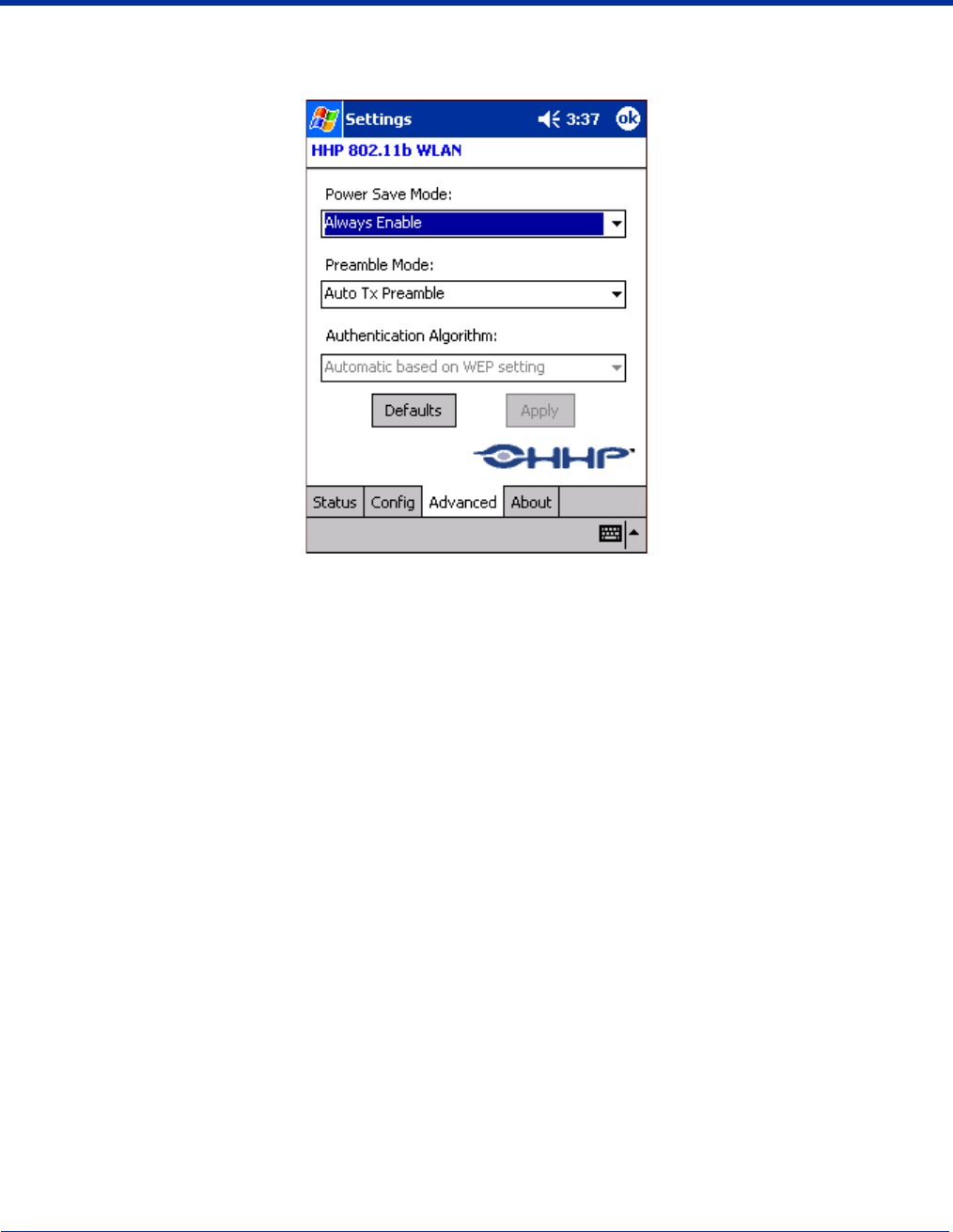
Dolphin® 9500/9550 Mobile Computer User’s Guide - GSM Draft 7 - 9
Advanced Tab
On the Settings window, tap the Advanced tab. The following screen displays:
Power Save Mode
Disable Choosing this option disables the Power Save mode.
Always Enable Choosing this option makes the Power Save mode always enabled. This is the default setting.
Auto Enable Choosing this option means that the Power Save mode is automatically enabled when the internal
battery powers the terminal and automatically disabled when an external power supply powers the
terminal.
Preamble Mode
Long TX Preamble Where Sync field consists of 128 bits.
Short TX Preamble Where Sync field consists of 56 bits.
Auto TX Preamble Automatically change between long and short preamble mode transmission based on the AP
configurations. This is the default Preamble Mode.
A Preamble consists of a Synchronization (Sync) field and a 16-bit Start Frame Delimiter (SFD) field.
Authentication Algorithm
This drop-down list is active and configurable only when the WEP Key is enabled for the selected SSID profile.
Automatic based on WEP setting Default setting.
WECA Compliant (always use Open)Not available in this release.
Must use Shared with WEP AP must use WEP method.
Defaults Resets all the settings to default values (Always Enable for Power Save Mode, Automatic based on
WEP setting for Authentication Algorithm, and Auto TX Preamble for Preamble Mode).
Apply Applies the change to new card setting.
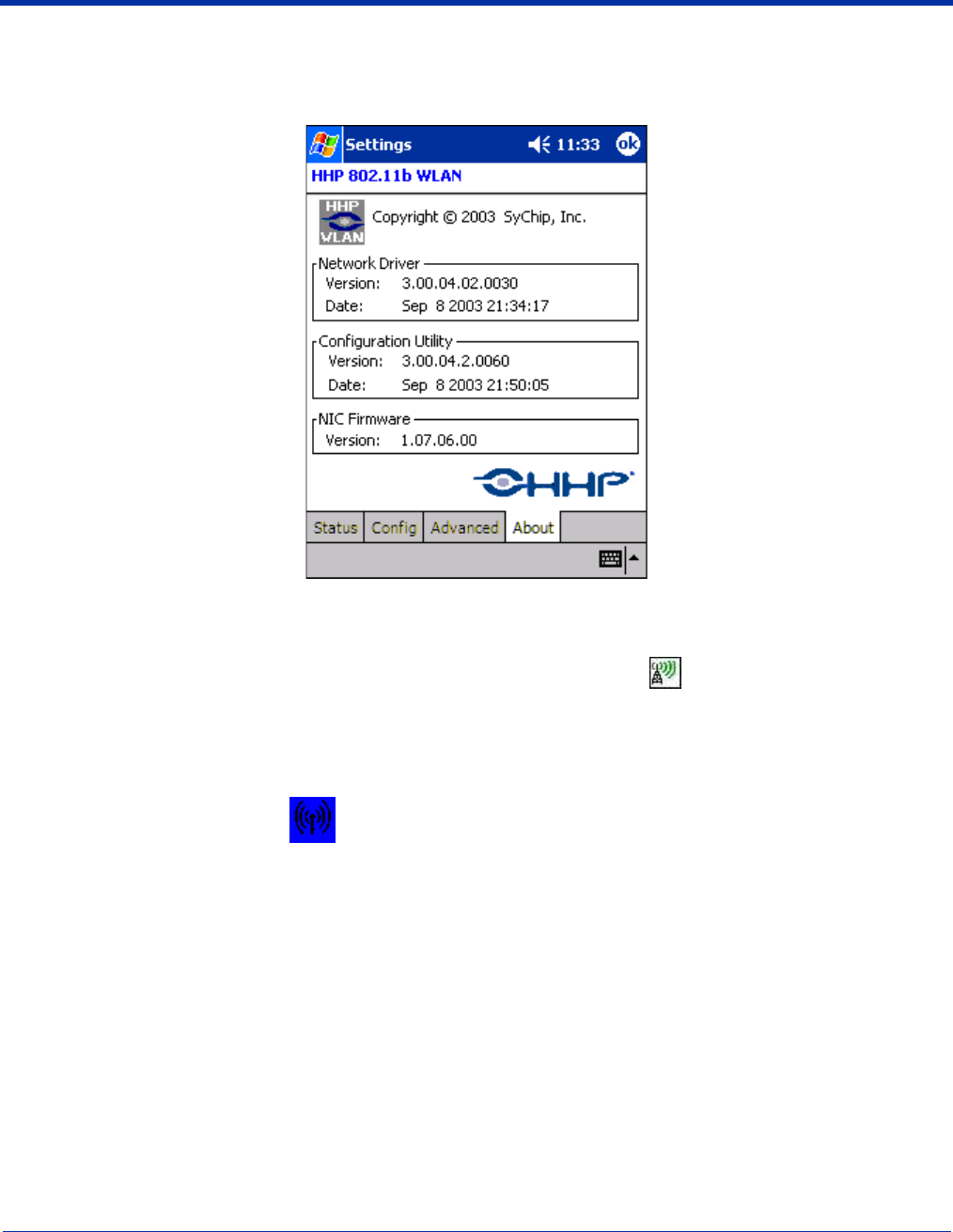
7 - 10 Dolphin® 9500/9550 Mobile Computer User’s Guide - GSM Draft
About Tab
This window provides Version Number and time of build for Network Driver, Configuration Utility, and NIC Firmware.
On the Settings window, tap the About tab.
The Status Icon
You access the 801.11b configuration utility by tapping and holding on the Status icon in the task tray at the bottom of the
screen. However, you must activate this icon before it appears.
To Activate the Status Icon
1. Tap Start > Programs.
2. Tap the HHP WLAN Settings icon .
This icon appears on the Programs window only if an 802.11b radio is installed.
3. The Status icon is now active in the bottom tray. When you tap it, a menu of configuration options appears.
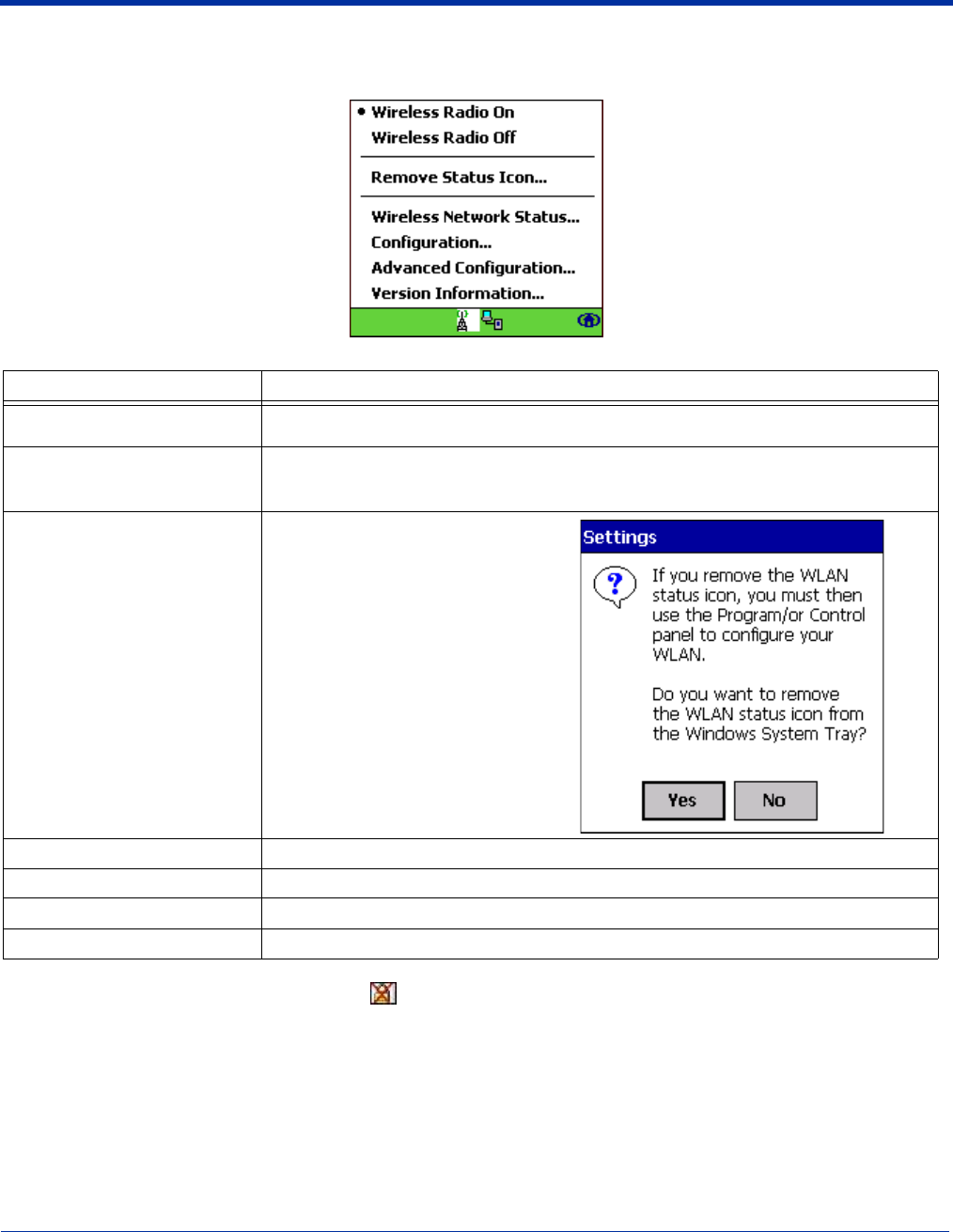
Dolphin® 9500/9550 Mobile Computer User’s Guide - GSM Draft 7 - 11
The Status Icon Menu
When you tap the Status icon in the bottom tray, the following menu displays:
Note: The Status Icon changes to a crossed lock as a warning that you may have entered a wrong key (WEP Key mismatch)
for the WEP-On AP or a station.
Menu Option Selecting This Option…
Wireless Radio On Turns on the radio. LED is on and the Link Icon displays with signal strength.
Wireless Radio Off Turns off the radio. A pop-up window will ask for your confirmation. If confirmed, the LED
will be off and the Status icon will change color from green to red on the top without signal
strength displayed. The WLAN card/module will stop functioning.
Remove Status Icon Removes the Status Icon from the
bottom tray. A pop-up window asks
you to confirm. Click Yes to confirm,
or No to cancel.
If confirmed, the Status icon does
not display in the task tray, and you
need to go to Start > Programs >
HHP WLAN Settings to access the
configuration utility.
Wireless Network Status Opens the Status tab of the configuration utility; see Status Tab on page 7-2.
Configuration Opens the Config tab of the configuration utility; see Config Tab on page 7-4.
Advanced Configuration Opens the Advanced tab of the configuration utility; see Advanced Tab on page 7-9.
Version Information Opens the About tab of the configuration utility; see About Tab on page 7-10.

7 - 12 Dolphin® 9500/9550 Mobile Computer User’s Guide - GSM Draft
Wireless Security Supplement
AEGIS Client® offers the most comprehensive IEEE 802.1X supplicant for securing wired and wireless networks. The Client is a
standards-based implementation of IEEE 802.1X and can be configured to work with almost any network equipment - wired or
wireless - that supports the 802.1X authentication standard. The Client is interoperable with 802.1X-capable wireless access
points and authentication servers including Microsoft's IAS and Cisco's ACS.
Installing the AEGIS Client Software
Preparation
Installing and configuring AEGIS Client software usually takes less than 15 minutes, provided you have the required equipment,
software, and configuration information. You need clear information from the network administrator about how the network’s
authentication works. Worksheets are provided below.
System Requirements
You need the following equipment and software to run AEGIS Client:
• A computer with a network interface card and/or wireless network interface card that support the NDIS 5.1 standard for 802.11
WLAN object identifiers (OID). Be sure your wireless card is installed! The AEGIS Client software installation routine
expects to find your computer’s wireless card properly installed, even if it isn’t connected to a network. If the card isn’t in the
computer, the installation program can’t make the proper program and protocol associations.
• The appropriate version of the AEGIS Client software package for your operating system. Contact HHP for the correct version
for your company.
Supported Operating Systems
There are several versions of AEGIS Client software for computers using a wide variety of operating systems. However, specific
capabilities of a particular version of AEGIS Client may vary. This is due to varying levels of support for different EAP types by
manufacturers. Drivers for some types of network hardware and operating system combinations don’t support as many EAP
types as others combinations.
The Windows AEGIS Client software requires Pocket PC 2002, CE.NET 4.1, or higher.
Required Network Configuration Information Worksheets
The worksheets on the following pages help you prepare to install and configure the AEGIS Client.
Each worksheet provides space to record the AEGIS Client configuration information required to set up the client software to
match a specific Extensible Authentication Protocol (EAP). The forms are designed so that hard copies can be filled out, copied,
and distributed.
The client software supports the following EAP authentication methods:
•MD5
• LEAP
• TLS/SmartCard
•TTLS
• PEAP
There is a worksheet for each method. Complete the worksheet for the method you choose.

Dolphin® 9500/9550 Mobile Computer User’s Guide - GSM Draft 7 - 13
MD5 Worksheet
To configure AEGIS Client to use MD5 authentication, you need to know:
1. Will you use your Windows user name and password for network authentication? (Applies only to Windows clients.)
2. If not, what is your unique user name/password combination?
If a second set of credentials is required, you need to know the exact user name and password. These are typically case-
sensitive.
User name: _______________________________________
Password: ________________________________________
LEAP Worksheet
To configure AEGIS Client to use LEAP authentication, you need to know:
1. Will you use your Windows user name and password for network authentication? (Applies only to Windows clients.)
2. If not, what is your unique user name/password combination?
If a second set of credentials is required, you need to know the exact user name and password. These are typically case-
sensitive.
User name: _______________________________________
Password: ________________________________________
TLS/SmartCard Worksheet
To configure AEGIS Client to use TLS/SmartCard authentication, you need to know:
1. Is a client certificate required?
____ No.
____ Yes. This file needs to be installed on your machine by your network administrator.
2. Should the AEGIS Client validate the server certificate chain?
____ No. Skip Questions 3-4.
____ Yes.
3. Will the server accept any trusted Certificate Authority (CA), or is a particular CA required?
____ Any trusted CA is acceptable.
____ A particular CA is required:________________________
4. Are intermediate certificates allowed?
____ No.
____ Yes.
5. What is the name of the server? _____________________________
This usually includes the server’s domain, for example: server.big_school.edu.

7 - 14 Dolphin® 9500/9550 Mobile Computer User’s Guide - GSM Draft
TTLS Worksheet
To configure with TTLS authentication, you need to know:
1. Use Windows user name and password for authentication? (Applies only to Windows clients.)
2. If not, what is your unique user name? If a second set of credentials is required, you need to know the exact user name. This
is usually case-sensitive.
User name:_______________________________________
3. Is a client certificate required?
____ No.
____ Yes. This file needs to be installed on your machine by your network administrator.
4. What is the user name (identity) and password for the tunnel authentication?
User name:_______________________________________
Password:________________________________________
5. What is the tunnel authentication protocol?
____ CHAP (Challenge Handshake Authentication Protocol)
____ MS-CHAP (Microsoft CHAP Extensions)
____ MS-CHAP v2 (Microsoft CHAP Extensions v. 2)
____ PAP
____ EAP-MD5
6. Is a server certificate is required?
____ No.
____ Yes.
7. Should the Aegis Client validate the server certificate chain?
____ No. Skip Questions 8-9.
____ Yes.
8. Will the server accept any trusted Certificate Authority (CA), or is a particular CA required?
____ Any trusted CA is acceptable.
____ A particular CA is required: _______________________
9. Are intermediate certificates allowed?
____ No.
____ Yes.
10. What is the name of the server?
This usually includes the server’s domain, for example: server.big_school.edu. _____________________________

Dolphin® 9500/9550 Mobile Computer User’s Guide - GSM Draft 7 - 15
PEAP Worksheet
To configure AEGIS Client with PEAP Authentication, you need to know:
1. Use Windows user name and password for authentication? (Applies only to Windows clients.)
2. If not, what is your unique user name? If a second set of credentials is required, you need to know the exact user name. This
is usually case-sensitive.
User name:_______________________________________
3. Is a client certificate required?
____ No.
____ Yes. If it is, this file needs to be installed on your machine by your network administrator.
4. What is the user name (identity) and password for the tunnel authentication?
User name:_______________________________________
Password:________________________________________
5. What is the tunnel authentication protocol?
____ MS-CHAP v2 (Microsoft CHAP Extensions v. 2)
____ EAP TLS/SmartCard
____ Generic Token Card
6. Is a server certificate is required?
____ No.
____ Yes.
7. Should the Aegis Client validate the server certificate chain?
____ No. Skip Questions 8-9.
____ Yes.
8. Will the server accept any trusted Certificate Authority (CA), or is a particular CA required?
____ Any trusted CA is acceptable.
____ A particular CA is required: _______________________
9. Are intermediate certificates allowed?
____ No.
____ Yes.
10. What is the name of the server?
This usually includes the server’s domain, for example: server.big_school.edu. _____________________________
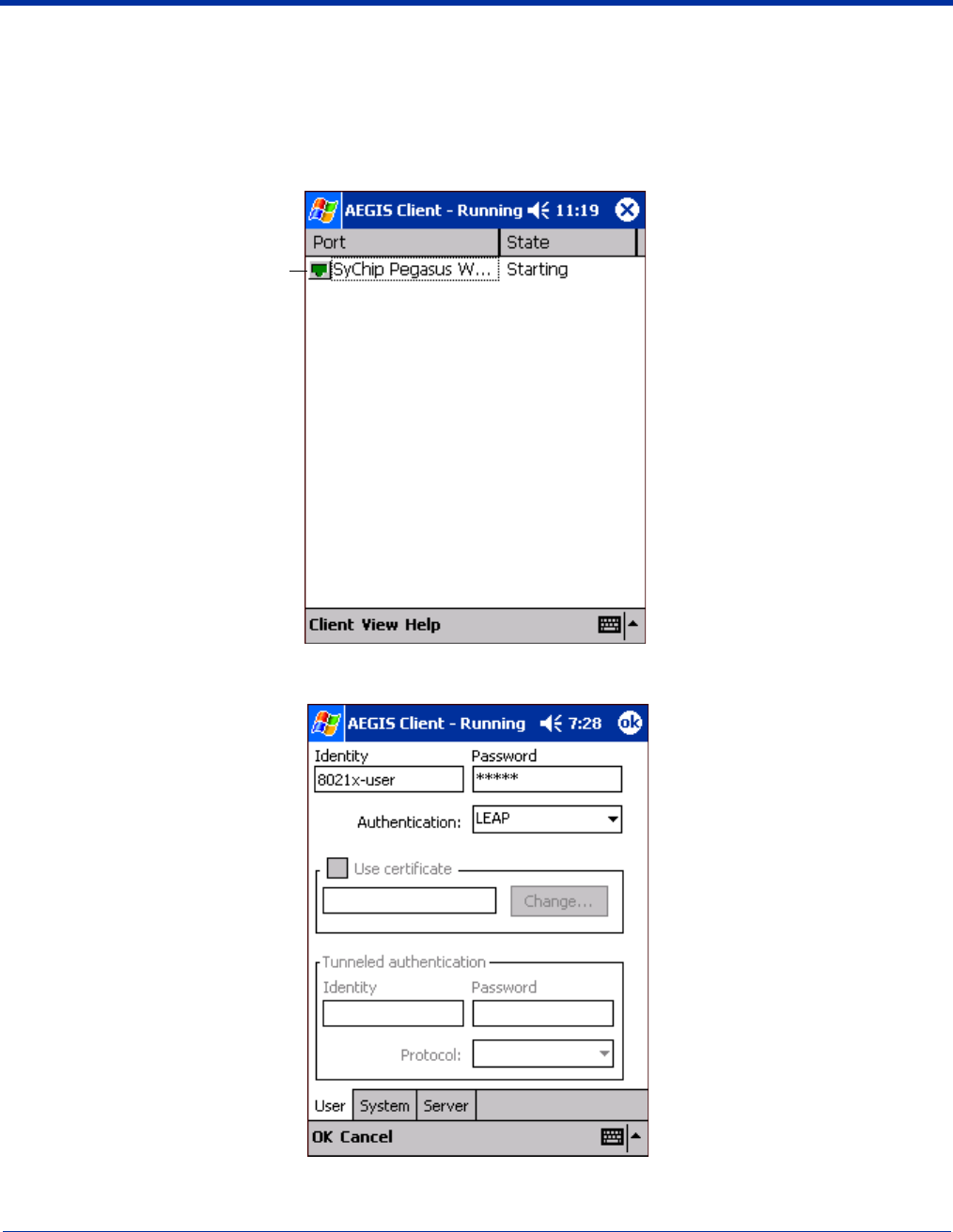
7 - 16 Dolphin® 9500/9550 Mobile Computer User’s Guide - GSM Draft
Configuring the Pocket PC Client
Because AEGIS Client enables your terminal to access a network that is protected by the IEEE 802.1X protocol, you must
configure EAP data communication to match your network server parameters. If the EAP configuration doesn’t match your
network configuration, you can’t access the network.
1. On the terminal, open the client by going to Start > Programs > Meetinghouse AEGIS Client. The Main screen opens
displaying a list of ports on the system’s network interface cards, You manage ports on this screen.
2. Tap the Client menu and select Configure. The Configuration Authentication screen appears displaying the User tab.
3. On the User tab
Port Status icon
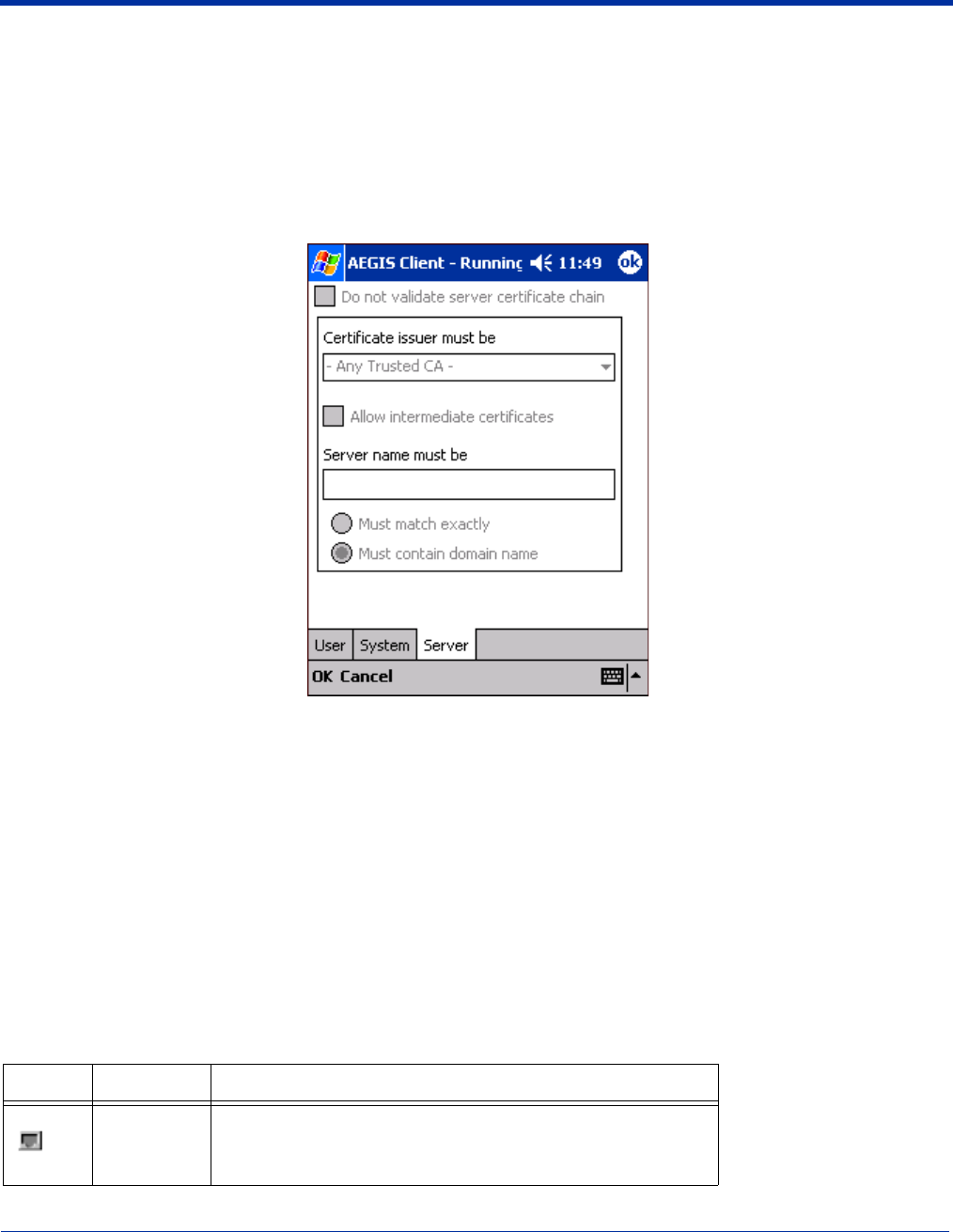
Dolphin® 9500/9550 Mobile Computer User’s Guide - GSM Draft 7 - 17
• In the Identity field, enter your network login or user name.
• In the Password field, enter your network password.
• If your network requires client certificates, select the Use certificate option and complete the information.
• If the Authentication Type is PEAP or TTLS, select the Tunneled authentication option and enter the appropriate
Identity, Password, and Protocol.
4. For most installations, you would skip the System tab, which controls system logging of network problems. Unless your set-
up requires custom logging, accept the default logging settings. For more information, see System Settings Tab on page 7-
20.
5. Tap the Server tab.
6. Depending on your authentication type, the Server tab
• may be entirely grayed-out (for instance, if you use MD5 authentication), or
• you may need to enter server-related information that you’ve already gathered on your worksheet (for TLS, TTLS, and
PEAP).
7. When you’ve entered the server information, tap OK to save the configuration and close the window.
Running AEGIS Client
After you finish the initial configuration, tap the network interface and select Start (if the port is already active, select Stop first,
then Start to force the program to read the new configuration file). On the main screen, you should see the port color and status
change as the port starts authentication, negotiates with the access point and/or authentication server, and then joins the
network.
As the network interface starts or stops, the color of the port icon and the status field in the Interface List updates to reflect the
current state of the interface.
Port Status Icon Table
Icon Color This color icon indicates that …
Gray
The port is not in use or is disabled.
Either the AEGIS Client isn’t running, or the port is not bound to
the 802.1X protocol.
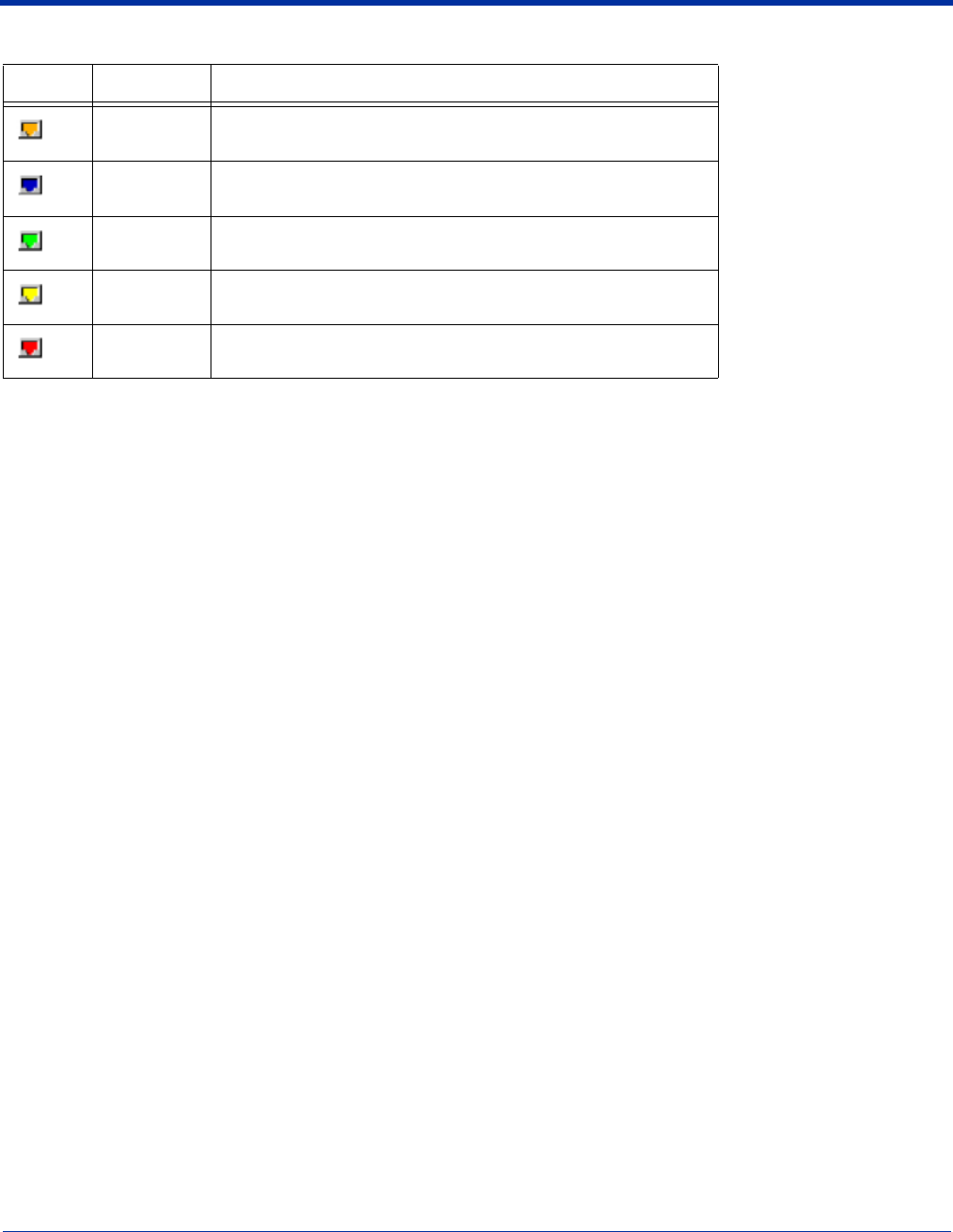
7 - 18 Dolphin® 9500/9550 Mobile Computer User’s Guide - GSM Draft
Configuring the AEGIS Client Software
Configuration takes place at several levels:
• First, each interface that interacts with the AEGIS Client may need to be configured.
• Second, each user account on the computer needs its own unique authentication settings. Because Pocket PC devices are
usually small devices with a single NIC and, usually, a single user, the initial configuration is usually the only time the software
needs to be set up. The Client will need to be reconfigured if the device is used on multiple networks, or if different users share
the computer.
• Third, each port may need to have its default settings changed.
The Configuration screen has three tabs:
1. User settings tab - where you configure the authentication credentials.
2. System settings tab - where you set the level of detail that the Client will provide in the system log.
3. Server identity tab - used only for the TLS, TTLS, and PEAP authentication methods. It tells the Client what server
credentials to accept from the authentication server to verify the server.
Orange The port is associated, but there is no response to 802.11b
packets.
Blue There is no 802.11b activity.
Green Authentication succeeded.
Yellow Authentication is in process.
Red Authentication failed.
Port Status Icon Table
Icon Color This color icon indicates that …
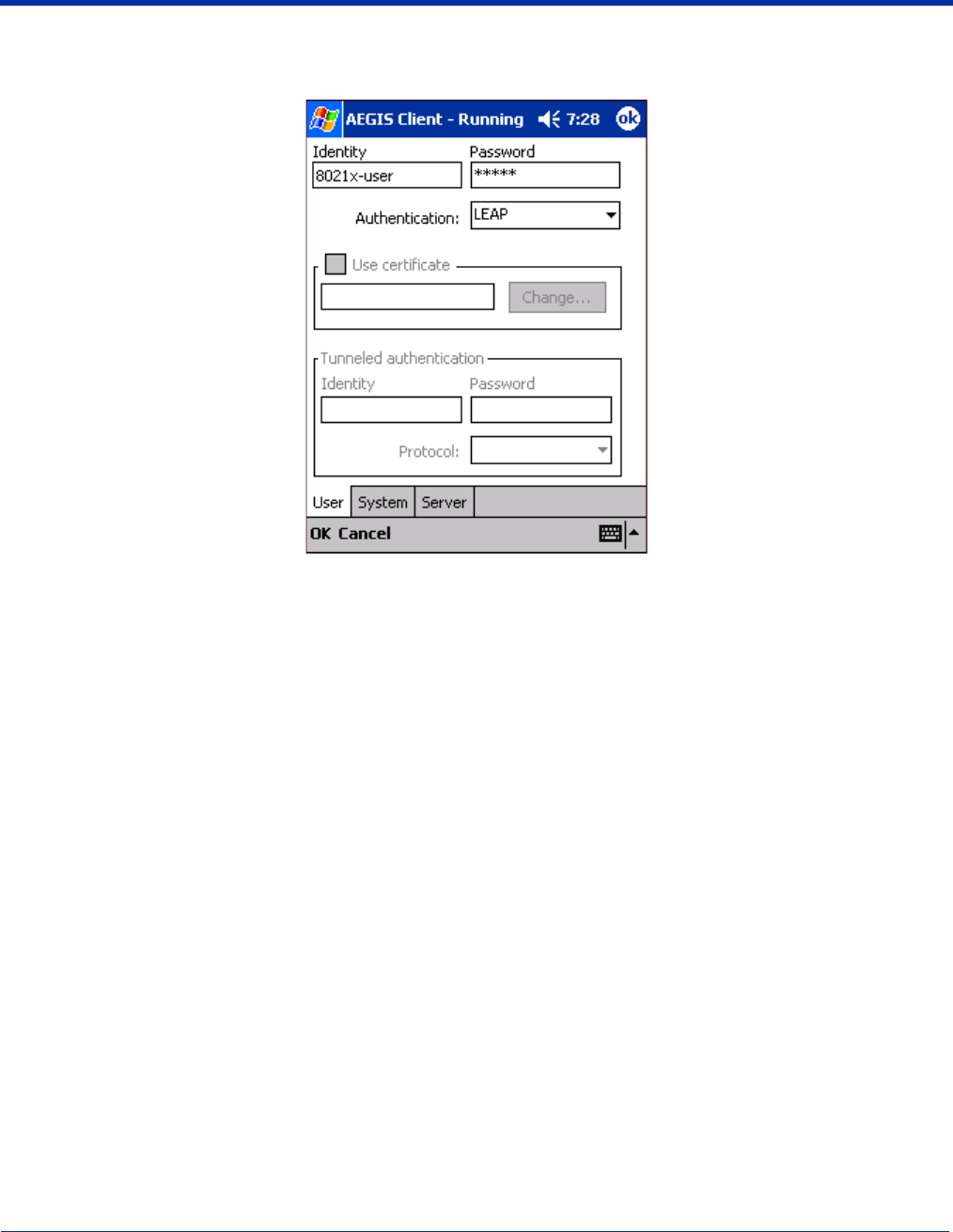
Dolphin® 9500/9550 Mobile Computer User’s Guide - GSM Draft 7 - 19
User Settings Tab
The User settings tab defines the protocol and the credentials used to authenticate a user.
Identity The 802.1X identity supplied to the authenticator. The identity value can be up to 63 ASCII characters
and is case-sensitive. In TTLS and PEAP, it is recommended that this field not contain a true identity,
but instead the identity “anonymous”, and any desired realm (e.g. anonymous@myrealm.com).
Password The password used for MD5-Challenge or LEAP authentication. It may contain up to 63 ASCII
characters and is case sensitive.
Authentication Valid entries are MD5-Challenge, LEAP, PEAP, TLS, or TTLS authentication.
Certificate The client certificate used with TLS or if TTLS or PEAP is selected and optional client authentication
is activated. When specifying a client certificate, do not enable strong private key protection. If you
enable strong private key protection for a certificate, an access password must be entered for the
certificate each time it is used. This means the 802.1X service will fail authentication because it is
invoked by the computer before a user is logged on, which means that a password won’t be provided.
Use certificate area This box is an option for TTLS and PEAP. It causes the AEGIS Client to make the client certificate
specified in the “Client Certificate” box available to the RADIUS server for an optional verification.
Tunneled authentication area
The following Tunneled Authentication parameters are used by only by TTLS and PEAP protocols, in phase 2 of authentication,
and after the secure tunnel has been established.
Identity The user identity used in phase 2 authentication. The identity specified may contain up to 63 ASCII
characters, is case-sensitive and takes the form of a Network Access Identifier, consisting of <name
of the user>@<user’s home realm>. The user’s home realm is optional and indicates the domain to
which the tunneled transaction is to be routed.
Password The password used for the tunneled authentication protocol specified. It may contain up to 63 ASCII
characters and is case sensitive.
Protocol This parameter specifies the authentication protocol operating within the secure tunnel. The following
protocols are presently supported for TTLS: EAP-MD5, CHAP, PAP, MS-CHAP and MS-CHAP-V2.
For PEAP the supported protocols are EAP-TLS, EAP-MS-CHAP-V2, and GTC.
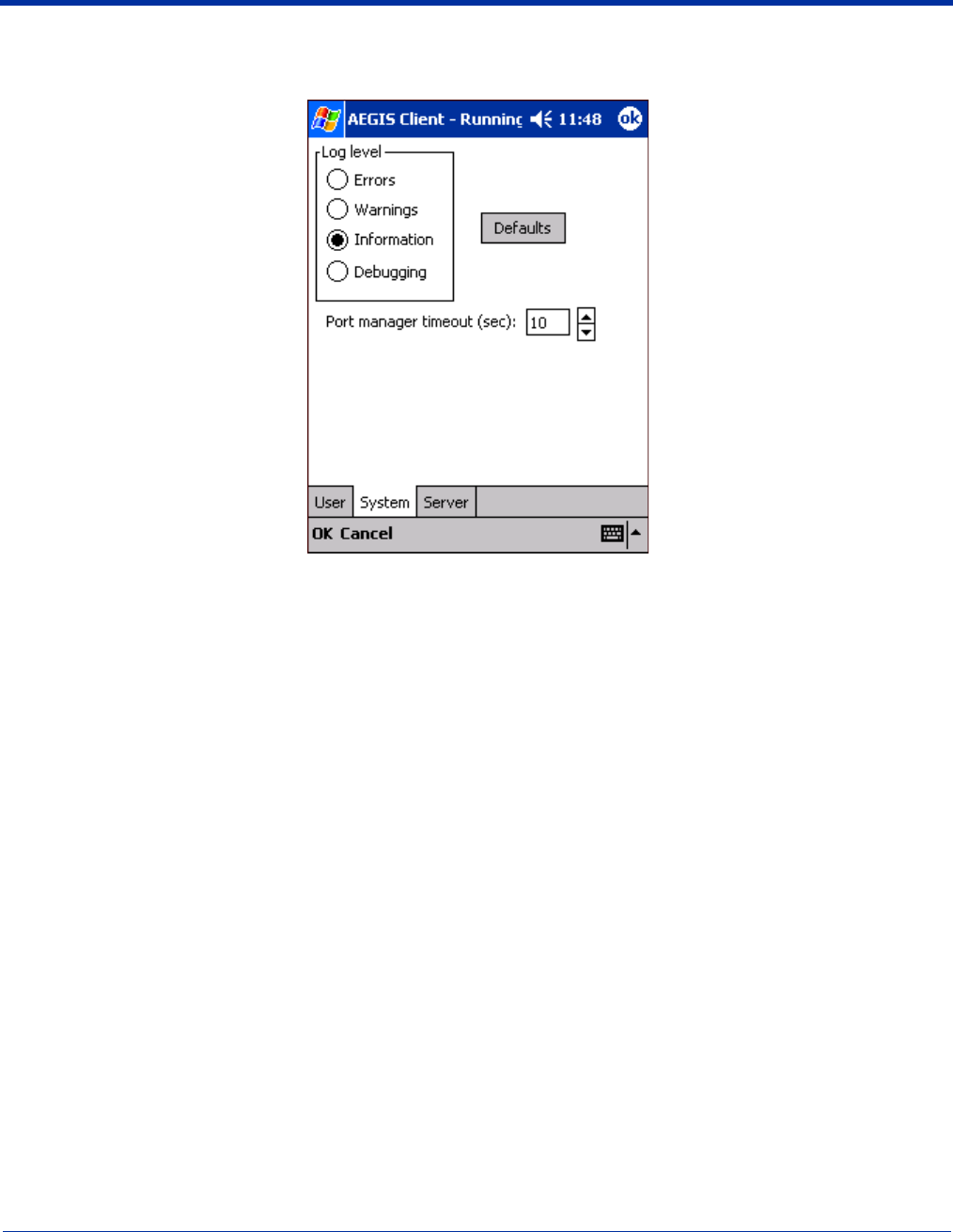
7 - 20 Dolphin® 9500/9550 Mobile Computer User’s Guide - GSM Draft
System Settings Tab
The System Settings tab controls logging and the port manger timeout period.
Log Level These settings control the detail of the log messages generated by the AEGIS Client. By default, all
errors, warnings, and information events are logged. Each entry records a severity code (of one
[debug message] to four [error] asterisks), a time stamp, and a message.
Logs fill memory quickly, especially if the Debugging level is chosen. Do not use the Debugging option
for a significant length of time because most internal operations generate messages.
Port Manager Timeout The interval at which the client polls the ports. This is used under different circumstances, for instance
after physical changes such as card removal or insertion have been detected. This value should not
be changed from the 10-second default unless so advised by Meetinghouse technical support.
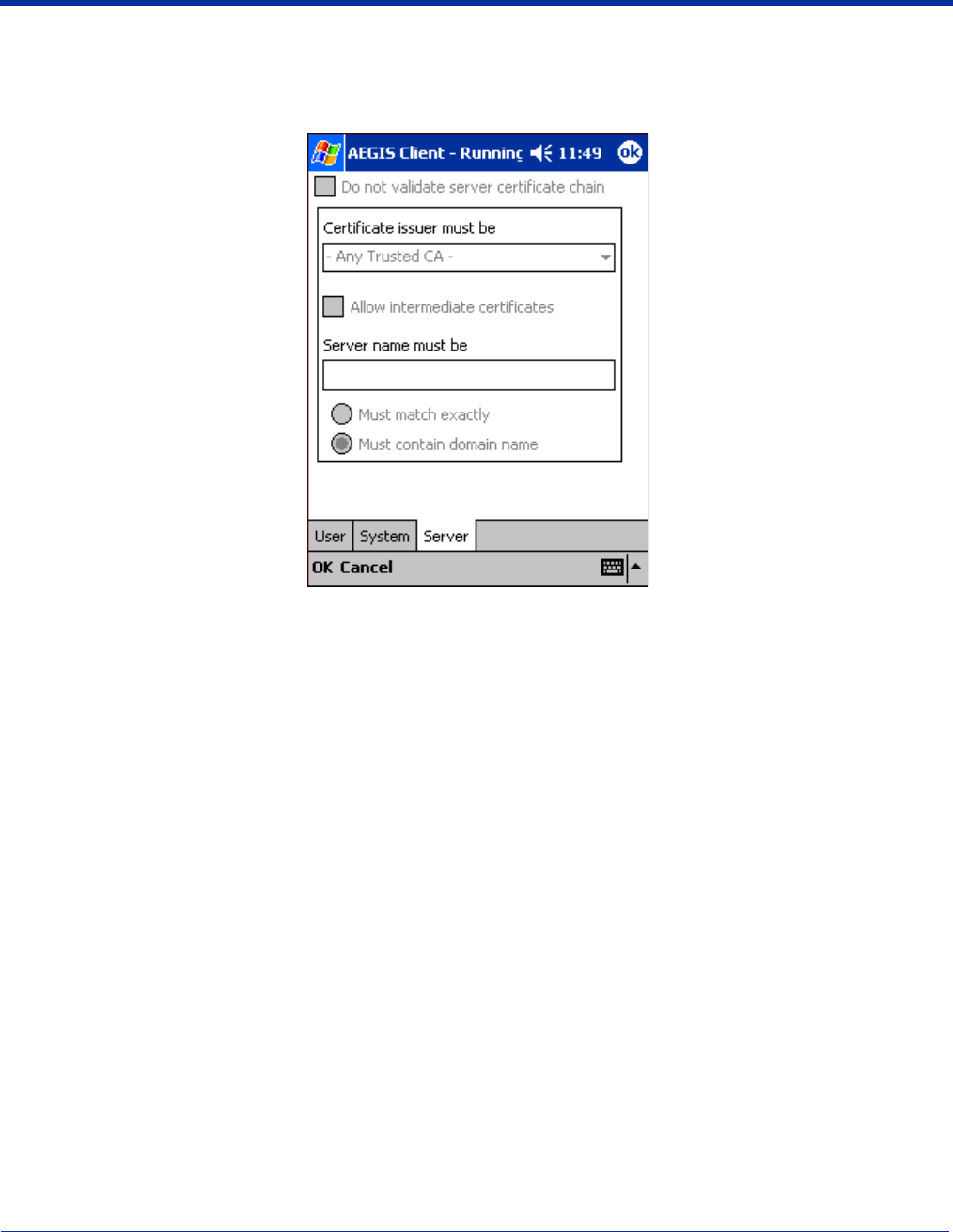
Dolphin® 9500/9550 Mobile Computer User’s Guide - GSM Draft 7 - 21
Server Identity Tab
The Server identity tab defines the credentials the client uses to authenticate the server during TLS/TTLS/PEAP authentication
message exchange. AEGIS Client uses the information entered on this screen to verify that the Client is communicating with a
trusted server.
Do not validate server certificate chain
When the server certificate is received during the TLS/TTLS/PEAP message exchange, it is not
validated.
Certificate issuer must be
The server certificate received during TLS/TTLS/PEAP message exchange must be issued by the
certificate authority selected in this field. Both trusted intermediate certificate authorities and root
authorities whose certificates exist in the system store are available for selection in the drop-down
list. If Any Trusted CA is selected, any Certificate Authority (CA) in the drop-down list can be used
during authentication.
Allow intermediate certificates
Selecting this option enables a number of unspecified certificates to be in the server certificate chain
between the server certificate and the certificate authority indicated in the Certificate issuer must
be field. This allows the server certificate received during negotiation to be issued directly by the
certificate authority indicated in the Certificate issuer must be field or by one of its intermediate
certificate authorities. If disabled, then the selected Certificate issuer must be must have directly
issued the server certificate.
Server name must be The server name, or a domain to which the server belongs, depending on which of the two fields
below has been checked.
Must match exactly When activated, the server name entered must match exactly the server name found on the
certificate.
Must contain domain name
When activated, the server name field identifies a domain and the certificate must have a server name
belonging to this domain or to one of its sub-domains (e.g., zeelans.com, where the server is
blueberry.zeelans.com).
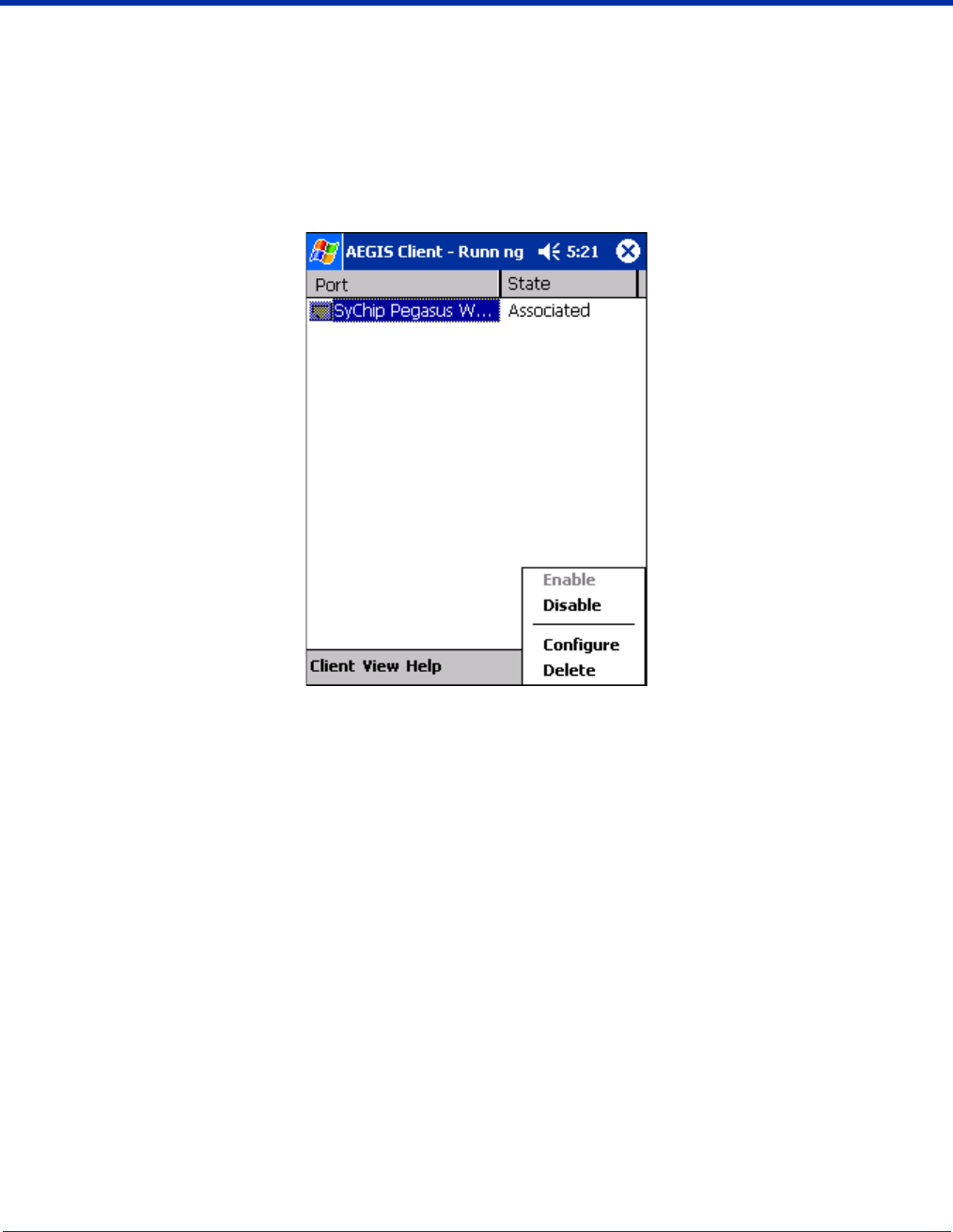
7 - 22 Dolphin® 9500/9550 Mobile Computer User’s Guide - GSM Draft
Port Setting Menus
To see or manage the wireless cards or Ethernet NICs controlled by the Client, go to Start > Programs > Meetinghouse AEGIS
Client. The Main menu contains a list of wireless and NIC adapters (ports). Tapping a port brings up a menu that allows the port
to be enabled or disabled, configured, or deleted.
Two menus are available from this screen: the Port menu and the Client menu.
Port Menu
To open the Port menu, tap and hold on a port on the main screen.
These commands allow the port to use 802.1X authentication, change the port configuration, and remove it from the port list. The
Port menu commands are:
Enable and Disable These commands enable or disable 802.1X authentication on the port. The port itself is not turned off
or on; to do that, use the Windows Network Connections control panel.
Configure Opens the port configuration screen.
Delete Removes an adapter from the port list. When the 802.1X protocol binds to an adapter, it is added to
the port list. This usually happens when the adapter is in the device and the Client software is
installed, or Install Protocol is selected from the Client menu.
i
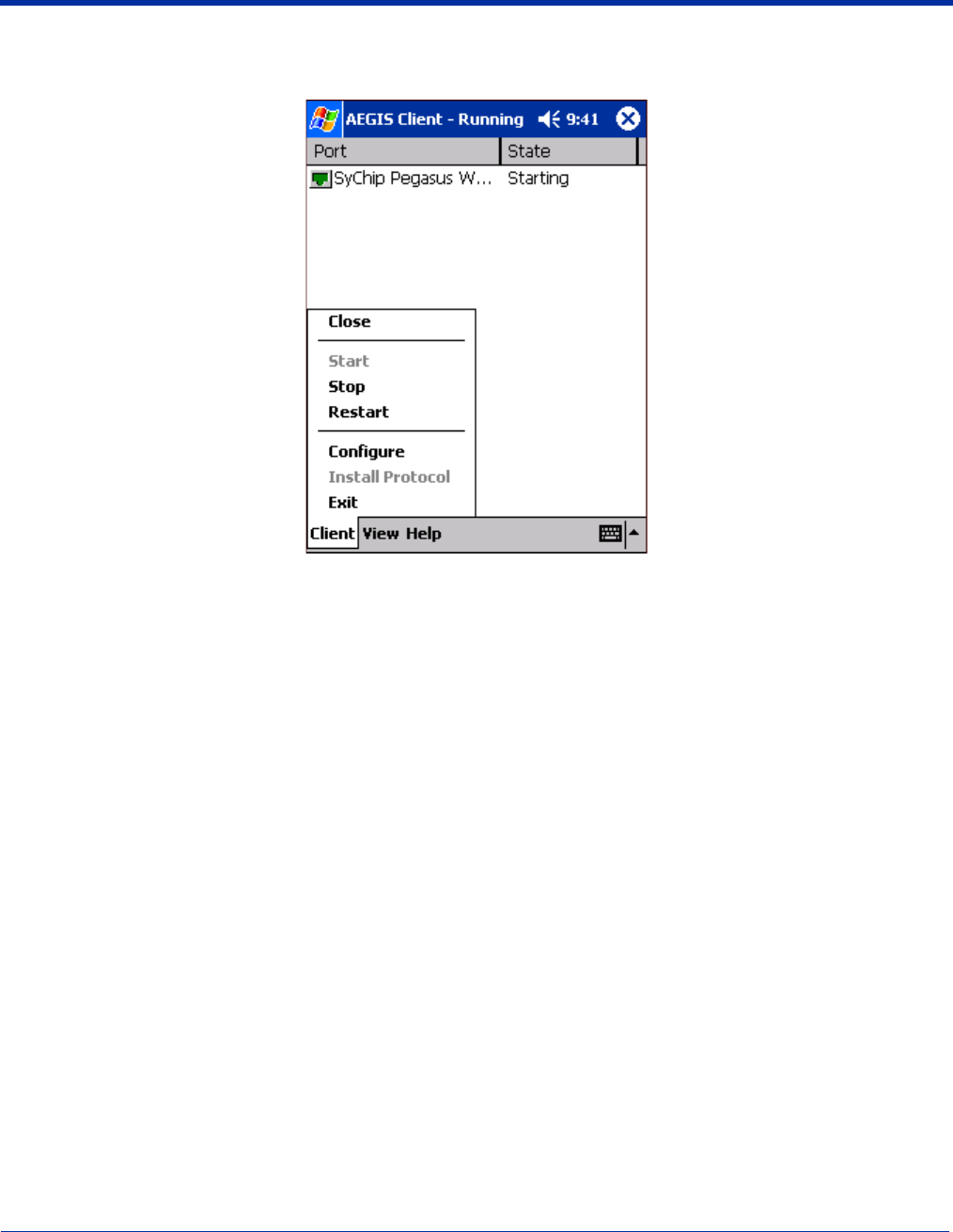
Dolphin® 9500/9550 Mobile Computer User’s Guide - GSM Draft 7 - 23
Client Menu
To open the client menu, tap Client in the command bar along the bottom of the window.
Close Closes the Client's interface, while leaving the client running.
Start/Stop Starts or stops 802.1X authentication.
Restart Same as a Stop followed by Start.
Configure Opens the Configuration screen displaying the User tab.
Install Protocol Selecting this option binds the 802.1X protocol to the WLAN adapter currently installed on the device.
The WLAN adapter then appears in the port list. For more information about network adapters, see
Network Adapters on page 5-28.
Exit Terminates the client, which stops the 802.1X protocol.
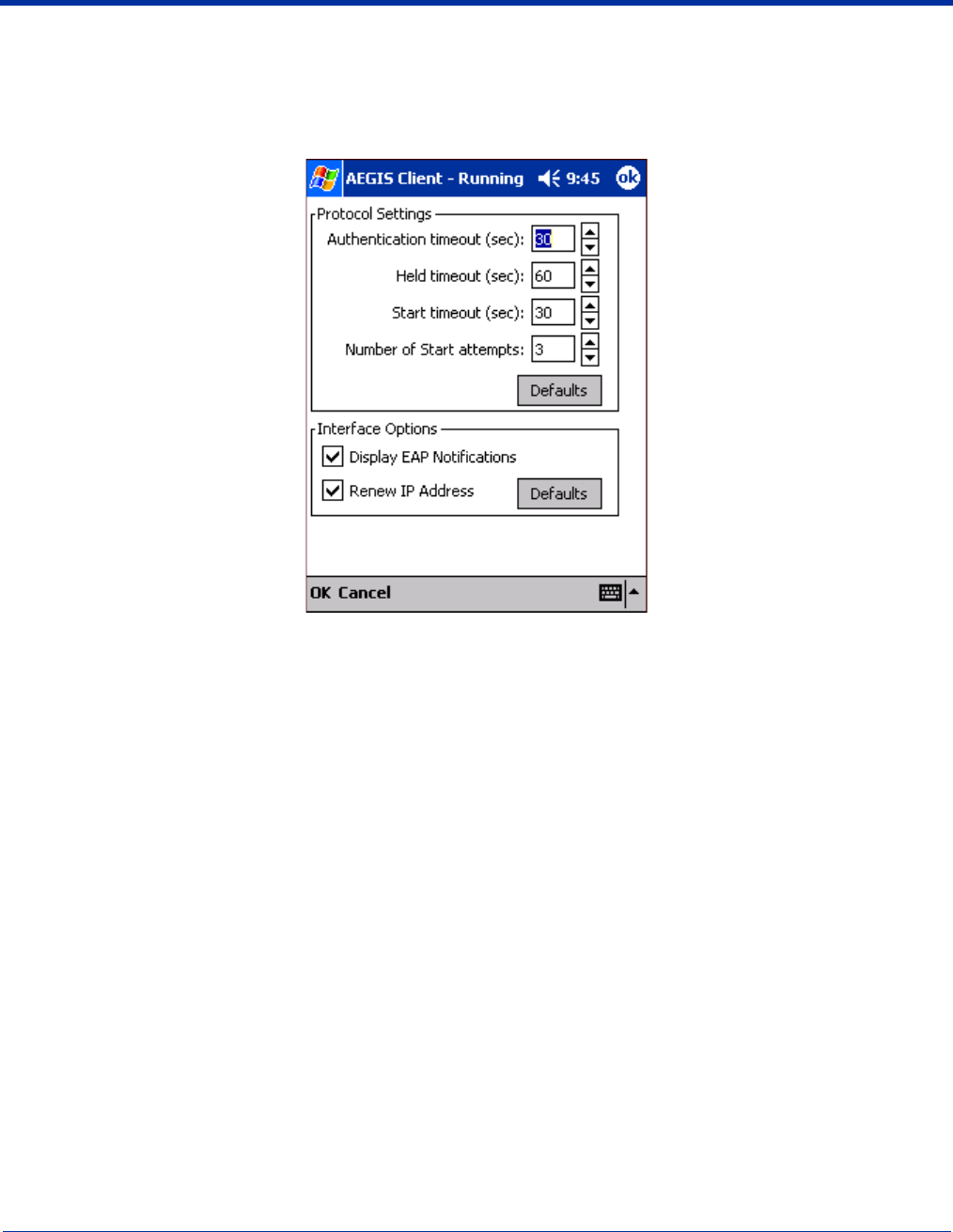
7 - 24 Dolphin® 9500/9550 Mobile Computer User’s Guide - GSM Draft
Port Setting Parameters
Port settings parameters rarely need to be modified from their defaults. In most cases, you should modify these settings only if
advised to by technical support. Port Settings are global to all ports.
To open the Port Settings screen, select any adapter in the port list, tap and hold, then select Configure on the Port menu. The
Port Settings screen is displayed.
Protocol Settings These are the timer intervals and retry settings defined in the 802.1X standard supplicant protocol
specification. They determine how long the supplicant state machine will wait in a given state. These
parameters shouldn’t be modified without an understanding of the supplicant state machine. For more
information about the supplicant state machine, obtain its 802.1X protocol specification.
The parameters are:
•Authentication Timeout. The period of time the Client remains in the authenticating or acquired state without
receiving a response from the access point or switch.
•Held Timeout. The period of time the Client remains in the held state after failing authentication.
•Start Timeout. The period of time the Client remains in the connecting state before restarting when there is no
response.
•Number of Start Attempts. The number of times the Client restarts before giving up. At that point, the Client then
defaults to the authenticated state, but there will be no network connectivity because the protocol exchange was never
completed.
The Interface Options are:
Display EAP notifications
This specifies that the EAPOL notification message will be displayed to the user. An authenticator
may use such notification to inform you, for example, about a near password expiration. However,
some authenticators send chatty and annoying notifications that may, for the convenience of the user,
be suppressed. Note that all notifications are written to the event log even if they are not displayed.
Renew IP address With this option enabled, the Client initiates a DHCP request to obtain a dynamic IP address after a
successful authentication, but only if the client detects that the connected network (the SSID) has
changed. The result is that renewal should not occur upon reauthentication, but does occur at boot
or when connecting to a different network. If you have a slow authenticator, you may wish to enable
this option when configuring the service because the slow authenticator may prevent you from getting
a DHCP-assigned IP address upon boot-up. This option is ignored if the given adapter has a static IP
address.
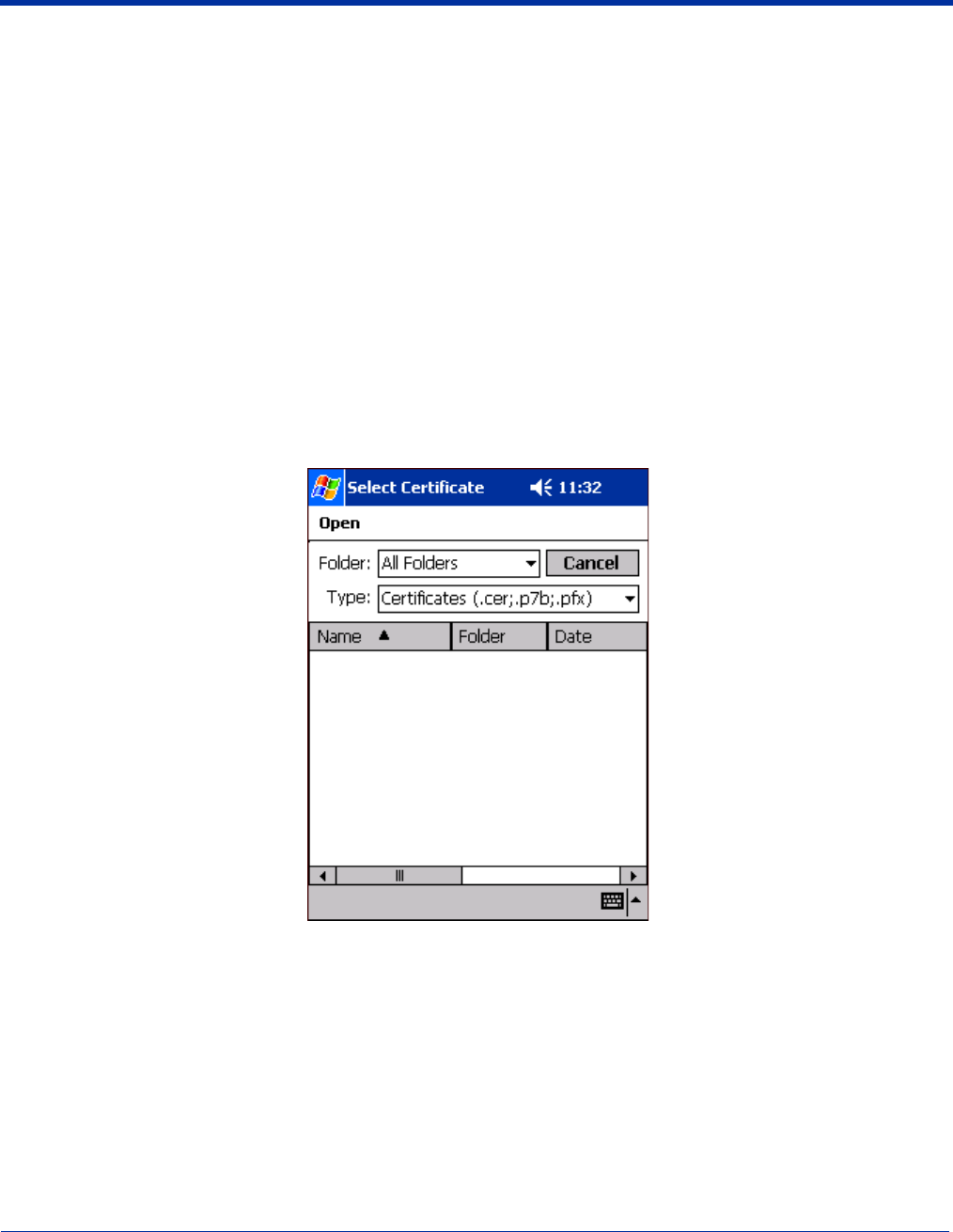
Dolphin® 9500/9550 Mobile Computer User’s Guide - GSM Draft 7 - 25
Certificate Management
During configuration, you may have specified one or two certificates to use during the authentication process. The specified
identity should match the Issued to field in the certificate and should be registered on the authentication server (i.e., RADIUS
server) that is used by the authenticator. In addition, your certificate must be valid on the authentication server. This requirement
depends on the authentication server and generally means that the authentication server must know the issuer of your certificate
as a trusted Certificate Authority.
If the selected certificate does require a password or pass phrase to decode the private key, enter this value in the “Certificate
Pass Phrase” field. This value will be encrypted when the configuration is saved.
However, on some systems, there may not be a certificate. If that is the case, you can use the section below as a primer on OS
X certificate management.
Installing Certificates with CertAdd
Pocket PC doesn’t have a native certificate store. The CertAdd utility is supplied with the AEGIS Client to select and install
certificates on a Pocket PC device. Client or Certificate Authority certificates can be imported from .cer (same as .der), .p7b, or
.pfx files.
To install certificates on a Pocket PC device:
1. Download the certificate to the device.The location isn’t critical, although you may want to create a standard folder for
consistency.
2. Go to Start > Programs > Meetinghouse Certificates. The opening screen is displayed.
3. In the Folder drop-down list, select the folder containing the certificate(s). Any files of the valid file types in the selected folder
are listed in the lower pane of the CertAdd screen.
4. Select a certificate from the list. A pop-up will ask if you want to install the certificate.
5. Tap OK. The certificate is loaded in the correct certificate store.

7 - 26 Dolphin® 9500/9550 Mobile Computer User’s Guide - GSM Draft
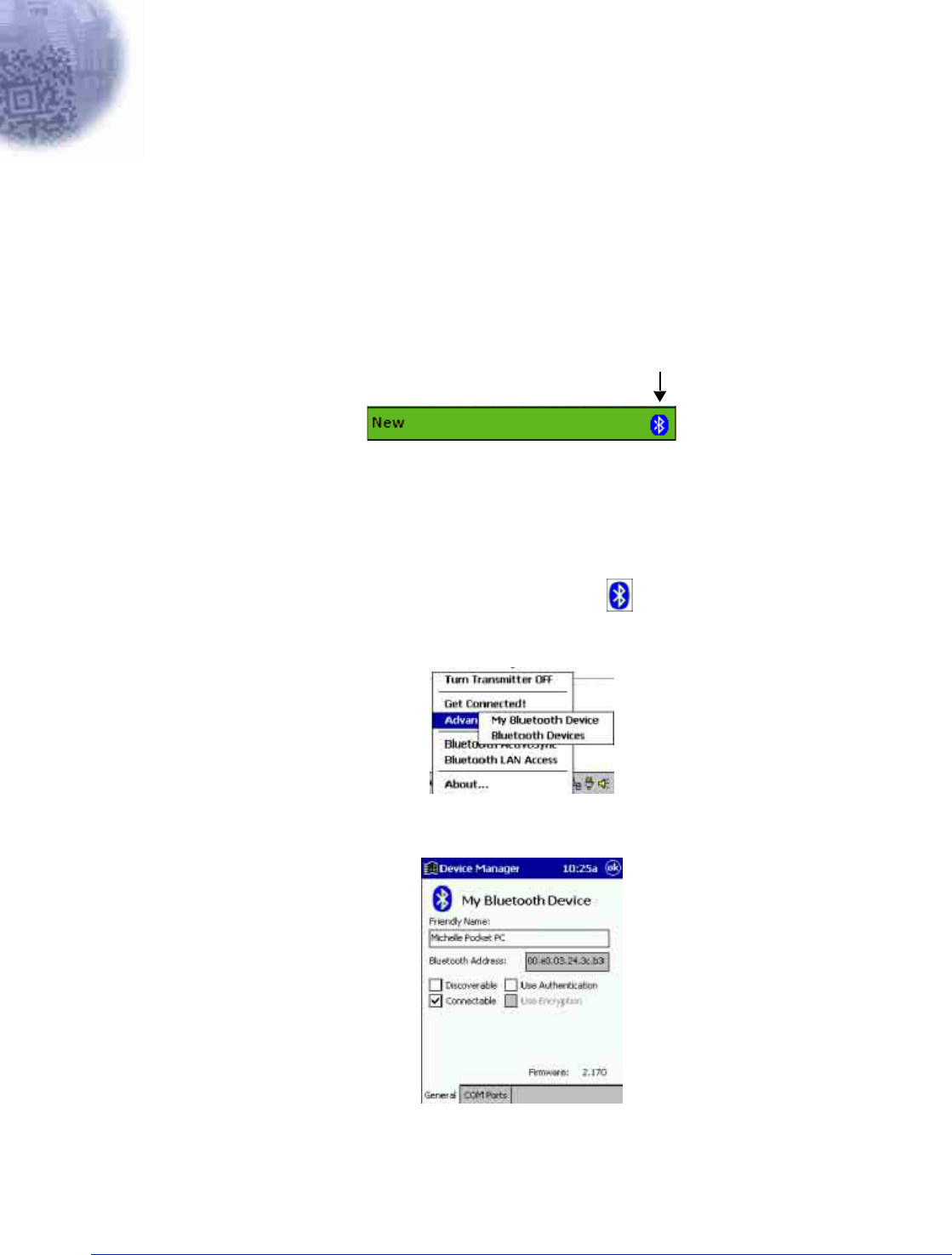
Dolphin® 9500/9550 Mobile Computer User’s Guide - GSM Draft 8 - 1
8
Wireless PAN Communications with Bluetooth
Overview
Dolphin 9500/9550 terminals are available with a Bluetooth radio for (Wireless Personal Area Network) WPAN usage. When the
mobile computer is first initialized, the *.cab file and module for Bluetooth are installed.
Powering Up the Bluetooth Radio Driver
Before using the radio, make sure that the Bluetooth radio is powered up. When the radio driver is powered up, the Bluetooth
icon appears in the task tray on the Today screen.
Radios are powered up in the Radio Manager utility; see Powering Up a Radio on page 4-19.
Setting Up Your Bluetooth Card
Note: If you use the Get Connected! Wizard, which is recommended for normal usage, then this step is not necessary. This step
would be used to change the friendly name of your mobile computer.
1. Tap the Bluetooth icon that appears in the task tray on the Today screen .
If you installed OBEX, the menu also lists Transfer via Bluetooth.
2. In the pop-up menu, select Advanced Features, then My Bluetooth Device.
3. In the My Bluetooth Device screen, you can modify the Friendly Name and make any desired configuration changes.
When done, tap OK.
• In normal phone connect operation, Discoverable mode is not needed and should be disabled.
• If you do enable Discoverable mode (e.g., for ActiveSync), note that it does not shut off by itself. To save power, remember
to disable it when not needed.
•Connectable, Use Authentication, and Use Encryption are also not required for printing or dial-up networking applications.
• Check Use Authentication to enable the Use Encryption option.
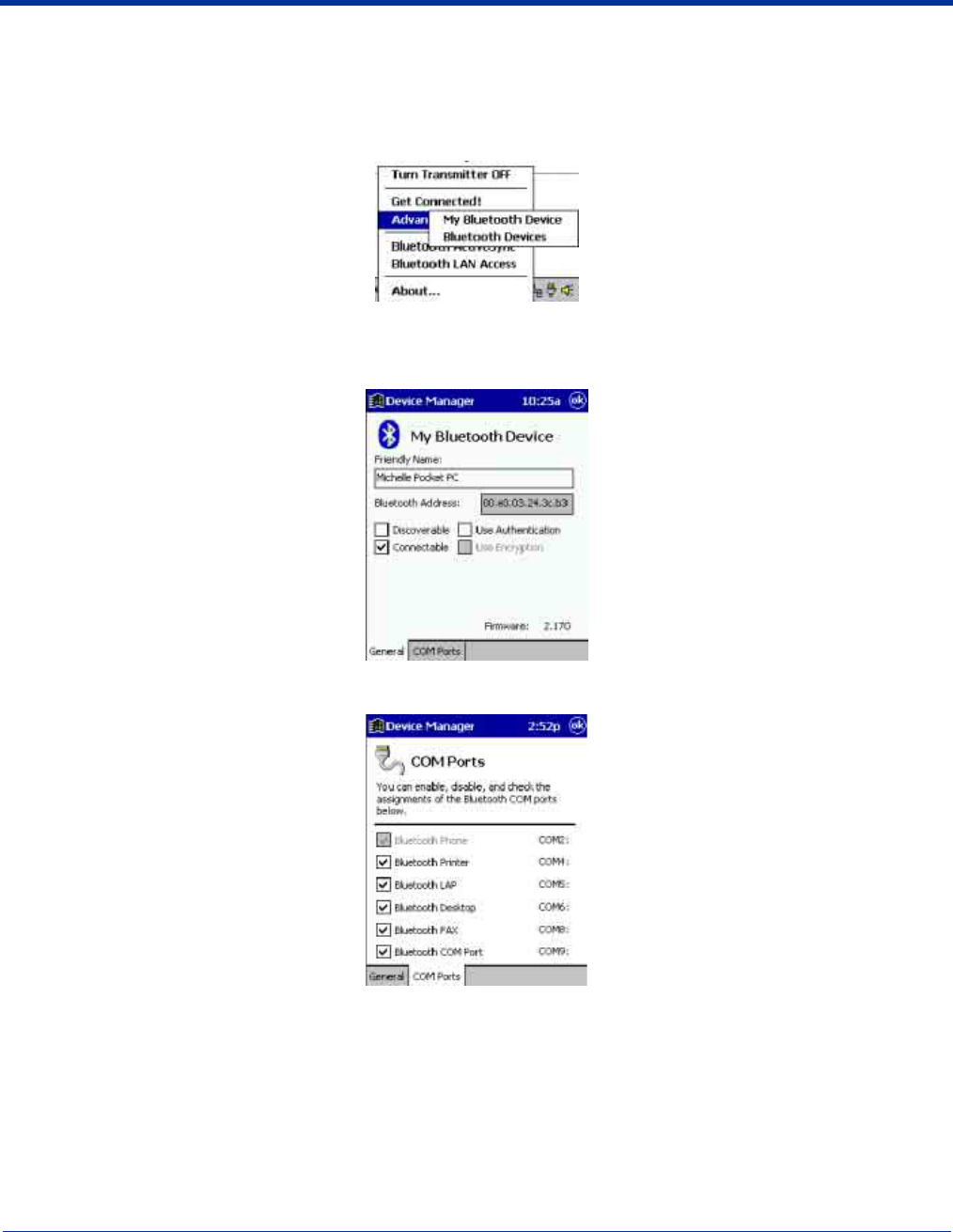
8 - 2 Dolphin® 9500/9550 Mobile Computer User’s Guide - GSM Draft
Assign COM Ports
Follow these steps to view and/or modify the Bluetooth COM ports. If you are not going to use the IrDA port, you can disable it
to free up a port for Bluetooth devices; see IrDA Config on page 5-7.
1. Tap on the Bluetooth icon on the Today screen. Select Advanced Features then My Bluetooth Device.
Note: If you installed OBEX, the menu also lists Transfer via Bluetooth.
2. The My Bluetooth Device screen appears. Tap on the COM Ports tab.
3. As needed, view and/or enable/disable the Bluetooth COM port assignments. Tap OK.
Note: The Bluetooth Phone port cannot be disabled. For more information about COM ports, see the Com Port Assignment
Table on page A-12.
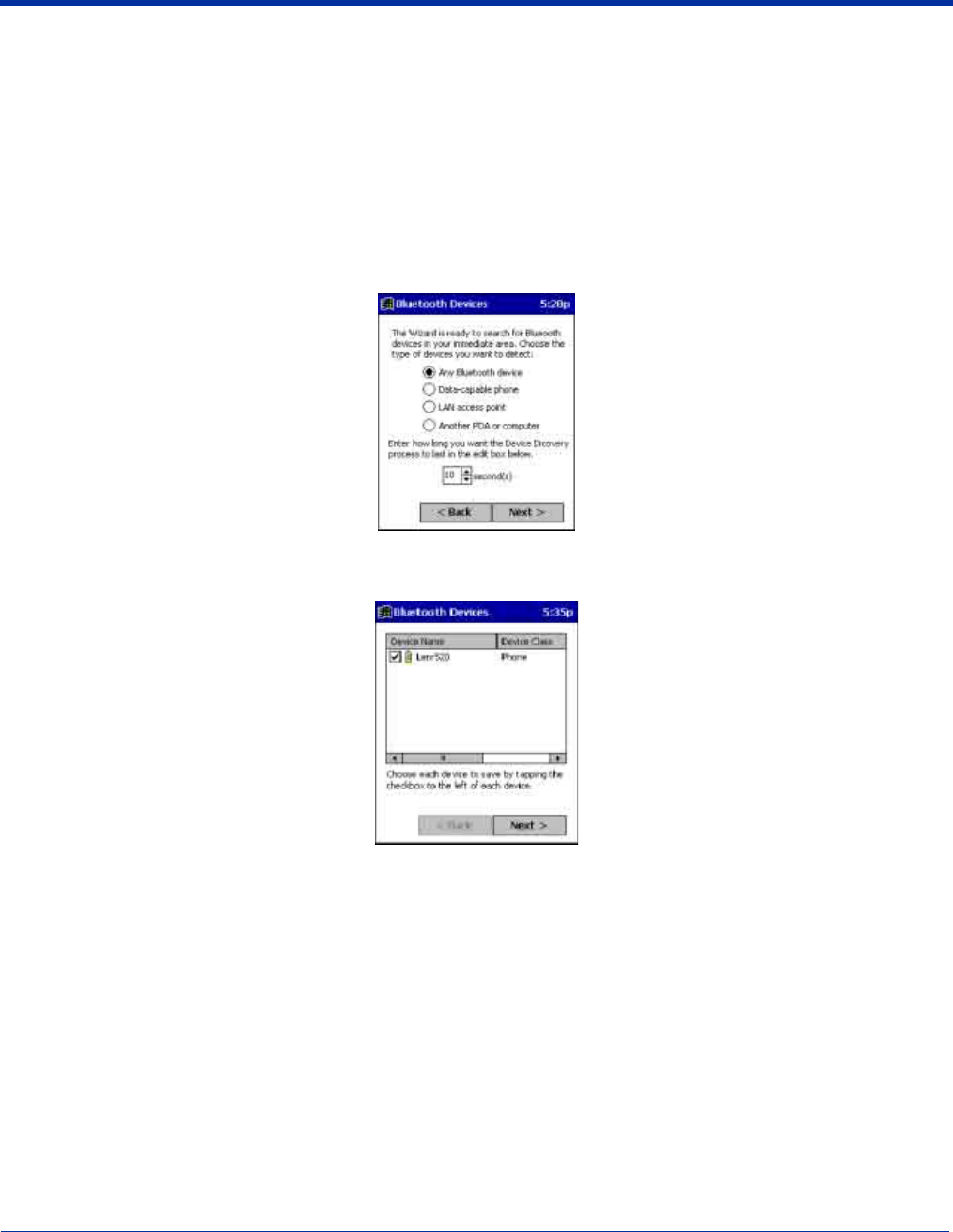
Dolphin® 9500/9550 Mobile Computer User’s Guide - GSM Draft 8 - 3
Discover Bluetooth Device(s)
Follow these steps to discover other Bluetooth devices nearby, including non-phone devices. The Device Discovery Wizard is a
more detailed alternative to using the Bluetooth “Get Connected!” Wizard or Bluetooth ActiveSync or Bluetooth LAN Access
options. The Device Discovery Wizard allows you to discover any type of Bluetooth device.
1. If not open, launch the Bluetooth Devices folder. Tap on the Bluetooth icon on the Today screen. Select Advanced
Features then Bluetooth Devices.
2. In the Bluetooth Devices Folder, tap on the Device Discovery icon. Or you can tap on Tools. In the pop-up menu, select
Device Discovery.
3. Follow the Bluetooth Device Discovery Wizard to search for Bluetooth devices nearby. When prompted, select the device
type you seek.
4. When the search is complete, a screen reports the discovered Bluetooth devices. Check the box next to any device you wish
to save information about, (i.e., any devices you wish to connect to). Tap Next.
5. A service discovery phase begins, 5-10 seconds per chosen device.
6. In the next screen, tap Finish.
Bond With Discovered Device(s)
Follow these steps to bond with an already discovered Bluetooth device. In most cases, bonding is for establishing secure
communications with a Bluetooth-enabled phone. This is a more detailed alternative to using the Bluetooth “Get Connected!
Wizard.”
Important!
• Do not try to bond with a Motorola Timeport 270C or Nokia 6310!
• Do not use this method to bond with a printer! The third-party printing software included on the installation CD also handles
bonding.
1. If not open, launch the Bluetooth Devices folder. Tap on the Bluetooth icon in the Today screen. Select Advanced
Features, then Bluetooth Devices.
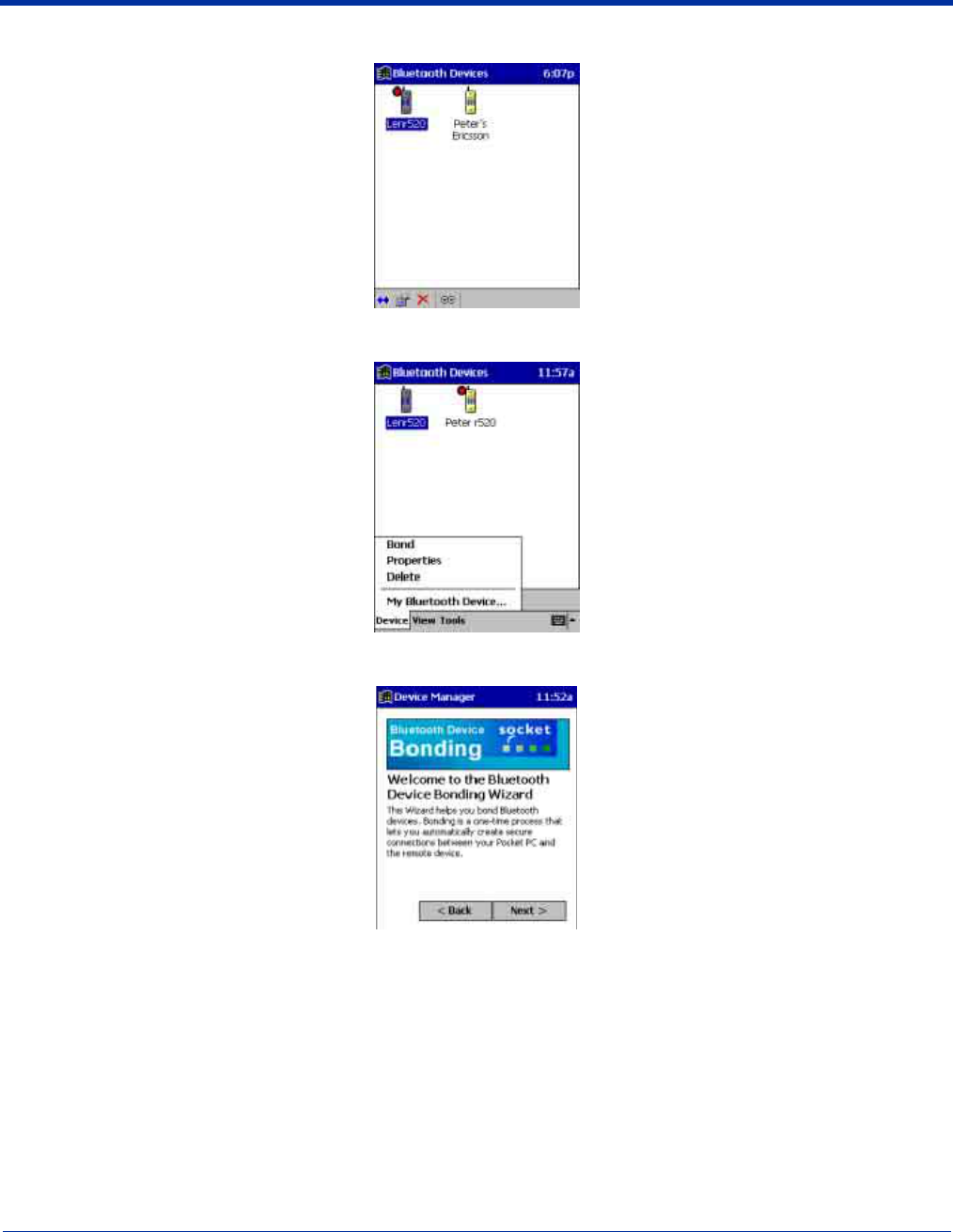
8 - 4 Dolphin® 9500/9550 Mobile Computer User’s Guide - GSM Draft
2. Tap and hold your stylus on the Bluetooth device you want to bond with. In the pop-up menu, select Bond.
3. Alternatively, after selecting a device, tap on the Bond icon. Or tap on Device, then select Bond.
4. The Bluetooth Device Bonding Wizard launches. Follow the wizard to bond with your selected device.
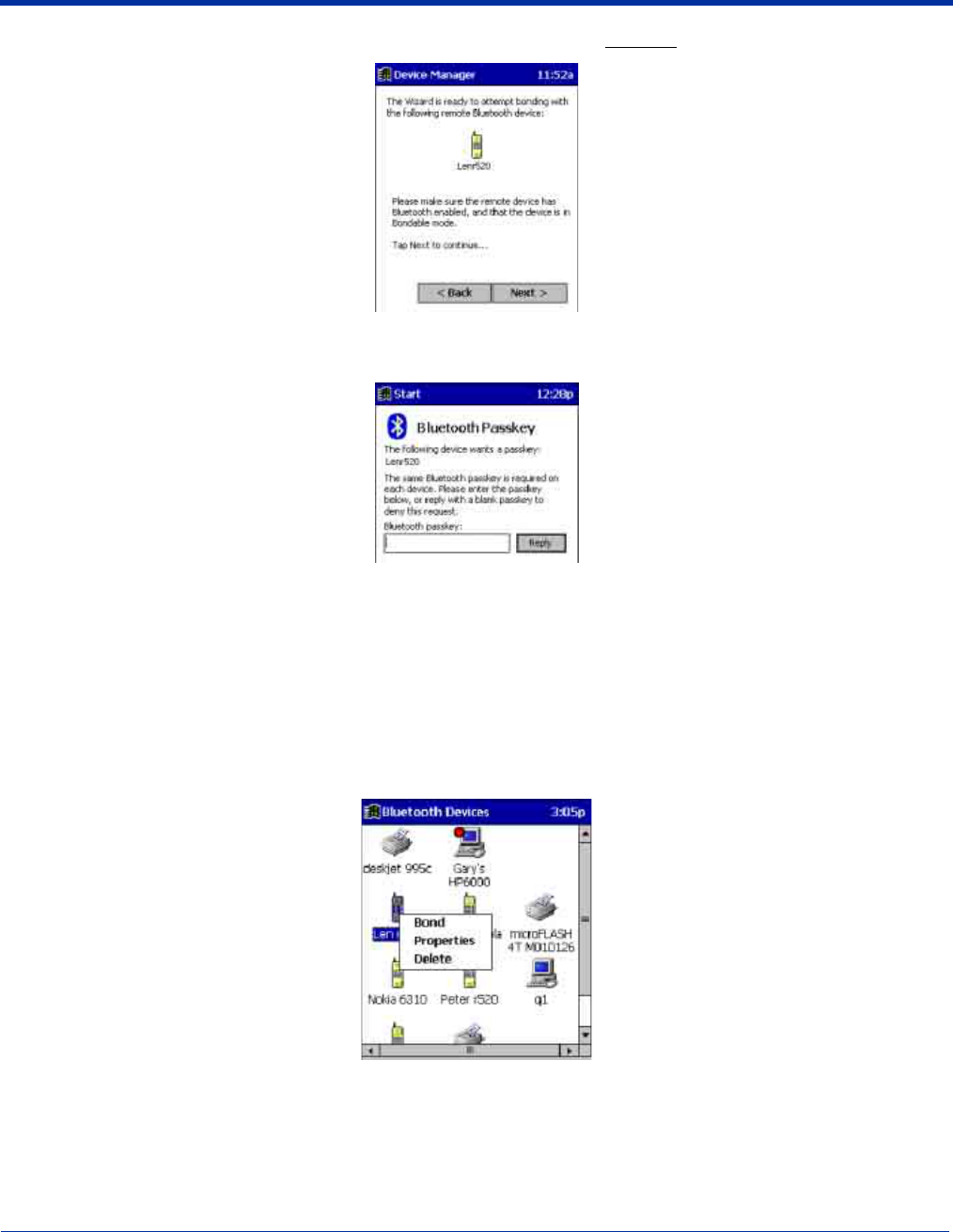
Dolphin® 9500/9550 Mobile Computer User’s Guide - GSM Draft 8 - 5
5. As prompted, make sure the Bluetooth device that you want to bond with is in Bondable mode.
6. If the remote device is set up to accept bonding, a Bluetooth Passkey screen appears. To continue bonding, enter the
correct passkey and tap Reply.
7. When you have successfully bonded with the other device, tap Finish.
View Device Properties
Follow these steps to view the properties of an already discovered device.
1. If not open, launch the Bluetooth Devices folder. Tap on the Bluetooth icon on the Today screen. Select Advanced
Features then Bluetooth Devices.
2. Select a device. Tap on the Properties icon, or tap on Device then select Properties. Alternatively, you can tap and hold
your stylus on the Bluetooth device you want to view information about. In the pop-up menu, select Properties.
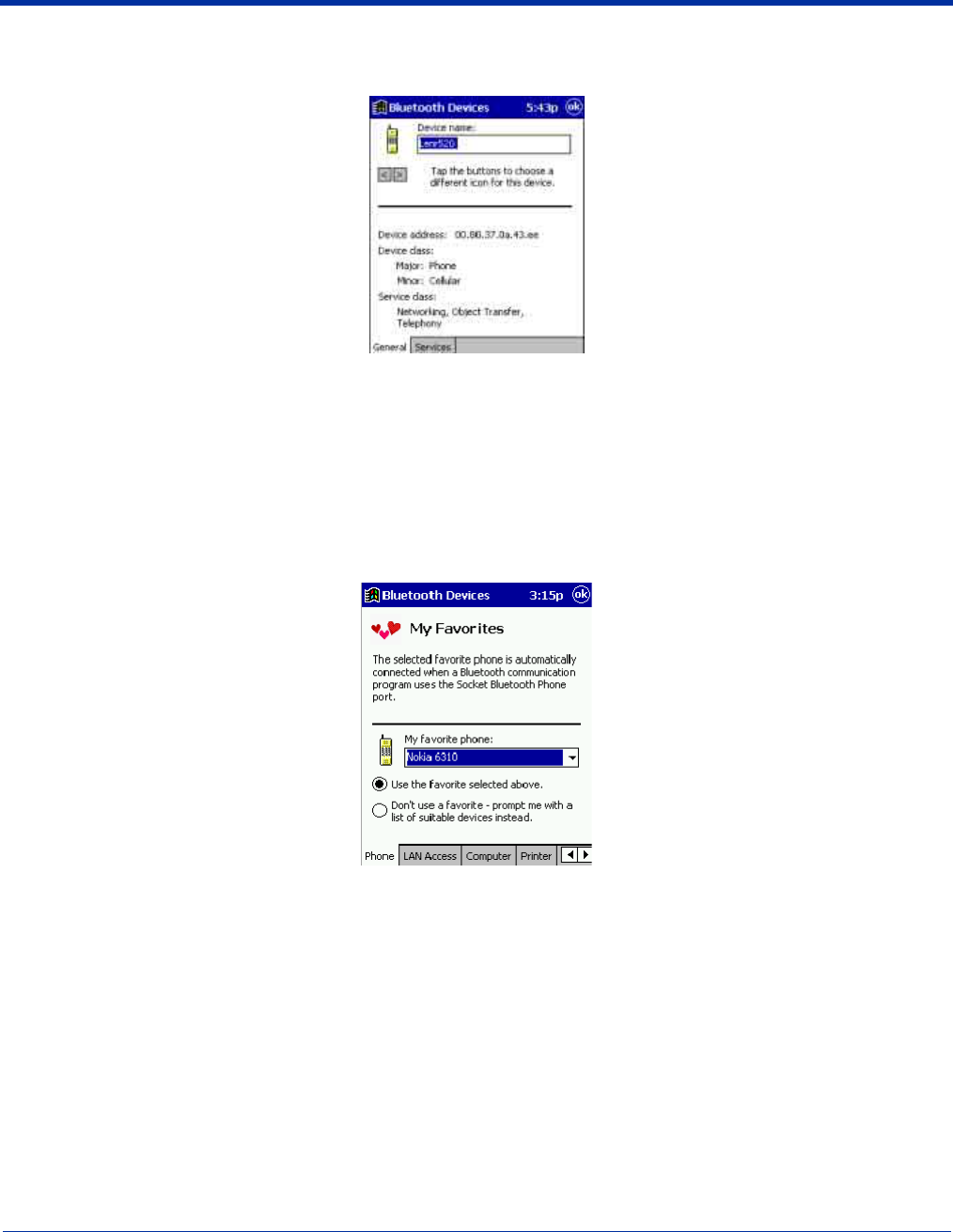
8 - 6 Dolphin® 9500/9550 Mobile Computer User’s Guide - GSM Draft
3. Use the General and Services screens to research device properties. If needed, assign a new device type icon by tapping
on the arrow buttons in the General screen. You can also use the Device name field to rename the device. When done, tap
OK for the setting to take effect.
Set Up Your Favorite Device
Follow these steps to set up default devices in the Bluetooth Devices folder. Please note that the Get Connected! Wizard
automatically assigns the favorite phone.
Complete these steps:
1. Tap on Tools and select My Favorites.
2. Tap on the tab for the type of device you would like to set a favorite for. If needed, use the arrow buttons to scroll and find the
tab you need.
Note: Tabs appears only for COM ports you have enabled. To enable a port, refer to the “Assign COM Ports” section earlier in
this chapter.
3. To select a favorite device, select Use the favorite selected above. In the drop-down list, select your device. Tap OK.
4. After setting a device as your favorite, its icon appears in the Bluetooth Devices folder with a heart next to it.
Change Views
You can switch between the Large Icons or Details views for the Bluetooth Devices folder.
1. In Bluetooth Devices, tap on View.
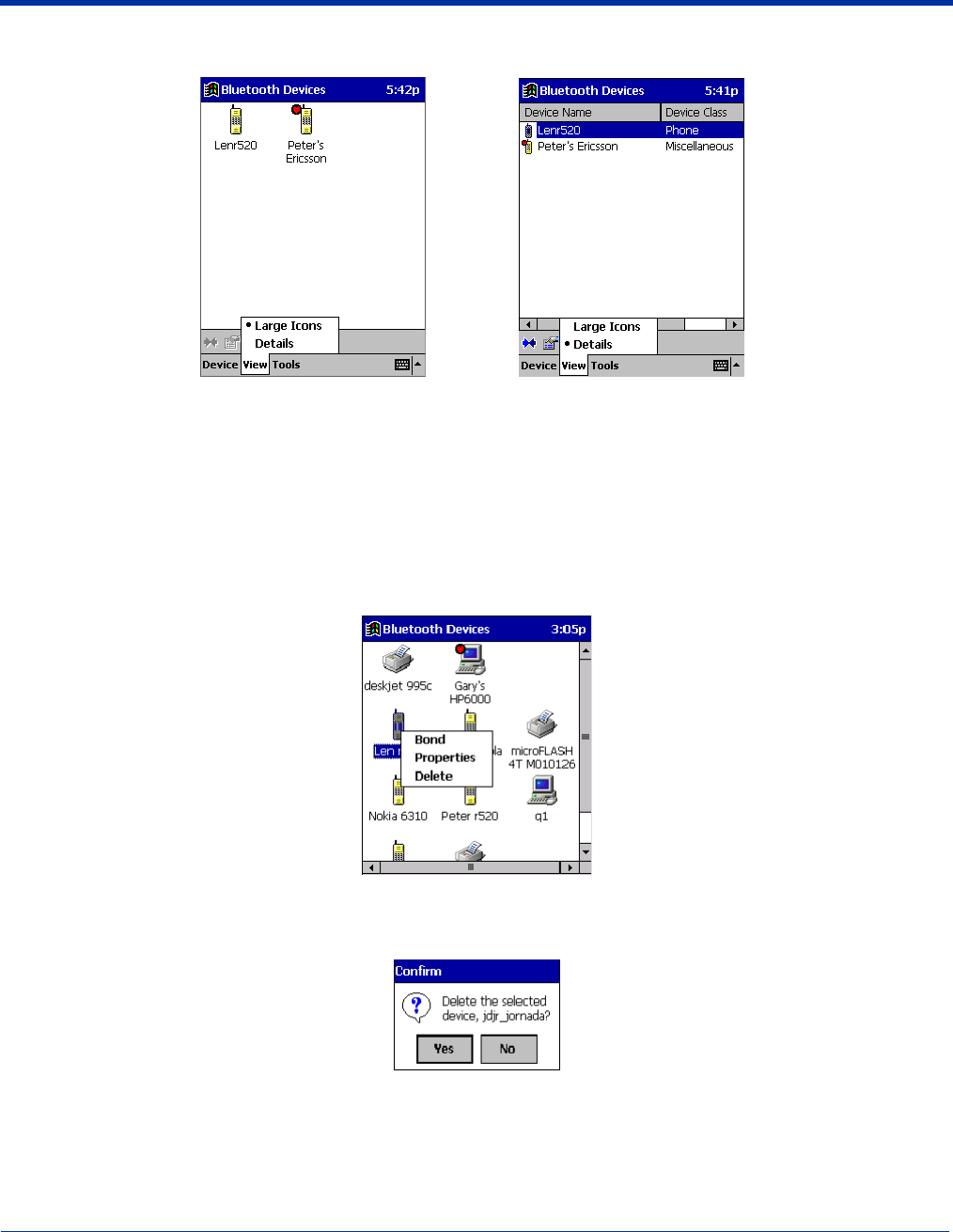
Dolphin® 9500/9550 Mobile Computer User’s Guide - GSM Draft 8 - 7
2. In the pop-up menu, choose between Large Icons or Details.
Note: In Details view, you can see the Device Class and scroll right to see the current Bonded status.
Delete a Device From the Folder
If you no longer plan to connect with it, you can delete a device from the Bluetooth Devices folder.
1. If not open, launch the Bluetooth Devices folder.
2. Tap and hold your stylus on the device you wish to delete. In the pop-up menu, select Delete.
3. Alternatively, after selecting a device, tap on the Delete icon. Or tap on Device then select Delete.
4. A Confirm screen appears. Tap Yes.
Large Icons Details
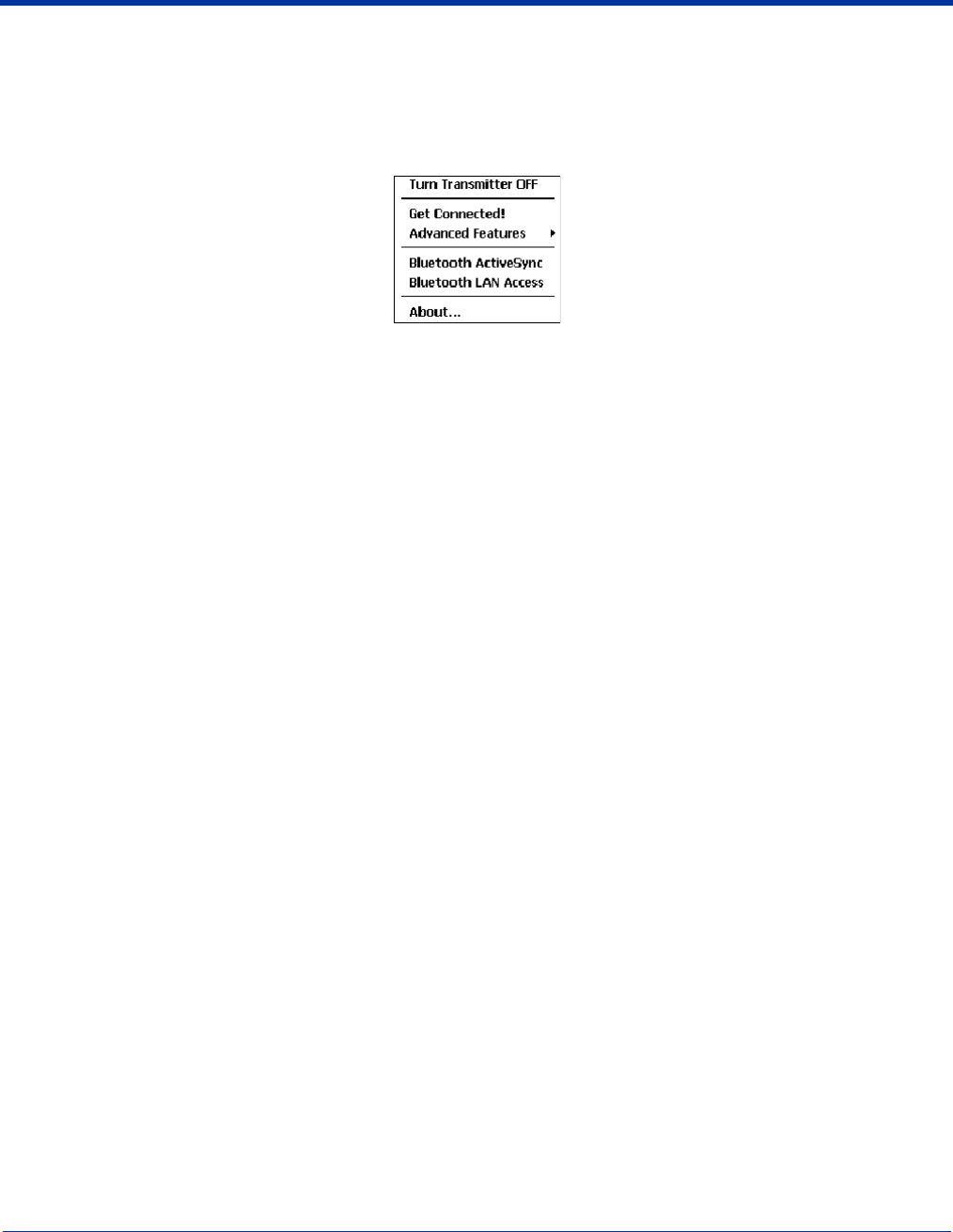
8 - 8 Dolphin® 9500/9550 Mobile Computer User’s Guide - GSM Draft
Turn Radio Transmitter ON/OFF
You may want to turn off the radio transmitter to save power or if you are entering an area with radio restrictions (e.g., an airplane).
1. The Bluetooth icon should appear in the task tray on the Today screen. Tap on the icon.
2. In the pop-up menu, select Turn Transmitter OFF.
3. The Bluetooth Card radio transmitter shuts off. The Bluetooth icon in the task tray becomes gray, as well as relevant menu
options (e.g., Get Connected!).
4. To turn the radio transmitter back on, tap on the gray Bluetooth icon. In the pop-up-menu, select Turn Transmitter ON.
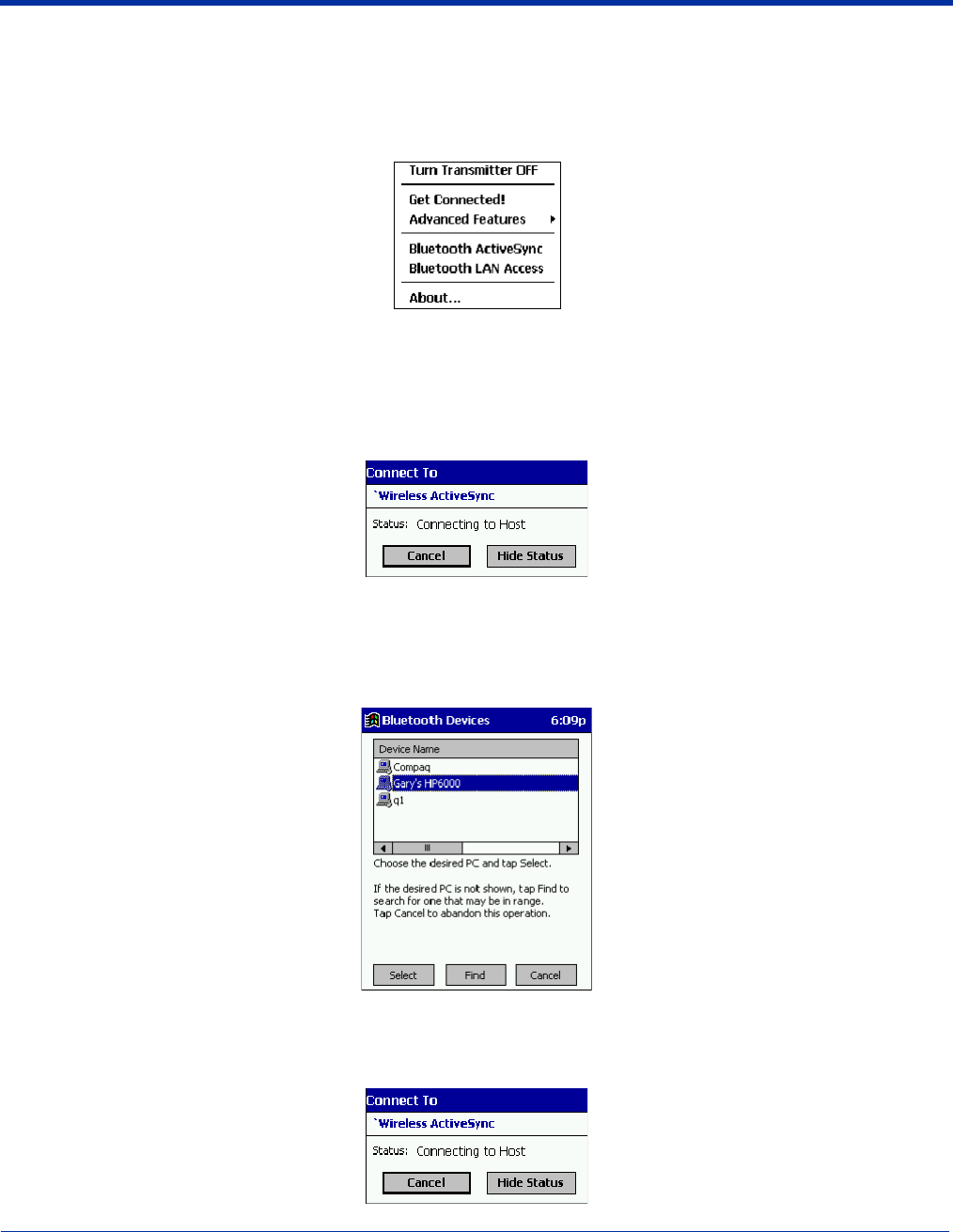
Dolphin® 9500/9550 Mobile Computer User’s Guide - GSM Draft 8 - 9
Bluetooth ActiveSync
This section explains how to use the Bluetooth ActiveSync feature. It helps you quickly and easily ActiveSync to a notebook or
desktop computer with ActiveSync v3.x installed.
1. Tap on the Bluetooth icon. In the pop-up menu, select Bluetooth ActiveSync.
2. The next screens varies depending on if your Bluetooth Devices folder contains any computers, and if one is chosen as your
favorite. Please refer to the appropriate scenario:
SCENARIO #1: Your Bluetooth Devices folder contains a favorite desktop computer.
(a) When you tap Bluetooth ActiveSync, your mobile computer automatically tries to connect to your favorite computer.
(b) The Connect To screen appears, reporting that it is trying to connect to Wireless ActiveSync.
(c) After a successful connection is made, the status screen reports Connected. Now you are ready to synchronize files, if
desired.
SCENARIO #2: Your Bluetooth Devices folder contains no favorite desktop computer.
(a) When you tap on Bluetooth ActiveSync, a screen appears that allows you to choose which computer to connect to in
your Bluetooth Devices folder. Choose a computer from the list and tap Select, or tap Find to search for another computer.
Note: If the computer you want to connect to is not listed, tap Find to begin a search. Proceed as described in Scenario #3 on
page 8-10.
(b) Your mobile computer attempts to connect to your selected computer.
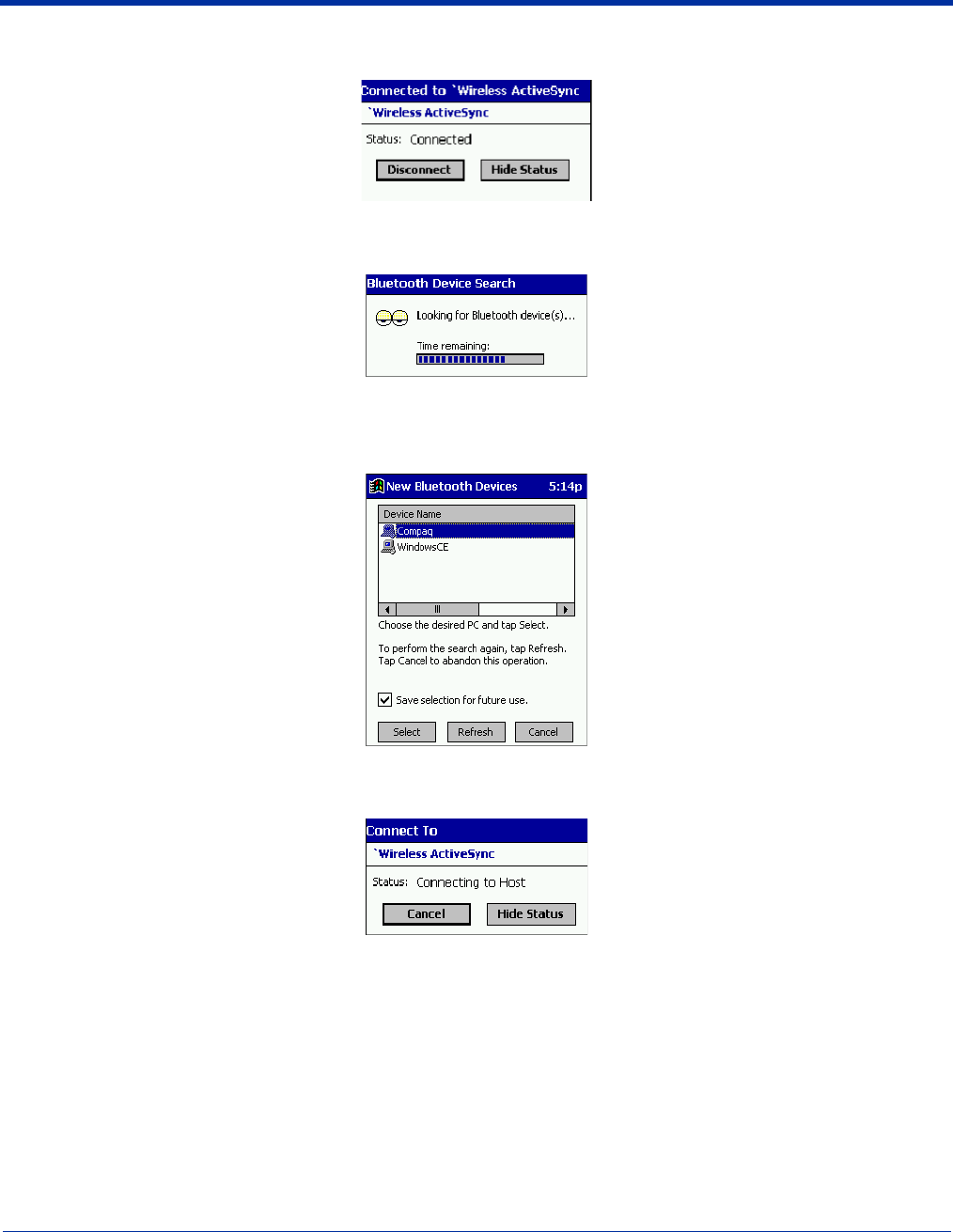
8 - 10 Dolphin® 9500/9550 Mobile Computer User’s Guide - GSM Draft
(c) After a successful connection is made, the status screen reports Connected. Now you are ready to synchronize files, if
desired.
SCENARIO #3: Your Bluetooth Devices folder contains no computers.
(a) When you tap on Bluetooth ActiveSync, a Bluetooth Device Search automatically begins.
Note: You can also start the device search by tapping Find in the Bluetooth Devices screen.
(b) After the search is complete, select the computer you wish to ActiveSync with and tap Select. If the computer is not listed,
make sure the computer id discoverable and tap Refresh to search again.
(c) After you tap Select, a service discovery phase begins.
(d) The Connect To screen appears, reporting that it is trying to connect to Wireless ActiveSync.
(e) After a successful connection is made, the status screen reports Connected. Now you are ready to synchronize, if desired.
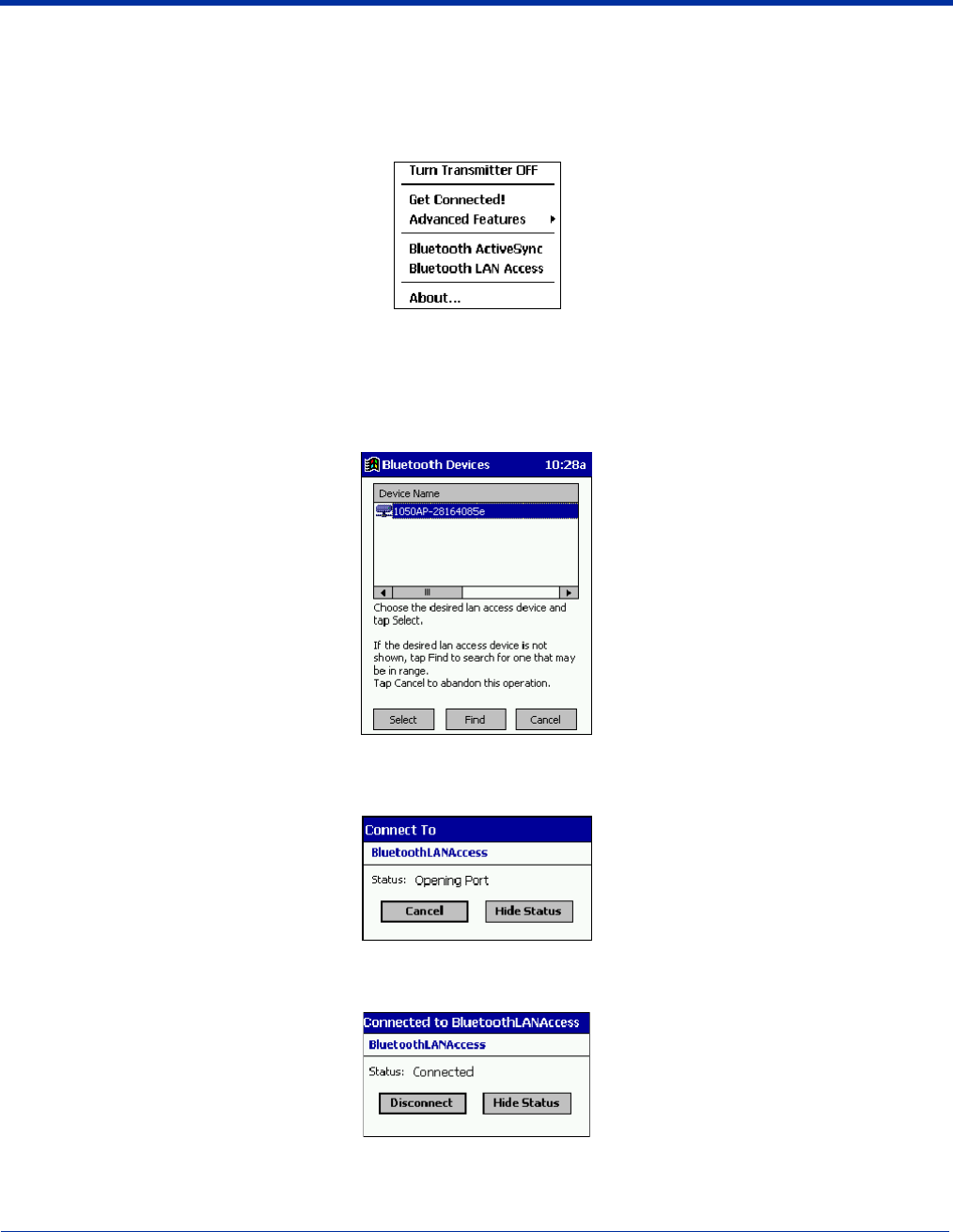
Dolphin® 9500/9550 Mobile Computer User’s Guide - GSM Draft 8 - 11
Bluetooth LAN Access
This section explains how to use the Bluetooth LAN Access feature to quickly and easily connect to a Bluetooth-enabled LAN
access point.
1. Tap on the Bluetooth icon. In the pop-up menu, select Bluetooth LAN Access.
2. The next screens varies depending on if your Bluetooth Devices folder contains any access points, and if one is chosen as
your favorite. Please refer to the appropriate scenario:
SCENARIO #1: Your Bluetooth Devices folder contains no favorite access point.
(a) When you tap Bluetooth LAN Access, a screen appears that allows you to choose which access point to connect to in
your Bluetooth Devices folder. Choose an access point from the list and tap Select.
Note: If your access point is not listed, tap Find and proceed as described in Scenario #3.
(b) Your mobile computer tries to connect to the selected access point.
(c) If your LAN requires a passkey, a screen appears asking for the passkey. Enter the passkey, then tap OK.
(d) After a successful connection is made, the status screen reports Connected.
(e) Now you are ready to access your LAN for Internet access, files, etc.
SCENARIO #2: Your Bluetooth Devices folder contains a favorite access point.
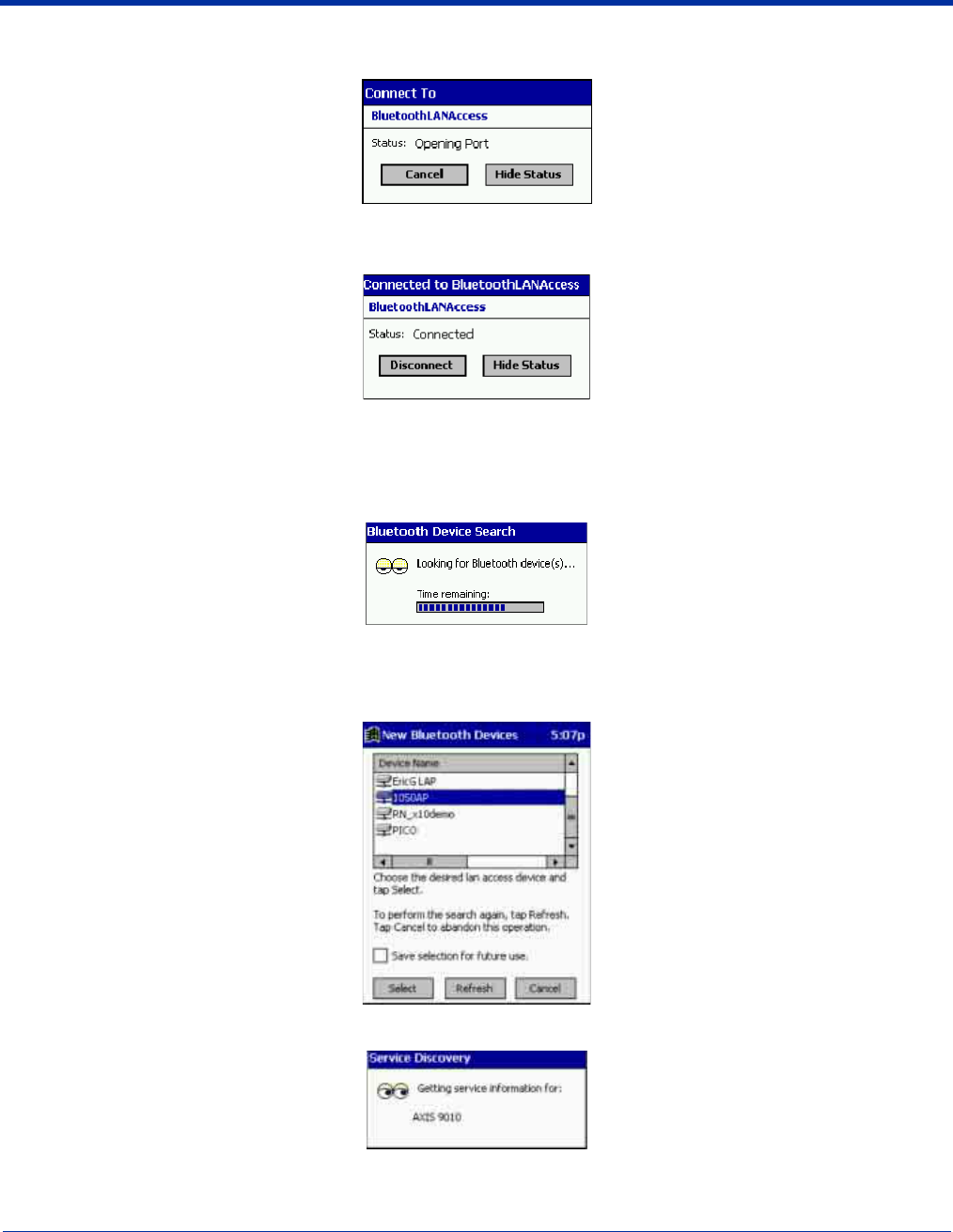
8 - 12 Dolphin® 9500/9550 Mobile Computer User’s Guide - GSM Draft
(a) When you tap Bluetooth LAN Access, your mobile computer automatically tries to connect with your favorite access
point.
(b) If your LAN requires a passkey, a screen appears, asking for the passkey. Enter the passkey, then tap OK.
(c) After a successful connection is made, the status screen reports Connected.
(d) Now you are ready to access your LAN for Internet access, files, etc.
SCENARIO #3: Your Bluetooth Devices folder has no access points.
(a) When you tap Bluetooth LAN Access, the mobile computer automatically begins to search for new Bluetooth devices.
Note: You can also start the device search by tapping Find in the Bluetooth Devices screen. See Scenario #2 on page 8-9.
(b) After the search is complete, select the access point you wish to connect to. Tap Select. If the access point is not listed,
tap Refresh to search again.
(c) After you tap Select, a service discovery phase begins.
(d) If the LAN requires a Passkey, a screen appears, asking for the Passkey. Enter the passkey, then tap OK.

Dolphin® 9500/9550 Mobile Computer User’s Guide - GSM Draft 8 - 13
(e) After a successful connection is made, the screen reports Connected.
(f) Now you are ready to access your LAN for Internet access, files, etc.
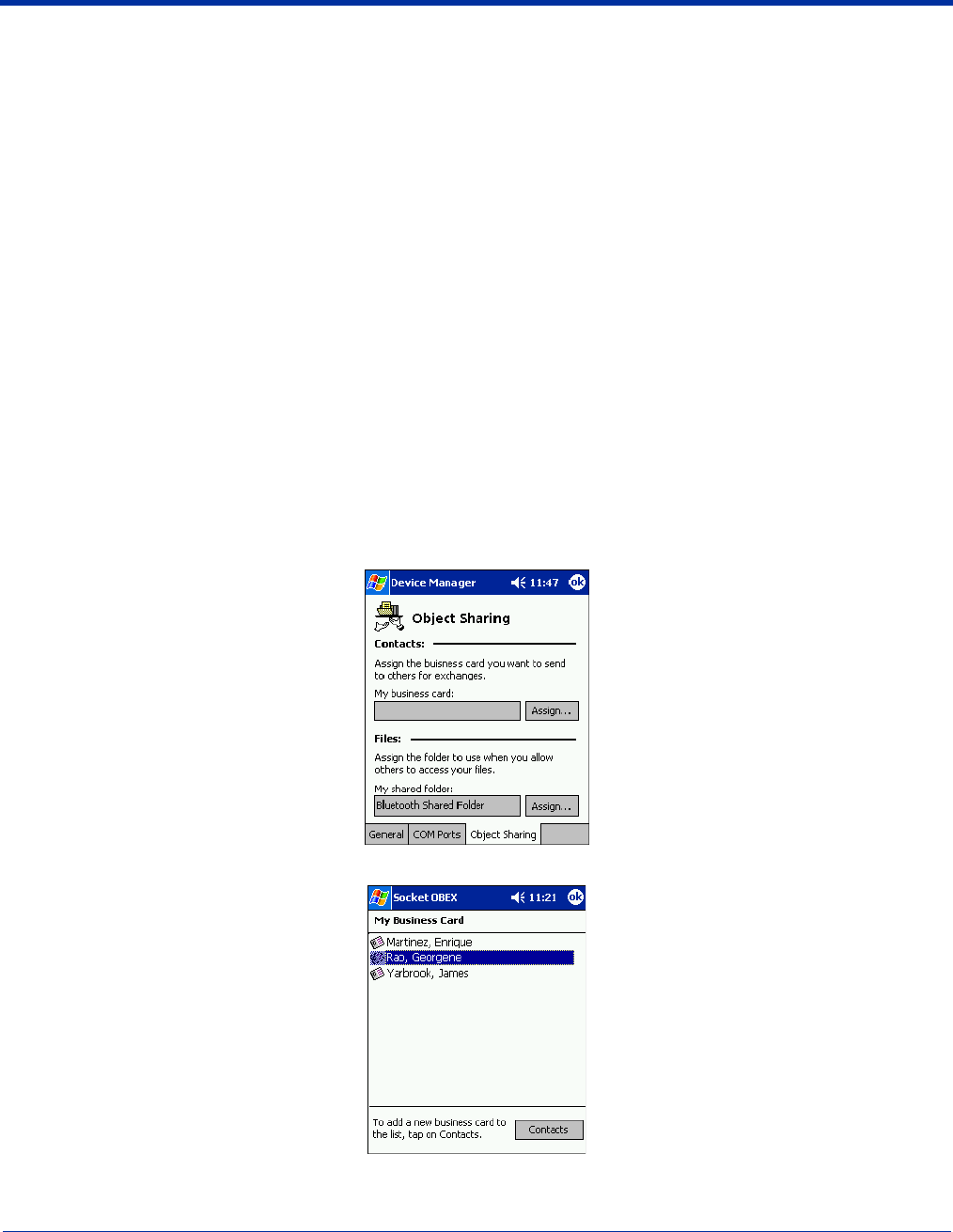
8 - 14 Dolphin® 9500/9550 Mobile Computer User’s Guide - GSM Draft
OBEX
This section explains how to use the OBEX (object exchange) application to trade business cards, contacts or files with another
Bluetooth device that supports OBEX.
Bluetooth OBEX application supports five operations:
• Exchange Business Cards
• Send a Contact
• Send a File
• Browse Remote Device
• Receive Contact or File
• Enable File Sharing
The first four operations - exchange business cards, send a contact, send a file, and browse remote device - are client-oriented.
They involve initiating an object exchange.
The last two operations - receive contact or file and enable file sharing - are server-oriented. They involve accepting objects in
an exchange initiated by another Bluetooth device.
Exchange Business Cards
1. Make sure both Bluetooth devices have a business card assigned to them.
Note: If each device does not have a business card assigned to it, you cannot exchange business cards.
To assign a business card to your mobile computer, do the following:
• Tap on the Bluetooth icon. In the pop-up menu, tap Advanced Features > My Bluetooth Device.
• Tap on the Object Sharing tab. Under My business card, tap Assign
• In the next screen, select your business card and tap OK. If your business card is not listed, tap Contacts to create one.
When you return to the Object Sharing screen, tap OK.
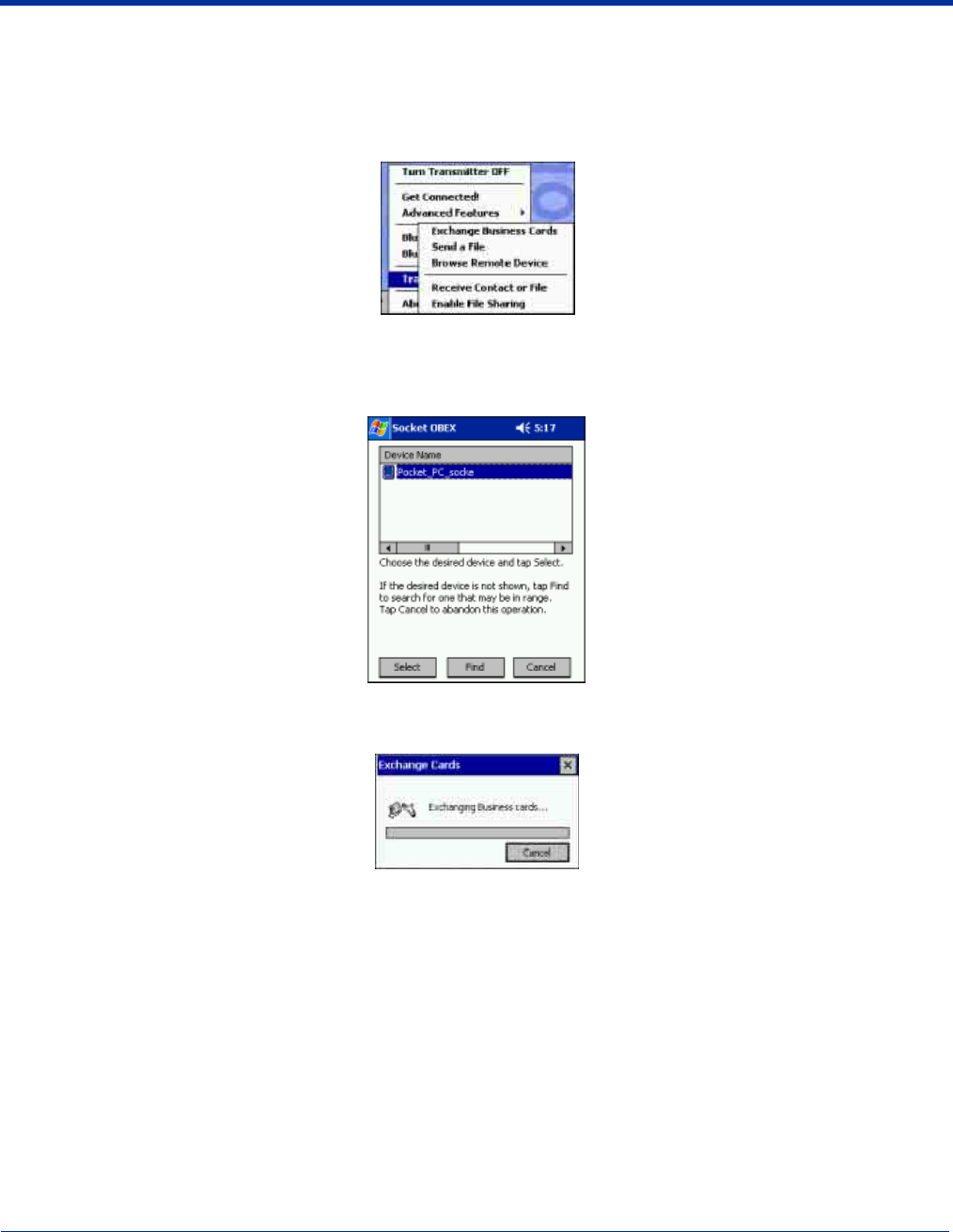
Dolphin® 9500/9550 Mobile Computer User’s Guide - GSM Draft 8 - 15
2. Make sure the other Bluetooth device is set up to receive a contact. The device must support the OBEX Object Push profile.
Note: If the other device is also using the Bluetooth Connection Kit, you can set it up to receive a contact by tapping the
Bluetooth icon. In the pop-up menu, tap Transfer via Bluetooth > Receive Contact or File.
3. Now you are ready to exchange business cards. Tap on the Bluetooth icon. In the pop-up menu, tap Transfer via
Bluetooth > Exchange Business Cards.
4. If your mobile computer has no devices in the Bluetooth Devices Folder, then it begins to search for Bluetooth devices
nearby.
5. Select the Bluetooth device you wish to exchange business cards with. If the device is not listed, tap Find.
6. Your mobile computer begins to exchange business cards. After the exchange, the new business card should appear in your
Contacts list.
Send a Contact
1. Make sure the other Bluetooth device is set up to receive a contact. It must support the OBEX Object Push server profile.
Refer to the documentation that came with the device for instructions.
Note: If the other device is also using the Bluetooth Connection Kit, you can set it up to receive a contact by tapping the
Bluetooth icon. In the pop-up menu, tap Transfer via Bluetooth > Receive Contact or File.
2. Now you are ready to send a contact. Go to your Contacts folder.
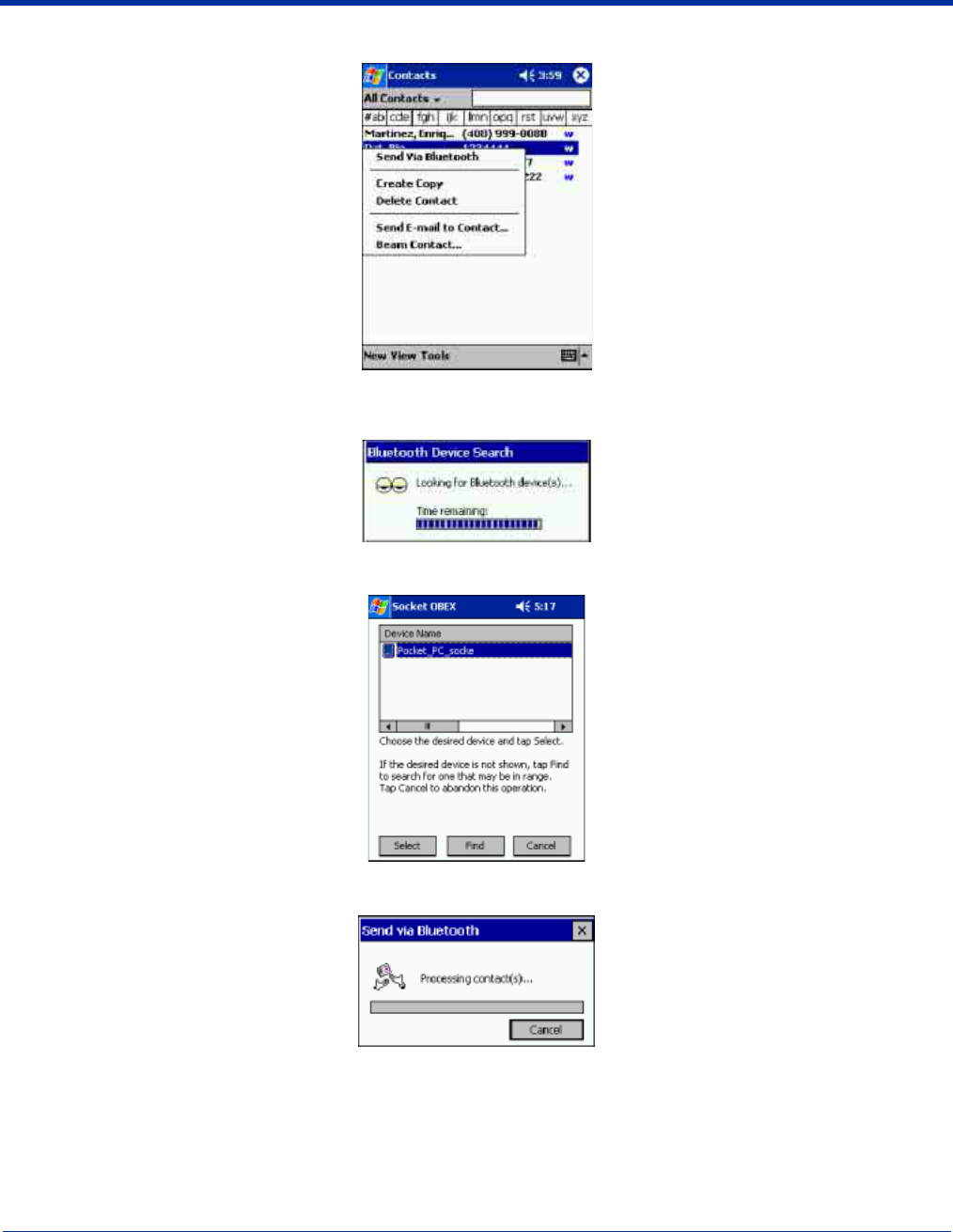
8 - 16 Dolphin® 9500/9550 Mobile Computer User’s Guide - GSM Draft
3. Tap and hold your stylus on the contact(s) you would like to send. In the pop-up menu, select Send Via Bluetooth.
4. If your mobile computer has no devices in the Bluetooth Devices Folder, then it begins to search for Bluetooth devices
nearby.
5. Select the Bluetooth device you wish to send the contact(s) to. If the desired device is not listed, tap Find.
6. Your mobile computer processes and send the contact(s).
Send a File
1. Make sure the other Bluetooth device is set up to receive a file. It must support the OBEX Object Push server profile. Refer to
the documentation that came with the device for instructions.
Note: If the other device is also using the Bluetooth Connection Kit, you can set it up to receive a file by tapping the Bluetooth
icon. In the pop-up menu, tap Transfer via Bluetooth > Receive Contact or File.
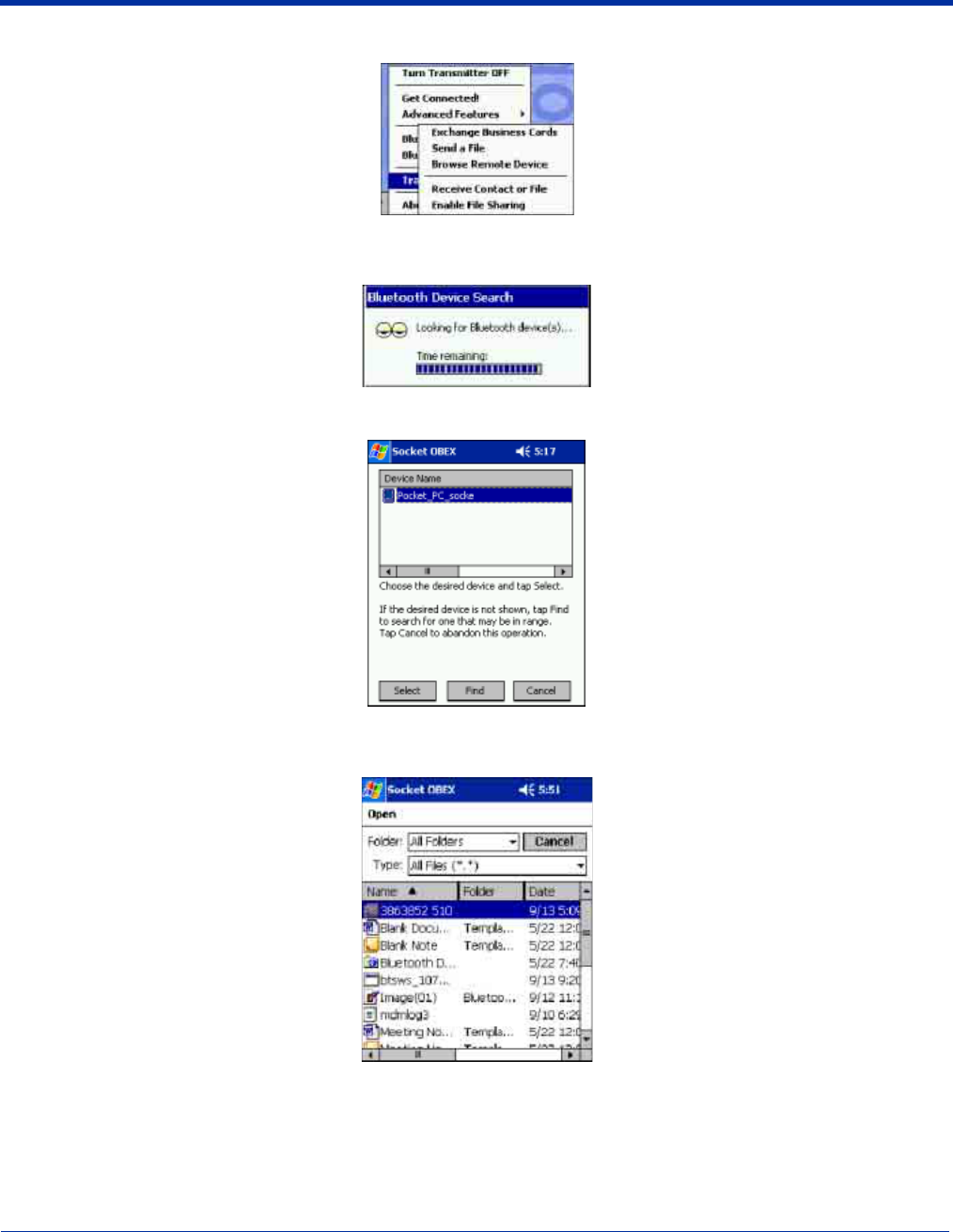
Dolphin® 9500/9550 Mobile Computer User’s Guide - GSM Draft 8 - 17
2. Now you are ready to send a file. Tap on the Bluetooth icon. In the pop-up menu, tap Transfer via Bluetooth > Send a File.
3. If your mobile computer has no devices in the Bluetooth Devices Folder, then it begins to search for Bluetooth devices
nearby.
4. Select the Bluetooth device you wish to send a file. If the desired device is not listed, tap Find.
5. In the next screen, tap on the file you wish to send. You can use the Folder and Type drop-down menus to search for your
file. Also, you can scroll horizontally to view the folder, date, size, type, and location of each file.
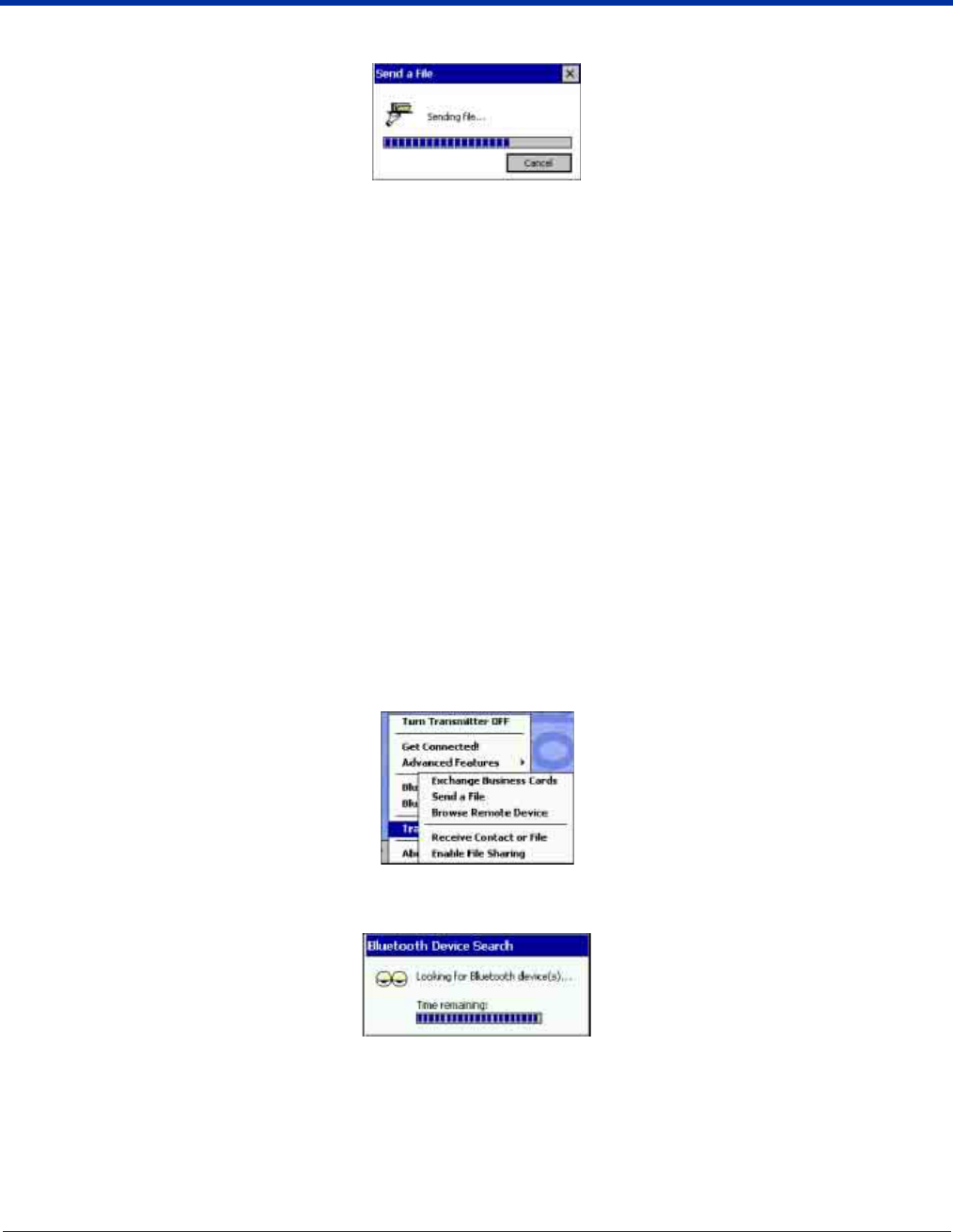
8 - 18 Dolphin® 9500/9550 Mobile Computer User’s Guide - GSM Draft
6. Your mobile computer sends the file.
Browse Remote Device
The Bluetooth File Explorer lets your mobile computer share files with another Bluetooth device. The other device must support
the OBEX File Transfer server profile.
This section covers the following file transfer operations:
• Prepare for file transfer
• Send/receive file(s) or folder(s)
• Create a folder
• Delete file(s) or folder(s)
• Refresh remote view
• Connect/disconnect
• Exit the program
Note: “Local device” refers to the mobile computer you are running the OBEX from. “Remote device” refers to the Bluetooth
device you are trying to transfer files with.
Prepare for File Transfer
1. Make sure the remote device has file sharing enabled. It must support the OBEX File Transfer server profile.
Note: If the other device is also using the Bluetooth Connection Kit, you can enable file sharing by tapping the Bluetooth icon.
In the pop-up menu, tap Transfer via Bluetooth > Enable File Sharing.
2. Now you are ready to browse the remote device. Tap on the Bluetooth icon. In the pop-up menu, tap Transfer via
Bluetooth > Browse Remote Device.
3. If your mobile computer has no devices in the Bluetooth Devices Folder that supports OBEX File Transfer, then it begins to
search for Bluetooth devices nearby.
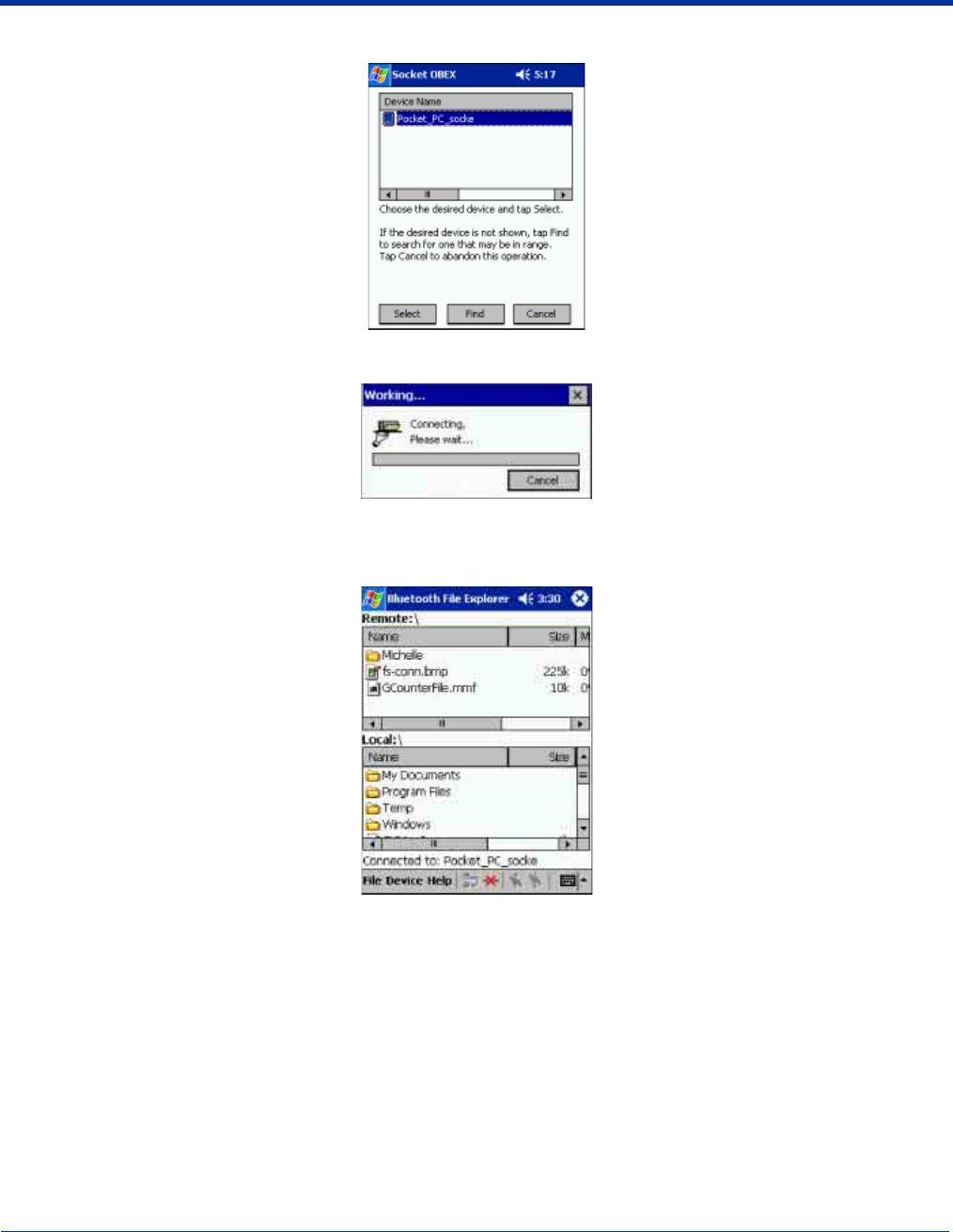
Dolphin® 9500/9550 Mobile Computer User’s Guide - GSM Draft 8 - 19
4. Select the Bluetooth device you wish to browse. If the desired device is not listed, tap Find.
5. Your mobile computer begins to establish a file sharing connection.
6. After the devices successfully connect, the Bluetooth File Explorer appears. Half of the screen shows contents of the remote
device, while the other half shows contents of your device (the local device). The very bottom of the screen reports the
connection status.
Send/Receive File(s) or Folder(s)
• Single-tap items to select them for transfer.
• Double-tap on a folders to open it and see its contents.
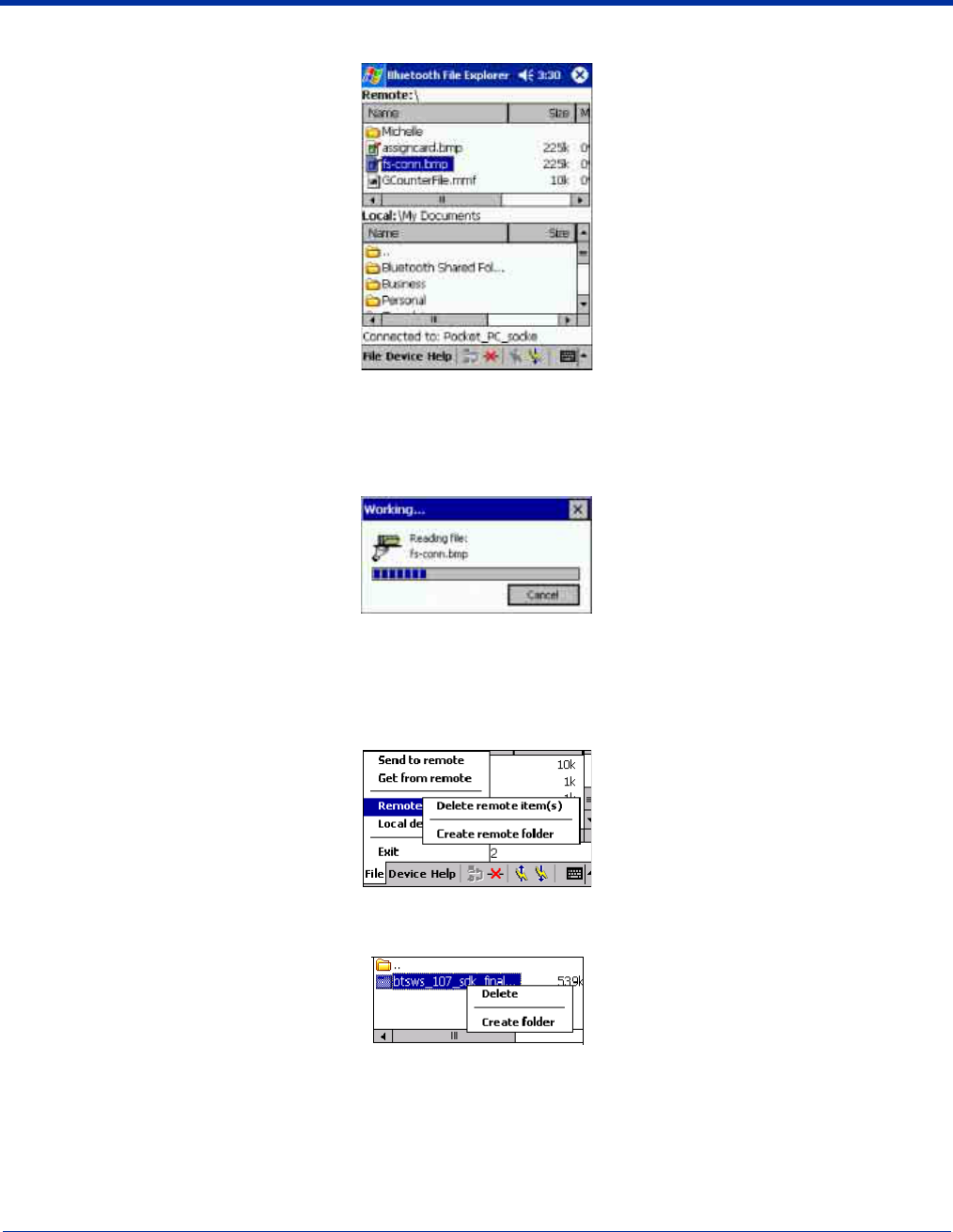
8 - 20 Dolphin® 9500/9550 Mobile Computer User’s Guide - GSM Draft
1. Select the file(s) or folder(s) that you wish to transfer. You can select items from only one device per transfer session.
2. There are two different ways to initiate the transfer:
• Tap on the File menu. Select Send to remote or Get from remote, as applicable. The inappropriate option should be gray.
• Tap on the Send to remote icon or Get from remote icon, as applicable. The inappropriate icon should be gray.
3. A screen reports the status of the transfer.
4. After the transfer, a copy of each selected item should appear in the other device.
Create a Folder
1. Tap on the File menu. Select Remote device or Local device, wherever you want to create a folder, then tap Create
remote folder or Create local folder, as applicable.
2. On the Dolphin 9500/9550, you can also tap and hold your stylus on an item in either the remote or local device that you wish
to put in a new folder. In the pop-up menu, select Create folder.
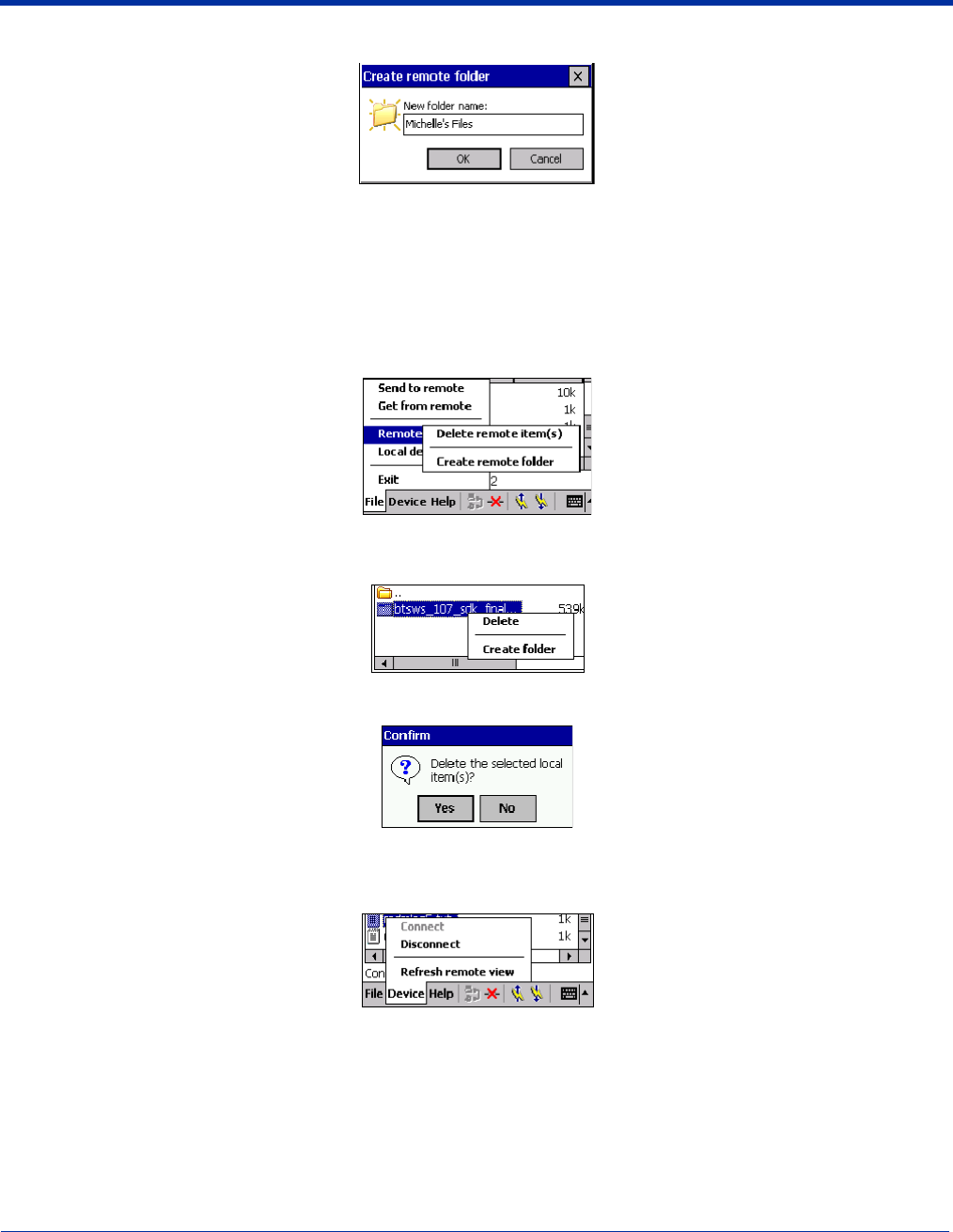
Dolphin® 9500/9550 Mobile Computer User’s Guide - GSM Draft 8 - 21
3. In the next screen, enter a name for your new folder. Tap OK.
4. The new folder should be listed under the appropriate device.
Delete File(s) or Folder(s)
1. Select item(s) that you wish to delete. You can only delete item(s) from one device at a time.
2. Tap on the File menu. Select Remote device or Local device, wherever the item(s) are located, then tap Delete remote
item(s) or Delete local item(s), as applicable.
3. Tap and hold your stylus an item in either the remote or local device that you wish to put in a new folder. In the pop-up menu,
select Delete folder.
4. In the Confirm screen, tap Yes.
Refresh Remote View
1. Tap on the Device menu. Select Refresh remote view.
2. Your local device begins to read the contents of the remote device.
3. After a few seconds, the contents view of the remote device is refreshed.
Connect/Disconnect
To connect to the remote device, do the following:
1. Make sure the remote device has file sharing enabled.
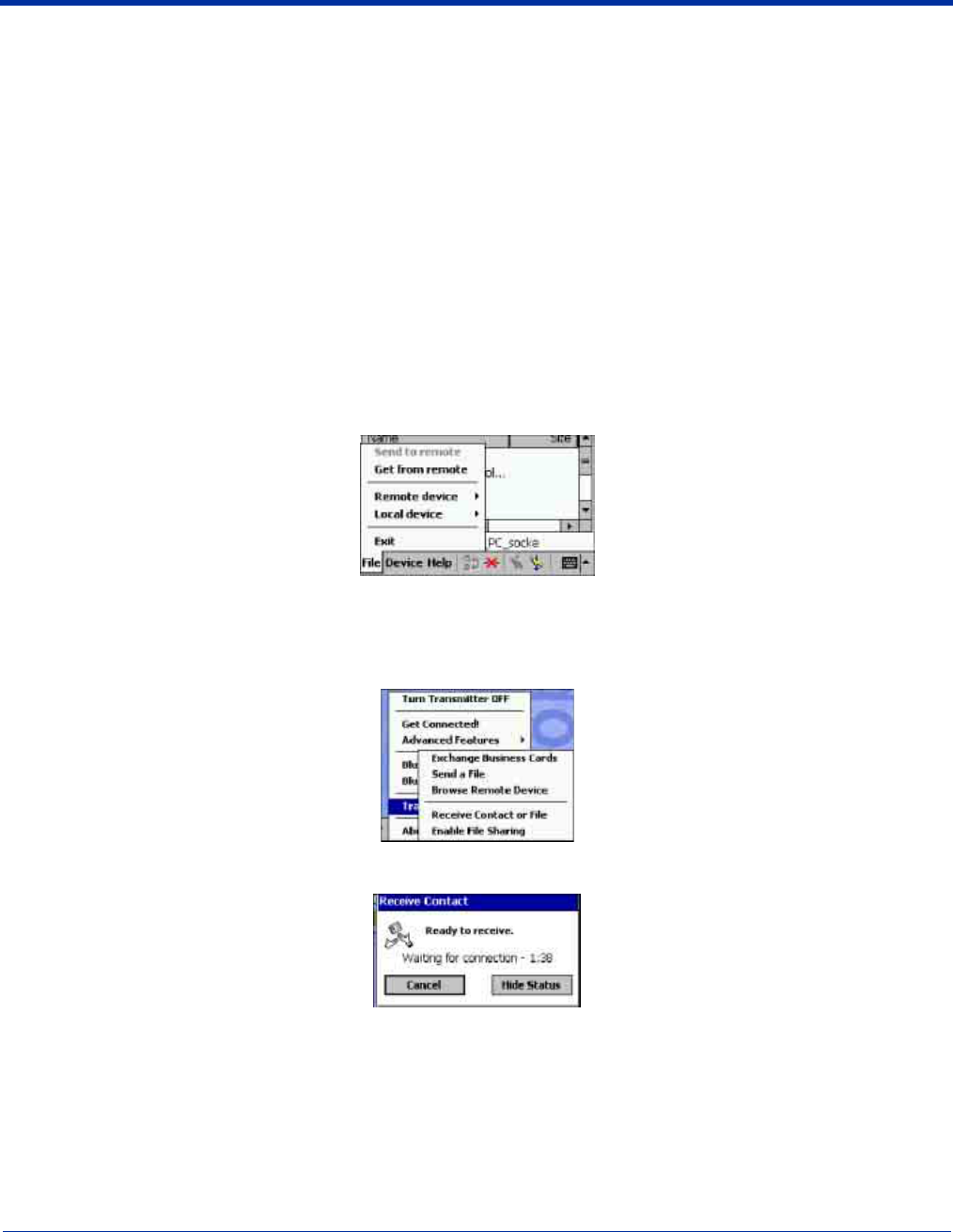
8 - 22 Dolphin® 9500/9550 Mobile Computer User’s Guide - GSM Draft
2. Start the connection process by either of two methods:
• Tap on the Device menu. Select Connect.
• Tap on the Connect icon.
3. In the next screen, select the device you wish to connect to. Tap Select. Your mobile computer attempts to connect to the
device selected.
To disconnect from the remote device, do the following:
1. Start the disconnection process by either of two methods:
• Tap on the Device menu. Select Disconnect.
• Tap on the Connect icon.
2. Your mobile computer disconnects from the remote device. Afterwards, no contents are listed for the remote device.
Exit Bluetooth File Explorer
To exit the Bluetooth File Explorer, tap File > Exit.
Receive Contact or File
1. Tap on the Bluetooth icon. In the pop-up menu, tap Transfer via Bluetooth > Receive Contact or File.
2. The Receive Contact or File status screen appears. Your mobile computer waits two minutes for the contact or file.
3. After successfully connecting to the remote device, the screen reports Connected then disappear. The new contact or file
should now be on your device.
4. If two minutes passes before you receive the item, tap Wait Again.
5. After you receive the file or contact, the “Receive Contact or File” feature is automatically disabled.
Enable File Sharing
1. Tap on the Bluetooth icon. In the pop-up menu, tap Transfer via Bluetooth > Enable File Sharing.

Dolphin® 9500/9550 Mobile Computer User’s Guide - GSM Draft 8 - 23
2. The Enable File Sharing status screen appears. Your mobile computer waits two minutes for the remote device to connect.
3. After successfully connecting to the remote device, the screen report Connected.
4. If two minutes passes before you connect, tap Wait Again.
5. File sharing is enabled until you end it by tapping Cancel.
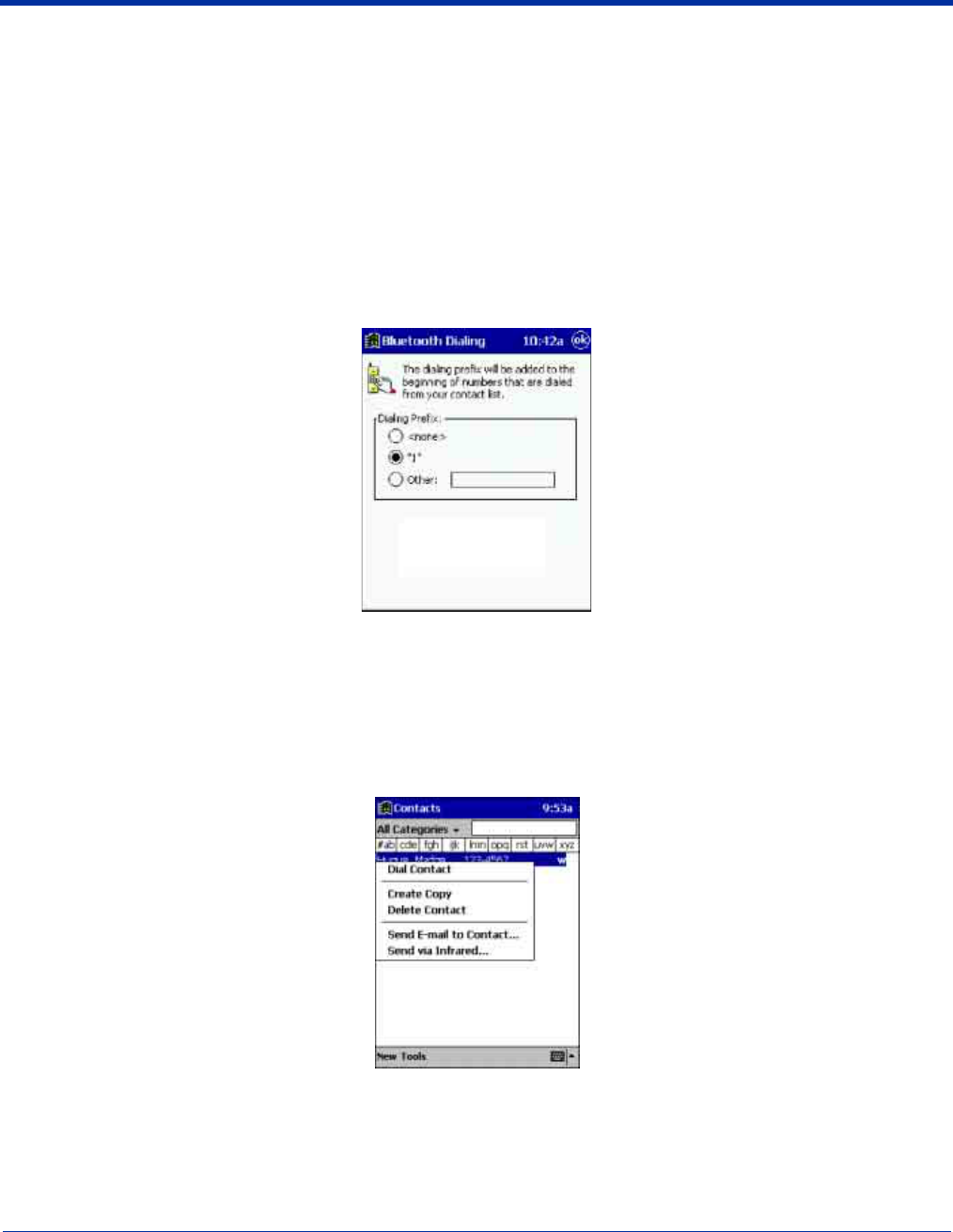
8 - 24 Dolphin® 9500/9550 Mobile Computer User’s Guide - GSM Draft
Using the Dialer
This section explains how to assign a dialing prefix and use the Dialer to dial a number directly from your Contacts list. The Dialer
makes it quick and easy to perform dial-up networking.
Note: The Dialer has been verified to work with Nokia and Ericcson phones and is known not to work with the Motorola 270c,
NTT Docomo Paldio 633S or Sony au C413S phone. Results may vary with other phones that are not listed as being supported
by the Bluetooth system.
Assign a Dialing Prefix
If you have not already assigned a dialing prefix during the install process, you can do so by following these steps:
1. Go to Start > Settings > System tab. Tap on Dialer.
2. Select the appropriate Dialing Prefix, then tap OK.
Using the Dialer
1. To use the dialer, the mobile computer must already be connected to the Bluetooth phone. You can use the Get Connected!
Wizard to do this. Also, the Bluetooth phone must be selected as your favorite.
2. Go to Start > Contacts.
3. Tap and hold your stylus on the contact you wish to dial to. In the pop-up menu, select Dial Contact. Alternatively, you can
tap on Tools and select Dial Contact.
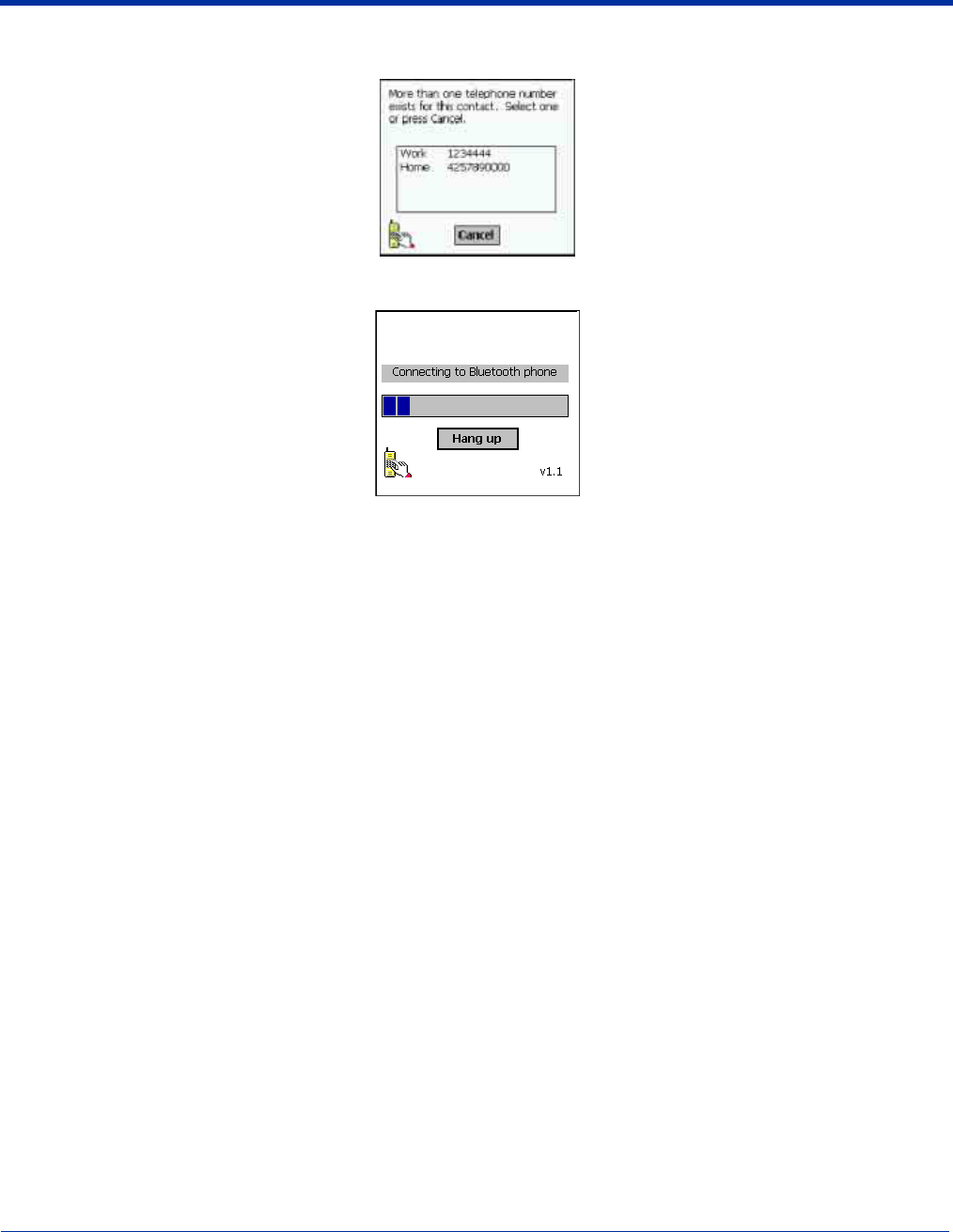
Dolphin® 9500/9550 Mobile Computer User’s Guide - GSM Draft 8 - 25
4. If you have multiple phone numbers for a contact, a screen appears listing them, including any dialing prefix you may have
assigned. Select the phone number you wish to dial.
5. Your mobile computer connects to your phone and begins dialing.
The Dialer can dial a phone number containing any of the following non-numeric characters:
*#+./!@-\space A B C D T P W
The following string can also be included in a phone number: (',')
The Dialer cannot dial a phone number containing non-numeric characters other than those listed above. HHP recommends that
you follow the standard Microsoft Outlook format for phone numbers.
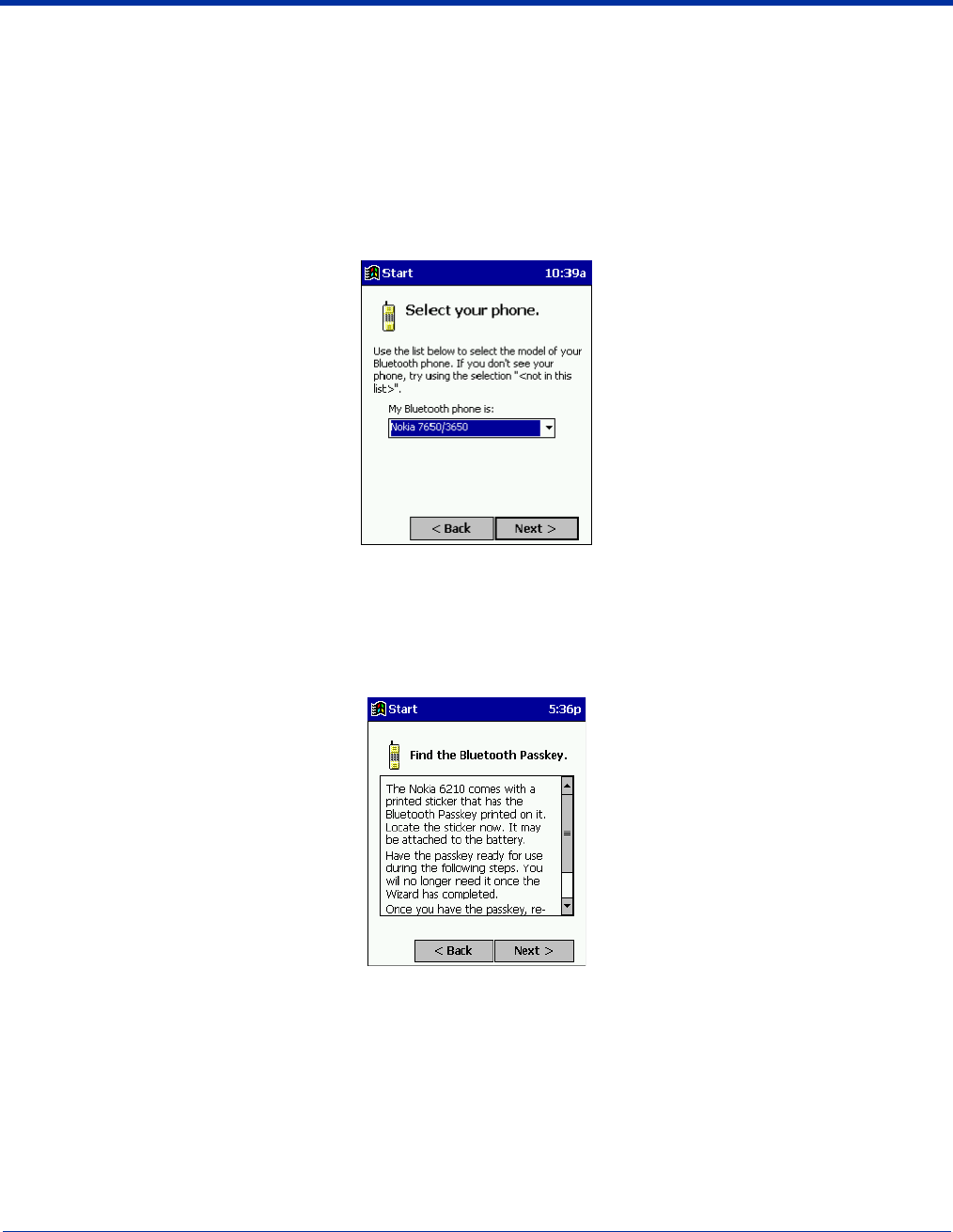
8 - 26 Dolphin® 9500/9550 Mobile Computer User’s Guide - GSM Draft
Get Connected Wizard
The Get Connected! Wizard guides you through a one-time setup process that prepares the mobile computer and phone for
Bluetooth connections. The wizard varies depending on what phone you want to connect to.
Ericsson, Nokia 6210, NTT DoCoMo, Sony Phones
1. Tap on the Bluetooth task tray icon. In the pop-up menu, select Get Connected!
2. Follow the Bluetooth “Get Connected!” Wizard. In the second screen, use the drop-down list to select your Bluetooth phone.
The wizard provides tailored instructions based on your selection.
3. Follow the next screen(s) to prepare your specific phone for Bluetooth connections. You may need to do 1, 2 or all of the
following steps:
(a) Naming your Bluetooth phone
(b) Setting your Bluetooth phone in Discoverable mode
(c) Preparing your Bluetooth passkey.
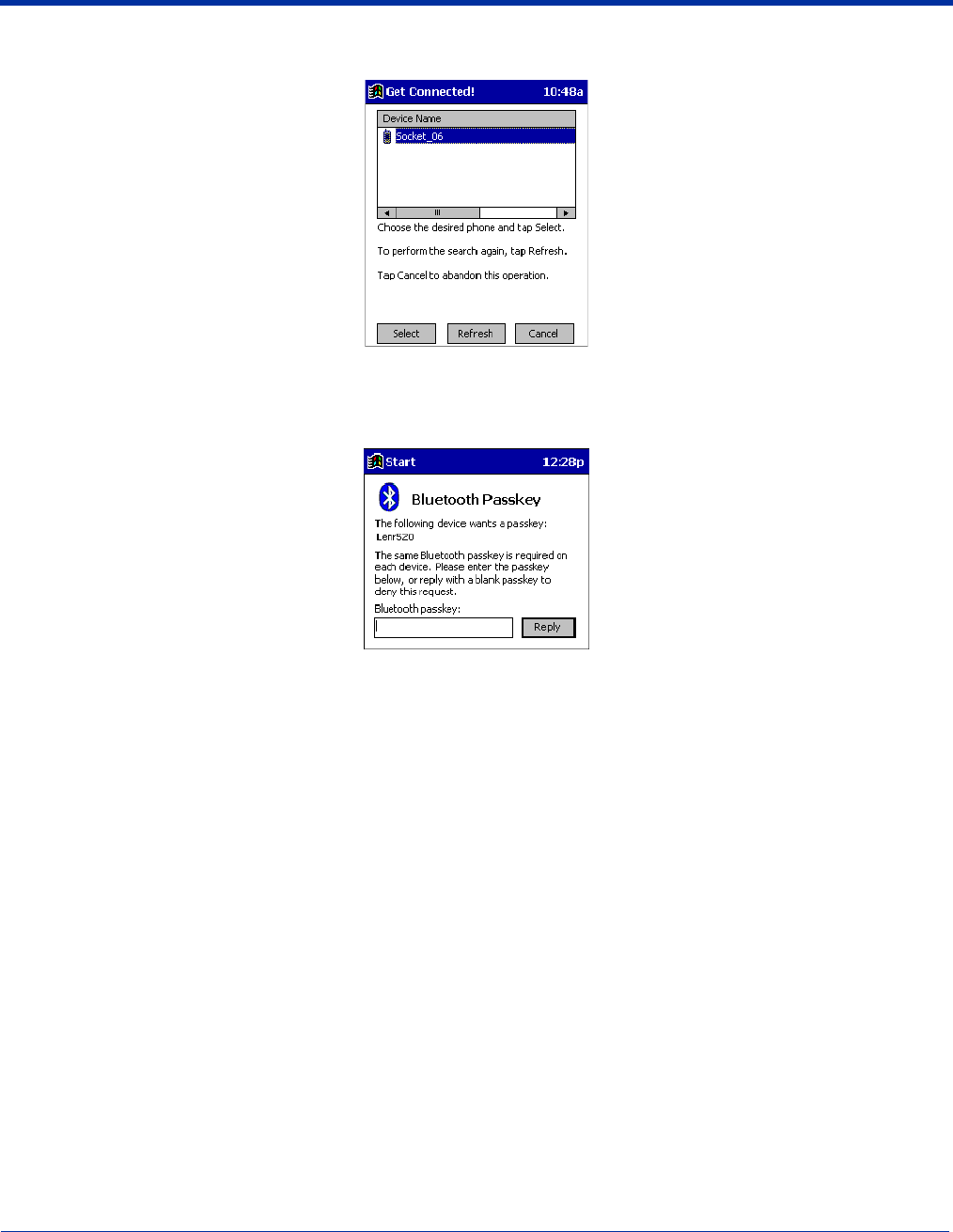
Dolphin® 9500/9550 Mobile Computer User’s Guide - GSM Draft 8 - 27
4. When the search is complete, a list of the discovered Bluetooth phones appears. Choose the phone you wish to connect to,
and tap Select. A service discovery phase begins, about 5-10 seconds.
5. As prompted in the next screen, prepare your phone for bonding. For instructions on setting your phone to “Bondable” or
“Pairable” mode, refer to your phone manual. Have your passkey ready, then tap Next>.
6. In the next screen, enter the passkey. Tap Reply.
7. The mobile phone may then either automatically accept the passkey or ask you to enter one. If prompted for a passkey, use
the same one you entered on the mobile computer.
Ericsson T68/T68i only: When the phone asks you if you want to bond, select 2: Add to paired devices. Do not tap ACCEPT.
8. Tap Finish. After successfully connecting, the phone appears in the Bluetooth Devices folder. On the Today screen, the
Bluetooth icon blinks. You do not need to run the Get Connected! Wizard again unless you plan to switch between different
phones.
Note: You may also switch between different phones by assigning a new “favorite phone” in the Bluetooth Devices folder.
Motorola Timeport 270C, Nokia 3650/6310/7650/8910/8910i
1. Tap on the Bluetooth task tray icon. In the pop-up menu, select Get Connected!
2. Follow the Bluetooth “Get Connected!” Wizard. In the second screen, use the drop-down list to select your Bluetooth phone.
The wizard provides tailored instructions for your phone.
Note: The screens below are for the Nokia 7650.
3. As directed on the next two screens, assign the phone a unique name, set the phone to Discoverable mode, and tap Next.
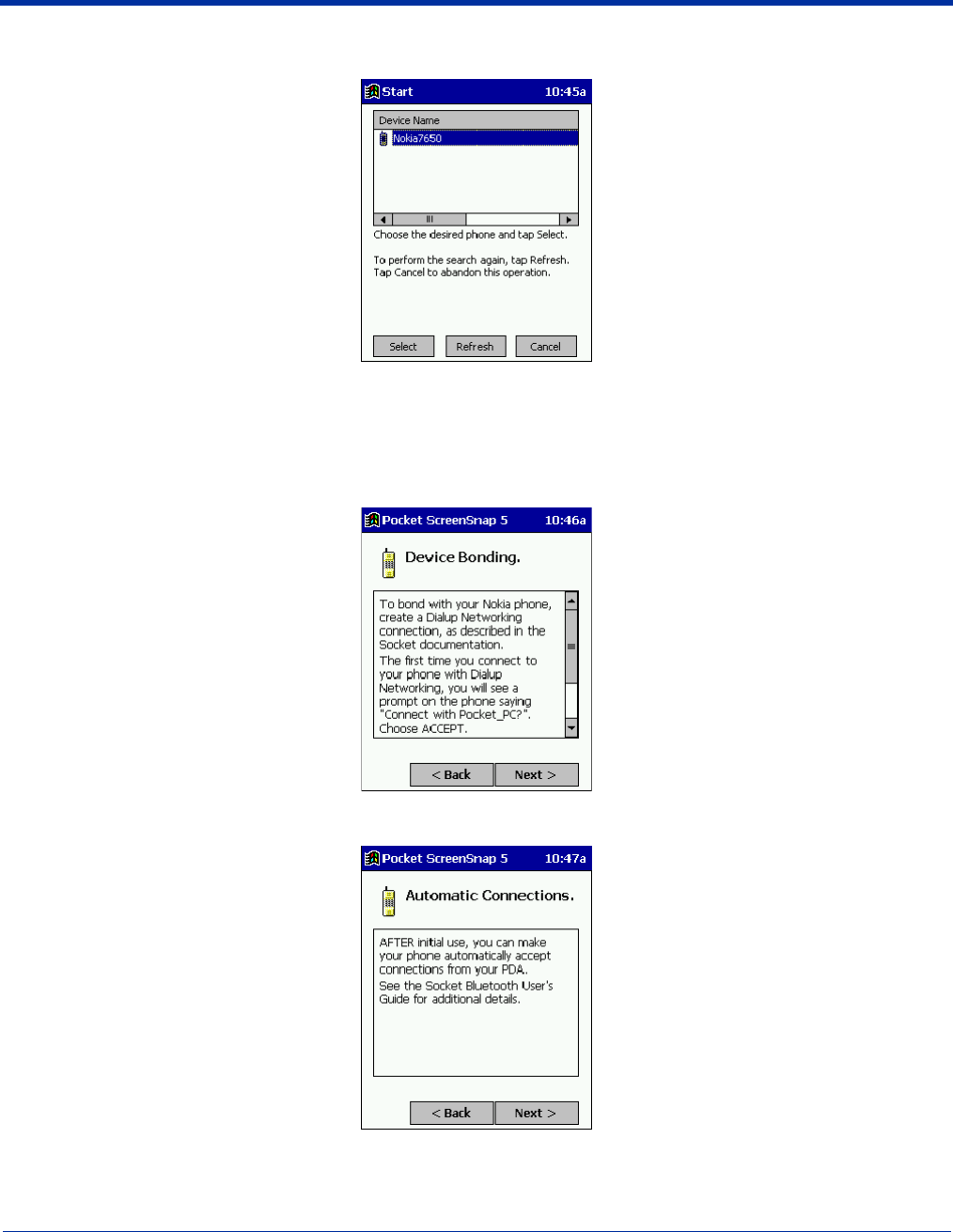
8 - 28 Dolphin® 9500/9550 Mobile Computer User’s Guide - GSM Draft
4. The mobile computer begins to search for the phone. When the search is over, a list of the discovered Bluetooth phones
appears.
Choose the phone you wish to connect to, and tap Select. A service discovery phase begins, about 5-10 seconds.
5. The next two screens describe procedures you can only complete outside of the wizard. Read through each screen but do
not complete the described procedures until you exit the wizard.
Bonding with your phone - This must be completed to establish the Bluetooth connection and involves dial-up
networking.
Automatic Connections - This procedure is optional but makes future Bluetooth connections more convenient.
6. Continue to the last screen of the wizard and tap Finish. Now proceed to STEP 6 to complete the bonding process and, if
desired, set up automatic connections.
Note: Directions for these procedures are provided in Dial-up to Your Network, starting on the next page.
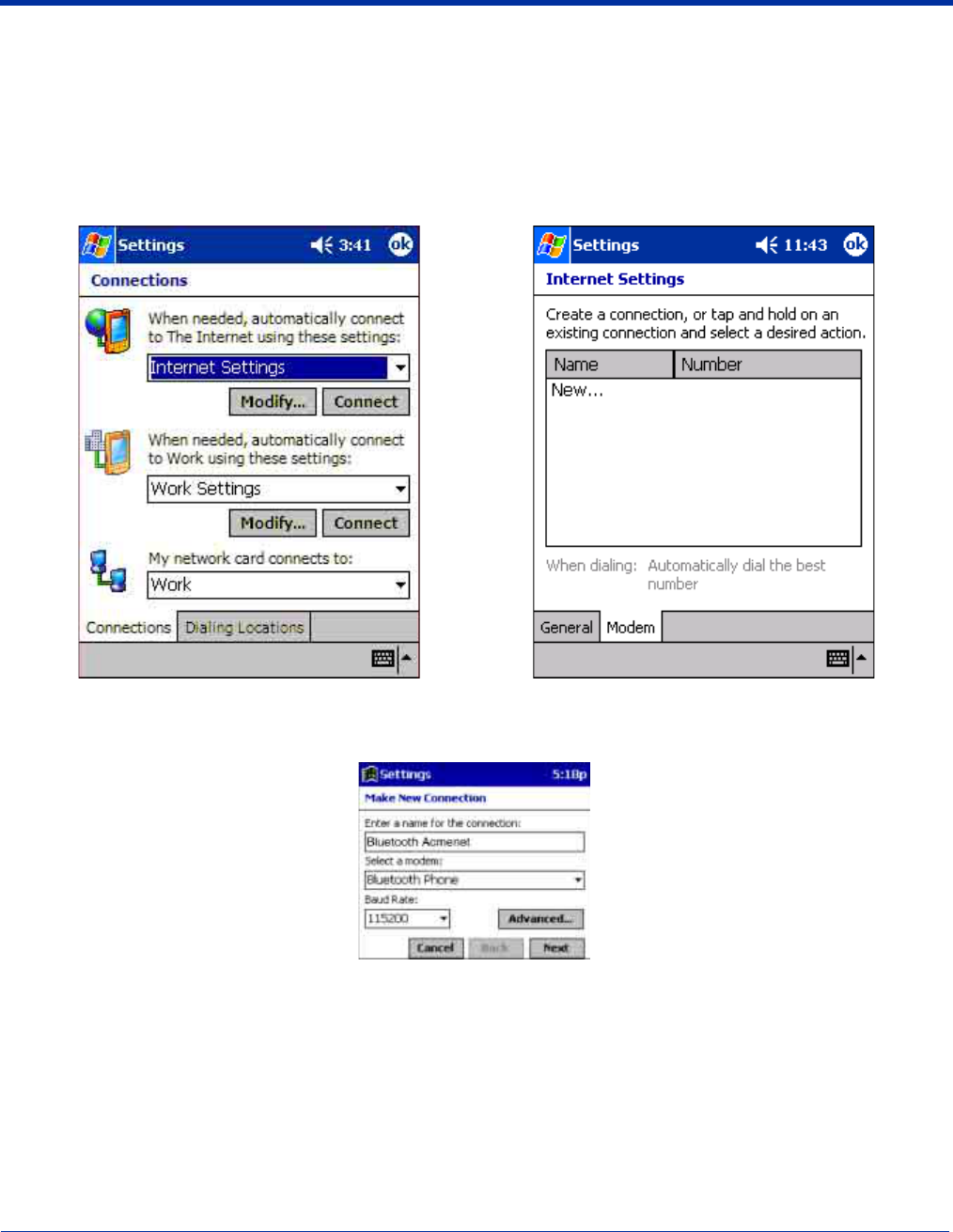
Dolphin® 9500/9550 Mobile Computer User’s Guide - GSM Draft 8 - 29
Dial-up to Your Network
Complete the following steps to create a new Bluetooth internet connection. Before setting up dial-up networking, prepare
yourself with dial-up information and other necessary settings from your office network or ISP.
1. Go to Start > Settings > Connections tab > Connections. In the top field, select Internet Settings and tap Modify. Then,
tap New.
2. On the Make a New Connection screen, enter a name for the dial-up connection. For the modem, select Bluetooth Phone.
For the Baud Rate, select 115200. Tap Advanced.
Note: Remember what you name the connection. In the future, you will need to select it to start the connection.
3. Tap Next.
4. In the Phone number field, enter the dial-up number. Tap Next.
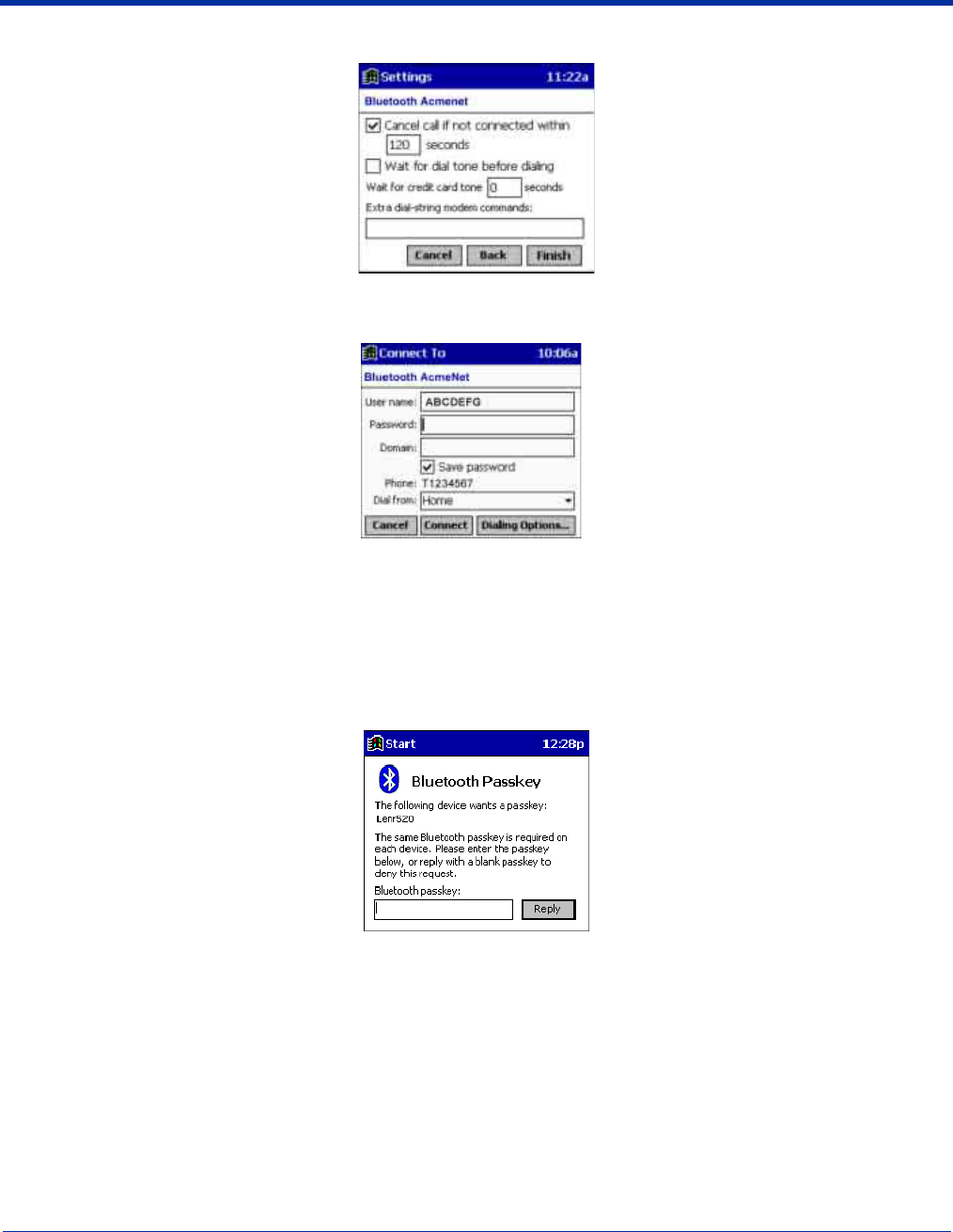
8 - 30 Dolphin® 9500/9550 Mobile Computer User’s Guide - GSM Draft
5. Uncheck Wait for dial tone before dialing. Tap Finish.
6. Now you are ready to start the connection. In the Connections screen, under Internet Settings, tap Connect. In Network Log
On, verify the dialing settings. Tap OK.
If you want to configure Port Settings, TCP/IP, or Name Server settings, navigate to the setting and tap Advanced; see Advanced
Settings on page 5-19.
7. ONLY FOR MOTOROLA TIMEPORT 270C OR NOKIA 3650/6310/7650/8910/8910i:
a) After you tap Connect for the first time, the phone displays a message asking if you want to bond. On Motorola, enter
GRANT; on Nokia, enter ACCEPT.
b) Make up a 4-16 digit passkey, enter it on the phone, then enter it on the Dolphin 9500/9550.
Note: The Bluetooth icon on the Today screen blinks to indicate a connection.
c) After successfully bonding, you can set up the phone to automatically connect to your Dolphin 9500/9550 without requiring a
passkey.
Automatic Connections for Motorola Timeport 270C:
• On the phone, press MENU.
• Scroll to Settings, then press SELECT.
• Scroll to Connection, then press ON.
• On Bluetooth Link, press SELECT.
• Scroll to Devices, then press SELECT.
• Choose your mobile computer, then press EDIT.
• Scroll to Access:Ask, then press CHANGE.
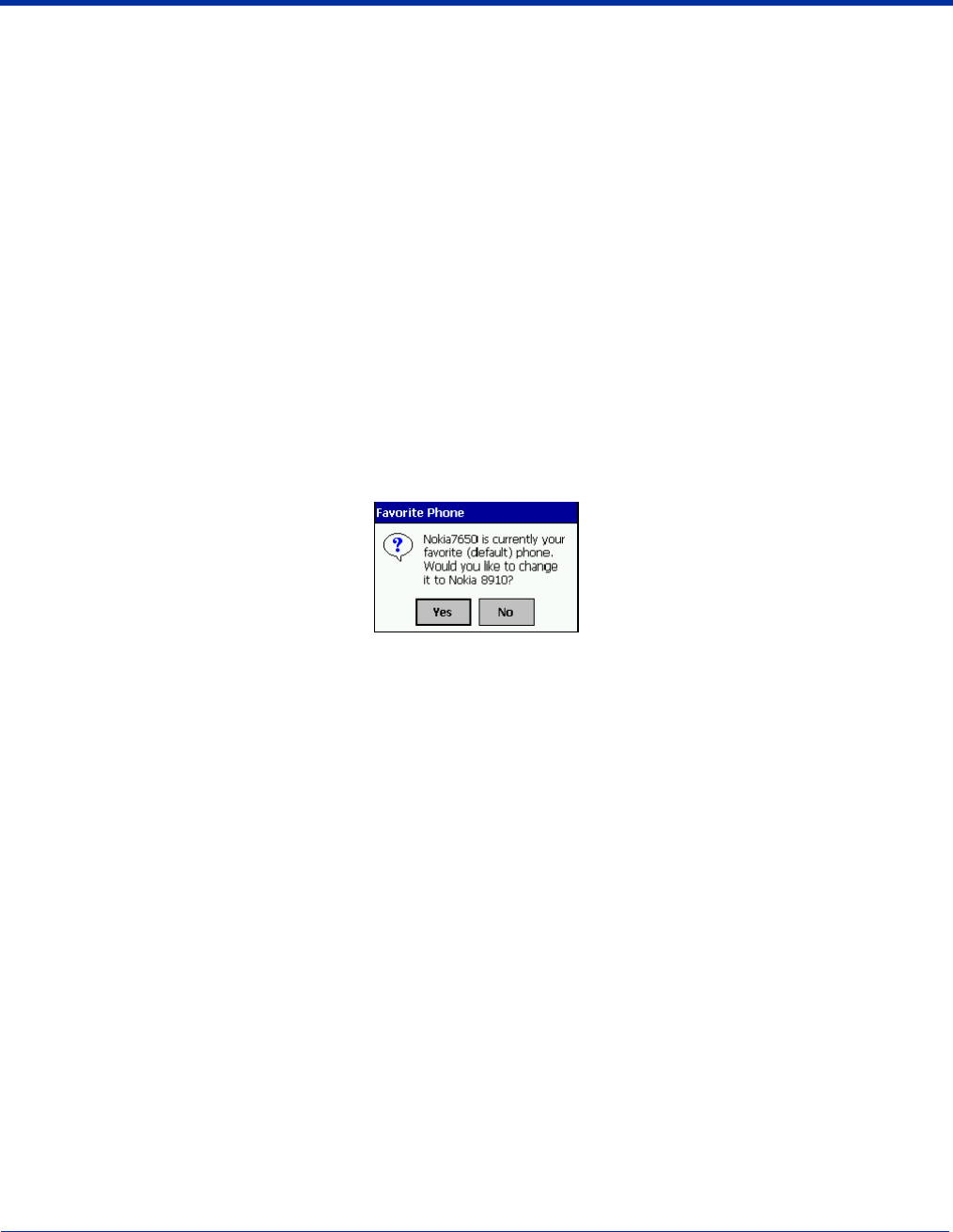
Dolphin® 9500/9550 Mobile Computer User’s Guide - GSM Draft 8 - 31
• Scroll to Automatic, then press SELECT. Press DONE.
Automatic Connections for Nokia 3650/7650:
• On the phone, press MENU.
• Scroll to Connectivity, then press OPTIONS.
• The Open option should be highlighted. Press SELECT.
• The Bluetooth option should be highlighted. Press OPTIONS.
• The Open option should be highlighted. Press SELECT.
• Scroll to the right tab to access the Paired devices list. Highlight your mobile computer, then press OPTIONS.
• Scroll to Set as authorized, then press SELECT.
• In the confirmation screen, press YES.
Automatic Connections for Nokia 6310/8910/8910i:
• On the phone, press MENU.
• Scroll to 10 Bluetooth, then press SELECT.
• Scroll to 4 View Paired Devices, then press SELECT.
• Highlight the Dolphin 9500/9550, then press OPTIONS.
• Scroll to 3 Request Connection Authorization, then press NO.
To use a different Bluetooth phone for dial-up networking, you can use the same connection setup, but you must make the new
phone your favorite. Just run the Get Connected! Wizard again, select the new phone, and make it your new Favorite when
prompted.
Alternatively, you can use the Bluetooth Devices folder to change your favorite phone. Refer to Using the Dolphin 9500/9550
Mobile Computer beginning on page 4-1 for instructions.

8 - 32 Dolphin® 9500/9550 Mobile Computer User’s Guide - GSM Draft
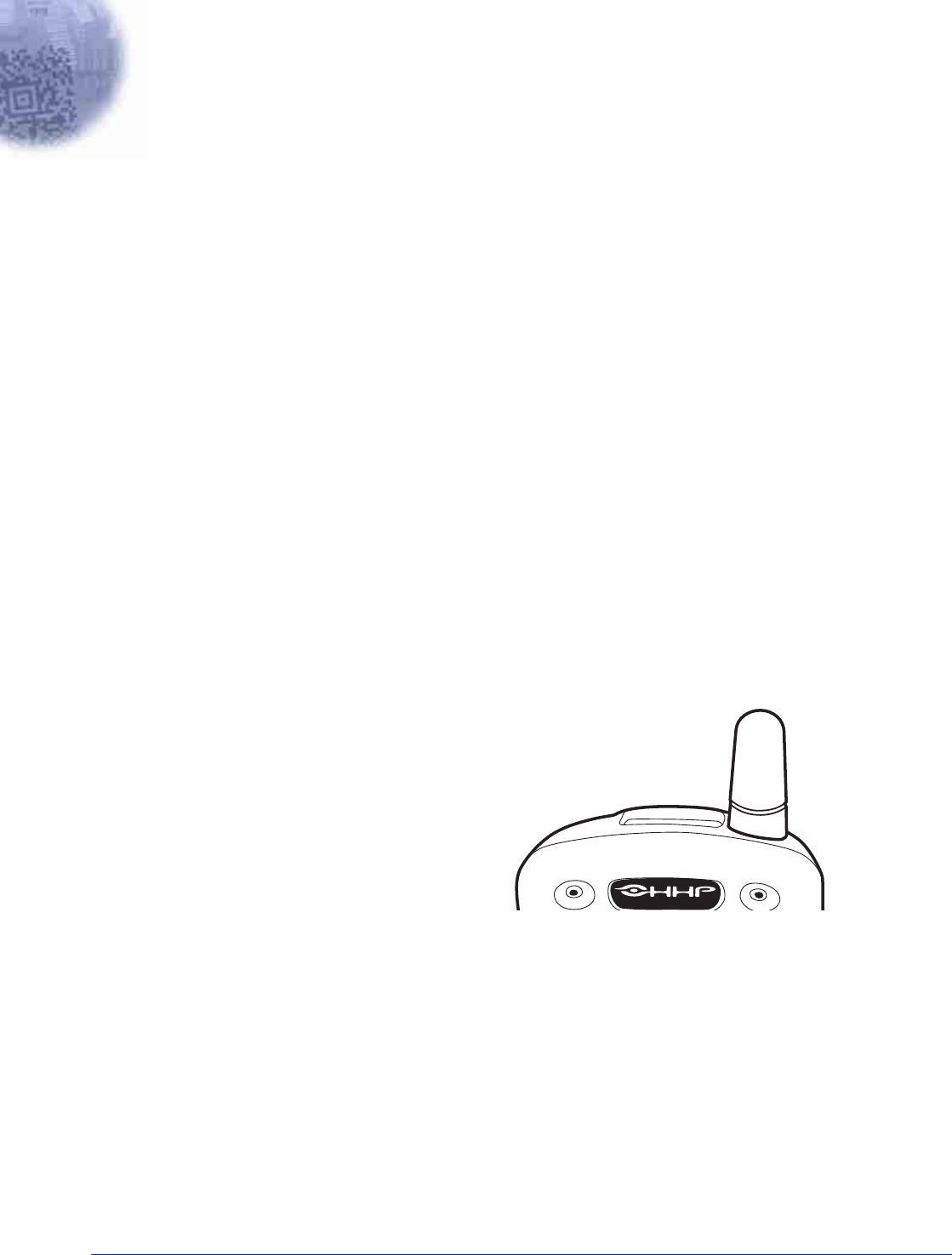
Dolphin® 9500/9550 Mobile Computer User’s Guide 9 - 1
9
Wireless WAN Communications with GSM/GPRS
Overview
Dolphin 9500 terminals can be configured with Wireless Wide Area Network (WWAN) via an integrated Siemens® GSM/GPRS
tri-band radio module.
Note: Dolphin 9550 mobile computers with pistol-grip do NOT support GSM/GPRS.
GSM - GSM stands for Global System for Mobile communications. It is an open, non-proprietary wireless wide area networking
system that is constantly evolving and growing. One of its great strengths is international roaming capability, which provides
standardized dialing in more than 170 countries.
GPRS - GPRS stands for General Packet Radio Service. It is a non-voice value added service that allows packet switched data
and information to be instantly sent and received across a mobile telephone network.
Powering Up the GSM/GPRS Radio Driver
When the mobile computer is first initialized, the radio driver for the GSM module is installed. Before using the radio, make sure
that the GSM radio is powered up. For more information, see The Radio Manager on page 4-18.
Capabilities
Dolphin 9500 computers with integrated GSM/GPRS WWAN radios are optimized for the following two-way voice and data
communications:
• GSM data "dial-up"
• SMS (Short Message Service)
• GPRS Class 10 - data transmissions average. 40-60 Kbps (wireless network carrier dependent)
Tri-Band Antenna
Requirements
Using GMS/GPRS on a Dolphin 9500 terminal requires:
• a network subscription to a GSM/GPRS network (you need to know what service providers are in your geographic area), and
• a SIM card installed on the terminal.
DOLPHIN9500
Dolphin 9500 terminals configured with a GSM/GPRS
radio module also feature a tri-band antenna on the top
panel. This antenna supports 900, 1800 and 1900 Mhz
frequencies for worldwide mobile applications.
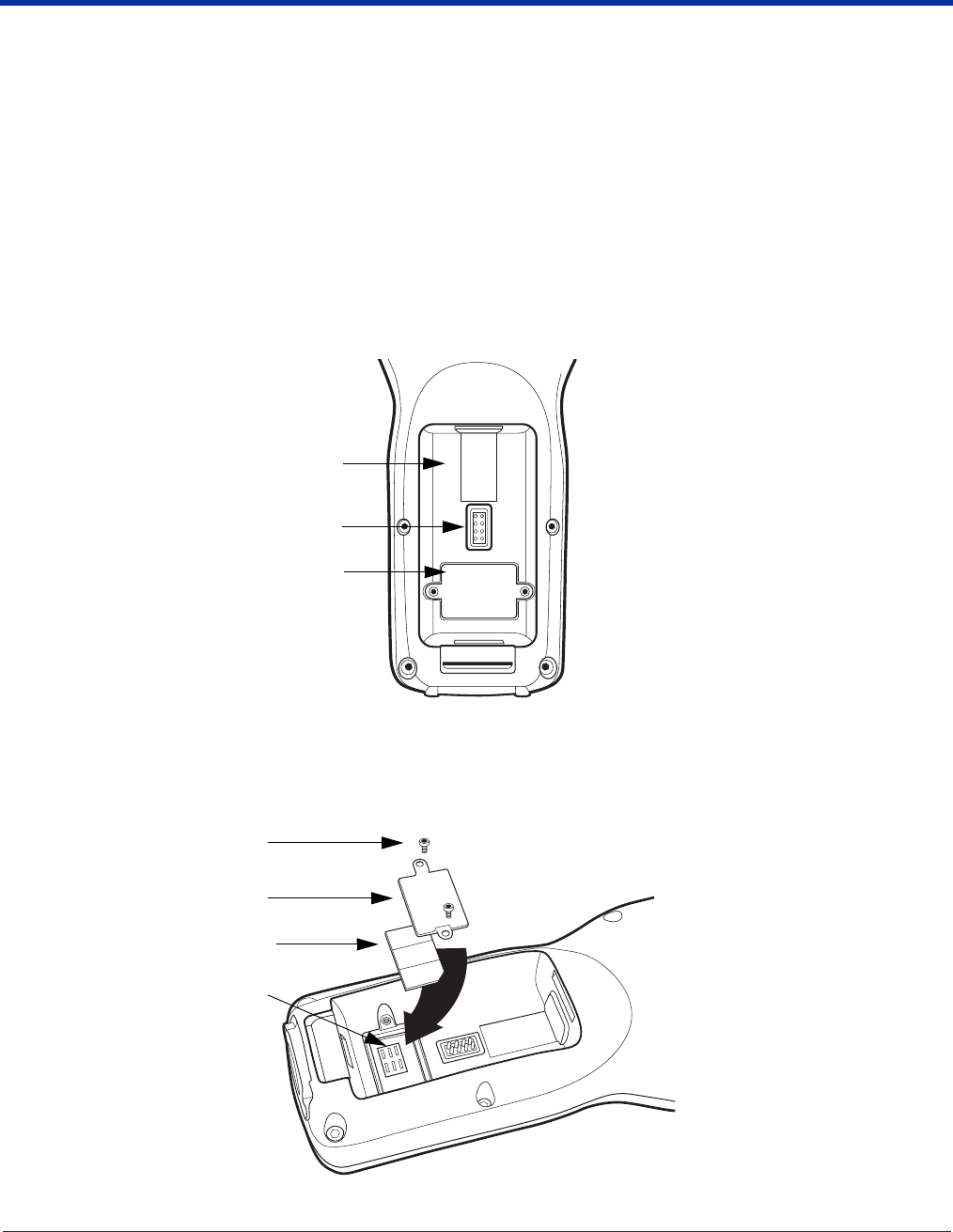
9 - 2 Dolphin® 9500/9550 Mobile Computer User’s Guide
SIM Card Installation
SIM stands for Subscriber Information Module. A SIM card stores the subscriber's personal information, GSM/GPRS radio
settings, security key, contacts, etc. SIM cards can be installed and removed from any mobile device, enabling you to switch
devices without losing your personal information. SIM cards are obtained and activated by the network provider that supports the
GSM/GPRS network.
On the Dolphin 9500 terminal, the SIM card door is located in the battery well on the back panel. This enables easy access to
the SIM card while securing it under an installed battery.
To Install a SIM Card:
Note: You need a metric .05” allen head screwdriver to open the SIM card door. The SIM card must be activated by the service
provider prior to insertion.
1. Turn off your terminal and lay it face-down on a flat surface.
2. Remove the battery pack. For details, see To Remove the Main Battery Pack on page 2-6.
3. Unscrew the faceplate of the SIM card door.
4. Insert your SIM card. Make sure the interface on the card is connected to the SIM Card interface in the slot; the beveled
corner is in the upper right corner.
5. Place the SIM card door over the secured SIM card and secure the allen screws.
6. Install the battery pack. The terminal powers on.
Battery Well
SIM Card Door
Battery Interface
SIM Card Interface
Allen Screws
SIM Card Door
SIM Card
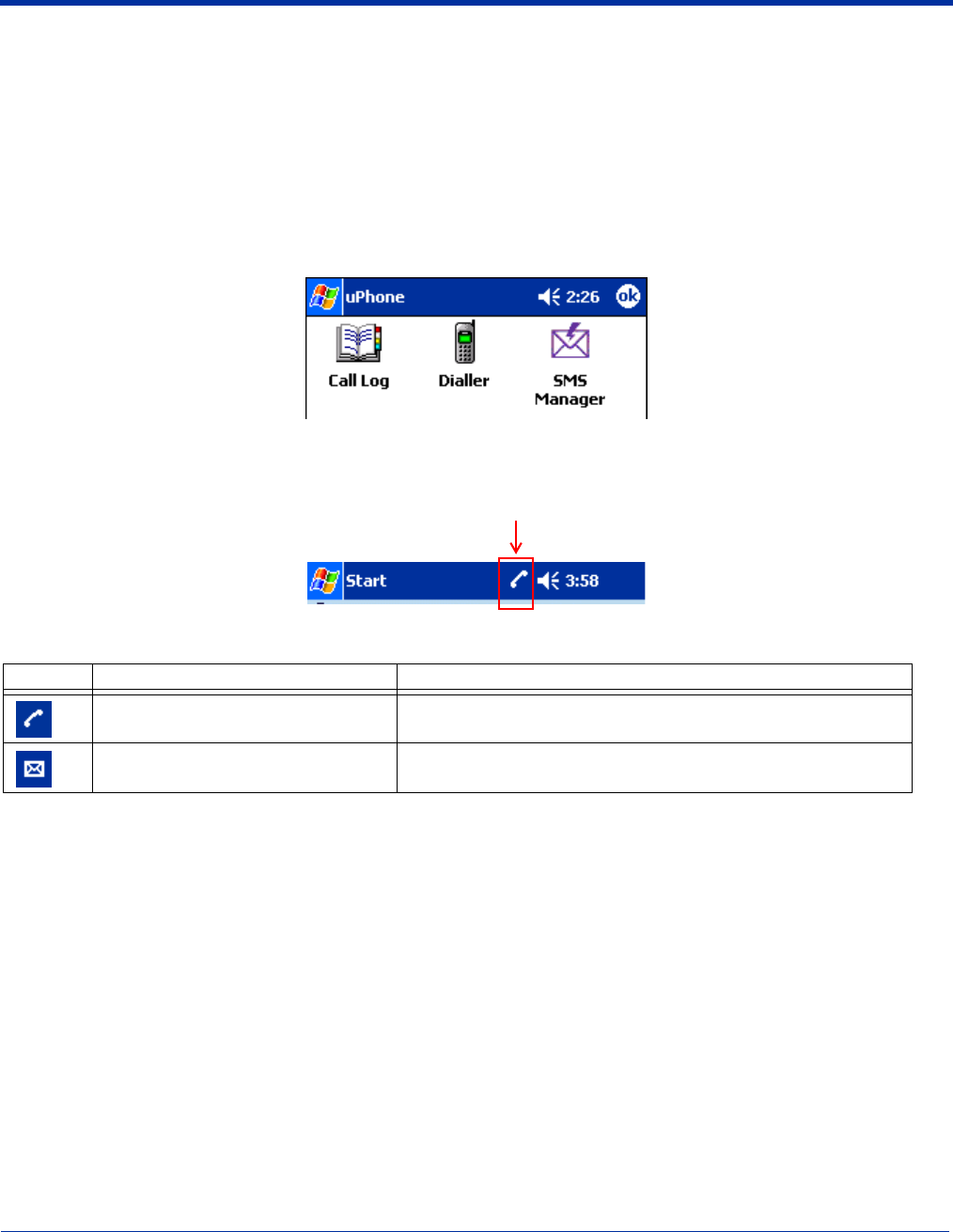
Dolphin® 9500/9550 Mobile Computer User’s Guide 9 - 3
Using uPhone
The uPhone Application Suite contains three programs that function together to provide a complete voice, data, and text
messaging solution for a mobile device fitted with a radio modem:
•Call Log enables you to view and manipulate a list of the most recent calls.
•Dialler emulates a mobile phone and is used to make and receive telephone calls.
•SMS Manager provides a text message handler similar to many email programs.
Accessing uPhone
Go to Start > Programs > uPhone. Tap one of the icons to launch the program.
Phone Status
The icon in the Navigation bar at the top of the screen indicates the status of the phone.
Status Icons
Icon This icon means… Tapping on this icon…
A call is in progress. Switches to the Dialler screen.
Incoming SMS message available. Switches to the SMS Manager where you can access you Inbox.
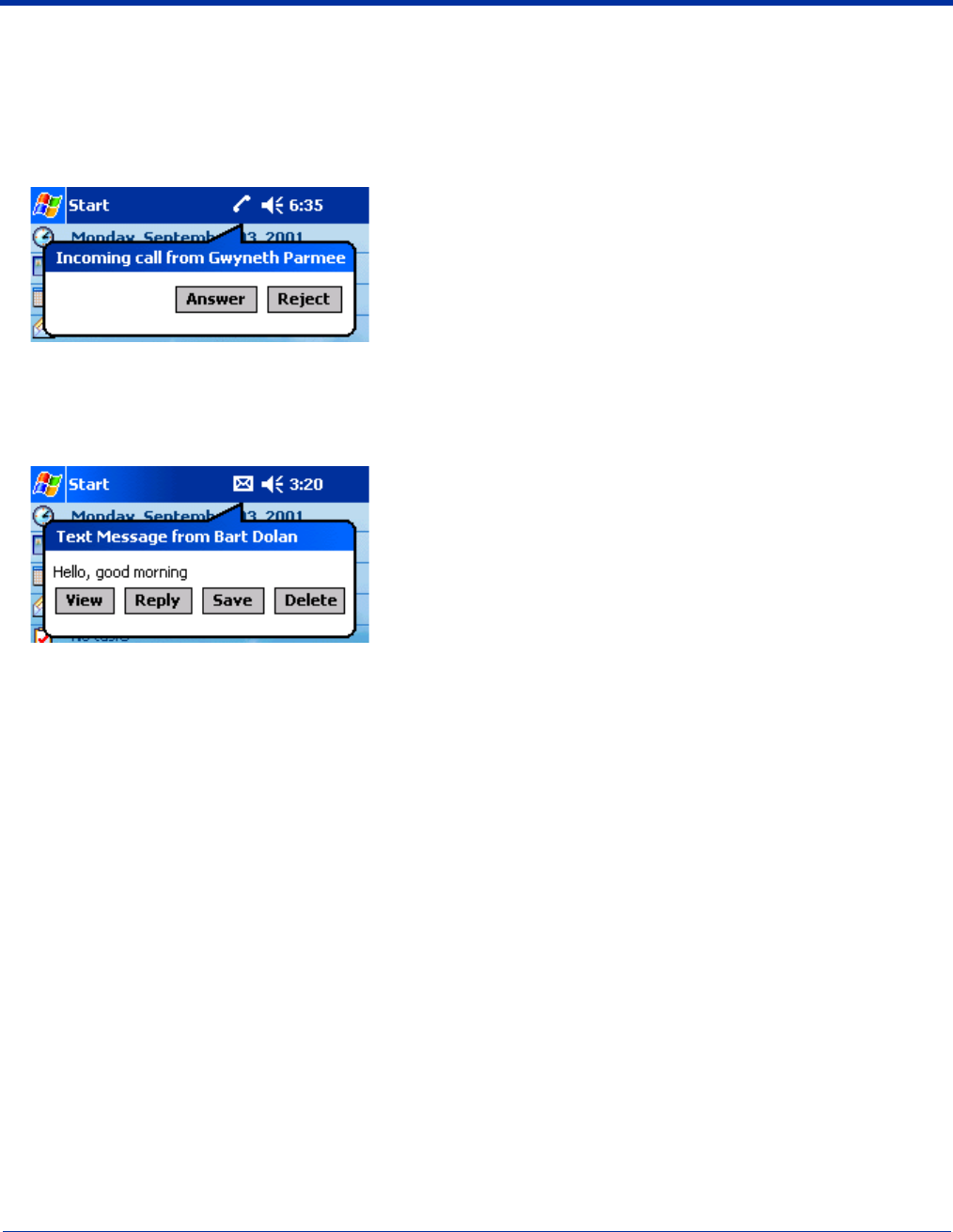
9 - 4 Dolphin® 9500/9550 Mobile Computer User’s Guide
Bubble Dialogs
If the Dialler or SMS Manager are not visible, the following bubble dialogs appear automatically:
Incoming Call
Incoming SMS Message Available
Displayed when an incoming call is received and the Dialler is not
visible. The caller’s name or number displays if it is in your Phonebook.
“No number" displays if the caller’s ID is not available. The ringtone is
played while the phone is ringing.
•Tap Answer to answer the call and open the Dialler.
Tapping Answer also places a current call on hold.
•Tap Reject to reject the call.
This bubble appears automatically when a new SMS message is
received. It displays the first few words of the message and provides
the following buttons:
•View - Displays the full message in the SMS Manager application.
•Reply - Switches to the SMS Manager Compose screen. The 'To:'
field us auto-filled with the sender’s address.
•Save - Puts the message in the SMS Manager Inbox.
•Delete - Deletes the message.
Tap a button to execute the command. The bubble closes
automatically.
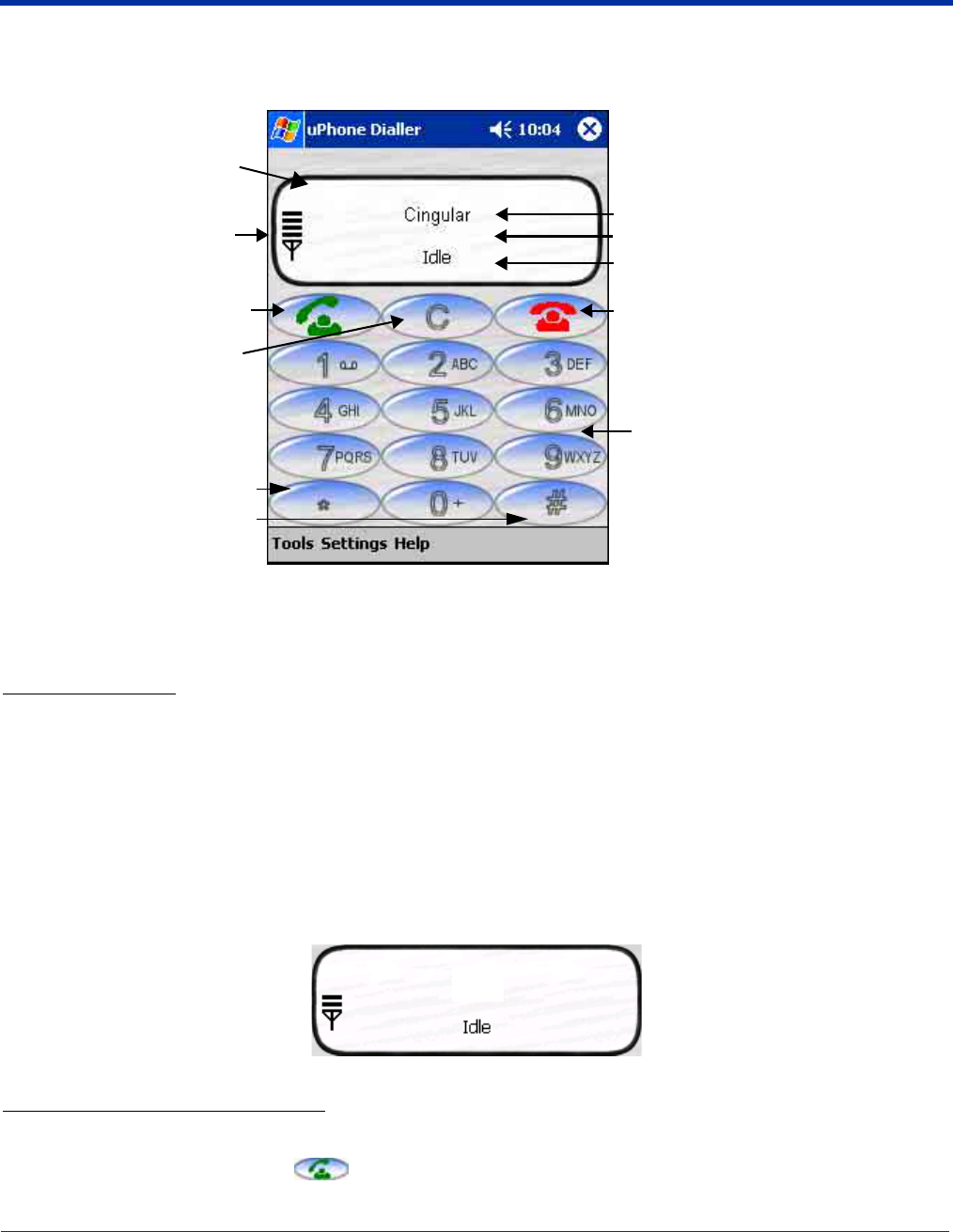
Dolphin® 9500/9550 Mobile Computer User’s Guide 9 - 5
Using the Dialler
To launch the Dialler, tap Start > Programs > uPhone > Dialler. The program launches and the uPhone Dialler screen opens:
Making a Call
To Enter a Number
You can:
• Enter the numbers manually using the phone keypad on the Dialler screen, the SIP, or the keyboard.
As you enter each number, it appears on the Dialler screen in the second information line. If a contact matching the entered
number is found in the Phonebook, the name of the contact appears in the second information line as you type; tapping on
the name enters the rest of the number automatically.
• Use the Phonebook to choose an existing contact.
Tap Tools > Phonebook, select a name or number, and tap OK (you can also tap and hold on the entry). The number is
automatically entered in the Dialler and appears on the screen.
• Use the Call Log.
When the phone is in Idle status, you can tap the Send button, press the ENTER key, or tap Tools > Call Log to see a list of
the last 20 calls made or received. Tap and hold on an entry in the list and select Dial. Note that pressing the Send button or
ENT key is available only when the phone is Idle.
To Send a Call To a Dialed Number
You can:
• Tap the Send button on the screen .
• Press the ENTER key on the keyboard.
• Press the appropriate key combination on the keyboard.
Information lines
1. Network Operator - name of service
provider.
2. Number/Name - number and/or name of
dialed, incoming, and outgoing calls
3. Status - displays the status of the phone.
Tap to end a call
Phone keypad - tap the numbers
to dial
Signal Strength -
Four bars is optimal for
transmission.
Tap to send (make) a call or
accept an incoming call
Dialler screen
Tap to clear the Dialler
Tap these buttons when * and #
are required for interactive voice
systems; also known as
touchtones.
Cingular
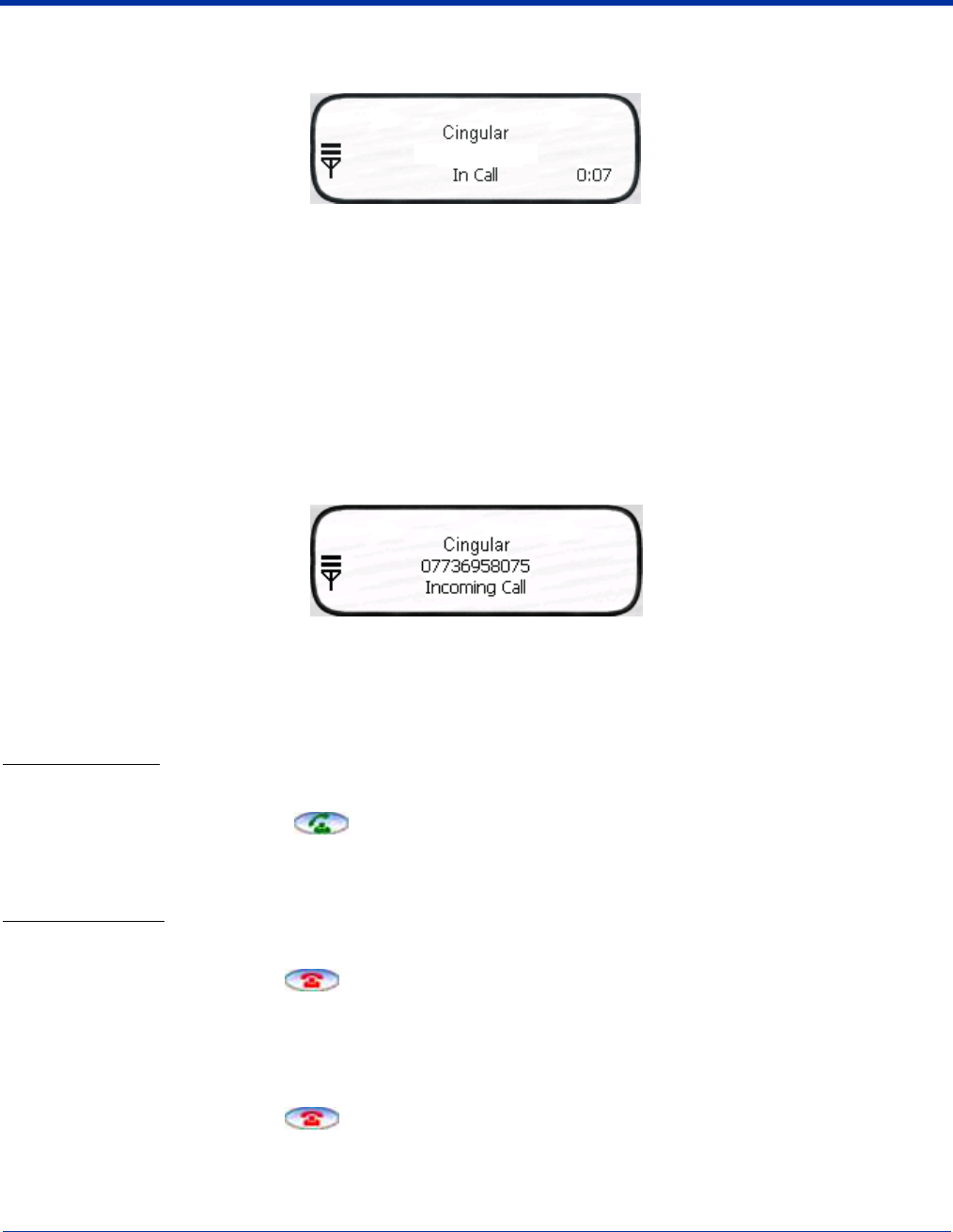
9 - 6 Dolphin® 9500/9550 Mobile Computer User’s Guide
When the call is connected, the three information lines display the following:
Network Operator Displays the name of the service provider you are using.
Name/Number Displays the name and/or number you called. If the number is from your Phonebook, that entry
displays.
Status The status of the call. Idle means no calls are incoming or outgoing, In Call means a phone call is in
progress, Incoming Call means that a a call is coming in.
The numbers in the lower, right corner display the minutes:seconds that have elapsed.
Receiving a Call
When the Dialler screen is open and an incoming call is detected, text is displayed on the Dialler screen. If the Dialler is not visible
at the time of the incoming call, a Navigation Bar notification appears, showing the name or number of the incoming call, with
options to accept or reject the call; see Incoming Call on page 9-4.
When a call is coming in, the ringtone sounds and the three information lines on the Dialler screen display the following:
Network Operator Displays the name of the service provider you are using.
Name/Number Displays the name and/or number calling in. If the number is from your Phonebook, that entry
displays.
Status Incoming Call.
To Answer a Call
You can:
• Tap the Send button on the screen .
• Press the ENTER key on the keyboard.
• Press the appropriate key combination on the keyboard.
To Reject the Call
You can:
• Tap the End button on the screen .
• Press the appropriate key combination on the keyboard.
Ending a Call
To end or reject a call at any time, you can:
• Tap the End button on the screen .
• Press the appropriate key combination on the keyboard.
Joe Smith
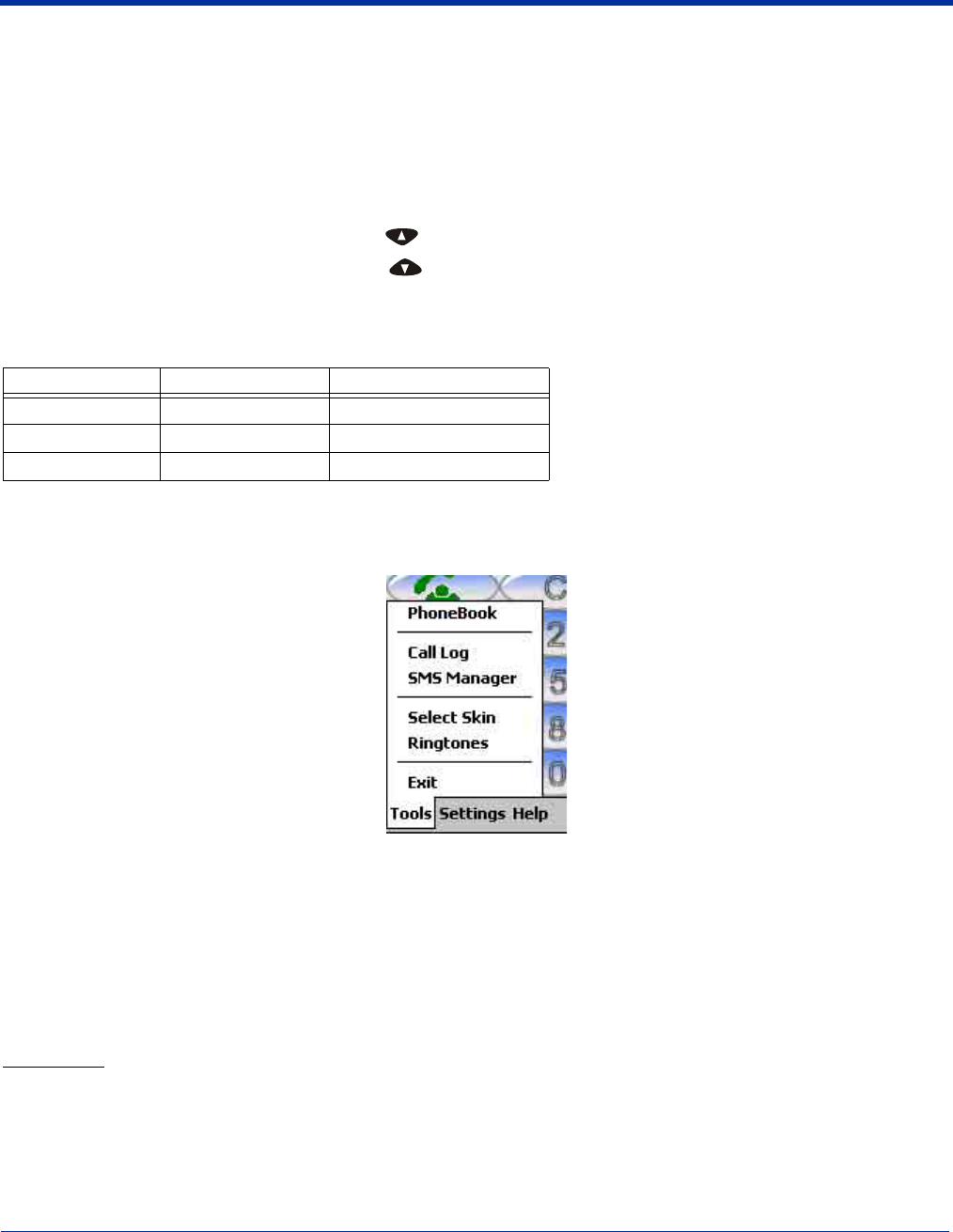
Dolphin® 9500/9550 Mobile Computer User’s Guide 9 - 7
Touchtones
To transmit touchtones for interactive voice systems while in a call, you can
• Tap the 0-9, *, and # buttons on the uPhone Dialler screen.
• Press 0-9 keys on the Dolphin keyboard; use the uPhone Dialler screen buttons for * and #.
Vol um e C o n t r o l
Use the Dolphin keyboard to manually adjust the volume.
To raise the volume, press the Blue modifier key + (VOL+)
To lower the volume, press the Blue modifier key + (VOL-)
Tools Menu
The Tools menu provides the following options:
Select this item To…
Phonebook Display the Phonebook.
Call Log Switch to the Call Log.
SMS Manager Switch to the SMS Manager Inbox.
Select Skin Allow selection of a new skin for the uPhone Dialler application.
Ringtones Switch to the ring tone selection control panel.
Exit Exit the uPhone Dialler.
Phonebook
The Phonebook contains the contacts from the SIM card and Pocket Contacts. If fixed dialing is set in the SIM, then only those
numbers in the fixed dialing list are shown in the Phonebook, and only these numbers can be called from the Dialler.
Keyboard Combinations To Send and End a Call
Each keyboard option contains a key combination to send and end a call using the Red modifier key.
Keyboard To Send, Press… To End (reject), Press…
35-key keyboard Red + SP Red + DEL
43-key keyboard Red + D Red + H
56-key keyboard Red + 3 Red + 6
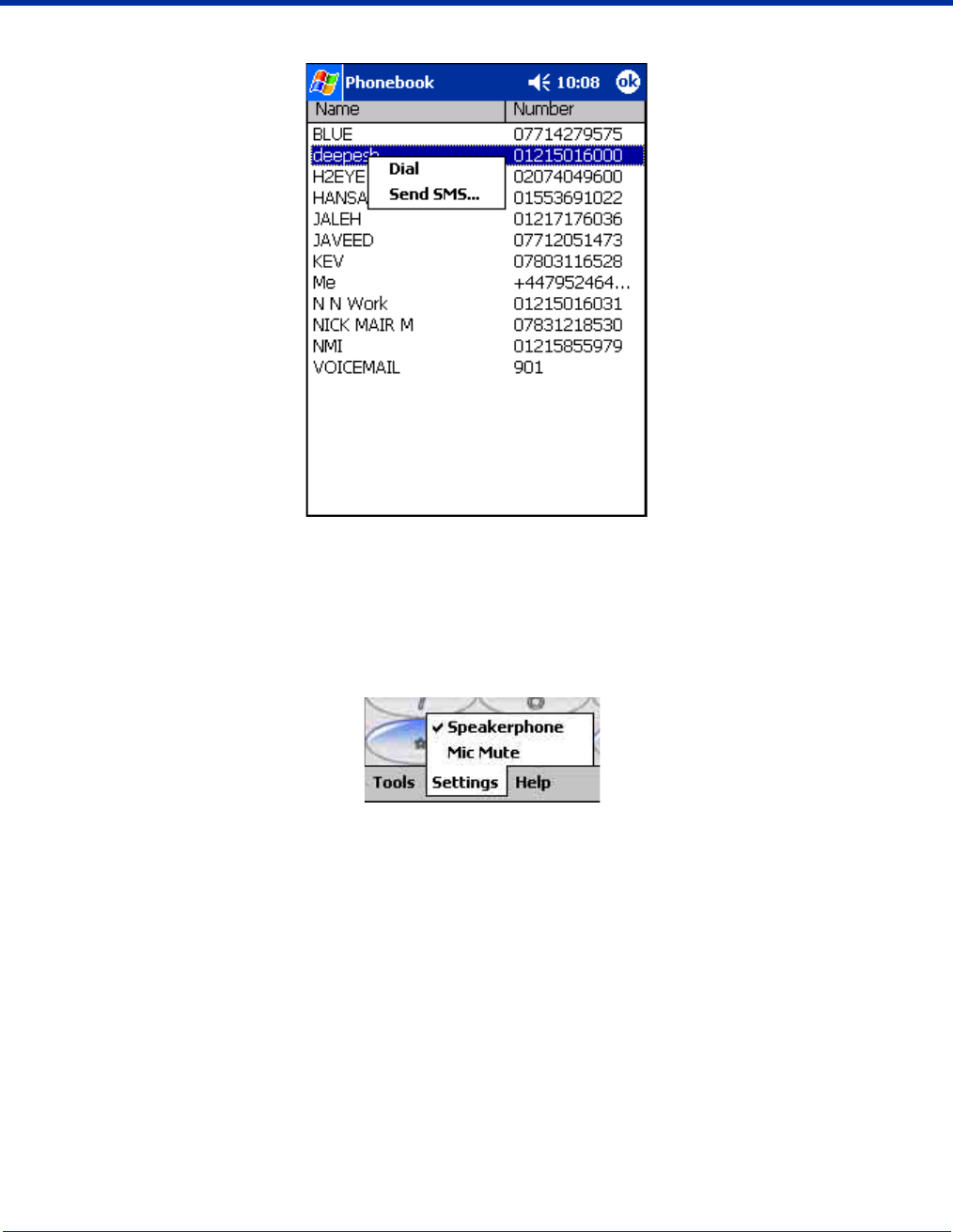
9 - 8 Dolphin® 9500/9550 Mobile Computer User’s Guide
You can access the Phonebook manually by opening the Dialler and going to Tools > Phonebook.
When you tap and hold on an entry, a popup menu displays the following options:
Dial Opens the Dialler with the number entered ready for dialing.
Send SMS Opens the SMS Manager in the Compose screen with the 'To:' field populated with the number.
Settings Menu
The Settings menu provides the following options:
Speakerphone Toggles speakerphone mode on and off. When an audio plug (for a headset) is inserted into the audio
jack (2.5mm), Speakerphone is inactive on this menu.
Mic mute Toggles microphone mute on and off (the other party cannot hear a private conversation when the
microphone is muted). This mode is active only during a call and automatically cancelled at the end
of a call.
A checkmark to the left of the entry indicates that the mode is active. When the entry is grayed-out, it is unavailable and cannot
be selected.

Dolphin® 9500/9550 Mobile Computer User’s Guide 9 - 9
Audio Modes
The back panel of the Dolphin 9500 contains both a speaker and a microphone that you can use to send and receive audio
signals over the GSM network. For details about the microphone and speaker on the back panel of the Dolphin 9500, see Back
Panel Features on page 3-4.
There are three audio modes:
1. Handset
2. Headset
3. Hands-free (speakerphone)
Handset
Handset mode is when you use the use the back panel of the terminal just as you would a cell phone, holding the speaker to your
ear to receive audio information and the your mouth over the microphone to send audio information.
This is the default audio mode.
Headset
Headset mode is when you plug an audio plug into the audio jack and speak into the microphone. You must use a 2.5mm plug;
not other audio plug will fit.
Hands-Free
Hands-free mode is when you use the back panel of the Dolphin 9500 as a speakerphone.
To switch the back panel to speakerphone, in the Dialler, tap Settings > Speakerphone. The audio levels adjust appropriately
for speakerphone use. For more information, see Settings Menu on page 9-8.
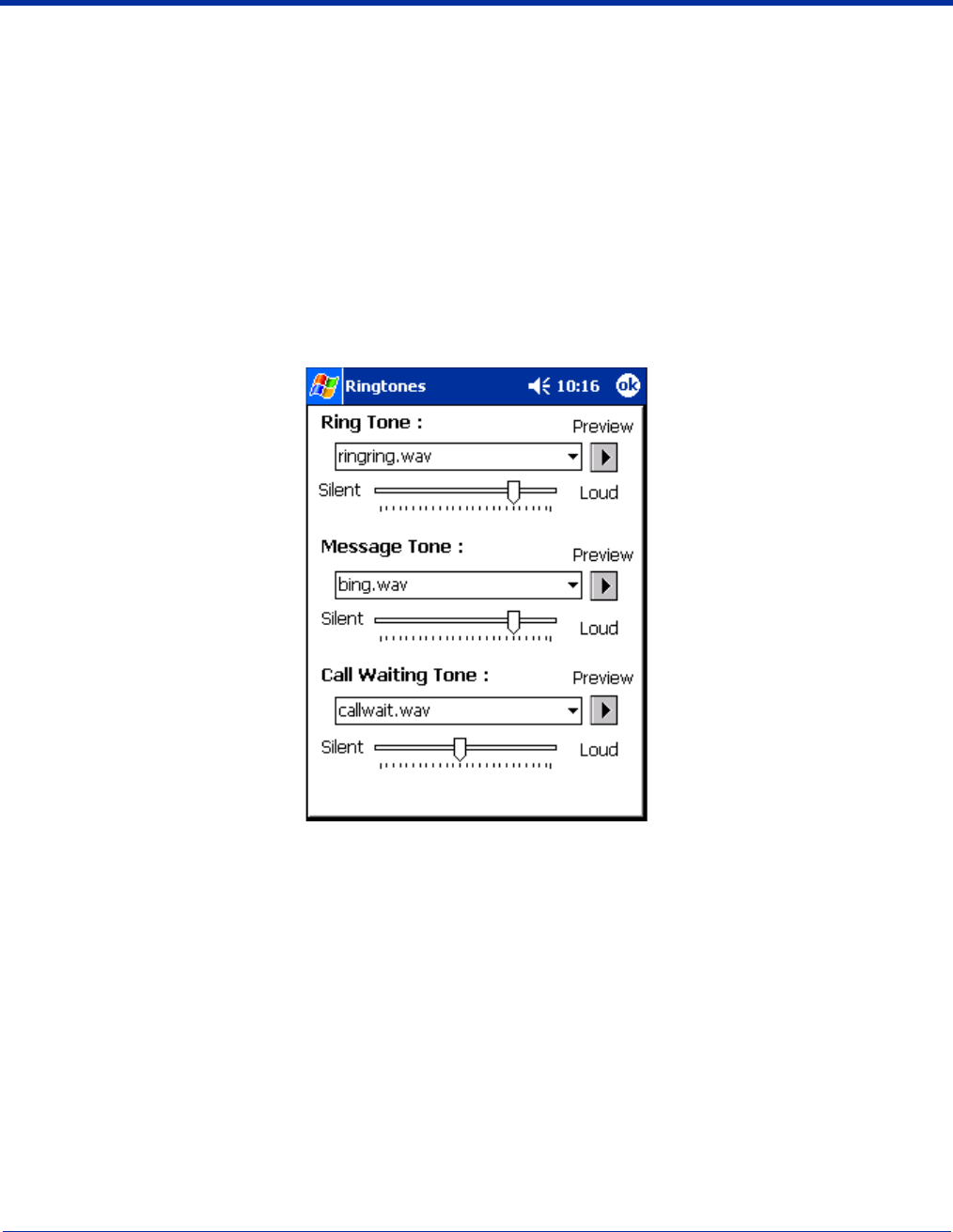
9 - 10 Dolphin® 9500/9550 Mobile Computer User’s Guide
Ringtone Configuration
Different ringtones, with individual volume settings, can be set for the following:
Ring Tone Sounds on an incoming call.
Message Tone Sounds on an incoming SMS or Voicemail notification.
Call Waiting Tone Sounds to indicate an incoming call while you are already on a voice call.
Accessing Ringtone Configuration
You can access Ringtones two ways:
1. Go to Start > Settings > Personal tab > Ringtones icon OR
2. Open the Dialler (tap Start > Programs > uPhone > Dialler) and go to Tools > Ringtones.
The Ringtones screen opens displaying the current settings.
Select the desired ringtone for each type of tone in the drop-down lists. Tapping OK saves any changes. Opening another screen
without tapping OK discards any changes.
WAV Files
You can customize your ringtones with *.wav files installed on your terminal. To appear here, *.wav files must be stored in the
Programs Files > uPhone >Ring Tones folder.
Previewing Tones
You can preview each tone by selecting the *.wav file in the drop-down list and tapping the Preview button. Use the slider to set
the volume for each tone.
While the tone is playing, the Preview button changes to a Stop button; tap it to stop the preview.
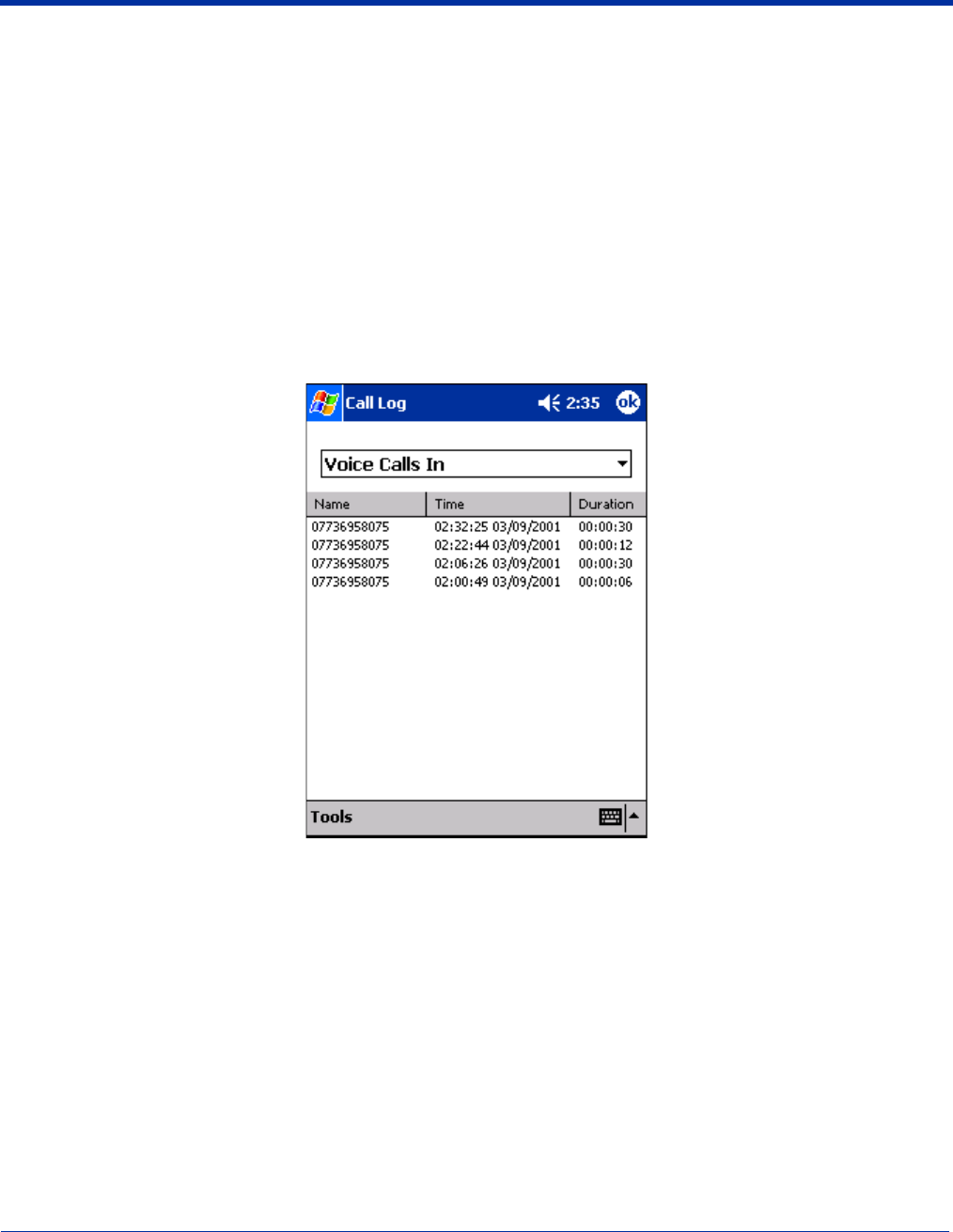
Dolphin® 9500/9550 Mobile Computer User’s Guide 9 - 11
Call Log
The Call Log maintains a list of the last 20 calls made or received in each of the following categories:
• Voice Calls In
• Voice Calls Out
• Voice Calls Missed
Voice Call In is the default display whenever the Call Log is opened.
Opening the Call Log
You can access the Call Log two ways:
1. Go to Start > Programs > uPhone > Call Log) OR
2. Open the Dialler (go to Tools > Call Log).
The Call Log opens displaying the last few Voice Calls In; the most recent call always appears at the top.
This column Displays the …
Name The phone number or the name if the call was from or to a matching entry in the Phonebook.
Time Time and date the call started. This is the local time and date.
Duration Duration of the call (hours:minutes:seconds). The clock starts when the call connects, not when
dialed.
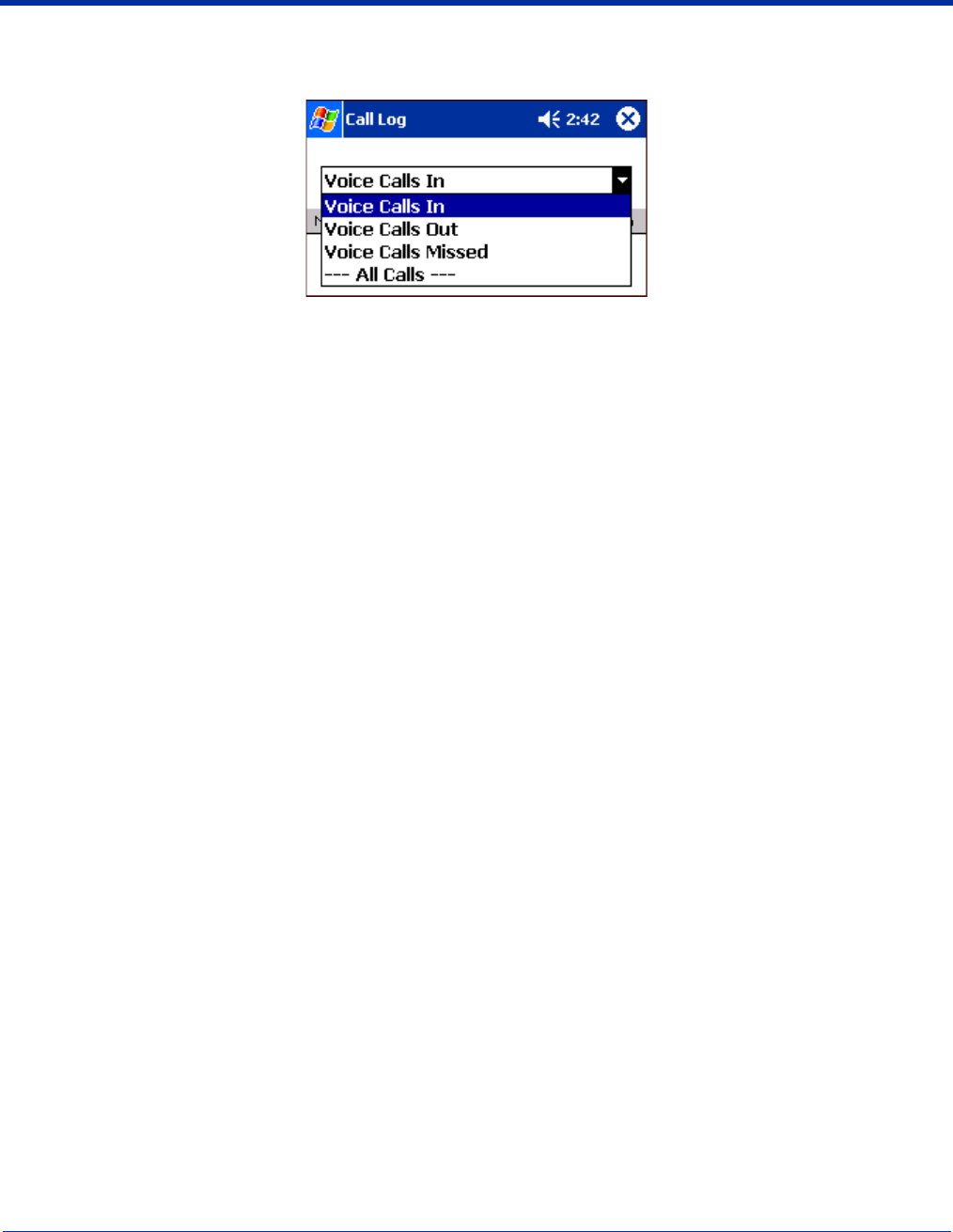
9 - 12 Dolphin® 9500/9550 Mobile Computer User’s Guide
Call Log Options
Voice Calls Out and Voice Calls Missed are available from the drop-down list. Select the option you want to view.
To see everything, select All Calls.
Tools Menu
The Tools menu in the Call Log provides you with the following options:
Select this menu option To…
Clear Delete the entire Call Log.
Exit Close the Call Log.
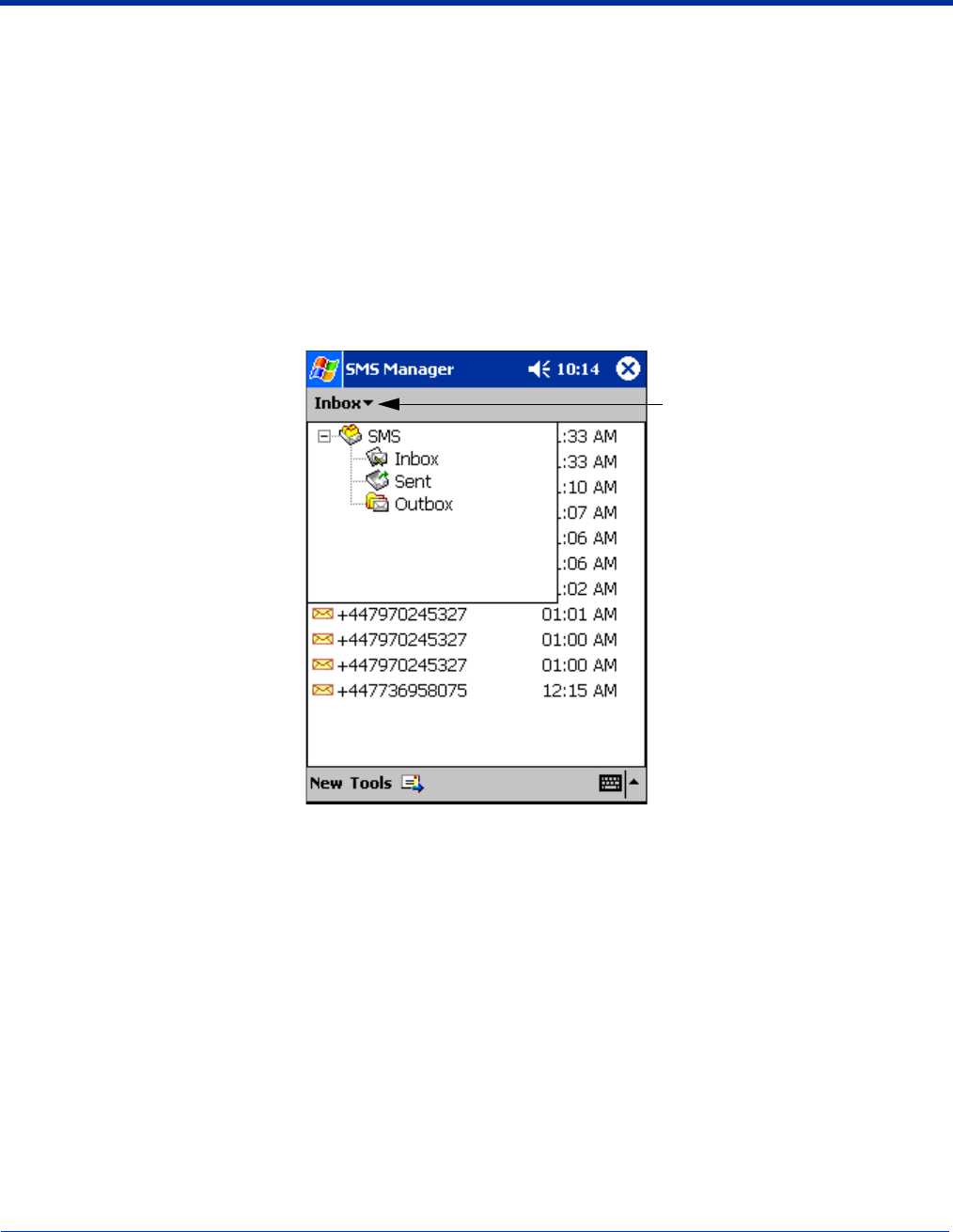
Dolphin® 9500/9550 Mobile Computer User’s Guide 9 - 13
SMS Manager
Abbreviated for Short Message Service, SMS enables the transmission of short messages (140-160 characters) to and from a
cell phone. SMS messages travel over the system's control channel, which is separate from the voice channel.
The SMS Manager on the Dolphin 9500 supports creation, sending, receiving, and storing of SMS text messages. Text
messages sent or received can be up to 160 characters long.
Opening the SMS Manager
You can access the SMS Manager two ways:
1. Go to Start > Programs > uPhone > SMS Manager, OR
2. Open the Dialler (Start > Programs > uPhone > Dialler) and go to Tools > SMS Manager.
The SMS Manager opens displaying a list of your most recent text messages. Tap the Inbox and the SMS folders drop-down.
Three folders are available from the Inbox menu:
Select this folder To see…
Inbox Received text messages.
Sent Sent text messages.
Outbox Text messages waiting to be sent (messages are moved to the Sent folder automatically after
transmission).
Tap here
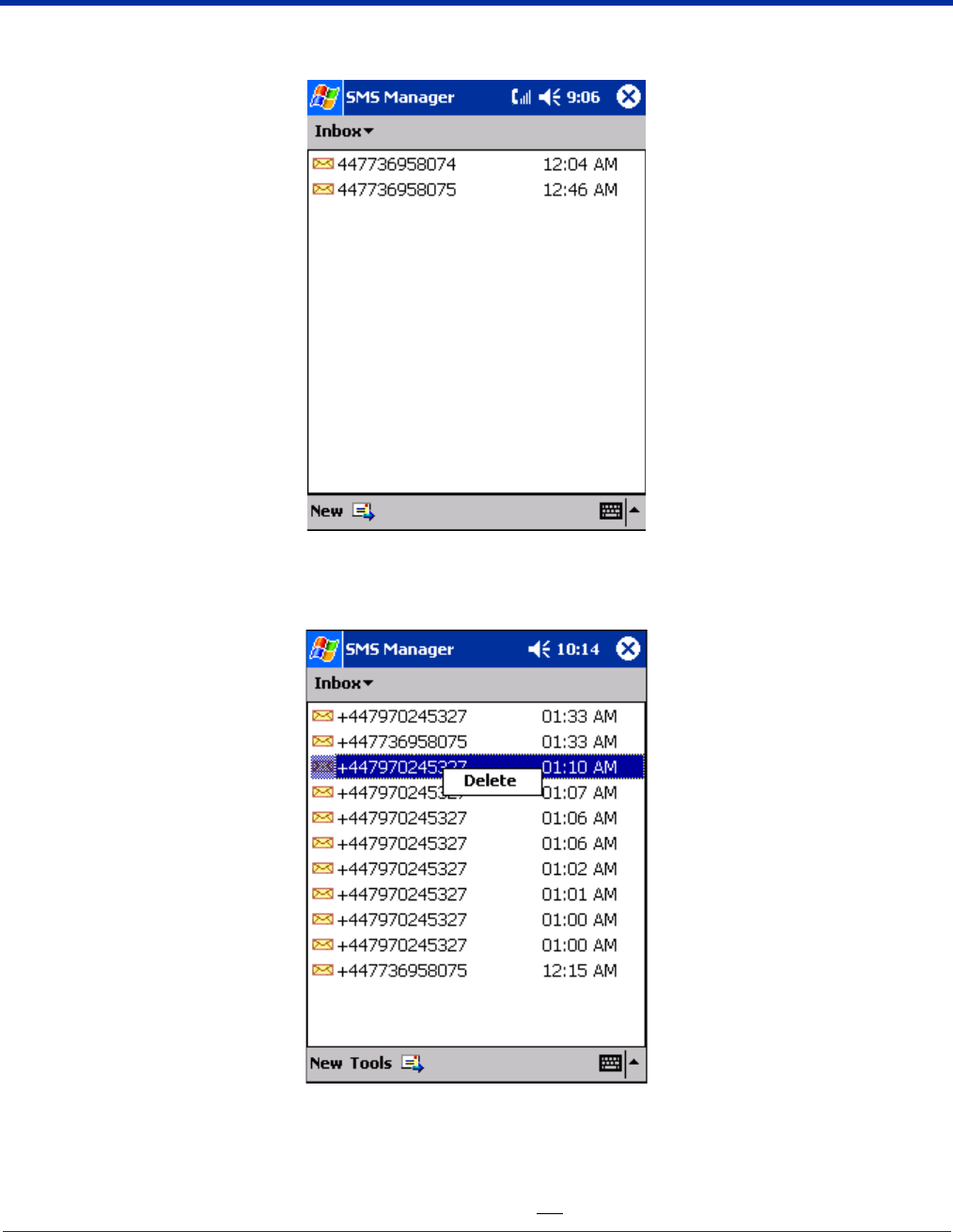
9 - 14 Dolphin® 9500/9550 Mobile Computer User’s Guide
When the folder is selected, the messages in it appear in the list. The name of the folder appears in the gray bar just under the
title bar.
To Do this…
Open a message Tap on it in the list.
Delete a message Tap and hold on it in the list. A popup menu appears that enables you to delete the message.
Sending an SMS Message
1. In the task tray at the bottom of the screen, tap New. The new message screen opens with the cursor active in the text area.
2. Tap inside the To: field. To add the number, you can type it in or tap To: to select an entry from your Phonebook.
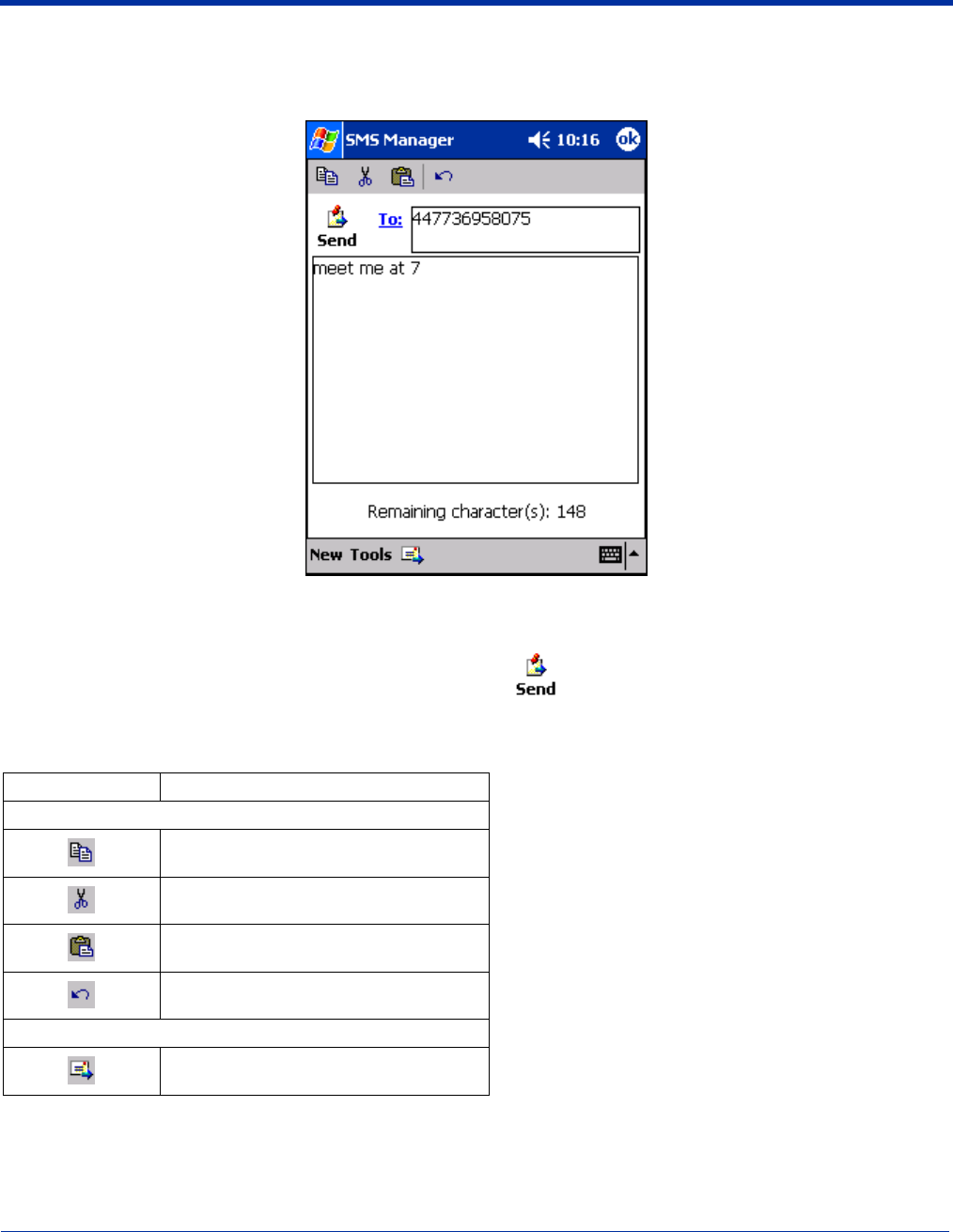
Dolphin® 9500/9550 Mobile Computer User’s Guide 9 - 15
• You must type a number that is in the appropriate international ISDN format for the country you are dialing. However,
you can dial a local number without the country code.
• Destination numbers can start with a “+” sign.
3. Tap inside the text area. To write a message, you can use the SIP or the keyboard.
The Remaining characters field displays how many characters you can type. It counts backwards from 160 as you type each
character.
4. When finished typing, tap the Send icon to transmit the message .
If you tap OK before tapping send, the program requests confirmation before discarding the message.
Online Help
Tapping Help > About provides information about the uPhone applications.
Icons
Tap this icon To…
At the top of the window:
Copy selected text.
Cut selected text.
Paste text.
Undo the previous action.
In the task tray at the bottom of the window:
Send all messages in the Outbox.
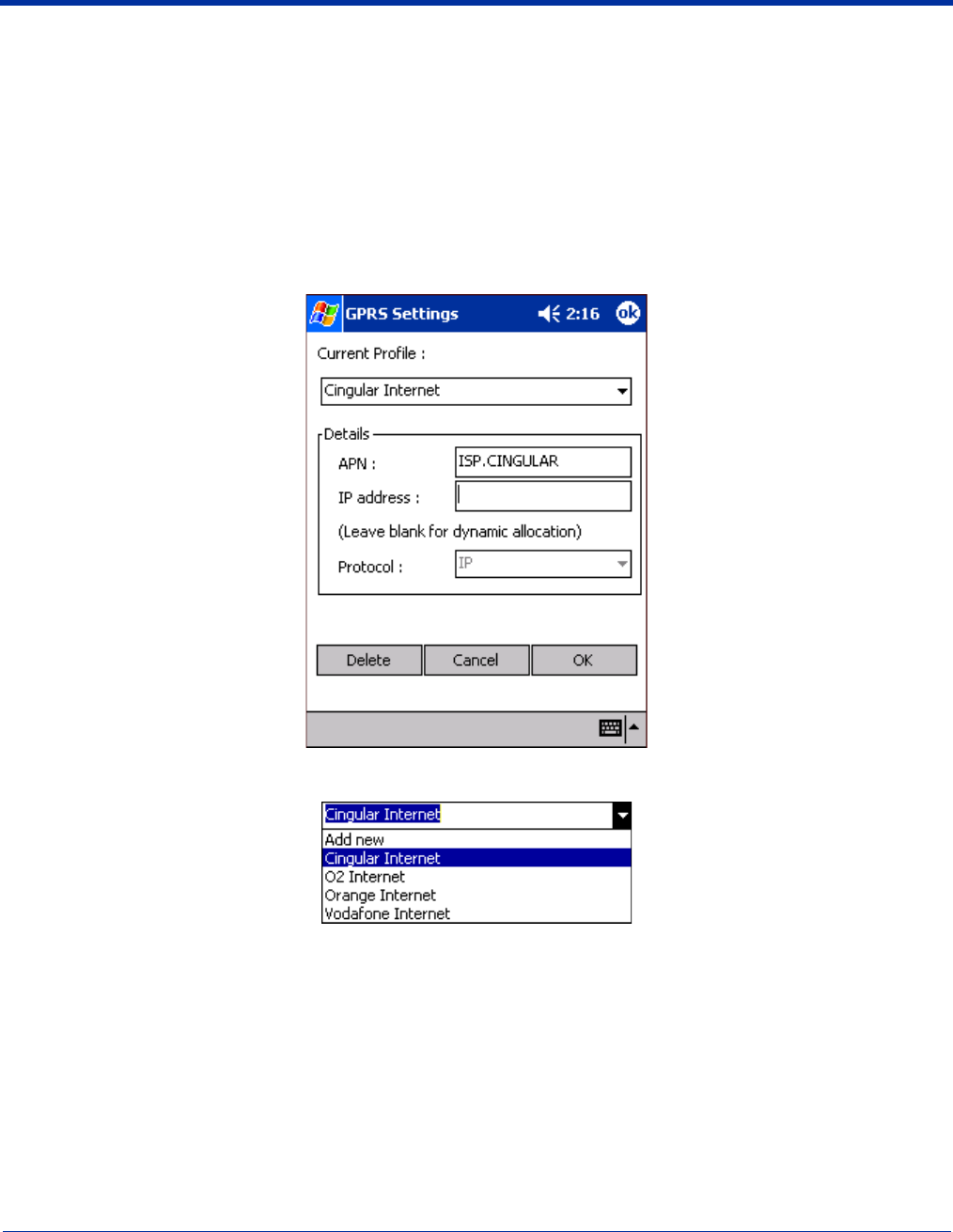
9 - 16 Dolphin® 9500/9550 Mobile Computer User’s Guide
GPRS Settings
After subscribing to a GPRS network and installing your SIM card, you can load the parameters of your GPRS subscription into
the terminal. However, some subscriptions load automatically when you install your SIM card. If the GPRS settings do not load
automatically, you must enter them manually.
uPhone includes a pre-configured GPRS connection in Internet Settings. You need to select or create GPRS settings prior to
making a GPRS call for the first time. You can also configure GPRS settings for browsing the web via a VPN or Proxy Server.
To Select Pre-Configured GPRS Settings
1. Go to Start > System > Connections tab > uPhone GPRS. The GPRS Settings screen appears displaying the default
setting.
The Current Profile drop-down list contains a number of pre-configured connection profiles.
2. If the profile associated with your account appears in the list, select it. If it does not appear in the Current Profile list, you need
to create one. For details, see To Add a GPRS Setting on page 9-17.
3. In the Details section
• Type in the APN number
• Type in the IP address
• Select the Protocol
4. Tap OK to save.
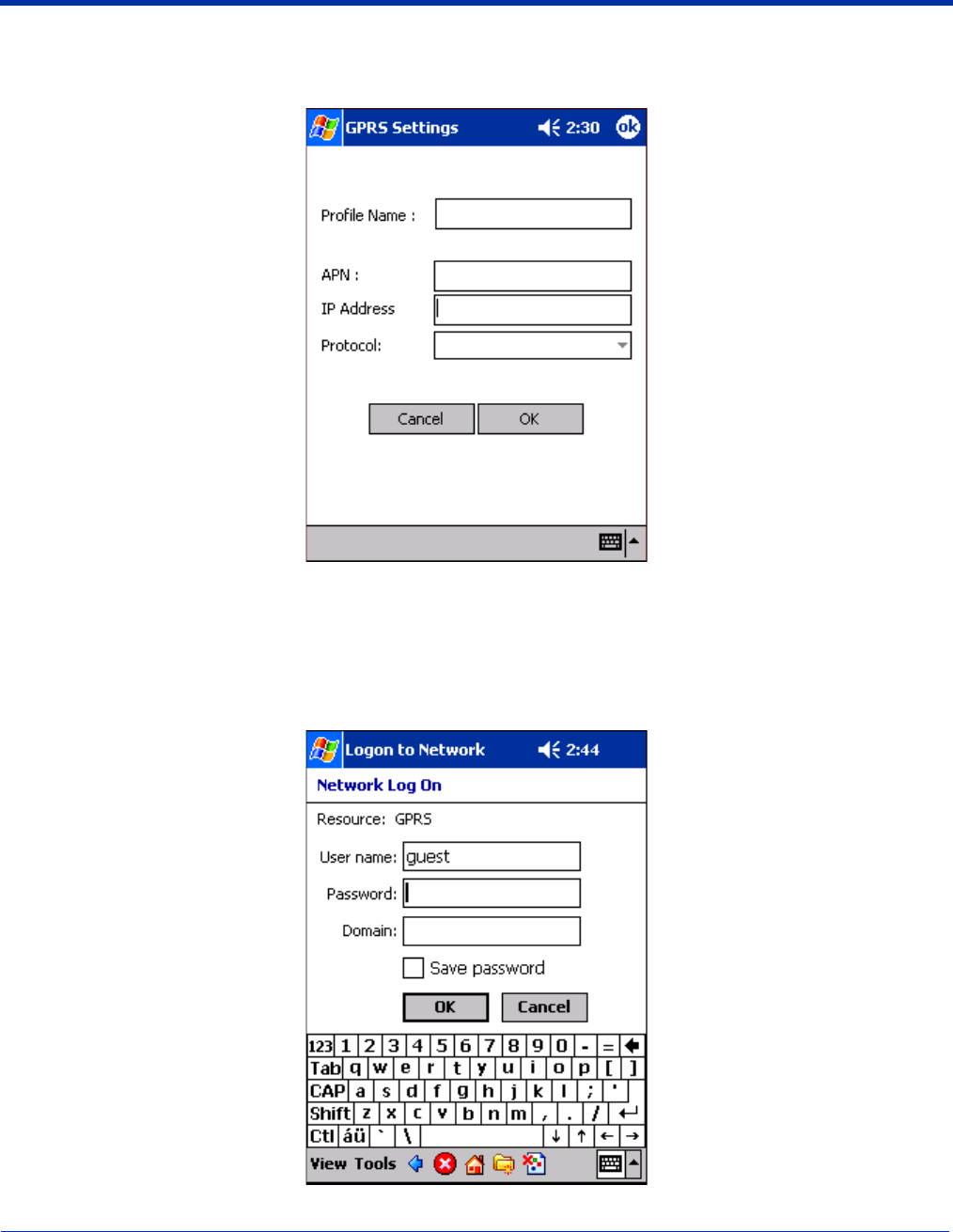
Dolphin® 9500/9550 Mobile Computer User’s Guide 9 - 17
To Add a GPRS Setting
1. On the GPRS Settings screen, in the Current Profile drop-down list, select Add new.
2. Type in the Profile Name, APN, IP Address, and select the Protocol.
3. Tap OK. You return to the settings screen. The Profile Name you selected now appears in the Current Profiles list.
GPRS Connection
When a GPRS connection is required - e.g., by navigating to a web site - a Network Log On screen is automatically displayed.
Enter the Password and Domain, then tap OK to connect.
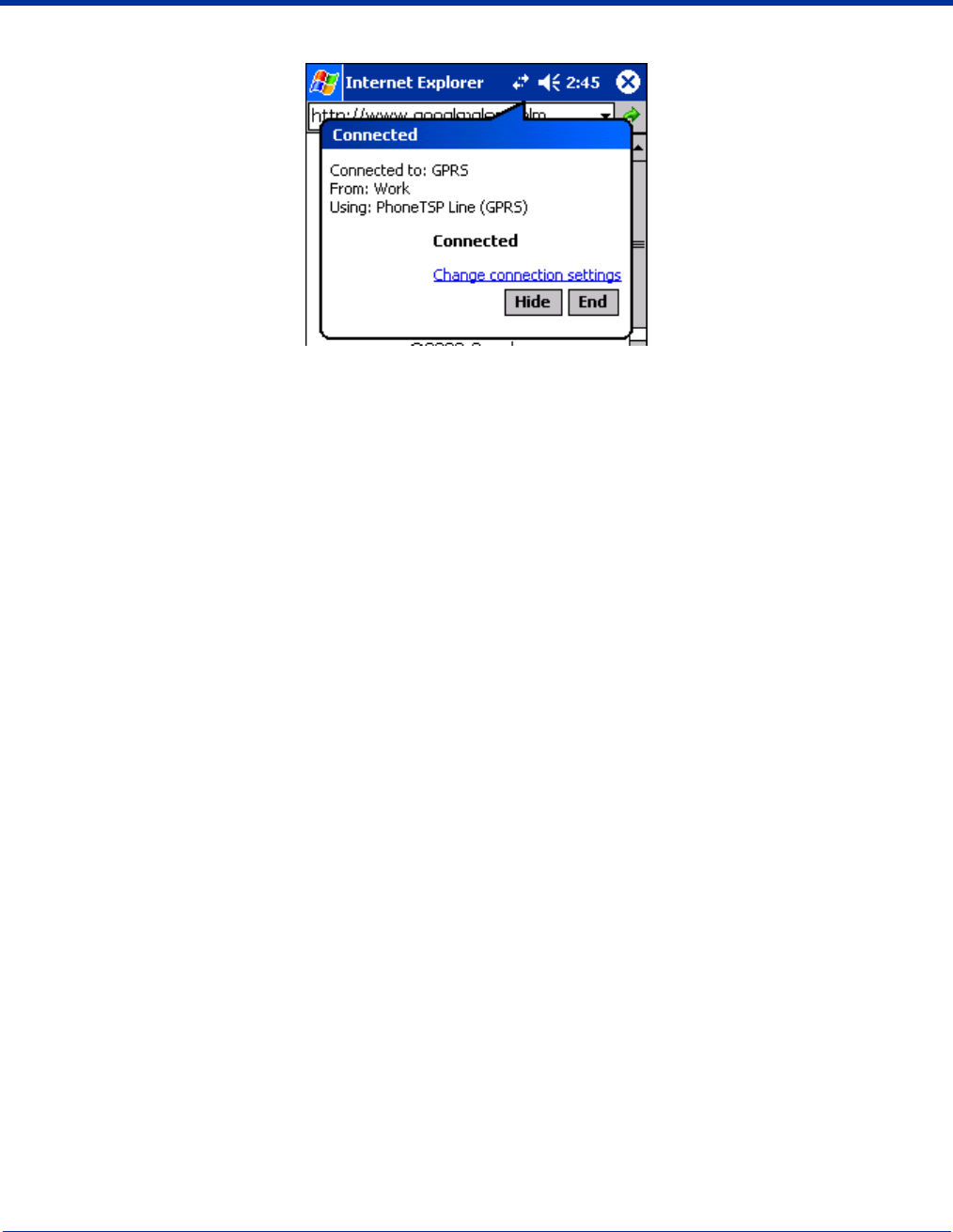
9 - 18 Dolphin® 9500/9550 Mobile Computer User’s Guide
You have the option of disconnecting by tapping on the GPRS connection icon in the navigation bar and tapping End.
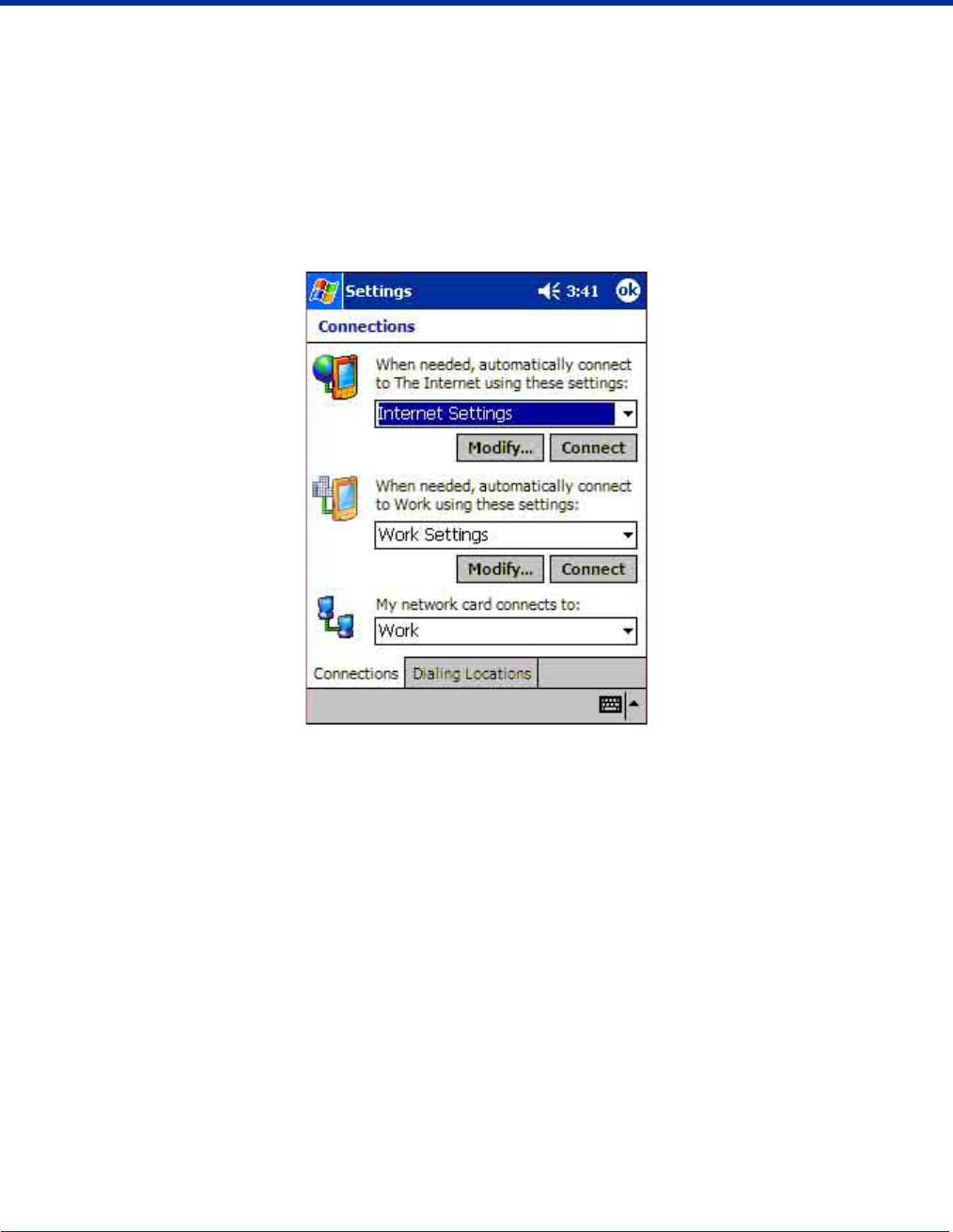
Dolphin® 9500/9550 Mobile Computer User’s Guide 9 - 19
Establishing GPRS Internet Settings
Because GSM/GPRS technology uses a network connection, you need to configure Internet Settings or Work Settings to use
GPRS parameters in the Connection Manager.
Note: Make sure that you are not using ActiveSync when configuring the connection settings.
Note: Please note that the following instructions are a generic overview. To establish a GPRS connection, you need to review
the information from your network service provider. Given that there can be so many different configurations, such as VPN
or Proxy Server connections, see Connection Settings on page 5-16 for instruction about how to set up each kind of
connection.
1. Go to Start > Settings > Connections tab > Connections. The Connection Settings screen appears.
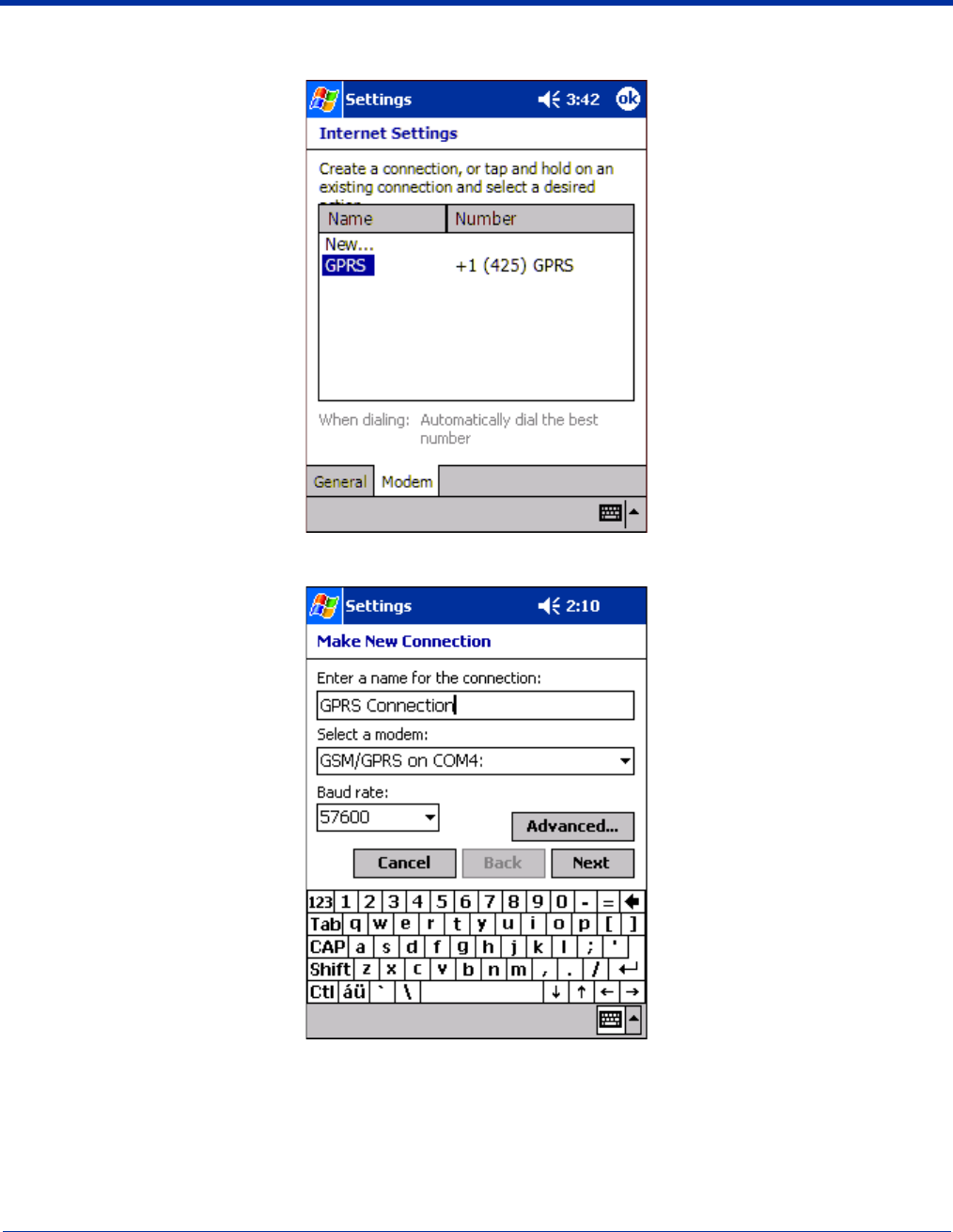
9 - 20 Dolphin® 9500/9550 Mobile Computer User’s Guide
2. Select Internet Settings and tap Modify. The Internet Settings screen appears displaying the current internet setting for
GPRS on the Modem tab.
3. Tap New. The Make a New Connection screen appears.
4. Enter a name for the connection; something that indicates that this is the GPRS connection is recommended.
5. Select a modem from the drop-down list.
6. Select a Baud rate from the drop-down lists; 57600 is recommended for optimal performance.
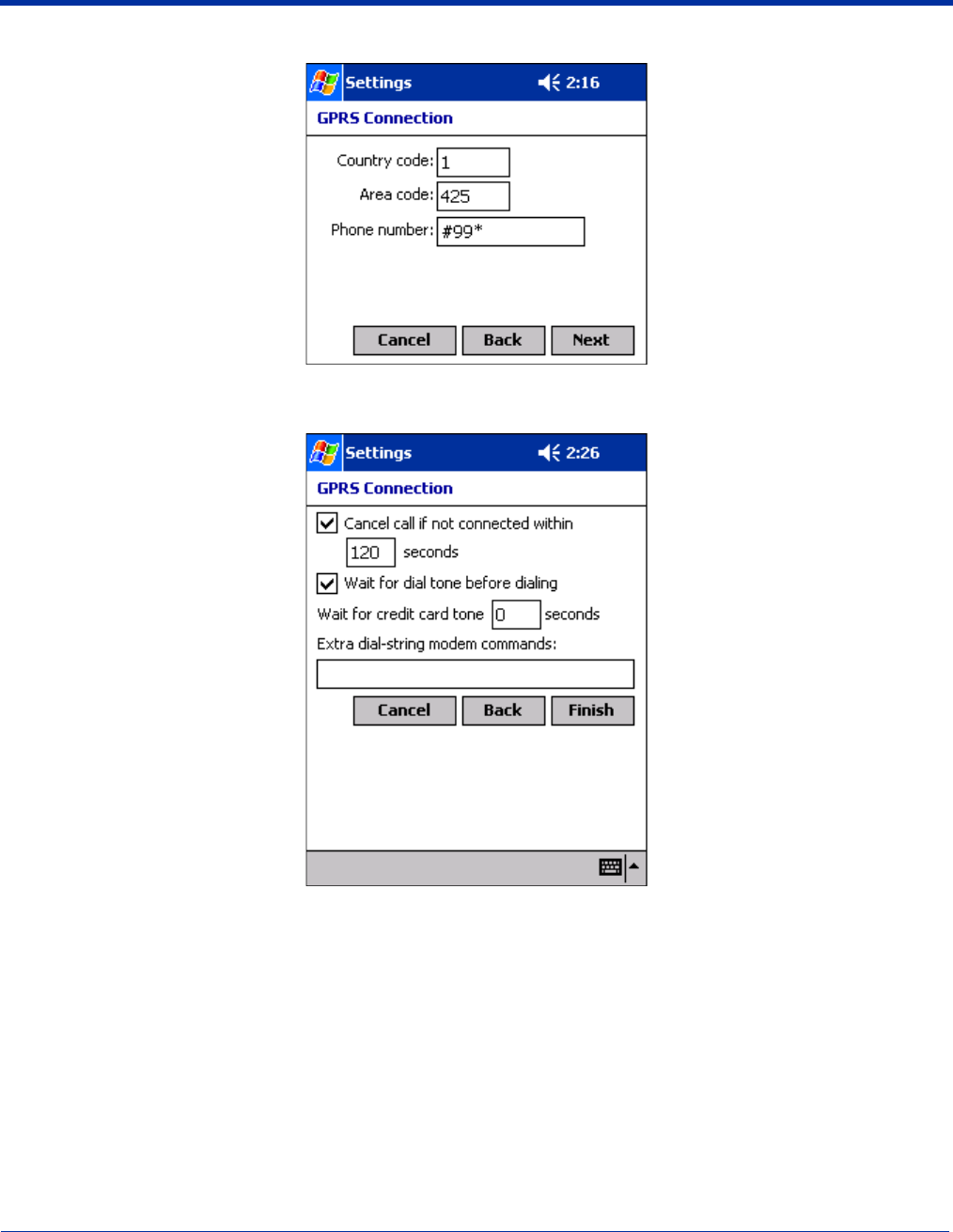
Dolphin® 9500/9550 Mobile Computer User’s Guide 9 - 21
7. Tap Next. Another screen appears asking for the exact phone number.
8. This information is available only from the network service provider you are using for GPRS. “#99*” is the generic dialing
number for GPRS. Enter the number and tap Next.
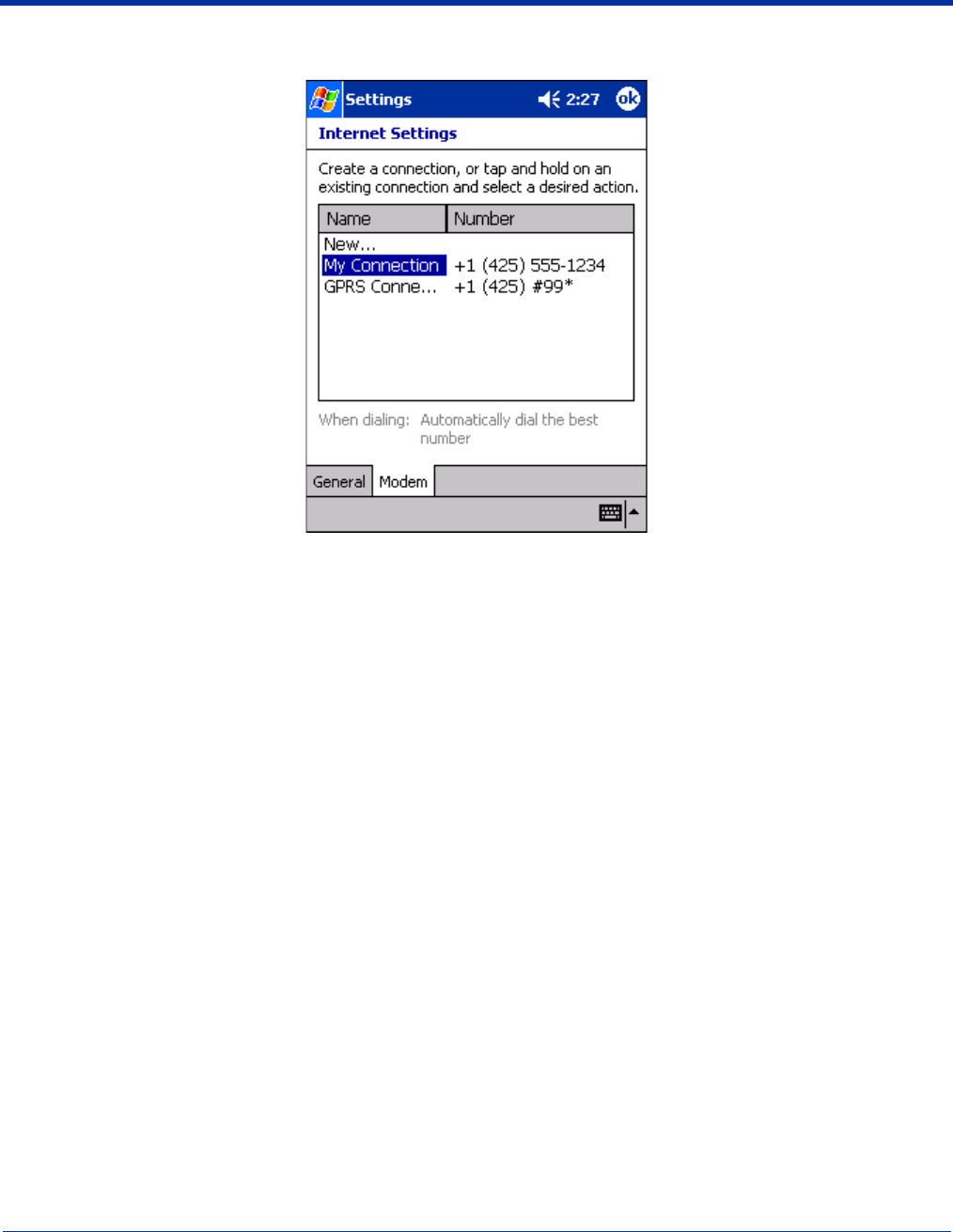
9 - 22 Dolphin® 9500/9550 Mobile Computer User’s Guide
9. Enter the information and tap Finish. You are returned to the Internet Settings screen with the connection you just
established displaying in the list.
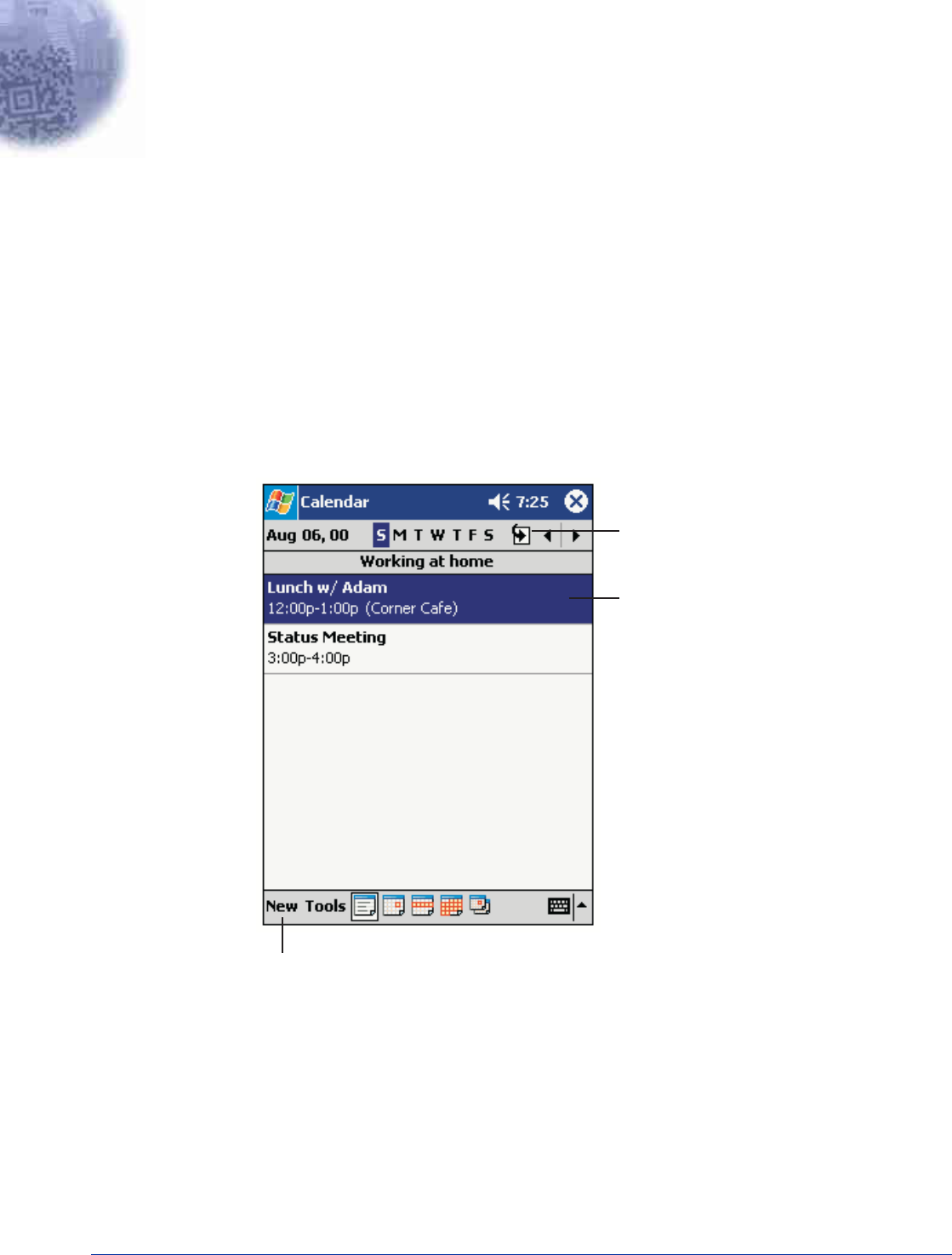
Dolphin® 9500/9550 Mobile Computer User’s Guide - GSM Draft 10 - 1
10
Applications
Microsoft Pocket Outlook includes Calendar, Contacts, Tasks, Inbox, and Notes. You can use these programs individually or
together. For example, e-mail addresses stored in Contacts can be used to address e-mail messages in Inbox.
Using Microsoft ActiveSync, you can synchronize information in Microsoft Outlook or Microsoft® Exchange Server on your
desktop computer with your device. You can also synchronize this information directly with a Microsoft Exchange server. Each
time you synchronize, ActiveSync compares the changes you made on your device and desktop computer or server and updates
both computers with the latest information. For information about using ActiveSync, see ActiveSync Help on the desktop
computer.
You can switch to any of these programs by tapping them on the Start menu.
Calendar: Scheduling Appointments and Meetings
Use Calendar to schedule appointments, including meetings and other events. You can check your appointments in one of
several views (Agenda, Day, Week, Month, and Year) and easily switch views by using the View menu.
Note: You can customize the Calendar display, such as changing the first day of the week, by tapping Options on the Tools
menu.
To Create an Appointment
1. If you are in Day or Week view, tap the desired date and time for the appointment.
2. Tap New.
Tap to go to today.
Tap to display or edit
the appointment details.
Tap to create a new appointment.
Calendar Application
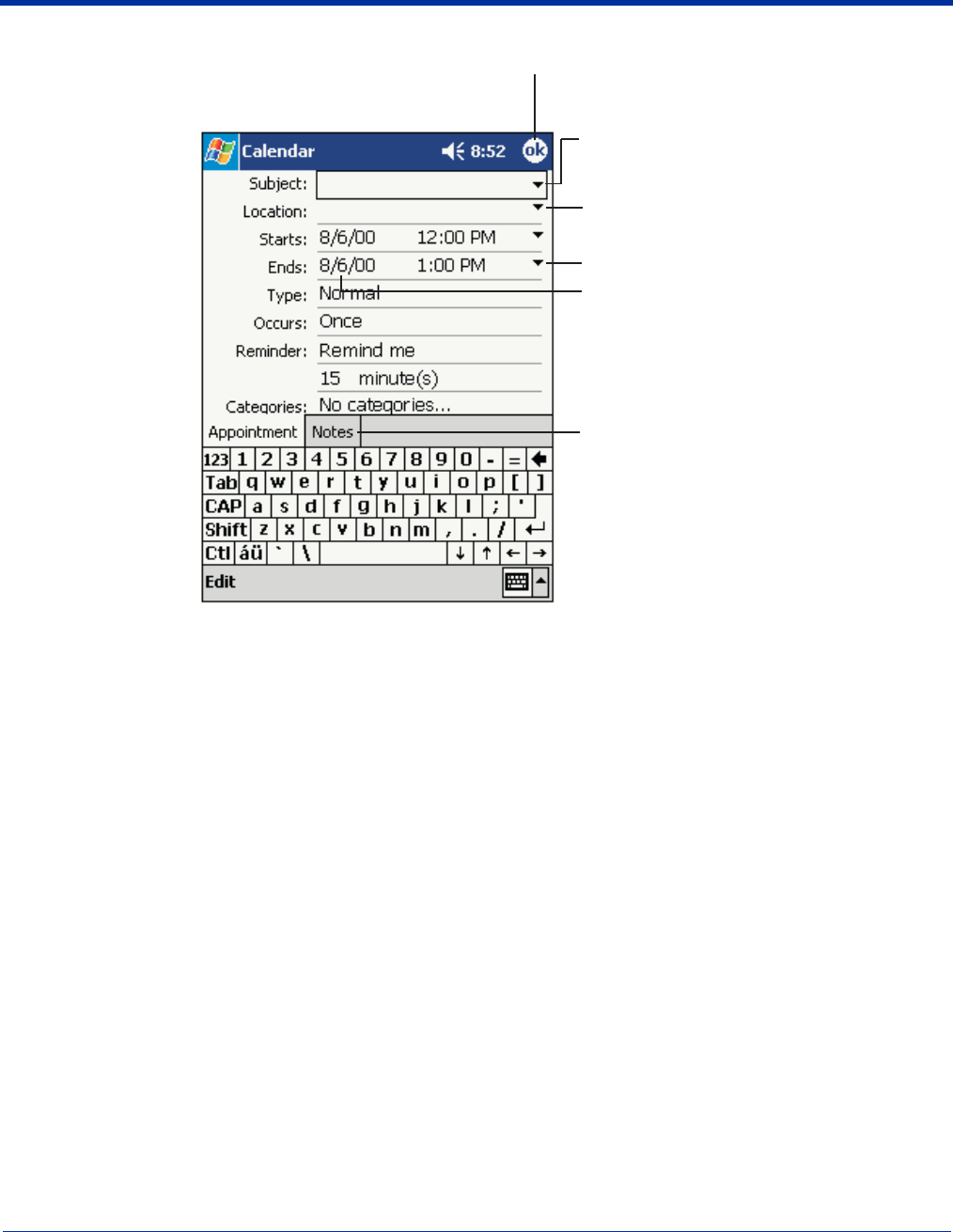
10 - 2 Dolphin® 9500/9550 Mobile Computer User’s Guide - GSM Draft
3. Using the input panel, enter a description and a location. Tap first to select the field.
4. If needed, tap the date and time to change them.
5. Enter other desired information. To see all available fields, hide the input panel.
6. To add notes, tap the Notes tab. You can enter text, draw, or create a recording. For more information on creating notes,
refer to Notes on page 10-10.
7. When finished, tap OK to return to the calendar.
Note: If you select Remind me in an appointment, your device will remind you according to the options set in Start, Settings,
Personal tab, Sounds & Reminders.
Tap to select a date.
Tap to select a time.
Tap to return to the calendar
(the appointment is saved
automatically).
Tap to choose from
previously entered locations.
Tap to choose from
predefined text.
Notes is a good place
for maps and directions.
Entering an Appointment
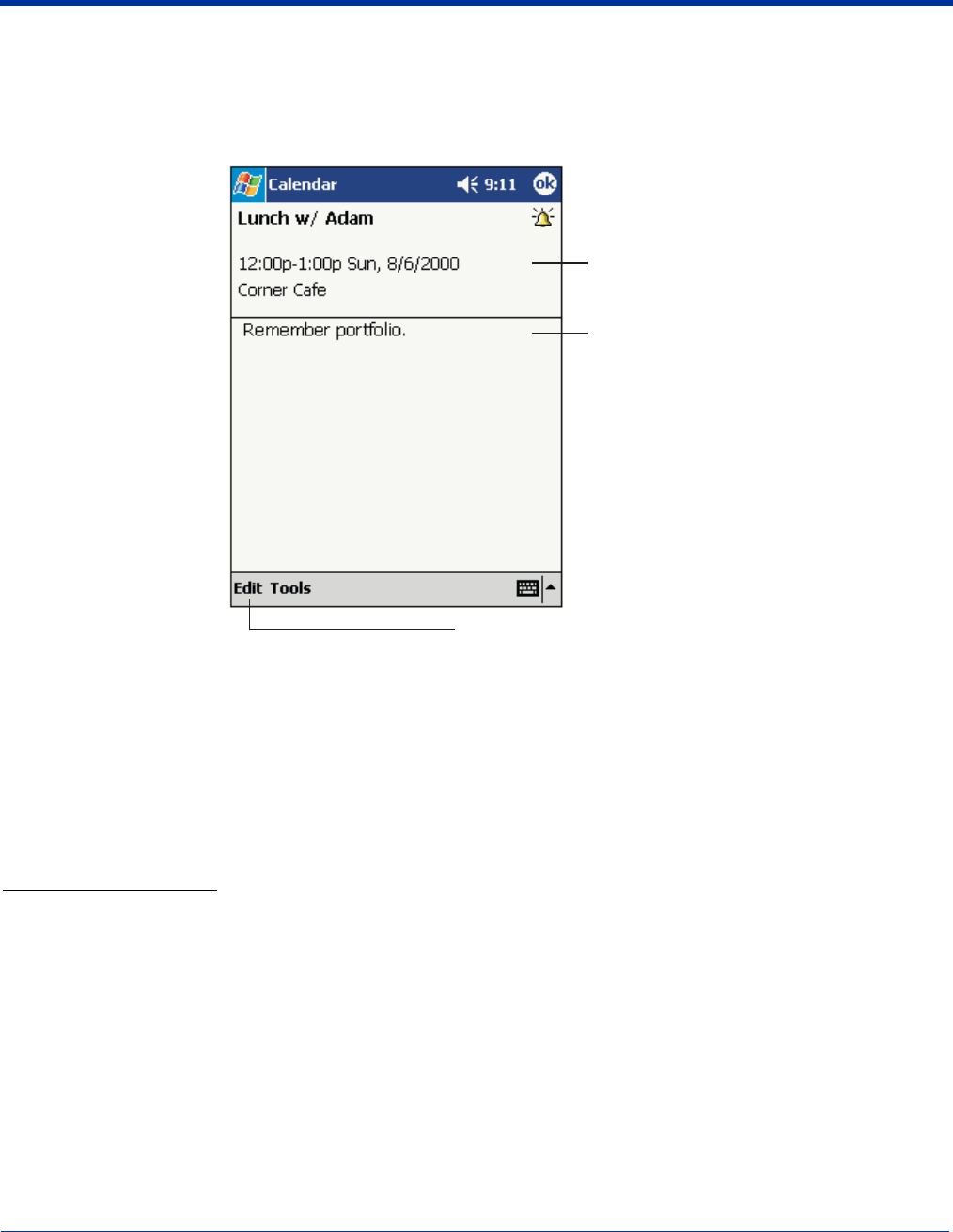
Dolphin® 9500/9550 Mobile Computer User’s Guide - GSM Draft 10 - 3
Using the Summary Screen
When you tap an appointment in Calendar, a summary screen is displayed. To change the appointment, tap Edit.
Creating Meeting Requests
You can use Calendar to set up meetings with users of Outlook or Pocket Outlook. The meeting request is created automatically
and sent either when you synchronize Inbox or when you connect to your e-mail server. Indicate how you want meeting requests
sent by tapping Tools and then Options. If you send and receive e-mail messages through ActiveSync, select ActiveSync.
To Schedule a Meeting
1. Create an appointment.
2. In the appointment details, hide the input panel, and then tap Attendees.
3. From the list of e-mail addresses you’ve entered in Contacts, select the meeting attendees.
The meeting notice is created automatically and placed in the Outbox folder.
For more information on sending and receiving meeting requests, see Calendar Help and Inbox Help on the device.
View appointment details.
View.
Tap to change
appointment.
Appointment Summary Screen
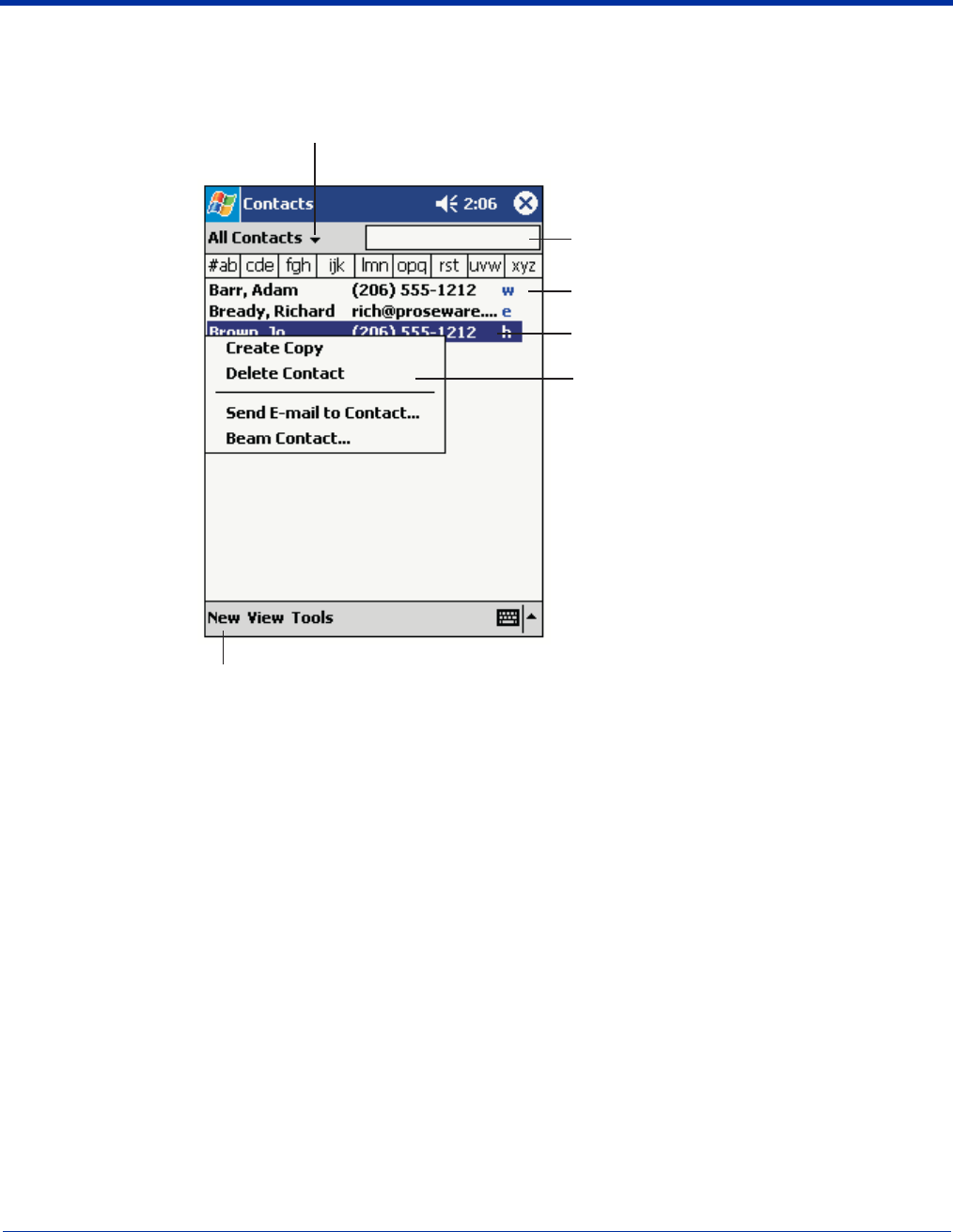
10 - 4 Dolphin® 9500/9550 Mobile Computer User’s Guide - GSM Draft
Contacts
Contacts maintains a list of your friends and colleagues so that you can easily find the information you’re looking for, whether
you’re at home or on the road. Using the device infrared (IR) port, you can quickly share Contacts information with other device
users.
Note: To change the way information is displayed in the list, tap Tools > Options.
Tap and enter part of a name to
quickly find it in the list.
Tap to display or edit
the contact details.
Tap and hold to display
a pop-up menu of actions.
Tap to see additional phone
numbers and e-mail addresses.
Tap to create a new contact.
Select the category of contacts
you want displayed in the list.
Contact Application
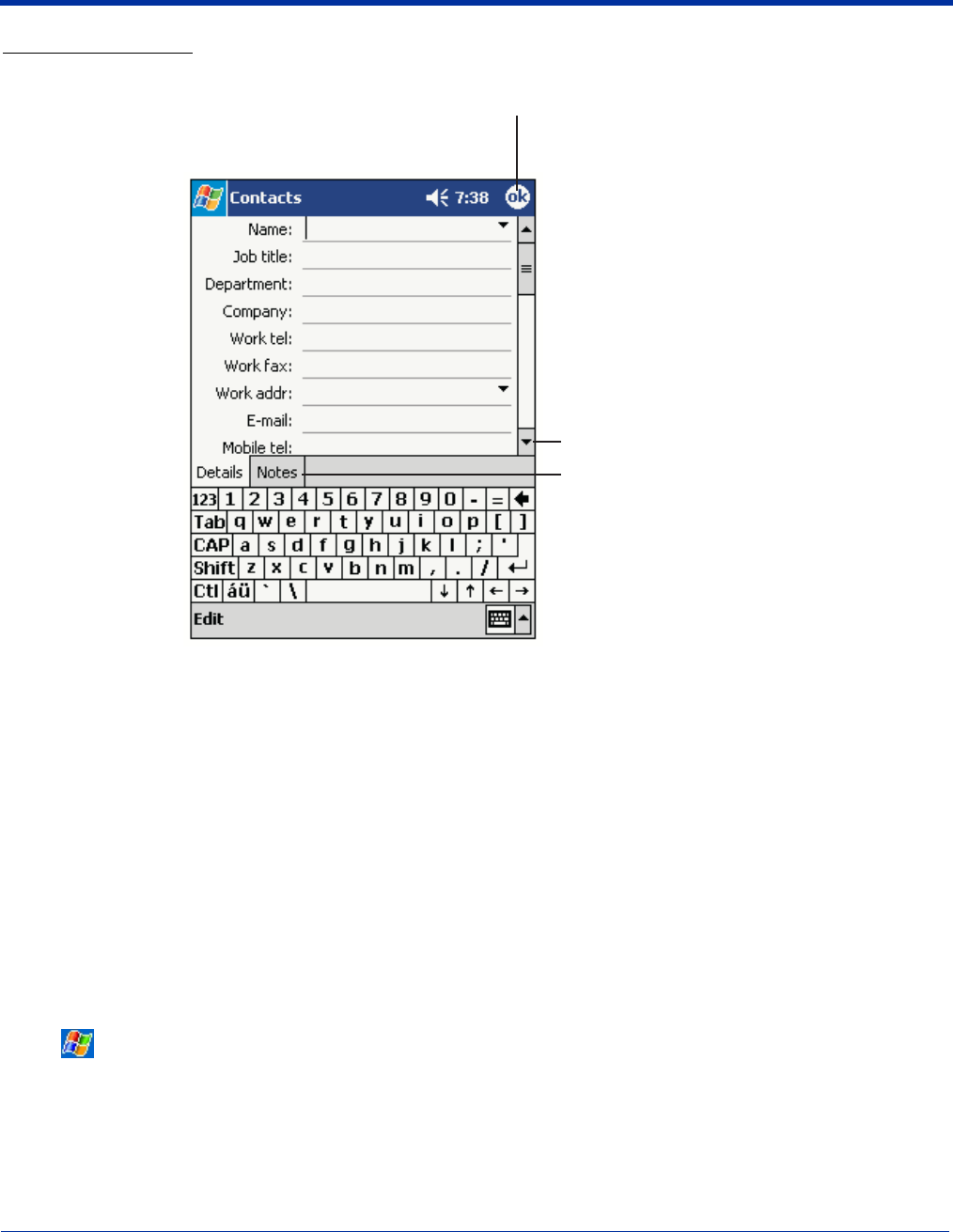
Dolphin® 9500/9550 Mobile Computer User’s Guide - GSM Draft 10 - 5
To Create a Contact
1. Tap New.
2. Using the input panel, enter a name and other contact information. You need to scroll down to see all available fields.
3. To assign the contact to a category, scroll to and tap Categories and select a category from the list. In the contact list, you
can display contacts by category.
4. To add notes, tap the Notes tab. You can enter text, draw, or create a recording. For more information on creating notes,
refer to Notes on page 10-10.
5. When finished, tap OK to return to the contact list.
There are four ways to find a contact:
• In the contact list, enter a contact name in the box under the navigation bar. To show all contacts again, clear text from the
box or tap the button to the right of the box.
• In the contact list, tap the category list (labeled All Contacts by default) and select the type of contact that you want displayed.
To show all contacts again, select All Contacts. To view a contact not assigned to a category, select None.
• To view the names of companies your contacts work for, in the contact list, tap View > By Company. The number of contacts
that work for that company are displayed to the right of the company name.
•Tap , Find, enter the contact name, select Contacts for the type, and then tap Go.
Notes is a good place
for maps and directions.
Tap to return to the contact
list (the contact is saved
automatically).
Scroll to see more fields.
Creating a Contact
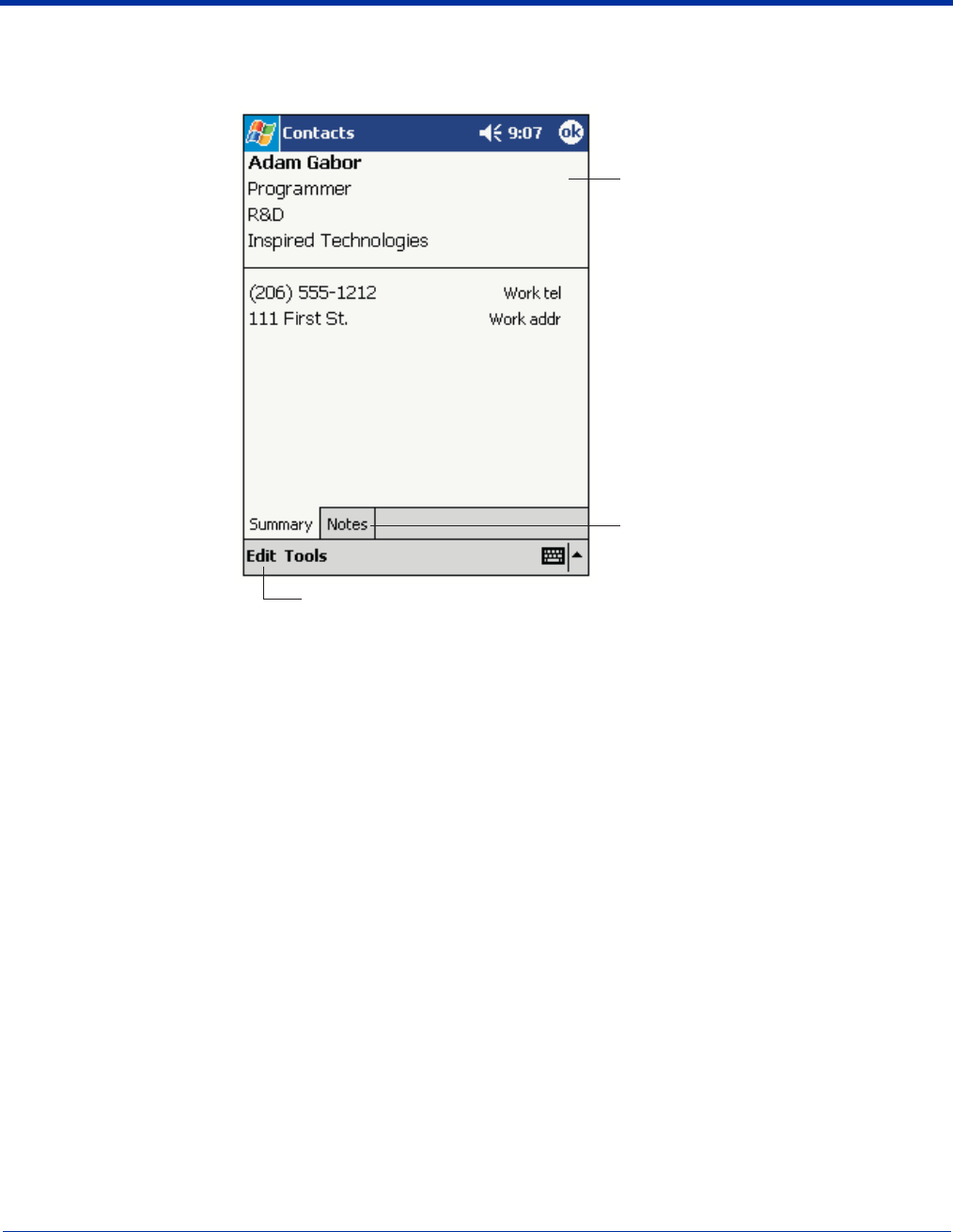
10 - 6 Dolphin® 9500/9550 Mobile Computer User’s Guide - GSM Draft
Using the Summary Screen
When you tap a contact in the contact list, a summary screen is displayed. To change the contact information, tap Edit.
View contact details.
Tap to view notes.
Tap to change contact information.
Contacts Summary Screen
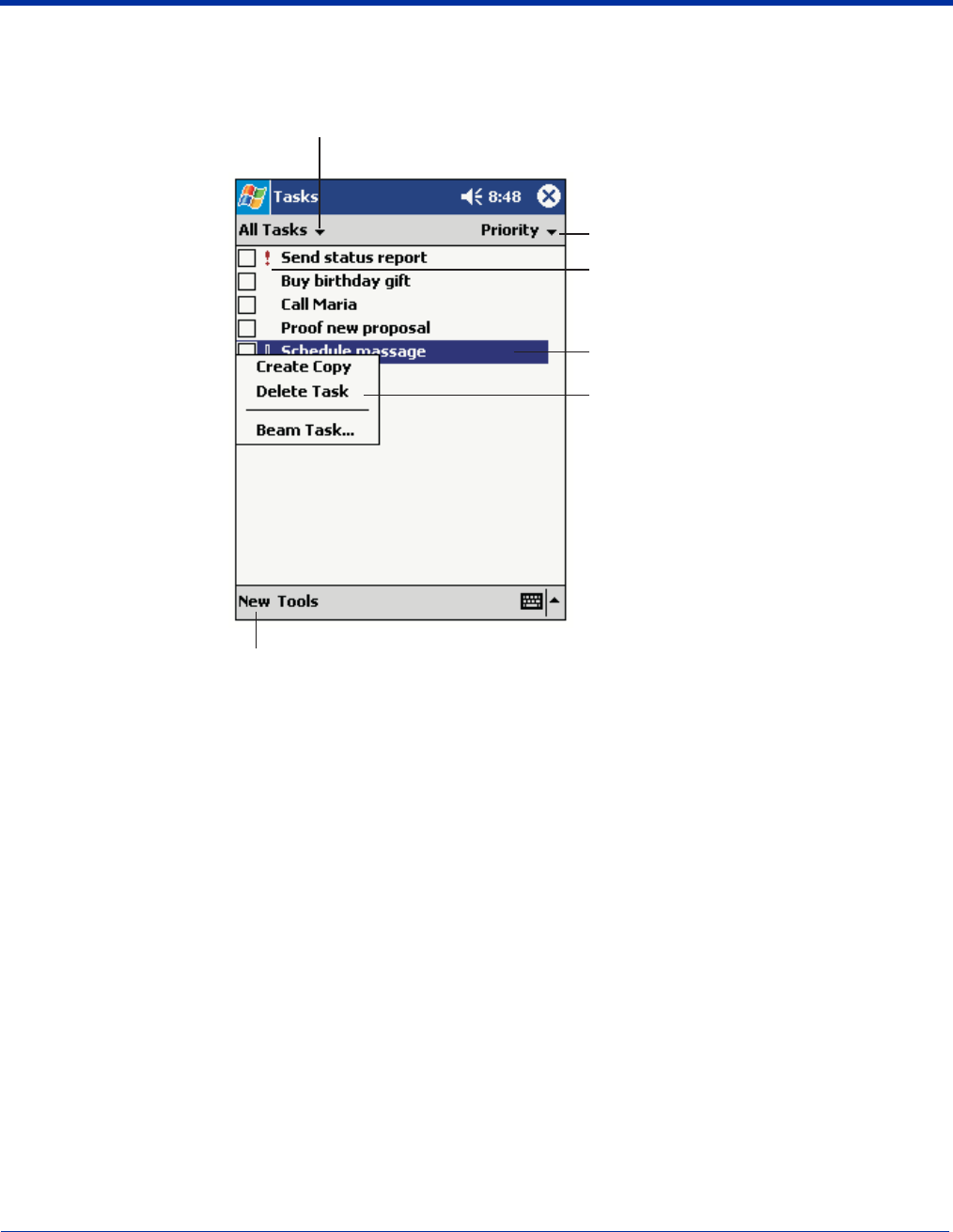
Dolphin® 9500/9550 Mobile Computer User’s Guide - GSM Draft 10 - 7
Tasks
Use Tasks to keep track of what you have to do.
Note: To change the way information is displayed in the list, tap Tools > Options.
Tap to create a new task.
Select the sort order
of the list.
Indicates high priority.
Select the category of tasks
you want displayed in the list.
Tap to display or edit
the task details.
Tap and hold to display
a pop-up menu of actions.
Task Application
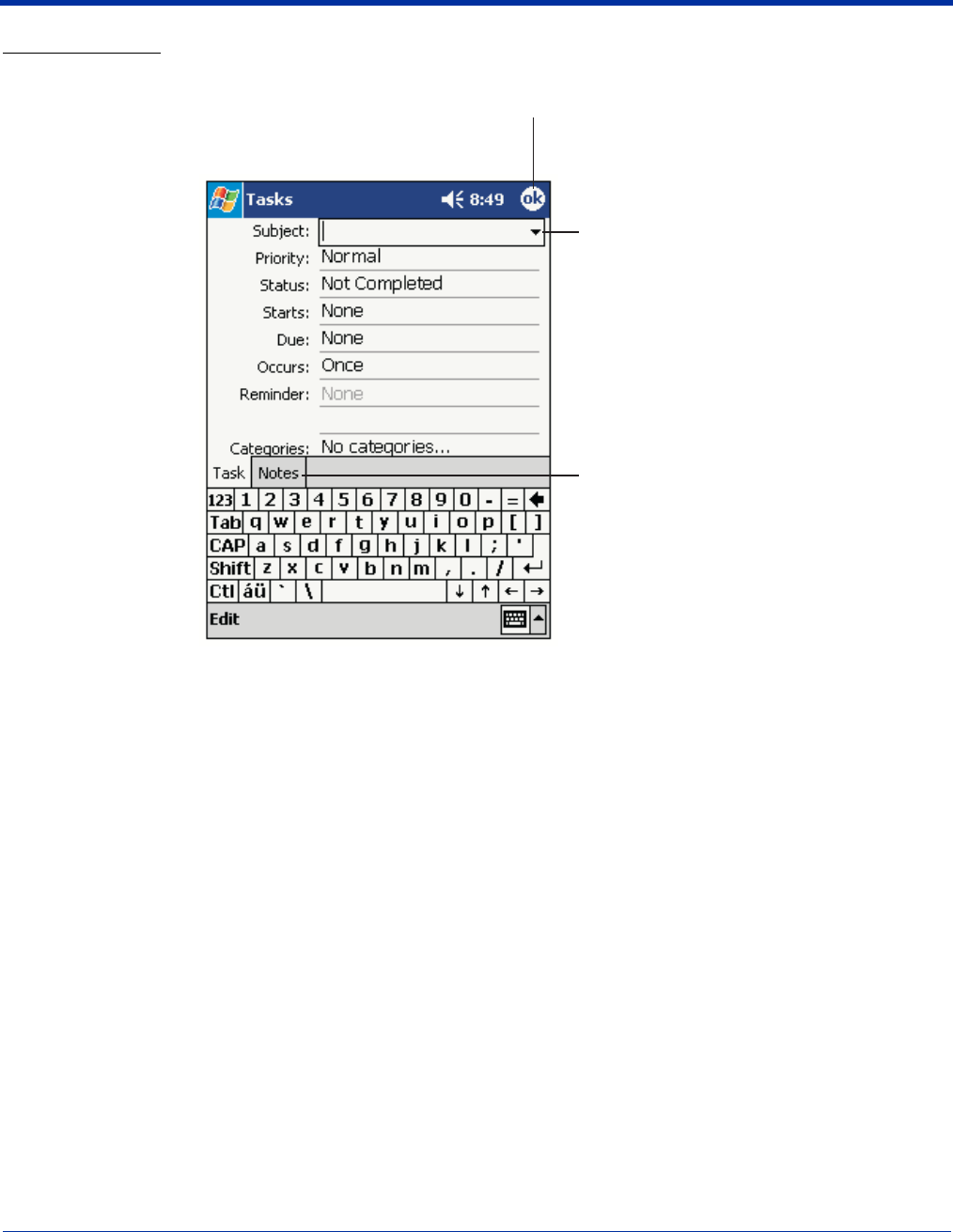
10 - 8 Dolphin® 9500/9550 Mobile Computer User’s Guide - GSM Draft
To Create a Task
1. Tap New.
2. Using the input panel, enter a description.
3. You can enter a start date and due date or enter other information by first tapping the field. If the input panel is open, you
need to hide it to see all available fields.
4. To assign the task to a category, tap Categories and select a category from the list. In the task list, you can display tasks by
category.
5. To add notes, tap the Notes tab. You can enter text, draw, or create a recording. For more information on creating notes,
refer to Notes on page 10-10.
6. When finished, tap OK to return to the task list.
Note: To quickly create a task with only a subject, tap Entry Bar on the Tools menu. Then, tap Tap here to add a new task and
enter your task information.
Tap to return to the task
list (the task is saved
automatically).
Tap to choose from
predefined subjects.
Notes is a good place
for maps and drawings.
Creating a Task
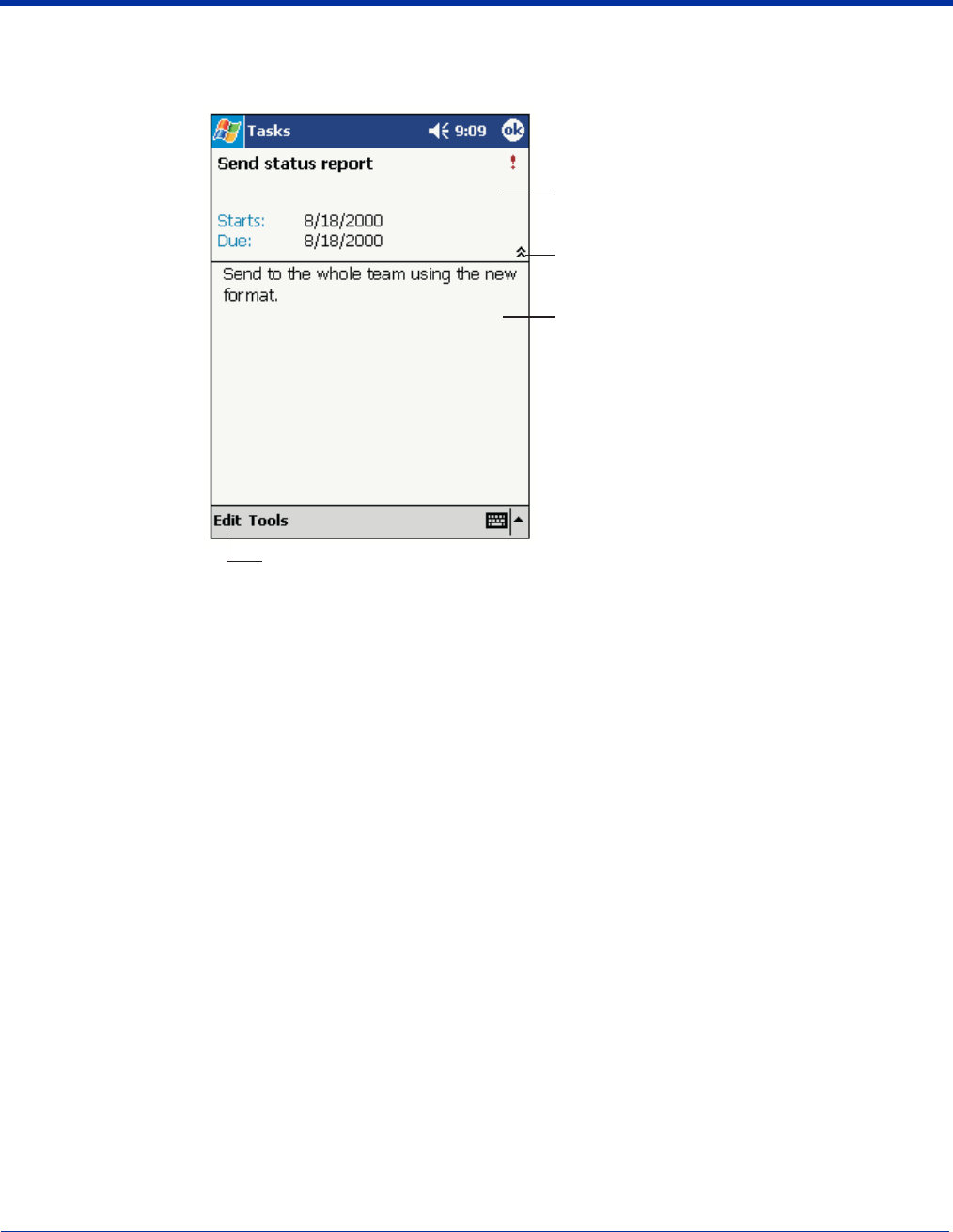
Dolphin® 9500/9550 Mobile Computer User’s Guide - GSM Draft 10 - 9
Using the Summary Screen
en you tap a task in the task list, a summary screen is displayed. To change the task, tap Edit.
View task details.
View notes.
Tap to show and hide additional
summary information.
Tap to change task.
Task Summary Screen
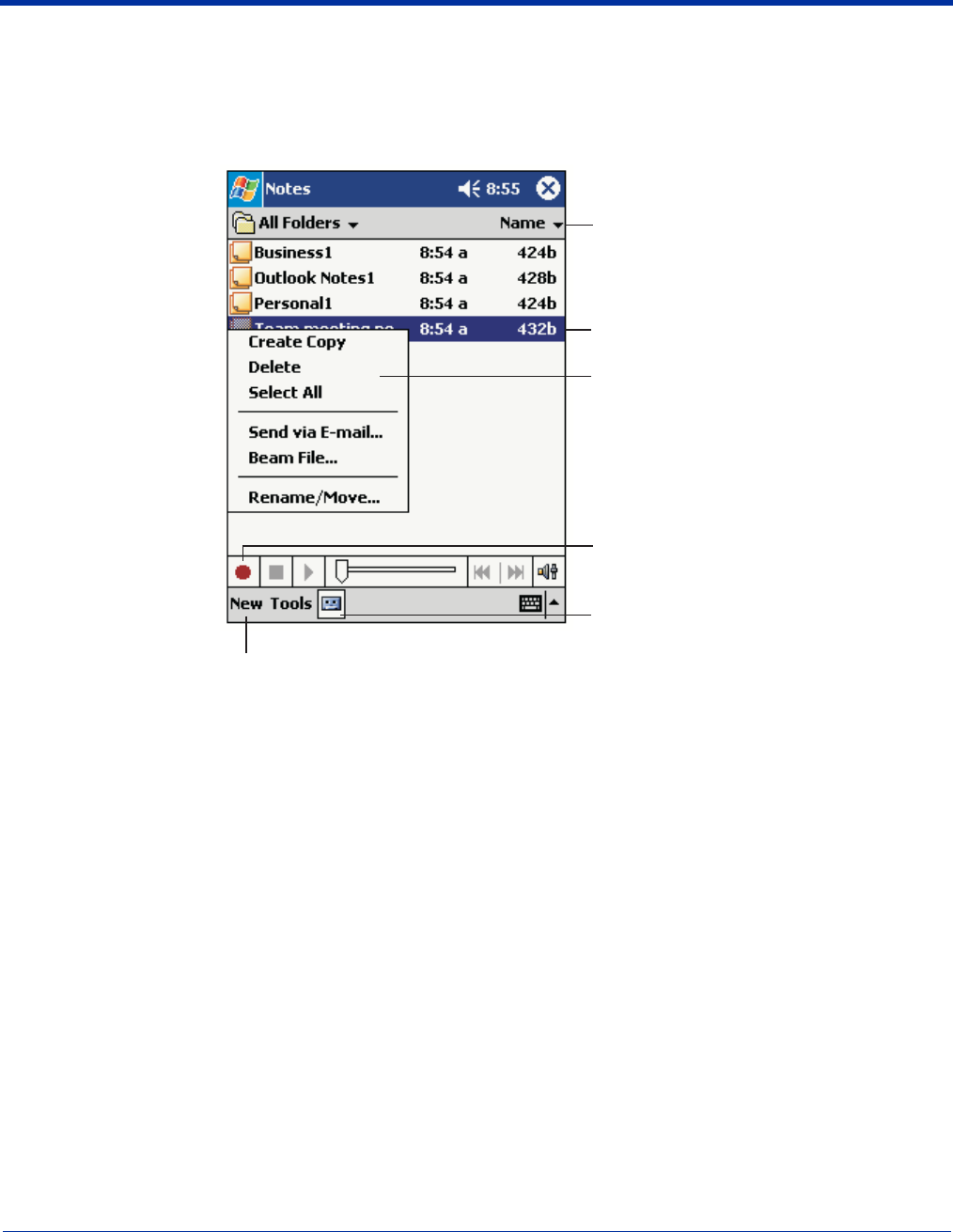
10 - 10 Dolphin® 9500/9550 Mobile Computer User’s Guide - GSM Draft
Notes
Quickly capture thoughts, reminders, ideas, drawings, and phone numbers with Notes. You can create a written note or a
recording. You can also include a recording in a note. If a note is open when you create the recording, it will be included in the
note as an icon. If the note list is displayed, it will be created as a stand-alone recording.
Tap to open a note or
play a recording.
Tap and hold to display
a pop-up menu of actions.
Tap to create a new item.
Tap to change the sort
order of the list.
Tap to show or hide the
Recording toolbar.
Tap to record.
Notes Application
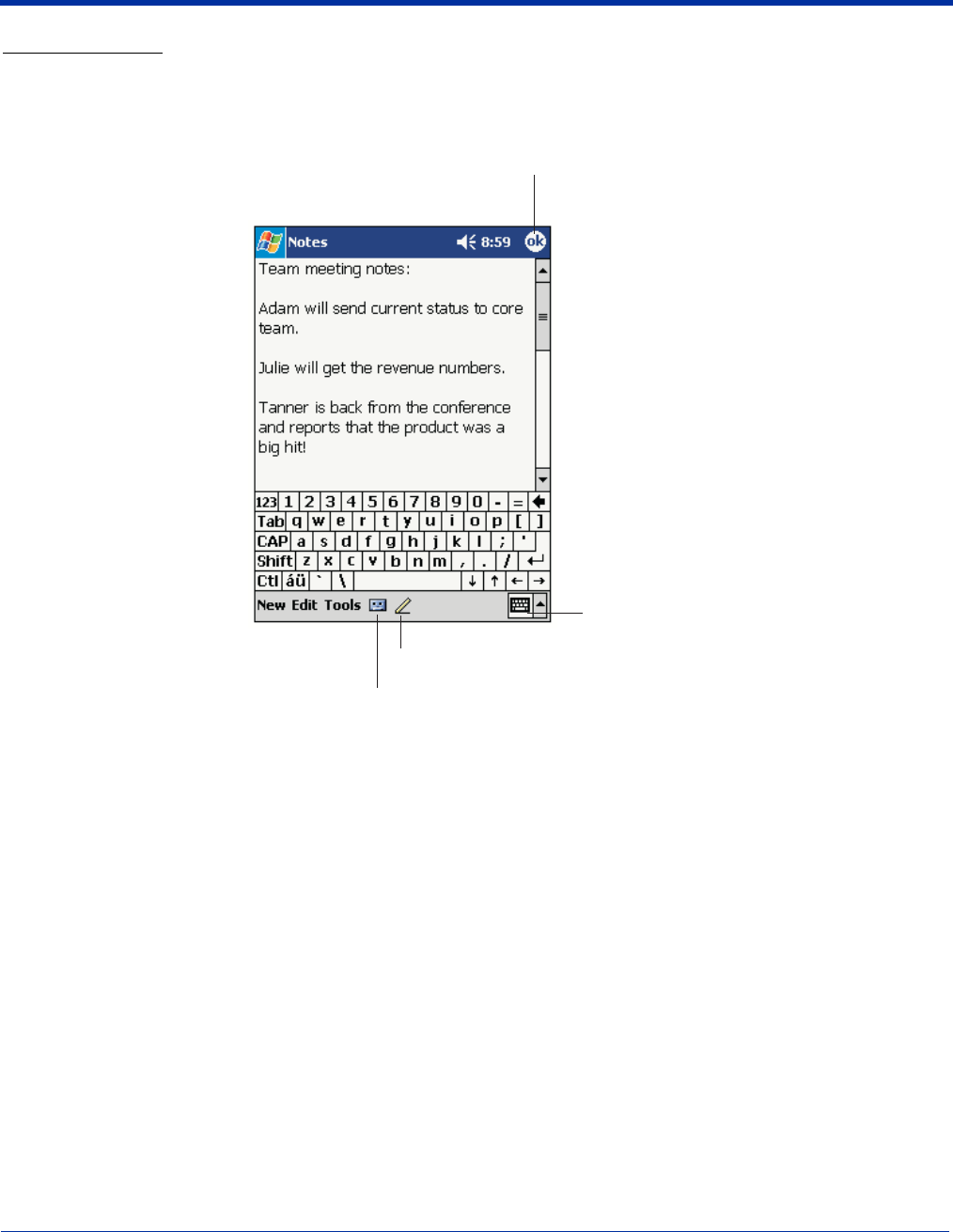
Dolphin® 9500/9550 Mobile Computer User’s Guide - GSM Draft 10 - 11
To Create a Note
1. Tap New.
2. Create your note by writing, drawing, typing, and recording. For more information about using the input panel, writing and
drawing on the screen, and creating recordings, see Using the Dolphin 9500/9550 Mobile Computer on page 4-1.
Tap to return to the note
list (the note is saved
automatically).
Tap to write on the screen.
Tap to show or hide
the input panel.
Tap to add a recording
to the note.
Creating a Note

10 - 12 Dolphin® 9500/9550 Mobile Computer User’s Guide - GSM Draft
Inbox
Use Inbox to send and receive e-mail messages in either of these ways:
• Synchronize e-mail messages with Microsoft Exchange or Microsoft Outlook on your desktop computer.
• Send and receive e-mail messages by connecting directly to an e-mail server through an Internet service provider (ISP) or a
network.
Synchronizing E-mail Messages
E-mail messages can be synchronized as part of the general synchronization process. You need to enable Inbox synchronization
in ActiveSync. For information on enabling Inbox synchronization, see ActiveSync Help on the desktop computer.
During synchronization:
• Messages are copied from the mail folders of Exchange or Outlook on your desktop computer to the ActiveSync folder in Inbox
on your device. By default, you will receive messages from the past three days only, the first 100 lines of each message, and
file attachments of less than 100 KB in size.
• E-mail messages in the Outbox folder on your device are transferred to Exchange or Outlook, and then sent from those
programs.
• E-mail messages in subfolders must be selected in ActiveSync on your desktop computer to be transferred.
Note: You can also synchronize e-mail messages with your desktop computer from a remote location. For more information,
see Chapter 7.
Connecting Directly to an E-mail Server
In addition to synchronizing e-mail messages with your desktop computer, you can send and receive e-mail messages by
connecting to an e-mail server.
When you connect to the e-mail server, new messages are downloaded to the device Inbox folder, messages in the device
Outbox folder are sent, and messages that have been deleted on the e-mail server are removed from the device Inbox folder.
Messages that you receive directly from an e-mail server are linked to your e-mail server rather than your desktop computer.
When you delete a message on your device, it is also deleted from the e-mail server the next time you connect based on the
settings you selected in ActiveSync.
You can work online or offline. When working online, you read and respond to messages while connected to the e-mail server.
Messages are sent as soon as you tap Send, which saves space on your device.
When working offline, once you’ve downloaded new message headers or partial messages, you can disconnect from the e-mail
server and then decide which messages to download completely. The next time you connect, Inbox downloads the complete
messages you’ve marked for retrieval and sends the messages you’ve composed.
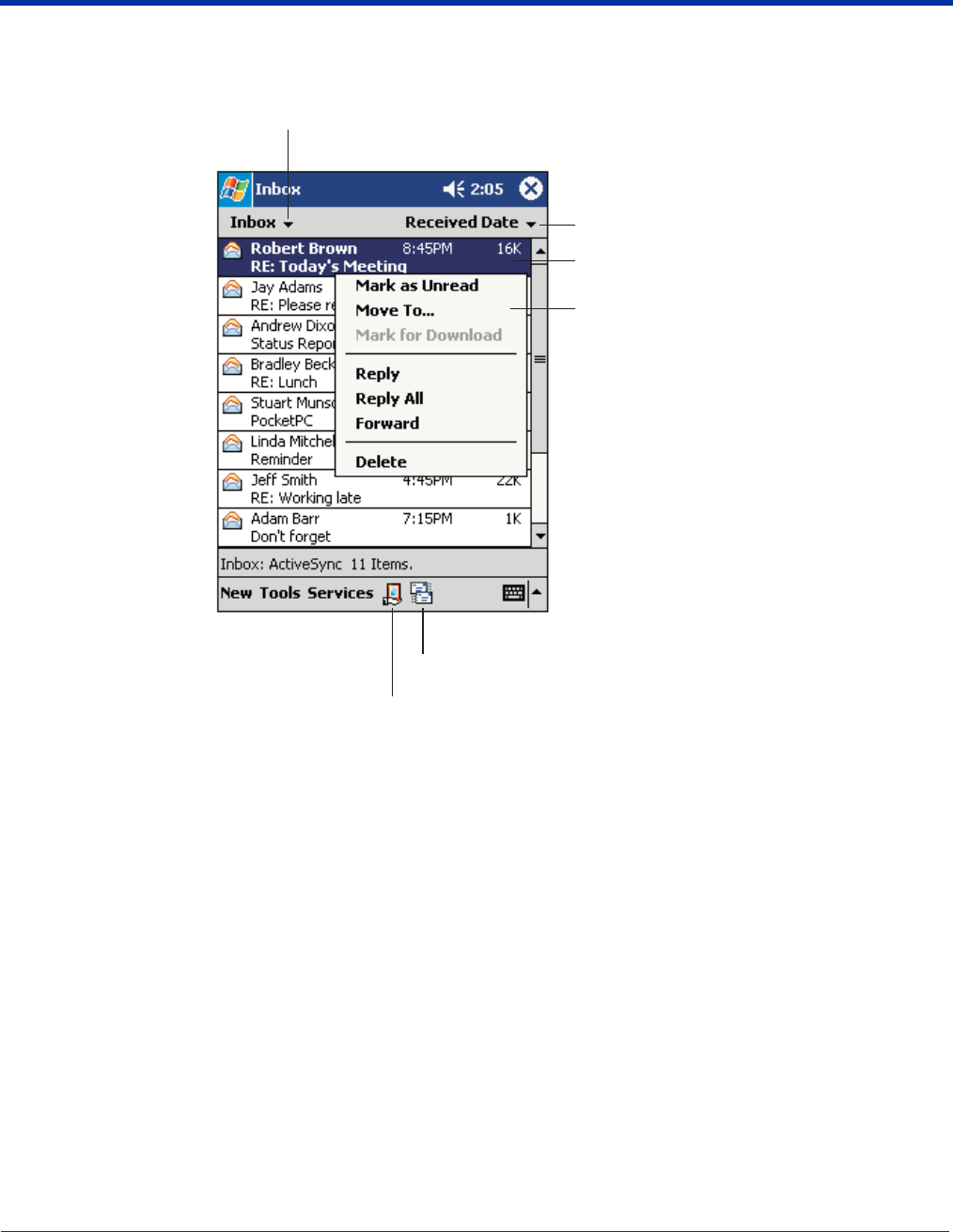
Dolphin® 9500/9550 Mobile Computer User’s Guide - GSM Draft 10 - 13
Using the Message List
Messages you receive are displayed in the message list. By default, the most recently received messages are displayed first in
the list.
Select the sort order
for messages.
Select the service and folder
you want to display.
Tap to connect to
the selected service.
Tap to connect and to
send and receive e-mail.
Tap to open a message.
Tap and hold to display
a pop-up menu of actions.
InBox Application
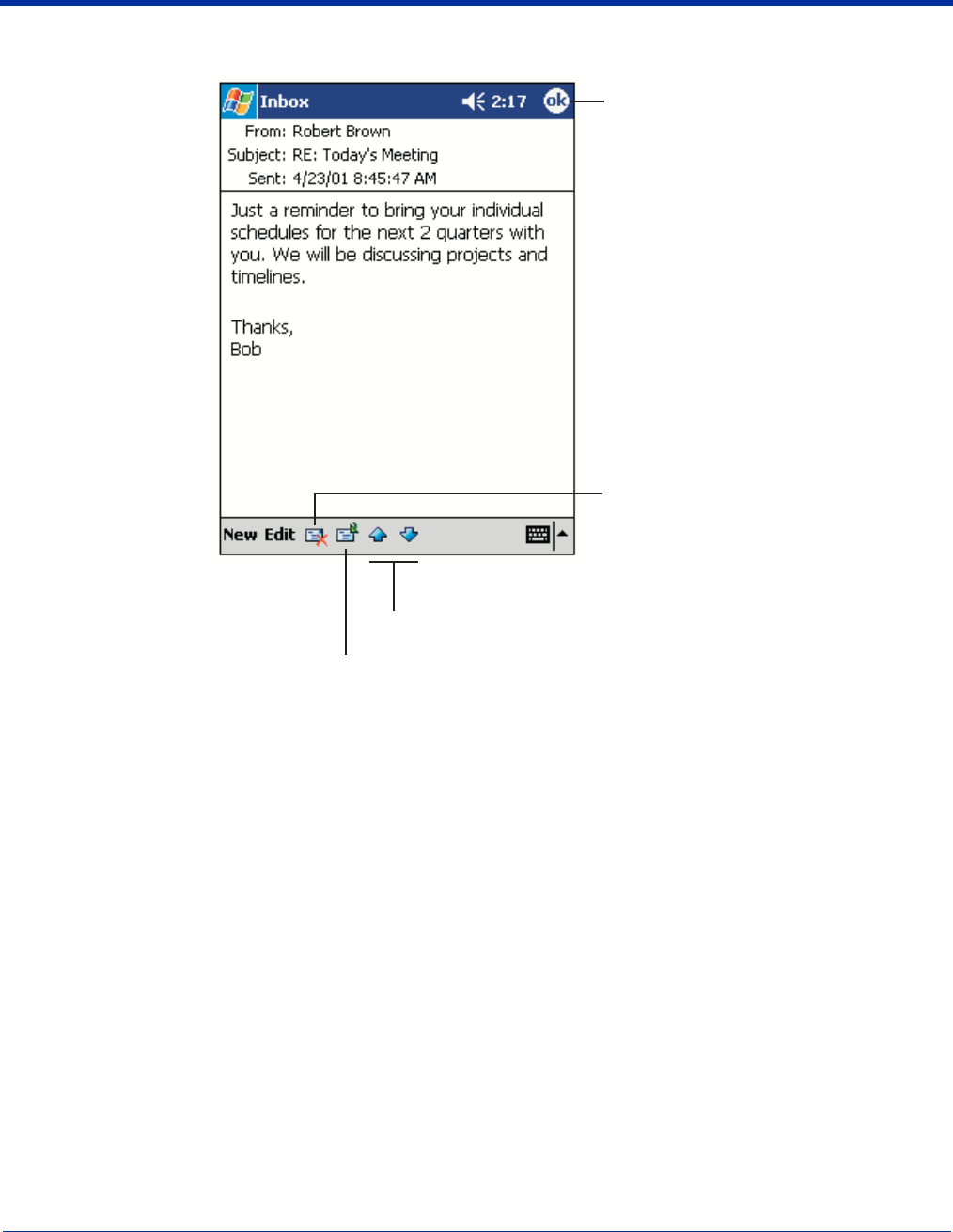
10 - 14 Dolphin® 9500/9550 Mobile Computer User’s Guide - GSM Draft
When you receive a message, tap it to open it. Unread messages are displayed in bold.
When you connect to your e-mail server or synchronize with your desktop computer, by default, you’ll receive messages from
the last five days only, the first 100 lines of each new message, and file attachments of less than 100 KB in size. The original
messages remain on the e-mail server or your desktop computer.
You can mark the messages that you want to retrieve in full during your next synchronization or e-mail server connection. In the
message list, tap and hold the message you want to retrieve. On the pop-up menu, tap Mark for Download. The icons in the
Inbox message list give you visual indications of message status.
You specify your downloading preferences when you set up the service or select your synchronization options. You can change
them at any time:
• Change options for Inbox synchronization using ActiveSync options. For more information, see ActiveSync Help.
• Change options for direct e-mail server connections in Inbox on your device. Tap Tools and then tap Options. On the Service
tab, tap the service you want to change. Tap and hold the service and select Delete to remove a service.
Tap to delete this message.
Tap to view the previous
or next message.
Tap to reply to or
forward this message.
Tap to return to
the message list.
Viewing A Message
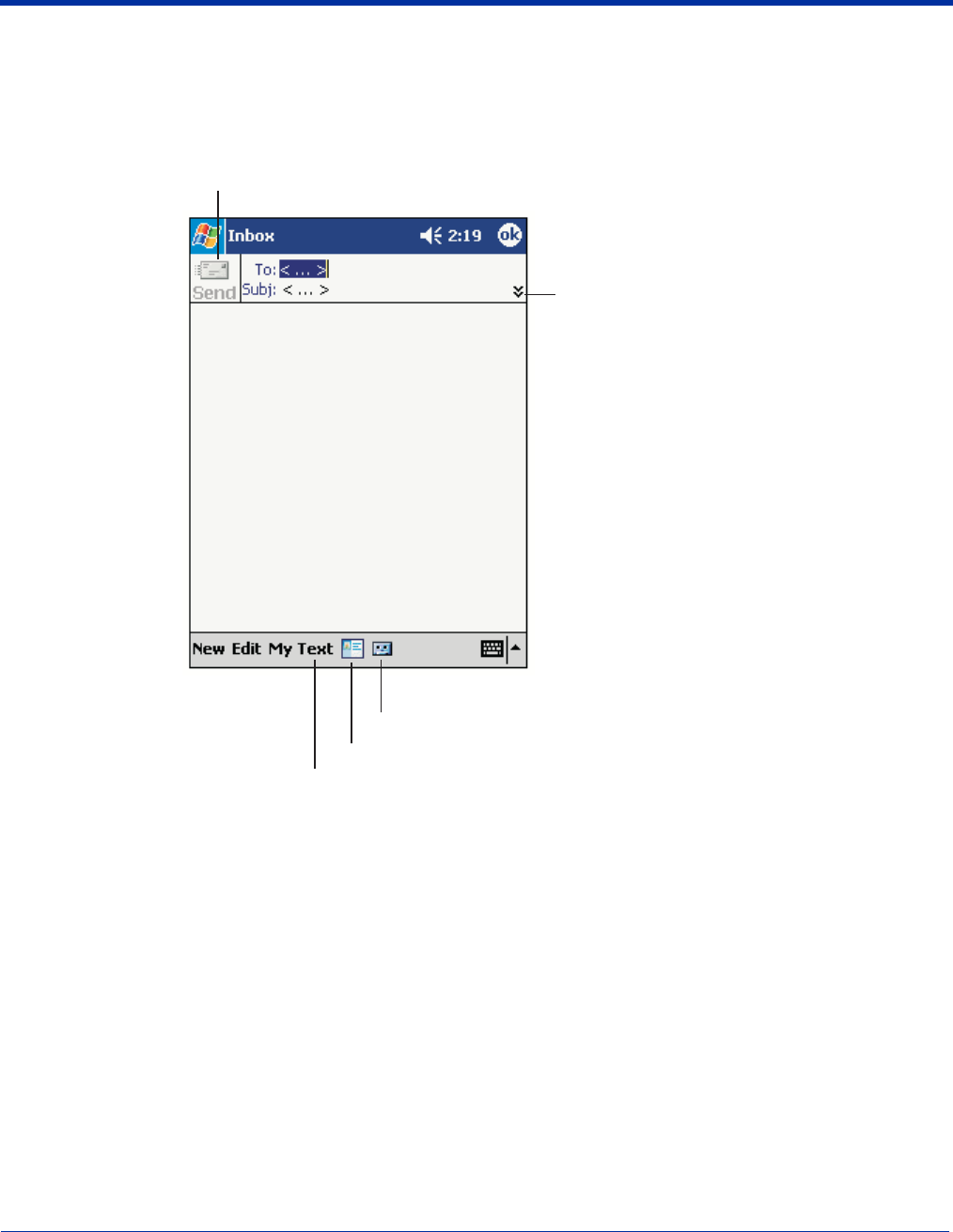
Dolphin® 9500/9550 Mobile Computer User’s Guide - GSM Draft 10 - 15
Composing Messages
1. Tap New.
2. In the To field, enter an e-mail or SMS address of one or more recipients, separating them with a semicolon, or select a name
from the contact list by tapping the Address Book button.
All e-mail addresses entered in the e-mail fields in Contacts appear in the Address Book.
• Compose your message. To enter preset or frequently used messages, tap My Text and select a message.
•Tap Send when you’ve finished the message. If you are working offline, the message is moved to the Outbox folder and will
be sent the next time you connect.
If you are sending an SMS message and want to know if it was received, tap Edit, Options, and select Request SMS text
message delivery notification before sending the message.
Managing E-mail Messages and Folders
By default, messages are displayed in one of five folders for each service you have created: Inbox, Deleted Items, Drafts, Outbox,
and Sent Items. The Deleted Items folder contains messages that have been deleted on the device. The behavior of the Deleted
and Sent Items folders depends on the options you have chosen. In the message list, tap Tools and then Options. On the
Message tab, select your options.
If you want to organize messages into additional folders, tap Tools, and then Manage Folders to create new folders. To move
a message to another folder, in the message list, tap and hold the message and then tap Move to on the pop-up menu.
Tap to show or hide
the complete header.
Tap to send the message.
Tap to insert common messages.
Tap to show / hide the
recording toolbar.
Tap to display the Address Book.
Creating a Message

10 - 16 Dolphin® 9500/9550 Mobile Computer User’s Guide - GSM Draft
Folder Behavior with a Direct Connection to an E-mail Server
The behavior of the folders you create depends on whether you are using ActiveSync, SMS, POP3, or IMAP4.
• If you use ActiveSync, e-mail messages in the Inbox folder in Outlook will automatically be synchronized with your device.
You can select to synchronize additional folders by designating them for ActiveSync. The folders you create and the
messages you move will then be mirrored on the server. For example, if you move two messages from the Inbox folder to a
folder named Family, and you have designated Family for synchronization, the server creates a copy of the Family folder and
copies the messages into that folder. You can then read the messages while away from your desktop computer.
• If you use SMS, messages are stored in the Inbox folder.
• If you use POP3 and you move e-mail messages to a folder you created, the link is broken between the messages on the
device and their copies on the mail server. The next time you connect, the mail server will see that the messages are missing
from the device Inbox and delete them from the server. This prevents you from having duplicate copies of a message, but it
also means that you will no longer have access to messages that you move to folders created from anywhere except the
device.
• If you use IMAP4, the folders you create and the e-mail messages you move are mirrored on the server. Therefore, messages
are available to you anytime you connect to your mail server, whether it is from your device or desktop computer. This
synchronization of folders occurs whenever you connect to your mail server, create new folders, or rename/delete folders
when connected.
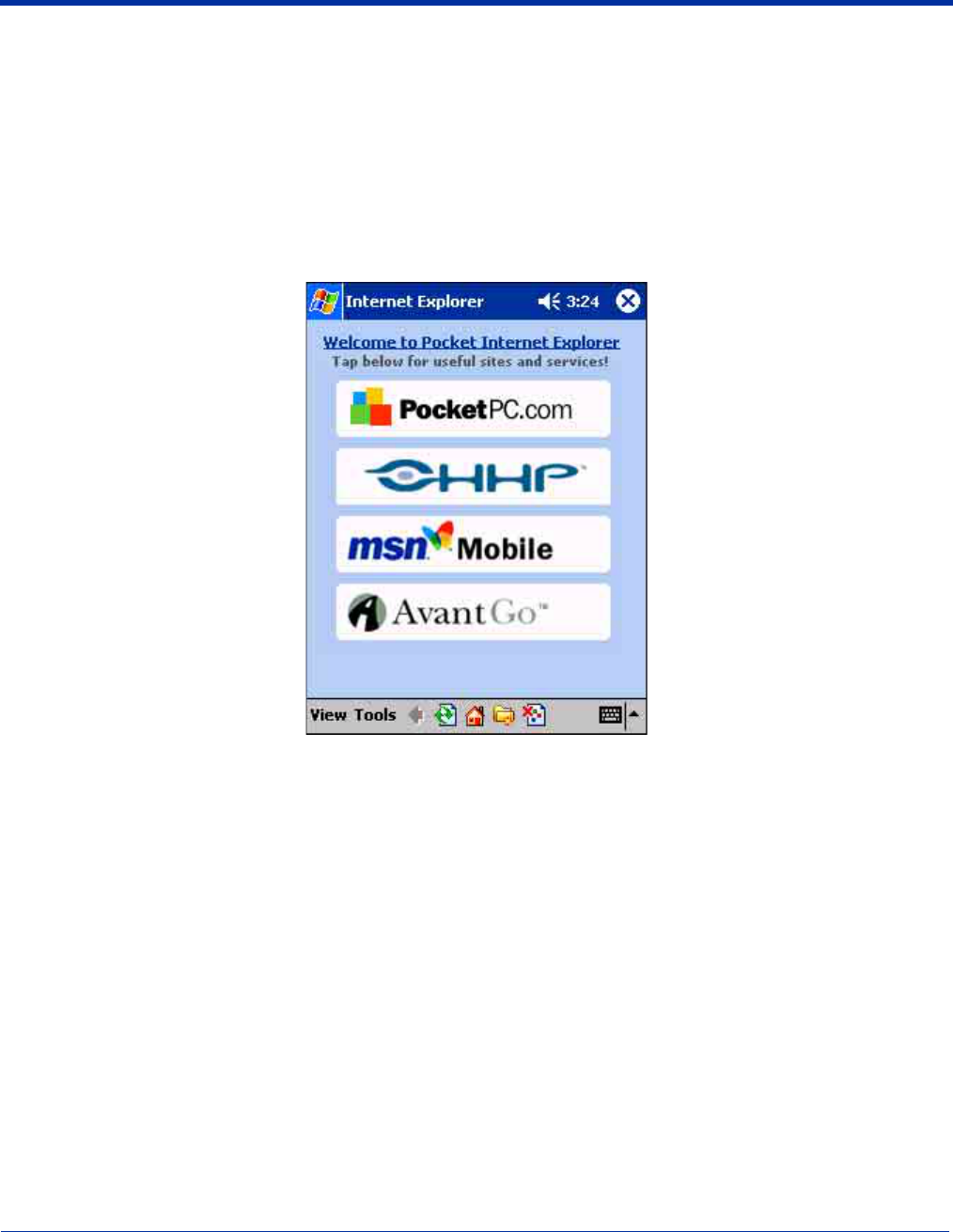
Dolphin® 9500/9550 Mobile Computer User’s Guide - GSM Draft 10 - 17
Pocket Internet Explorer
Use Microsoft Pocket Internet Explorer to view Web or WAP pages in either of these ways:
• During synchronization with your desktop computer, download your favorite links and mobile favorites that are stored in the
Mobile Favorites subfolder in Internet Explorer on the desktop computer.
• Connect to an Internet service provider (ISP) or network and browse the Web.
When connected to an ISP or network, you can also download files and programs from the Internet or intranet.
Accessing Pocket Internet Explorer
To switch to Pocket Internet Explorer, tap Start and then Internet Explorer.
You can use Pocket Internet Explorer to browse Mobile Favorites and channels that have been downloaded to your device
without connecting to the Internet. You can also connect to the Internet through an ISP or a network connection and browse the
Web.
Browse the Internet on Your Terminal
1. Set up a connection to your ISP or corporate network using Connections; see Using an ISP on page 6-8.
Note: If you select Pocket Internet Explorer before setting up the network connections, a screen may appear allowing you to
proceed to the connection settings screen. After you select the settings, you return to Pocket Internet Explorer. To add a
favorite link while using the device, go to the page you want to add, tap and hold on the page, and tap Add to Favorites.
2. To connect and start browsing, tap View and then Address Bar.
3. In the address bar that appears at the top of the screen, enter the Web address you want to visit and then tap Go.
4. Tap the arrow to choose from previously entered addresses.
If Mobile Favorites have been set up, you can tap one of them to start browsing. See The Mobile Favorites Folder on page 10-18.
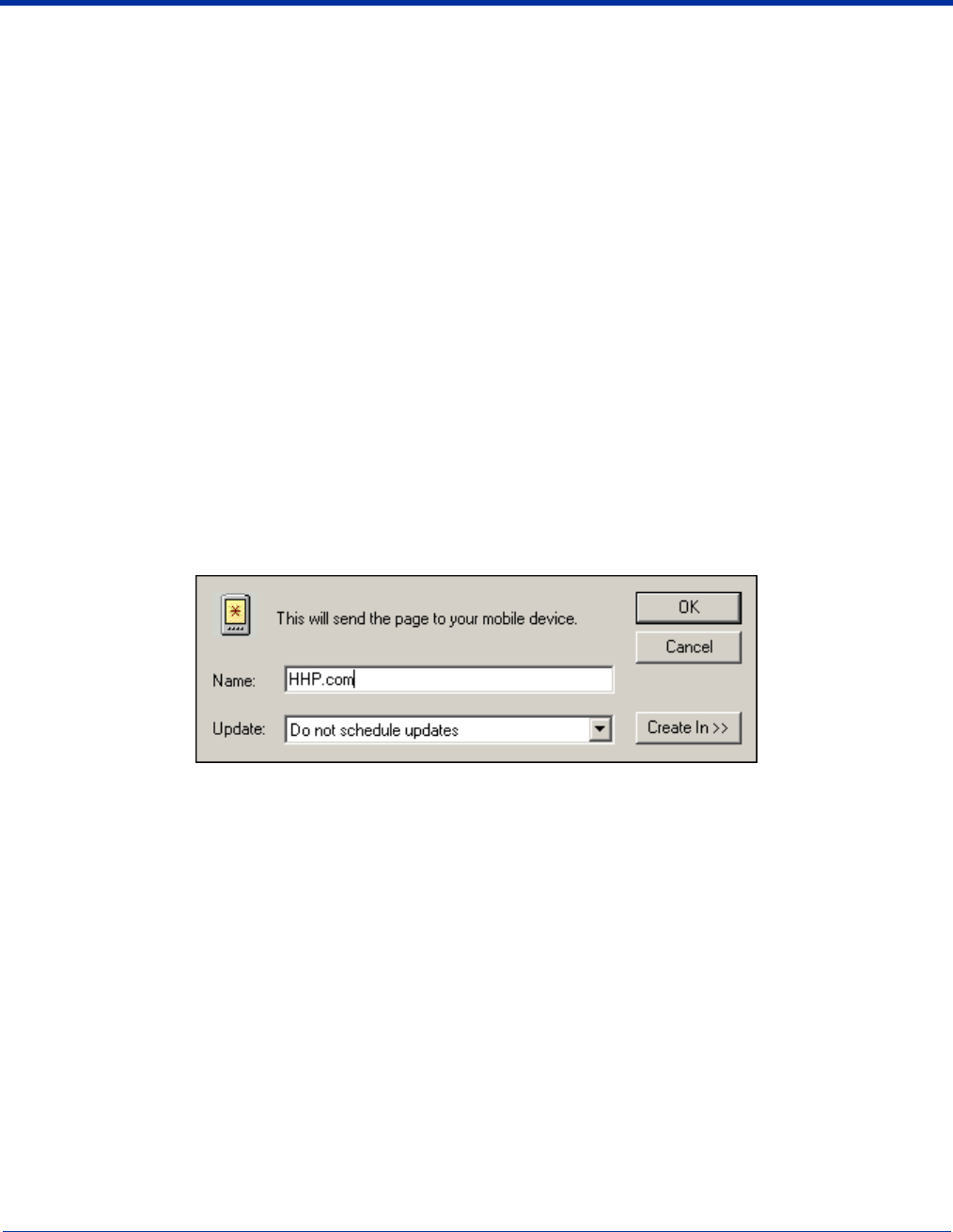
10 - 18 Dolphin® 9500/9550 Mobile Computer User’s Guide - GSM Draft
The Mobile Favorites Folder
Purpose
The Mobile Favorites folder was created on your desktop computer when you installed ActiveSync. It enables you to create
Favorite Links on your desktop computer that you can transfer to your Dolphin 9500/9550 terminal. Those Favorite Links are then
available for selection when browsing the internet on your terminal.
Process
First, you create your Favorite Links in the Mobile Favorites folder on your desktop computer. Then, the next time you sync your
desktop computer with your terminal, those Mobile Favorites are transferred to the Mobile Favorites folder on to your terminal.
Only items stored in the Mobile Favorites subfolder in the Favorites folder in Internet Explorer on your desktop computer are
synchronized with the Mobile Favorites folder on your terminal.
Note: Unless you mark a Favorite Link as a mobile favorite, only the link downloads to your terminal, and you will need to connect
to your ISP or network to view the content. For more information on synchronization, see ActiveSync Help on the desktop
computer.
Creating and Synchronizing Mobile Favorites
If you are using Microsoft Internet Explorer 5.0 or later on your desktop computer, you can download Mobile Favorites to your
device. Synchronizing mobile favorites downloads Web content to your device so that you can view pages while you are
disconnected from your ISP and desktop computer.
Use the Internet Explorer plug-in installed with ActiveSync to create mobile favorites
Complete these steps:
1. On your desktop computer, open Internet Explorer, click Tools > Create Mobile Favorite.
2. To change the link name, enter a new name in the Name box.
3. Optionally, in Update, select a desired update schedule.
4. Tap OK. Internet Explorer downloads the latest version of the page to your desktop computer.
5. If you want to download the pages that are linked to this mobile favorite, in Internet Explorer on the desktop computer, right-
click the mobile favorite and then click Properties. On the Download tab, specify the number of links down that you want to
download. To conserve device memory, go only one level down.
6. Synchronize your device and desktop computer. Mobile favorites that are stored in the Mobile Favorites folder in Internet
Explorer are downloaded to your device.
If you did not specify an update schedule in Step 3, you will need to manually download content to keep the information updated
on your desktop computer and device. Before synchronizing with your device and desktop computer, in Internet Explorer on your
desktop computer, click Tools and then Synchronize. You will see the last time content was downloaded to the desktop
computer, and you can manually download content if needed.
You can add a button to the Internet Explorer toolbar for creating mobile favorites. In Internet Explorer on your desktop computer,
click View, Toolbars, and then Customize.
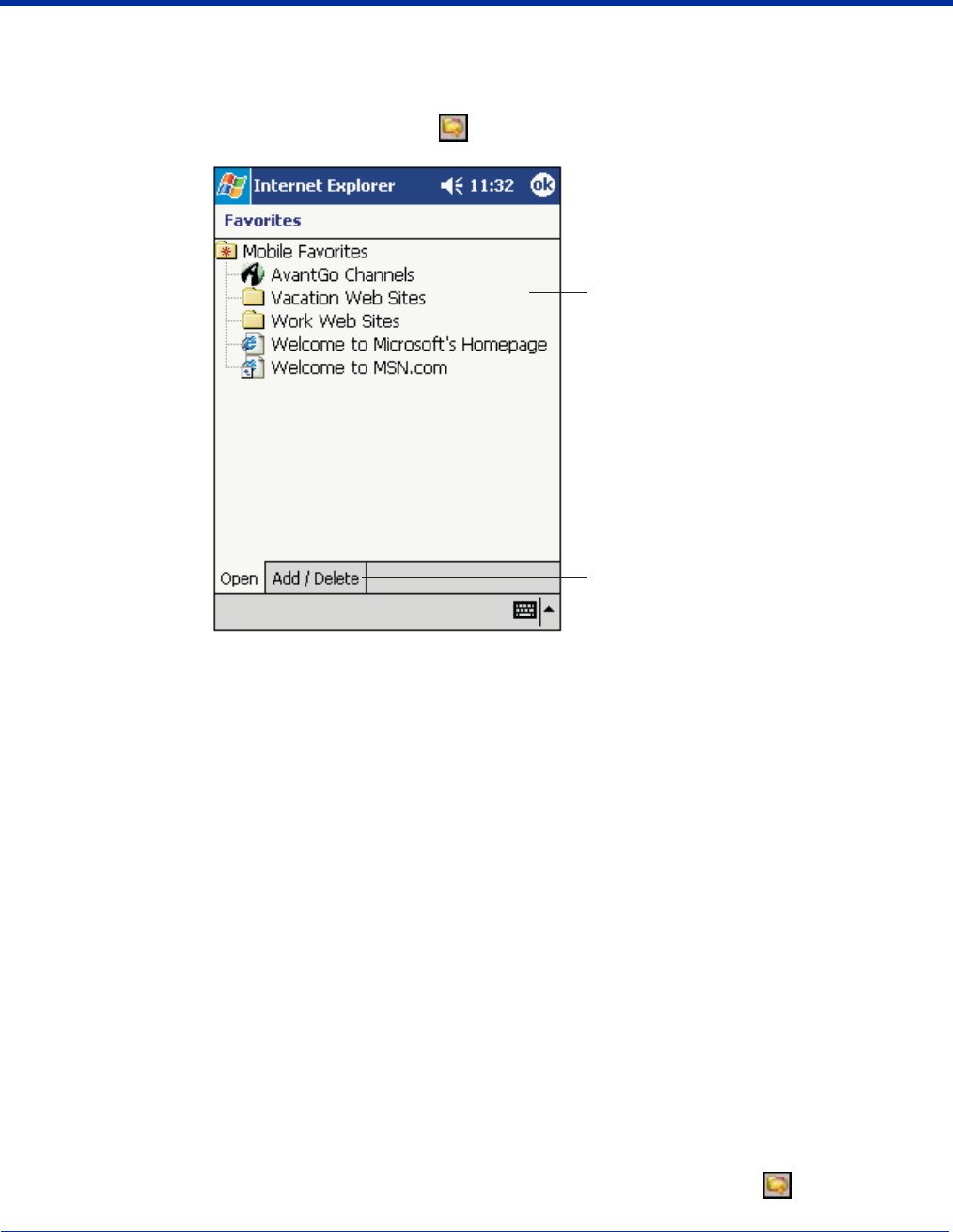
Dolphin® 9500/9550 Mobile Computer User’s Guide - GSM Draft 10 - 19
View Mobile Favorites and Channels on the Terminal
1. Access Pocket Internet Explorer.
2. Tap the Favorites button to display your list of favorites .
3. Tap the page you want to view.
You’ll see the page that was downloaded the last time you synchronized with your desktop computer. If the page is not on your
device, the favorite will be dimmed. You will need to synchronize with your desktop computer again to download the page to your
device, or connect to the Internet to view the page.
Saving Memory On Your Terminal
Mobile favorites take up storage memory on your device.
To minimize the amount of memory used:
• In the settings for the Favorites information type in ActiveSync options, turn off pictures and sounds, or stop some
mobile favorites from being downloaded to the device. For more information, see ActiveSync Help.
• Limit the number of downloaded linked pages. In Internet Explorer on the desktop computer, right-click the mobile
favorite you want to change and then Properties. On the Download tab, specify 0 or 1 for the number of linked pages
you want to download.
Using AvantGo® Channels
AvantGo is a free interactive service that gives you access to personalized content and thousands of popular Web sites. You
subscribe to AvantGo channels directly from your device. Then, you synchronize your device and desktop computer, or connect
to the Internet to download the content. For more information, visit the AvantGo website: http://avantgo.com/frontdoor/index.html.
To Sign Up for AvantGo
1. In ActiveSync options on the desktop computer, turn on synchronization for the AvantGo information type.
2. In Pocket Internet Explorer on your device, tap the Favorites button to display your list of favorites .
Tap to add or delete
a folder or favorite link.
Tap the favorite you
want to view.

10 - 20 Dolphin® 9500/9550 Mobile Computer User’s Guide - GSM Draft
3. Tap the AvantGo Channels link.
4. Tap Activate.
5. Follow the directions on the screen. You will need to synchronize your device with your desktop computer and then tap the
My Channels button to complete the AvantGo setup.
When synchronization is complete, tap the AvantGo Channels link in your list of favorites to see a few of the most popular
channels. To add or remove channels, tap the Add or Remove link.
10
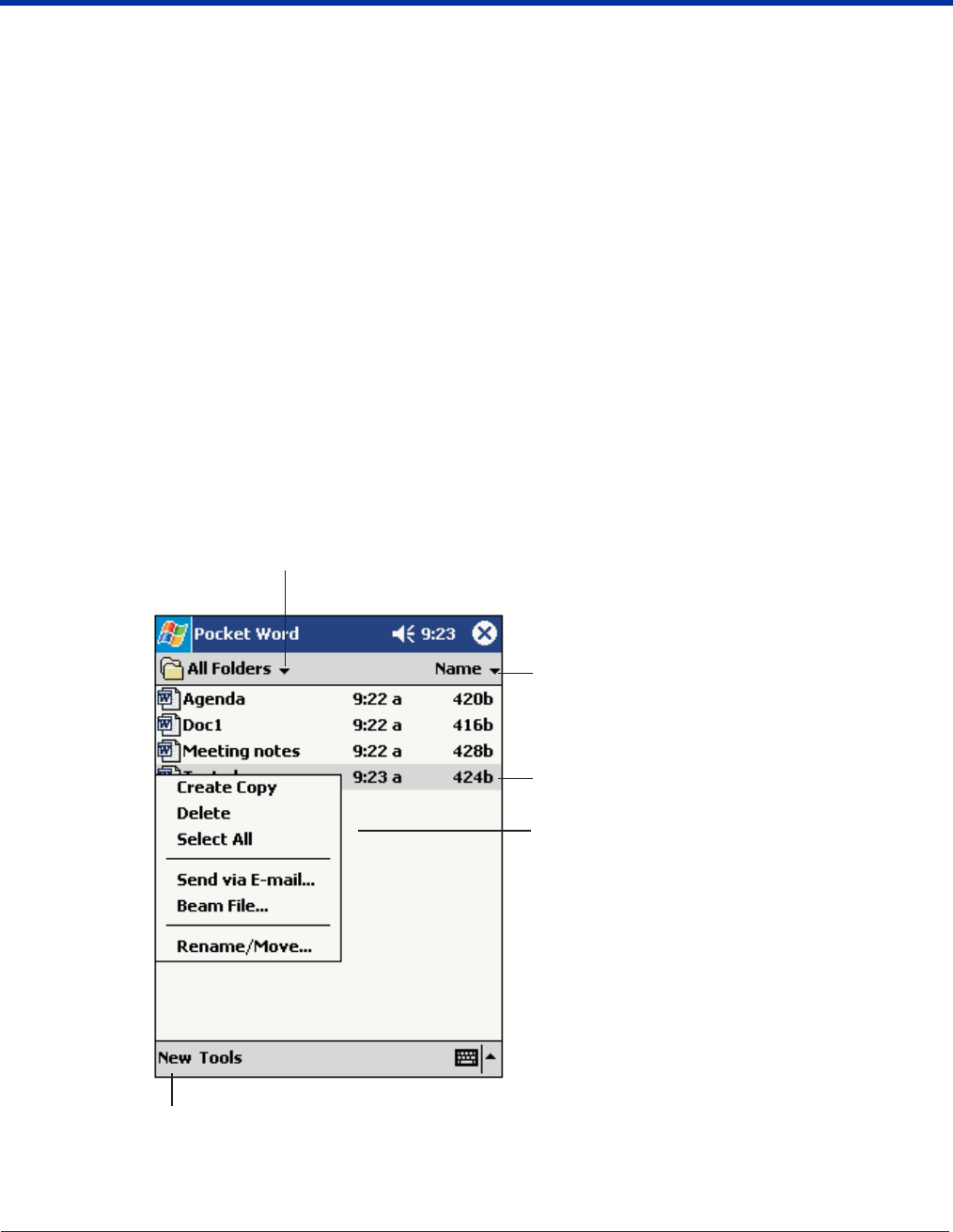
Dolphin® 9500/9550 Mobile Computer User’s Guide - GSM Draft 10 - 21
Companion Programs
The companion programs for Pocket PC installed on Dolphin 9500/9550 terminals are
• Pocket Word and
• Pocket Excel.
Windows® Media Player™ for Pocket PC, Microsoft® Money, MSN® Messenger, Microsoft® Reader are NOT installed on the
Dolphin 9500/9550 when shipped but may be installed from the Microsoft Companion CD.
Pocket Word
Pocket Word works with Microsoft Word on your desktop computer to give you easy access to copies of your documents. You
can create new documents on your device, or you can copy documents from your desktop computer to your device. Synchronize
documents between your desktop computer and your device so that you have the most up-to-date content in both locations.
Use Pocket Word to create documents, such as letters, meeting minutes, and trip reports.
To create a new file, tap Start > Programs > Pocket Word > New. A blank document appears. Or, if you’ve selected a template
for new documents in the Options dialog box, that template appears with appropriate text and formatting already provided. You
can open only one document at a time; when you open a second document, you’ll be asked to save the first. You can save a
document you create or edit in a variety of formats, including Word (.doc), Pocket Word (.psw), Rich Text Format (.rtf), and Plain
Text (.txt).
Using Pocket Word
Pocket Word contains a list of the files stored on your device. Tap a file in the list to open it. To delete, make copies of, and send
files, tap and hold a file in the list. Then, select the appropriate action on the pop-up menu.
You can enter information in Pocket Word in one of four modes (typing, writing, drawing, and recording), which are displayed on
the View menu. Each mode has its own toolbar, which you can show and hide by tapping the Show/Hide Toolbar button on the
command bar.
You can change the zoom magnification by tapping View and then Zoom. Then select the percentage you want. Select a higher
percentage to enter text and a lower one to see more of your document.
Tap to change the sort
order of the list.
Tap to open a document.
Tap and hold an item to see
a pop-up menu of actions.
Tap to create a new document.
Select the type of folder you
want displayed in the list.
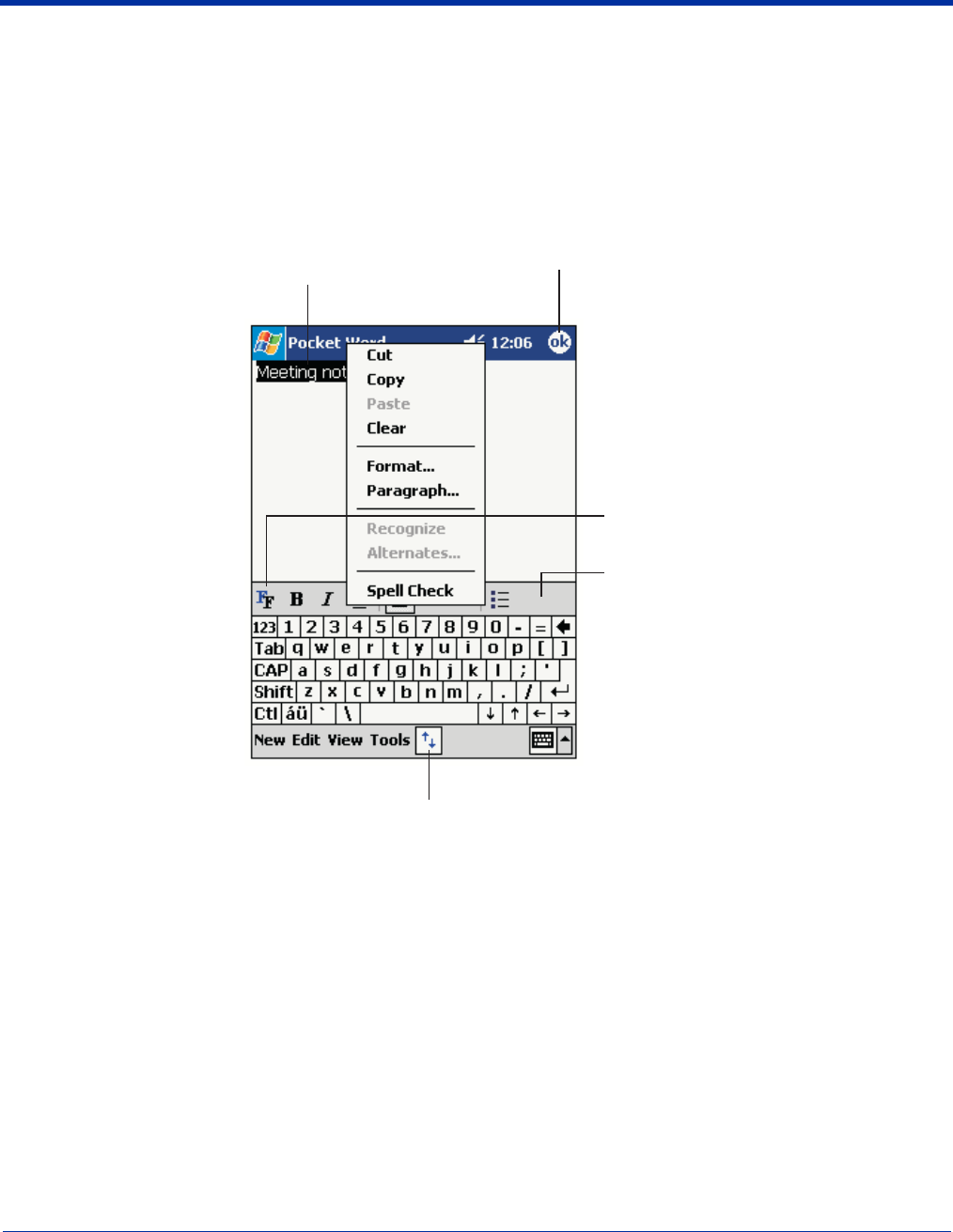
10 - 22 Dolphin® 9500/9550 Mobile Computer User’s Guide - GSM Draft
If you’re opening a Word document created on a desktop computer, select Wrap to Window on the View menu so that you can
see the entire document.
Typing Mode
Using the input panel or Dolphin keypad, enter typed text into the document. For more information on entering typed text, see
Using the Dolphin 9500/9550 Mobile Computer on page 4-1.
To format existing text and to edit text, first select the text. You can select text as you do in a Word document, using your stylus
instead of the mouse to drag through the text you want to select. You can search a document to find text by tapping Edit and
then Find/Replace.
Tap to change
formatting options.
Tap to format text.
Tap and hold to see a
pop-up menu of actions.
Tap to show or hide
the toolbar.
Tap to return to the
document list (changes are
saved automatically).
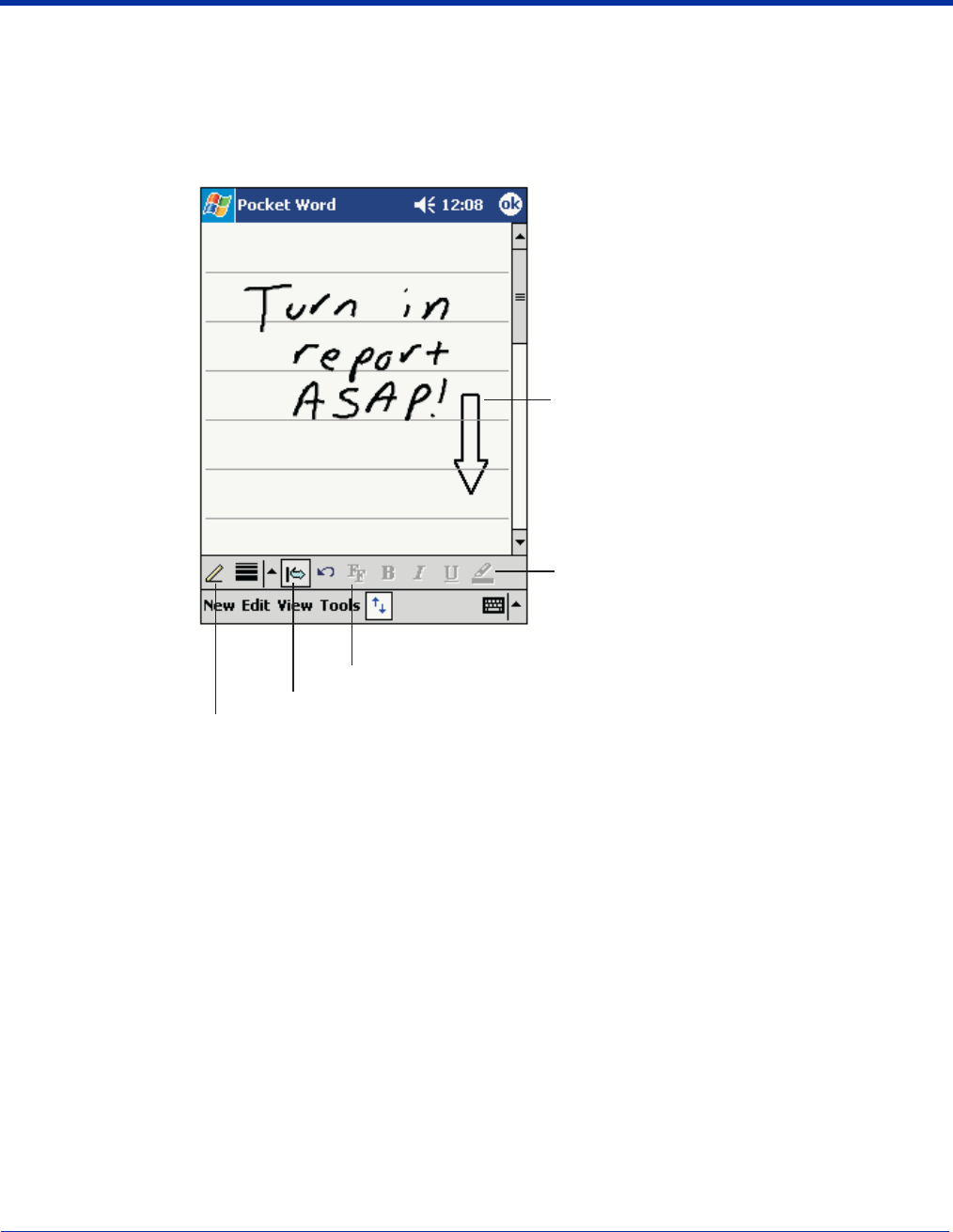
Dolphin® 9500/9550 Mobile Computer User’s Guide - GSM Draft 10 - 23
Writing Mode
In writing mode, use your stylus to write directly on the screen. Ruled lines are displayed as a guide, and the zoom magnification
is greater than in typing mode to allow you to write more easily.
For more information on writing and selecting writing, see Using the Dolphin 9500/9550 Mobile Computer on page 4-1.
Writing on the Screen in Pocket Word
If you cross three ruled lines in a single stylus stroke, the writing becomes a drawing, and can be edited and manipulated as
described in the following section.
Written words are converted to graphics (metafiles) when a Pocket Word document is converted to a Word document on your
desktop computer.
With Space button selected,
drag to insert space. An arrow
appears showing the space
direction and size.
Tap to highlight selected text.
Space button.
Tap to select formatting options,
such as pen weight and line color.
Pen button.
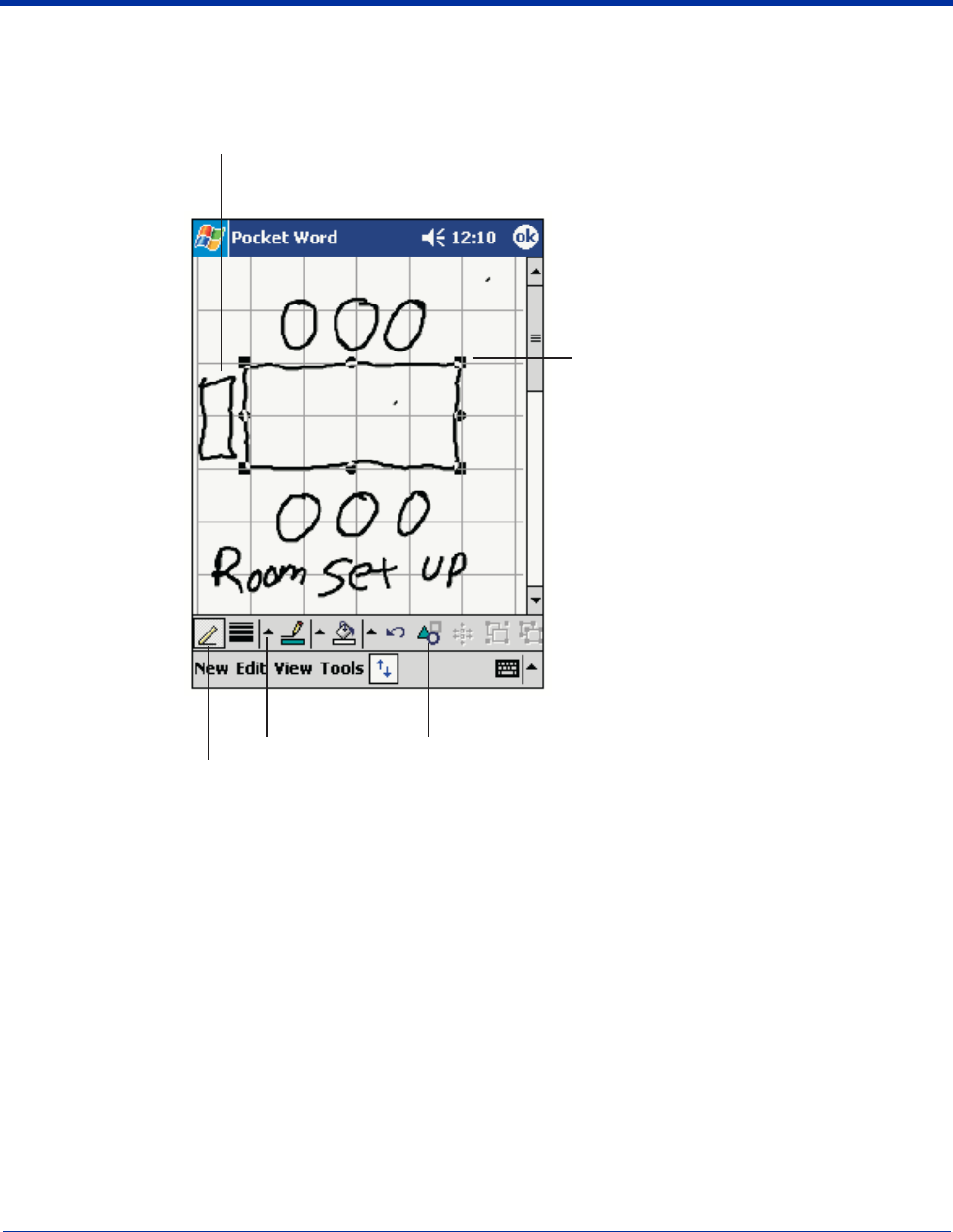
10 - 24 Dolphin® 9500/9550 Mobile Computer User’s Guide - GSM Draft
Drawing Mode
In drawing mode, use your stylus to draw on the screen. Gridlines appear as a guide. When you lift your stylus off the screen
after the first stroke, you’ll see a drawing box indicating the boundaries of the drawing. Every subsequent stroke within or touching
the drawing box becomes part of the drawing.
For more information on drawing and selecting drawings, see Using the Dolphin 9500/9550 Mobile Computer on page 4-1.
For more information on using Pocket Word, tap Start and then Help.
Select Shape on the
pop-up menu to convert
objects to proper shapes.
Resize an object by dragging
the selection handles.
Tap an arrow to
see your choices.
Tap to select formatting options,
such as line weight, fill color, and line color.
Pen button.
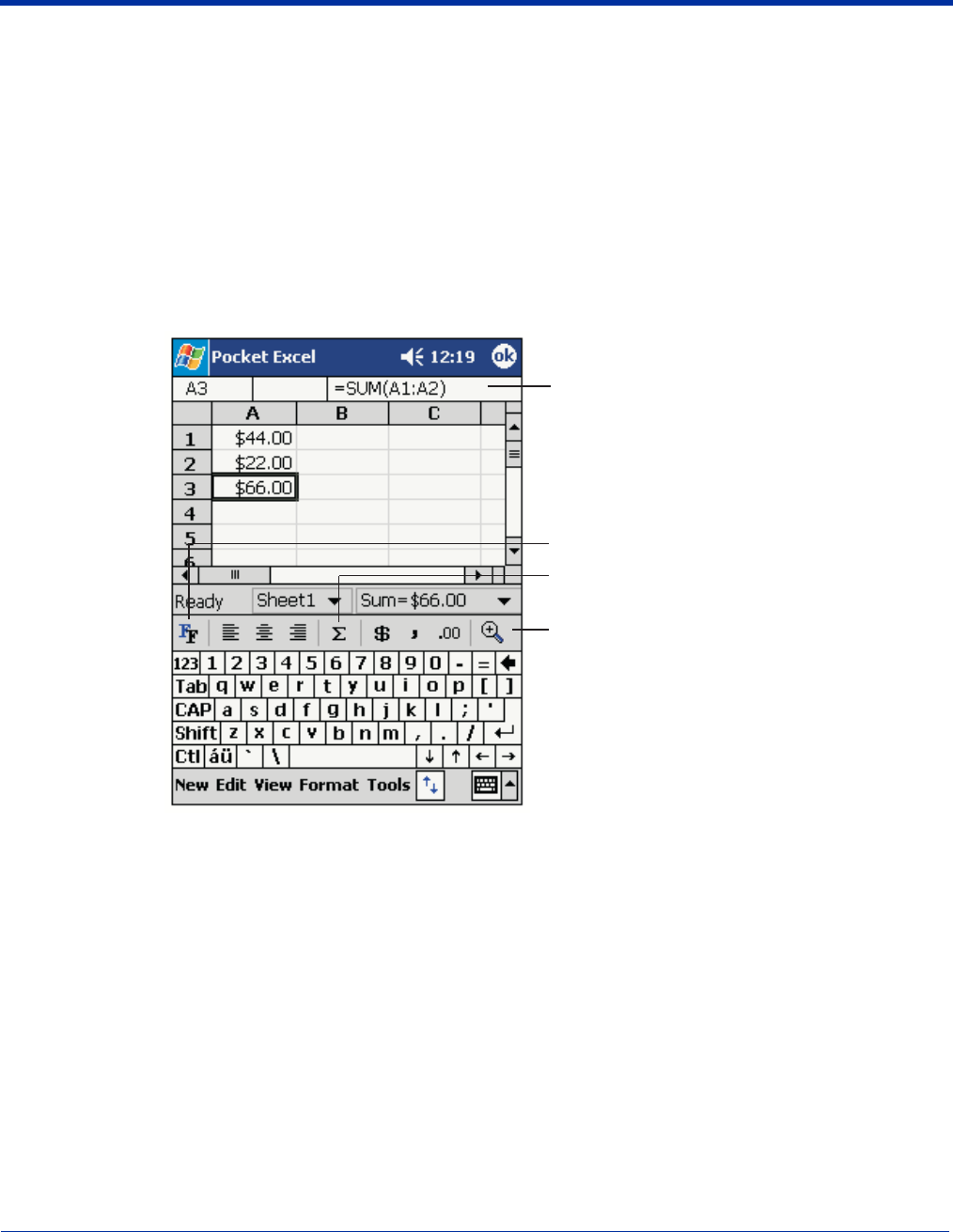
Dolphin® 9500/9550 Mobile Computer User’s Guide - GSM Draft 10 - 25
Pocket Excel
Pocket Excel works with Microsoft Excel on your desktop computer to give you easy access to copies of your workbooks. You
can create new workbooks on your device, or you can copy workbooks from your desktop computer to your device. Synchronize
workbooks between your desktop computer and your device so that you have the most up-to-date content in both locations.
Use Pocket Excel to create workbooks, such as expense reports and mileage logs.
To create a new file, tap Start > Programs > Pocket Excel > New. A blank workbook appears. Or, if you’ve selected a template
for new workbooks in the Options dialog box, that template appears with appropriate text and formatting already provided. You
can open only one workbook at a time; when you open a second workbook, you’ll be asked to save the first. You can save a
workbook you create or edit in a variety of formats, including Pocket Excel (.pxl) and Excel (.xls).
Pocket Excel contains a list of the files stored on your device. Tap a file in the list to open it. To delete, make copies of, and send
files, tap and hold a file in the list. Then select the appropriate action from the pop-up menu.
Pocket Excel provides fundamental spreadsheet tools, such as formulas, functions, sorting, and filtering. To display the toolbar,
tap View > Toolbar.
If your workbook contains sensitive information, you can protect it with a password. To do so, open the workbook, tap Edit, and
then Password. Every time you open the workbook, you will need to enter the password, so choose one that is easy for you to
remember but hard for others to guess.
Tips for Working in Pocket Excel
When working in large worksheets in Pocket Excel:
• View in full-screen mode to see as much of your worksheet as possible. Tap View and then Full Screen. To exit full-screen
mode, tap Restore.
• Show and hide window elements. Tap View and then tap the elements you want to show or hide.
• Freeze panes on a worksheet. First select the cell where you want to freeze panes. Tap View > Freeze Panes. You might
want to freeze the top and left-most panes in a worksheet to keep row and column labels visible as you scroll through a sheet.
• Split panes to view different areas of a large worksheet. Tap View > Split. Then drag the split bar to where you want it. To
remove the split, tap View > Remove Split.
• Show and hide rows and columns. To hide a hidden row or column, select a cell in the row or column you want to hide. Then
tap Format,> Row or Column > Hide. To show a hidden row or column, tap Tools > Go To, and then type a reference that
is in the hidden row or column. Then tap Format > Row or Column > Unhide.
For more information on using Pocket Excel, tap Start > Help.
Cell contents appear here
as you enter them.
AutoSum button.
Format button.
Zoom button.

10 - 26 Dolphin® 9500/9550 Mobile Computer User’s Guide - GSM Draft

Dolphin® 9500/9550 Mobile Computer User’s Guide - GSM Draft 11 - 1
11
Dolphin 9500/9550 HomeBase
Overview
As the hub of your Dolphin 9500/9550 system, the Dolphin HomeBase charging and communication cradle supports both RS-
232 and USB communications, which make it able to interface with the majority of PC-based enterprise systems. When a terminal
is seated in the HomeBase, its main battery pack charges in less that four hours.
Power
The HomeBase provides power to the intelligent battery charging system that prevents over- and undercharging incorporated
into Dolphin terminals. The base senses when a full charge has been achieved and switches to a trickle charge. The HomeBase
completes a full charge of the main battery pack in less than four hours.
Communications
Reliable data communications at speeds of up to 115k baud can be transmitted by the HomeBase through the RS-232 serial
port. Using the full-speed USB port, the data transmission rate is12 Mbps.
HomeBases cannot be physically connected to each other - sometimes referred to as “daisy-chained” - but can be networked
together via a serial or USB hub.
Convenient Storage
Intelligent battery charging makes the Dolphin HomeBase a safe and convenient storage receptacle for your Dolphin terminal.
Capacity
The Dolphin HomeBase holds one terminal and features an auxiliary battery well behind the terminal well that can charges a
battery pack independently of the terminal well. This means that one HomeBase can charge two batteries: the one installed in
the terminal and a spare.
Use only Dolphin 9500 series peripherals, power cables, and power adapters. Use of peripherals, cables, or power
adapters not sold/manufactured by HHP will void the warranty and may damage the terminal.
Use only the Li-ion battery packs provided by HHP. The use of any battery pack not sold/manufactured by HHP in the
Dolphin 9500/9550 terminal will void your warranty and may result in damage to the Dolphin terminal or battery.
!
!
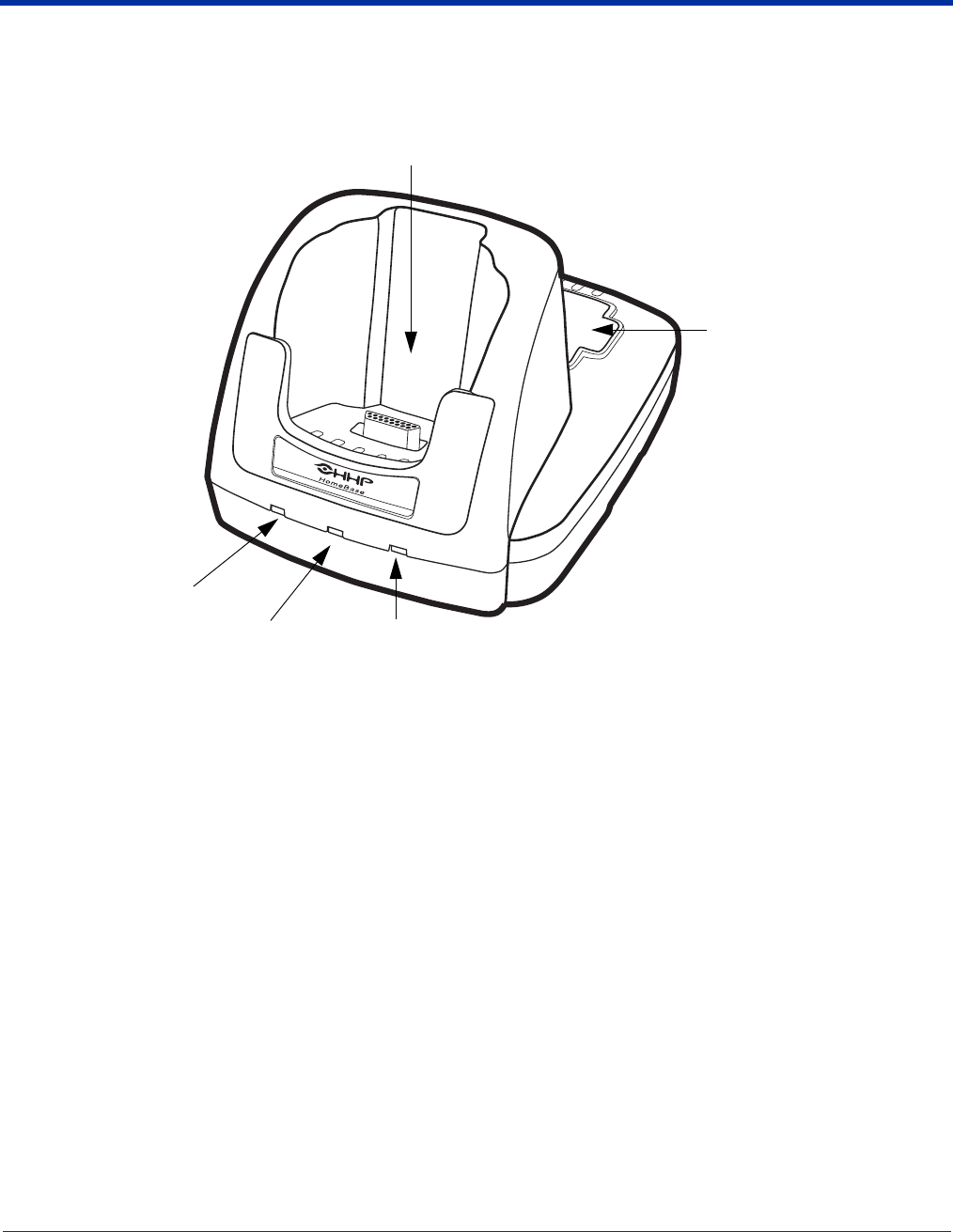
11 - 2 Dolphin® 9500/9550 Mobile Computer User’s Guide - GSM Draft
Dolphin 9500/9550 HomeBase Parts and Functions
Front Panel
Terminal Well
Place the Dolphin terminal in this well both to communicate with a host device. If the host device is a desktop computer
that uses ActiveSync, synchronization begins immediately. While seated in the terminal well, the main battery installed
in the terminal charges. The HomeBase completely charges a battery pack in less than four hours.
Auxiliary Battery Well
See Auxiliary Battery Well on page 11-4.
DOCK LED
Turns solid green when the Dolphin terminal is properly seated in the Dolphin HomeBase. When this light is on, the
terminal is connected to the base.
AUX Battery LED
Indicates status of the battery charging in the auxiliary battery well.
To see the auxiliary battery well, see Rear Panel on page 11-4.
This color means…
Orange
The auxiliary battery is charging.
Green
The auxiliary battery has completed charging and is ready for use.
DOCK
AUX BATTERY
COMM
Terminal Well
DOCK LED
Auxiliary Battery Well
AUX Battery LED COMM
LED

Dolphin® 9500/9550 Mobile Computer User’s Guide - GSM Draft 11 - 3
For information about charging a battery in the auxiliary battery well, see page 11-7.
COMM LED
This is the communication LED. It indicates the status of data transfer between the Dolphin terminal and the host device.
The color of this LED differs if the HomeBase is using the serial or USB port connection.
If using the serial port:
If using the USB Port:
This color means…
Red
Serial data is being sent from the Host Device to the Dolphin
HomeBase.
Green
Serial data is being sent from the Dolphin HomeBase to the Host Device.
Orange
Serial data is being sent at high data rates.
This color means…
Green LED
A USB Connection is established with the host computer.
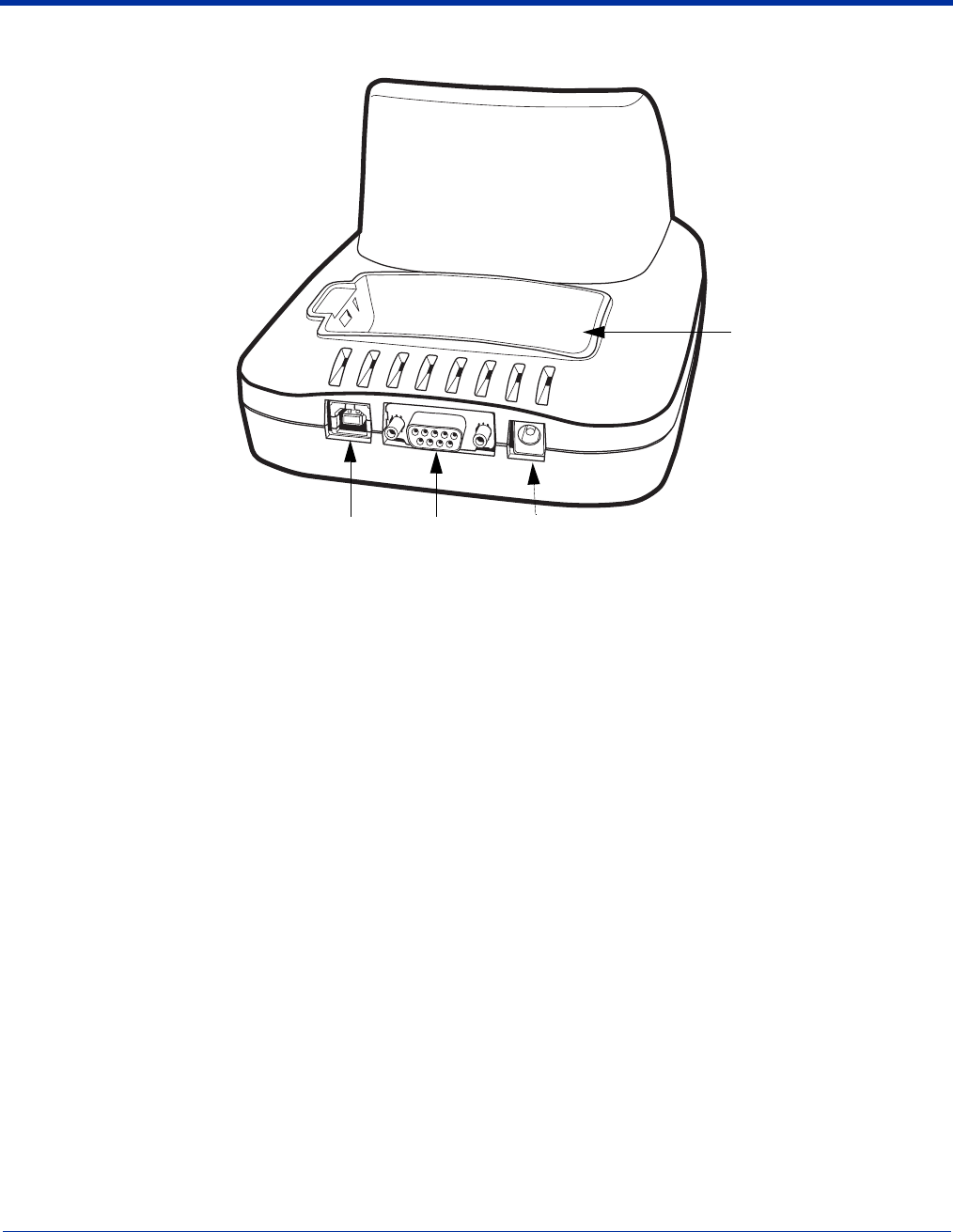
11 - 4 Dolphin® 9500/9550 Mobile Computer User’s Guide - GSM Draft
Rear Panel
Auxiliary Battery Well
The HomeBase enables you to charge an additional Li-ion battery pack independently of the terminal well. This feature
ensures that you can always have a fully-charged battery for your Dolphin terminal. See Powering the HomeBase on
page 11-6.
USB Port
This USB Port is full-speed and 2.0 compliant. Using a USB cable, you can connect the HomeBase to a peripheral
device, such as a desktop computer or printer. When the Dolphin 9500/9550 is seated in the terminal well, it is
connected to the peripheral device via the HomeBase.
The USB port on the HomeBase requires that you use ActiveSync 3.7 or higher.
RS-232 Port
Use a 9-pin, RS-232 cable from HHP to connect this port to a peripheral device for RS-232 data communication. For
more information, see HomeBase Serial Connector on page 11-5.
DC Power Jack
Use a power cable from HHP to supply power to this power jack. For more information, see Powering the HomeBase
on page 11-6.
Note: Please contact HHP for communication and power cable pricing and part numbers.
Auxiliary Battery Well
DC Power JackRS-232 PortUSB Port
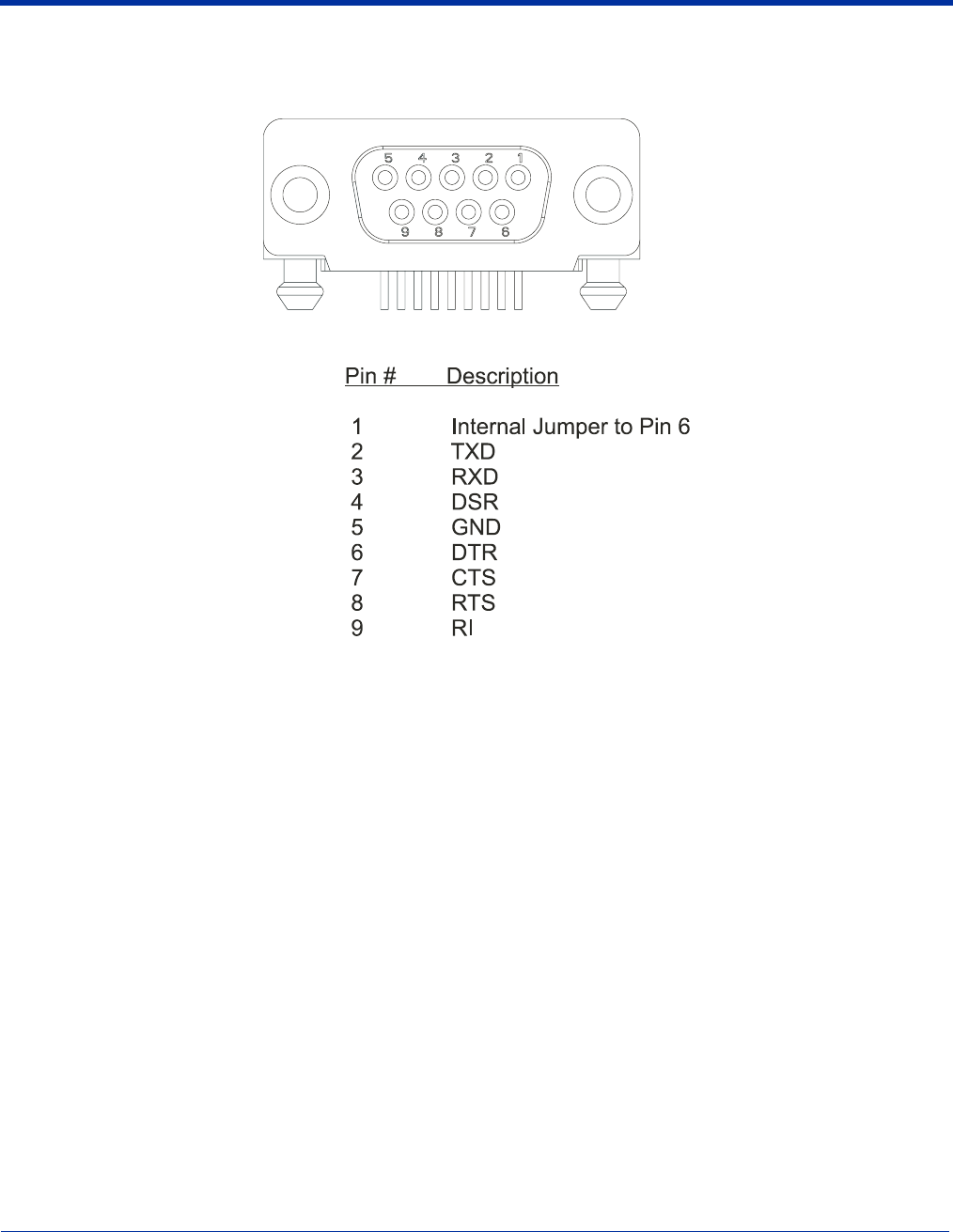
Dolphin® 9500/9550 Mobile Computer User’s Guide - GSM Draft 11 - 5
HomeBase Serial Connector
The following diagram displays the serial connector of the HomeBase.
Note: Signals referenced are for a DTE device. The Home Base is at a right-angle to the printed circuit board (PCB). The ninth
pin has a ring indicator (RI).

11 - 6 Dolphin® 9500/9550 Mobile Computer User’s Guide - GSM Draft
Powering the HomeBase
The terminal requires 9.5 Volts DC input for communications and battery charging; the HHP power cable converts the power
source voltage accordingly.
1. Connect the HHP power cable to the DC jack on the rear of the HomeBase.
2. Connect the HHP power cable to the power source.
HHP recommends that you leave the Dolphin HomeBase connected to its power source at all times, so that it is always ready to
use.
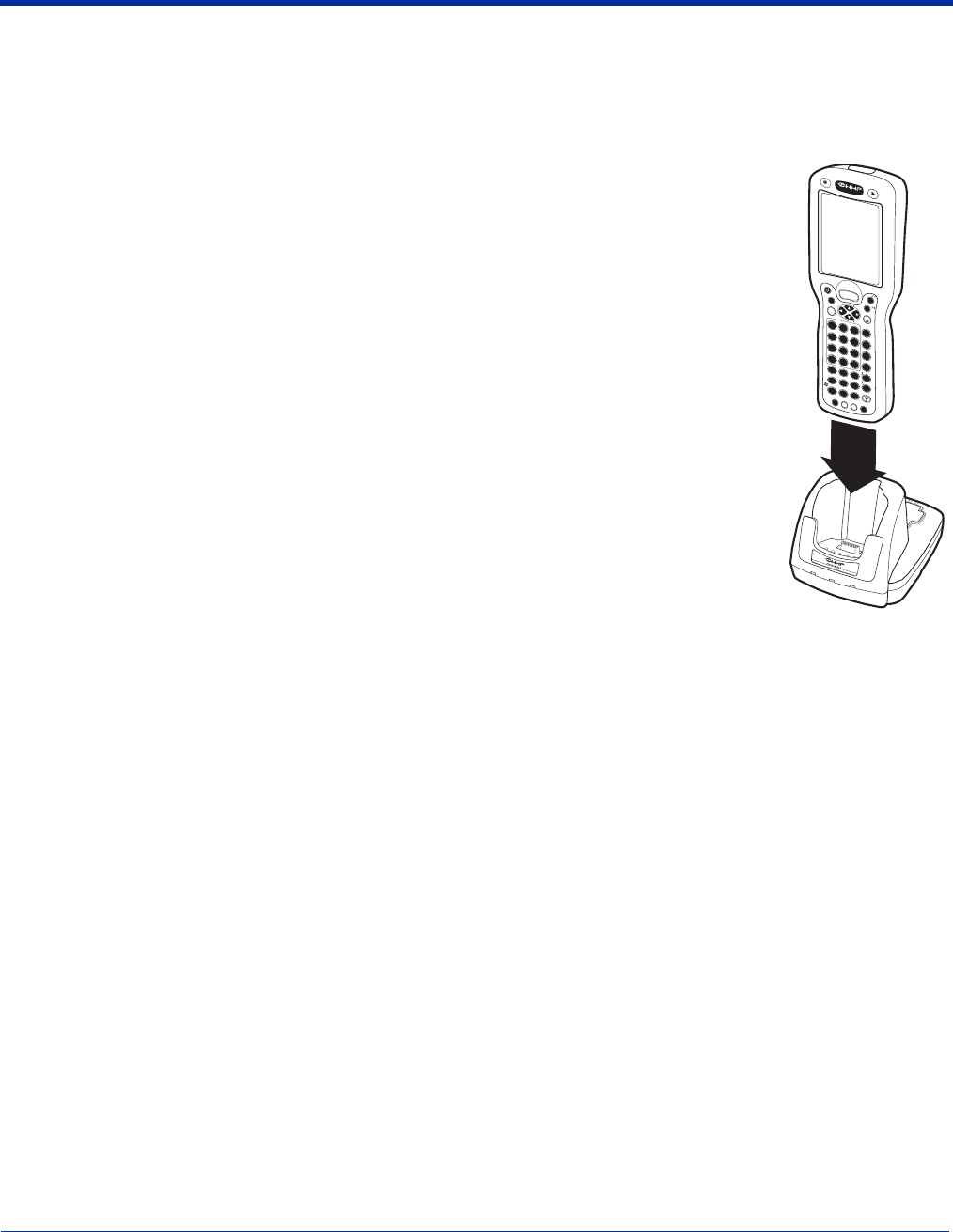
Dolphin® 9500/9550 Mobile Computer User’s Guide - GSM Draft 11 - 7
Charging the Main Battery
The Dolphin HomeBase powers the terminal and fully charges its main battery pack in less that four hours. The HomeBase
contains an intelligent battery charging system that protects the battery from being damaged by overcharging; the unit senses
when a battery pack is fully charged and automatically switches to maintain the battery at full capacity indefinitely. Therefore,
Dolphin terminals may be stored in the HomeBase indefinitely without damage to the terminals, battery packs, or peripherals.
To check battery power, use the Power system setting; see Power on page 5-11.
For more information about HHP Li-ion batteries, see Batteries on page 3-10.
To Power a Terminal and Charge its Main Battery
1. Install the battery pack in the terminal; see Install the Main Battery Pack on page 2-6.
1. Connect the HomeBase to the power supply provided by HHP.
2. Slide the terminal into the terminal well until the Dock LED lights green to indicate that the terminal is
properly seated.
3. The battery pack begins charging.
Charging a Spare Battery Using the Auxiliary Battery Well
The auxiliary battery well located on the back of the HomeBase charges a spare battery independently
of the terminal well. The Aux Battery LED on the front panel indicates the status of the battery in this well.
Charge time is less than four hours.
To see this well, see Auxiliary Battery Well on page 11-2.
1. Insert the end of the battery without the locking tab into the bottom of the auxiliary well opening.
2. Snap the battery into place with a hinging motion. The Aux Battery LED lights orange.
3. Use the AUX Battery LED to monitor charging progress.
DOCK
AUXBATTERY
COMM
DOLPHIN9500
SCAN
ESC
TAB
SFT
ABC
EFG
IJK
MNO
S
R
Q
UVW
YZ
D
H
L
P
T
X
NUM
ENT
123
789
456
;:
*
@
F1F2F3F4
F5F6F7F8
STARTINSBKSPDEL
CTRLALT
SEND
END
POWER
V
O
L
P
G
V
O
L
P
G
+
+
-0
,
SP
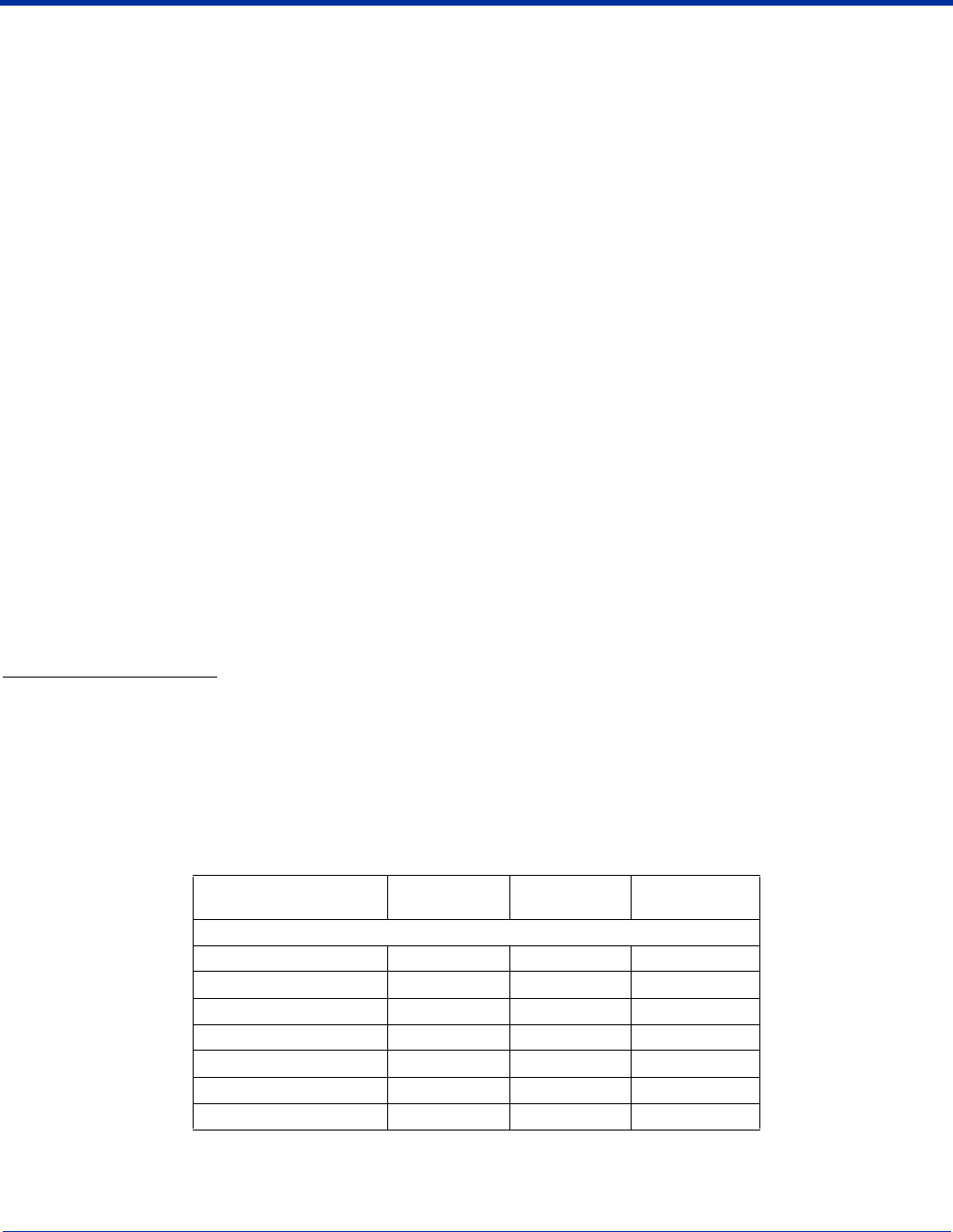
11 - 8 Dolphin® 9500/9550 Mobile Computer User’s Guide - GSM Draft
Communications
Communications Types
RS-232
The HomeBase supports RS-232 communications via the RS-232 Communications Port located on the back of the device. Tis
port enables the Dolphin terminal to communicate to a personal computer, modem, or any RS-232 device using a standard serial
cable and communications software.
USB
The HomeBase also supports USB communications via the USB port located on the back. The HomeBase acts as a USB device
by interfacing the USB signals of the Dolphin 9500/9550 to the USB of the host computer. Using a standard USB cable, the
HomeBase’s USB interface allows the Dolphin terminal to communicate with a personal computer or to be networked through a
USB hub.
Note: The HomeBase should have only one type of interface cable connected at a time, either USB or RS-232. You must be
using ActiveSync, version 3.7 or higher.
Equipment Requirements
To install and use the HomeBase, you need the following equipment:
• HomeBase connected to the appropriate power supply
• For RS-232 communications, a Serial cable
• For USB communications, a USB cable
CAUTION! Use only the power and communication cable from HHP.
Setting up the HomeBase for RS-232 Communications
Connecting the Cables
Connect the HomeBase to the host computer or other device by plugging an RS-232 serial cable into the RS-232
Communications Port on the rear of the HomeBase. The wiring of your cable depends on whether the other device is set up as
a Data Communications Equipment (DCE) or Data Terminal Equipment (DTE) device.
The HomeBase Communication Port is configured as a DCE device. To communicate with a DCE device, use either a null
modem adapter in line with a standard RS-232 cable, or a null-modem serial cable. To communicate with a DTE device such as
a computer, use a standard (or straight-through) RS-232 cable.
You can make your own cables by following the pin configuration in the chart below. To do so, you must determine if your host
RS-232 device is 9-pin or 25-pin, and whether it is configured as a DCE or DTE device.
Note: The HomeBase cannot be daisy-chained.
HomeBase /Host Port
(DCE)
IBM AT DB9
(DTE)
IBM XT
DB25 (DTE)
Modem DB25
(DCE)
Pin / Input Signal
2 / (RD) 2 3 2
3 / (TD) 3 2 3
5 / (SG) 5 7 7
4 / (DTR) 4 20 6
6 / (DSR) 6 6 20
7 / (RTS) 7 4 5
8 / (CTS) 8 5 4
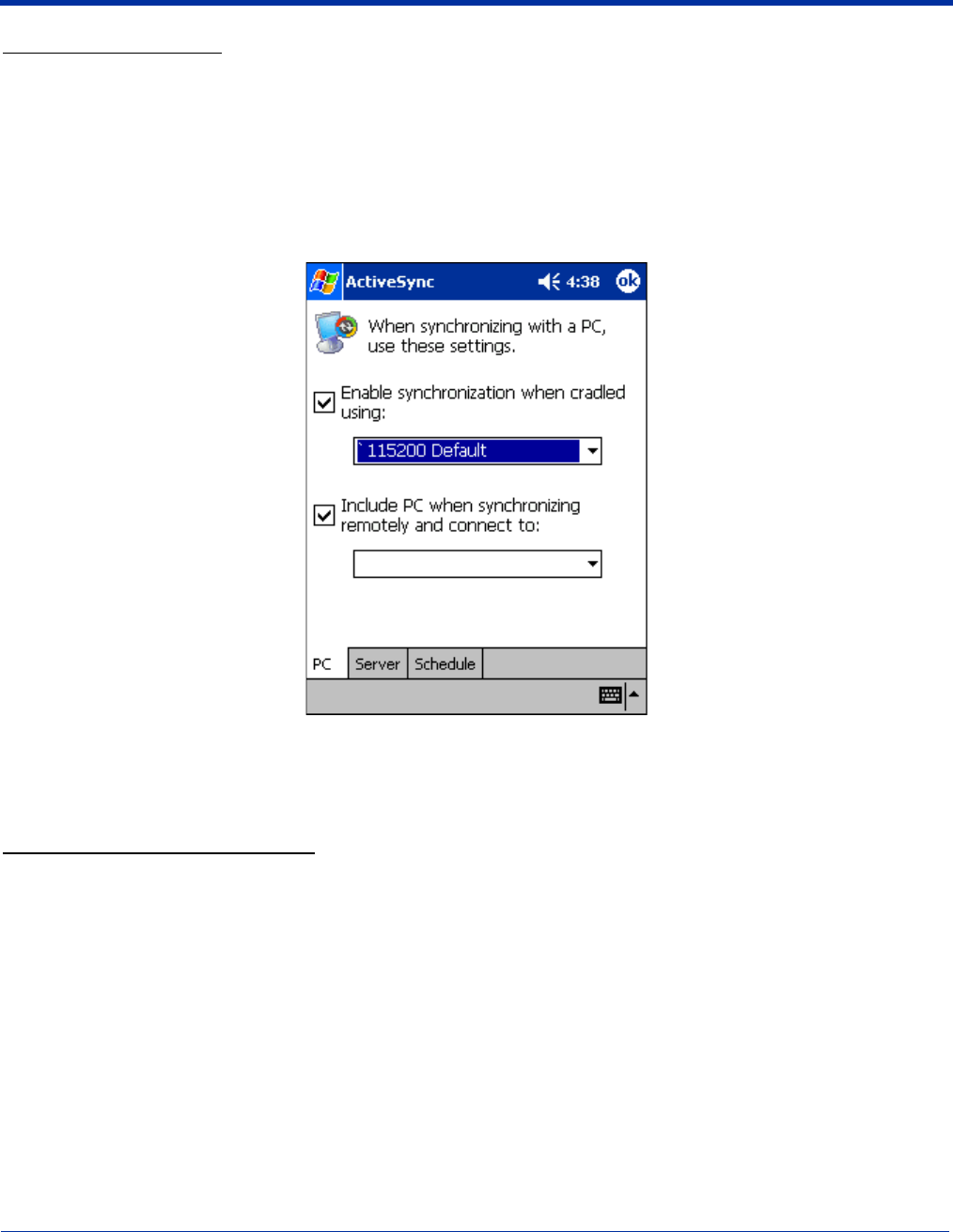
Dolphin® 9500/9550 Mobile Computer User’s Guide - GSM Draft 11 - 9
Setting up the Terminal
The Dolphin terminal may be configured for communications using the ActiveSync options as described in Chapter 2 or manually
as described below.
To set Communications Properties, complete these steps:
1. Select Start > ActiveSync > Tools > Options.
2. Select the PC tab.
3. Check the Enable synchronization box and select the desired option from the pull-down list; 115200 Default is
recommended for an RS-232 connection.
4. Tap OK.
5. Place the Dolphin in the cradle. The Dolphin 9500/9550 attempts to start an ActiveSync connection with the desktop
computer automatically.
Setting up the Desktop Computer
ActiveSync must be installed and configured for RS-232 on the desktop computer to sync successfully with a Dolphin 9500/9550
device that is configured for RS-232 communication.
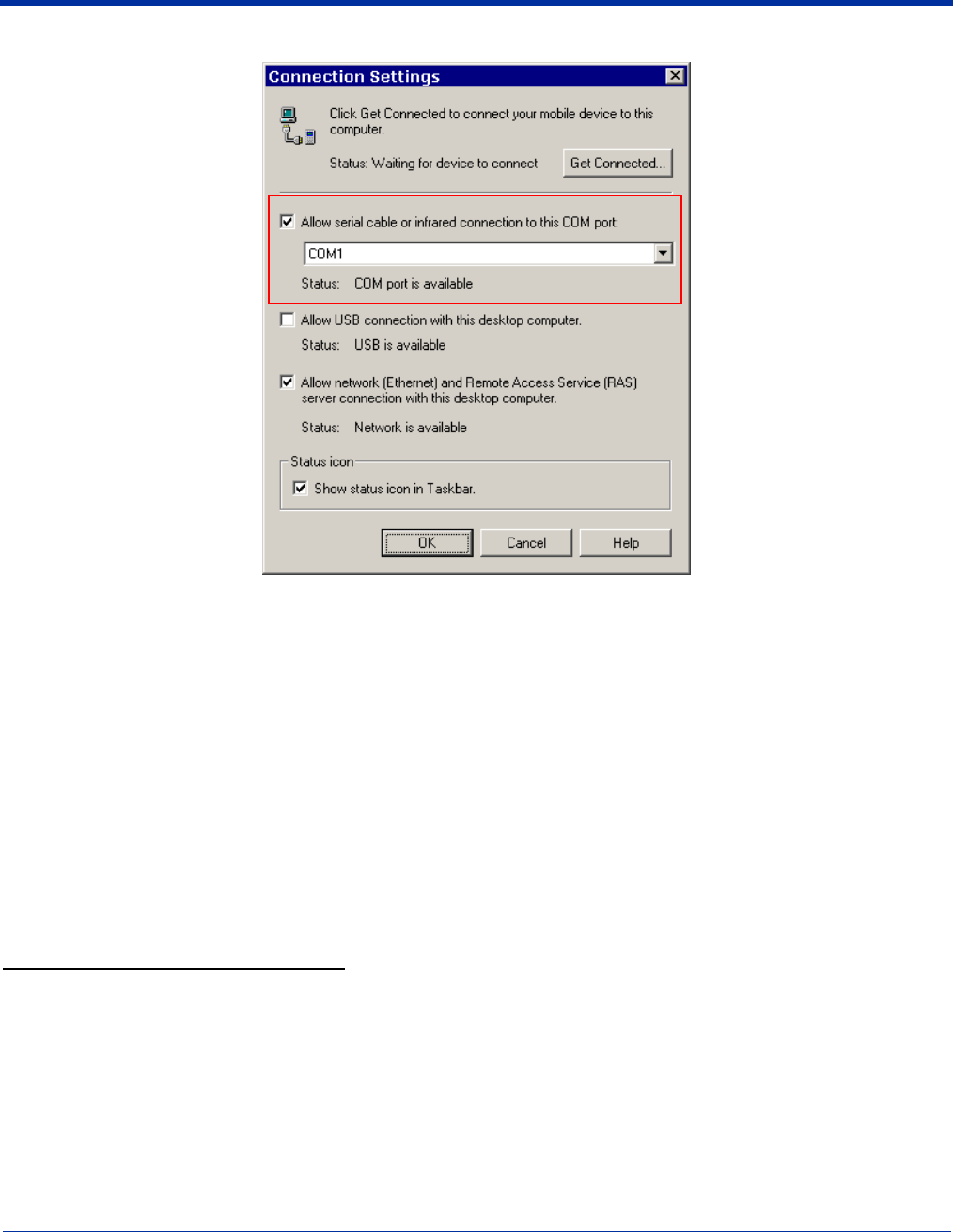
11 - 10 Dolphin® 9500/9550 Mobile Computer User’s Guide - GSM Draft
The following graphic displays the correct ActiveSync Connection Settings on the desktop computer for an RS-232 connection.
Note: You can have the USB connection box checked in addition to the serial cable box without affecting processing. However,
you would most likely use one or the other.
Setting up the HomeBase for USB Communication
The Dolphin 9500/9550 terminal is defaulted to support USB communications out of the box.
Required Equipment:
• HomeBase with power supply
• USB Cable
• ActiveSync v3.7 or above
• Windows® 98 second edition*, Windows® Me, Windows® 2000, or Windows® XP computer.
Note: The HomeBase does not support Windows
NT® when using a USB connection.
This is because Windows
NT
does not
support USB
.
*Windows® 98 second edition provides full USB support.
To Install the HomeBase Using USB
Note: You must be using ActiveSync 3.7 or higher.
Complete these steps:
1. Plug in the power supply and connect it to the back of the HomeBase.
2. Plug the USB cable into the back of the HomeBase.
3. At this point, the hardware is installed and operating. You may need to reboot your PC to complete the installation process.
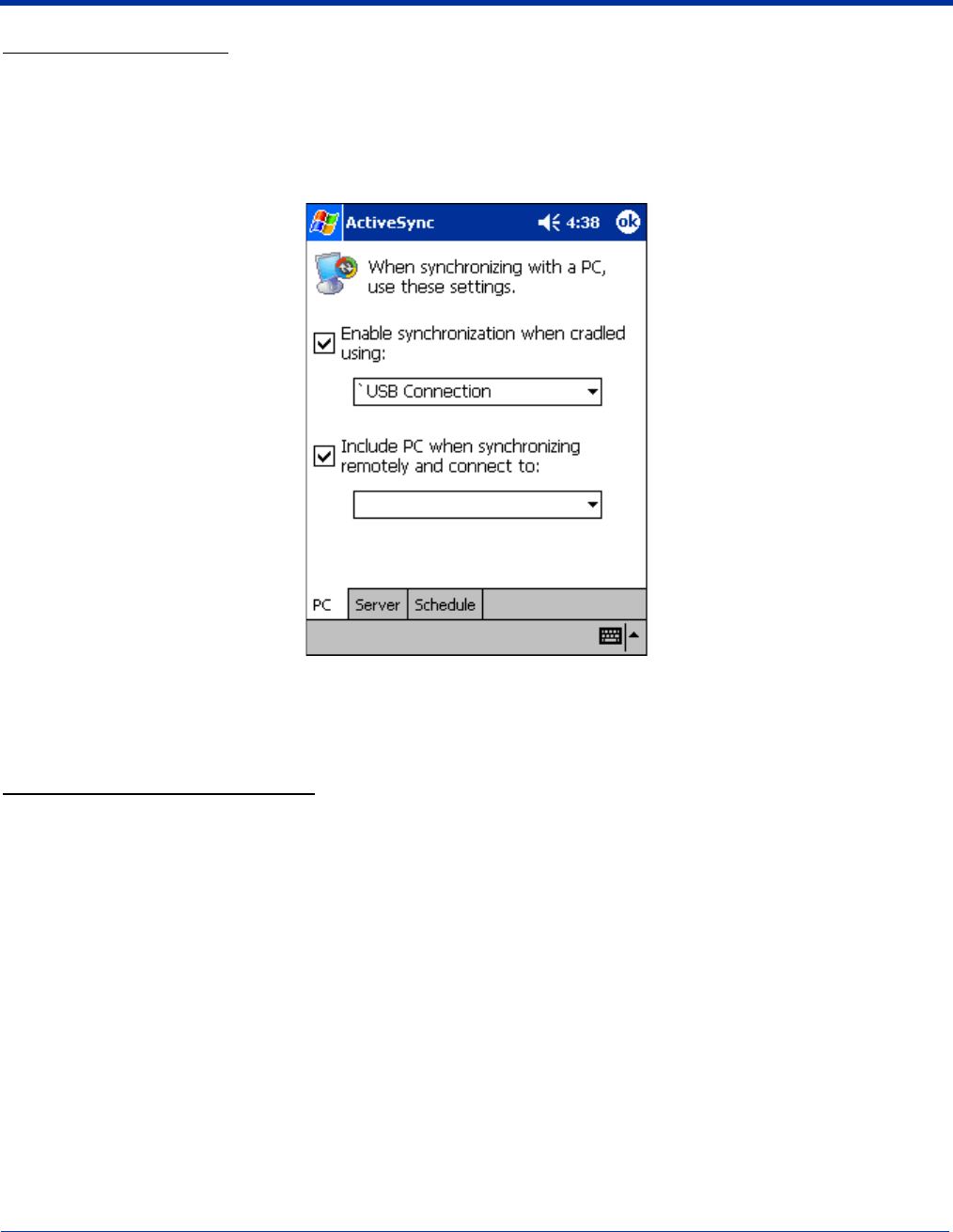
Dolphin® 9500/9550 Mobile Computer User’s Guide - GSM Draft 11 - 11
Setting up the Terminal
To select ActiveSync options:
1. Select Start > ActiveSync > Tools > Options.
2. Select the PC tab.
3. Check the Enable synchronization box and select ‘USB Connection from the drop-down list.
4. Tap OK.
5. Place the Dolphin in the cradle. The Dolphin 9500/9550 attempts to start an ActiveSync connection with the desktop
computer automatically.
Setting up the Desktop Computer
After the USB HomeBase is installed, you can use ActiveSync to connect to a Dolphin 9500/9550 terminal that is properly seated
in the HomeBase. These instructions assume that ActiveSync v3.7 is installed on your PC.
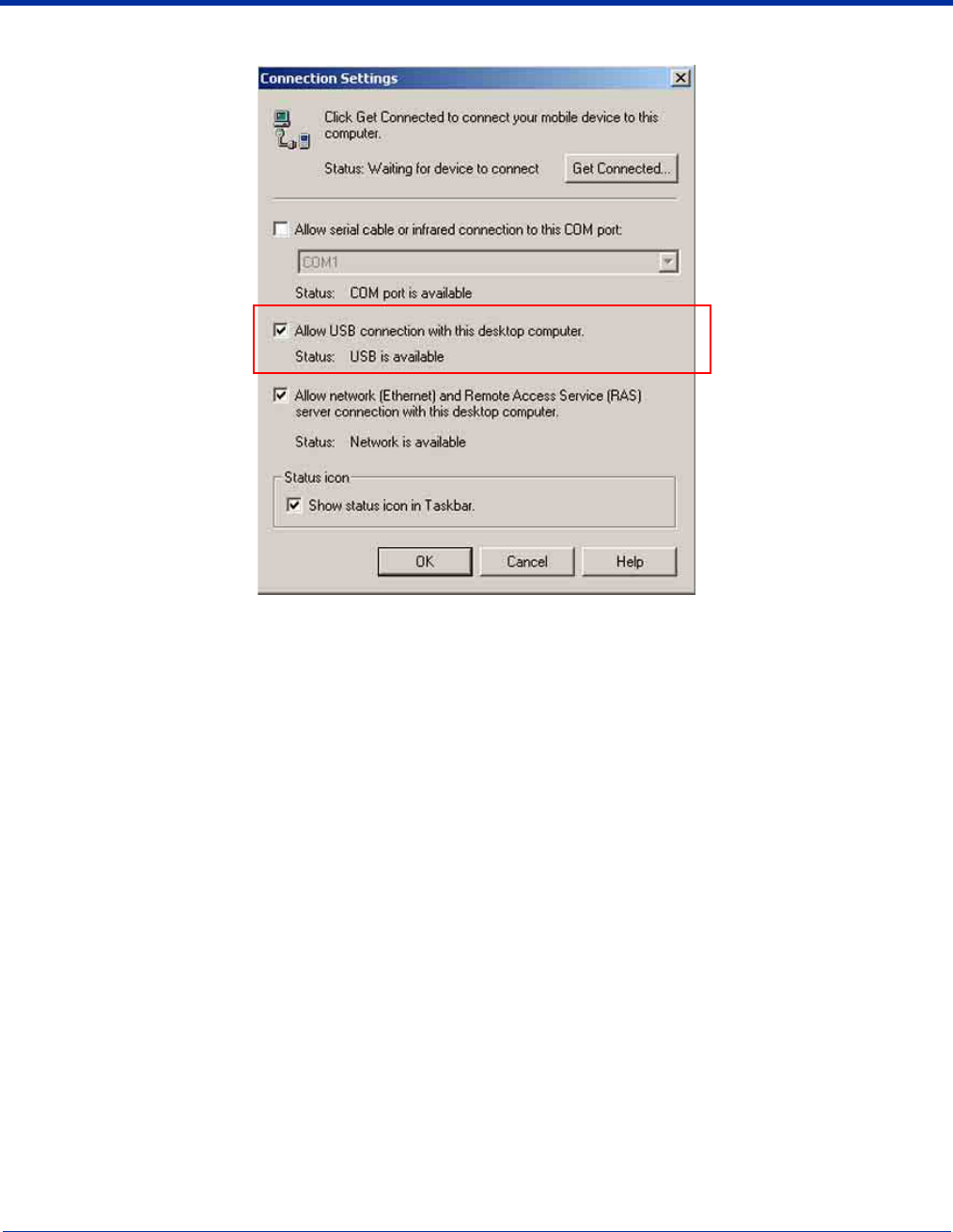
11 - 12 Dolphin® 9500/9550 Mobile Computer User’s Guide - GSM Draft
The ActiveSync Connection Settings must be set as the following graphic indicates.
The Allow USB connection with this desktop computer box must be checked. Do not check the serial cable box.
Communicating with the Dolphin 9500/9550 Terminal
To initiate communications between the Dolphin 9500/9550 and its peripheral, complete these steps:
1. Insert the Dolphin 9500/9550 into the terminal well of the HomeBase.
• The DOCK LED illuminates green. If the DOCK LED does not illuminate, make sure that the terminal is properly seated.
You may need to remove and re-insert the terminal.
• The Dolphin terminal activates; if the power is off, the terminal automatically powers on. If the terminal does not power on,
verify that the HHP power supply is properly connected to the cradle and plugged into a functioning outlet.
• The Dolphin 9500/9550 terminal automatically opens ActiveSync to establish a connection.
2. The HomeBase can now transfer data between the terminal and the host device. If communication does not occur, check the
port connections to ensure that the cradle is correctly configured.
Verifying Communication
You can verify that the USB driver is functioning by watching the COMM LED on the USB HomeBase. When the COMM LED
illuminates solid green, the HomeBase is communicating with the host device.
Verifying Data Transfer
The COMM LED flashes when data is being transferred via the HomeBase. For an RS-232 connection, the COMM LED flashes
red and green. For a USB connection, the COMM LED flashes green.
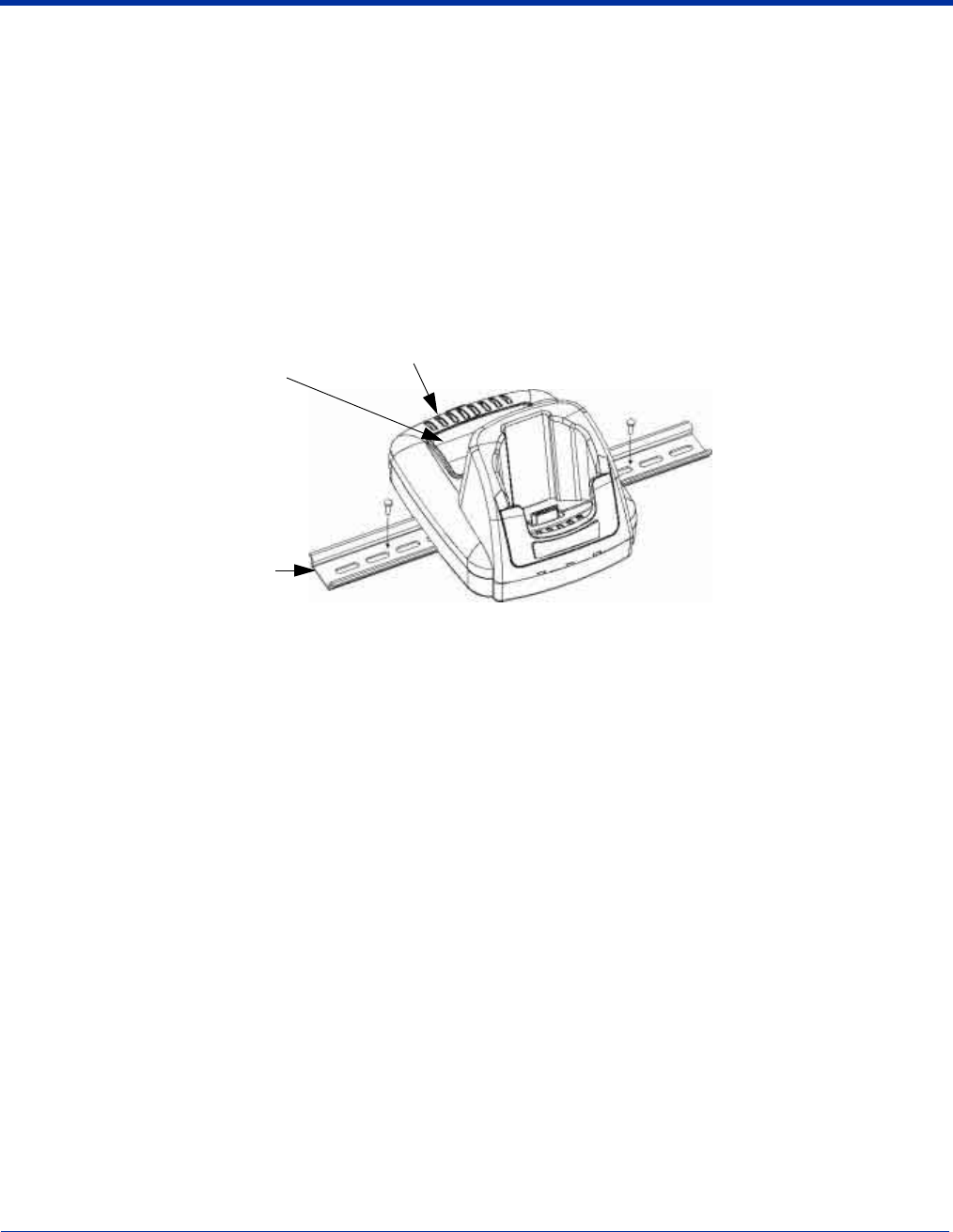
Dolphin® 9500/9550 Mobile Computer User’s Guide - GSM Draft 11 - 13
Mounting the HomeBase
Set the Dolphin HomeBase on a dry, stable surface, such as a desktop or workbench near an electrical outlet. Be sure to provide
enough workspace with good lighting for the user to view and operate the Dolphin terminal while it is in the HomeBase.
When choosing a location, bear in mind that:
• the mounting location must allow users easy access to the Auxiliary Battery Well, and
• the serial and USB ports as well as the power jack face straight out of the rear panel, and you will most likely want easy access
to them in the future.
Desk Mounting
Dolphin charging/communication cradles have a DIN rail (7.5 X 35 mm) slot on the bottom to allow for secure desk attachment
of the unit if desired.
To mount the HomeBase, you slide the DIN rail slot along the bottom panel and secure it. Then, using the appropriate nuts and
bolts, secure the DIN rail to the desk or flat surface.
Auxiliary Battery Well
Serial and USB port location (not in view)
DIN rail (7.5 X 35 mm)
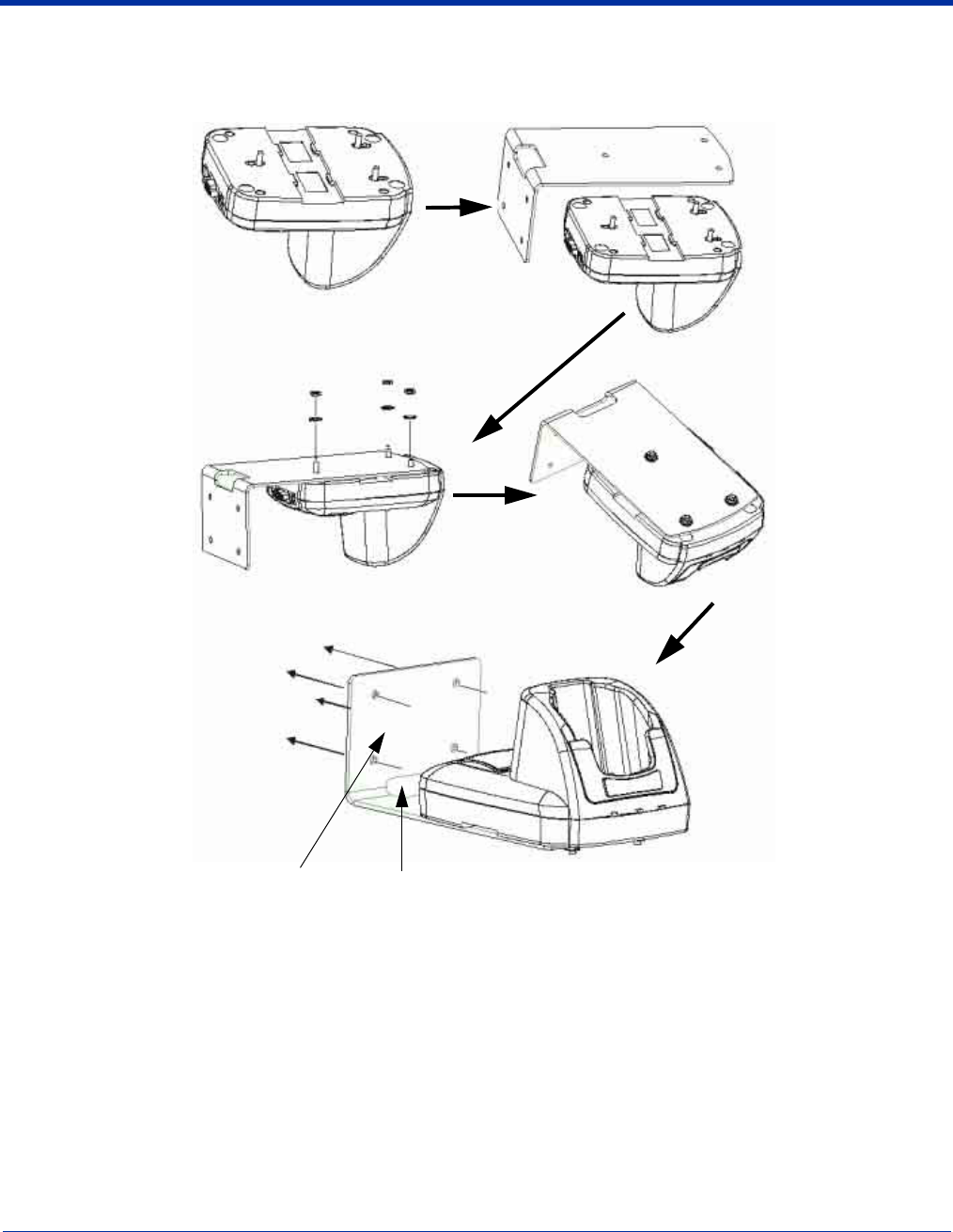
11 - 14 Dolphin® 9500/9550 Mobile Computer User’s Guide - GSM Draft
Wall Mounting
The following diagram displays how to wall-mount a Homebase:
The back wedge of the mounting bracket contains an open slot for the power and communications cables. There is an extra
space between this slot and the rear panel of the HomeBase to allow easy access to the power and communications ports. For
more details on both ports, see Rear Panel on page 11-4.
Secure screws to
the bottom panel
by sliding them
into the available
slots
Fasten the
screws to secure
the HomeBase to
the mounting
bracket
Turn the secured
HomeBase right
side up.
Attach the
bottom panel to
the mounting
bracket - match
the holes to the
secured screws
Using the
appropriate
screws, secure
the mounting
bracket to the
wall or vertical
surface as
shown.
1.
4.
2.
3.
5.
Back wedge Open slot for cords and connectors

Dolphin® 9500/9550 Mobile Computer User’s Guide - GSM Draft 12 - 1
12
Dolphin 9500/9550 Mobile Base
Overview
The Dolphin Mobile Base charging and communication cradle is designed specifically for in-premise and in-transit data collection
applications. It features a flexible mounting bracket, a cigarette lighter adapter, and a power cable to adapt it to your environment.
When a terminal is seated in the Mobile Base, its main battery pack charges in less than four hours. The serial connector supports
RS-232 communication and power out to peripheral devices, such as hand held scanners.
As the hub of your Dolphin 9500/9550 mobile data collection system, the Mobile Base performs three important functions: 1)
charging, 2) communications, and 3) storage.
Charging
The Dolphin Mobile Base provides power to the intelligent battery charging system that prevents over- and undercharging
incorporated into Dolphin terminals. The base senses when a full charge has been achieved and switches to a trickle charge.
The Mobile Base completes a full charge of the main battery pack in less than four hours.
Communications
The Mobile Base transmits data to other devices at speeds of up to 115K baud via its RS-232 serial port.
Convenient Storage
Intelligent battery charging makes the Dolphin Mobile Base a safe and convenient storage receptacle for your Dolphin terminal.
Capacity
The Dolphin Mobile Base holds one terminal.
Use only Dolphin 9500 series peripherals, power cables, and power adapters. Use of peripherals, cables, or power
adapters not sold/manufactured by HHP will void the warranty and may damage the terminal.
Use only the Li-ion battery packs provided by HHP. The use of any battery pack not sold/manufactured by HHP in the
Dolphin 9500/9550 terminal will void your warranty and may result in damage to the Dolphin terminal or battery.
!
!
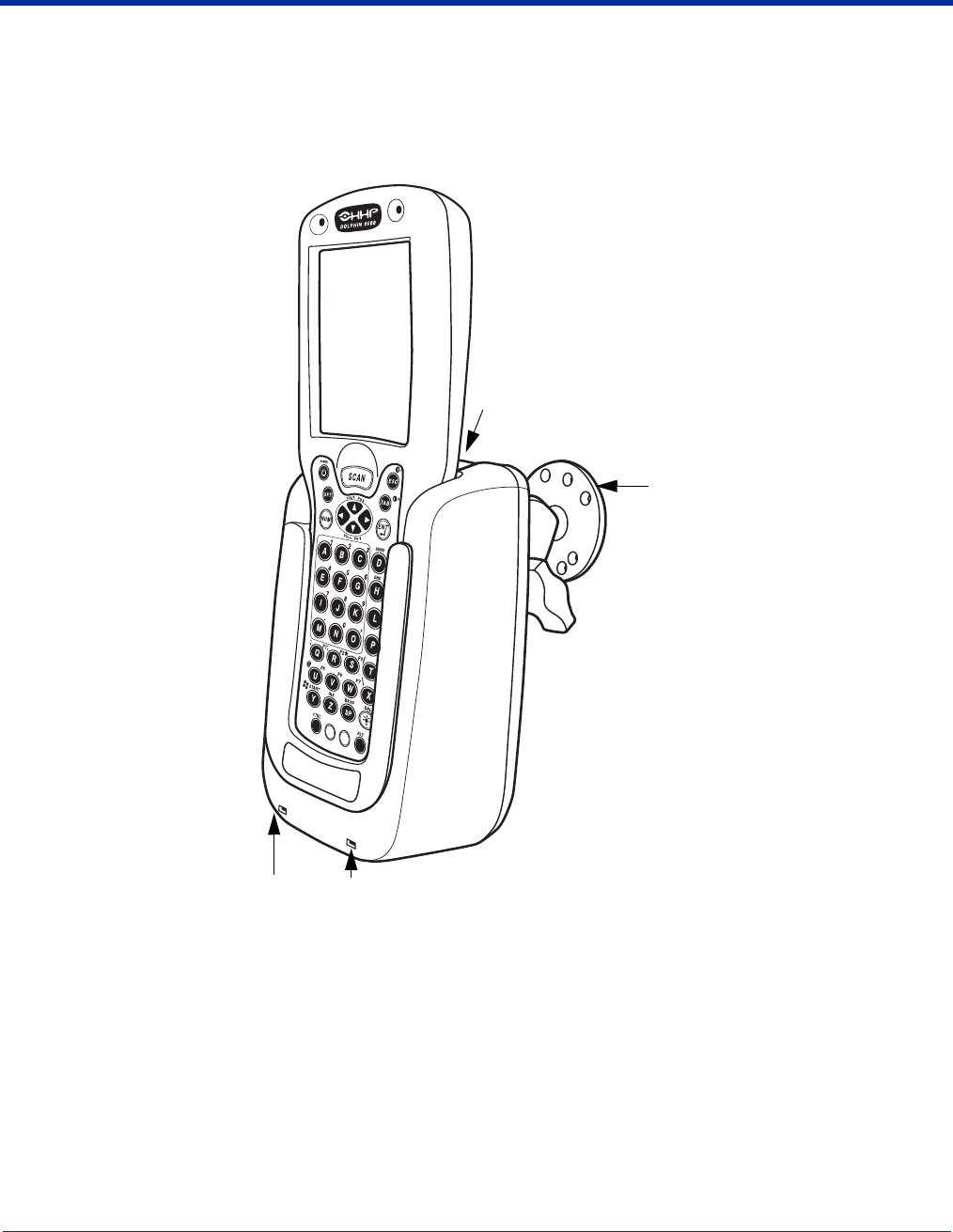
12 - 2 Dolphin® 9500/9550 Mobile Computer User’s Guide - GSM Draft
Mobile Base Parts and Functions
Front Panel
The front panel of the Mobile Base has one slot. The following graphic features the Mobile Base with the Dolphin 9500 inserted
into the Terminal Well.
Terminal Well Place the terminal in this well to communicate with a host device and charge the main battery pack.
Mounting Brackets Use these to mount the Mobile Base to a fixed location.
DOCK LED Illuminates solid green when the Dolphin terminal is properly seated in the terminal well.
COMM LED Indicates the status of data transfer between the host device and the Dolphin terminal
COMM LED color Indicates that…
Red Data is being sent from the Host Device to the Dolphin Mobile Base.
Green Data is being sent from the Dolphin Mobile Base to the Host Device.
Orange Data is being sent at high data rates.
DOCK
COMM
Terminal Well
COMM LED
Mounting
Brackets
DOCK LED
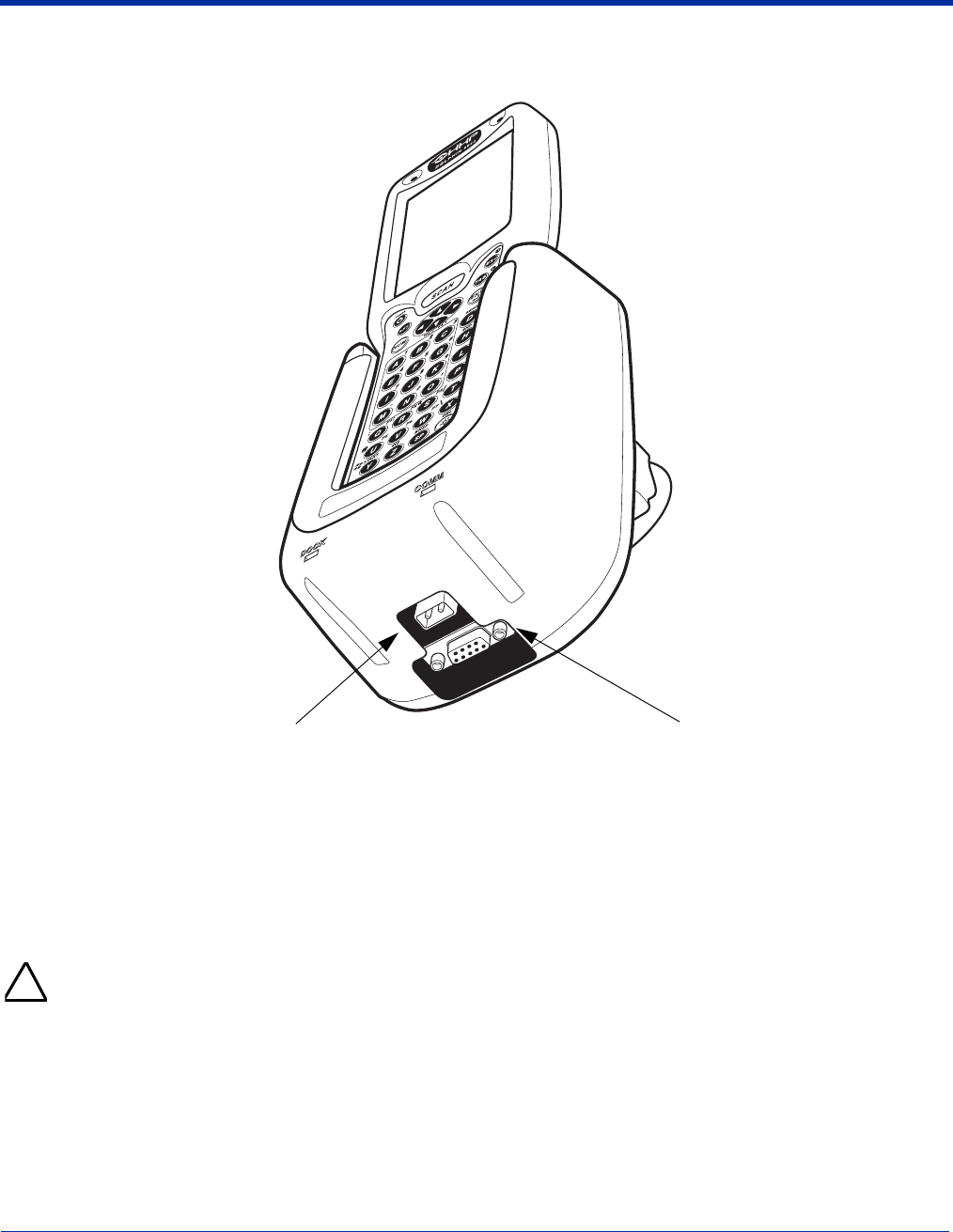
Dolphin® 9500/9550 Mobile Computer User’s Guide - GSM Draft 12 - 3
Bottom Panel
The power supply and RS-232 connectors are located on the bottom of the unit.
Power Supply Connector
Use this connector to attach an HHP power cable to the Dolphin 9500/9550 Mobile Base. The Mobile Base can be
powered by an external DC power source of between 11 VDC to 48 VDC. The optional HHP cigarette lighter adapter
cable allows the Mobile Base to be powered from a standard 12 VDC cigarette lighter outlet in a vehicle.
You can also power the unit using the supplied pigtail power cable to “hard-wire” into the vehicle power bus.
Verify that the power source is always within the specified range and observe correct input voltage polarity. An improper
input voltage range (above the 48 VDC maximum) or reverse polarity could damage the power conversion circuitry.
RS-232 Communications Port
Use a standard serial cable to connect the unit to a host device via RS-232; see Mobile Base Serial Connector on page
12-8.
RS-232 Communications PortPower Supply Connector
!

12 - 4 Dolphin® 9500/9550 Mobile Computer User’s Guide - GSM Draft
Powering the Dolphin Terminal
When seated in a Mobile Base that is connected to the appropriate power source, the Dolphin terminal receives the power to
charge its main battery and run its internal circuitry. Keep the Mobile Base plugged into the power source so that the Dolphin
terminal battery pack stays fully charged.
For more information about powering the Mobile Base, see Powering the Dolphin Mobile Base on page 12-6.
Charging the Dolphin Terminal
The Mobile Base supplies charging power to the Dolphin terminal so that the terminal can monitor the charging of its battery pack.
This charging method protects the battery from being damaged by overcharging. Therefore, the Dolphin terminal may be stored
indefinitely in the Mobile Base without damage to the terminal, the battery pack, or the Mobile Base.
To charge a Dolphin terminal, complete these steps:
1. Insert a battery pack into the Dolphin terminal.
2. Slide the terminal, imager window up and the LCD visible, into the terminal well of the Mobile Base until it stops.
3. When the Dolphin terminal is properly seated, the DOCK LED on the Mobile Base illuminates solid green. The terminal
begins charging automatically.
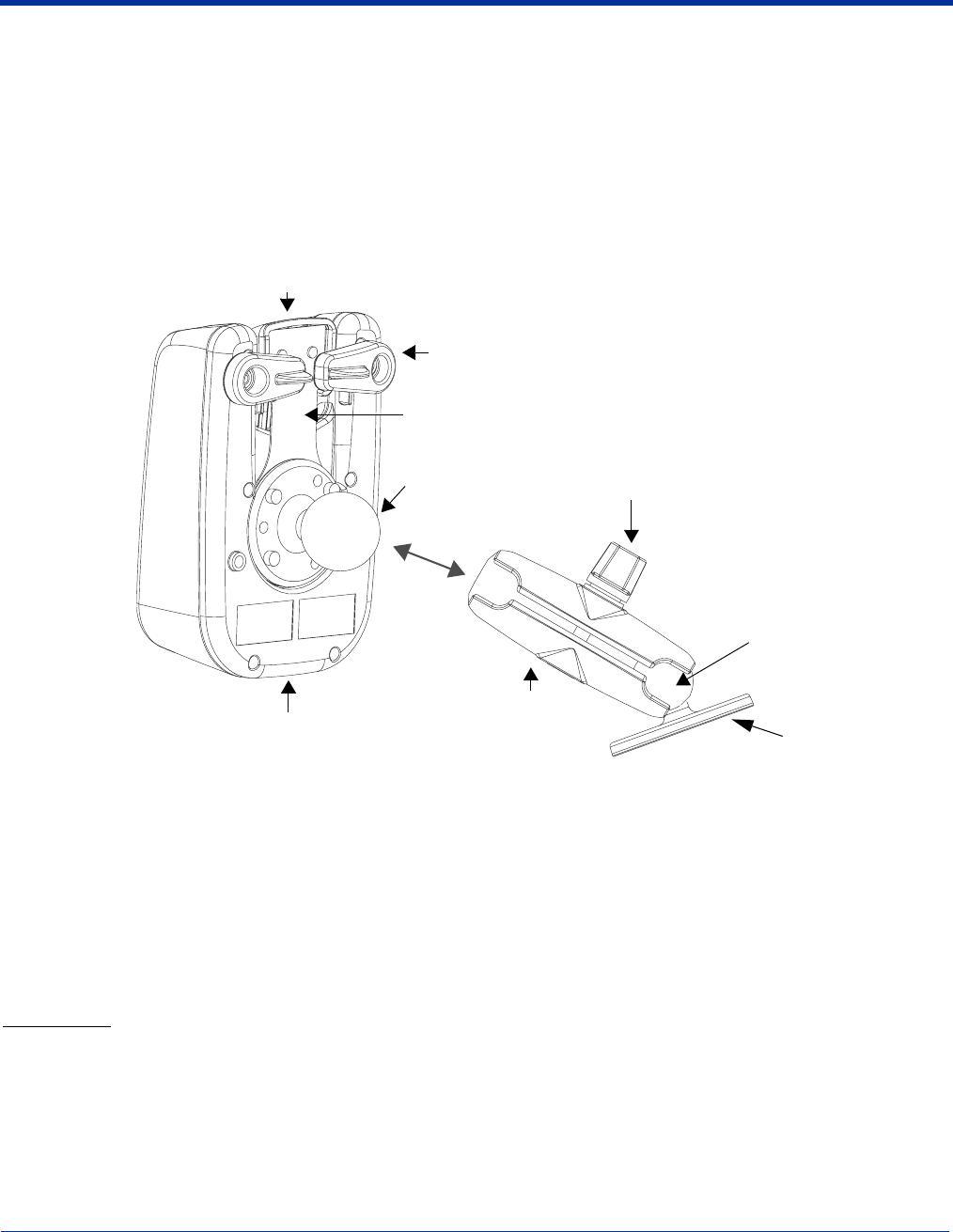
Dolphin® 9500/9550 Mobile Computer User’s Guide - GSM Draft 12 - 5
Installing the Dolphin Mobile Base
To install the Dolphin Mobile Base, you need to mount it securely to an appropriate location and supply it with power.
Mounting the Mobile Base
The adjustable mounting bracket holds the terminal securely in place and gives the user a variety of options for mounting the
Mobile Base. When selecting a location, keep in mind that the power supply and serial connectors point straight out the bottom
panel.
Back Panel and Brackets
Complete these steps:
1. Loosen the turnscrew.
2. Insert the ball joint of the mounting bracket to the back of the bracket.
3. Insert the ball joint on the back of the Mobile Base into the other side of the bracket.
4. Tighten the turnscrew to secure both ball joints.
5. Secure the mounting bracket to the appropriate location.
Back Panel
Latch
The latch sits on top of the spring arm assembly and holds the back of the terminal securely in place. The graphic above
displays the mounting of a Dolphin 9500 terminal. There is a special latch available for the Dolphin 9550 that
accommodates the pistol-grip handle.
Turnscrew
Power supply and RS-232
connectors (not in view) Mounting Bracket
Locking tabs
Ball Joint
Bracket
Latch
Spring Arm Assembly
Ball Joint

12 - 6 Dolphin® 9500/9550 Mobile Computer User’s Guide - GSM Draft
Locking Tabs
When positioned as shown in the above graphic, the locking tabs secure the spring arm assembly, latch, and terminal
in place. When seating a terminal, turn both arms up to allow the spring arm to move as necessary while the terminal
is being inserted. After the terminal is seated, turn both arms toward the center to lock them.
Spring Arm Assembly
The spring arm assemble is the column that connect the latch to the back of the Mobile Base.
Ball Joints
There are two ball joints: one on the back of the Mobile Base and one on the mounting bracket. Both ball joints are
inserted into the bracket and secured to mount the Mobile Base.
Connectors
The power and RS-232 connectors are located on the bottom panel. For more information, see Bottom Panel on page
12-3.
Brackets
Bracket
The bracket contains the turnscrew and two slots. Ball joints are inserted into each slot and secured with the turnscrew.
Turnscrew
The turnscrew is located on the top of the bracket. Rotate the turnscrew to secure or loosen the ball joint slots.
Mounting Bracket
The mounting bracket is what you attach to the mounting surface. It is comprised of a ball joint and flat disk. The disk
contains drill holes you use to secure the Mobile Base to the mounting surface.
Powering the Dolphin Mobile Base
Note: HHP recommends that you leave the Mobile Base connected to its power source at all times.
The Mobile Base is powered via the power connector on the bottom panel; see Bottom Panel on page 12-3. Both the power and
serial connectors are straight out, not at an angle.
The Mobile Base must be powered by a 12 to 48 volt DC source.

Dolphin® 9500/9550 Mobile Computer User’s Guide - GSM Draft 12 - 7
Setting the Mobile Base Up for Communications
The Mobile Base RS-232 interface allows the Dolphin terminal to communicate to a personal computer, modem, or any standard
RS-232 device using a standard serial cable and communications software.
Connecting the Cables
Connect the Mobile Base to the host computer or other device by plugging an RS-232 serial cable into the RS-232
Communications Port on the bottom of the Mobile Base. Plug the other end of the RS-232 serial cable into the correct port on
the host RS-232 device.
The wiring of your cable depends on whether the other device is set up as a Data Communications Equipment (DCE) or Data
Terminal Equipment (DTE) device.
The Mobile Base Communication Port is configured as a DCE device. To communicate with a DTE device such as a computer,
use a standard (or straight-through) RS-232 cable. To communicate with a DCE device, use either a null modem adapter in line
with a standard RS-232 cable, or a null-modem serial cable.
RS-232 Pin Configuration
Refer to this table if you want to make your own cables. To do so, you must determine if your host RS-232 device is
• 9-pin or 25-pin and
• configured as a DCE or DTE device.
Mobile Base /Host Port
(DCE)
IBM AT DB9
(DTE)
IBM XT DB25
(DTE)
Modem DB25
(DCE)
Pin / Input Signal
2 / (RD) 2 3 2
3 / (TD) 3 2 3
5 / (SG) 5 7 7
4 / (DTR) 4 20 6
6 / (DSR) 6 6 20
7 / (RTS) 7 4 5
8 / (CTS) 8 5 4
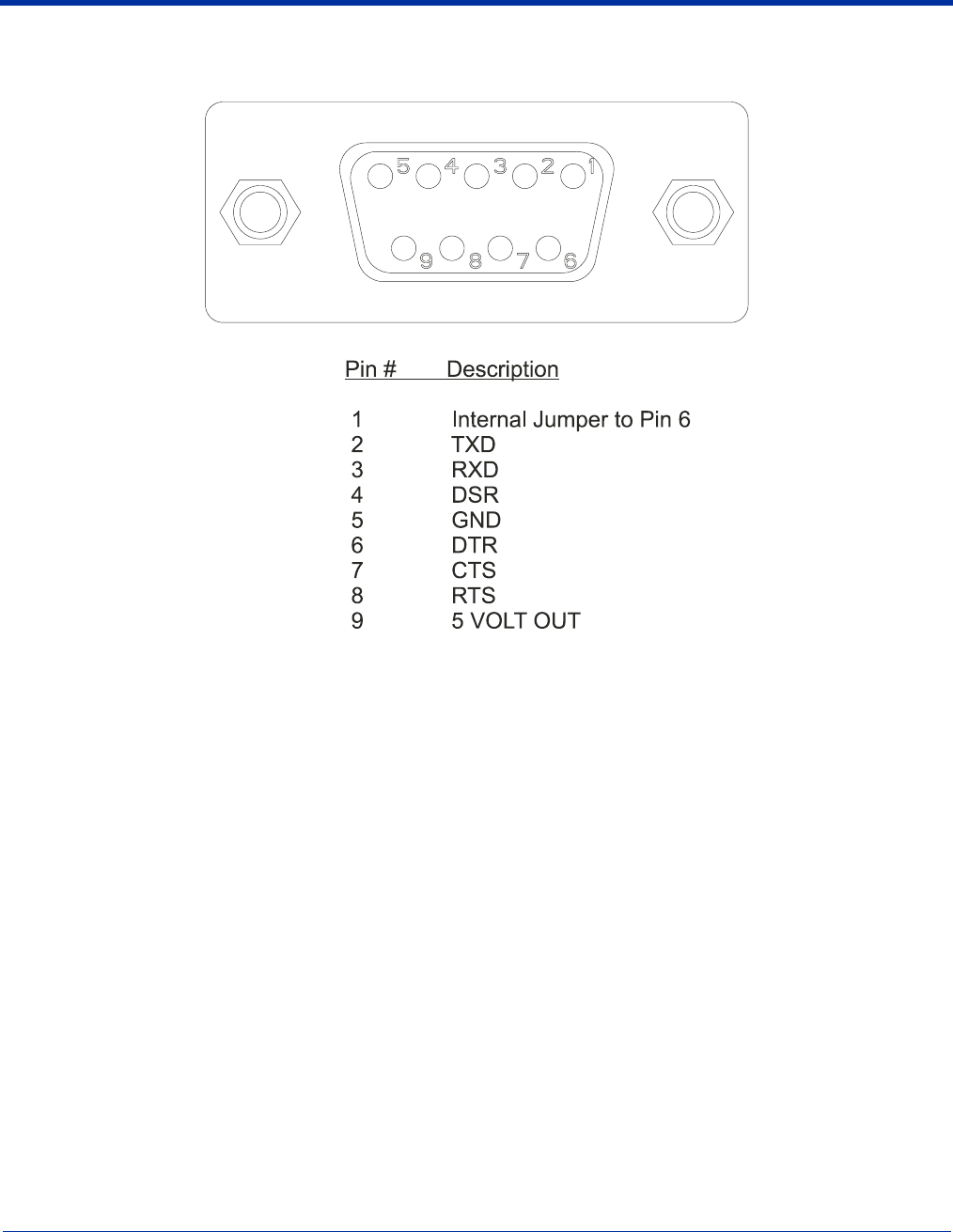
12 - 8 Dolphin® 9500/9550 Mobile Computer User’s Guide - GSM Draft
Mobile Base Serial Connector
The following diagram displays the serial connector of the Mobile Base.
Note: Signals referenced are for a DTE device.
The Mobile Base connector is straight to the printed circuit board (PCB). The ninth pin sends 500mA at 5V power out. This can
power a peripheral device, such as a mobile printer, provided that that peripheral device can accept 500mA at 5V.
Configuring the Dolphin Terminal
Communications Properties must be configured appropriately on the Dolphin 9500/9550 terminal for it to communicate with the
Mobile Base.
To set Communications Properties:
1. Tap Start > ActiveSync > Tools > Options.
2. Tap the PC Connection tab
3. Check the Enable Synchronization check box.
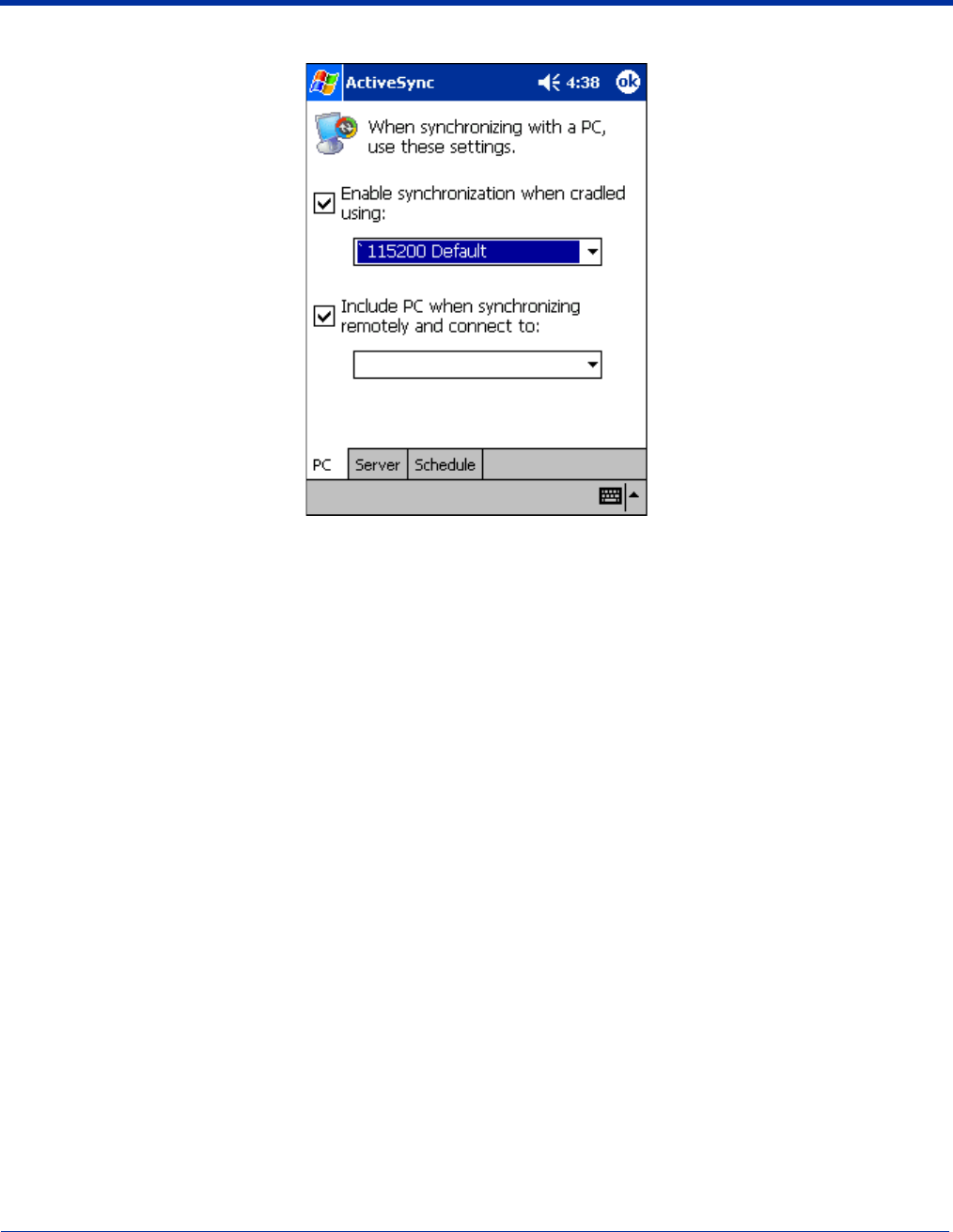
Dolphin® 9500/9550 Mobile Computer User’s Guide - GSM Draft 12 - 9
4. Select the appropriate baud rate for connecting to the RS-232 Host Device; ‘11520 is the default.
5. Tap OK and close the ActiveSync window on the Dolphin 9500/9550 terminal.
6. Place the Dolphin in the Mobile Base. Synchronization begins immediately.

12 - 10 Dolphin® 9500/9550 Mobile Computer User’s Guide - GSM Draft

Dolphin® 9500/9550 Mobile Computer User’s Guide - GSM Draft 13 - 1
13
Dolphin 9500/9550 ChargeBase
Overview
The Dolphin ChargeBase is a four-slot charging cradle that can charge four Dolphin terminals, each in less than four hours.
provides intelligent battery charging for Dolphin 9500/9550 terminals with Li-ion battery packs installed.
Capacity
The ChargeBase can hold up to four Dolphin 9500/9550 terminals. Each charging slot works independently to control the
charging of each terminal.
Compatibility
The ChargeBase is compatible only with the batteries for all models in the Dolphin 9500/9550 family of mobile computing devices.
Charging process
As battery packs charge, the charging circuitry follows the two-step charging process (CC-CV) that is recommended for Li-Ion
batteries. The process monitors changes in temperature, current, and voltage.
Use only Dolphin 9500 series peripherals, power cables, and power adapters. Use of peripherals, cables, or power
adapters not sold/manufactured by HHP will void the warranty and may damage the terminal.
Use only the Li-ion battery packs provided by HHP. The use of any battery pack not sold/manufactured by HHP in the
Dolphin 9500/9550 terminal will void your warranty and may result in damage to the Dolphin terminal or battery.
!
!
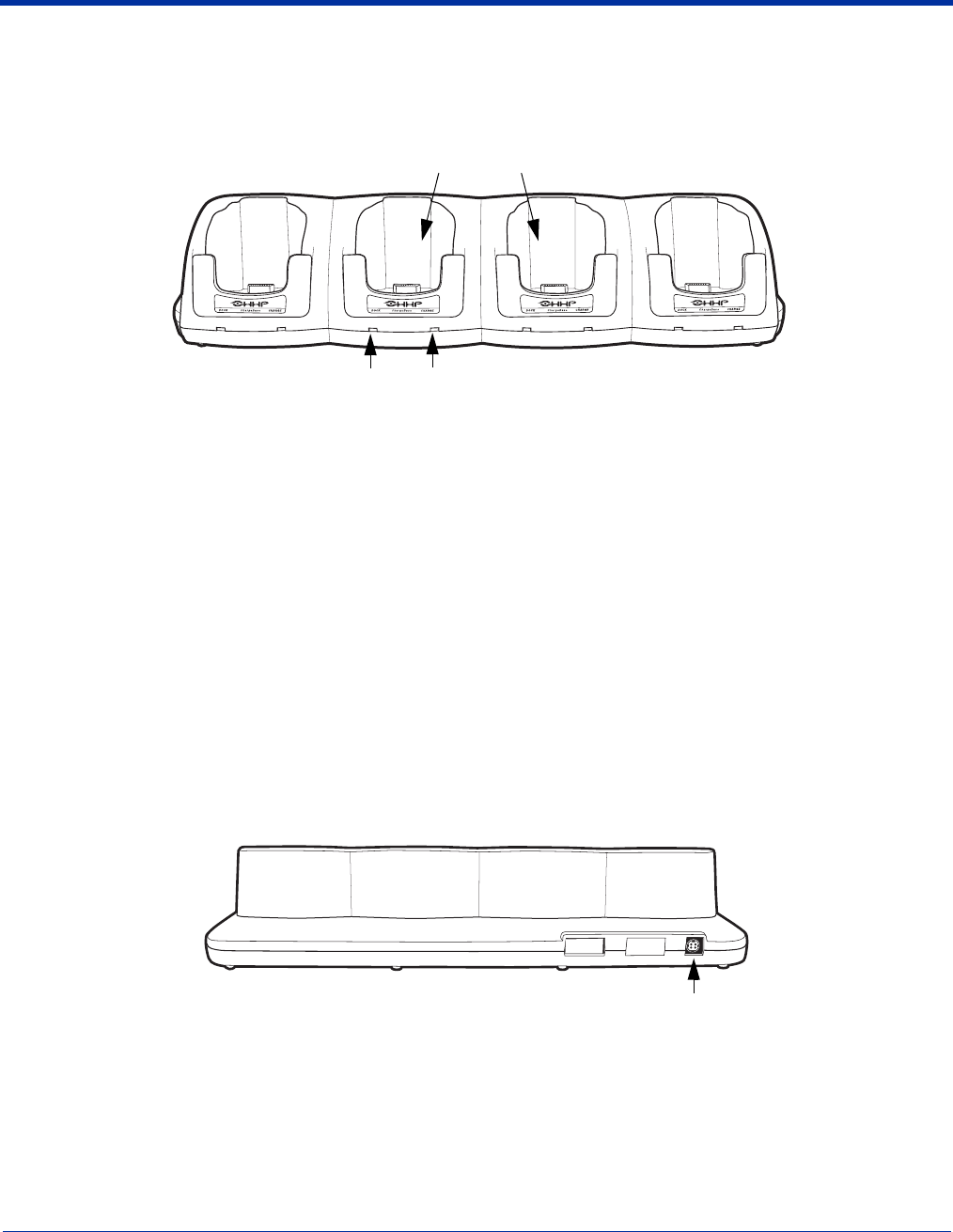
13 - 2 Dolphin® 9500/9550 Mobile Computer User’s Guide - GSM Draft
Dolphin ChargeBase Parts and Functions
Front Panel
Terminal Wells
The ChargeBase contains four terminals wells. Each well
• Holds and charges the main battery pack of one Dolphin 9500/9550 terminal.
• Contains the companion to the industrial-grade, 17-pin connector on the bottom panel of Dolphin 9500/9550
terminals.
• Has two LEDs on the front: the Dock LED and the Charge LED.
Dock LED
Each terminal well displays a Dock LED on the front that lights solid green when a terminal is properly seated, which
means that the terminal and the base are connected.
Charge LEDs
Each terminal well displays a Charge LED on the front that lights green to indicate charging. For details, see Charging
Terminals in the ChargeBase on page 13-5.
Back Panel
Power Supply Connector
This connector receives input from the power adapter. Plug the power connector cable from the power adapter into this
connector.
Note: There is no ON/OFF switch on the back panel of the ChargeBase. The power switch is on the power adapter.
Charge LED
Dock LED
Terminal Wells
Power Supply Connector
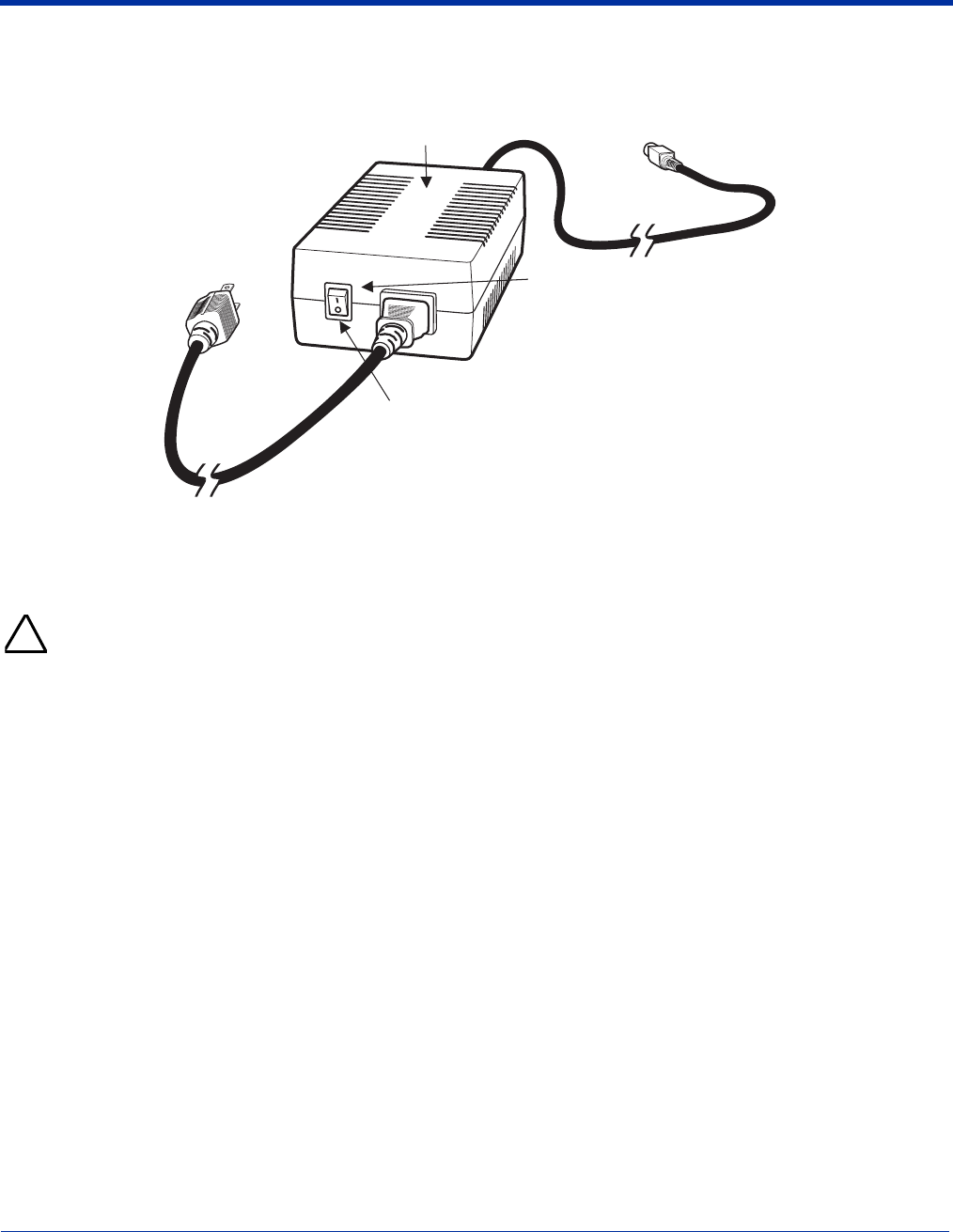
Dolphin® 9500/9550 Mobile Computer User’s Guide - GSM Draft 13 - 3
Power Supply
The ChargeBase includes a power supply that contains a power adapter to ensure the proper voltage. The power adapter is
plugged into standard AC/DC outlets.
Supplying Power to the ChargeBase
Using a non-HHP power adapter voids your warranty and could result in serious damage to the circuitry of the Dolphin
ChargeBase.
1. Be sure the power switch on the power adapter is in the OFF position.
2. Plug the power cord into the power adapter.
3. Plug the power connector cable into the power connector on the back panel of the ChargeBase.
4. Plug the power cord into a standard wall outlet.
5. On the power adapter, turn the power switch to the ON position. The LEDs illuminate as the ChargeBase powers up.
6. The ChargeBase is ready to begin charging terminals.
Power Cord
ON/OFF
Switch
ON Position
Power Adapter
Power
Connector
Cable
!
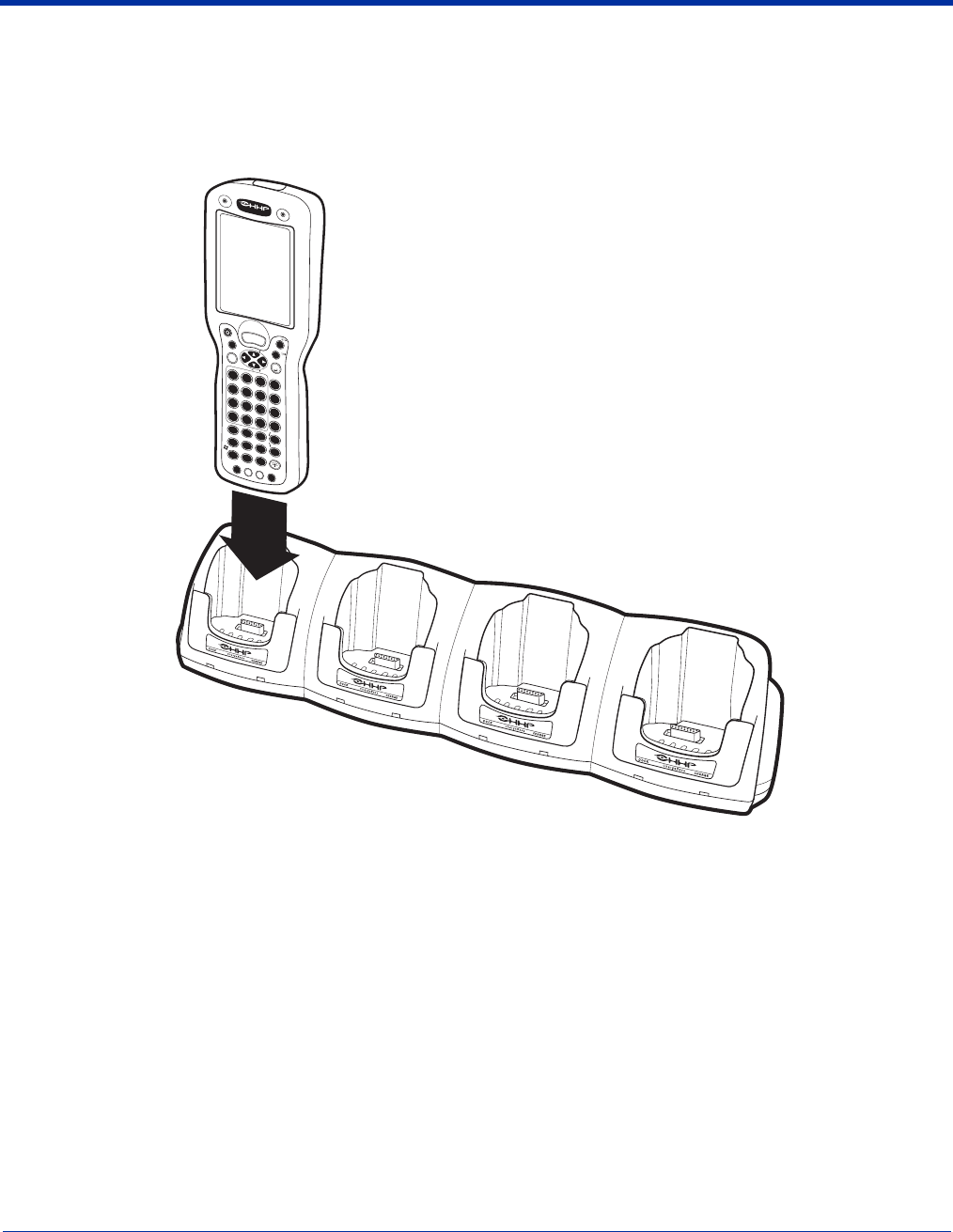
13 - 4 Dolphin® 9500/9550 Mobile Computer User’s Guide - GSM Draft
Inserting and Removing Terminals
Inserting
1. Hold the terminal with the bottom panel perpendicular to the base.
2. Slide the terminal into the well until the Dock LED lights solid green.
3. Charging begins immediately.
Removing
To remove a terminal, grasp it firmly in your hand and lift it up and out of the terminal well. The LEDs for the terminal well turns off.
DOLPHIN9500
SCAN
ESC
TAB
SFT
ABC
EFG
IJK
MNO
S
R
Q
UVW
YZ
D
H
L
P
T
X
NUM
ENT
123
789
456
;:
*
@
F1F2F3F4
F5F6F7F8
STARTINSBKSPDEL
CTRLALT
SEND
END
POWER
V
O
L
P
G
V
O
L
P
G
+
+
-0
,
SP

Dolphin® 9500/9550 Mobile Computer User’s Guide - GSM Draft 13 - 5
Charging Terminals in the ChargeBase
The Dolphin ChargeBase charges the main battery of each terminal in less than four hours. The ChargeBase uses the intelligent
battery charging system incorporated into all Dolphin terminals that prevents overcharging. This means that Dolphin terminals
may be stored in the ChargeBase indefinitely without damage to the terminals, battery packs, or the ChargeBase.
1. Power the ChargeBase; see Supplying Power to the ChargeBase on page 13-3.
2. Insert a terminal into a terminal well; see Inserting and Removing Terminals on page 13-4.
3. The Charge LED lights green to indicate that the terminal is powered and charging.
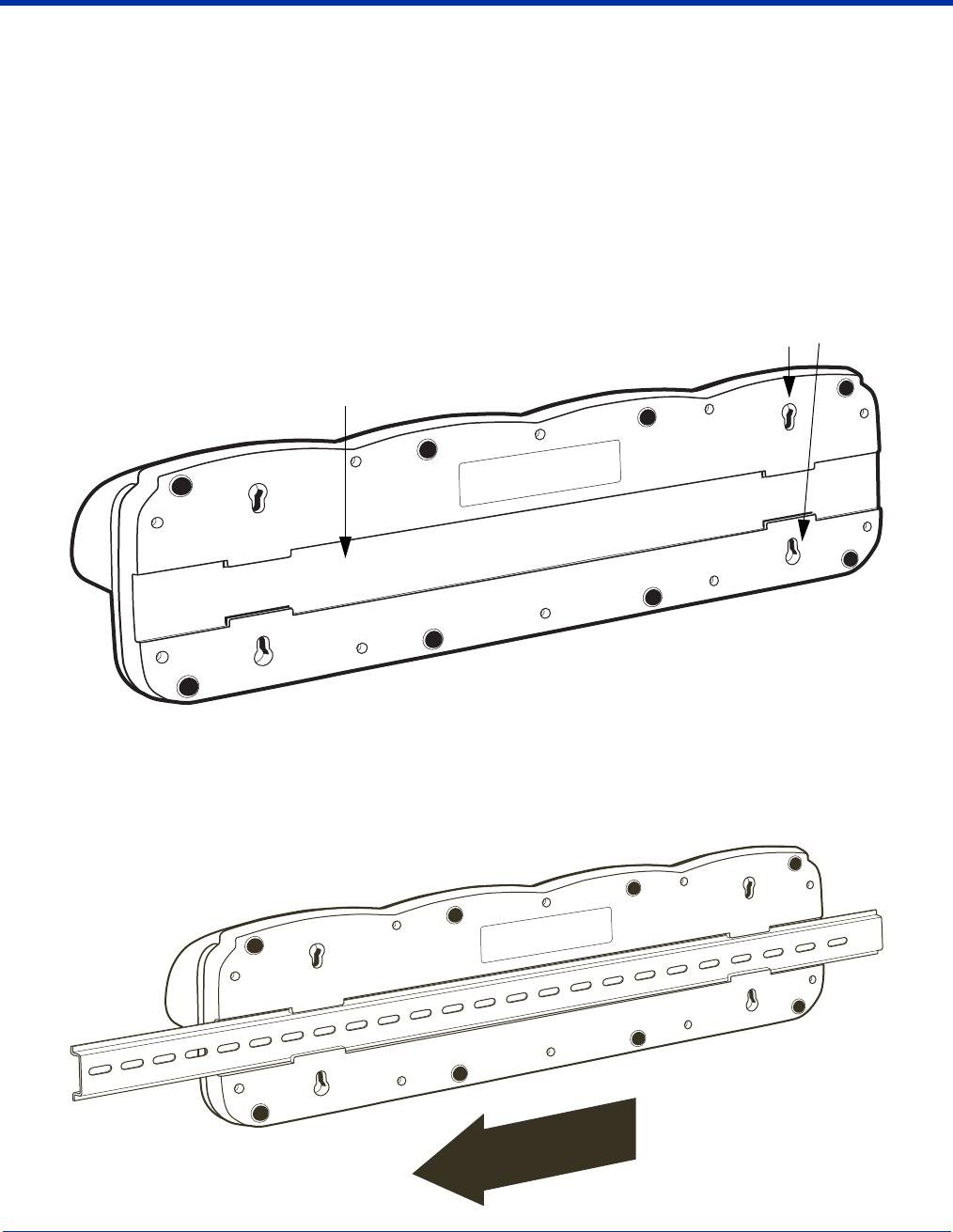
13 - 6 Dolphin® 9500/9550 Mobile Computer User’s Guide - GSM Draft
Mounting the ChargeBase
The Dolphin ChargeBase should be on a dry, stable surface. To easily adapt the ChargeBase to your environment, it can be
mounted on a flat, horizontal surface such as a desktop or workbench, or a flat, vertical surface such as a wall.
When choosing a location, always bear in mind that
• The mounting location must allow users easy access to the power connector.
• The ChargeBase should be oriented so that users can easily read the labels.
Bottom Panel
The bottom panel of the Dolphin 9500/9550 ChargeBase offers two mounting options: insert a DIN Rail in the available slot for
desk mounting or secure two mounting brackets with the available screw slots.
Using the DIN Rail
All Dolphin charging/communication cradles have a DIN rail (7.5 X 35 mm) slot on the bottom panel to enable secure mounting.
1. Slide the DIN Rail into the DIN Rail slot on the bottom panel.
DIN Rail Slot
Screw Slots
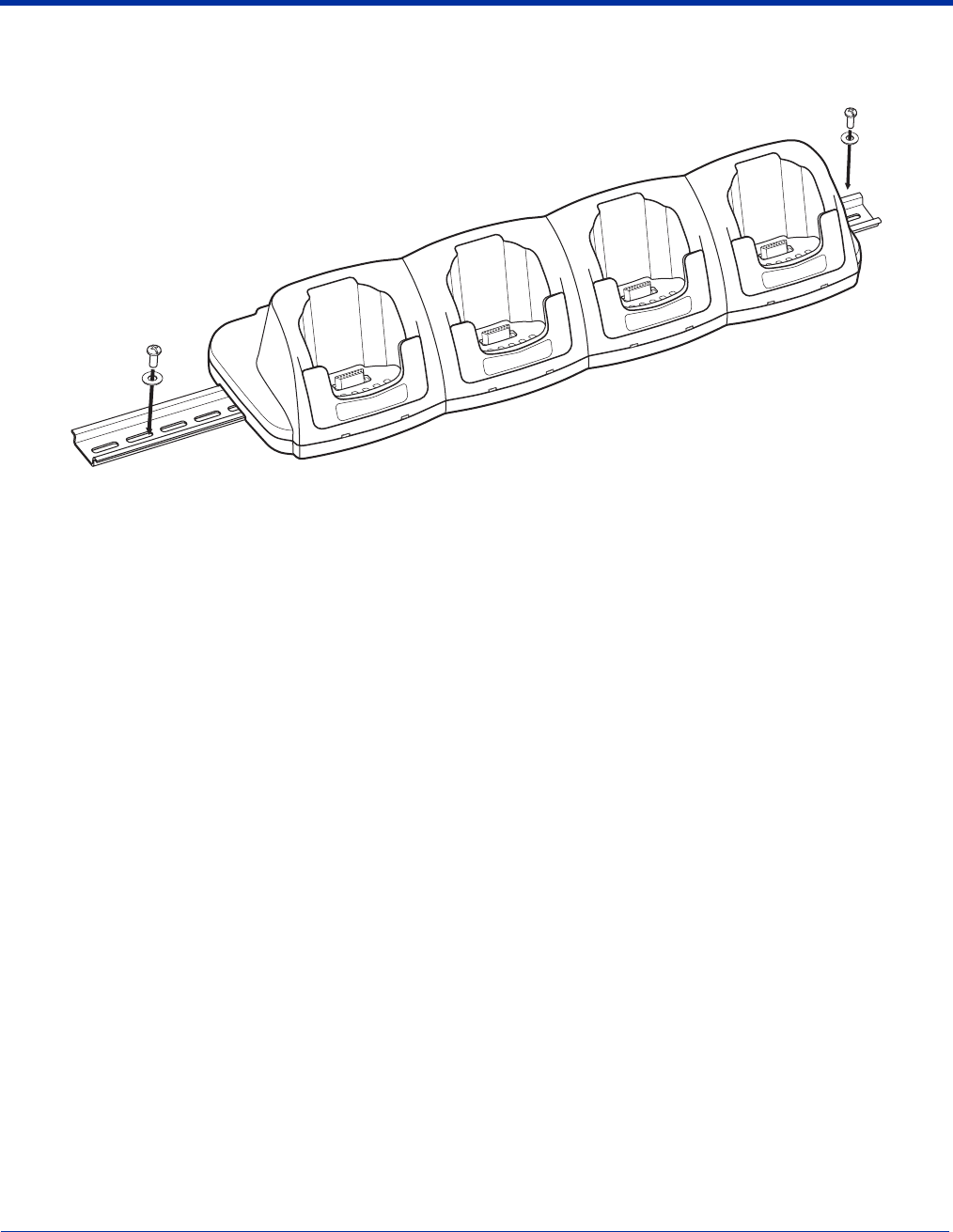
Dolphin® 9500/9550 Mobile Computer User’s Guide - GSM Draft 13 - 7
2. Turn the ChargeBase and DIN Rail right side up.
3. Secure the DIN Rail to a stable, flat horizontal surface.
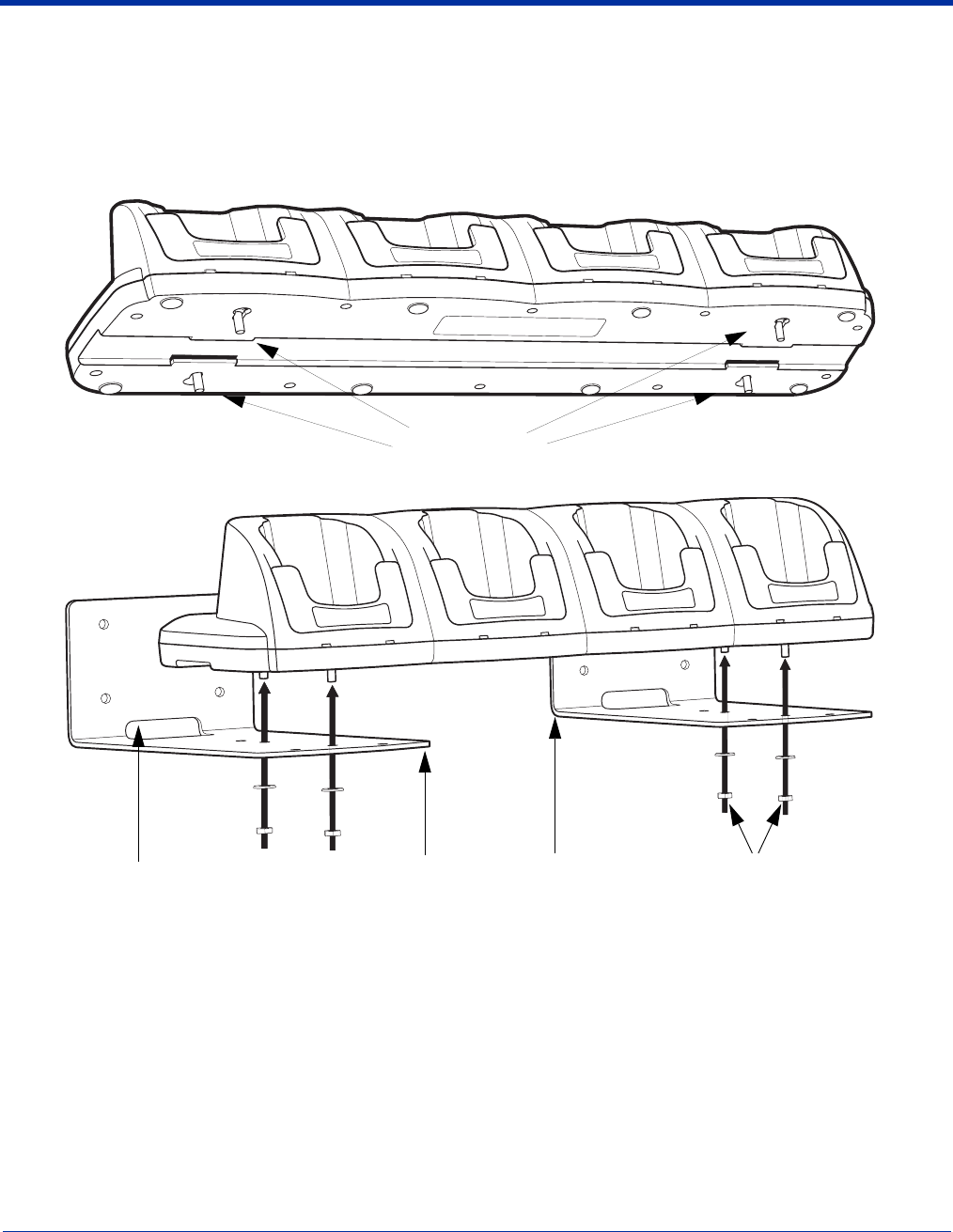
13 - 8 Dolphin® 9500/9550 Mobile Computer User’s Guide - GSM Draft
Using the Mounting Brackets
Use the screws and the mounting brackets to mount the ChargeBase to a wall or other vertical surface. The wall mount kit
contains two mounting brackets to secure both ends of the ChargeBase. Each mounting bracket contains an open slot in the
back to accomodate the connector cables.
1. Secure the screws into the four screw slots on the bottom panel. Insert the heads into the round end and slide towards the
narrow end until the screw is secure.
2. Attach the bottom panel to the two mounting brackets.
Screws in slots
Nuts and Bolts
Open Slot for Connector Cables Mounting Brackets
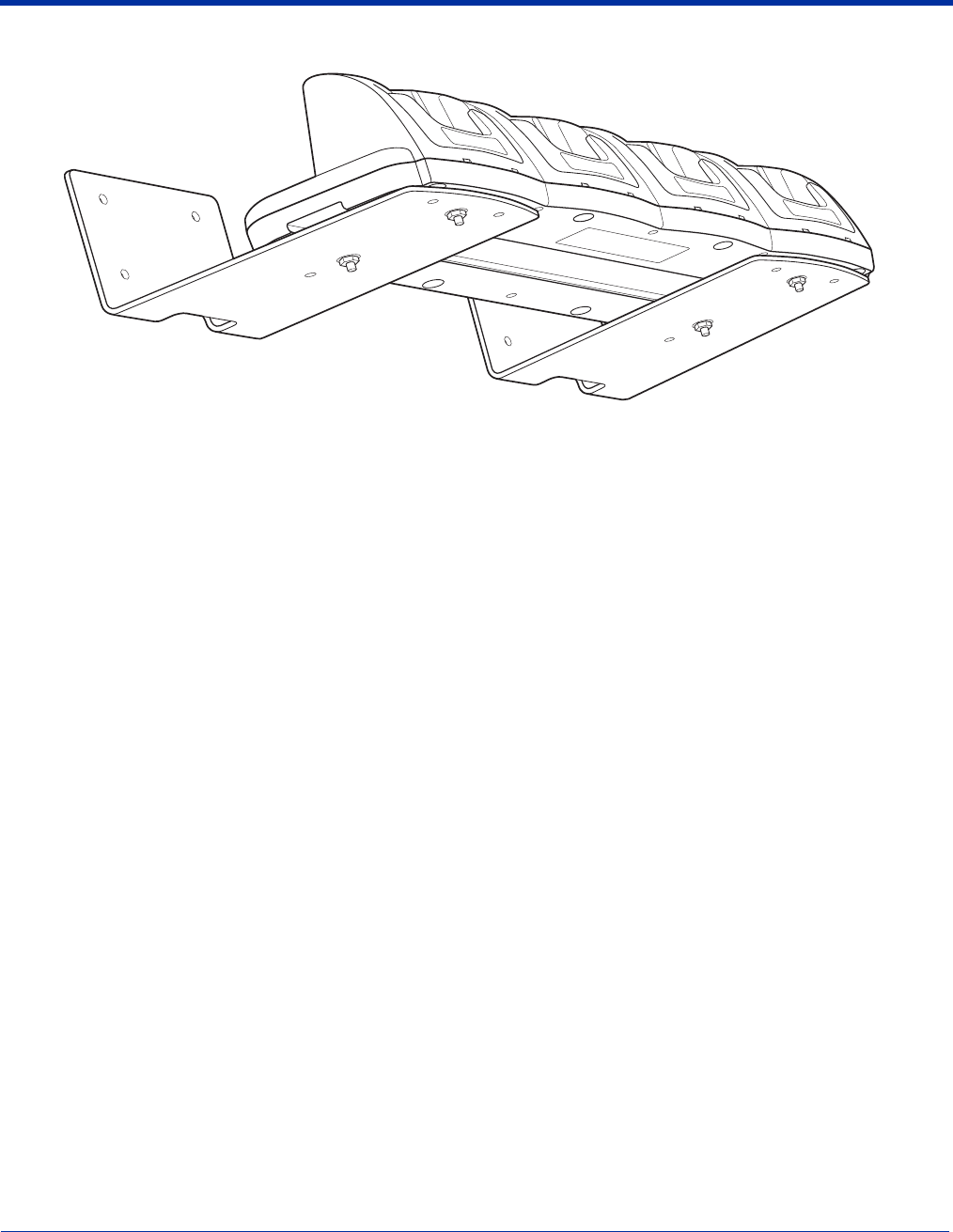
Dolphin® 9500/9550 Mobile Computer User’s Guide - GSM Draft 13 - 9
3. Using the nuts and bolts, secure the mounting brackets to the bottom panel.
4. Secure the mounting brackets to an appropriate horizontal surface.

13 - 10 Dolphin® 9500/9550 Mobile Computer User’s Guide - GSM Draft

Dolphin® 9500/9550 Mobile Computer User’s Guide - GSM Draft 14 - 1
14
Dolphin 9500/9550 QuadCharger
Overview
The Dolphin QuadCharger is a four-slot charging station that provides intelligent battery management for Dolphin 9500/9550
battery packs. It can charge each battery in less than four hours. The fourth slot features a battery analyzer that completely resets
and re-calibrates a battery and displays its resulting capacity.
Compatibility
The QuadCharger is compatible with the Li-ion batteries that power the Dolphin 9500 series of mobile computing devices.
Charging Process
Each charging slot works independently of the other three.
As battery packs charge, the charging circuitry follows the two-step charging process (CC-CV) that is recommended for Li-Ion
batteries. The process monitors changes in temperature, current, and voltage. The charger also resets and calibrates battery
pack data to accurately show battery status on the Dolphin display.
Use only Dolphin 9500 series peripherals, power cables, and power adapters. Use of peripherals, cables, or power
adapters not sold/manufactured by HHP will void the warranty and may damage the terminal.
Use only the Li-ion battery packs provided by HHP. The use of any battery pack not sold/manufactured by HHP in the
Dolphin 9500/9550 terminal will void your warranty and may result in damage to the Dolphin terminal or battery.
Dolphin QuadCharger Parts and Functions
Front Panel
Charging Slots
The QuadCharger contains four charging slots. Each holds one Dolphin 9500/9550 battery. When a battery is placed
in each slot, it immediately begins charging.
!
!
O
SLOT 4
BATTERY
CAPACITY
100%
0%
ANALYZE
CHARGE/ANALYZE
1
2
3
4
Charging Slots
Status LEDs
Charge/Analyze Slot
Battery Capacity Indicator LEDS
Analyze Button
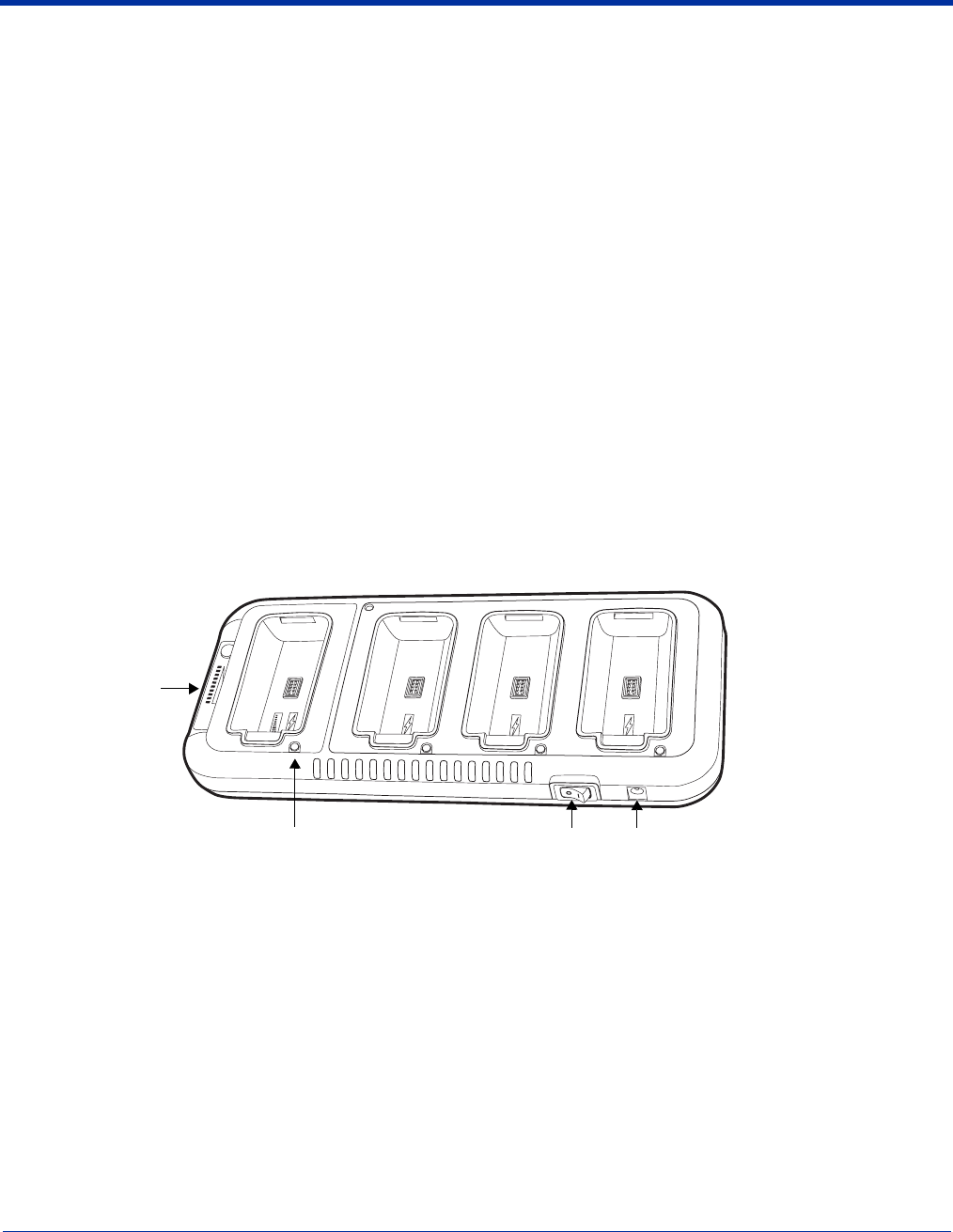
14 - 2 Dolphin® 9500/9550 Mobile Computer User’s Guide - GSM Draft
Charge/Analyze Slot
This is the fourth slot and the only one that can be used to charge or analyze a battery. When a battery is placed in this
slot, it begins charging just as it does in the other three slots. However, if you press the ANALYZE button, it runs the
battery in the slot through the complete Analyze cycle. For more information, see Using the Battery Analyzer on page
14-4.
Battery Capacity Indicator LEDS
Indicates the progress of the Analyze cycle of the battery in the Charge/Analyze slot.
Analyze Button
Press this button to start a battery analyze cycle. For more information, see Using the Battery Analyzer on page 14-4.
Status LEDs
A status LED is located above each of the four battery slots. The color of the LED indicates the charge status of the
batteries in its slot.
Rear Panel
Battery Analyzer
This is Charge/Analyze slot from the rear view.
Power Switch
Toggle the power switch to turn the QuadCharger on and off.
Power Supply Connector
Use this connector to attach the power supply to the QuadCharger. The universal power supply accepts input voltages
between 90-265 volts.
Status LED color This color indicates that the battery in the slot…
Green Has completed its charge cycle and is ready for use.
Orange Is being charged at a maximum charge rate.
Red Encountered and error during the most recent charge cycle.
1
2
3
4
Swc
O
CHARGE/ANALYZE
0%
ALYZE
LOT 4
TTERY
PACITY
0%
Power Supply Connector
Power Switch
Battery Analyer
Status LED

Dolphin® 9500/9550 Mobile Computer User’s Guide - GSM Draft 14 - 3
Supplying Power to the QuadCharger
The charger must be connected to the appropriate power source for any type of operation.
1. Locate the AC power cord that came with the Dolphin QuadCharger.
2. Plug the cord into the power supply connector on the back of the unit and then plug the power cord into a wall socket.
3. Press the power switch to the ON position.
The power LED illuminates green, and the charger performs a self-diagnostic test that lasts approximately five seconds.
Inserting and Removing Battery Packs
Inserting
To insert a battery pack, place the end of the battery without the locking tab into the bottom of the charging pocket and snap the
battery into place with a hinging motion. The Status LED for that particular slot illuminates orange when the battery has been
properly inserted.
Removing
To remove a battery pack, push the locking tab down and pull the battery out from the charging slot with a hinging motion.
Storing Batteries
Recommendations
To maintain top performance from batteries, follow these storage guidelines:
• Avoid storing batteries outside of the specified temperature range of -4 to 104° F (-20 to 40°C) or in extremely high humidity.
• For prolonged storage, do not keep batteries stored in a charger that is connected to a power source.
Charging Batteries in the QuadCharger
For best results, battery packs should be at room temperature before recharging them; temperature has a marked effect on
charging. The recommended temperature range is 50° to 95° F (10
°
to 35
°
C).
Complete these steps:
1. Set up the QuadCharger.
2. Supply the QuadCharger with power and turn the power switch on.
3. Insert batteries into the appropriate slots. The Status LED for each slot turns orange to indicate that the battery has begun a
charge cycle.
4. When the Status LED turns green, the battery in the slot has completed charging.
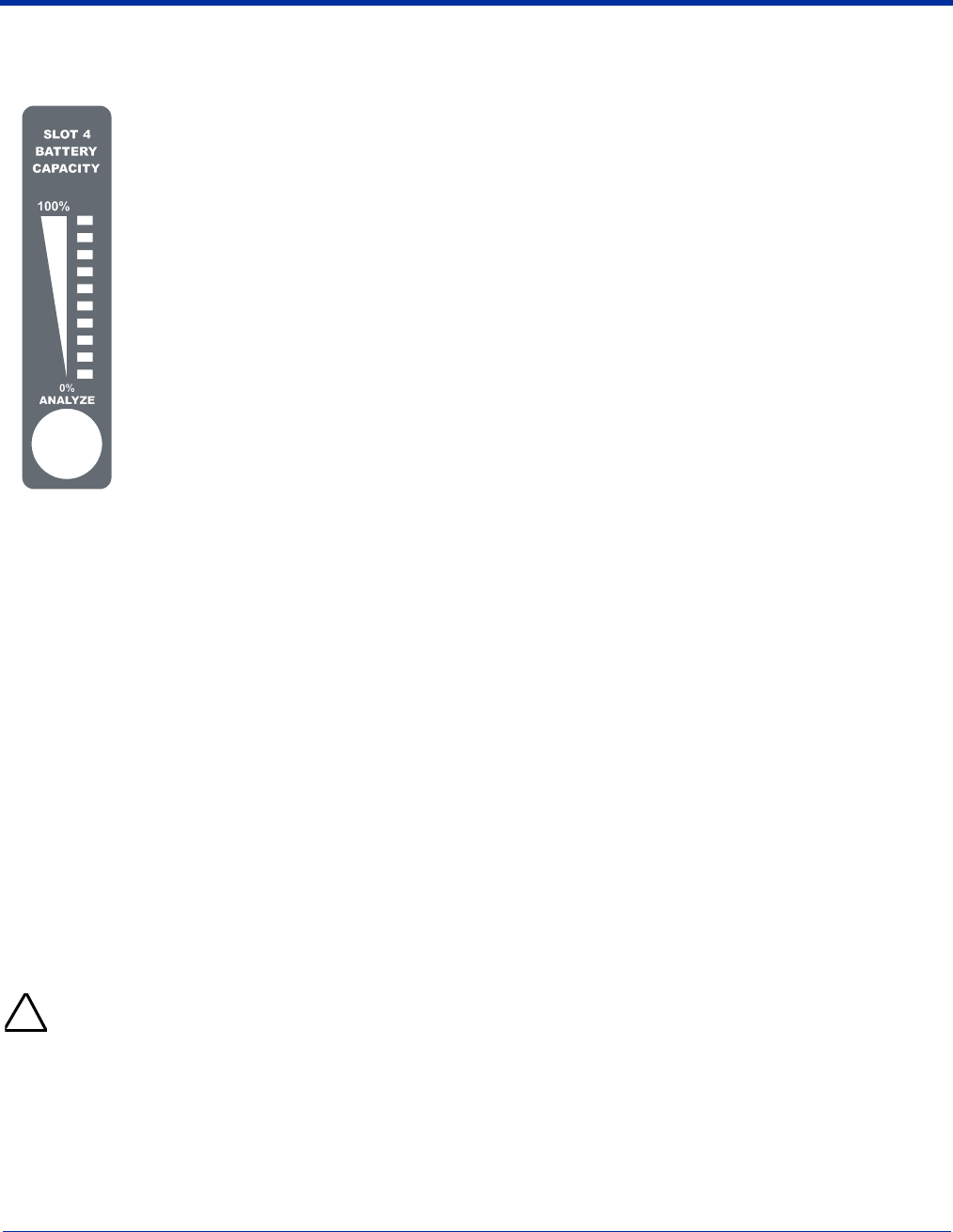
14 - 4 Dolphin® 9500/9550 Mobile Computer User’s Guide - GSM Draft
Using the Battery Analyzer
Location
The battery analyzer is located in the fourth slot of the ChargeBase. Only batteries in this slot can be analyzed.
Analyze Cycle
The Analyze cycle is initiated when a battery is placed in the Charge/Analyze slot and the ANALYZE button
is pressed. In an Analyze cycle, batteries are completely discharged, then recharged to capacity, as well as
completely reset and re-calibrated.
The length of time it takes for a battery to complete the Analyze cycle varies depends on initial state of the
battery’s charge. Minimum time is 8 hours, maximum time is 12 hours.
Battery Capacity Indicator LEDs
The Battery Capacity Indicator LEDs are located along the right side of the Charge/Analyze slot. These LEDs
display the capacity of the battery at the end of the Analyze cycle. Battery capacity is displayed as a
percentage of measured capacity/rated capacity. Each LED equates to 10% battery capacity.
Purpose
Using the Charge/Analyze slot helps you monitor the charge capacity of Li-ion batteries over time. The LEDs
in this slot provides a readout of the battery’s capacity after a complete discharge and full charge. They tell
you the maximum charge level the battery can hold.
Status LED
The Charge/Analyze slot also contains a standard status LED in the upper, left corner of the slot. When this slot is used for regular
charging, this LED operates in the usual manner; see Status LEDs on page 14-2.
When this slot is being used to analyze a battery, the status LED functions as follows:
To Analyze a Battery
Complete these steps:
1. Insert the battery into the Charge/Analyze slot (the fourth).
2. Press the ANALYZE button. The Status LED flashes orange to indicate that the analyzing cycle has begun.
3. Upon completion of the Analyze cycle, the Status LED lights solid green, and the Battery Capacity Indicator LEDs display the
battery’s capacity.
The Dolphin QuadCharger is accumulating battery pack information during the entire Analyze cycle. Do NOT remove the
battery until the cycle has been completed.
Status LED color Indicates that the battery in the slot…
Solid Green Has completed the Analyze cycle.
Flashing Orange Is being analyzed.
Solid Red Encountered an error during the Analyze cycle.
!
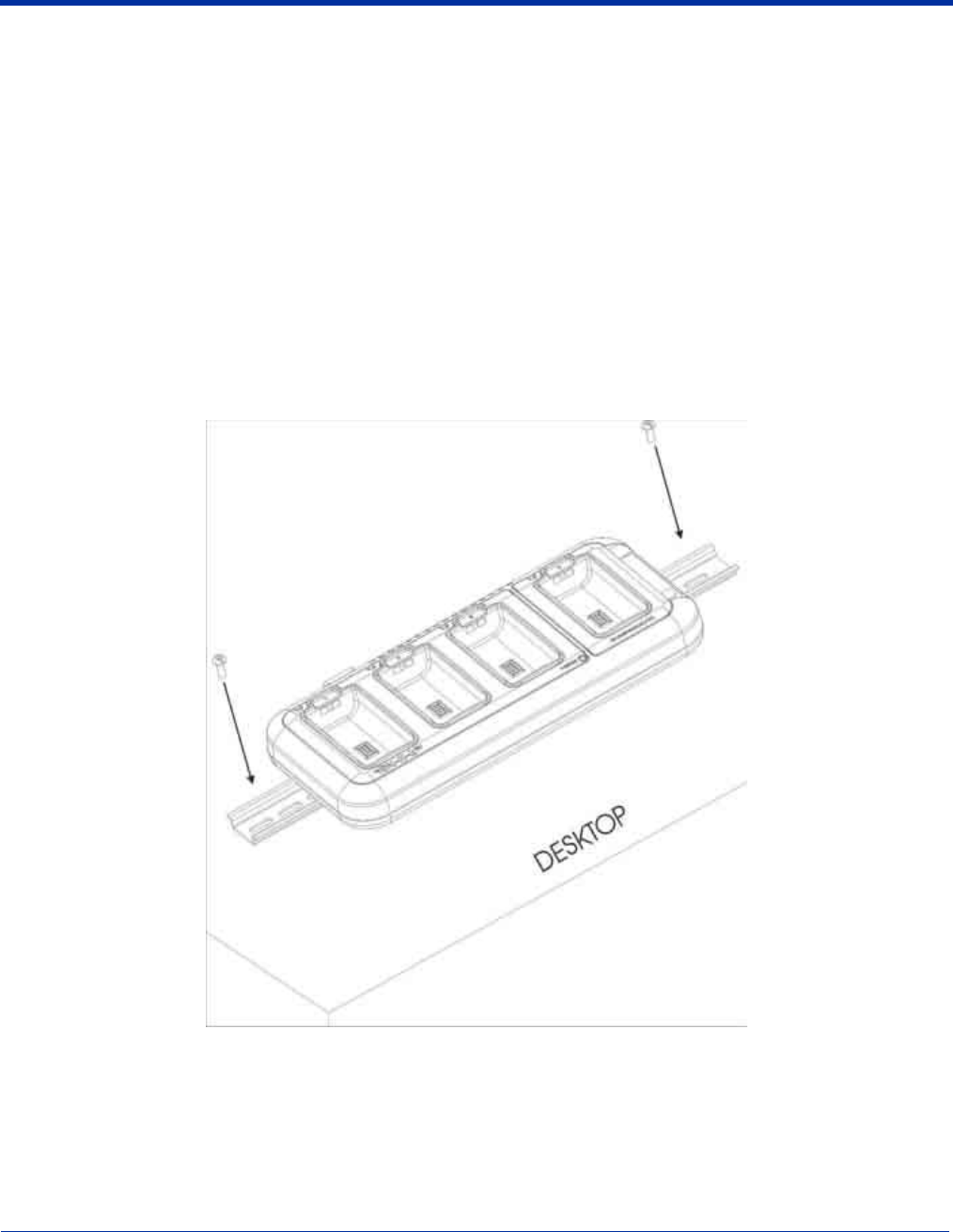
Dolphin® 9500/9550 Mobile Computer User’s Guide - GSM Draft 14 - 5
Mounting the QuadCharger
The Dolphin QuadCharger should be on a dry, stable surface. To easily adapt the QuadCharger to your environment, it can be
mounted on a flat, horizontal surface such as a desktop or workbench, or a flat, vertical surface such as a wall.
When choosing a location, always bear in mind that
• the mounting location must allow users easy access to power switch and power connector:
• the QuadCharger should be oriented so that users can easily read the labels, especially for the Battery Analyzer.
Mounting with the DIN Rail
All Dolphin charging/communication cradles have a DIN rail (7.5 X 35 mm) slot on the bottom panel to enable secure mounting.
To mount the QuadCharger, you slide the DIN rail slot along the bottom panel and secure it. Then, using the appropriate nuts
and bolts, secure the DIN rail to the desk or wall.
Desk Mounting
The following graphic displays how to mount the QuadCharger to a desk:
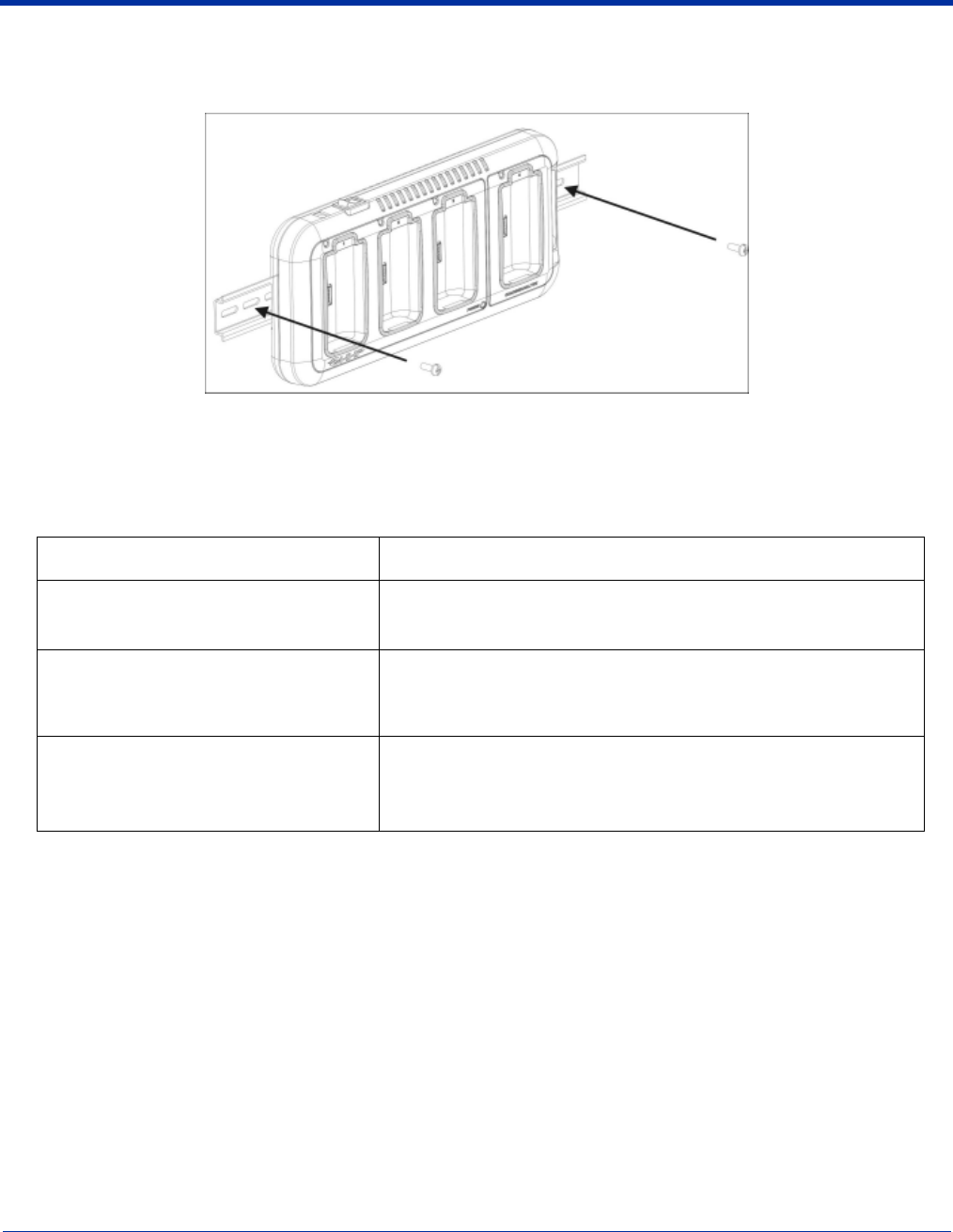
14 - 6 Dolphin® 9500/9550 Mobile Computer User’s Guide - GSM Draft
Wall Mounting
The following graphic displays how mount a QuadCharger to a wall:
Troubleshooting
If you encounter problems with your Dolphin QuadCharger, refer to chart below for possible solutions. If problems persist, please
contact HHP Technical Support.
Problem Issue
The Status LED does not come on when I
insert a battery pack into the Dolphin
QuadCharger
Check the power connections on the Dolphin QuadCharger; make sure
the POWER switch is ON and the battery pack is properly seated.
The Status LED lights red during charging. Try to charge the battery in one of the other charging slots. If the red
Status LED comes on again, then the problem is associated with the
battery pack. If the red status stays with the charging slot, the problem is
associated with the charging circuity.
The Status LED lights red and stays on
without a battery in the charging slot.
An error occurred during the self-diagnostic test for that particular
charging pocket. Call HHP Product Service and request an RMA.
For additional warranty and return information, see Warranty, Support,
and Service on page 15-1.

Dolphin® 9500/9550 Mobile Computer User’s Guide - GSM Draft 15 - 1
15
Warranty, Support, and Service
Limited Warranty
Hand Held Products, Inc., d/b/a HHP (“HHP“) warrants its products to be free from defects in materials and workmanship and to
conform to HHP’s published specifications applicable to the products purchased at the time of shipment. This warranty does not
cover any HHP product which is (i) improperly installed or used; (ii) damaged by accident or negligence, including failure to follow
the proper maintenance, service, and cleaning schedule; or (iii) damaged as a result of (A) modification or alteration by the
purchaser or other party, (B) excessive voltage or current supplied to or drawn from the interface connections, (C) static electricity
or electro-static discharge, (D) operation under conditions beyond the specified operating parameters, or (E) repair or service of
the product by anyone other than HHP or its authorized representatives.
This warranty shall extend from the time of shipment for the duration published by HHP for the product at the time of purchase
(“Warranty Period”). Any defective product must be returned (at purchaser’s expense) during the Warranty Period to HHP’s
factory or authorized service center for inspection. No product will be accepted by HHP without a Return Materials Authorization,
which may be obtained by contacting HHP. In the event that the product is returned to HHP or its authorized service center within
the Warranty Period and HHP determines to its satisfaction that the product is defective due to defects in materials or
workmanship, HHP, at its sole option, will either repair or replace the product without charge, except for return shipping to HHP.
EXCEPT AS MAY BE OTHERWISE PROVIDED BY APPLICABLE LAW, THE FOREGOING WARRANTY IS IN LIEU OF ALL
OTHER COVENANTS OR WARRANTIES, EITHER EXPRESSED OR IMPLIED, ORAL OR WRITTEN, INCLUDING, WITHOUT
LIMITATION, ANY IMPLIED WARRANTIES OF MERCHANTABILITY OR FITNESS FOR A PARTICULAR PURPOSE.
HHP’S RESPONSIBILITY AND PURCHASER’S EXCLUSIVE REMEDY UNDER THIS WARRANTY IS LIMITED TO THE
REPAIR OR REPLACEMENT OF THE DEFECTIVE PRODUCT. IN NO EVENT SHALL HHP BE LIABLE FOR INDIRECT,
INCIDENTAL, OR CONSEQUENTIAL DAMAGES, AND, IN NO EVENT, SHALL ANY LIABILITY OF HHP ARISING IN
CONNECTION WITH ANY PRODUCT SOLD HEREUNDER (WHETHER SUCH LIABILITY ARISES FROM A CLAIM BASED
ON CONTRACT, WARRANTY, TORT, OR OTHERWISE) EXCEED THE ACTUAL AMOUNT PAID TO HHP FOR THE
PRODUCT. THESE LIMITATIONS ON LIABILITY SHALL REMAIN IN FULL FORCE AND EFFECT EVEN WHEN HHP MAY
HAVE BEEN ADVISED OF THE POSSIBILITY OF SUCH INJURIES, LOSSES, OR DAMAGES. SOME STATES, PROVINCES,
OR COUNTRIES DO NOT ALLOW THE EXCLUSION OR LIMITATIONS OF INCIDENTAL OR CONSEQUENTIAL DAMAGES,
SO THE ABOVE LIMITATION OR EXCLUSION MAY NOT APPLY TO YOU.
All provisions of this Limited Warranty are separate and severable, which means that if any provision is held invalid and
unenforceable, such determination shall not affect the validity of enforceability of the other provisions hereof.
The limited duration of the warranty for the Dolphin 9500 and Dolphin 9550 terminals is as described below:
• Terminals with an integrated imager are covered by a two-year limited warranty.
• Touch screens are covered by a one-year limited warranty.
• The limited duration of the warranty for the Dolphin HomeBase, Mobile Base, Mobile Charger, and QuadCharger is one year.
• The limited duration of the warranty for batteries is one year. Use of any battery not sold/manufactured by HHP may damage
the terminal and/or the battery and will void the warranty. Batteries returned to HHP in a reduced state may or may not be
replaced under this warranty. Battery life will be greatly increased when following the battery instructions in this user’s guide.
• Use of any peripheral with the Dolphin terminal not manufactured/sold by HHP will void the warranty. This includes but is not
limited to: cables, power supplies, cradles, and docking stations.
• Use only power adapters approved for use by HHP. Failure to do so may result in improper operation or damage to the unit
and will void the warranty.
Hand Held Products, Inc. extends these warranties only to the first end-users of the products. These warranties are non-
transferable.
How to Extend Your Warranty
HHP offers a variety of service plans on our hardware products. These agreements offer continued coverage for your equipment
after the initial warranty expires. For more information, contact your HHP sales representative, customer account representative,
the Product Service Marketing Manager, or your Authorized Reseller.

15 - 2 Dolphin® 9500/9550 Mobile Computer User’s Guide - GSM Draft
Return Information
Should your unit or any of the peripherals prove to be defective within the stated warranty period from the date of purchase, return
the product, as described in the Repair Maintenance Authorization (RMA) procedures below, and we will, at our option, repair or
replace the product, to whatever extent HHP deems necessary to restore the product to proper operating condition, without any
charge to you.
You must obtain an RMA number to receive service from any of HHP’s repair facilities. Failure to obtain an RMA number before
shipping your product to this repair facility can delay the processing of your repair request. Please contact the Product Service
facility (numbers listed below) nearest you to receive an RMA number.
If you purchased the product from an Authorized HHP Reseller, contact the Reseller with the unit's serial number. Your Reseller
will contact HHP, on your behalf, to arrange for the unit to be serviced.
Calling for an RMA Number
If you purchased the product directly from HHP, or have been instructed by your Reseller to contact HHP directly, call the Product
Service Department in your area to request an RMA number.
You can also access product service and repair online at : http://www.hhp.com/hhp/service/contactservice.tpl.
Requirements
When calling for service at any of our repair facilities, please be prepared to give the following information:
• Product type and serial number
• Brief description of problem
• Dated proof-of-purchase
If your equipment is still covered under the initial end-user's product warranty, please notify the Product Services Representative
when you call.
Service and Repair Locations.
Shipping
Please make note of the RMA number (if required) and the product's serial number before shipping.
If you must return your unit, place the product in its original packaging with a copy of your original invoice (this helps avoid
possible service delays) and ship the product prepaid to the appropriate address below. For your protection, we recommend you
insure any equipment being sent to HHP.
Write the RMA number on the mailing label under the address.\
Repair
After repair or replacement of the equipment, HHP will ship the product, at our cost, to your location. Non-warranty repairs will
be returned, at the customer's expense, unless otherwise requested. Units currently under a service agreement will be shipped
per the service agreement.
North America/Canada
HHP Corporate Offices
Telephone: (800) 782-4263, option 3
Fax: (704) 566-6015
E-mail: ProductService@hhp.com
Latin America
HHP Latin America
Telephone: +1 239-263-7600
Fax: +1 239-263-9689
E-mail: LASupport@hhp.com
Asia Pacific
HHP Asia/Pacific
Telephone: +852-2511-3050
Fax: +852-2511-3557
E-mail: chuie@hhp.com
Europe, Middle East, and Africa
(EMEA)
HHP Europe
Telephone:+ 31 (0) 40 29 01 633
Fax: + 31 (0) 40 2901631
E-mail: EuroService@hhp.com
Brazil
HHP Brazil
Telephone: +55 (21) 2494-7060
Fax: +55 (21) 2494-5033
E-mail: suporte@hhp.com.br
Japan
HHP Japan
Telephone: +813 5842 6325
Fax: +813 5842 6335
E-mail: KobayashiT@hhp.com

15 - 3 Dolphin® 9500/9550 Mobile Computer User’s Guide - GSM Draft
Technical Assistance
If you have a question or problem with your unit, you can obtain technical assistance from HHP’s Application Support department.
North America/Canada:
Telephone: (800) 782-4263, Option 4 (8 a.m. to 6 p.m. EST)
Fax number: (315) 685-4960
E-mail: support@HHP.com
Europe, Middle East, and Africa:
Telephone
European Ofc: +31 (0) 40 29 01 600
U.K. Ofc: +44 1925 240055
E-mail: euro_support@HHP.com
Asia:
Telephone: +852-2511-3050
E-mail: asia_support@HHP.com
Latin America:
Telephone: (239) 263-7600
E-mail: la_support@HHP.com
Assistance Online
You can also access technical assistance online at: http://www.hhp.com/hhp/service/contacttech.tpl.
FTP Server
Downloads are available at: ftp://hhpftp.handheld.com/Pub/AppSupport/.

15 - 4 Dolphin® 9500/9550 Mobile Computer User’s Guide - GSM Draft

Dolphin® 9500/9550 Mobile Computer User’s Guide - GSM Draft A - 1
Appendix A - Keyboards
Overview
This appendix provides useful tools for programming and managing your Dolphin 9500/9550 terminal.
General Windows Keyboard Shortcuts
Use the keyboard shortcuts in the chart below to navigate the Dolphin 9500 and Dolphin 9550 terminal keyboards. These are
standard keyboard shortcuts for Windows applications.
Press these keys, To…
CTRL + C Copy
CTRL + X Cut
CTRL + V Paste
CTRL + Z Undo
DELETE Delete
CTRL + RIGHT ARROW Move the insertion point to the beginning of the next word.
CTRL + LEFT ARROW Move the insertion point to the beginning of the previous word.
CTRL + DOWN ARROW Move the insertion point to the beginning of the next paragraph.
CTRL + UP ARROW Move the insertion point to the beginning of the previous paragraph.
SHIFT with any of the arrow keys Select more than one item in a window or on the desktop, or select text
within a document.
CTRL+A Select all.
ALT+ENTER View properties for the selected item.
ALT+TAB Switch between open items.
ALT+ESC Cycle through items in the order they were opened.
ALT + Tap on Touch screen Right-click
CTRL+ESC Display the
Start
menu.
ALT+Underlined letter in a menu name Display the corresponding menu.
Underlined letter in a command name on an open
menu
Carry out the corresponding command.
BACKSPACE View the folder one level up in My Computer or Windows Explorer.
ESC Cancel the current task.
A
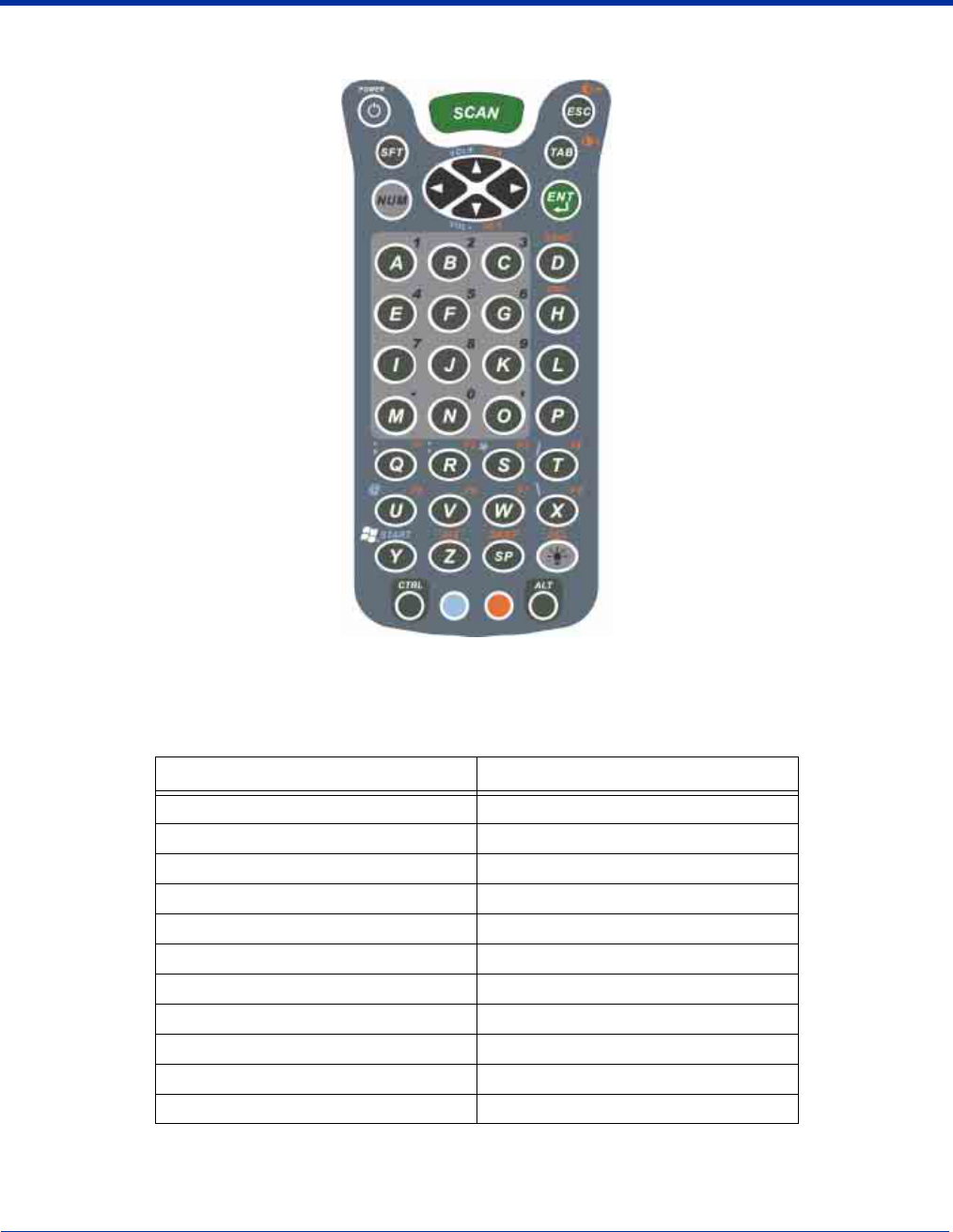
Dolphin® 9500/9550 Mobile Computer User’s Guide - GSM Draft A - 2
43-Key Alpha/Numeric Keyboard
Blue Key Functions and Characters
The following table displays the special functions performed and characters inserted using the blue key.
Key Combination Function/Special Character
Blue key + D - (minus)
Blue key + H _ (underscore)
Blue key + L =
Blue key + P +
Blue key + Q ;
Blue key + R :
Blue key + S *
Blue key + T /
Blue key + U @
Blue key + X \
Blue key + Y START
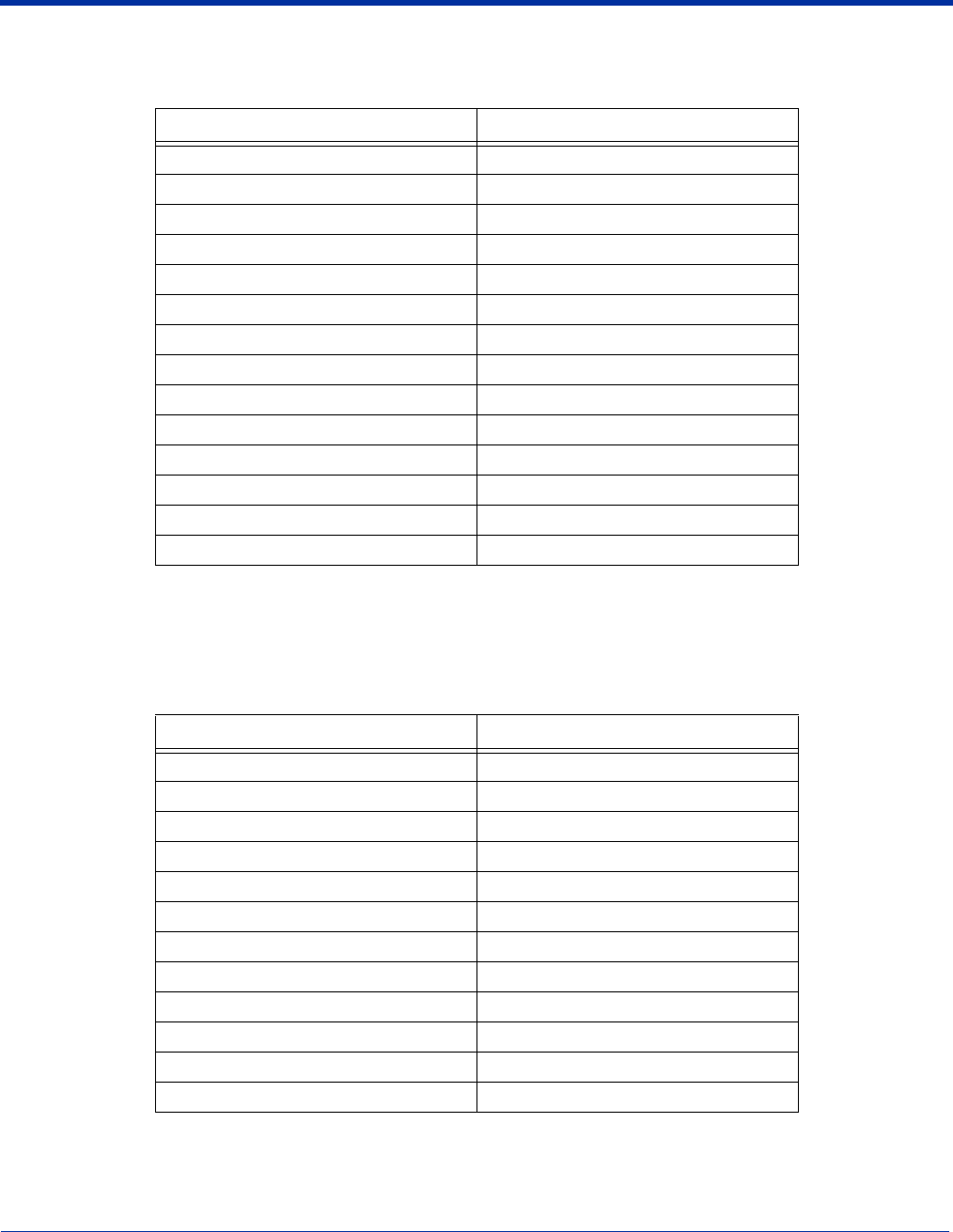
Dolphin® 9500/9550 Mobile Computer User’s Guide - GSM Draft A - 3
Red Key Functions and Characters
The following table displays the special functions performed and characters inserted using the red key.
* Exit the mouse utility prior to adjusting the contrast.
Key Combinations
Use the key combinations listed below to access certain keyboard functions or to use special characters that are not defined on
the 43-key version of the Dolphin 9500/9550 keyboard.
Key Combination Function/Special Character
Red key + ESC Lightens Contrast*
Red key + TAB Darkens Contrast*
Red key + SFT Toggles on Caps Lock
Red key + Q F1
Red key + R F2
Red key + S F3
Red key + T F4
Red key + U F5
Red key + V F6
Red key + W F7
Red key + X F8
Red key + Z INS (insert)
Red key + SP BKSP (backspace)
Red key + BACKLIGHT KEY DEL (delete)
Key/Key Combination Function/Special Character
NUM + SFT + A !
NUM + SFT + B @
NUM + SFT + C #
NUM + SFT + E $
NUM + SFT + F %
NUM + SFT + G ^
NUM + SFT + I &
NUM + SFT + J *
NUM + SFT + K (
NUM + SFT + M >
NUM + SFT + N )
NUM + SFT + O <

A - 4 Dolphin® 9500/9550 Mobile Computer User’s Guide - GSM Draft
Key Combinations Using Blue + Sft Keys
Miscellaneous Key Combinations
Key/Key Combinations Function/Special Characters
SFT + Blue + T ?
SFT + Blue + X >
Key/Key Combinations Function/Special Characters
NUM + ALT + 3 + 9 ‘
NUM + ALT + 3 + 4 “
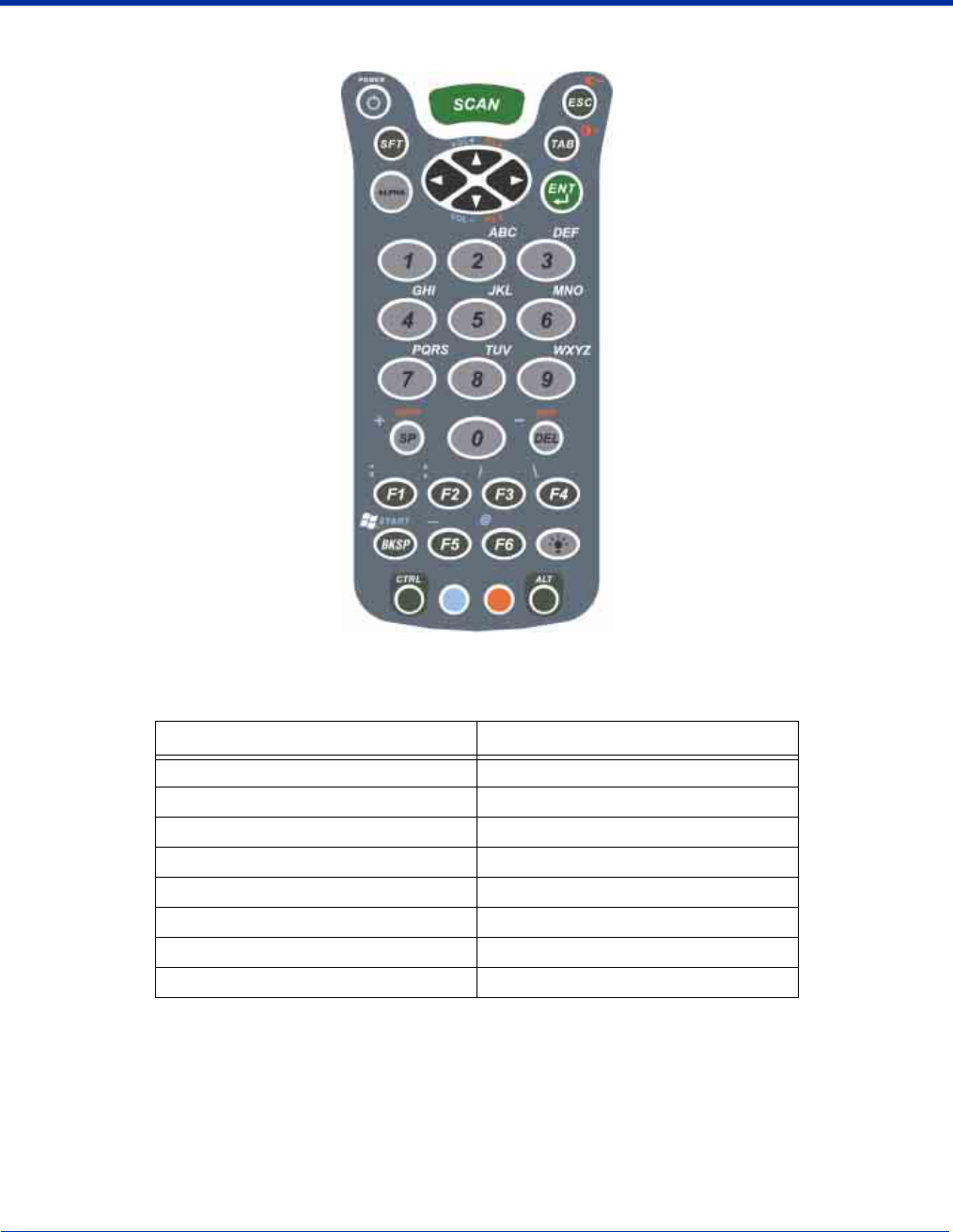
Dolphin® 9500/9550 Mobile Computer User’s Guide - GSM Draft A - 5
35 Key Numeric/Alpha Keyboard
Blue Key Functions and Characters
Key Combination Function/Special Character
Blue key + . +
Blue key + , -
Blue key + F1 ;
Blue key + F2 :
Blue key + F3 /
Blue key + F4 \
Blue key + SP +
Blue key + DEL -

A - 6 Dolphin® 9500/9550 Mobile Computer User’s Guide - GSM Draft
Key Combinations
Use the key combinations listed below to access certain keyboard functions or to use special characters that are not defined on
the 35-key version of the Dolphin keyboard.
Key Combinations Using Alpha + SFT Keys
ALT Key Combinations
Key/Key Combination Function/Special Character
ALPHA + SFT + 1 !
ALPHA + SFT + 2 @
ALPHA + SFT + 3 #
ALPHA + SFT + 4 $
ALPHA + SFT + 5 %
ALPHA + SFT + 6 ^
ALPHA + SFT + 7 &
ALPHA + SFT + 8 *
ALPHA + SFT + 9 (
ALPHA + SFT + 0 )
Key/Key Combinations Function/Special Characters
Hold the ALT key down as you type in the numbers.
ALT + 3 + 9 ‘
ALT + 3 + 4 “
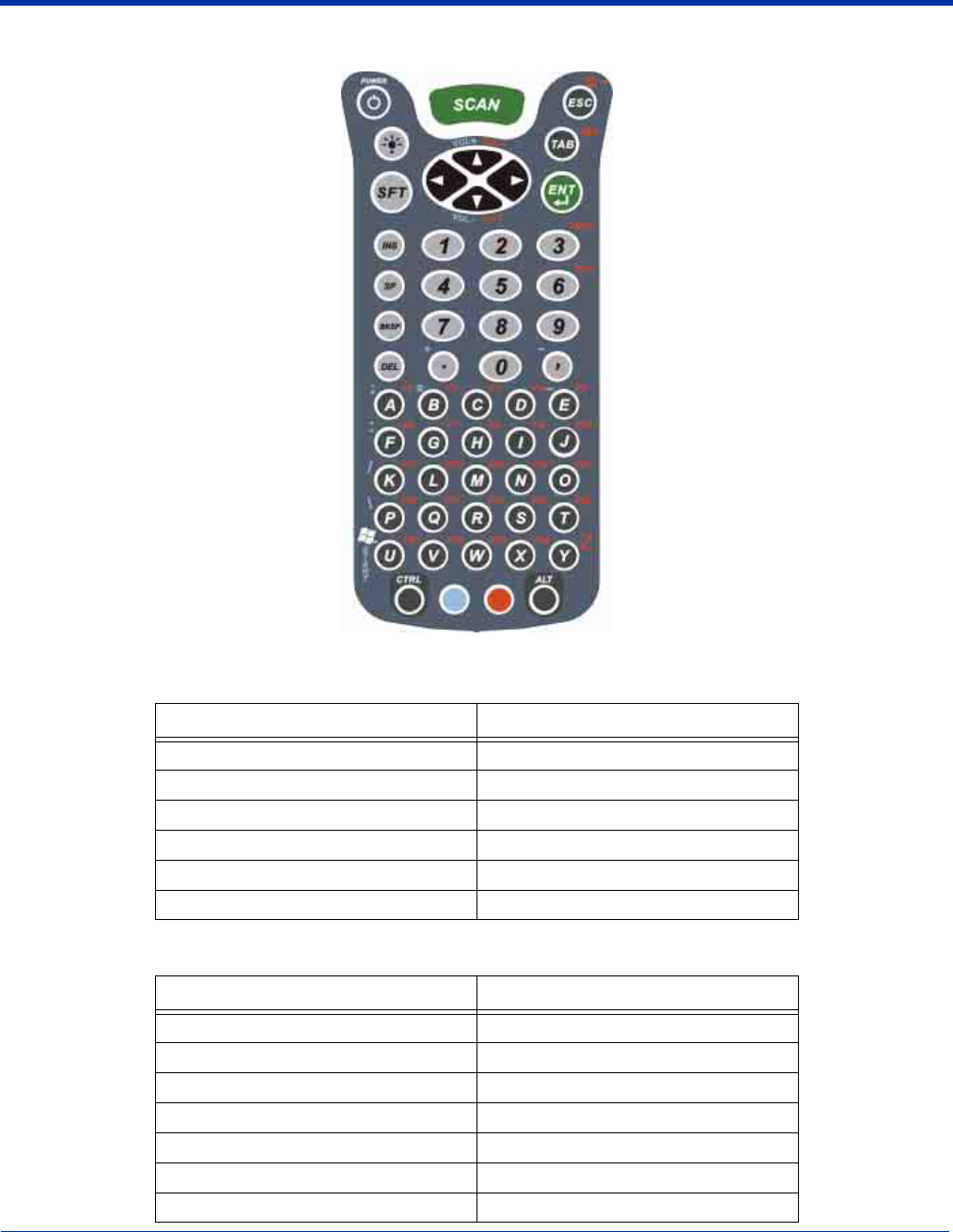
Dolphin® 9500/9550 Mobile Computer User’s Guide - GSM Draft A - 7
56 Key Full Alpha Numeric
Blue Key Functions and Characters
Red Key Functions and Characters
Key Combination Function/Special Character
Blue key + . +
Blue key + , -
Blue key + A ;
Blue key + B @
Blue key + E _
Blue key + F :
Key Combination Function/Special Character
Red key + ESC Lightens Contrast*
Red key + TAB Darkens Contrast*
Red key + SFT Toggles on Caps Lock
Red key + A F1
Red key + B F2
Red key + C F3
Red key + D F4

A - 8 Dolphin® 9500/9550 Mobile Computer User’s Guide - GSM Draft
* Exit the mouse utility prior to adjusting the contrast.
Red key + E F5
Red key + F F6
Red key + G F7
Red key + H F8
Red key + I F9
Red key + J F10
Red key + K F11
Red key + L F12
Red key + M F13
Red key + N F14
Red key + O F15
Red key + P F16
Red key + Q F17
Red key + R F18
Red key + S F19
Red key + T F20
Red key + U F21
Red key + V F22
Red key + W F23
Red key + X F24
Red key + Y Z
Key Combination Function/Special Character
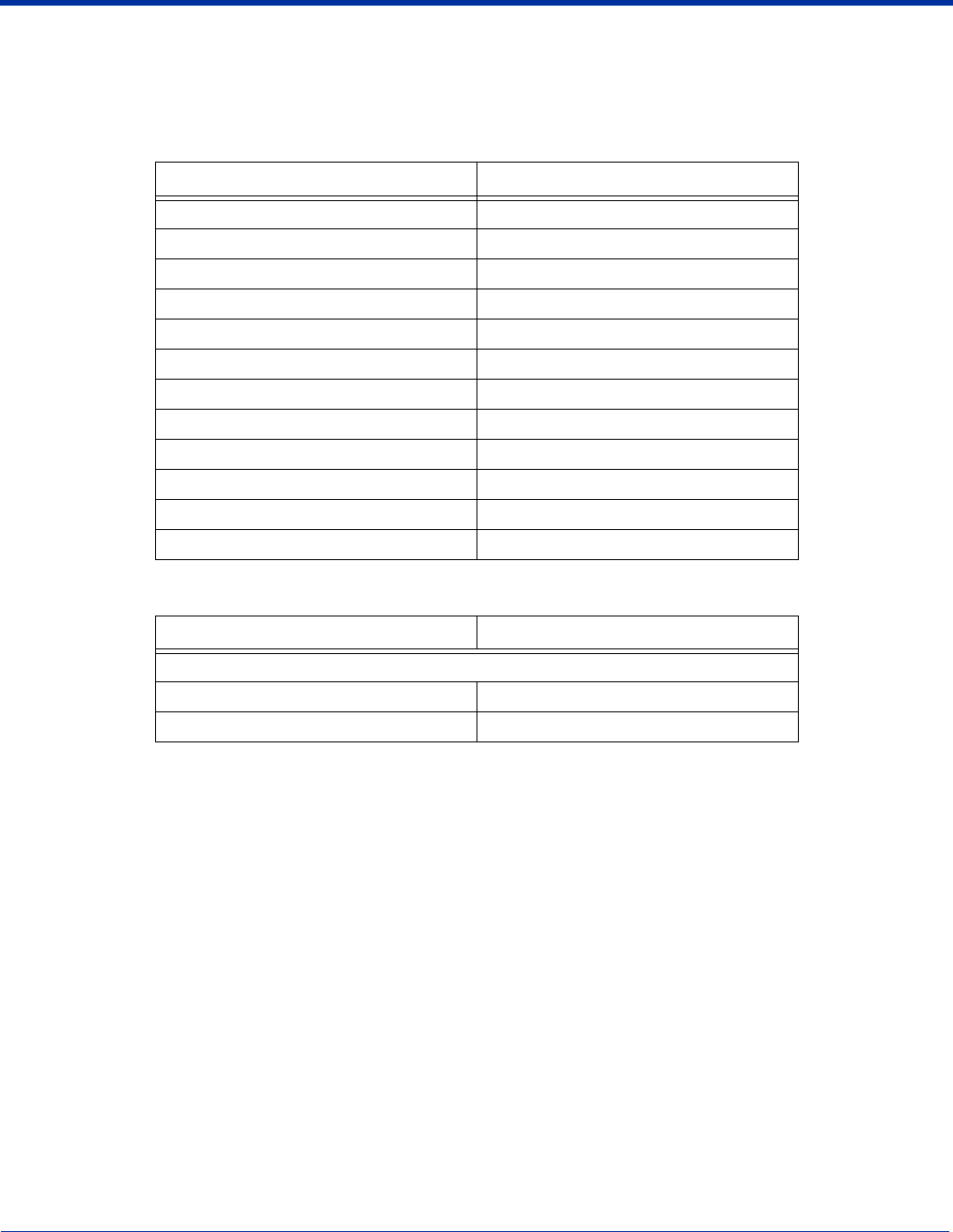
Dolphin® 9500/9550 Mobile Computer User’s Guide - GSM Draft A - 9
Key Combinations
Use the key combinations listed below to access certain keyboard functions or to use special characters that are not defined on
the 56-key version of the Dolphin keyboard.
SFT Key Combinations
ALT Key Combinations
Key Combination Function/Special Character
SFT + 1 !
SFT + 2 @
SFT + 3 #
SFT + 4 $
SFT + 5 %
SFT + 6 ^
SFT + 7 &
SFT + 8 *
SFT + 9 (
SFT + 0 )
SFT + . (period) >
SFT + , (comma) <
Key Combinations Function/Special Characters
Hold the ALT key down as you type in the numbers.
ALT + 3 + 9 ‘
ALT + 3 + 4 “

A - 10 Dolphin® 9500/9550 Mobile Computer User’s Guide - GSM Draft
Com Port Assignment Table
Com Port Assignment
Com Port 1 Serial port. This is the 17-pin connector on the bottom panel of
Dolphin 9500/9550 terminals.
Com Port 2 Bluetooth Module
If there is no Bluetooth hardware installed on the terminal, this com
port is unassigned.
Com Port 3 Raw Infrared
Com Port 4
Com Port 5 USB virtual serial port
Com Port 6 IrDA, if IrDA is enabled.
If IrDA is disabled, this com port becomes available. See
To
Disable the IrDA Port
on page
5-7.
Com Ports 7-9 Unassigned.
These are available for selection only when connecting to devices
that use virtual com ports, such as Bluetooth.


™
95/9550/UG Rev (b)